

All Destinations , Asia , Nepal
Best everest base camp trek itinerary (12 days).

Whether you’re planning on hiking in Nepal with a guide or trekking the Khumbu region independently, this Everest Base Camp trek itinerary should give you a clear idea about what to expect.
Everest Base Camp has been on my bucket list for 15 years, ever since I learned about the Himlayas at school.
But I never had a chance to do it until Spring 2024, when my partner’s friends organised a group of us to undertake the hike.
When I was preparing for the hike, I was full of questions. How much money do I need? Is it safe? How should I train?
But, above all, what is the standard Everest Base Camp trek itinerary?
We were provided an itinerary for the trail, but I was craving more details.
So, when I was doing the trek, I decided to put together our detailed Everest Base Camp itinerary to help any future hikers!
This is the standard itinerary that’s followed by most tour groups, with a few variations, and my experience and thoughts about it. If you’re hiking independently I have put a few suggested tweaks in that I think could improve the itinerary.
Let’s get into it!
Everest Base Camp trek itinerary
The typical Everest Base Camp itinerary is as follows:
- Day 1: Flight from Kathmandu to Lukla; trek to Phakding
- Day 2: Phakding to Namche Bazar
- Day 3: Acclimatization day in Namche Bazar
- Day 4: Namche Bazar to Tengbouche
- Day 5: Tengbouche to Dingboche
- Day 6: Acclimatization day in Dingboche
- Day 7: Dingboche to Lobuche
- Day 8: Lobuche to Gorak Shep; visit Everest Base Camp
- Day 9: Hike to Kala Patthar; return to Gorak Shep; trek down to Pangboche
- Day 10: Pangboche to Namche Bazar
- Day 11: Namche Bazar to Lukla
- Day 12: Flight from Lukla back to Kathmandu

This is the itinerary that most tour companies use, give or take a few stops (for example, some groups hike to Manjo rather than Phakding on the first day, or stay in Periche rather than Pangboche on day 9).
And of course, if you’re trekking independently, yours might look a bit different.
Here’s what to expect on each day!
Day one – Fly to Lukla – hike to Phakding

- Start Elevation: Lukla – 2,860 meters (9,383 feet)
- End Elevation: Phakding – 2,610 meters (8,563 feet)
- Elevation Loss: 250 meters (820 feet)
- Distance: Approximately 8 km (5 miles)
- Difficulty: Easy
Your Everest Base Camp hike begins by flying to Lukla airport – often dubbed the “world’s most dangerous airport” ( you can see my thoughts on it here ).
The timing of your flight can vary greatly – it depends on the weather, which is incredibly temperamental at Lukla (as expected at 2,800 metres altitude) and how many passengers. Flights might depart as early as 6 AM or as late as mid-afternoon.
Keep in mind, there’s a 50% chance flights could be cancelled due to weather. If this happens, you might need to wait for the next available flight (which could be the next day) or opt for a helicopter ride at an additional cost (we were told that this would be $400 per person, although I have heard of people paying much cheaper).
Upon arrival in Lukla – elevation 2,860 meters – you’ll feel the anticipation buzzing through the crisp mountain air.
Compared to other villages along the trail, Lukla is positively cosmopolitan, with a variety of shops and tea houses.
The trek to Phakding is a gentle introduction to the Himalayan terrain.
It’s mostly downhill (although there are some ups, too – this is Nepali Flat ) and takes about 3 to 4 hours, covering around 8 kilometres. As you descend to Phakding (2,610 metres), you’ll pass through beautiful landscapes dotted with traditional Sherpa villages and monasteries and walk along the Dudh Koshi River.
The path is well-maintained, with plenty of spots to rest, grab a snack or use the toilet. While the altitude here is significant, it’s generally not high enough to trigger acute mountain sickness, though some of us started feeling the elevation!
Some hikers continue to Monjo, but whether you’ll be able to do this depends on what time your plane lands. I wouldn’t recommend counting on being able to hike past Phakding.
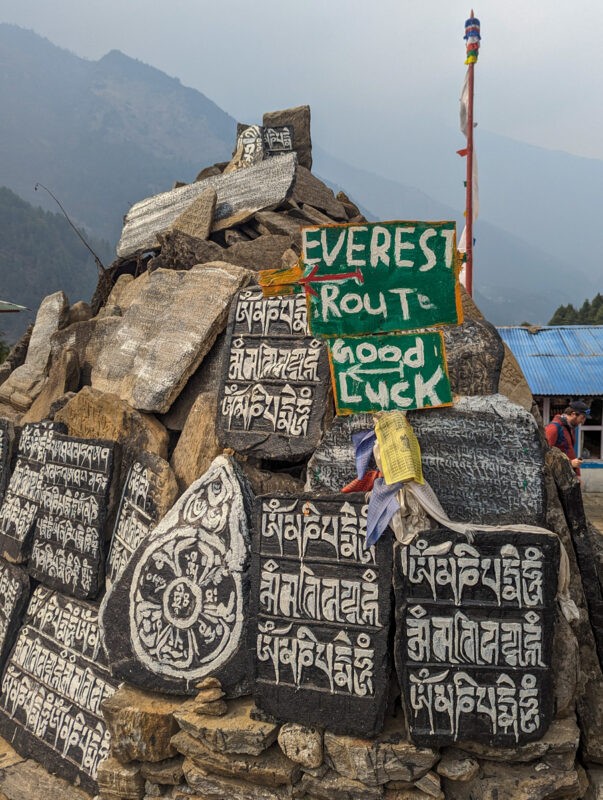
My Suggestions
For a less tiring start to this journey, I’d advise spending the night in Ramechhap or flying to Lukla a day early.
Staying in Kathmandu requires waking up around 2am for the drive to Ramechhap, which can be exhausting even before your trek begins!
Many tour companies offer accommodation arrangements in these locations – if you’re on a private tour, just ask your organiser before heading out.
Where to stay
We stayed in Trekkers Lodge Phakding , which was cosy and well-appointed – I loved the outdoor sitting area with views of the hills! Rooms were en-suite, with a shower – although the water was freezing cold.
Day Two – Phakding to Namche Bazar
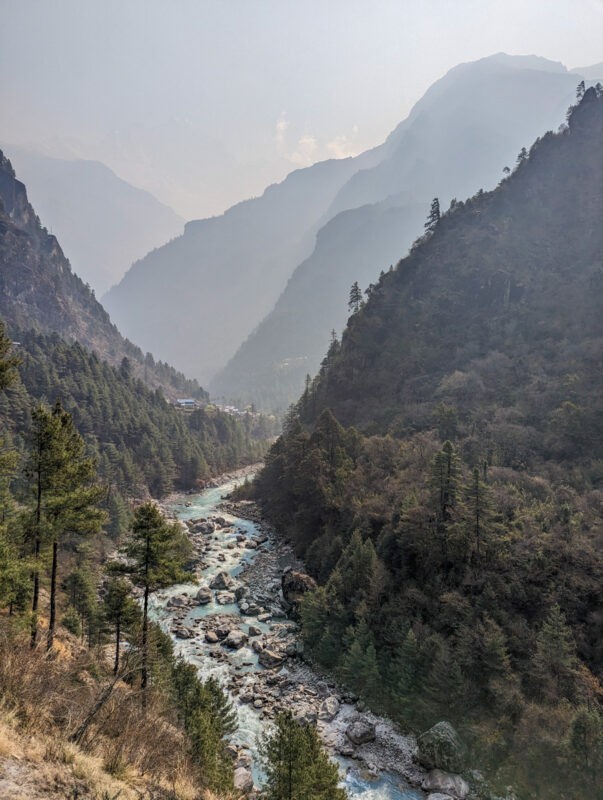
- Start Elevation: Phakding – 2,610 meters (8,563 feet)
- End Elevation: Namche Bazar – 3,440 meters (11,286 feet)
- Elevation Gain: 830 meters (2,723 feet)
- Distance: Approximately 10-12 km (6-7.5 miles)
- Difficulty: Moderate
Today is your first full day on the trail!
Today’s trek from Phakding to Namche Bazar is where the real climbing begins.
The hike starts with a pleasant walk along the Dudh Koshi River, but don’t be fooled by the easy path – it will get more difficult! You’ll cover approximately 10 to 12 kilometres today, which usually takes about 5 to 7 hours without breaks, depending on your pace.
As you leave Phakding, the trail meanders through magnificent pine forests, crossing and recrossing the river several times on suspension bridges draped with prayer flags that flutter in the wind. I found these bridges to be rather hair-raising, but they are stable!
The most famous is the Hillary Suspension Bridge , named after the first Westerner to summit Everest (along with Sherpa Tenzing Norgay ).
Elevation gain is a key part of today’s hike, as you ascend from Phakding at 2,610 meters to Namche Bazar at 3,440 meters – this is quite a lot of altitude to gain at once, but unfortunately, there’s not really anywhere else you can stop (as you’ll gain most of this elevation on the steep climb up to Namche!).
As you approach the village, you might start feeling the altitude – I found the last ascent into Namche particularly challenging.
Namche Bazar, often considered the gateway to the high Himalayas and the largest town in the Everest region, is a bustling sherpa community that offers a warm welcome to trekkers. Here, you’ll find an array of cafes, bakeries shops and the world’s highest Irish pub !
It’s a cultural hub where trekkers can soak up the local culture and prepare for higher altitudes in the days to come.
Hotel 8848 was a fun tea house with a great atmosphere. I’d definitely recommend staying here, and try the veggie burger in the restaurant – it’s excellent!
Day Three – Acclimatization in Namche Bazar
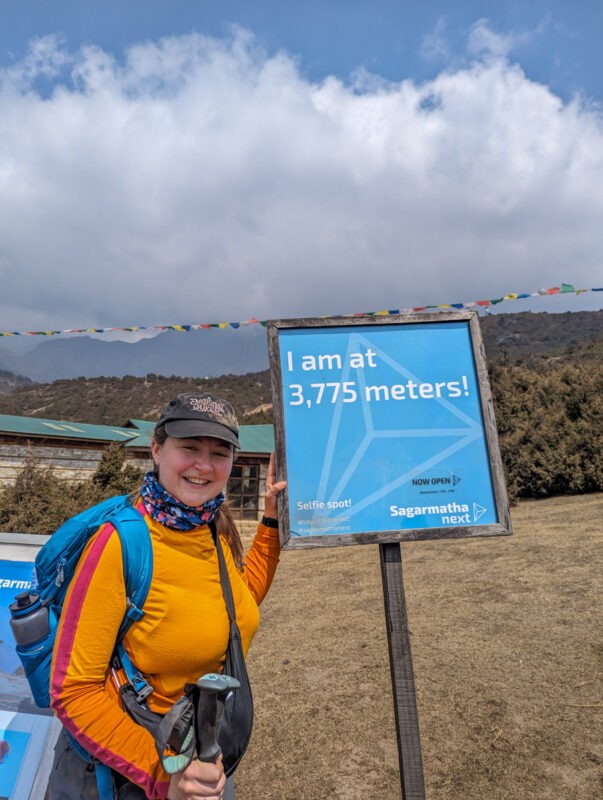
- Activities: Hiking uphill and then down for acclimatisation
- Difficulty: Easy to moderate
Take today to acclimatise and explore the heart of the Khumbu region, Namche Bazar.
Your body will thank you for allowing it time to adjust to the higher altitude!
All organised treks will include a day of acclimatisation in Namche , and I’d highly recommend doing the same if you’re hiking independently.
However, acclimatisation doesn’t mean resting all day! In fact, the best way to acclimatise is to keep active.
Start your morning with a short hike up about 150 meters to the Sagarmatha National Park Museum .
As it’s just above Namche, this climb not only helps with acclimatisation but you can also catch a glimpse of Mount Everest on a clear day!
The museum itself is well worth a visit – here, you’ll discover insights into Sherpa people, the history of Everest expeditions and its geography.
After your museum visit, continue your hike up to the Everest View Hotel.
Aim to reach early; the views are best in the morning, as afternoons are often cloudy!
The hotel is apparently the highest luxury hotel in the world and we visited for a cup of tea. It was surprisingly the most underwhelming—and the priciest—tea I had, served DIY style with just a pot of hot water and the raw ingredients.
Also, note trekkers are expected to use the external bathrooms, so keep some toilet paper handy!
If I did the trek again and it was unlikely that I’d see Everest from the hotel, I’d probably stop a bit before it and return to Namche. The last part of the trail is flat, so you could just hike to 4800 metres and then descend rather than pay for the Khumbu region’s most expensive tea at the hotel!
After lunching at our tea house, we had the afternoon at leisure. Our tea house (Hotel 8848) had hot showers which was bliss, and I did a bit of last-minute shopping!
Day Four – Namche Bazar to Tengboche
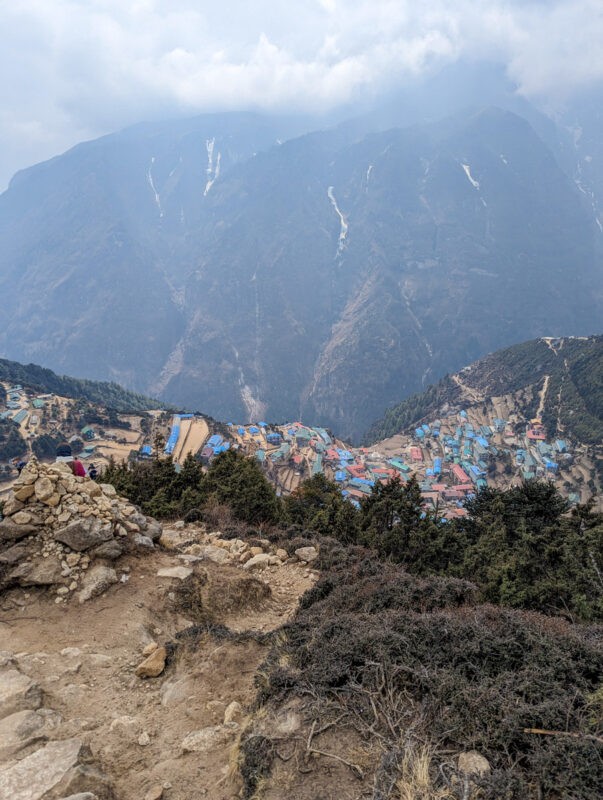
- Start Elevation: Namche Bazar – 3,440 meters (11,286 feet)
- End Elevation: Tengboche – 3,860 meters (12,664 feet)
- Elevation Gain: 420 meters (1,378 feet)
- Distance: Approximately 9-10 km (5.6-6.2 miles)
First up on day four is a climb out of Namche Bazar, heading up to a path that runs above the town. Then, it’s generally flat for a while, with a few minor uphills and downhills.
While this is fairly easy, it was here that I started feeling awful – low energy, headachey and a bit sick.
At our tea stop, I started taking Diamox as I thought it might be due to altitude sickness.
We lunched just before the infamous uphill zig-zag path that leads to Tengboche monastery.
This path is steep and relentless – it took us about two hours to reach the top (elevation: 3,800 metres).
Here, the air is noticeably thinner. Dominating the landscape is the majestic Tengboche Monastery.
It’s well worth popping into – with an entry fee of just 300 rupees, it offers not only a moment of spiritual reflection but also a chance to admire its intricate artistry up close. When we visited, we even got a blessing from one of the resident monks!
Inside, the air is heavy with the scent of incense; the walls, stories high, are adorned with ancient thangkas.
However, by the time we reached the top of the zig-zags, we didn’t have the energy for a monastery visit – instead, we popped in on the way back down.
From Tengbouche Monastery, it was a 45 minute walk to Good Luck Tea House , where we were staying for the night.
Despite the name, this was not a lucky night for me. My nausea had worsened and I retreated straight up to our room, where I was quickly quite sick! (Luckily, we had an en-suite bathroom, unluckily, the walls were paper-thin).
I wasn’t sure if this was altitude or food-related, but I thankfully did start feeling a lot better after I was sick. My guide was an angel and brought me dinner and reassured me that I was ok for the moment, and could see how I felt in the morning regarding altitude.
I had one episode of diarrhoea in the night, but thankfully woke up in the morning feeling fragile, but lots better and able to continue the hike.
Good Luck Tea House was decent, although my memory of being there is marred by feeling awful!
Day Five – Tengbouche to Dingboche
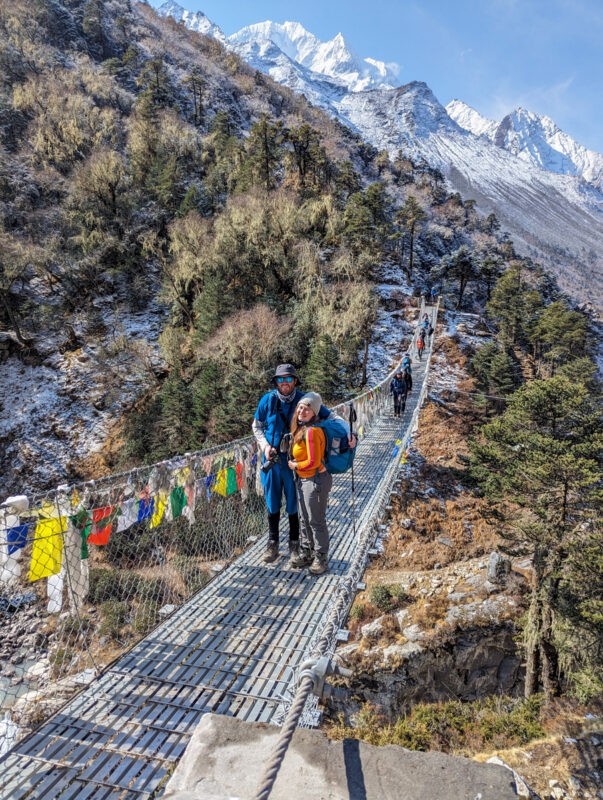
- Start Elevation: Tengbouche – 3,800 meters (12,467 feet)
- End Elevation: Dingboche – 4,410 meters (14,470 feet)
- Elevation Gain: 610 meters (2,000 feet)
- Distance: Approximately 11 km (6.8 miles)
- Difficulty: Moderate
The trek was starting to get harder due to the altitude, but other than that, this hike is a lot more manageable than previous days.
However, as I was still quite fragile, I struggled with the first part of it!
We weaved out of Tengbouche and through the last of the trees – after our lunch stop, we’d be hiking above the tree line.
As the trail ascends toward Dingboche, the increase in altitude becomes more apparent, and the air noticeably thinner.
However, the ascents are nowhere near as severe as the previous days.
Dingboche, sitting at an altitude of 4,410 meters is a critical acclimatisation stop. It’s very important to take a day to acclimatise here!
We stayed at Good Luck Tea House again – it’s a branch of the same tea house in Tengboche – and had a couple of hours in the afternoon to relax before dinner. I couldn’t face much food – I was scared of being sick again – so I just had a bowl of plain pasta with salt and pepper.
Day Six: Acclimatization Day in Dingboche
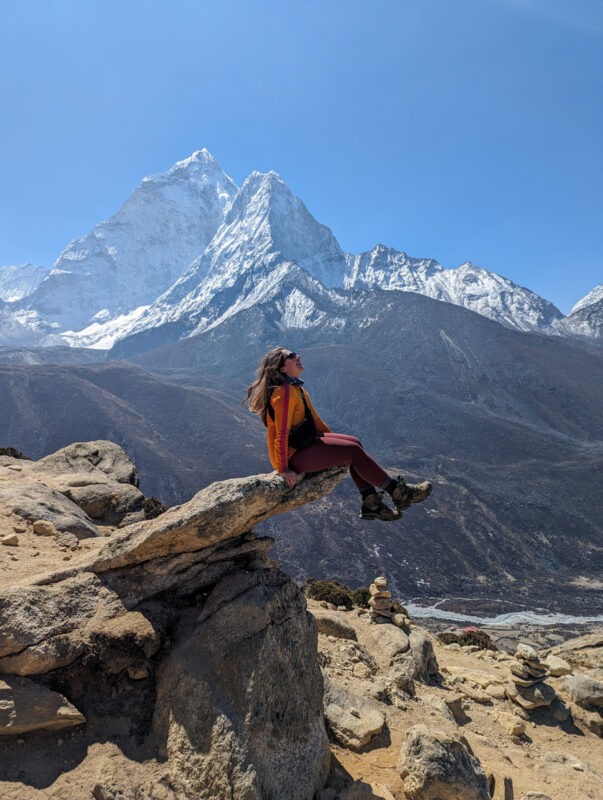
- Elevation: Dingboche – 4,410 meters (14,470 feet)
- Activities: Short acclimatization hike
- Total Hiking Time: Approximately 2 hours
- Elevation Gain: 300 meters
- Difficulty: Easy
Day six on the Everest Base Camp trek is a key acclimatization stop in Dingboche. There are a variety of hikes to do around the village – we opted for a fairly easy but still hilly trek. You can do longer, but for our group, this worked well to acclimatise while still having ample time to rest.
Above Dingboche, there are three flagpoles, the highest of which is 300 meters above the town. We opted to hike to the highest one.
This hike is easier and shorter than the previous acclimatisation day in Namche Bazar, taking about 2 hours in total.
I was feeling much better today, so felt quite invigorated as we hiked around!

There are lots of photo stops on the way too – the mountain views are stunning – including the famous rock that everyone gets a photo at. Climbing on it isn’t as scary as it looks!
After returning to Dingboche, you have the rest of the day to relax!
We decided to visit Cafe 4410, a popular bakery serving hot drinks, cakes and heavier meals. Try one of their luxury hot chocolates!
We actually ended up in the cafe for hours – the waiter put on the Everest movie, so we watched that and enjoyed being stationary for a bit!
Day Seven: Dingboche to Lobuche
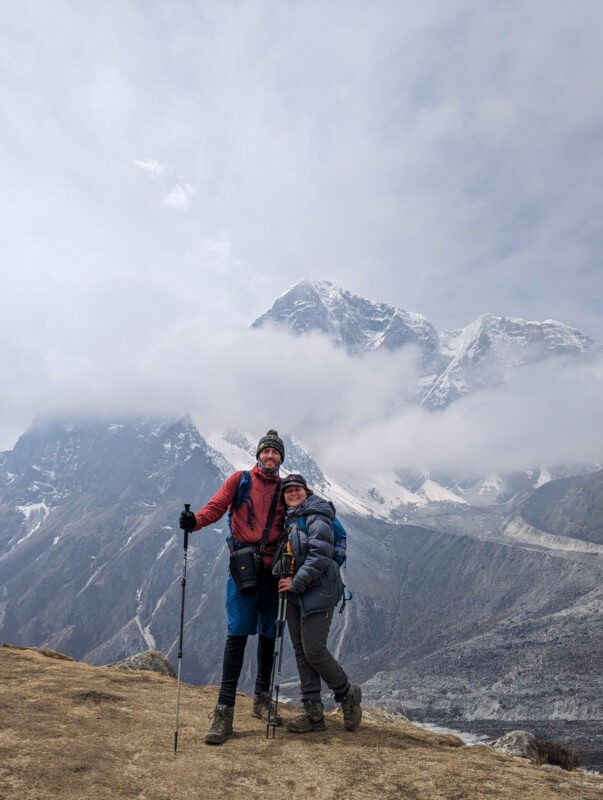
- Start Elevation: Dingboche – 4,410 meters (14,470 feet)
- End Elevation: Lobuche – 4,900 meters (16,076 feet)
- Elevation Gain: 490 meters (1,608 feet)
- Distance: Approximately 7-8 km (4.3-5 miles)
- Difficulty: Moderate to Challenging
You’re going to hike to nearly 5,000 metres today, so buckle up!
Leaving Dingboche behind, you’ll feel like you’re saying farewell to the vestiges of normality as the landscape transitions into more stark, alpine scenery.
Today’s route progresses from 4,410 meters in Dingboche to 4,900 meters in Lobuche, navigating through changing terrains and increasing altitudes.
The trek starts gently – it’s more or less flat as it exits Dingboche.
Then, it follows up the valley, gradually gaining elevation slowly.
We stopped for lunch in Thukla at the Yak Lodge. I’d recommend having the ramen noodles here (simple, but gives you hydration and energy) and avoiding the fried noodles – I had them on the way down and they were awful.
After Thukla, it’s time to climb up the cliff face! This looks short, but the altitude and steepness mean it’ll take around an hour.
At the top of the climb, you’ll find a memorial site which honours climbers who have lost their lives trying to summit Everest.
It was especially poignant for us, as we’d just watched the Everest movie the day before, which focuses on the 1996 disaster .
We saw memorials to Rob Hall and Scott Fisher, who were two of the victims. It’s a harrowing reminder of how dangerous the mountains can be, but don’t worry – the dangers lie after base camp, not before it (take a look at my article about Everest Base Camp safety for more information ).
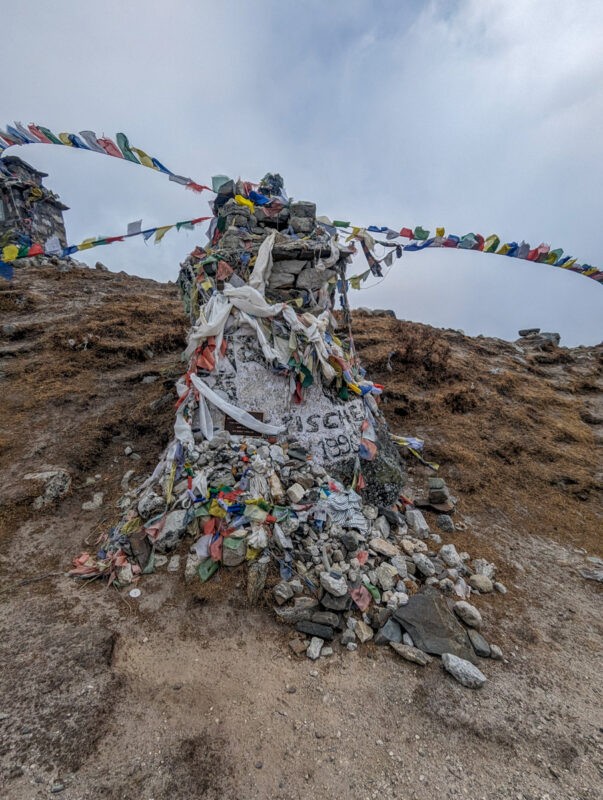
After passing the smaller Lobuche Base Camp, the trek continues for another 90 minutes to reach the village of Lobuche.
While the hike is not technically difficult aside from the uphill section, the increasing altitude makes the physical exertion feel more intense, and symptoms of altitude sickness may start to become more noticeable!
Lobuche is known for housing the world’s highest bakery ; it’s not as well stocked as Dingboche, but I was surprised to see it at all!
I can’t recommend our tea house in Loboche (Mother Earth)
It was notably less comfortable compared to previous nights, with no lights in the bedrooms and substandard toilet facilities. It also backed onto the stables, so we could smell animals from the corridor!
This is partially due to it being such high altitude but our tea house in Gorak Shep, 300 metres higher, was a lot better!
Day Eight – Loboche – Everest Base Camp – Gorak Shep

- Start Elevation: Lobuche – 4,900 meters (16,076 feet)
- End Elevation at EBC: Everest Base Camp – 5,364 meters (17,598 feet)
- End Elevation at Gorak Shep: Gorak Shep – 5,164 meters (16,942 feet)
- Elevation Gain: 464 meters (1,522 feet) to EBC
- Distance: Approximately 15 km (9.3 miles) total
- Difficulty: Challenging
Today’s the day!
We finally reached the base of the highest mountain in the world.
The morning journey from Lobuche to Gorak Shep had relatively gentle uphills, but at altitudes surpassing 5,000 meters, the air is notably thinner—oxygen levels hover around 55% of what they are at sea level.
This significant reduction in oxygen can make even slight inclines feel disproportionately challenging!
This was also the only area around Everest Base Camp where I felt like it was too busy. The pathway is narrow here, and lots of hikers were on their way to base camp, so it was quite chaotic at times!
You will catch your first view of Everest Base Camp (and the Khumbu icefall) here.
In Gorak Shep, a small settlement at 5,200 meters, we stopped for lunch and a brief rest. As I mentioned, the tea house here was much better than Loboche!
Then, it was time for the final leg to Everest Base Camp!
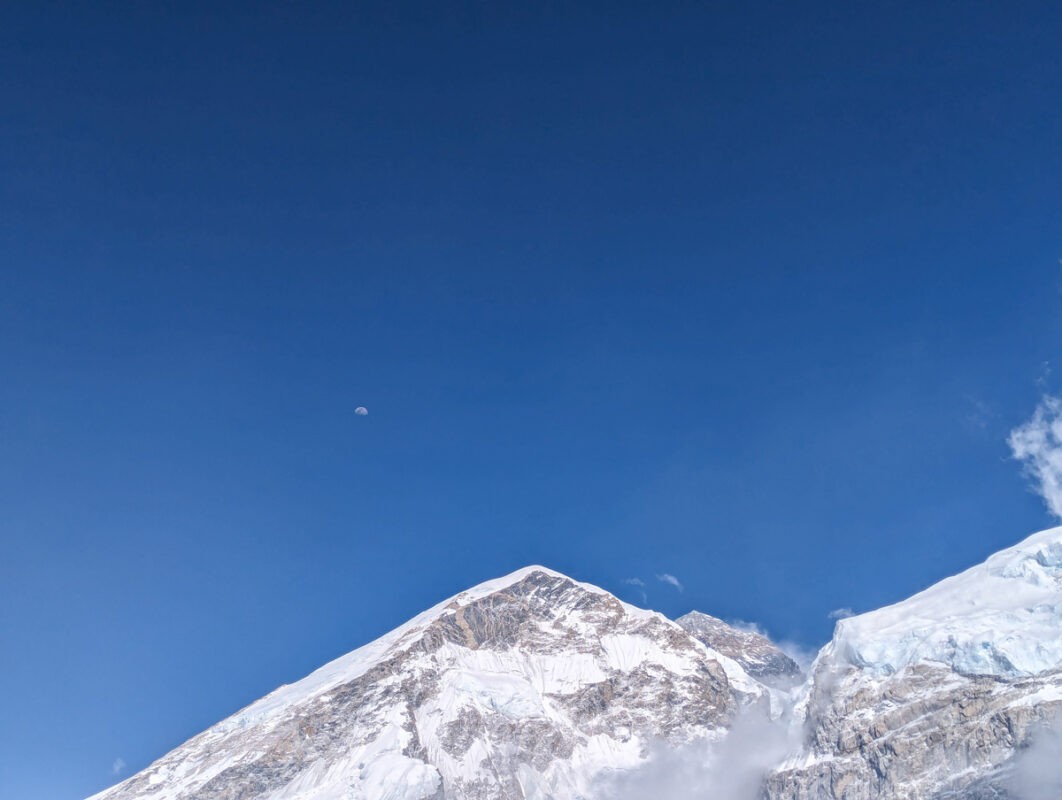
The trail followed the same pattern as the morning – a net incline of 164 metres, but a lot of downhill and uphill along the route.
After around 2.5 hours, we made it! Everest Base Camp is 5,364 metres high, and it’s where summiteers stay for around two months while preparing to hike to the summit of Mount Everest, the highest point in the world.
As a tourist, access is restricted to the periphery of the actual campsite, but even from the edges, the sense of adventure and the scale of the expeditions are palpable.
You can catch a view of Everest from the base camp, and of course take photos with the signature rock. Although, since 2024, there’s been a sign over part of it, so photos are more limited these days!
We stayed at Buddha Lodge , which, while basic, was remarkably better than Mother Earth in Loboche. For such high altitude, I was impressed with their food offerings. Try the hash brown!
Day Nine: Gorak Shep – Kala Patthar – Pangboche
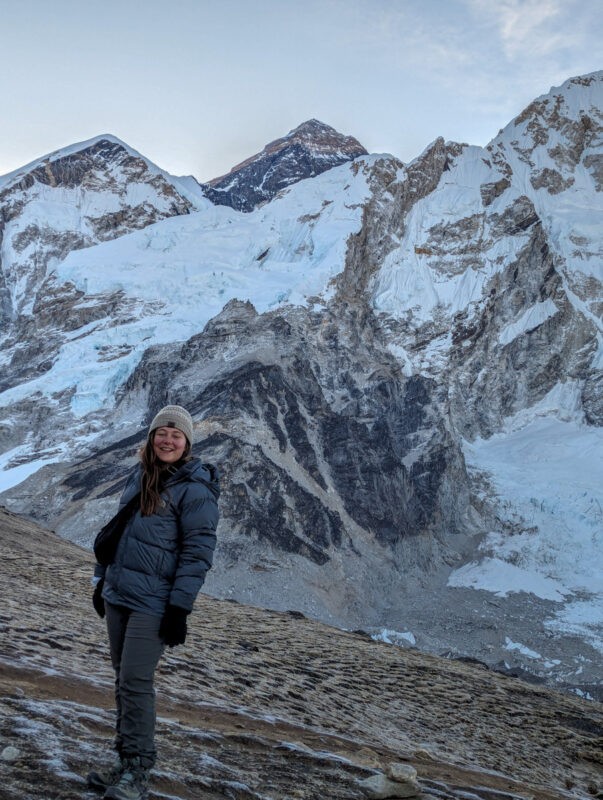
- Start Elevation: Gorak Shep – 5,164 meters (16,942 feet)
- Highest Point: Kala Patthar – 5,545 meters (18,192 feet) – this is the highest altitude that you’ll go on the trek
- End Elevation: Pangboche – 3,985 meters (13,074 feet)
- Distance: Approximately 15-16 km (9-10 miles)
- Difficulty: Challenging due to altitude and initial ascent, then easier descent
The best view of Everest isn’t actually from Everest Base Camp!
If you can handle even higher elevations, I’d recommend a pre-dawn hike from Gorak Shep to Kala Patthar.
This is just a steep climb from Gorak Shep, and while the full ascent to Kala Patthar’s peak is popular, a partial hike still offers incredible views of Everest and the surrounding peaks, some of which mark the border between Nepal and Tibet.
Not many of us in our group opted to do this trek, but I’d highly recommend it if you can get out of bed (we left at 5am). I found standing underneath the world’s highest mountains as the sun came up to be absolutely enchanting.
The trail then leads down! We retraced our steps, back to Loboche and then further downhill. The first hour was still up and down, which was tough, but then it swiftly got easier.
We were originally aiming for Periche on this day, which sits just below Dingboche, but ultimately decided to descend further to Pangboche, as we had daylight and knew that we’d feel better the further we descended.
The trail was mostly downhill, and was very easy for the most part.
We stayed at Buddha Lodge and Restaurant , which was quite cosy – we were the only people there!
Day Ten: Pangboche – Namche Bazar

- Start Elevation: Pangboche – 3,985 meters (13,074 feet)
- End Elevation: Namche Bazar – 3,440 meters (11,286 feet)
- Distance: Approximately 14-15 km (8.7-9.3 miles)
- Difficulty: Moderate
Continuing the descent, the path from Pangboche to Namche Bazar winds through beautiful Himalayan forests (the trees are back!) and traditional Sherpa villages.
Don’t forget to visit Tengboche Monastery on the way back if you didn’t while ascending.
The trek is mostly downhill, although just as the trail was up and down on the way up, it’s down and up on the way back! There is a particularly hilly section midway through the day.
Once you arrive in Namche, you’ll feel like you’re in the land of mod cons!
We had our first shower in a week and then went to the Irish pub for an alcoholic drink. The Irish pub also serves excellent pizza, easily the best thing I ate all week!
We stayed at Hotel 8848 again.
Day Eleven: Namche Bazar to Lukla

- Start Elevation: Namche Bazar – 3,440 meters (11,286 feet)
- End Elevation: Lukla – 2,860 meters (9,383 feet)
- Distance: Approximately 18-19 km (11-12 miles)
- Difficulty: Challenging due to the afternoon uphill section
It’s the final day of trekking!
The first descent is easy (I do recommend hiking poles, they’ll make this part of the trek much easier), but once we were down in the valley, we then had to climb uphill.
It wasn’t as hard as climbing at high altitudes, but on the last day of the trek, the very last thing I wanted to do was go uphill some more!
However, Lukla is a welcome respite from the trekking; here, you can purchase Everest souvenirs (although you can also get these in Kathmandu) and relax at one of the tea houses. We stayed at The Nest.
We stayed at The Nest , which is where we had lunch on the first day. We had en-suite bathrooms with showers, which could be made hot (for free!) but the beds were incredibly hard here. But, it was our last day in tea houses before we flew back to Kathmandu!
Day Eleven: Flight back to Ramechhap

Another 18 minute flight beckons on this day, but while it’s a very short time in the air, you could end up waiting a while for it!
For us, it wasn’t too bad. We stayed at The Nest (which is right by the airport) until it was time to check in, and then had around a 45 minute wait in the airport before we boarded.
Then, our van was waiting for us to take us back to Kathmandu!
If you have an international flight out of Nepal, I’d recommend leaving a couple of days before it, just in case the weather doesn’t play ball and you end up stuck in Lukla!
How many days do I need for the Everest Base Camp trek?
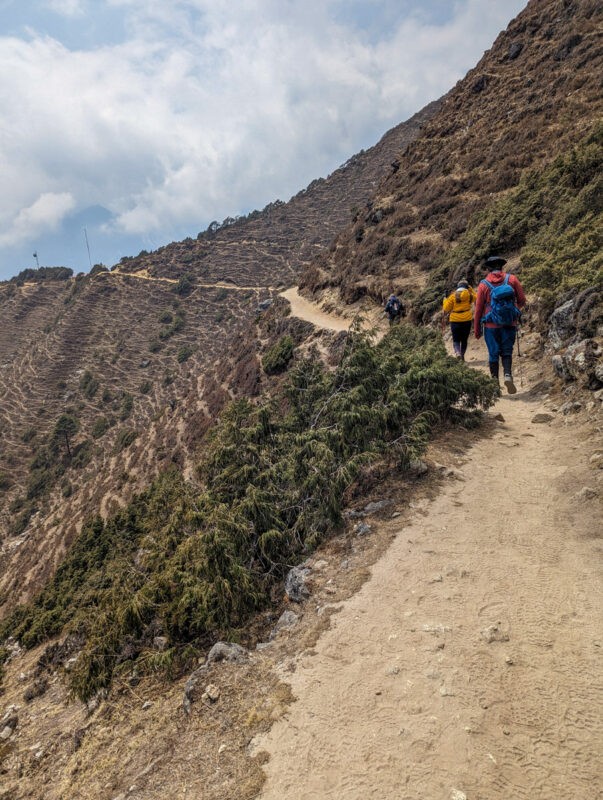
Most Everest Base Camp itineraries are 12 days long (not including days in Kathmandu). This is because most tourists only have two weeks off work, and it lets them fit it into their holiday time.
It’s possible to do it quicker, but I wouldn’t recommend it unless you have experience at similar altitudes. Acclimatisation is all-important on this hike! If you really need a day less, you could fit the descent into two days rather than three.
Plus, if you’re hiking independently and are able to, I’d recommend taking longer on the hike. Allowing an extra day for acclimatisation in Namche Bazar and stopping more on the way from Namche to base camp could help you avoid feeling unwell.
Having extra days to play with also helps in case of bad weather and flight cancellations.
When is the best time to hike to Everest Base Camp?
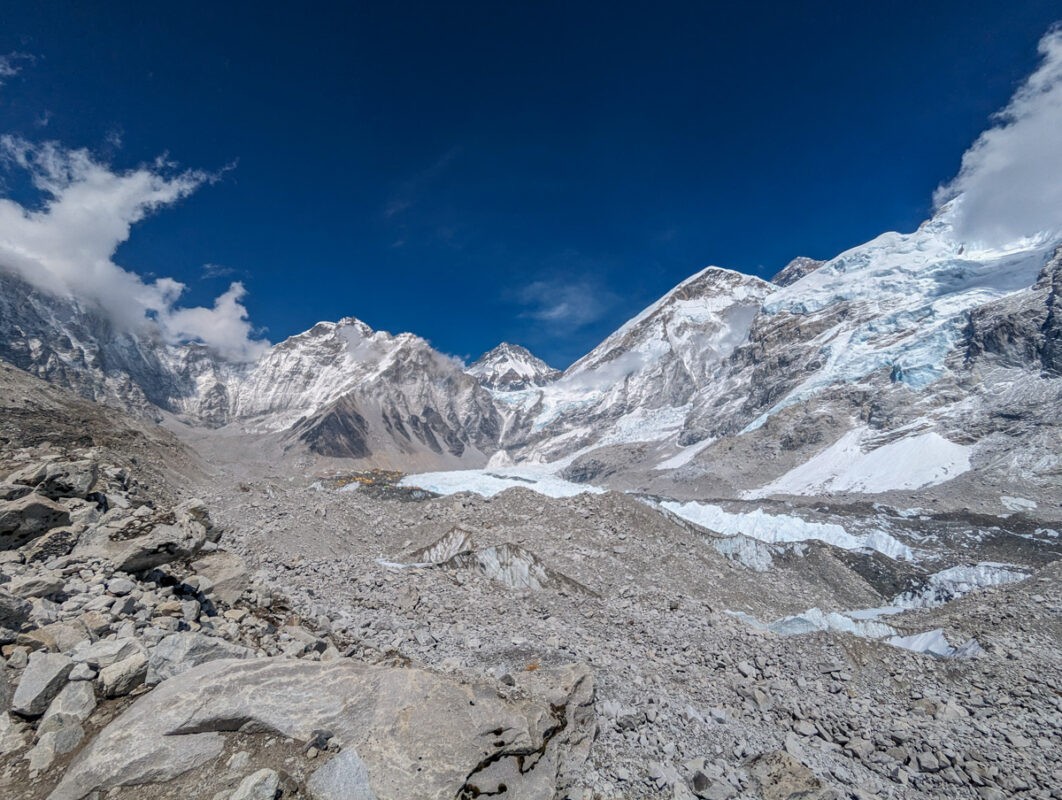
The best times to hike Everest Base Camp are during the pre-monsoon spring months of March, April and May, and the post-monsoon autumn months of October and November.
Spring (March, April and May):
Spring is a popular time as the weather is generally stable and relatively warm. Of course, it’ll be much colder in March than May!
Additionally, as it’s pre-monsoon, the likelihood of rain is lower so typically the trails are dry and safer for trekking.
It’s also when most summit attempts leave from Base Camp, so you’ll see most of the activity at the actual camp at this time (usually from mid-April through May). At other times of year (including March), base camp will be a lot quieter.
Autumn (October and November):
The Autumn season is another prime trekking time, with clear skies and temperate weather.
The air after the monsoon is fresh and clear, offering some of the best views of Everest and the surrounding Himalayas.
Plus, the trails aren’t as crowded as they are in the spring months – but you won’t see anywhere near the amount of activity at base camp.
Off-Peak Seasons
Trekking is possible year-round, but most hikers don’t attempt it in the monsoon season (June to early September) or winter.
In the monsoon season, trails can be slippery, mountain views obscured and there’s a much higher chance of landslides.
In the winter season, temperatures are freezing, with lots of snow and the chance of some passes being closed.
Do you need a guide to hike Everest Base Camp?

In the Everest region, unlike other areas in Nepal, hiring a guide is not mandatory. However, I couldn’t imagine doing the hike without a guide.
Our guide helped us manage health concerns like altitude sickness, trekking permits, ensured safe navigation on the trail (ours helped us deal with the many oxen that we had to share the trail with!), facilitated interactions with local communities, and handled logistics such as accommodations and flights.
Their knowledge and skills in addressing sudden medical issues or route changes are invaluable. Plus, hiring guides (and porters!) helps the local economy.
I’d also recommend hiring a porter for this reason; while it feels lazy not carrying your gear, porters are accustomed to the altitude and carrying heavy loads (although not too heavy! Ours could carry a maximum of 30kg, split between two people). Hiring them gives them work, which isn’t always easy to find in the remote Himalayas.
Are you ready to hike Everest Base Camp?
There’s no experience in the world quite like hiking to Everest Base Camp, seeing the world’s highest mountains and fathoming what an undertaking summitting Everest is. While it was tough, I’d recommend it to anyone who feels able to. You’ll quite literally feel like you’re on top of the world!
I have lots of blog posts and YouTube videos to come, and I’ve already been posting on TikTok and Instagram , so hopefully I’ll be covering all bases regarding the EBC trek. If you have any questions, feel free to reach out on social media and I’ll try my best to answer you!
- New Zealand
- The Philippines
- The Netherlands
- United Kingdom
- Inspiration
- Overland Itineraries
- Packing Lists
- Travel Tips
- Working Abroad
- Accomodation Guides
- Overland Travel
- Preserving Cultures
- Protecting Animals
- Living Abroad
- Tips & Tricks
- Tales from the Trails
The Ultimate Insider’s Guide to Trekking Everest Base Camp
CAMPING TIPS & TRICKS , Hiking / Camping / Tour Companies , TRAVEL
At 8,848 meters, 29,029 feet above sea level, Mt. Everest is the tallest mountain in the world, towering over the surrounding peaks in the Himalayas mountain range on the border between Nepal and Tibet.
Even if you’re not a diehard mountaineer, you can still explore this beautiful region of Nepal with a trek to Everest base camp (EBC).
Not only will you get lifelong bragging rights for completing the trek to base camp, but it’s also a beautiful trek in its own right. Amazing vista can be seen passing through the Sagarmatha National Park and the awe-inspiring Himalayas .
Although the trek takes about two weeks, it’s surprisingly accessible and has been completed by many first-time trekkers.
Everest Base Camp: A Brief Overview
Since the first successful summit in 1953 by Sir Edmund Hillary and Sherpa Tenzing Norgay, the imposing peak has attracted decades of adrenaline-seekers wishing to add their name to the list of successful summiteers. A good portion of these climbers never returned .
Despite the intimidating statistics, the sister trek through the picturesque Khumbu Valley to the base camp used by professional mountaineers is an attainable goal for many people.
Located at an altitude of 5,361 meters, 17,590 feet above sea level, you don’t need fancy equipment or mountaineering skills to reach EBC. Certainly, it takes just a positive attitude and a reasonable level of fitness.
There’s a sense of camaraderie and a tangible buzz in the air as the adrenaline of the would-be Everest summiteers infects everybody around them.
The scenery at these altitudes is breathtaking and varied, ranging from rhododendrons and pine fields to rivers; suspension bridges strung with prayer flags; glaciers, lakes, valleys, high mountain passes, and finally, the spectacular Himalayan mountain peaks!
The Sagarmatha National Park is home to rare animal species such as snow leopards and red pandas – though it’s very unlikely you’ll encounter them. You’ll frequently have to step aside (to the uphill side!) as you encounter yaks on the trail.
Whether you choose to follow the traditional EBC route or one of the alternative trails, it’s guaranteed to be an experience you’ll never forget.
In contrast to most multi-day treks where you’d be camping in a tent, trekkers to base camp stay in cozy tea houses. You can find several available in a range of budgets, which function as both hotels and restaurants.
The trek is dotted with Buddhist monasteries and tiny villages almost all the way up. The relaxed pace of the trek allows plenty of time for you to explore the villages and get to know the local Sherpa culture.
Mt. Everest is increasingly covered in garbage left behind by the hordes of people who have set out to conquer its lofty heights. When you go, please respect the environment and do your best to minimize waste.
The most popular time of year to do the Everest base camp trek is between February and May – the pre-monsoon season.
During these spring months, the weather is typically warm and dry and the mountains will be ablaze with colorful rhododendrons.
This is also peak season and while you’re unlikely to have the trails to yourself, you’ll enjoy a buzzing atmosphere at the tea houses on the way. This is also when most Everest climbers make their summit attempts.
The summer months bring the monsoon rains, resulting in slippery trails and a heightened risk of landslides. If that doesn’t deter you, the leeches and foggy weather might! It’s not recommended to attempt the trek in the summer.
It can also be difficult to fly into Lukla during the monsoon. Indeed, this is a good time to pick the Jiri trek over the classic EBC trek.
If you want fewer crowds, try going in September or October, the post-monsoon months, when you have the highest chance of clear skies, although temperatures are slightly colder.
You can even do the trek in the winter but be prepared for sub-zero temperatures most days and lots of snow.
Whenever you go, make sure you pack for unpredictable weather in case a snowstorm takes you by surprise.
Trekkers interested in the local culture might want to plan their trip dates around traditional holidays with celebrations in Kathmandu, such as Holi (February/March) or Indra Jatra (September).
Another thing to consider when planning your trip is flight prices, which can vary considerably. Check flights before booking as this might have a huge impact on when you want to go.
Lastly, be aware that it might be harder to find tour operators who provide treks in off-season months. Also, some of the paths might be closed.
Conversely, if you want a stab at actually sleeping in Everest Base Camp, then late spring is your best option. It will be rare to find tour operators who might be able to wrangle this.
Everest Base Camp Packing list
If this is your first multi-day trek, don’t forget to budget for all the equipment you’ll have to take with you.
You can choose between renting or buying your gear. Hikers who plan on doing more multi-day treks might want to invest in their own equipment.
If you’re doing a two-week trek, it makes more sense to rent your sleeping bag and down jacket. For trekkers who plan on trekking for a whole month, it makes more financial sense to buy.
The neighborhood of Thamel in Kathmandu offers plenty of options for buying and renting. However, the products on offer may be of questionable quality.
Further on, Namche Bazaar is a last-resort option if you find you’ve forgotten to pack any essentials. If you keep your receipts, then talk it over with the shop when buying. Some shops will buy your gear back from you, at the end of your trek, for a reduced price.
Almost everything available for sale along the trek has been carried up the mountain, either by yaks or people. This means things get more expensive the higher you go.
Pack strategically. This means bringing the items you can’t live without while avoiding overloading your backpack. Whether you hire a porter or decide to go solo, somebody will be lugging your things up the mountain. Indeed, think twice before including unnecessary items like an extra book or five spare shirts!
Aim to pack around 10kg if you’re carrying everything yourself, and 20-25kg if you’re getting help from a porter. Don’t forget that your water adds extra weight. Try packing your bag with full water bottles, to get a more accurate idea of how much you can bring.
This list is aimed at trekkers who will be sleeping in tea houses every night. Be aware that if you don’t book early enough, the tea houses may be sold out in high season.
If you think you might end up having to camp, Then you’ll need more supplies not covered on this list, such as a winter insulated tent , sleeping pad , etc.
What to Wear
The clothes you pack will depend on which season you’re visiting in. Make sure you have enough clothing to keep warm, especially in the evenings.
Layers are crucial, as temperatures and weather conditions will change drastically between day and night and as you ascend and descend in altitude.
Tea houses often only heat the common areas, and then only in the evenings, so bring warm clothes for lounging around at night.
The higher you get, the less likely you are to have power in your tea house, or only for a few hours as they’re run off solar power.
Base layers: Your base layer should be comfortable and moisture-wicking. Stay away from cotton; go for merino wool or synthetics .
Pack a long-sleeved shirt (avoid short sleeves as you’re more likely to get sunburnt) and long underwear, if only for the cold evenings.
Fleece mid-layer: You’ll probably be putting this on and taking it off with every mountain pass. Indeed, try to find one that will fit easily into your day pack.
Outer layer: Get a down jacket with a good warmth-to-weight ratio, as you’ll be carrying it much of the time.
Waterproof windbreaker and pants.
Hiking pants: Well-insulated trekking pants , or trekking pants that can turn into shorts.
Waterproof hiking boots. We can’t stress enough how important it is to break your hiking boots in properly before your trek.
Don’t forget to bring a pair of comfortable sneakers or sandals for the evenings and for bathroom runs.
Socks: Woollen hiking socks are worth the investment – bring a few pairs that can handle very cold temperatures for the higher altitudes, and look for flat seams and padded spots to reduce blisters.
Sock liners and Vaseline are two other good ways to prevent blisters . You should also bring a pair of warm socks for base camp.
Gaiters: These will be especially useful during the rainier months.
Gloves : Pack a thin pair of “inner” gloves and a very warm pair of outer gloves. There will be at least one or two days where your fingers will freeze otherwise – for example, the day you summit Kala Patthar.
Scarf/balaclava/buff: The trail to EBC gets infamously dusty, provoking the “ Khumbu cough ” that plagues many hikers. A buff or something similar will keep you warm as well as provide you with a layer to breathe through to minimize the amount of dust in your lungs.
Beanie and sun hat , preferably with neck cover, to protect against the sun .
Underwear and sports bras: You’ll probably be reusing these, so get good-quality, non-cotton ones.
Accessories
Drinking water: Most tour operators provide purified water. Avoid bottled water, as this is expensive on top of being an environmental disaster.
We recommend bringing two big reusable water bottles (or a water bladder for drinking on the go). Tablets take a while to work and it’s nice to have one water bottle ready to drink while the other one is getting purified.
You can also fill a bottle with hot water and sleep with it in your sleeping bag if you’re cold during the night. If you’re purifying your own water, bring water purification tablets , LifeStraw , or a Steri-pen. But remember, these need charging, and charging on the trail costs money.
You may wish to add flavor enhancers to your water. Unfortunately, at Gorak Shep the water is very mineralized so you’ll need to buy bottled water.
Showering: Whether or not you shower is up to you. Expect to pay around $5 for a hot shower. Some people rely on wet or backpacking body wipes , especially since wet hair is no fun in negative temperatures!
Sunglasses: The combination of snow and altitude is brutal on your eyes, so invest in good polarized sunglasses with wraparound arms.
Sleeping bag : The teahouses will provide blankets and pillows but you’ll want your own sleeping bag and pillowcase.
Find a mummy sleeping bag rated to -20° C – or colder, depending on the season. Consider bringing a silk liner , especially if you’re renting your sleeping bag.
Toiletries: Sunscreen , SPF chapstick (this is better than lip balm as there’s no need to smear it on with your grubby fingers), quick-drying towel, tissue, baby wipes, period supplies, compressed toilet paper tablets or biodegradable toilet paper (remove cardboard and keep in ziptop bag), hand sanitizer, toothbrush and toothpaste, etc.
Always bring toilet paper with you. Most bathrooms are squat toilets and are located only in villages.
Tip : wet wipes are more expensive than toilet paper on the trail, so if you have to choose, stock up on wet wipes and buy toilet paper when you run out.
Shewee: Ladies, you’ll be glad not to have to pull your pants down in the freezing high-altitude weather. If you need to pee, then I recommend using a portable pee device, like PeeBuddy Reusable Female Urination Device . You stand and use the portable pee funnel, so you don’t need to squat.
If you get your period on the trail and you’re not comfortable with using the DivaCup, another good option is to keep used pads/tampons in a ziptop bag and dispose of them in the next garbage can.
Personal first-aid kit: Bring diarrhea meds, altitude meds, antibiotics, ibuprofen, paracetamol, aspirin, bandaids, blister plasters, tape/trekker’s wool, Vaseline, cough drops (to beat the Khumbu cough), cold medicine, rehydration salts.
Tour operators should provide the rest. Don’t forget to get your travel vaccines before you go.
TSA approved padlock for your luggage.
Backpack: What you pack your gear in will depend on whether you’re using porters. Most porters prefer you to pack your things in a soft-sided duffel bag. Check with the tour operator in case they provide these for you.
If you have a porter, then you’ll only need a daypack for yourself. If you’re not hiring a porter, then bring a collapsible daypack anyway in addition to your backpack. This is so you can leave your big backpack in the tea house during the one-day acclimatization hikes.
Try to get a backpack with straps for hiking poles and zippers to open it from the sides. Not to mention, you won’t have to dig everything out of your bag whenever you want to access something.
Dry bag or plastic cover for your backpack and daypack to prevent water ingress.
Hiking poles : These are a must! All the treks listed here will take you uphill, downhill, uphill and downhill again. Hiking poles will save your knees, and they’ll come in handy on slippery trails during the wet season.
Headlamp or flashlight : You’ll be glad to have this in the evenings after the power goes out, and during early-morning or late-night hikes. Remember to bring extra batteries.
Trekking map: If you’re going independently, a good trekking guidebook is essential – Lonely Planet is highly recommended.
Ziptop bags: These always come in handy for protecting electronics, etc.
Camera or GoPro with memory card and extra batteries.
Money: There are ATMs at select points such as Lukla and Namche Bazaar. But these have low daily withdrawal limits and high commission fees. What’s more, they have been known to take money out of your account without actually dispensing it to you.
Since currency exchange rates on the trail are sky-high, it’s best to bring a stash of local rupees with you. You’ll need rupees to pay for meals, showers, tips, etc.
Wi-Fi: A good option for staying connected is to buy a local sim card. It will give you data to about 4000m altitudes, and sometimes in EBC itself.
You can also check Everest Link for Wi-Fi data packages. The connection is supposedly available in most teahouses along the way, but it can be slow and unreliable so don’t depend on it too much.
Top Tip : Beware of phone updates. These will eat through your Wi-Fi and data limits before you realize what just happened!
Entertainment: EBC treks usually only schedule a few hours of hiking a day, to allow you time to acclimatize. Bring books, a Kindle , cards or other games for the many hours of downtime. Certainly, bring a journal so you can remember this once-in-a-lifetime experience!
Solar charger: Many teahouses offer power points where you can charge your devices for a nominal fee. Also, don’t forget to bring an adapter. It’s a good idea to bring your own solar-powered charger and extra batteries to minimize costs.
Tip : Keep batteries, base layers , and anything else you don’t want freezing in your sleeping bag with you overnight. Keep your phone in flight mode to save power.
Important documents: Bring printouts of your travel insurance information. And make sure one of your travel buddies knows what to do and whom to contact in case of an emergency.
Bring your passport, visas, money, etc. – I always keep these documents in a zip-top bag.
Trekking solo? Bring a safety whistle , compass , pocket knife , & duct tape, especially on the less-crowded trails
High-calorie snacks: These will make a huge difference to your experience. Snacks are exceedingly expensive on the trail, and they provide welcome calories on tough trekking days.
You’ll have to decide how many you want to bring and which ones you want to buy along the trail.
Cloth bags : Many trekkers use these to separate dirty laundry and organize different outfits.
Earplugs: You’ll be glad for these when the tea houses are alive with the sound of Khumbu coughs.
A Note on Trekking Insurance
Be very careful when purchasing travel insurance, because regular policies usually stop covering you once you ascend higher than 3,000m/9,840ft.
At these altitudes, you have a higher chance of getting Acute Mountain Sickness. Also, there’s a pretty good chance you’ll have to be airlifted out to a hospital for injuries . To clarify, injuries like a pulled muscle or twisted ankle at sea level can be more serious at higher altitudes.
Because of these higher costs and risks , insurance companies will charge you a premium for high-altitude trekking insurance.
Luckily, there’s no shortage of insurance companies that offer travel insurance specifically tailored to Everest Base Camp trekkers.
When purchasing a policy, make sure you’re covered for trekking up to altitudes of 6,000m/19,685ft. In addition, ensure it has search and rescue costs, preferably by helicopter.
Don’t forget to check if you’re covered for different travel-related illnesses (and make sure you get your vaccinations before going!).
It’s also nice to have compensation for delayed or canceled flights and repatriation in case of death (hopefully you won’t be needing this one).
Check the clause about lost, stolen or damaged luggage to see if it will cover most of the cost of your hiking gear.
If you’re traveling in winter or shoulder season, then check for trip cancelation insurance. This is to ensure you’re covered if your trek is canceled due to weather.
You’ll likely have other considerations depending on your personal situation. Don’t just take our advice for it – remember to do your research, ask questions and read the fine print of your travel insurance policy before you purchase.
I always keep my travel insurance information handy while on the trek. Additionally, I pass it along to someone else in my group. This is so they know whom to contact in case of an emergency.
Some travel insurance providers require you to confirm with them before ordering a helicopter. Check out this option on getting trekking travel insurance for more information.
How to Avoid Altitude Sickness
Most tour operators organize a relaxed trekking schedule and follow the mantra “climb high, sleep low”. In essence, this is to avoid the risk of altitude sickness.
Take it slow – once you finish hiking for the day you’ll have a lot of dead hours in the teahouse. For this reason there’s really no point in racing there.
It’s important to respect the acclimatization days. The acclimatization hikes are designed to help you adjust to tomorrow’s altitude.
Try to drink 3-4 liters of water a day, as dehydration will make the altitude sickness way worse. It also goes without saying that you shouldn’t drink caffeine or alcohol or smoke during your trek.
If you can, then cut out these vices about a week before you start hiking. So that you won’t suffer from withdrawal headaches.
Many people swear by Diamox as a preventative drug against AMS. It’s your choice whether to take this or not. I personally found the tingling fingers and toes to be very off-putting, but it probably helped me acclimatize.
Altitude sickness is unpredictable and doesn’t discriminate based on fitness or age. Listen to your body and descend immediately if you think you have signs of Acute Mountain Sickness.
Check out our article on altitude sickness for a more detailed overview.
Choosing a Tour Operator
Every year there are rumors that the Nepali government will make it compulsory to go with a guide.. But so far, it’s still possible to undertake the trek to EBC on your own.
Unless you’re going in high season, you’ll can drop in at tea houses and get a bed without a reservation.
Independent trekkers can choose whether to hike all by themselves. While others choose between ring a porter, a guide, or a guide and a porter. A guide will speak some English and can help with booking accommodation. However, a porter probably won’t speak English and will only carry your bag.
You can also hire one person who acts as a guide and a porter. Another upside to hiring a guide is that you’ll be providing someone with a job. And in turn, you’ll get to immerse yourself in the Nepali culture.
Alternately, you can opt to join a guided trek with a tour operator. While this is pricier, it’s a good choice for people who have never done such a long, high-altitude trek before.
Tour operators typically arrange flights, airport transfers, accommodation, visas and permits, porters and guides. Western tour operators will usually charge more, but provide a more trustworthy service. You can expect to pay about twice as much for a Western tour operator.
Check to see if your tour operator is registered with the Trekking Agencies Association of Nepal (TAAN). TAAN regulates trekking agencies in Nepal to ensure fair treatment of employees, respect for local communities and preservation of the environment.
The Kilimanjaro Porters Assistance Project mission is to improve the working conditions of porters. They advocate for fair treatment and wages, lend free mountaineering clothing, and encourage them to work for only ethical companies. Through providing education and training opportunities, guides and porters have received classes on porters rights, Leave No Trace and are certified in First Aid.
Please make every effort to ensure the porters and guides are dressed properly, stay within the weight limit including their own luggage. Also, ensure they have adequate sleeping arrangements and insurance and are paid a fair wage.
It’s better to go with companies that employ their porters and guides full-time instead of freelance because there’s a better chance the company is providing them with benefits, sick days and health insurance.
Tipping is always a tricky subject and suggested rates will depend on whom you ask. Aim for around 15 percent of salary (if you’re traveling in a group, this number refers to the total pooled tip) per porter and/or guide, and adjust accordingly.
The classic Everest Base Camp trek winds through the Khumbu valley; once reaching Everest Base Camp, you’ll retrace your steps back down to Lukla for the return flight to Kathmandu.
If you’re interested in escaping the crowds or doing circular routes that don’t involve retracing your steps, there’s a variety of alternate routes to choose from.
You can also opt to tack small detours onto your classic EBC trek. This is especially doable if you’re traveling independently or in a small group.
You shouldn’t have any trouble booking your trek, even on the classic EBC trek.
Classic Everest Base Camp trek
The classic Everest Base Camp trek takes about 14 days, including time in Kathmandu before and after.
From Kathmandu, you’ll fly into Lukla Airport (2,860m/9,383ft) with its famously short runway – try to sit on the left side of the plane so you can catch your first views of Mt. Everest.
It’s a good idea to leave yourself a few buffer days, as Lukla flights are often delayed due to weather. Flights should be included in your tour price; otherwise they’re about USD 300, plus USD 100 for your guide’s ticket.
From the airport, you’ll trek to Phakding for the night.
The next day you’ll set out from Phakding and follow the Dudh Koshi River, crossing suspension bridges and pine forests until you reach the Namche Bazaar (3,440m/11,286ft), in the Sagarmatha National Park UNESCO World Heritage Site .
Namche Bazaar is the region’s principal trading point, so use this opportunity to stock up on supplies you might have forgotten. If you’re there on Saturday, then don’t miss the market. From here you can also catch a peak of Everest.
You’ll take a day to acclimatize in Namche Bazaar – you can make the most of the Wi-Fi, stock up on any supplies you forgot, check out the Sherpa museum or just tool around the village.
The day after you’ll follow the former Tibet-Nepal trading route via Thame to Tengboche. These villages are known for legendary views, where you can visit one of the region’s biggest monasteries .
Next you’ll hike through Phangboche to Pheriche while admiring the views of Ama Dablam. You might be interested to know that Pheriche is where the Himalayan Rescue Association makes its base – but hopefully you won’t need to use this information!
Most people stay in Pheriche for a day to acclimatize and visit local attractions like the Imja Lake or Dingboche village, which boasts views of Lhotse and Island Peak.
Now that you’re rested, you’ll be ready to tackle the trek to Lobuche, which features a 600m/1,969ft elevation gain. You’ll skirt the perilous Khumbu Glacier and witness the many memorials to sherpas and climbers who perished in their attempt to climb Everest.
From Lobuche you’ll set out towards Gorak Shep, which is the world’s highest permanently inhabited village.
Finally, it’s time to push on through the moraine towards Everest Base Camp! Since actual summiteers of Everest have priority, don’t expect to spend too long there or even be allowed inside the base camp itself.
But don’t worry, the adrenaline-filled atmosphere extends all the way down to the trekker stop point! From here you’ll go back down to Gorak Shep for the night.
You can’t actually see the peak of Mt. Everest from Everest Base Camp, so the next day you’ll make a steep ascent up to the summit of Kala Patthar (5545m/ 18,192ft) to catch amazing views of Everest, Nuptse (7,861m/25,791ft) and Lhotse (8,516m/27,940ft).
Most groups try to do this at sunset on the same day as they reach EBC, or at sunrise the next morning, when Mt. Everest sometimes turns pink in the early-morning light.
Forging on ahead, you’ll descend to Dingboche or Pheriche, and from there past Tengboche and back to Namche Bazaar the next day. Keep an eye out for the massive fields of wild rhododendrons if you’re visiting in the spring!
Your last day of trekking will take you back to Lukla, where you’ll spend the night before catching the flight to Kathmandu.
- Pros : Comparatively gentle altitude profile, can be done independently
- Cons : Have to retrace steps on the way down, can be crowded
- Length : ~130km (12-14 days)
- Highest point : Kala Patthar (5545m/ 18,192ft)
Gokyo Lakes Trek
The Gokyo Lakes Trek is popular for its beautiful glacial lakes , nestled in the quiet Gokyo valley.
Like the classic Everest Base Camp trek, the Gokyo Lakes trek starts at Lukla, breaking off towards the northwest at the Namche Bazaar.
This trek is considered slightly more challenging than the classic EBC trek, with steeper ascents and more time spent at high altitudes.
It takes 2-3 days longer, detouring around some of the most crowded sections of the classic base camp trek but still finishing at Everest Base Camp.
You’ll see glacial lakes and summit Gokyo Ri (5,357m/17,575ft) where you’ll earn views of Everest, Lhotse and Cho Oyu (8,201m/26,906ft).
Fly into Kathmandu, spend a few days acclimatizing and then take another flight to Lukla. The next day, you’ll trek down through the Dudh Koshi Valley to Phakding past several Buddhist sites.
Hiking through pine forests and along the Dudh Koshi River, you’ll cross several suspension bridges including the Hillary Suspension Bridge. After entering the Sagarmatha National Park, you’ll continue hiking until the Namche Bazaar.
You’ll then separate from the classic EBC trek and head northwest towards Dole along the Dudh Koshi valley. You’ll get some of the first views of Everest, Lhotse and Ama Dablam today.
The next day brings a steep climb towards Machhermo, which is populated with yaks in the summer.
Allow yourself a day to acclimatize and enjoy views of Ngozumpa Glacier (the biggest glacier in the Himalayas). Once you’ve enjoyed the glacier, trek to the Gokyo lakes and you’ll eventually reach Gokyo village. If you are tired by now, you’re in luck because this is where you’ll bed down for the night.
This is another popular time to take an acclimatization rest day and explore the surrounding lakes, or summit Gokyo Ri, which stands almost 5,500m/18,045ft above sea level.
Stop to take in the stunning views of Everest, Lhotse and Cho Oyu, then continue back down to the Ngozumpa glacier and on into Dragnag.
The next day is a tough one. You’ll traverse Cho La, one of the “Three Passes” (5,420m/17,782ft), cross a glacier and then spend the night in Zonglha.
Joining up with the classic EBC trek, you’ll stop for a moment of reflection at the memorials to sherpas and climbers who perished in their attempts to climb Everest, and then continue on to Lobuche for the night.
From Lobuche, you’ll skirt the Khumbu glacier, hiking up past Gorak Shep and finally you’ll reach Everest Base Camp! Enjoy it while it lasts, because the priority at EBC is the Everest summiteers, especially in the spring months.
You’ll hike back down to Gorak Shep alongside views of the Khumbu icefall . Part of the highest glacier on Earth, the icefall’s deadly crevasses, unstable seracs and unpredictable avalanches have taken dozens of lives.
The next day you’ll hike up Kala Patthar, with more views of Everest and the neighboring mountain peaks, and then down to Dingboche along the classic EBC route.
It’s time to return to Namche Bazaar. The day after you’ll hike back to Lukla through the Dudh Koshi valley, and then fly into Kathmandu.
Because the trek is longer, expect to pay more than you would for the classic EBC trek. Trekkers are advised not to attempt this trek independently, due to the increased difficulty and the fact that there are fewer people on the routes.
Like the classic EBC trek, the best time to go is during spring or fall. Because the trek isn’t as popular, you shouldn’t have to worry about crowds for most of the way, so feel free to go during peak season.
- Pros : Fewer crowds, more challenging, more sights, get to summit a peak, see the world’s highest freshwater lake system, prettier landscapes than classic trek, circular route so no need to retrace steps
- Cons : More expensive than classic EBC trek
- Length : ~220km/136 miles (16-17 days, including a few days in Kathmandu before and after)
- Highest point : Kala Patthar (5545m/18,192ft)
Jiri to Everest Base Camp
This old-school route mirrors the route taken by the first Everest summiteers in the 1950’s, starting with an 8-hour bus ride from Kathmandu to Jiri instead of flying into Lukla.
From Jiri, you’ll pass through the towns of Sete, Junbesi and Numtala in the Solu Khumbu region.
After reaching Lukla, you’ll join up with the classic EBC trek, passing through Phakding, Namche Bazaar, Tengboche, Pheriche and Gorak Shep.
In total, the Jiri route takes about 5-6 days longer than the classic route.
Jiri route trekkers will have the chance to spend a lot more time with the locals. You’ll also spend more time at low altitudes – the route starts at just 1,800m/5,905ft above sea level – meaning landscapes will forests and streams with actual running water.
Much of the trek is off the beaten path, with fewer crowds than the EBC classic trek.
Tool around Kathmandu for a day and then take an 8-hour (190km/118 mile) bus ride, following the Sun Koshi River to Jiri and then Shivalaya.
The next day, you’ll cross a suspension bridge over the river and then explore several tea houses. Go through the Deorali Pass, taking a moment to check out the prayer flags and decorated walls, and then head down to Bhandar for the night.
From Bhandar, you’ll walk through fields and forests before embarking on a steep descent t
owards the village of Kenja. Uphill again, you’ll traverse the Lamjura Pass and arrive at the town of Sete.
The next day, you’ll return to the Lamjura Pass and pass through magnificent fields of pine trees, magnolia and rhododendrons. Without a doubt, you’ll appreciate the stunning mountain views. Next,hike down the other side and you’ll arrive at the town of Junbesi.
Back into the forest, you’ll see Mt. Everest for the first time. You’ll then cross the Ringmo Khola suspension bridge and arrive at the village of Ringmo with its gorgeous Tibetan architecture. Another forest and you’ll be at Nunthala.
In the morning, you’ll head out towards the Dudh Koshi River, crossing another impressive suspension bridge on your way to Bupsa.
The next few days will take you to higher altitudes as you pass through forests with monkeys and several small villages.
Arriving in Lukla, you’ll join up with the classic EBC trek. After reaching Everest Base Camp, you’ll summit Kala Patthar for the obligatory views of Mt. Everest at dawn and then return through Gorak Shep, Namche Bazaar and finally Lukla, for your flight back to Kathmandu.
Like the classic Everest trek, the Jiri route is best undertaken in spring or fall. Caution: some parts of the Jiri trek may be closed in the winter, so we don’t recommend going during this season.
The Jiri route is only slightly more difficult than the classic Everest Base Camp route, due to its longer duration.
The average day of hiking comprises 5-6 hours, covering about 15km/9 miles. On the bright side, due to the more gradual ascent compared with the classic trek, you’re less likely to get altitude sickness.
- Pros : More authentic, less touristy, chance to see Solo Khumbu landscapes (terraced farmland, forests, Dudh Koshi river, sherpas), gradual acclimatization
- Cons : 8-hour bus ride (but scenic!)
- Length : ~250km/155 miles (22 days, of which 18 days of trekking)
- Highest point : Kala Patthar (5,545m/ 18,192ft)
Three Passes Trek
As you might infer from the name, the Three Passes trek takes you across three high mountain passes (all higher than 5,000m/16,400ft). Thus, making it more difficult than the classic EBC trek.
After reaching Namche Bazaar, the Three Passes trek splits off from the classic trek. This takes you towards Thame and the Nangpa Valley. The trek takes around 19 days in total, of which 14-15 will be spent trekking. Getting a guide is highly recommended.
After flying into Lukla from Kathmandu, you’ll work your way down to Phakding.
The next day will take you across several suspension bridges on the way to Namche Bazaar. You’ll be there for a day of acclimatizing. After which you’ll split off from the classic EBC route and head to Thame.
Crossing the Bhote Koshi river, you’ll reach Lumde and catch your first good views of the mountain peaks. The next day, you’ll tackle the first pass.
The Renjo La (5,360m/17,585ft) lies near the Dudh Koshi valley and will reward you with views of Everest. Then you’ll pass the Gokyo lakes and the village of Gokyo, where you’ll summit Gokyo Ri and catch sight of Cho Oyu.
After spending some time acclimatizing in Gokyo, you’ll walk across the Ngozumpa Glacier. This is Nepal’s largest glacier, and you’ll then spend the night in Dragnag.
The next day is notorious. You’ll traverse the next pass, Cho La (5,420m/17,782 ft), which has a glacier and prayer flags at the top. On the other side of the pass lies Zonglha.
Joining back up with the base camp trek, you’ll visit Lobuche and Gorak Shep and take in views of the Khumbu Glacier, Everest, Lhotse and Nuptse.
You’ll explore Everest Base Camp and summit Kala Patthar before retracing your steps back through Gorak Shep and Lobuche.
The trek keeps on going, past the Kongma La pass (5,535m/18,159ft), down into the Chukkung valley and up to the summit of Chukking Ri (5,550m/18,209ft) with more mountain views.
You’ll trek through Dingboche, with its views over the Khumbu Valley. Eventually, you hike down through the rhododendron fields and the village of Khumjung, ending back at the Namche Bazaar.
From here you’ll cross the Dudh Koshi, following the classic EBC route back down to Lukla.
This trek can also be done backwards; it’s up to you whether you want to head clockwise or counter-clockwise after the Namche Bazaar.
Many people recommend doing the trek counter-clockwise to avoid crossing the difficult Renjo La Pass right off the bat.
You’re best off doing this trek with a tour operator, as it’s quite off the beaten path.
- Pros : See a little bit of everything, uncrowded trails, challenging elevation profile
- Cons : Riskier terrain than classic EBC trail, long stretches with no facilities
- Length : ~21 days (150km/90 miles)
- Highest point : Chukking Ri (5,550m/18,209ft)
Island Peak (Imja Tse)
Experienced trekkers who wish to try their hand at mountaineering might be interested in summiting Island Peak (6,189 m/20,305 ft).
To master the glaciers and icy headwall during the ascent of these peaks, you’ll need to use crampons, an ice ax and potentially a ladder and ropes to cross the crevasses, depending on the weather.
Tour operators claim you can learn these skills on the fly, but it’s better to have some prior mountaineering experience before you tackle these routes, which are significantly more challenging.
That being said, Island Peak is a relatively “easy” climb as far as climbs go, so it’s a good option if you’re looking to expand your repertoire.
Since a detailed itinerary of Island Peak is outside the scope of this article, be aware that the general packing list doesn’t include the specialized mountaineering equipment you need for this trek.
Likewise, ascending Island Peak takes you above 6,000m and will probably not be covered by standard travel insurance providers, so check with your local mountaineering association for options.
Practical Information
What will I eat? How much will the trip cost? These are the questions most frequently asked.
As a general rule, the tea house lodgings themselves are very, very cheap with the condition that you eat dinner and breakfast in the same lodge.
This is where your costs will really add up – food is very expensive – so check with your tour operator when booking to see if meals are included.
Food on the trek is repetitive but nourishing. The meals are carb-heavy – think pasta dishes, dahl baht or “sherpa stew” with veggies and noodles.
What other trek offers the convenience of stopping in at a tea house or bakery for a hot lunch or freshly baked pastry? Just be prepared for stretches where you won’t see a tea house for several hours.
Hot drinks are readily available, and a popular treat is a deep-fried Mars bar. Don’t leave without trying one!
Most people recommend going vegetarian during the trek. Sagarmatha National Park has a no-kill policy so all meat has to be carried up by porters or yaks and is never very fresh, so there’s a real risk of getting sick.
Much of the garbage that’s disposed of in the villages ends up getting burned on-site, which really makes you consider the impact of your waste.
Before wantonly throwing plastic into the garbage cans, try to reduce what you use and pack out as much as you can.
The budget for your trip will vary widely depending on whether you’re trekking independently or going with a tour operator.
If you are booking with a tour operator, the flight price and permit prices should be included – usually you’ll have to pay for your guide’s flight as well.
Tour prices run from about USD 1000 to 3000 depending whether you go local or get a Western tour operator.
Budget around USD 400 for the flight from Kathmandu to Lukla Airport, including your guide’s ticket. If you go independently, consider getting help from a local agency for buying your flight tickets.
Flights have a way of being overbooked and you’re more likely to get on the plane if a local agent is vouching for you. On this note, factor in a few buffer days for your flight from Lukla back to Kathmandu, in case of weather or overbooking delays.
Nationals of all countries except India will need a visa to enter Nepal, which costs USD 25 for 15 days, USD 40 for 30 days and USD 100 for 90 days.
You’re best off getting the 30-day visa even if your trek is only scheduled to take two weeks, as weather and other factors might extend the trip unexpectedly. For the most part, you can get your visa when you land in Nepal.
It used to be mandatory to purchase a Trekkers Information Management System (TIMS) card, but the laws on this are constantly changing and there is a new local tax being charged, so check before you go unless your tour operator is arranging paperwork for you.
You will need a Sagarmatha National Park entry permit, which you can get ahead of time or at Monjo, when entering the park.
The price of the permits will normally be included in the trip price if going with a tour operator. Bring several passport photos for the permits.
All Set: Are You Ready?
The name “Everest” may sound intimidating, but this is actually one of the more approachable multi-day treks out there.
If you have a reasonable fitness level and are comfortable walking uphill for several hours a day carrying a heavy backpack, then you should be able to complete the trek. The key is to go slowly to avoid altitude sickness.
You don’t need special mountaineering know-how or an incredible level of fitness. The hike to EBC is a relaxed one, as hikes go.
The pace is slow, to allow you the time to acclimatize, so you’ll have plenty of free hours to peruse the village cafés, tuck into a slice of apple pie and snuggle up with a good book or make friends over a game of cards back at the teahouse.
That being said, of course it’s a good idea to prepare for the trek by hitting the gym in the months prior to your departure, and plenty of practice hikes starting two months before you go.
Don’t forget to practice hiking with a heavy backpack on! Check out this article for more tips on preparing for an uphill hike .
In total, the trek is around 130km/81 miles round trip, with an elevation gain of 2,685m/8,809ft between Lukla (2,860 m) and Kala Patthar (5,545 m).
It’s usually done in just under two weeks, including rest days for acclimatization. The outward leg will take longer and you can expect to trek 5-6 hours per trekking day, covering an average of 15km/9 miles.
The hike from EBC back to Lukla will go much faster since you’ll already be acclimatized.
Plenty of people with no prior trekking experience manage to complete the EBC trek and you can too! Like any non-technical trek at altitude , the key is a proper pace, a decent level of fitness and most of all, a good attitude!
Have you been trekking in Nepal? Let us know about it in the comments section below!
Disclaimer : This post is for information only and is not intended to replace the advice of an experienced guide. Always do your research and check with local weather stations, etc. before attempting to undertake treks in the wild. Distances are approximate and routes may vary depending on your tour operator.
Photos via Depositphotos.
- Insider’s Guide to Hiking Machu Picchu
- Inspirational Mountains: Exciting Summits for Ordinary Hikers
- Climbing Kilimanjaro: Everything you Need to Know
- Four Pass Loop (This Hiking Trail Should Be at the Top of Your List)
Best Summer Sleeping Bags for Backpacking
Kilimanjaro packing list, kammok mantis ul hammock tent review, the absolute best lumbar pack for hiking, best backpacking saw: cutting edge reviews, discover the best pop-up tents: expert reviews & buying tips, camp coffee: how to stay caffeinated on the trail, the ultimate beach camping essentials: a comprehensive guide, how to build a campfire safely and quickly, the ultimate guide to using a tent footprint, best bivy sacks on the market in 2024, camping stove reviewed – best of 2024 guide, how to keep bears out of your food: bags, canisters...
Last update on 2024-05-16 / Affiliate links / Images from Amazon Product Advertising API
Automated page speed optimizations for fast site performance
How to trek to Everest Base Camp

Jun 20, 2023 • 10 min read
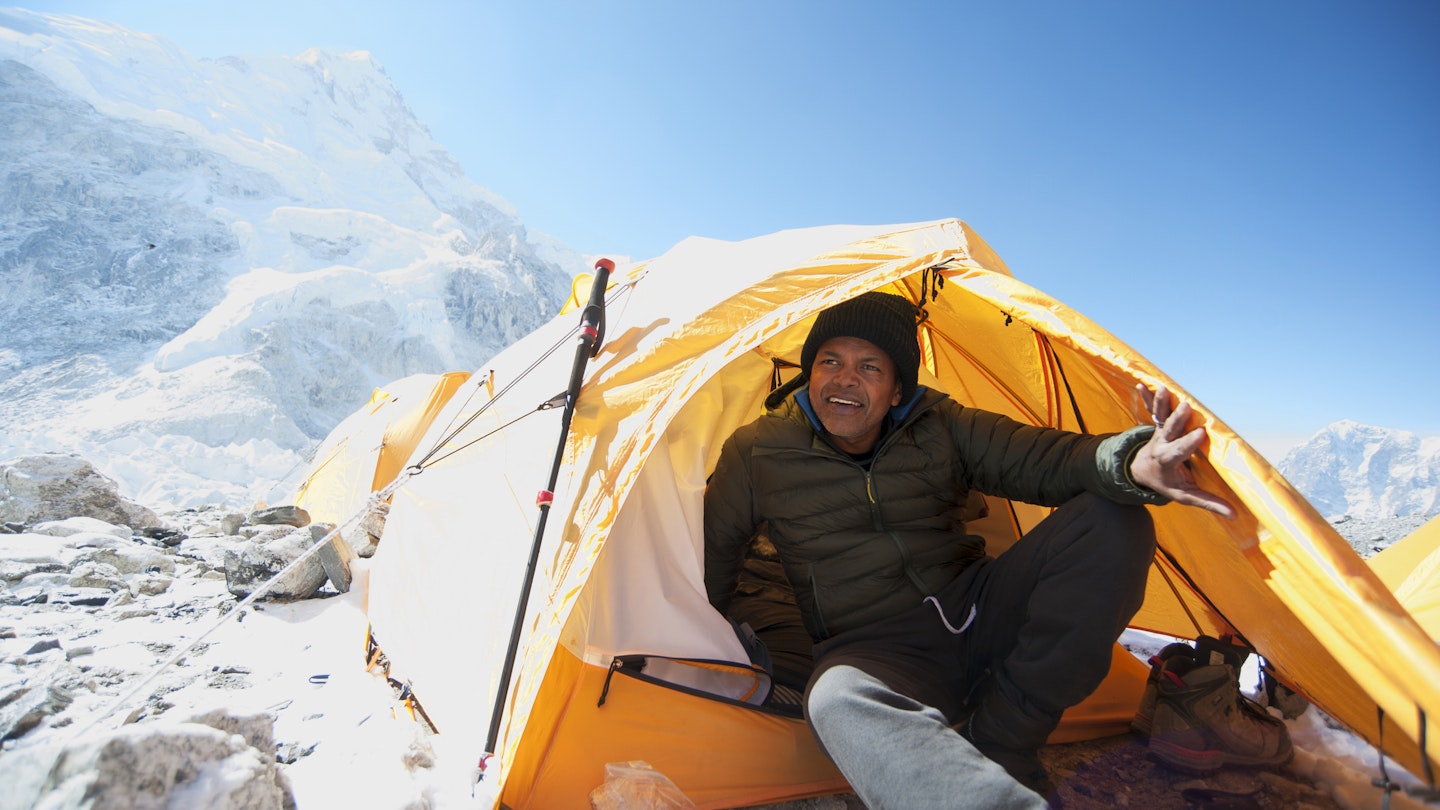
From permits to teahouses, here's everything you need to know about trekking to Everest Base Camp © Mint Images / Getty Images
Top of many people's travel bucket lists, the trek to Everest Base Camp is often the first thing people think about when they start dreaming of a trip to Nepal .
The walk takes trekkers past Sherpa villages and Tibetan-style monasteries, right up into the heart of the high Himalaya, into a breathtaking world (literally) of iconic glaciers, lakes and the tallest peaks on earth. It's probably the world's most famous trek.
But what is it actually like to trek to Base Camp? Is it something within your capabilities or budget? What should you bring? And, most importantly, can you get a proper coffee en route?
I just returned from trekking to Everest Base Camp for Lonely Planet's Nepal guide . Here’s what I think you need to know.
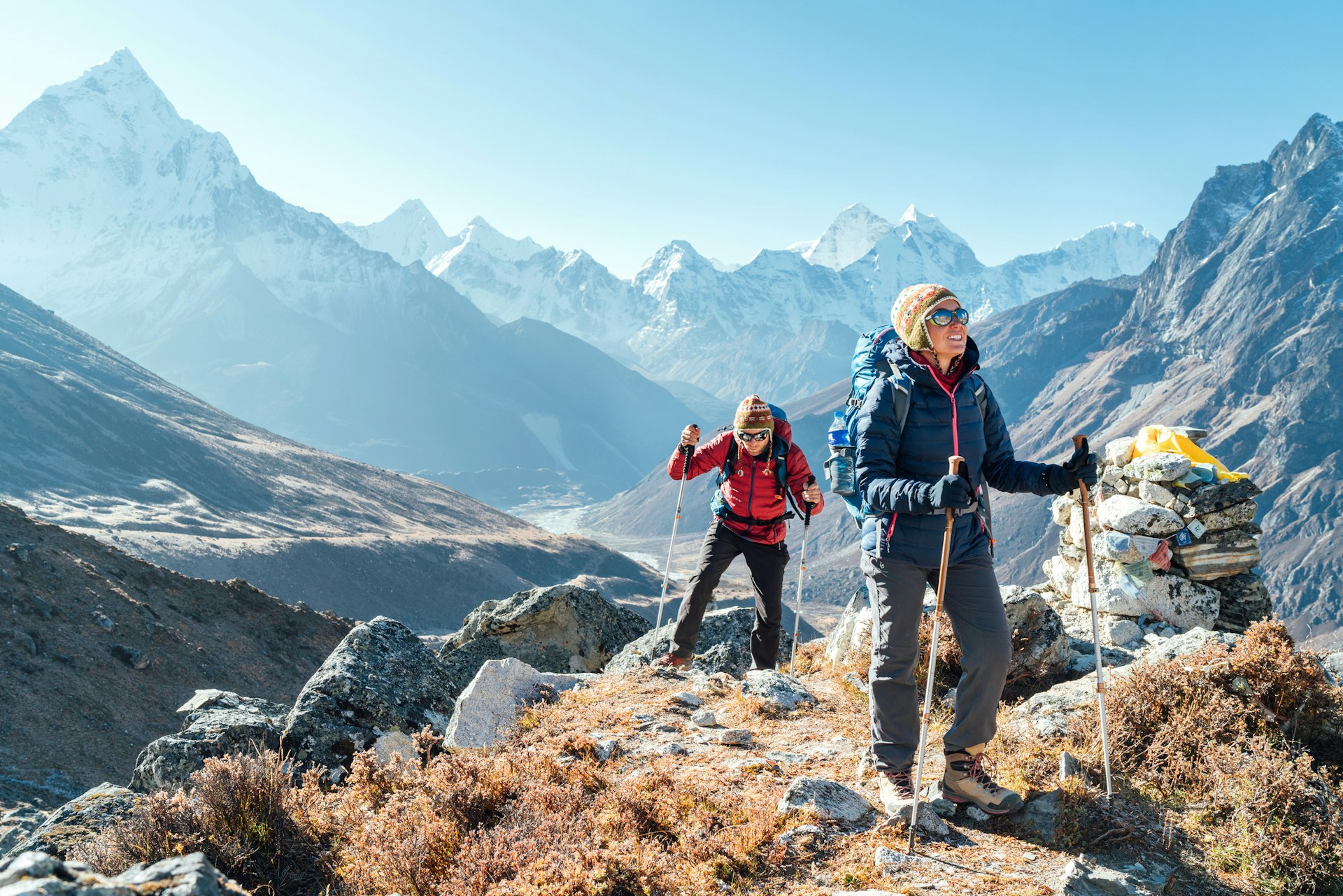
What's so great about the Everest Base Camp (EBC) trek anyway?
Firstly, the mountain scenery surrounding the world's highest peak is truly spectacular. The sublime views of Ama Dablam, Pumori, Nuptse and Thamserku peaks are unbeatable and constantly change as you progress along the walk. The Sherpa villages and monasteries are fascinating places to visit and the lodges (called teahouses) are the best in the world.
The knowledge that you are walking in the expedition footsteps of Hillary, Tenzing, Messner and others is a thrill. Anyone who has read Into Thin Air will be moved by the memorial stupas of Rob Hall, Scott Fischer and others who have lost their lives on the mountain. And then there's the fact that you will have reached the base of the world's highest peak; whether you call it Chomolongma (Tibetan), Sagarmatha (Nepali) or Everest, it’s a rush all the same.
And what’s not so great about the Everest Base Camp trek?
Well, if you force us to play devil's advocate… EBC is one of the busiest trails in Nepal. In the high season months of October and November you'll be walking with thousands of other trekkers, competing with them to get a bed, a lunch order or an airplane seat. There will be lines at checkpoints and even at moments on the trail itself. In bad weather you might be stranded at Lukla airport with hundreds of other trekkers, all trying to get on the first flight out. It's not quite the Zen-like wilderness experience you may have been imagining.
Bear in mind also that even after a solid week of walking, your view of Everest will be partial at best (for infinitely more dramatic Everest views visit the northern Everest Base Camp in Tibet ). If you trek outside of May's expedition weather window you won’t actually find much to see at Base Camp beyond a boulder hastily spray-painted with "Everest Base Camp".
If this has put you off, don’t worry; there are dozens of other fantastic treks in Nepal .
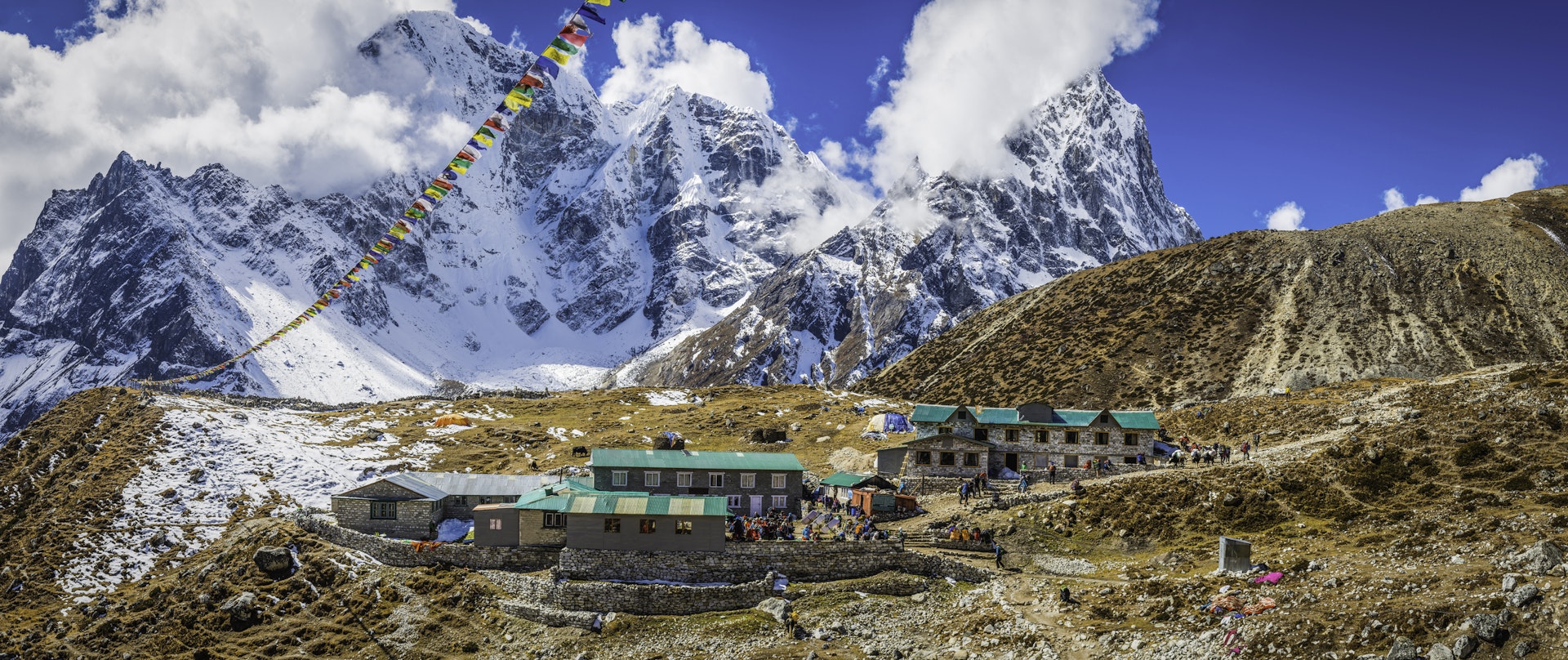
How long does it take to trek to Everest Base Camp?
The walk from the airport at Lukla to Everest Base Camp and back takes a minimum of 15 days. Several of the days are surprisingly short, but this is because you have to figure in time to acclimatize to the high altitudes.
If you can, it's definitely worth adding on a couple of extra days to this basic itinerary. Some of the most dramatic (and least visited) views are from detours off the main trail. I always add two days to visit Thame, two days to visit Chhukung and, if possible, three or four days to visit the lakes of the Gokyo Valley – probably the most beautiful scenery in the Everest region.
Be sure to also budget an extra day or two as a transport buffer. Weather-related flight delays in and out of Lukla are not uncommon (I had to wait six days for a flight to Lukla on my recent trip) so you need some buffer time if heading back for an international flight home.
How challenging is the trek to EBC?
In terms of physical effort, the EBC trek itself is not especially tough. There are only a couple of steep climbs, lasting about an hour each, and most days involve less than four hours of walking.
The thing that makes the EBC trek tough is the altitude. Base Camp is at 5600m (18,373ft) and you will need to spend one or two nights above 5000m (16,404ft). Above 4000m (13,123ft) you are going to feel increasingly lethargic and out of breath as the amount of oxygen in the air decreases. Combine this with the cold, the discomfort of being at altitude and the compounded tiredness from walking for two weeks straight, and you can see why the whole trek experience is definitely a physical challenge.
While you don't need to be an athlete to walk to EBC it is still a good idea to start a fitness regime in the weeks leading up to your trek. You'll enjoy the walk so much more if you are in decent shape.
When is the best time to trek to Everest Base Camp?
October and November bring the best weather and the clearest skies but these are also the most popular months. The second most popular season is April to early May, when spring blooms and expedition traffic bring extra interest to the trail. To avoid the crowds but still enjoy clear views, pack an extra thermal layer and come in December or March.
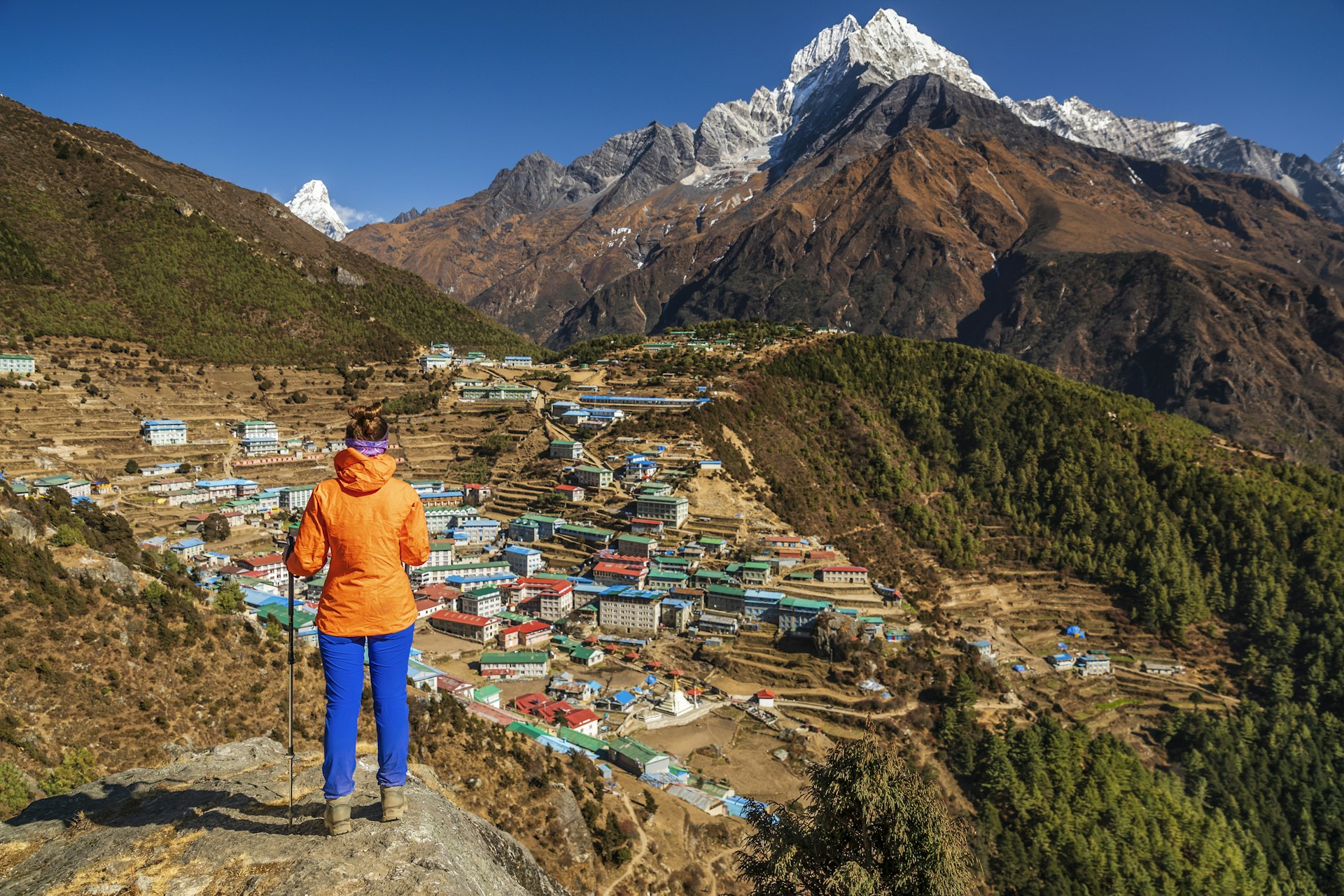
What can I do to avoid altitude sickness?
The majority of people who fail to reach Base Camp do so because they failed to acclimatize properly to the altitude. It's essential not to gain altitude too quickly by following the recommended overnight stops and limiting your daily altitude gain to a maximum of 400m (1312ft) when above 3000m (9843ft).
Be sure to add in acclimatization days at both Namche Bazaar and Dingboche, during which it's a good idea to hike to higher altitudes during the day, returning to sleep lower at night.
What are the teahouses like?
At lower altitudes the Everest lodges are the most comfortable in Nepal. Private rooms are the norm, many of which have private bathrooms. Showers are available at most places, though the hot water supply can be patchy. All have cozy dining rooms with tables arranged around a central dung-fueled stove. There are even a few luxury lodges along the trail.
In budget lodges, or when you get above Dingboche, things get simpler, with rooms offering little more than a collection of plywood walls, a solar light and a foam mattress. Toilets are a mixture of seats and squatters; sometimes outdoors, always freezing. A blanket is normally supplied but be sure to bring a four-season sleeping bag rated to well below 0°C (32°F).
What's the food like?
Menus in teahouses range from pasta and pizza to spring rolls, fried potatoes and soups, though the most popular meal is a daal bhaat , a set Nepali meal of rice, lentil soup and fried vegetables, normally served with a papad and pickle, and with a refill included. It's the most filling and environmentally sustainable meal you can order.
In villages such as Namche Bazaar and Dingboche you will also find bakery-cafes serving espresso and slices of delicious apple pie, plus shops selling everything from Snickers bars to bottles of beer. This is one trek where you might actually gain weight!
Can I get wi-fi or phone coverage?
Most lodges offer wi-fi, either free of charge or for a few dollars per day (at higher elevations). Above Namche Bazaar you will likely have to buy a scratch card, giving you unlimited data for twelve hours (AirCell) or a specific amount of data over a month (Everestlink). Depending on your network provider you'll likely get data and a phone signal at lower elevations, and possibly even at Everest Base Camp, but not at other high altitudes. So yes, in theory, you can Skype all your friends from Base Camp!
What should I bring?
Warm clothes are a must, and you should pack thermal underwear, a down jacket and fleece hat. Comfortable hiking boots and good, padded socks are also essential. Sun block, a sun hat with a brim and good sunglasses are important against the strong high-altitude light.
Morale-boosting snacks like chocolate and salami are always helpful, as is a book and smartphone with mapping software like Maps.me. Bring water purification of some sort. If you forget something, don’t worry, you can buy almost anything you might want in Namche Bazaar these days (from ice axes to cans of Pringles), though at prices higher than in Kathmandu .
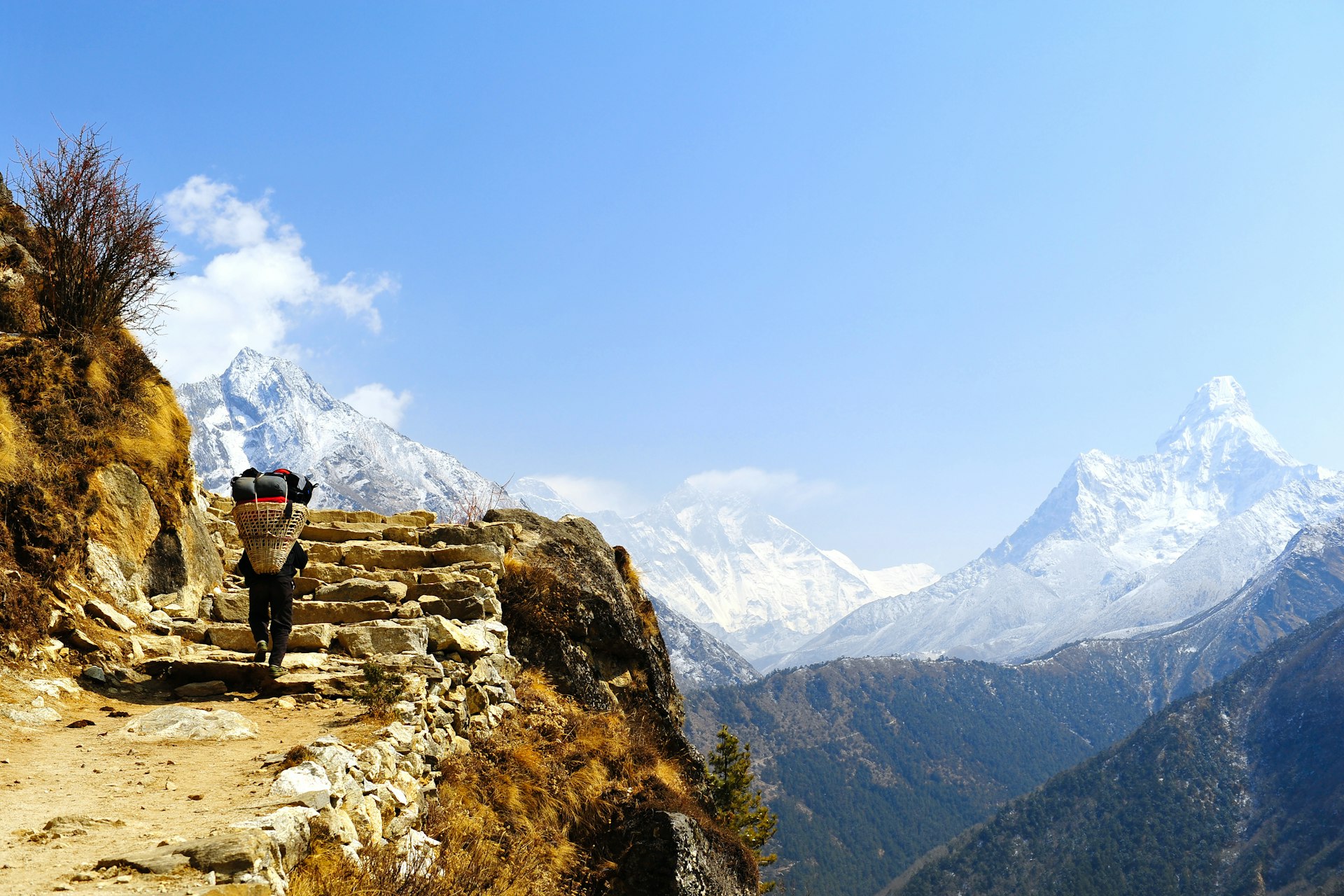
Do I need a porter and guide?
In terms of finding your way you don't need a guide if you are an experienced walker, as the route is clearly marked and well-trod. A guide can be useful for smoothing your way at teahouses, making sure you get your food on time and helping you pay your bill. It's important not to trek alone, so solo trekkers should find a companion or take a guide or porter.
A porter will carry a bag of around 15kg, freeing you up to pack a few extra chocolate bars and enjoy the walk with little more than a day pack. Not having the strain of carrying a full pack is worth its weight in gold for anyone over the age of 50. Trust me.
How much does the Everest Base Camp trek cost?
For a room in a lodge and three meals a day, figure on US$20–25 per person per day, a bit more if you want a room with a private bathroom and the occasional slice of apple pie. Add on another US$5 every time you want a shower. Figure on an additional US$20 per day for a porter, and US$25–30 for a guide, and budget 10–15% of that fee for an end-of-trip tip.
You'll pay a bit more to have a Kathmandu-based trekking company arrange your entire trek, and a lot more for the convenience and backup of an international trekking tour.
Do I need any permits?
You will need to buy an Everest region permit (US$20) at Lukla, as well as a Sagarmatha National Park entry ticket (US$30) at Monjo. Currently that's all you need.
How can I trek more sustainably?
With 60,000 trekkers and guides headed to the Everest region, it’s important to minimize your impact on the region. Firstly, don't buy bottled water on the trek, as the bottles are nonrecyclable and are a huge problem throughout the region. Bring a system of water purification, like a Lifestraw or Sawyer filter, a Steripen or chemical purification.
Secondly, carry all your trash out (especially batteries), and sign up for the Carry Me Back program, whereby you carry a 1kg bag of trash from Namche Bazaar to Lukla, for it to be recycled in Kathmandu.
Finally, be polite to the Sherpas and porters you meet en route, as well as your fellow trekkers. Walk clockwise around stupas and be respectful at monasteries and shrines.
How do I get to Lukla to start the trek?
Flights run multiple times daily between Kathmandu and Lukla, taking around 30 minutes. During high season however you may have to drive five hours from Kathmandu to Ramechhap airport to catch your Lukla flight there.
It's also possible to fly or drive to Phaplu and walk two days to Lukla from there, or walk from Shivalaya to Lukla in seven days as an excellent pre-trek warm-up.
This article was first published Jan 14, 2013 and updated Jun 20, 2023.
Explore related stories
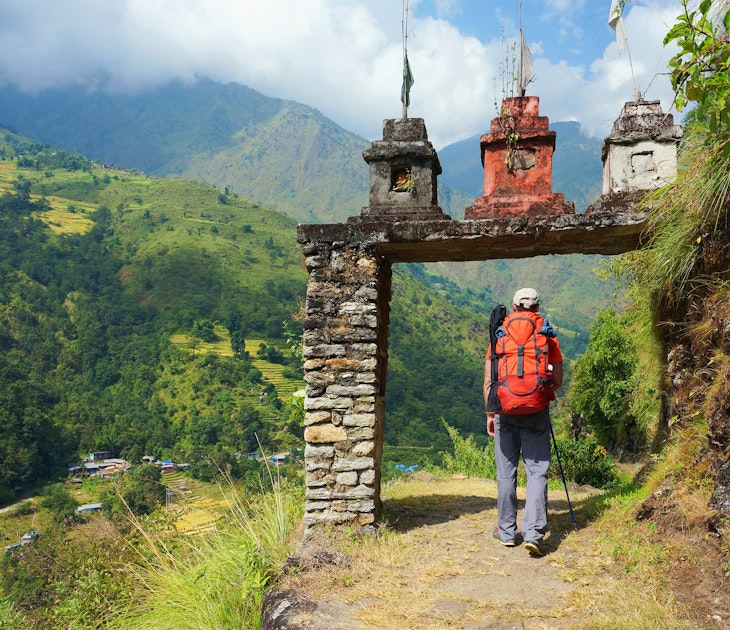
Mar 14, 2023 • 4 min read
To reduce accidents and promote jobs, Nepalese authorities recently announced a ban on solo trekking in national parks and conservation areas.

Jul 13, 2022 • 8 min read

Jan 31, 2022 • 6 min read
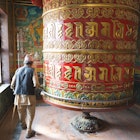
Jan 9, 2022 • 8 min read

Sep 14, 2021 • 11 min read

Jan 28, 2021 • 5 min read
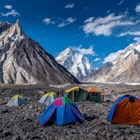
Jan 12, 2021 • 7 min read
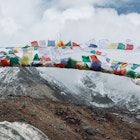
Dec 10, 2020 • 6 min read
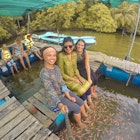
Jan 7, 2020 • 6 min read
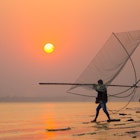
Oct 10, 2019 • 9 min read
Best Time to Visit
Weather & Climate
Kathmandu Airport Guide
Top Destinations in Nepal
One Week in Nepal
Tipping Guide
Getting Around
Top Things to Do in Nepal
Complete Guide to Kathmandu
Top Things to Do in Kathmandu
Top Things to Do in Pokhara
Sacred Sites
Amazing Festivals
Top National Parks
Must-Try Food
Annapurna Circuit
Manaslu Circuit
Himalaya Trail
Facts About Mt. Everest
Trek to Everest Base Camp
Everything You Need to Know About Trekking to Everest Base Camp
:max_bytes(150000):strip_icc():format(webp)/greg-rodgers-adventure-ed92646b25f247049e53af6d36f6c15f.jpg)
Jason Maehl / Getty Images
Everest Camp II (2)
Trekking to Everest Base Camp in Nepal's Sagarmatha National Park is the adventure of a lifetime. Although actually climbing Mount Everest is out of reach for many of us, anyone with enough grit and good enough fitness can reach EBC and the Khumbu Icefall, the starting point for climbing Mount Everest. (You’ll need an $11,000 permit and some serious equipment to go any higher from there!)
The Himalayan scenery here is unrivaled on earth. Snowy sentinels will witness your struggle toward the top of the world , while stupas, prayer flags, and Sanskrit tablets will remind you of the spiritual significance of the area. Sadly, the numerous memorials to hikers who perished along the trail underscore the seriousness of your undertaking.
You’ll battle freezing cold, thin air, weather changes, and your own body as you ascend. Once at Everest Base Camp, you won’t even get to see the famous mountain itself unless you take a day to climb Kala Patthar (18,519 feet), an adjacent prominence that affords views of the “Holy Mother” when weather permits.
Read on for our complete guide to the Everest Base Camp trek, with information on what to pack, when to go, EBC tours, and more. Note that we’ll only cover getting to South Base Camp in Nepal, not North Base Camp in Tibet .
What to Expect
Trekking to Everest Base Camp involves hiking between lodges (or “teahouses”) found in villages along the trail. Some days may only consist of four hours or so of uphill trekking, depending on how much elevation is gained that day. Sometimes, you’ll have the option of pushing on to another village higher up—but no matter what, you will never gain more than 1,312 feet (500 meters) in a day.
Once above the tree line, the common rooms in your lodges will invariably be heated by yak dung-burning stoves. Weary hikers will hang around these stoves, warming themselves and socializing before retiring early to their unheated rooms. The shared toilets are sometimes located in snowy outhouses.
The village of Namche Bazaar (11,290 feet) is considered the last fully “civilized” stop on the trek to Everest Base Camp. Here, trekkers can enjoy treats from a German bakery while watching screened documentaries. You’ll find last-minute gear and souvenirs for sale along with the last ATM on the trail. You can even indulge at the “highest Irish pub in the world” on your way down after a successful trek!
When's the Best Time to Trek to Everest Base Camp?
The best time for trekking to Everest Base Camp is in either spring (March to May) or fall (September to November). If you want to see the camp in full form with climbers, support teams, and film crews, you’ll need to time your trip with spring climbing season, usually late April or early May. This is also the busiest time to be in Nepal .
For less traffic on the trails, consider making your trek to Everest Base Camp in September or October. Unfortunately, this means hiking in cooler weather with even less daylight than usual.
Avoid making the trek during monsoon season in summer. Humidity reduces beautiful views at lower elevations, and snowfall closes trails at higher elevation.
Adisorn Fineday Chutikunakorn / Getty Images
Should I Book a Tour or Go Independently?
There are three options for completing a trek to Everest Base Camp:
- Book a group tour and have all arrangements made for you.
- Make the trek to Everest Base Camp independently .
- Arrive in Nepal, then hire a guide and/or porter yourself.
No matter which option you choose, try to spend an additional day at Namche Bazaar. The extra time at 11,290 feet reduces some of the effects of elevation later; you’ll enjoy a better overall trekking experience and suffer less. The extra day isn’t “wasted”—many day hikes around Namche Bazaar provide beautiful views while giving your body time to adjust. Your chances of successfully reaching Base Camp vastly improve if you spend more time at Namche Bazaar.
Everest Base Camp Tours
Although the most expensive option by far, having everything organized before you arrive provides peace of mind. You’ll be taken care of all along the way, with access to better safety measures such as supplemental oxygen. Bigger companies use yaks to take your gear ahead; you’ll find it waiting for you in your teahouse room at the end of each hiking day.
You can book an Everest Base Camp tour online from home, or if time permits, do so after arriving in Kathmandu . Booking on the ground through a Nepalese agency saves money and better helps the local economy. You’ll find trekking agencies on every corner in Thamel, but unfortunately, not all are reliable. Choose a reputable agency that’s a member of the Trekking Agencies’ Association of Nepal . You can see in the member directory how long an agency has been in operation, and hopefully, make a better informed decision.
Independent Trekking
First, independently trekking to Everest Base Camp doesn’t necessarily mean solo trekking. Trekking alone in the Himalayas is dangerous no matter your experience level. A simple slip or unexpected weather change could keep you from reaching the next teahouse before temperatures plummet at night.
Independent trekkers can save a lot of money by foregoing organized tours and simply teaming up with other trekkers they meet along the way. (Everyone you meet in the lodges is going in one of two directions: up or down!) The well-marked trail to Everest Base Camp is busy during peak trekking seasons, giving you the best chance of meeting new friends who match your speed and fitness level.
Going independently does carry some risk, of course. You’ll be responsible for your own well-being and making important decisions. On the other hand, you’ll be able to set your own pace and make adjustments based on how well your body acclimatizes. A majority of hiker deaths on the trail each year occur when people in group excursions are suffering from Acute Mountain Sickness (AMS) but don’t speak up. They fear slowing everyone down, or don’t want to forfeit reaching Everest Base Camp.
If guiding yourself, pick up a good trail map in Kathmandu. Don’t rely solely on electronic devices for making survival decisions! You’ll also need to store your luggage at a trustworthy guesthouse or hotel in Kathmandu. Locking duffel bags and padlocks can be purchased in local shops; some owners will buy them back once you return from your trek.
Hiking Guides and Porters
Rest assured: Your pack is going to feel heavier at 15,000 feet than it does at home! Even as an independent trekker, hiring a local guide and/or porter are options. Hiring directly ensures money goes to the Sherpas instead of a Western tour agency that managed to rank well online. Expect to pay between $15 to $20 a day for a porter or $25 to $30 a day for a guide.
You’ll need to negotiate terms and contingencies before hitting the trail. Paying up to half of the porter’s fee up front is common, and you will also be expected to tip guides and porters after the trip. Finalize details and other expenses to avoid a potential disagreement. The agreed daily rate should include their meals, drinks, and accommodation so you aren’t asked for money later.
Guides will approach you on the street in Thamel, however, you should hire only a credible and licensed guide through either a trekking company or your accommodation. You may still be able to hire a porter later on the trail by speaking to the staff at your lodge.
How Much Does It Cost to Trek to Everest Base Camp?
The cost of trekking to Everest Base Camp depends entirely upon your needed level of comfort. One indelible rule holds on the trail: Prices rise as elevation rises. That 50-cent candy bar from Kathmandu is worth $7 at 17,000 feet!
Extremely basic accommodation in teahouses can be found for as low as $5 per night. You’ll be expected to have your meals where you stay. A hearty Nepalese meal of dal bhat can be enjoyed for $6 or less, but expect to pay much more for Western food. A can of Coke can cost up to $5; remember, it’s heavy and had to be carried up by a porter.
Other luxuries add to the cost of life on the trail. A (somewhat) warm shower can cost $5. Charging electronic devices and accessing the internet, if available, cost several dollars an hour, and the solar charging systems are often slow and provide only a weak charge. Depending on your food and drink indulgences, plan to spend $20 to $30 a day living on the trail. This excludes any fees you pay to porters and guides.
If not already covered, your greatest expense will be the short flight to and from Lukla. The 30-minute flight can cost around $180 each way.
Do You Need a Permit for Everest Base Camp?
You’ll need at least two permits for trekking to Everest Base Camp. Your tour organizer will probably provide these, but you’ll need to arrange them yourself if trekking independently.
- Sagarmatha National Park Permit: Get this at the Nepal Tourism Board office in Kathmandu (approximately $25).
- Khumbu Pasang Lhamu Rural Municipality Permit: You will get this permit from a checkpoint in Lukla; it isn’t available in Kathmandu (approximately $17).
- Gaurishankar Conservation Area Permit: You only need this permit from the Tourism Board if doing the longer trek to Everest Base Camp from Jiri instead of flying to Lukla (approximately $17).
The permit system changed in 2018. Disregard any information you read elsewhere about needing a TIMS card for the trek to Everest Base Camp.
Greg Rodgers
What to Pack
Kathmandu, particularly in Thamel, has more than enough outfitting shops for gearing up. Unfortunately, those same shops are stacked with counterfeit gear that probably won’t survive the hardships of the trek. Sifting through the piles of used gear in dark shops requires patience. Prices are inflated, so put your game face on and start haggling !
If you booked a guided tour, find out what your tour company plans to provide (e.g., hiking poles, down jackets, etc) before shopping. Consider bringing mission-critical items from home so that equipment failure doesn’t affect your experience. For instance, you’ll need quality sunglasses to prevent eye injury. Sunglasses for sale locally may have “UV Protection” stickers on them but don’t offer much actual protection.
- Good hiking boots. You should invest in high-quality, waterproof hiking boots and break them in properly before you leave home; painful blisters can ruin an otherwise-excellent trek.
- Lightweight sleeping bag. Rooms along the trek are unheated. Lodges provide weighty blankets for the freezing nights, but you'll appreciate having a layer between you and the unwashed bedding. Even a lightweight silk “sleep sheet” will do the trick.
- Alternate footwear. After removing your muddy hiking boots, a pair of lightweight shoes or sandals comes in handy for wearing around lodges and shared bathrooms.
- Water purification: As elevation increases, so does the cost of bottled water and need to reduce plastic waste. You’ll be drinking more than ever to counter dehydration in the dry air. Although there are many options, the two-bottle, chlorine dioxide system from Aquamira is a reliable solution.
- Trail snacks: Candy bars and nuts provide a much-needed boost to energy and morale while on the trail or in the lodge.
- USB power bank: Keeping batteries charged in the extreme cold is a challenge. If you plan to use a phone for photos or communication, you’ll want to bring along a rugged power bank.
- Diamox tablets: Diamox (acetazolamide) is medication for countering the dangerous effects of AMS. Guides should have some on hand, but independent trekkers will want to buy Diamox to carry. Beware of fake tablets for sale in Kathmandu. Purchase only from legitimate pharmacies—not from shops—and discuss how to use them.
If you won’t be taking your poles and other gear home after the trek, consider giving it directly to the Sherpas you meet in Lukla.
John Elk III / Getty Images
How to Get There
Fly into Kathmandu's Tribhuvan International Airport (KTM) and plan to spend a few days resting and preparing for the trek. Unless you’ll be starting the trek in Jiri—which requires a seven-hour bus ride and an additional five to seven days of trekking—you’ll need to book a flight to Lukla.
Taking the small prop plane from Kathmandu to Lukla (LUA) is one of the scariest and most scenic aviation experiences many travelers will have. Although not the highest airport in the world , weather and visibility changes have caused enough crashes at Tenzig-Hillary Airport in Lukla to earn it the title of “most dangerous airport in the world.”
The trek to Everest Base Camp begins in Lukla and finishes at the infamous Khumbu Icefall!
How Dangerous Is Everest Base Camp?
Although frostbite and rock slides are hazards along the trail, the biggest danger—by far—comes from the high elevation. Once symptoms of AMS begin (severe headache and nausea), you need to descend as soon as possible. Ideally, you’ll ascend slowly enough to minimize altitude sickness in the first place.
The CDC recommends never gaining more than 500 meters in one day and taking a rest day for every 1,000 meters gained. Whenever possible, you should descend to sleep at a lower elevation than the highest point reached during the day. Track and do the elevation math as though your life depends on it.
The high elevation and thinner air introduces additional risks. For one, your body will increase its production of red blood cells, causing excessive urination; be sure to drink plenty of water to avoid dehydration. Many trekkers will also experience the dry, hacking "Khumbu cough" from panting heavily in the thin air and breathing in the dust of the region. You can cover your face with a bandanna or balaclava for some protection. The cough usually goes away after time. Ultraviolet rays, too, are more damaging in the thinner air, so protect your skin, lips, and eyes by applying high SPF sunscreen and lip balm, wearing long sleeves, and donning sunglasses.
Finally, yak trains always get the right of way! Never share a bridge crossing with one, and always pass them on the “inside” of the trail. Startled yaks are unpredictable and sometimes knock trekkers off the trail.
Additional Tips
- Take your stocking up on snacks seriously. Pack candy bars, even if you wouldn’t ordinarily indulge at home. You’ll experience strong cravings at higher elevation. Hikers are willing to spend $7 or more for Snickers bars near Everest Base Camp!
- The weather in the Himalayas changes quickly and unpredictably. Flights to and from Lukla frequently become delayed by a day or two, maybe longer if a winter storm system sets in. Add some buffer days to your Kathmandu itinerary just in case this happens.
- Before retiring to bed, ask your teahouse staff to pour boiling water into your bottles and use them as bed warmers. Fair warning: They’ll probably be frozen next to you in the morning!
- Sleep with your phone and any batteries in the bed with you. Your body heat will protect battery life a little.
- Weight limitations imposed by airlines that fly to Lukla are strictly enforced. If an airline says 33 pounds (15 kilograms), that includes all baggage , stowed or carried. Don’t risk having to forfeit gear in Kathmandu Airport because you’re a pound or two over the allowance. You can stuff some items into your pockets, within reason.
How to Go Teahouse Trekking in Nepal
The Best 12 Hikes in Nepal
Solo Trekking in Nepal's Everest National Park
How to Choose and Prepare for a Hiking Trip
Independent Trekking in Nepal
The World's Highest Places and Attractions That You Can Visit
Five Amazing Hiking Routes Among the High Mountains of the Himalayas
The Most Beautiful National Parks in Nepal
A Guide to Tipping in Nepal
The Complete Guide to Climbing Morocco's Mount Toubkal
Nepal's Great Himalaya Trail: The Complete Guide
How to Trek Nepal's Manaslu Circuit
The Different Types of Adventure Travel
The Top 15 Destinations in Nepal
Where Is Mount Everest?
How To Do The Everest Base Camp Trek In Nepal
The Mount Everest Base Camp Trek in Nepal is one of the world’s best bucket list hikes. In less than 2 weeks, you can trek to the foot of Mt Everest and other snowy peaks in the Himalayan mountains.
The good news is that it’s not a super difficult hike, and you don’t need a big budget to do it. The EBC trek is worth it for the fun and accomplishment alone, but you also get views of the Himalayas that are out of this world.
This travel guide will explain how you can do the Mt Everest Base Camp hike independently (with or without a tour guide), along with a recommended packing list and everything else you need to know before you go!
Best Everest Base Camp Tours
First of all, if you’d rather skip the hassle of planning your own EBC Trek, Klook has Everest Base Camp Tours starting as low as $900 USD for a full 12-day trek.
You may be able to find something cheaper than this once you land in Kathmandu, but booking online with a vetted tour company has some big advantages, and the reviews on their website are very positive.
We’ve used Klook for lots of tours and activities around the world, and they’re great! Highly recommended.
Book Now: Everest Base Camp Tours

When To Do The EBC Trek
The Mt Everest region has 4 different trekking seasons:
- March – May: High season. Best weather, with stable temperatures and bright sunny days, but the trails can get crowded. During these months you may share the EBC trail with pro climbers on the way to go summit Everest.
- June – August: Monsoon season. There’s a lot more rain during these months, and the trails are mostly empty.
- September – October: Clear days and busy trails. This is one of the most popular trekking seasons.
- November – February: Coldest season, but the weather is stable and dry. The trails are mostly clear.
I trekked in early February, and even though it was nice having the trail mostly to myself, the cold in the evenings and mornings was straight up misery.
My home state of Missouri can get very cold in the winter, but the cold has just never been my thing. If I could go back and change it, I would definitely do my Everest Base Camp hike later in the season.

Everest Base Camp Weather
Temperatures on the Mt Everest Base Camp Trek can range from 5 °C (40 °F) to 20 °C (70 °F) depending on month, and as low as -30 °C (-22 °F) at night during the winter months.
If you trek during the warmer months (Mar-May and Sep-Oct), the cold is not a big problem and shouldn’t be hard to cope with. Winter is a different story. Your snot will freeze in your nose at Gorak Shep.
Sunshine is key for winter trekking in Nepal, and thankfully you should have lots of sun in most months outside of the monsoon season. On my February hike, I often found myself shedding all my layers while trekking because I was heating up in the sun.
If you do your Everest Base Camp hike during the winter, the biggest issue is staying warm in the evenings and at night. For this, you’ll definitely want a top quality down jacket and sleeping bag.

All About Everest Base Camp Trekking
My everest base camp itinerary.
- Day 1: Kathmandu to Lukla to Benkar .
- Day 2: Benkar to Namche Bazaar .
- Day 3: Namche Acclimatization Day .
- Day 4: Namche to Deboche .
- Day 5: Deboche to Pangboche .
- Day 6: Pangboche to Dingboche .
- Day 7: Dingboche Acclimatization Day .
- Day 8: Dingboche to Thukla .
- Day 9: Thukla to Gorak Shep .
- Day 10: Everest Base Camp .
- Day 11: Kala Patthar to Gorak Shep to Pheriche .
- Day 12: Pheriche to Namche .
- Day 13: Namche to Lukla .

If you ever need motivation to keep going on the Everest Base Camp hike, just look at how much the porters are carrying!

Mount Pumori as seen from the Kala Patthar viewpoint, just a short distance from Mt Everest Base Camp.

Ama Dablam, one of my favorite mountains on the Mt Everest Base Camp Trek.
EBC Trek Packing List / Gear
This isn’t a complete list of everything to bring on a Mt Everest Base Camp Trek, and you may have to change things up a little depending on what month you go, but these are just some of the basics.
You can find most of this gear in Kathmandu, but in my opinion you’ll get higher quality and a wider selection if you order online.
- Beanie: I only wore this at night, but it definitely helped keep my ears warm.
- Down Jacket: Bring the biggest, warmest DJ possible. This is your most important piece of gear. You can use it as an extra cover at night.
- Fleece Sweater: This is the only jacket you’ll need to wear while trekking most days, especially if it’s sunny.
- Shirts: Something comfy with quick dry material.
- Trekking Pants: Something lightweight and breathable.
- Thermal Underwear: May not be needed if you trek in the warmer months.
- Gloves: I only wore these at night, but they definitely helped keep my hands warm.
- Socks: Merino wool is best for staying warm and stopping moisture.
- Headlight: Smart to have at least a small one, just in case.
- Tumbler: 1 liter water bottle to refill daily on the trek.
- Sunblock: It’s easy to sunburn at high altitudes. A small bottle is plenty.
- Sunglasses: Good for snow. May not be necessary unless you plan to hike a mountain pass like Cho La.
- Hat: I wore old faithful throughout the hike.
- Watch: An altimeter watch would be fun to play with here.
- Camera: Duh. You can’t do the Mt Everest Base Camp Trek without taking lots of pictures.
- Power Bank: Bring a big power bank and you might only need to recharge it once on the whole trek.

Everest Base Camp Trek Cost
For a 13 day trek, I paid about $21 USD per day for food, drinks, and room. Porter/guide was an extra $25 per day, although it’s not a requirement. Flights to Lukla were $330 return, but again not a requirement if you hike in.
You can read the sections below for more info on the daily trekking costs and what you get for your money. It’s not a very expensive trek, all things considered!
Keep in mind, these numbers are from 2020. They’ll go up a little over time. Exchange rates may also vary, so check the latest rates .

The flight to Lukla from Kathmandu is $165 USD each way. You can shop for flights to Lukla at Skyscanner.
If your budget is tight or you have extra time, you can skip this flight by hiking from Jiri to Lukla rather than flying. It only adds a couple days to the itinerary.

Guide / Porter / Solo
You can do the EBC trek with a guide, porter, OR independently (solo).
A guide will show you the way to Mt Everest Base Camp and help with lodging, navigation, advice, taking pictures for you, etc. A porter-guide will do these same things and also carry a 20 kg (45 lb) pack for you.
A porter or guide is NOT a requirement to do this hike, especially if you go in the warmer months when you may not need as much gear. In 2023, they were supposedly introducing a guide requirement for EBC, but so far that has not been enforced at all, thankfully.
With that said, there are some good advantages to hiring a guide, and it’s pretty cheap by Western standards. A porter is only $15 or $20 USD per day, and a porter-guide is $25 per day. A popular arrangement is to hire one porter for two hikers, splitting the cost and still making things easier for both of you.
In the end, this all depends on your budget and hiking preferences.

Hiking Fees
If you’re hiking EBC independently, you’ll need to be aware of two fees you have to pay near the start of the trek.
There’s a local government tax that they’ve now started collecting in Lukla. This one is currently 2,000 Rupees ($17 USD).
There’s also an Everest park fee/ticket you have to pay at the Sagarmatha National Park entrance just beyond the small village of Monjo, Nepal. This one is currently 3,500 Rupees ($30 USD).
No TIMS card is needed anymore for independent hikers. That fee has been retired for the Mount Everest Base Camp Trek.

Accommodation & Amenities
Throughout the Everest Base Camp hike, you’ll stay and sleep at small guesthouses along the way, called teahouses.
This is where you get your meals and drinks for the trek, along with the occasional amenities like showers, charging, or WiFi. The teahouses start out decent, but quickly get more shabby as you go further up the trail.
You have to pay for everything you use, of course, and the prices get quite high as you go, because everything has to be hauled up on the backs of the poor porters.

Guesthouses
The teahouses on the EBC trek are cold and dingy, with drop toilets and cracks in the walls. Don’t expect luxury.
Most rooms are free as long as you buy your meals there (the meals are how they make their money). If you stay at a lodge and don’t eat there, you’ll be expected to pay for the room.
In some cases, I was charged 500 Rupees for a room on top of my meal costs. I’m not sure why some teahouses do this and others don’t, but I never paid more than 500 Rupees for a room, and most were free with the meals.

Food & Drink
I’m happy to report that the food and drinks on the Everest Base Camp hike are top notch, especially after you’ve worked up an appetite trekking.
You have western food choices, or the standard local staples like veggie fried rice, steamed momos (dumplings), and mushroom soup. Everything was hot and fresh. Meal prices for these ranged from 250 to 750 Rupees depending on altitude. Not too bad.
For drinks I tried hot chocolate, lemon/apple/mint tea, and occasionally bottled water for my tumbler. These ranged from 100 to 400 Rupees. If you want to avoid plastic bottles, there’s usually boiled water available and this is safe to drink too.
Getting enough water on the trek is never a problem. Just fill up a 1 liter tumbler in the morning, and this will last you until evening, especially since you’re likely to pass more tea houses along the trail as you’re hiking throughout the day.

Showers are only available at a few lodges, depending on the season and how high up you are, and they cost 600 to 1200 Rupees. In the winter, water higher up will be frozen most of the time.
I never had a shower on my February EBC trek, and that seems to be the norm (although I got one or two opportunities in Namche). Yes, it’s gross. I could smell myself by trek’s end, and it wasn’t pretty.
But aside from the fact that I hate to fork out money for something as basic as a shower, I also never really got close to other people for very long on the trek, so I didn’t feel too guilty about it.
Most days were cold enough that the thought of stripping down for a shower was not really appealing, either. Your best bet is baby wipes and deodorant.

WiFi / Cell Service
WiFi costs anywhere from $5 to $10 USD per day if you buy it from the teahouses.
Alternatively, you can buy a 10 GB/30 Day Everest Link WiFi card in Namche Bazaar and use this for the entire EBC trek. During my Mount Everest Base Camp Trek the WiFi was down across the whole region, so unfortunately I wasn’t able to use either of these options.
I bought an Ncell local SIM card in the Kathmandu airport and had 3G service for half the days of the Everest Base Camp hike. Coverage is still improving in the area, so if you need to stay connected I’d definitely bring a local SIM.

Electricity
All of the teahouses on the way to Mt Everest Base Camp sell outlet charging for electronics, and the prices range from $2 to $10 USD for a full charge, depending on how far up the trail you are.
The key is to bring a big power bank and then use this to charge all of your other electronics (phone, camera, etc). I did this and only paid once to recharge my power bank on the whole trek.

How Much Cash To Bring
Everything you buy during the Everest Base Camp hike (meals, WiFi, charging, etc) will have to be paid for with cash. Credit cards won’t work. There are no ATMs outside of Lukla and Namche Bazaar (Days 1-4), and even the ATMs there are not reliable.
What this means is that you’ll have to withdraw enough cash (Nepalese Rupees) at an ATM in Kathmandu to cover your entire trek. The ATM fees will bite you, and I hate to carry large amounts of cash, but it’s not really avoidable here.
All up, I spent about $20 USD (2,400 Rupees) per day on the Mount Everest Base Camp Trek, and never spent more than $25 USD in a single day. With that said, I didn’t splurge on WiFi, showers, charging, or alcohol. The only things I bought were the bare necessities: room, food, and drinks.
If you hire a porter/guide, you don’t need to factor that into your daily cash carry. That’s paid before the trek starts. But do reserve a little cash for a decent tip.

Mount Everest Base Camp Trek Difficulty
I’m not going to lie, this is a difficult trek. And if you do it in the winter like I did, it’s even harder. With that said, if you are in decent shape, determined, and obey the guidelines for altitude sickness prevention (more on that below), then you’ll have no problem reaching base camp.
There is a lot of elevation gain and loss on this hike. At times near Lukla, the constant ups and downs will make you feel like you’re hiking a roller coaster, but the trail is never too steep or dangerous. After Namche, it’s mostly a slow uphill plod.
This trek has been completed by old seasoned hikers in their 70s, and young kids in their pre-teens. It’s also been flunked by healthy 20-30 somethings who try to push through it quickly without enough acclimatization to altitude.
Patience and discipline are key for trekking to Everest Base Camp. Slow and steady wins the race here.

Trekking Distance
The one way trekking distance from Lukla to Mt Everest Base Camp is about 65 kilometers (40 miles).
That means the total roundtrip distance of an EBC Trek is about 130 kilometers, even if you don’t do any of the detours.
Don’t let that scare you off. It’s a lot of hiking, but every step is worth it.

Altitude Sickness
By far your biggest danger on the Mount Everest Base Camp Trek is altitude sickness, also known as Acute Mountain Sickness (AMS).
No one is immune to this, and it doesn’t matter how fit you are. If you gain altitude too fast, you can get sick and in some cases even die. Plenty of people have died from AMS on the EBC Trek.
The problem is that overzealous hikers push the envelope on this hike all the time, and a lot of them end up needing a very expensive helicopter evacuation to lower ground.
The best way to avoid altitude sickness is to go slow . At altitudes above 3,000 meters (10,000 feet), don’t increase your sleeping elevation by more than 300-500 meters (1,000-1,500 feet) per night.
Every 1,000 meters (3,000 feet) you should also spend a second night at the same elevation. If you get a bad headache, dizziness, or nausea, descend to a lower altitude until you feel better. As long as you follow these general guidelines, you shouldn’t have any issues.
You can take Diamox (acetazolamide) on the trek for extra AMS prevention. This medication can be found in Kathmandu or Namche. I bought mine in Namche and it seemed to help my headache and slight foggy feeling. I didn’t have any side effects aside from the usual tingling toes/fingers.

Everest Base Camp Altitude
The Mount Everest Base Camp altitude is 5,364 meters (17,598 feet). At this elevation, there is 50% of the oxygen at sea level.
However, most treks also go to Kala Patthar, a viewpoint even higher than base camp where you can get the best views of Mount Everest.
The elevation at Kala Patthar is 5,644 meters (18,519 feet). From there, you’ll be rewarded with an incredible panorama of Mount Everest and other icy peaks like Pumori, Lhotse, and Nuptse.
Happy travels!

If you’d rather skip the hassle of planning your own EBC Trek, Klook has Everest Base Camp Tours starting as low as $900 USD for a full 12-day trek.
You may be able to find something cheaper than this once you land in Kathmandu, but booking online with a vetted tour company has some big advantages, and the reviews on their website are very positive for this Mt Everest Base Camp tour.
More Nepal Travel Tips
Hopefully you were helped by this guide for the Everest Base Camp Trek. Let me know in the comments below if I can help answer any questions.

You may also like
Fulidhoo island guide: shark & stingray beach in maldives, how to visit dhigurah island: budget paradise in maldives, 10 best hikes in aruba: family friendly trails, how to visit tanjung puting national park in indonesia, sanur bali travel guide: 23 best things to do, coron vs el nido: which is better all differences explained.
So much useful detailed information.
Thanks for the straight forward information. Beautiful photos

Leave a Comment Cancel Reply
Save my name, email, and website in this browser for the next time I comment.

The Ultimate Everest Base Camp Trek Itinerary: How to Get from Lukla to Everest Base Camp
Are you planning a trip to Everest Base Camp? Sitting at 5 380 m, the EBC trek in Nepal is one of the most iconic hikes in the world and tops any adventurer’s bucket list!
But walking over 130 km from Lukla to Everest Base Camp is tough! Mentally, physically and emotionally. Every day of your expedition will push you to your limits.
The reality is that no matter how intense your preparation is, it’s not your fitness levels or even your age that will determine whether you reach Everest Base Camp. It’s about how your body adjusts to a higher altitude.
Some people struggle, others don’t. This is why the acclimatization schedule in your Everest Base Camp trek itinerary is so crucial.
After successfully reaching base camp, I put together this comprehensive guide which includes step-by-step details of the best Everest Base Camp route to take, including the trekking time, the highlights, the best tea houses, how to deal with altitude sickness and so much more!
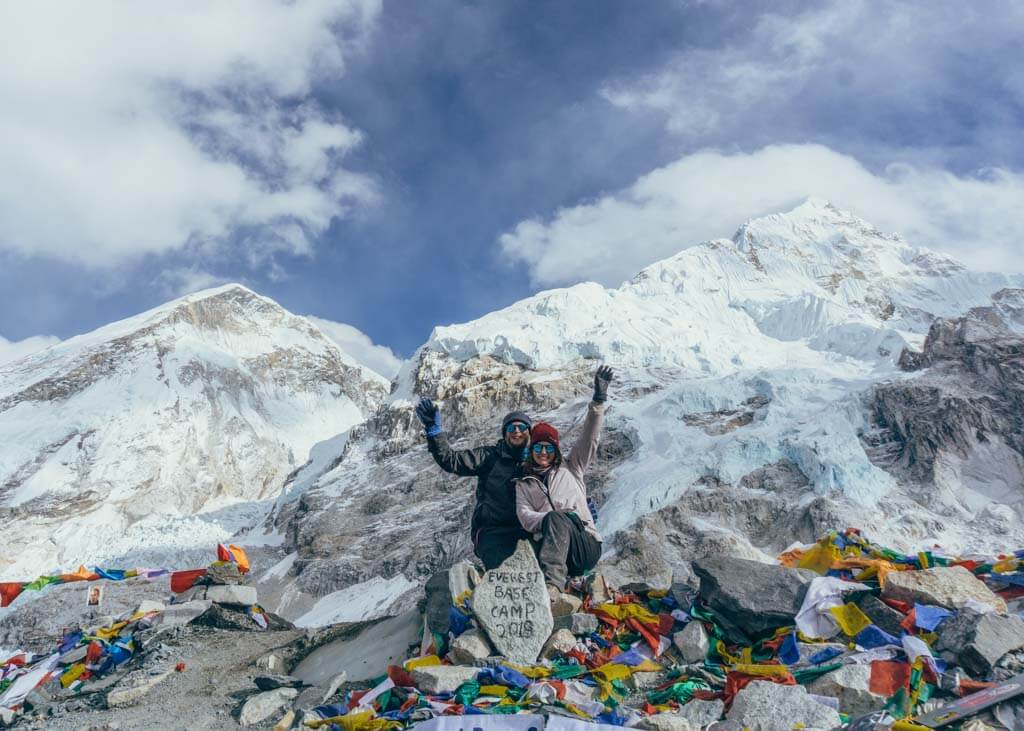
Quick Navigation
When to plan your Everest Base Camp Trek itinerary
April to May (Spring) and October to November (Autumn) are the most popular hiking months in Nepal offering perfect conditions for your Everest Base Camp trek.
But these months also attract scores of travelers looking to take on the Himalaya mountain ranges and so the trail does get busy.

Everest Base Camp Trek Route
If you follow my Everest Base Camp trek itinerary, you’ll need 12 days to start and return to Lukla. You will reach Everest Base Camp on day 9 which is enough time for your body to adjust to the higher altitude.
Day 1: Kathmandu to Lukla to Phakding
Day 2: phakding to namche bazaar, day 3: namche bazaar (acclimatization day), day 4: namche bazaar to khumjung, day 5: khumjung to phortse, day 6: phortse to dingboche, day 7: dingboche (acclimatization day), day 8: dingboche to lobuche, day 9: lobuche to gorak shep to everest base camp to gorak shep, day 10: gorak shep to kala patthar to pheriche, day 11: pheriche to namche bazaar, day 12: namche bazaar to lukla.
I did not take altitude sickness medication such as Diamox but I walked slowly, extremely slowly – probably the slowest anyone’s ever walked to EBC. This Everest Base Camp trek itinerary offers the best acclimatizing schedule to allow your body to naturally adjust to a higher altitude.
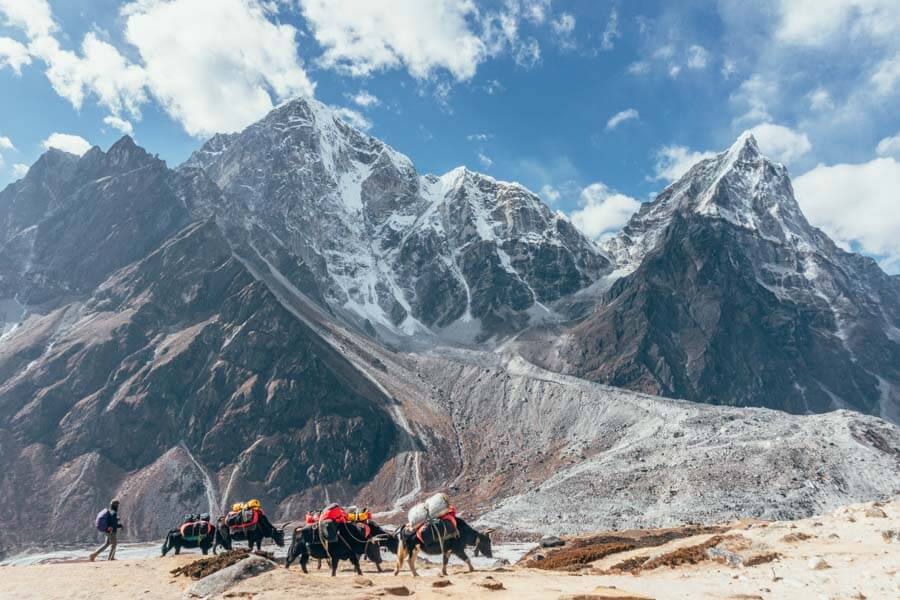
The start of your Everest Base Camp itinerary: Kathmandu
Your first few days in Nepal will be in the capital city, Kathmandu. Sitting at 1 400m above sea level, it’s recommended to spend at least 2 days here.
This allows your body to get used to the higher elevation, especially if you’re coming from sea level.
Kathmandu is a dynamic city with a rich culture and tradition, and you can easily spend a few extra days exploring if you have the time. Most tour operators include a day excursion to the nearby sights and temples within the city.
Make sure you stay in Thamel. It’s the hiking hub of Kathmandu with lots of eager trekkers choosing to base themselves here.
You can buy all your Everest Base Camp hiking gear in Thamel so don’t worry if you’ve forgotten something behind. Or if, like me , you arrived in Nepal with no hiking gear – only a pair of hiking boots! Thamel has got you covered.
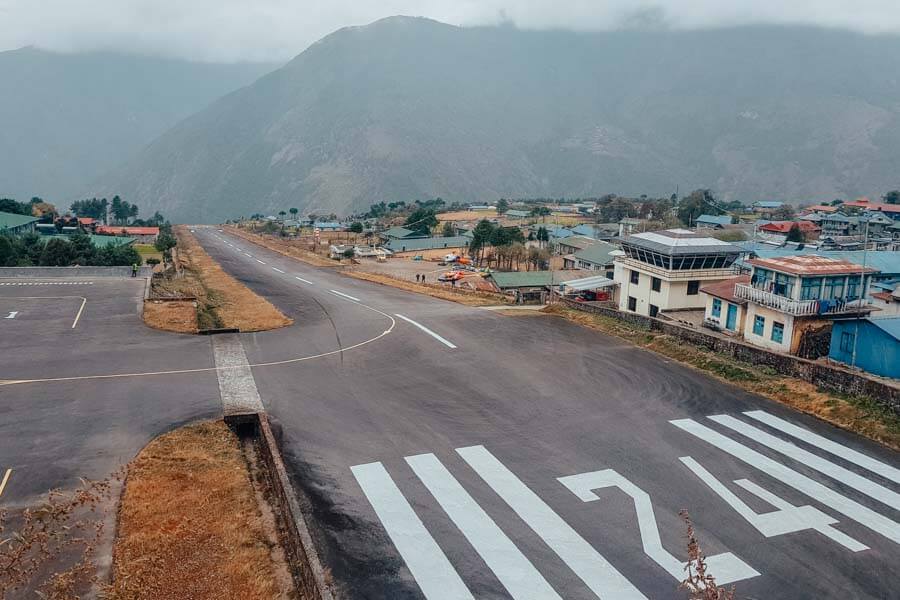
Altitude: Kathmandu (1 400m) – Lukla (2 860m) – Phakding (2 610m).
Trekking time: 3-4 hours | 7,4 km.
Difficulty: Easy with only a few uphill sections.
Highlight: Flight into Lukla.
Overview: The first day of your Everest Base Camp trek itinerary will start bright and early with a flight out of Kathmandu to the infamous Tenzing Hillary Airport in Lukla. From there, you’ll hit the ground running and hike just over 3 hours to Phakding, your stop for the night.
Tea house: Royal Sherpa Resort.
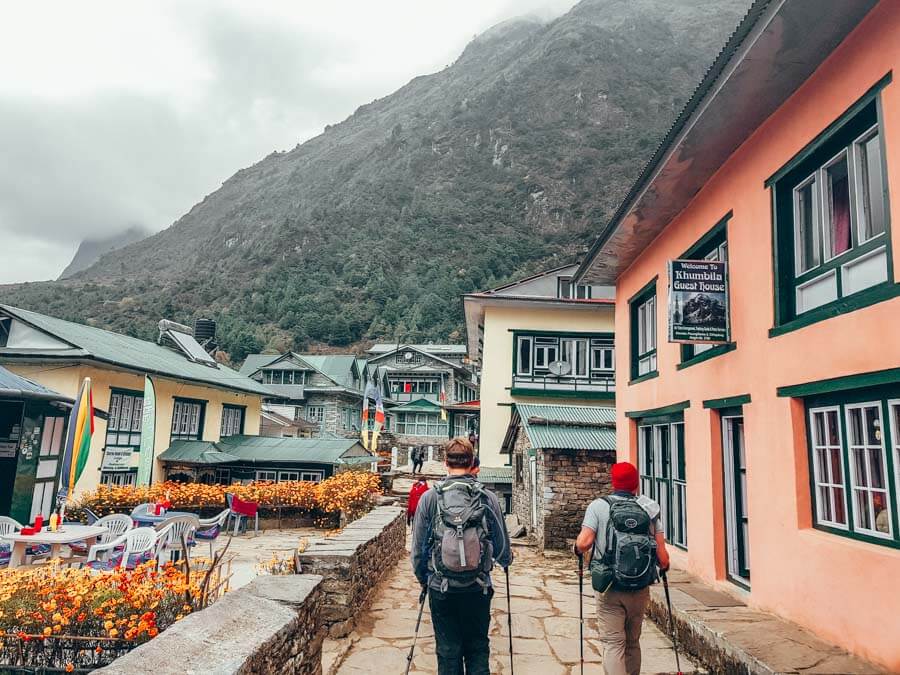
The day has finally arrived – The first day of your Everest Base Camp itinerary!
The flight from Kathmandu to Lukla is only 36 minutes but it relies heavily on the weather. Even if there’s slight cloud cover, the flights are delayed or worse, canceled. Lukla Airport is one of the most dangerous airports in the world after all.
My flight with Summit Air was due to leave at 9 am, but we only left after 3 pm due to the weather conditions. The planes are tiny, and you’re allowed no more than 15kg of luggage – in total!
The flight itself was thrilling but not as frightening as I anticipated. Although I did freak out every few minutes when there was a slight bump.
Lukla to Phakding
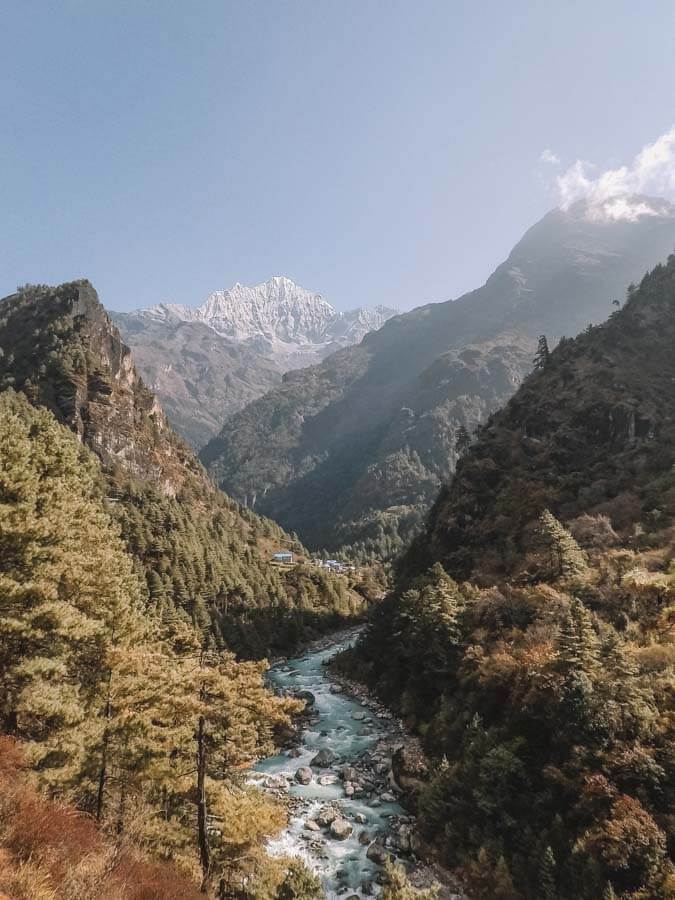
Once you’ve arrived in Lukla, grab a quick bite to eat before starting the afternoon trek to Phakding.
This section from Lukla to Phakding is an easy one and it’s the perfect introduction to the Himilaya mountain range. It’s an incredibly scenic trail that hugs the mountain and runs alongside a stream.
You’ll pass through several villages and will set your sights on the first yaks and mules of your Everest Base Camp trek.
Before you know it, you’ll have reached Phakding where you’ll spend the night in your first tea house. Don’t get too used to these comfortable conditions though. The further up you go from Lukla to Everest Base Camp, the more basic the amenities become!
Tip: There are ATM’s in Lukla (and Namche) but draw cash in Kathmandu as a back-up.
Tip: There’s cell reception (NCell) in Phakding and most tea houses offer free power to charge up your phone or camera here.
Tip: Try to eat well during the first few days as you’ll start losing your appetite from day 3 of your Everest Base Camp itinerary. Remember: “Dal Bhat Power – 24 Hour”

Altitude: Phakding (2 610m) – Namche Bazaar (3 440m).
Trekking time: 7-9 hours | 10,4 km.
Difficulty: Easy for the first section, steep and difficult for the second half.
Highlight: The views from the suspension bridges.
Overview: Day 2 is when the real hiking starts! You’ll begin with a slow hike before climbing a steep section leading to Namche Bazaar, one of the most iconic stops on your Everest Base Camp trek itinerary.
Tea house: AD Friendship Lodge.
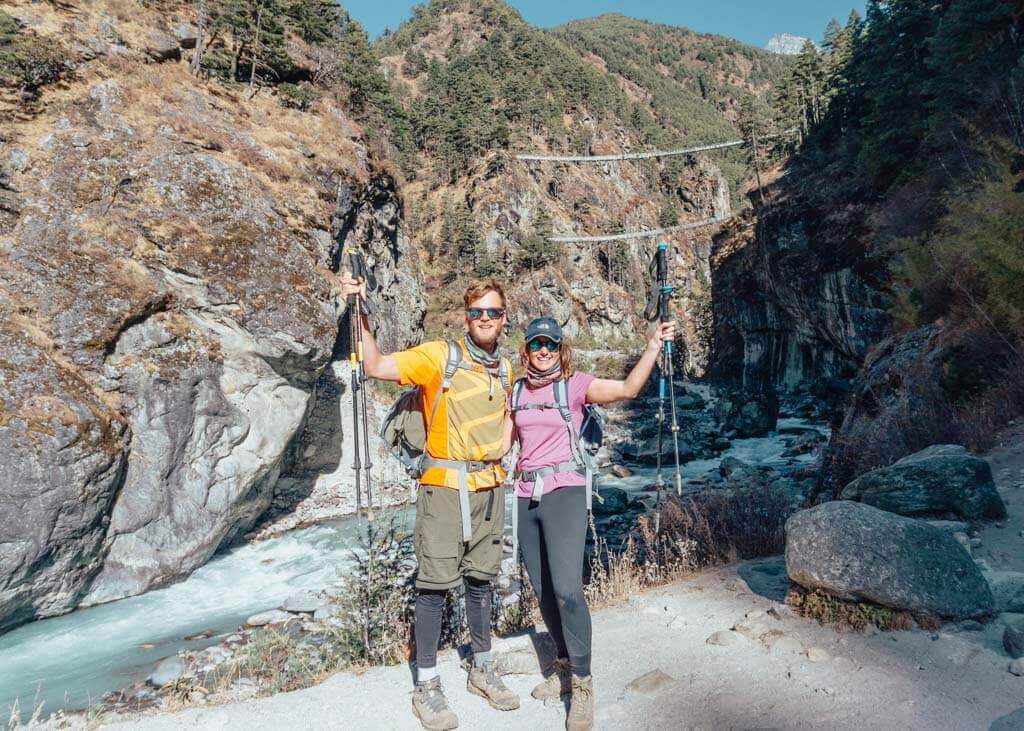
Day 2 is one of the most picturesque days of your Everest Base Camp trek itinerary. But you have a long day of hiking ahead of you so try to leave Phakding by 08:00 am.
The first part is an easy trek alongside pine forests and the excitement will begin to set in as you pass fellow trekkers making their way back down from Everest Base Camp to Lukla.
The glacial rivers are an impressive sight and you’ll cross several suspension bridges throughout the course of the day. These offer gorgeous views but they’re also terrifyingly high! Take in these beautiful surroundings as the landscape changes dramatically over the week.
After lunch, there is a sharp gain in elevation and the easy path suddenly becomes steeper. Take it slow to allow your body to adjust to this higher altitude.
En route to Namche Bazaar, you’ll also get your first glimpse of Mount Everest (If the weather conditions are on your side). You’ll also need to sign in at a checkpoint.
Namche Bazaar
Namche Bazaar is a picturesque village with a lively atmosphere. It’s the main trading center of the Khumbu region and a sherpa village. From Namche Bazaar it starts to get chilly but luckily there are plenty of tea houses with fireplaces to warm you up.
Tip: After you’ve arrived in Namche, pop into Hermann Helmers for their chocolate carrot cake. It’s life-changing!
Tip: Take a warm shower in Namche ($5) as it’s the cheapest you’ll find for the next 10 days!
Tip: Avoid eating meat after Namche Bazaar. Just think of it being carried up the mountain, during the heat of the day with no refrigeration. Don’t do it!
Day 3 of your EBC trek itinerary is your acclimatization day, a supposedly “rest day” to allow your body to slowly adjust to the high altitude. But that doesn’t mean you’ll get to sit inside and relax all day. Today, you’ll do an acclimatization hike to Everest View Hotel.
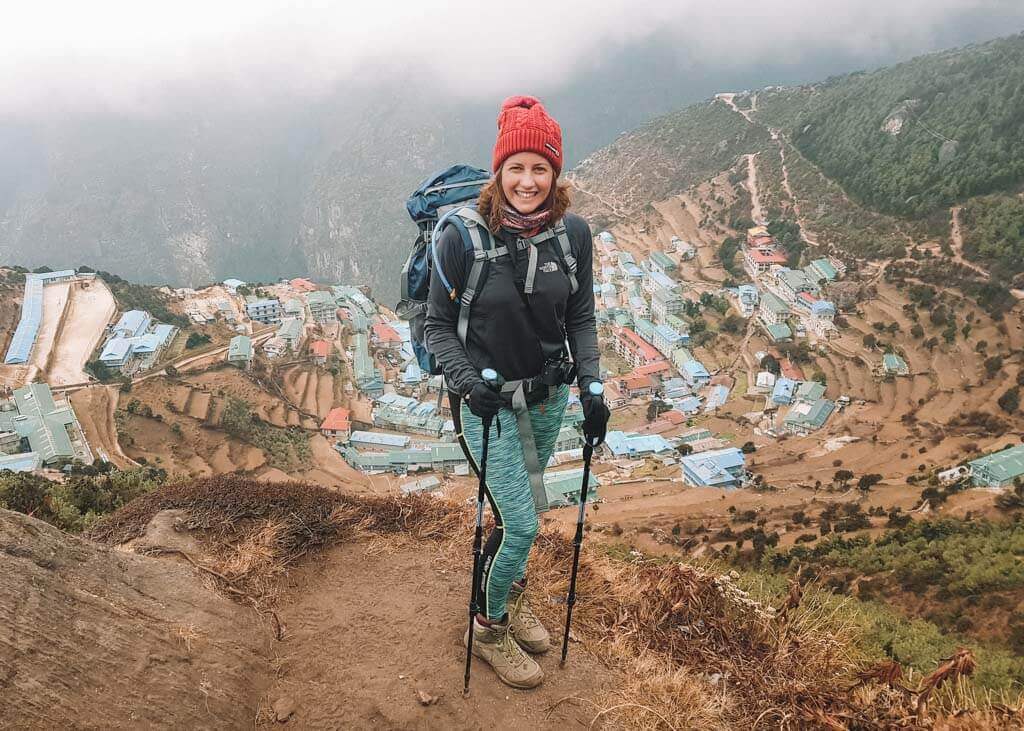
Altitude: Namche Bazaar (3 440m) – Everest View Hotel (3 880m) – Namche Bazaar (3 440m).
Trekking Time: 3 hours | 2.5 km.
Difficulty: The path itself isn’t too difficult, but with the elevation gain, you’ll begin losing your breath quickly.
Highlight: Watching Everest documentaries at Liquid Bar in Namche Bazaar (3 pm or 7:30 pm).
Overview: A short hiking day to Everest View Hotel and back, followed by free time to explore Namche Bazaar.
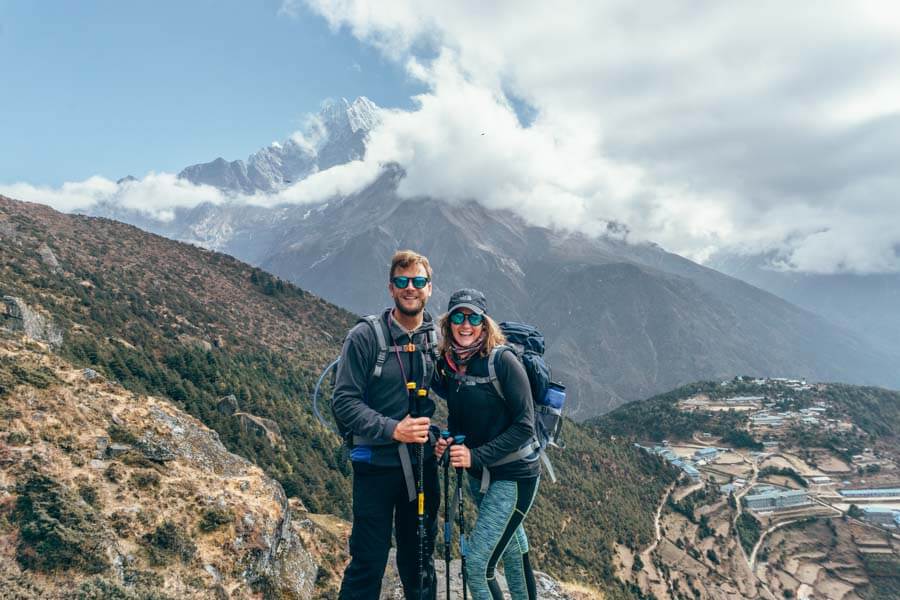
Even if you’re not feeling up to it, it’s important to get out and hike to a higher point, before coming back down to sleep at a lower altitude.
Today is also your second chance to get a glimpse of Mount Everest if you didn’t the day before. The trek is a tough one, and if you have not yet felt any symptoms of the higher altitude, you’ll soon begin to experience them.
Tip: There are many pubs and bars which show Everest documentaries. Make sure you watch one during your time in Namche Bazaar (But don’t drink alcohol on your way up – save that for when you return).
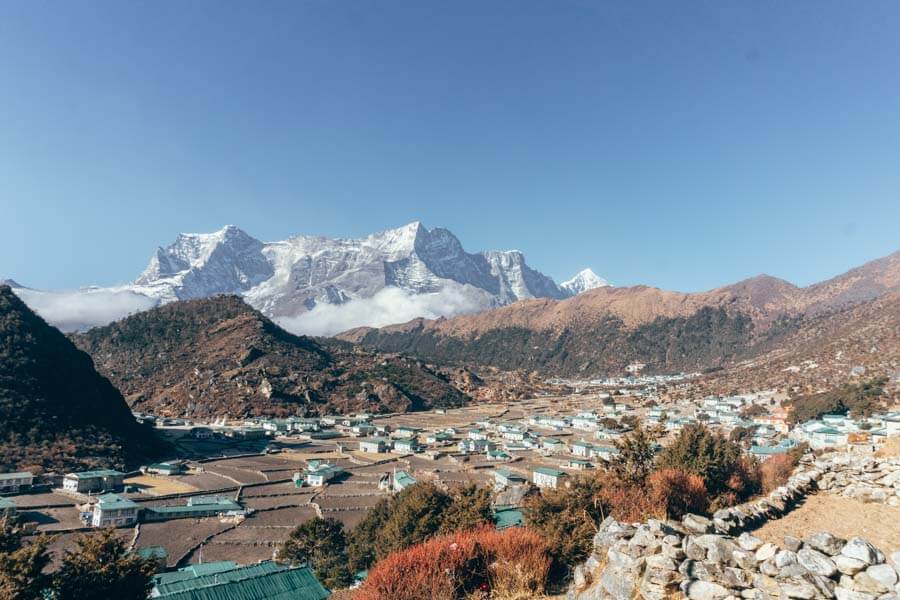
Route: Namche Bazaar (3 440m) – Khumjung (3 780m).
Trekking time: 4 hours | 4 km.
Difficulty: Moderately easy as it’s a short trekking day but from today the cold sets in.
Highlights: Playing card games in front of the fire, wrapped up in my sleeping bag because it was so cold.
Overview: You’ll go off the standard trekking route from Namche to Khumjung.
Tea House: Hill Top Lodge.
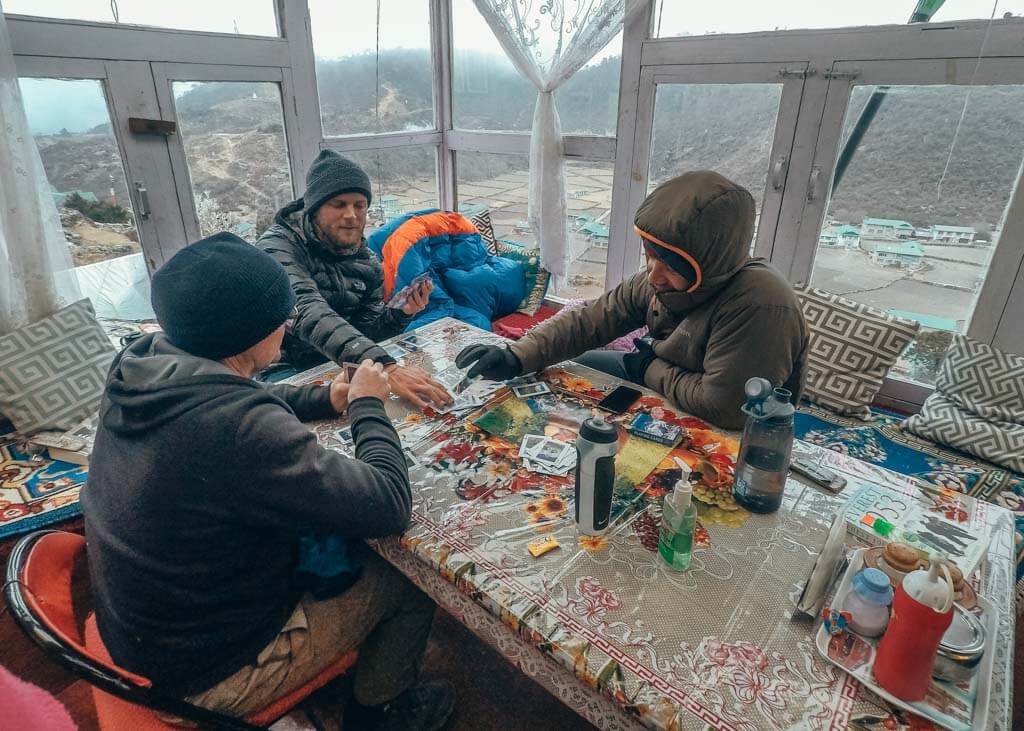
This is where most Everest Base Camp trek itineraries differ. From Namche Bazaar, there are two routes you can take both of which link up again in Dingboche on day 6 of your trek.
The first option (and most popular) is from Namche to Tengboche, before reaching Dingboche .
The second option (and my chosen route) is from Namche to Khumjung and Phortse which are on the other side of the river.
I chose the Khumjung route as it’s the less popular option. As a result, the hike isn’t as crowded, yet it offers the same sweeping views of the valleys below. But don’t worry, you’ll still get to experience the Tengboche route on your way back down from Everest Base Camp to Lukla.
Today was the first day that I layered up as it did get quite cold. You’ll pass a small local hospital as well as the famous Sir Edmund Hilary School before arriving in the small village of Khumjung.
When you get to Khumjung you’ll notice the change in the landscape. It’s far more arid and drier, with very few green luscious trees.
Tip: Ensure you have a pack of playing cards and a book with you. They’ll come in handy on short trekking days like today.
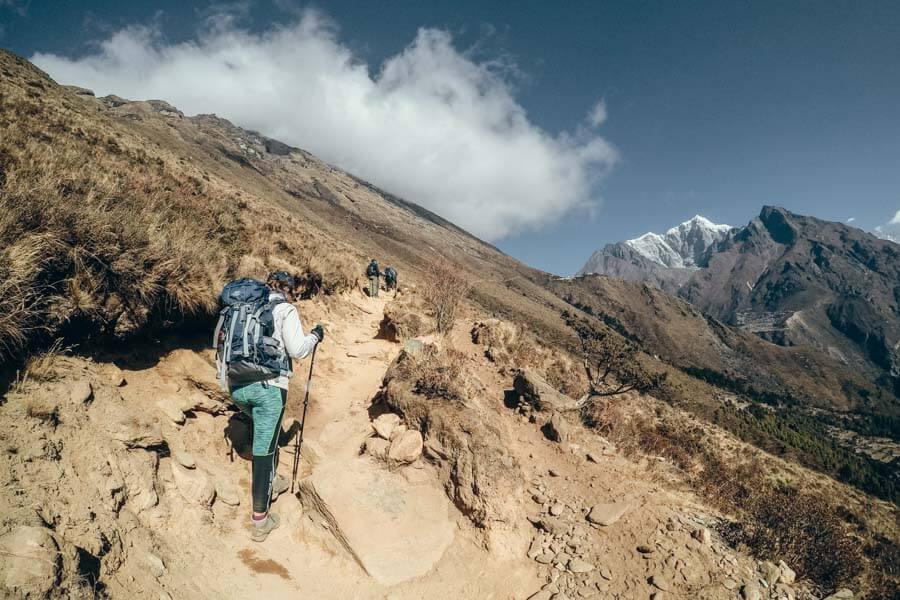
Route: Khumjung (3 780m) – Phortse (3 900m).
Trekking time: 6 hours | 7 km.
Difficulty: Although there isn’t much altitude gain today, there are still many sections where you walk downhill, before climbing back uphill so this constant up/down is strenuous.
Highlights: Today was the first day I began to feel the effects of the high altitude and I lost my appetite.
Overview: The trail from Khumjung to Phortse is incredibly scenic and you’ll walk alongside all the Himalaya giants.
Tea house: Phortse Resort.
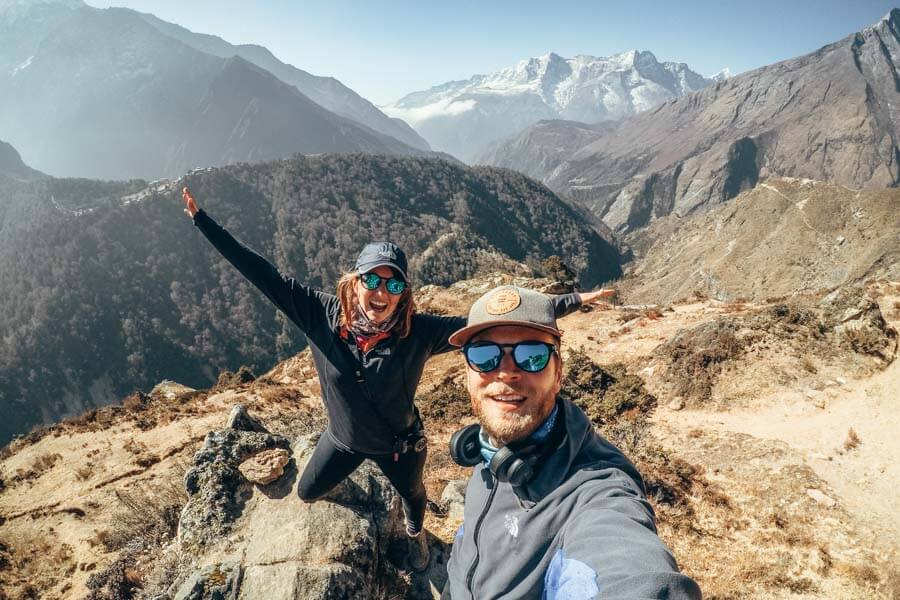
Day 5 of your Everest Base Camp trek itinerary will start with a 2-hour climb to Mongla (3 975m). You’ll then go back down to 3 800m which is the elevation of your next stop, Phortse.
You’re still on the “quieter” route so enjoy this path as it gets busier from tomorrow when you head to Dingboche.
Today is the day I started to feel the effects of altitude sickness and by the time I reached our lunch stop, I had lost my appetite and a terrible headache was setting in. I wrote this detailed guide to how hard Everest Base Camp is and it includes these moments where i felt horrible!
There is also a considerable drop in temperature – It was 4 degrees celsius when we started walking today. The pipes in Phortse were frozen and the guides start to give you hot water in the evening which will be your drinking water from here on out.
Tip: When you’re given hot water in your drinking bottles, put one inside your sleeping bag to act as a hot water bottle.
Tip: I took a headache tablet at lunchtime and after a good night’s rest, I was feeling much better. If you’re not feeling well, don’t be afraid to take a pain killer but make sure you communicate with your guide so that he knows to keep an eye on you.
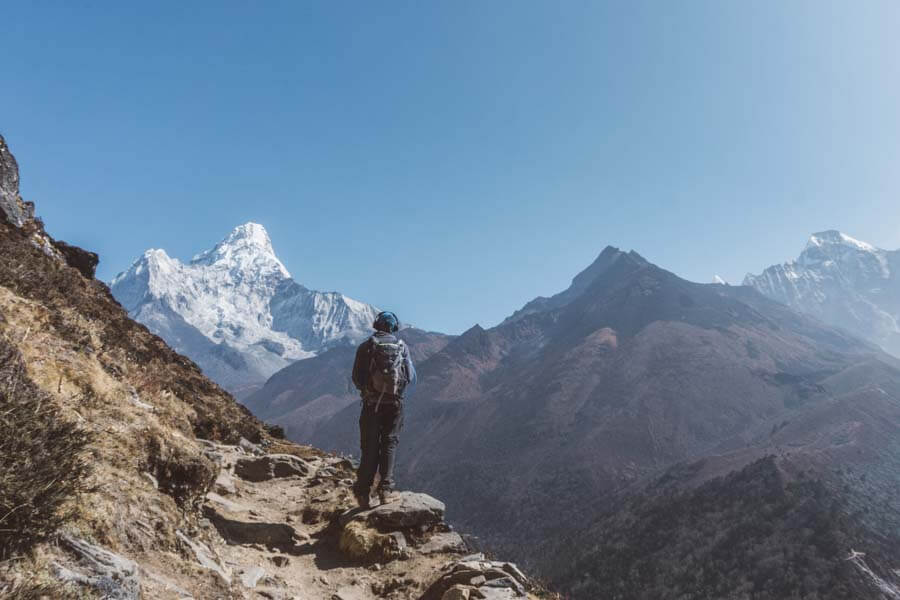
Altitude: Phortse (3 800m) – Dingboche (4 360m).
Trekking time: 8 hours | 9 km.
Difficulty: Today is a long, tiring day and breathing is difficult. The first few hours are tough, followed by an easier trek as you get closer to Dingboche.
Highlights: Arriving in Dingboche – today was a hectic day and I was so happy when it was over!
Overview: You’ll trek the entire day with a constant gradual incline until you arrive in Dingboche, where our EBC itinerary will meet up with the others who are coming from Tengboche.
Tea house: Sonam Friendship Lodge.
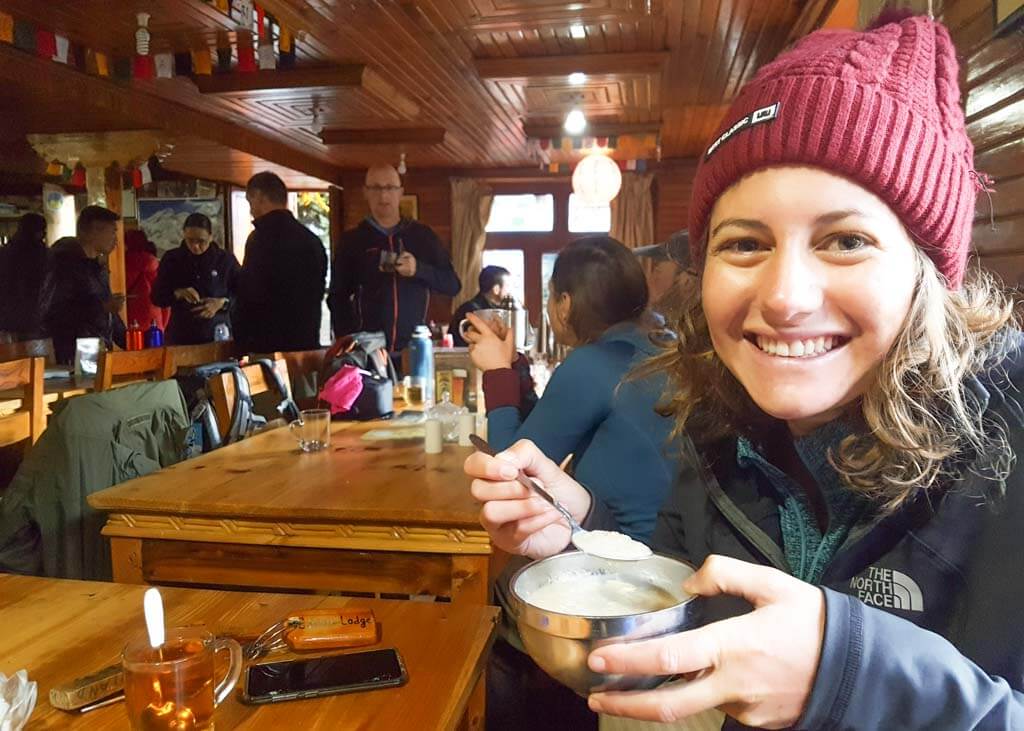
Today is a long trekking day!
When I woke up on day 6, I was feeling fit and strong (unlike the afternoon before) . I was extremely aware of how sick I had felt yesterday and despite feeling better, I took precautionary measures and walked extra slow with many breaks.
The first 5 hours involve constant uphill climbs, followed by downhill treks, before going uphill again! You’ll eventually pass the tree line, and the entire landscape becomes bare and rocky and resembles a desert.
Today you’ll be surrounded by all the Himilayan giants: Ama Dablam, Nuptse, and Cholatse, with unspoiled views of Mount Everest.
Throughout the day you’ll hear the sounds of helicopters making emergency rescues as trekkers begin struggling with the higher altitude and need to be taken back down to Namche Bazaar from Everest Base Camp. It’s quite scary to see how frequently people require this emergency assistance!
Luckily, the final stretch to Dingboche after lunch isn’t as tough as the section before.
Tip: There’s no cell reception as you get closer to Dingboche so enjoy the next few days going off the grid.
Tip: On day 6 of our Everest Base Camp itinerary, a few trekkers started taking altitude sickness medication as a precautionary measure. I didn’t take Diamox but my guide had in case I needed it. As always, be cautious of the altitude.
Tip: You’ll lose your appetite, but order boiled potatoes to get some food into your stomach.
Today is the last of your acclimatization days so you’ll spend a second night in Dingboche. Again, it’s important to do an acclimatization hike from Dingboche .
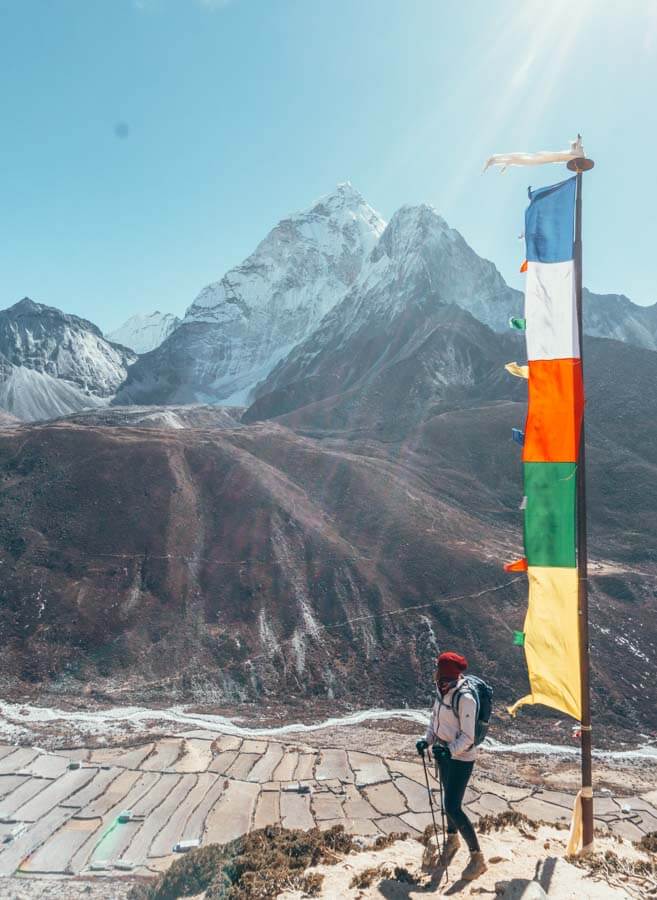
Altitude: Dingboche (4 360m) – viewpoint (4 900m) – Dingboche (4 360m).
Hike time: 3 – 5 hours | 3 km.
Difficulty: Short, but steep climb so take it slow and steady.
Overview: Today is a short acclimatization hike to a viewpoint and back.
Highlight: Views of the Chukhung Valley and Island Peak.
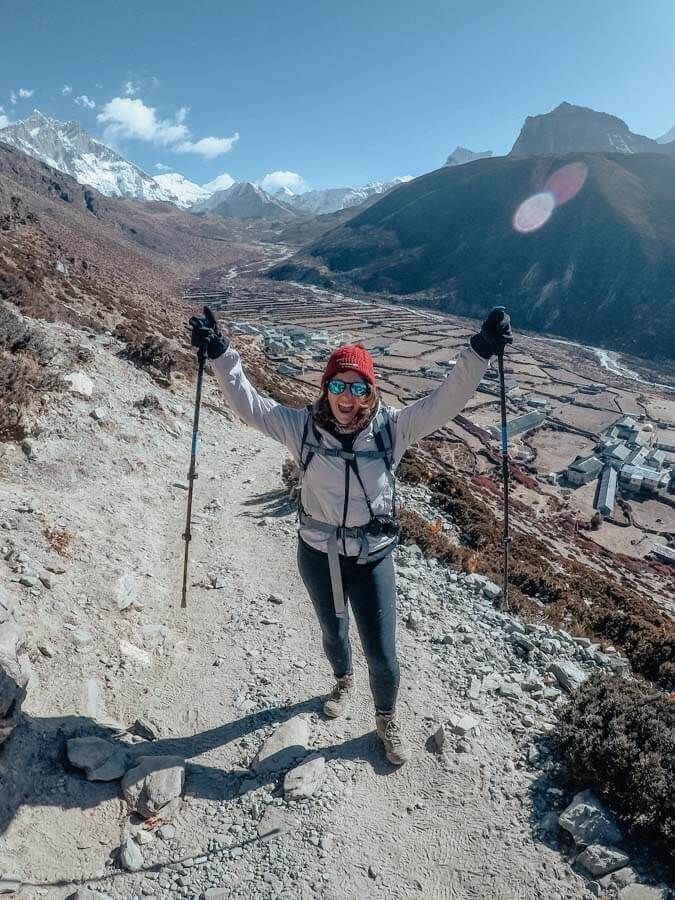
I woke up on day 7 of my EBC trek and I was feeling terrible. The Khumbu cough had really set in, I was freezing cold, my nose was constantly running and I was beginning to lose my voice.
When you reach Dingboche, the luxuries of warm water, comfortable beds, and flushing toilets are long gone, and this is when the mental challenge begins. But listen to your body and be honest with your guides about how you’re feeling.
During my time in Dingboche, a porter from a different tour group (who had hiked to EBC many times before) had gotten sick and had to be airlifted back to Lukla. This was a harsh reality of the effects of high altitude climbing and how it can happen to anyone, no matter your experience, fitness level, or age.
Dingboche Acclimatization Hike
Today you’ll go on an acclimatization hike to a viewpoint overlooking the Chukhung Valley. Going to this higher altitude, and then returning to Dingboche will make you feel so much better (as it did for me). So, gear up, pack your day bag, and head outside for a few hours.
The acclimatization hike from Dingboche to the viewpoint is pretty steep and rocky, but you’ll be hiking at a much slower pace than the previous days. All around you, you’re surrounded by towering mountains and peaks, and it’s a sight you won’t easily forget!
Once at the viewpoint, you’ll have the best views of Ama Dablam and Island Peak, as well as the symbolic prayer flags.
I added Island Peak to my Everest Base Camp itinerary (and I HIGHLY recommend you do the same). It’s 4 extra days of trekking after you’ve reached Everest Base Camp, and it was one of the best and most thrilling experiences of my life!
Tip: After returning from your acclimatization hike pop into Cafe Himalaya Bakery to watch their daily Everest movie.
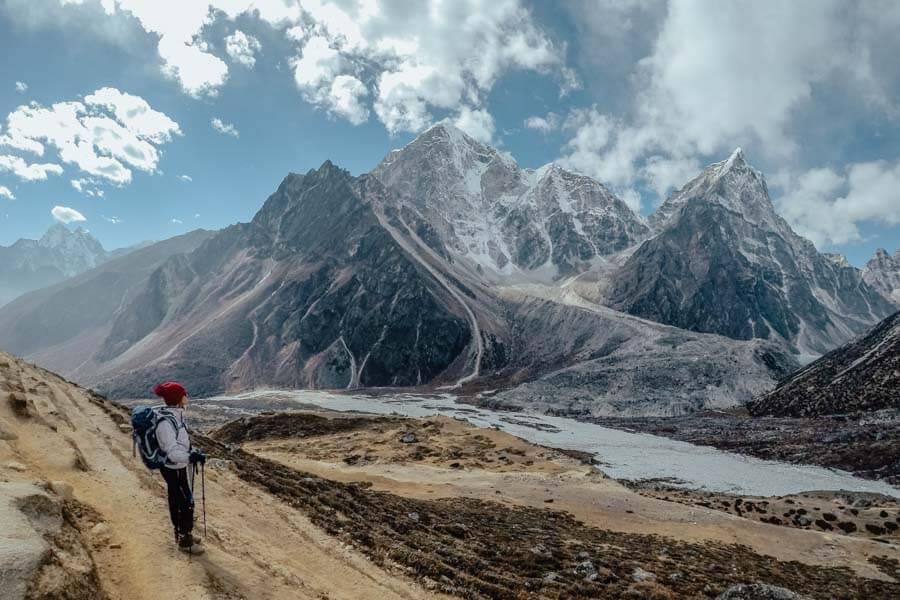
Altitude: Dingboche (4 360m) – Lobuche (4 930m).
Trekking time: 7 hours | 10.7km.
Difficulty: Hard! The section from the bottom of the icefall to the Everest memorial is brutal. It’s steep, and it’s far.
Highlight: The climb to the Everest memorial. It’s painfully steep and I struggled!
Overview: As you leave Dingboche, the first part of your trek is relatively easy. Until you reach Dukla! This is where the trail becomes steep. From there it’s an excruciating 2-hour climb before the path becomes flat again. You’ll walk alongside the Khumbu Glacier, the longest glacier in Nepal.
Tea house: Sherpa Lodge.
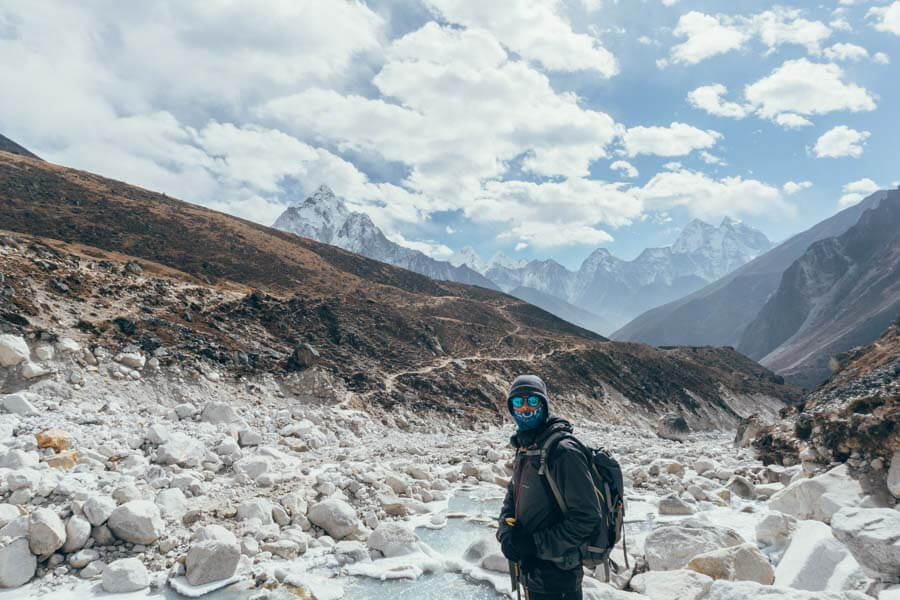
I kept a day-to-day journal of my Everest Base Camp trek itinerary, and in it, day 8 is highlighted (in capital letters with several exclamation marks) “ The hardest day EVER! ”
And thinking back to this day, it really was!
The first 3 hours include a gradual incline before crossing to Dukla which will be your lunch stop for the day. Enjoy the break, because you are going to be hating life for the next 2 hours – it’s a killer of a climb. Breathing at an altitude of over 4 500m doesn’t make it any easier!
You’ll pass many trekkers who are making their way back from Everest Base Camp. I was shocked to see the condition most of them were in. Many people were even getting carried down by mules! They looked like they had really taken strain – coughing, no voice, chapped lips, and no energy.
I was hoping and praying that wouldn’t be me in a few days (but unfortunately, it was – except I didn’t need to be carried down!)
Everest Memorial
At the top, you’ll reach the Everest Memorial for climbers who’ve lost their lives in their attempt to reach the summit of Mount Everest. There is a somber mood, and I get goosebumps thinking about all those climbers and their families.
From the memorial, it’s about a 1-hour trek alongside the Khumbu Glacier to Lobuche. This last section is far easier than the previous one. Again, take it slowly!
Tip: At this stage, everyone is feeling the effects of the altitude and the cold. You’re not alone! Just keep pushing through, it’s nearly over! (says me who wanted to turn back countless times) .
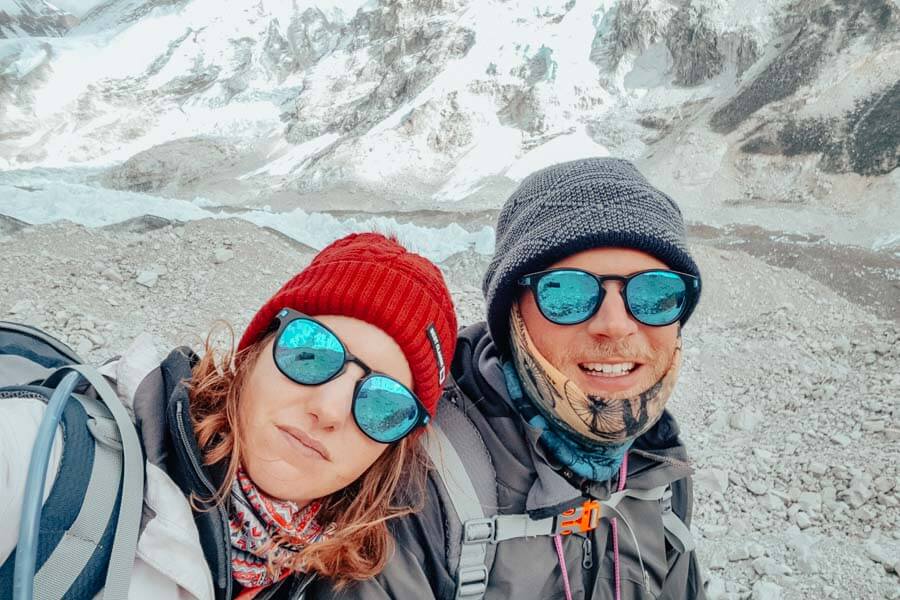
Altitude: Lobuche (4 930m) – Gorak Shep (5 160m) – Everest Base Camp (5 360m) – Gorak Shep (5 160m)
Time: 10 hours | 12 km.
Difficulty: Moderate with a steep climb towards Gorak Shep and an easy trail to Everest Base Camp. The difficulty lies in hiking time and the high altitude.
Overview: Today is the day you reach Everest Base Camp! You’ll arrive in Gorak Shep, drop off your bags and have lunch before departing north along the Khumbu Glacier to Everest Base Camp.
Highlight: It should be reaching Everest Base Camp, right?
Tea house: Buddha Lodge
Whilst the previous day’s hike from Dingboche to Lobuche was certainly the toughest and most physical section, getting to Gorak Shep, and then on to EBC and Kala Pattar were the most emotionally and mentally challenging sections of my entire Everest Base Camp trek itinerary.
Your day will start with a moderate hike leading to Gorak Shep from Lobuche. After about an hour into your hike, the path becomes steep with numerous boulders to pass. Whilst it isn’t a strenuous climb, the altitude will affect you and you’ll be walking very slowly.
Gorak Shep and Everest Base Camp
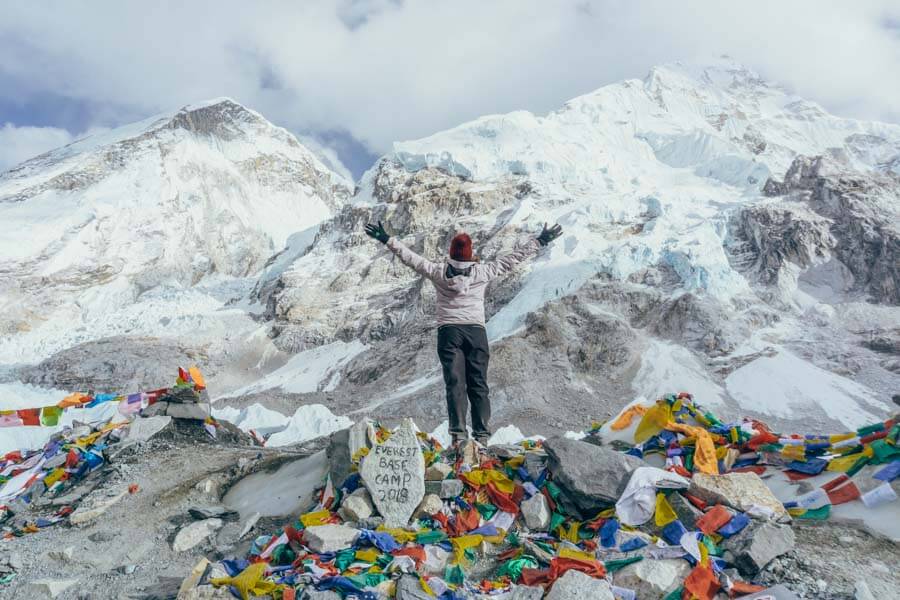
You’ll reach Gorak Shep at lunchtime where you’ll drop off your bags and prepare for the afternoon hike to EBC.
You don’t actually stay at Everest Base Camp. Gorak Shep is your base with the closest tea house to EBC.
After lunch, you’ll trek to Everest Base Camp. The path is made of rocky sections and loose stones. You’ll be exhausted at this point. But the adrenalin rush will keep you going. The excitement to finally reach Everest Base Camp will get you to the end.
Arriving at base camp is surreal. You can see the Khumbu Icefall in the distance, one of the most notorious sections leading up to the Everest summit.
It’s an eerie feeling reaching Everest Base Camp but absolutely gorgeous standing at the foot of the highest mountain in the world.
You’ll then make your way back to Gorak Shep which is where you’ll spend the night.
The reality
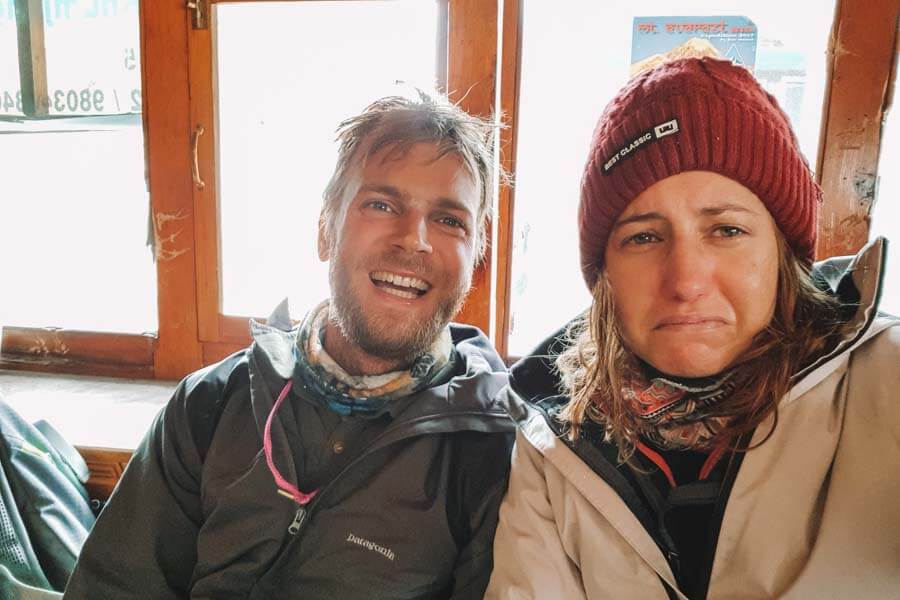
The most vivid memory I have of my entire Everest Base Camp trek is sitting in the tea house in Gorak Shep after returning from Base Camp.
The communal area of more than 60 people was quiet. You could only hear the sounds of loud coughing. There were no celebrations by those who had made it to Everest Base Camp and the atmosphere was not jovial.
Everyone was feeling sick and looking worse for wear. People were being helivaced from Gorak Shep to Lukla, others were on oxygen. You could see trekkers struggling to take a bite of their food.
I was so emotional because I was just so incredibly exhausted. You could sense that everyone was at their breaking point and had been pushed to their limits. Including me.
Tip: Don’t rush! Remember that you’re breathing in air with 50% oxygen. Many trekkers get excited as they’re so close to Everest Base Camp, but you still need to be careful. From what I saw, several people got sick and had to be put on oxygen AFTER they’d successfully reached EBC, perhaps this is because they’d taken it too fast.
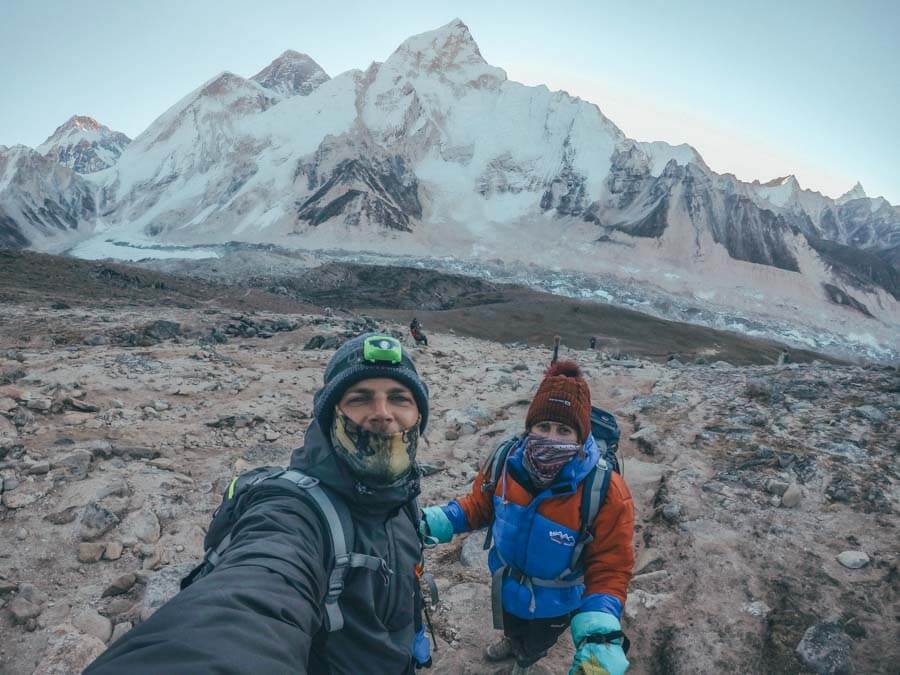
Altitude: Gorak Shep (5 160m) – Kala Patar (5 643m) – Pheriche (4 370m).
Trekking time: 7 hours | 13 km.
Difficulty: This day is difficult, only because of Kala Patthar! The rest is easy as you’ll be going down the mountain to a lower altitude.
Highlight: Everything about the trek up to Kala Patthar. The 5 am wake-up call, the ice-cold temperatures, the steep trail, the incredible view!
Overview: The day starts with an early morning trek to Kala Patthar for the best views of Mount Everest. After returning to Gorak Shep, you’ll head back down to Pheriche.
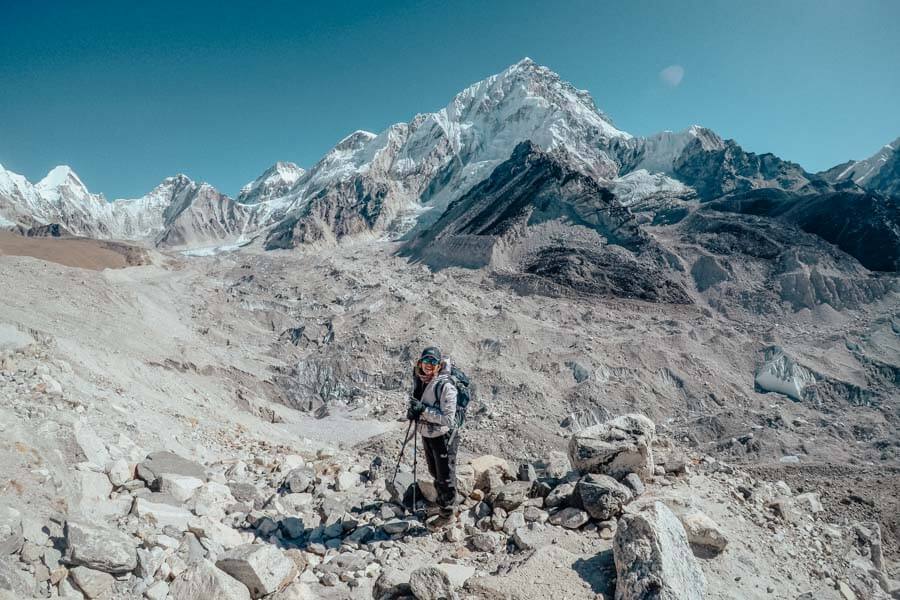
You can’t actually see Mount Everest from Everest Base Camp or Gorak Shep as Lhotse sits in front of it and blocks the view.
This is why people trek to Kala Patthar, which is a nearby viewpoint next to Gorak Shep.
Be prepared for a long and tiring day! Just when you thought it couldn’t get any tougher, day 10 of your Everest Base Camp trek will really push you to your limits.
Sitting at 5 643m, Kala Patthar is a small, rocky peak with a rewarding view of Mount Everest, Changtse, Lhotse, and Nuptse.
Your morning starts with a 5 am wake-up call as you prepare to hike to Kala Patthar. Some trekkers choose to skip this part of the itinerary because they’re too sick and just do not have the energy to make it to the top.
The main goal is Everest Base Camp, right? You’ve made it!
You don’t have to climb Kala Patthar. Listen to your body and if you’re not feeling well, don’t do it! I was incredibly slow, fatigued, and sluggish and only got about ¾ of the way to the top before our guide advised that we turn back.
If we didn’t, we’d fall behind on the day’s schedule.
After climbing Kalla Patthar, we arrived back at our tea house at Gorak Shep at about 9 am, had a quick breakfast then began our long trek past Lobuche and on to Pheriche.
My day hadn’t got off to a good start and I was feeling very weak hiking Kala Patthar, but as soon as we began our downhill climb, I regained my strength and felt like a different person!
Tip: If you’re feeling sick at Gorak Shep, make sure you monitor this but the moment you go to a lower altitude, you will feel stronger.
Tip: If you’re continuing to Island Peak, you can check out my Island Peak guide. To sum it up, from Gorak Shep, you’ll go to Dingboche ( and not Pheriche as this route goes) . After spending the night in Dingboche, you’ll go in a different direction to Chukhung and Island Peak Base Camp.
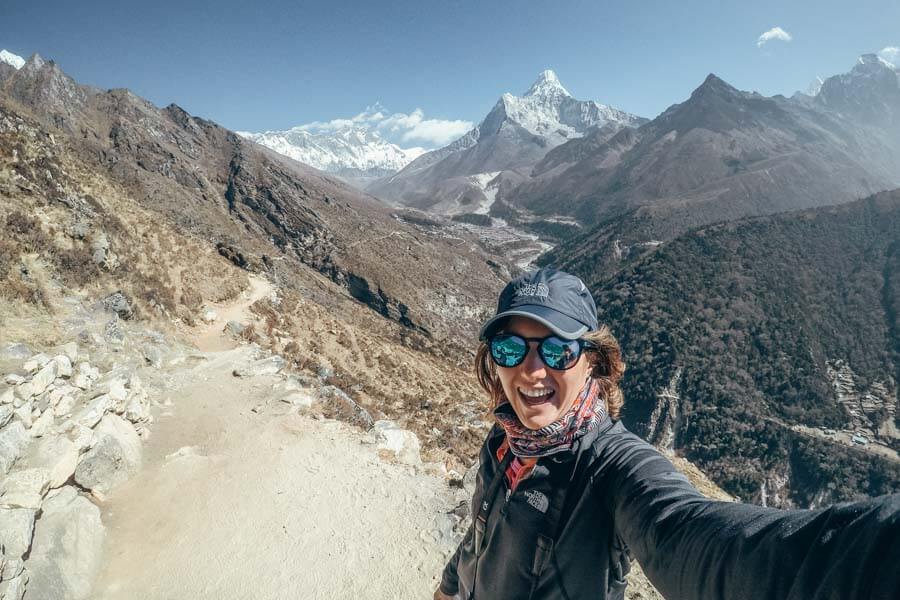
Altitude: Pheriche (4 280m) to Namche Bazaar (3 440m).
Trekking time: 14km | 8 hours.
Difficulty: Easy but a long day of hiking.
This day (and the next) are particularly long and you’ll want to get off the mountain ASAP!
You’ll be running down from Pheriche to Namche Bazaar as it’s so much easier to breathe as the elevation decreases. You’ll also be craving a hot shower, clean clothes, a proper meal, and a warm bed.
Soon, you’ll hit the tree line once again, cross over suspension bridges, and pass scores of mules.
After every corner, you’ll think you’ve reached Namche Bazaar, but it’s further than you expect, and the trail seems to go on forever. On your way down you still have sections where you climb up and down (yes, more climbing), but there’s no altitude gain so who’s complaining!
You’ll pass Tengboche, which is home to the largest monastery in the Khumbu region and the village where most trekkers stop on their way up the mountain (But we chose a different route on this Everest Base Camp trek itinerary).
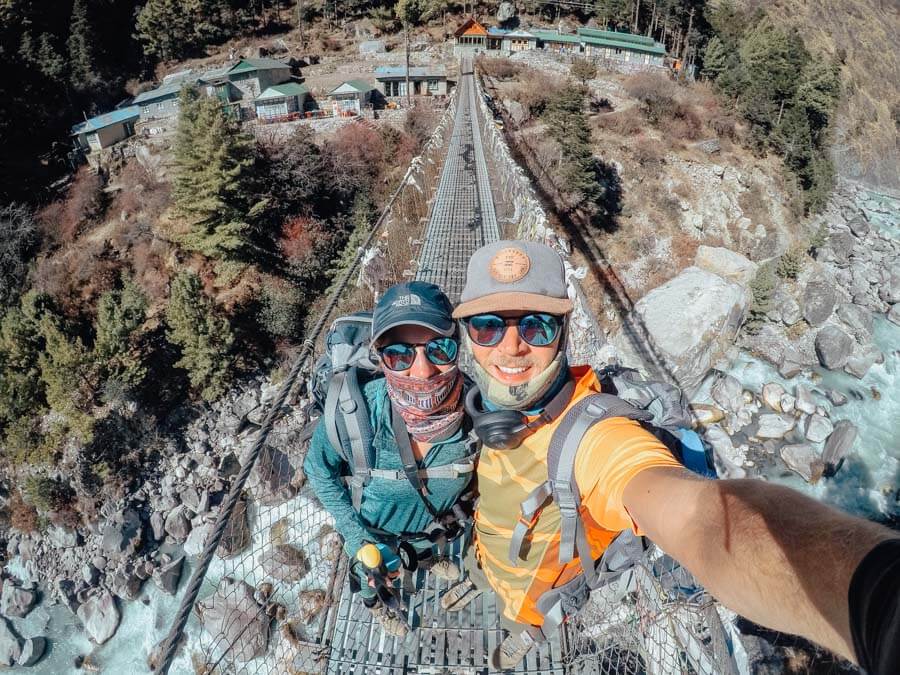
Altitude: Namche Bazaar (3 440m) – Lukla (2 860m).
Trekking time: 18 km | 8 hours.
Difficulty: Same as yesterday! A long day of hiking.
You’ve made it to the last day of your Everest Base Camp trek itinerary! Today you’ll retrace your steps from Day 1 and 2 (except this time you’ll cover the same distance in 1 day, and not 2!)
You’ll also see other trekkers ascending to EBC looking bright-eyed and bushy-tailed. If only they knew what was in store for them over the next few days! You’ll smile at them, and offer words of encouragement, but deep inside, you’ll just thanking your lucky stars that it’s them going up, and not you!
Enjoy your last lunch on the mountains in the village of Phakding before taking on the last section to Lukla. Spend the night in Lukla where you’ll celebrate with a delicious meal and a few cold beers!
Last day of your Everest Base Camp itinerary: Lukla to Kathmandu
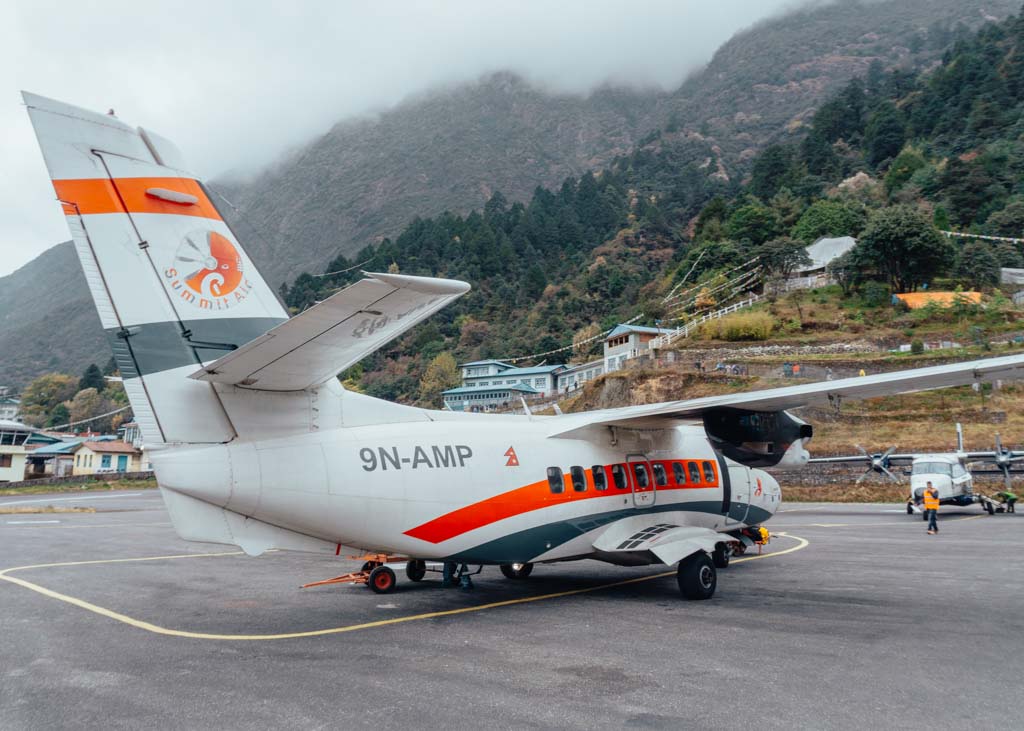
On the last day, you’ll be ready to say goodbye to the mountains! Once again your flight isn’t guaranteed to leave on schedule so one last bit of patience is required.
After I landed in Kathmandu, I went straight to my hotel, had the best hot shower EVER, ordered takeaways, hopped into bed, and didn’t leave my room for 24 hours! Those 24 hours of doing nothing were absolutely incredible!
Pictures speak a thousand words! After going through my EBC trek itinerary, check out my photo diary with includes all the highlights of my trek to Everest Base Camp.
Is Everest Base Camp trek worth it
Absolutely – But it’s not easy! From the terrifying flight into Lukla to the long trekking days, freezing cold tea houses, weeks with no showers, dealing with altitude sickness, and all the aches and pains that come along with it – It’s brutal.
But the experience is incredible and you’ll gain memories that will last a lifetime!
Should you plan your Everest Base Camp Itinerary with a tour or not
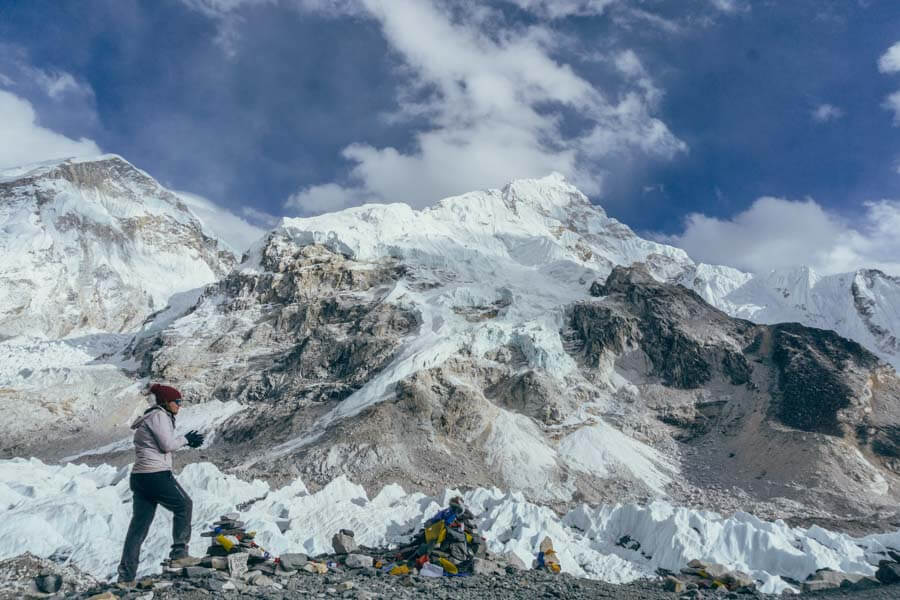
This one’s debatable!
In 2014 I summited the highest mountain in Africa, Mount Kilimanjaro . For this trek, you have to book a tour through an organized trekking company. I thought the same would apply to Everest Base Camp and wrongly assumed that attempting to conquer EBC independently was only for broke backpackers or highly experienced hikers.
I was wrong! You can definitely navigate the Everest region without a guide and many people do so.
However, I don’t regret booking through a trekking company, Mountain Monarch . Here’s why.
Why I booked my EBC trek with a tour group

Firstly, I added Island Peak to my Everest Base Camp itinerary. For this extra section of the trek, a guide is required. Whilst Everest Base Camp requires no technical climbing, Island Peak does and it’s intense.
If you’re up for the challenge, I highly recommend you add Island Peak to your Everest Base Camp tour. You can read about my climb to Island Peak here!
Secondly, I had previous experience with high altitude climbing and if it wasn’t for my skilled guide, I wouldn’t have made it to the summit of Mount Kilimanjaro. As with Kili, getting to Everest Base Camp is tough and reality is that it can be fatal. You need to pace yourself. Many people are put on oxygen and need assistance and those who trek independently don’t have immediate access to these emergency services.
And lastly, the fellow trekkers that I met on my Everest Base Camp tour were the best teammates anyone could ask for. I loved the support, the humor, the motivation, and having a small group of people who were there for me through thick and thin. As you get to the end of your Everest Base Camp trek, you’re going to need all the support you can get.
Final thoughts on how to plan a trek to Everest Base Camp
Trekking to Everest Base Camp is tough. Looking back, there are so many moments where I was thinking “ Why the F$%# did I sign up for this ” and “ With this money, I could’ve spent an extra 3 months backpacking instead of putting myself through this torture “.
But, challenging myself, my mind, my body – and crushing my goal and STILL going on to summit Island Peak – man, you cannot beat that feeling!
Are you planning a trip to Everest Base Camp? Looking for more information on how to get from Lukla to Everest Base Camp? Drop me a question in the comments section below!
Psst… Looking for epic adventures to add to your bucket list? Check out my other posts!
- Complete Guide To Island Peak Climbing in Nepal
- The Perfect Everest Base Camp Packing List
- 10 Things You Need To Know For Your Kilimanjaro Trek
- Everest Base Camp Trek Difficulty: 11 Key Things You Need To Know
- Everest Base Camp Trek with Island Peak Climbing: My Highlights and Photo Diary
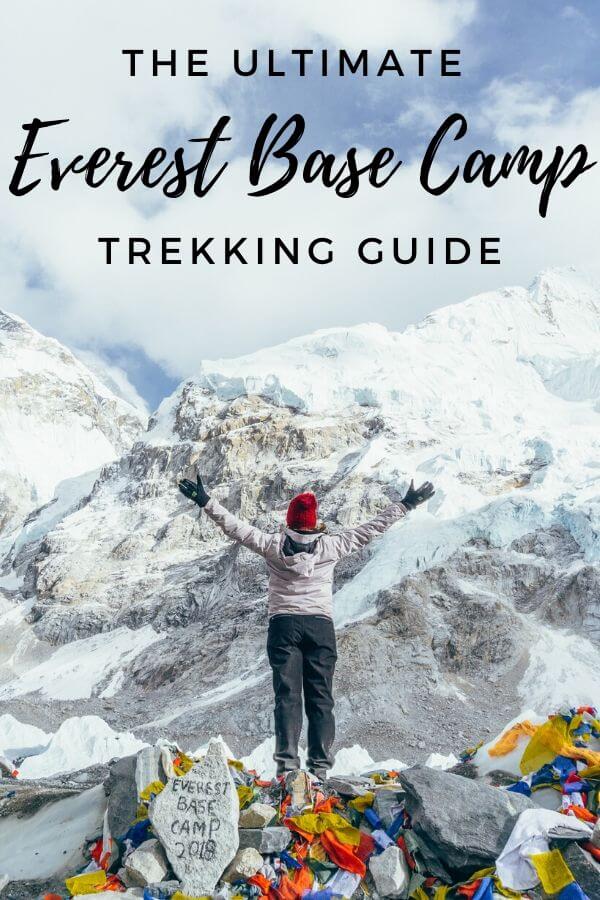
Hi, I'm Carryn. I’m an adventure travel blogger trying to figure out my way through life by traveling and exploring. Join me as I share my travel guides and tips for life abroad. Find out more about me here .
Backpacking Indonesia: 26 Things I Wish I Knew
Everest base camp trek difficulty: 12 key things you need to know, 24 thoughts on “the ultimate everest base camp trek itinerary: how to get from lukla to everest base camp”.
Wow! Sounds like such an adventure. I loved reading your in depth post about your Everest base camp itinerary. It sounds like there is so much that goes into preparing but definitely sounds like you had the adventure of a lifetime.
Thanks Ann. It sure was an adventure I’ll never forget!
Ok, this post was epic – so much information I have to save it. Thanks for sharing!
Thanks Laura! Glad you found it helpful.
this is absolutely breathtaking! i honestly don’t know if I would ever be prepared to do this myself, but your day by day break down was really helpful!
Thanks Claire! Looking back at the photos I’m still in shock that I managed to get to Everest Base Camp!
Amazing. What a trek and journey for your mind, body and soul!
It was indeed!
This is epic! Im going in April and I’m so excited. Ive done Annapurna base Camp and loved it so I’m sure ill love this too!
Hi Emma, Good luck for your trek! I’d love to hear how EBC compares to Annapurna.
So interesting to read about your experience! I’m going to Nepal soon to do the Annapurna base camp and mardi Himal. They have a lower altitude but I’m still a bit nervous because of the altitude sickness 🙆🏼♀️
Hi Nina, I’m sure you’ll love it. Just take your time and don’t be afraid to walk super slow (like I did)!
WoW! This sounds like one amazing trip and one I’m sure that you will never forget! Really inspiring
Thanks Lori. EBC tops my bucket list so now I’m looking for the next adventure to conquer!
Wow! This sounded so intense! What an experience to say that you’ve done it.
It was tough, but everyone goes through a different experience. I thought about turning back so many times, but I’m so glad I stayed strong and kept going!
Wow! What an incredible experience, I don’t know if I’m ready for it but you definitely gave me some things to think about, thanks for sharing!!
Thanks Meghan!
Amazing!!! Wonderful recap! EBC isn’t easy! That was my first dance with altitude! Need to get back to do Island Peak!!!
Hey Bridget, Island Peak is incredible and I’m so glad I added it to my Everest Base Camp itinerary. Congrats on making it to base camp!
BADASS! I love that you mentioned a longer itinerary to acclimatize (is that the right word? lol) naturally and a way to get off the beaten path for this popular trek! I hope to make the Everest Base Camp Trek in the coming years and this is definitely a guide I will come back to help plan (: AND CONGRATS on killing it on this hike! So epic!
Hay Aaren, thanks for the kind message! I’m so stoked that I made it to base camp. And you can to! If you ever decided to trek to EBC, let me know!
Congrats on choosing the High Scenic Trail via Mong La and Phortse instead of the crowded Tengpoche route 95% of trekkers use. The best kept secret in Khumbu is finally leaking out!
About helicopter traffic: Google [helicopter rescue scam Nepal] and be educated. Multimillion dollar business now, thousands of EBC trips destroyed every year with this insurance fraud.
Hi Petrus, Agree – the less crowded route is far better!
Leave a Comment Cancel reply

Everest Base Camp Trek: The Ultimate Guide
Jackson Groves
Posted on Last updated: August 10, 2023
Categories NEPAL , HIKING
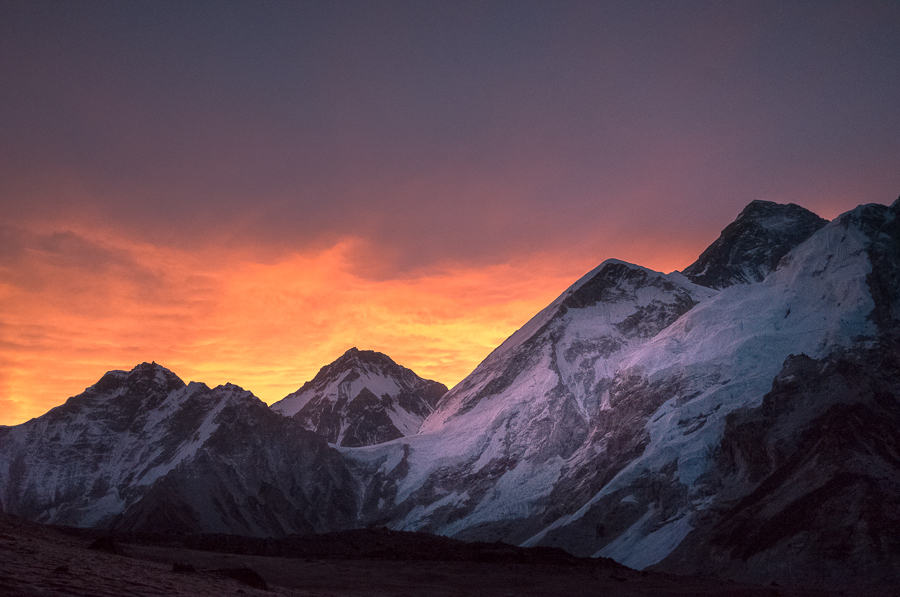
Mt. Everest is the highest mountain in the world and trekking to the base camp is no easy feat either. It’s a journey through some of the most spectacular mountain views but also through a number of beautiful villages along the way. The Everest Base Camp Trek takes anywhere from 9 to 15 days depending on your route and itinerary but also how well you acclimatize.
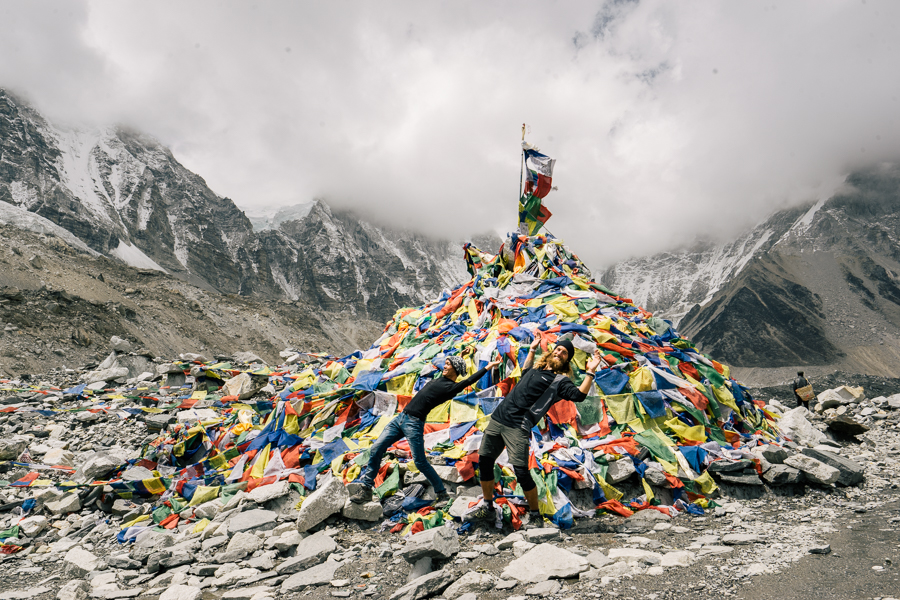
In this article, I will cover everything you need to know about the logistics of the Everest Base Camp (EBC) trek but I will also share with you my experience on each day of the trek. A short journal entry with a vlog from my experiences from each day will give you an idea of what to expect and you can see how the journey went for me. After sharing my experience, I will then include all of the information you need to know in this complete guide about trekking to Everest Base Camp.
BEST TREKKING COMPANY IN NEPAL
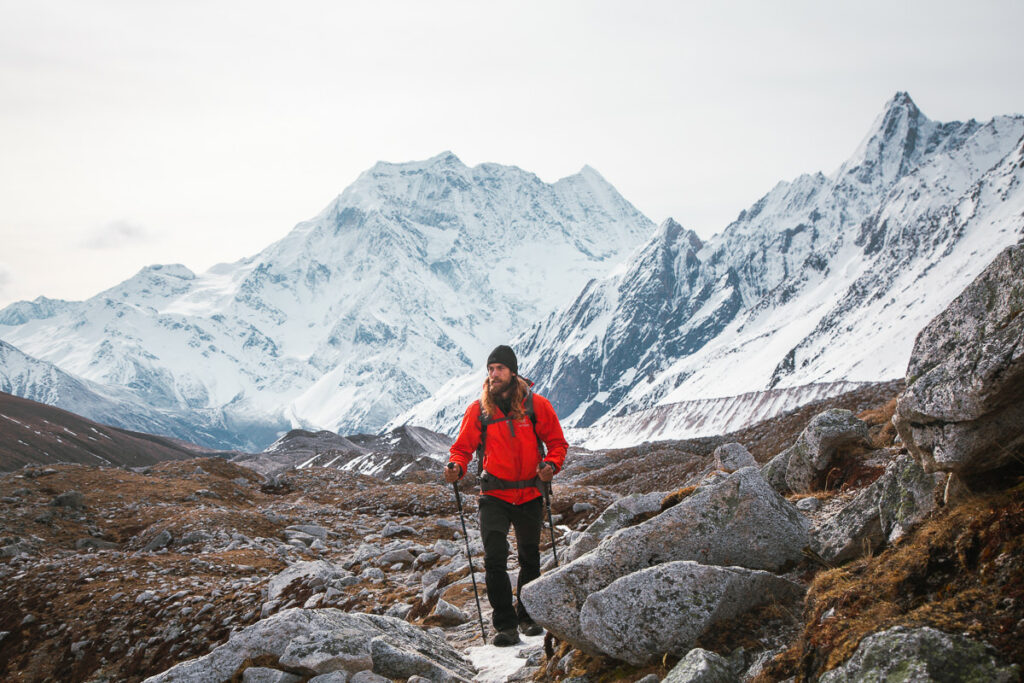
Interested in trekking in Nepal or doing the Everest Base Camp Trek? I recommend booking your trek with Himalayan Masters , which is the company I use for all of my treks in Nepal. Use my code JACKSON5 when you book to receive a 5% DISCOUNT .
Table of Contents
EVEREST BASE CAMP TREK DETAILS
- Distance : 120 km round-trip from Lukla to Base Camp and back to Lukla (You will fly to Lukla from Kathmandu)
- Days required : 12 -14 days
- Total Incline : (Undulation) – 6015 m
- Total Decline :(Undulation) – 5821 m
- The highest point on the trek : 5640 m/18 500 ft, this is actually at Kala Patthar, which you will hike to in the morning after reaching Everest Base Camp. This is where you get the best views of Mount Everest.
- Difficulty : It’s hard for an average hiker but the altitude is definitely more difficult to manage than the distance with several rest days and acclimatization days.
- Permits : Your tour operator will take care of these but in case you do the trek independently it’s good to know that you will pay a Local Government fee and Sagarmatha National Park permit, which totaled together cost about $40-$50
- Cost per day : This will depend on your tour price and whether you do the trek with a group, a porter, a guide, or independently. Somewhere between USD $40 (without flights) $60 per person per day with all meals, transport, and guides included.
- Guide : It isn’t required but highly recommended. You can do the Everest Base Camp Trek in a few different ways such as by yourself with no guide, with an experienced guide or in a group with a guide.
- Accommodation : Guest Houses, also known as Tea Houses along the way where you will sleep in a comfortable bed and have access to showers (extra charge) and restaurant facilities. Very comfortable accommodation and great after a long day of hiking.
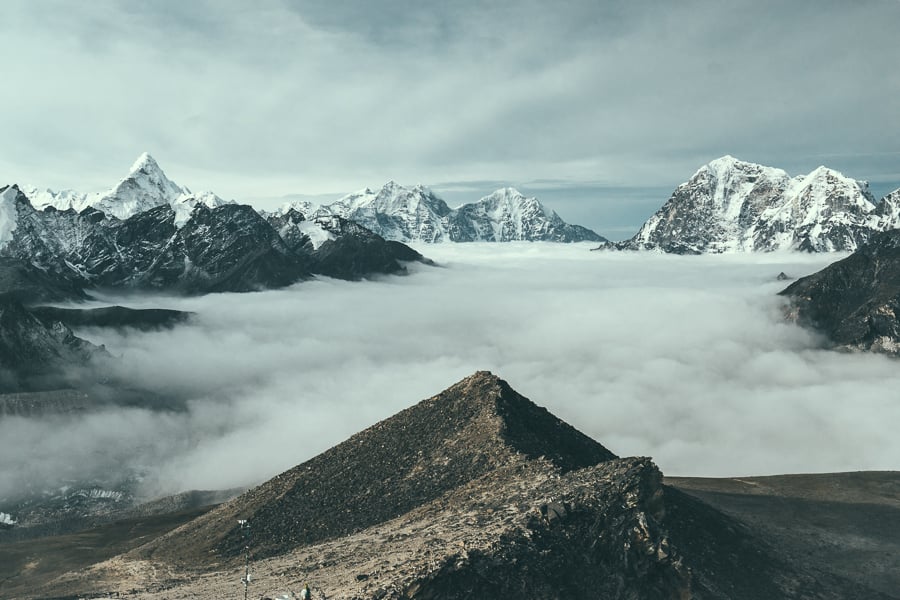
TRY THE 3 BEST TREKS IN NEPAL

Manaslu Circuit : My personal favorite 2-week trek through Tibetan villages and stunning scenery. Less crowded and more authentic.
Annapurna Circuit : The most beautiful & scenic 2-week trek in Nepal although can be crowded at times.
Everest Base Camp Trek : The most iconic 2-week route reaching the famous (EBC) Everest Base Camp at 5,300m.
BOOKING A GUIDE FOR THE EVEREST BASE CAMP TREK
The Everest Base Camp Trek doesn’t require a guide but it’s great to have a guide managing the logistics such as directions, tea-houses, distances, medical issues, and the overall organization. I’d say 90% of trekkers go with a guide. I highly recommend booking with Himalayan Masters which is one of the top trekking companies when it comes to the Everest Base Camp Trek. I’ve trekked many different routes in Nepal with them and I’m a big fan of their attention to detail.
The trek costs around $1500 USD with Himalayan Masters as of 2022 and includes all transfers, accommodation, meals, drinks, permits, and even the hotel stay before and after the trek at a high-quality hotel. I honestly had a great time on this trek and I can wholeheartedly recommend Himalayan Masters.
You can use my discount code ‘ JACKSON5 ‘ for 5% off the total price of your trek with Himalayan Masters which is a pretty handy saving.
Email: [email protected]
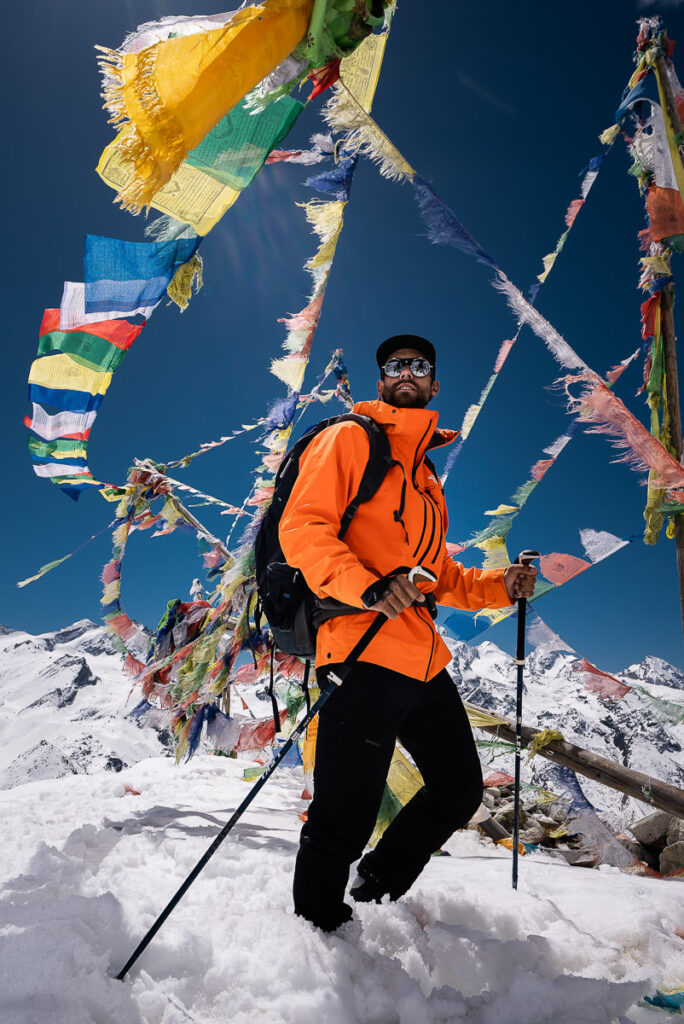
TOP 3 PLACES TO STAY IN KATHMANDU

- Ultimate Luxury: The Dwarika’s Hotel – Luxury, Spa-service, Pool
- Best Value : Aloft Kathmandu Thamel – Swimming Pool, Gym & Great Restuarant
- Budget Choice: Hotel Jampa is easily the top cheap hotel in Kathmandu
MY EXPERIENCE ON THE EVEREST BASE CAMP TREK
I’d like to share with you my experience and photos from my two weeks of trekking to Everest Base Camp. I hope you enjoy recounting the journey as much as I did.
Day One, Two & Three: Kathmandu to Lukla to Phak Ding to Namche
Day one began with an incredible flight from Kathmandu to Lukla. Unfortunately for me, I had come down with food poisoning the night before the trek so it was a rough start for me but I decided to battle on. The flight gives you incredible views of the Himalayas before you touch down at Lukla Airport, one of the most famous and scariest airports in the world. The landing strip is on a downwards slope and gives passengers a heart-in-mouth moment on take-off and landing.
After landing, we had a quick coffee and look around Lukla before making the short and relatively flat trek through the villages and forest to reach Phak Ding. Day one is a short trek but you have made your way up pretty high even just by landing at Lukla Airport so it is not a bad idea to take the first day easy, given that your biggest battle on this trek will be the altitude, not the distance or speed.
Day Two for me was actually a day of recovery in Phak Ding where I spent the entire day sick in the guesthouse. There is usually one day scheduled on your itinerary for sickness or rest day so I had used mine early!
Day three was a tough day as I was still recovering but we made the climb up to Namche, which is a winding climb through the forest and out above the tree line. Namche Bazaar is located at an altitude of 3450m inside the Sagarmatha national park, a UNESCO world heritage site and it is actually known as the last frontier for trekkers and climbers before the trek to Everest Base Camp starts to get serious.
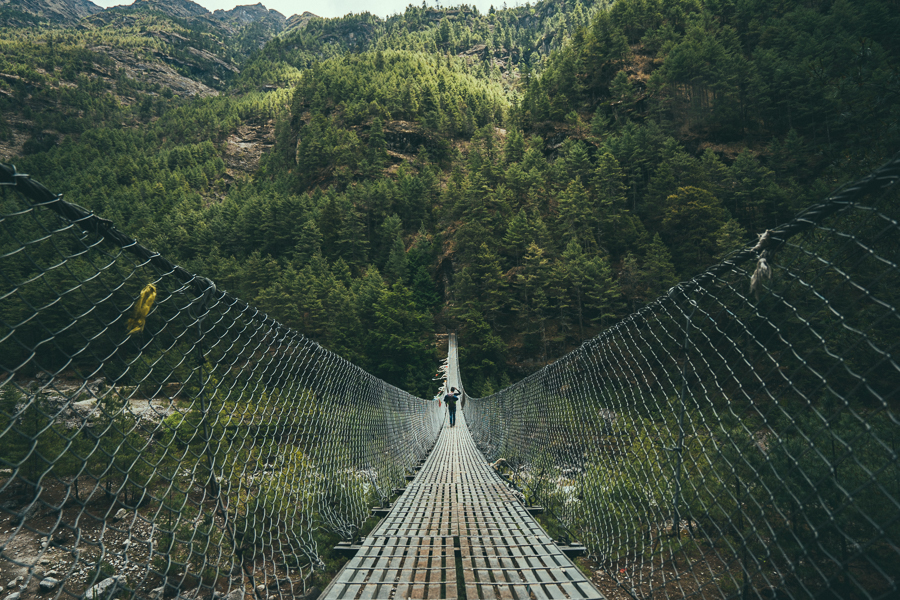
Day Four & Five: Namche to Tengboche to Dingboche
Day four is a big day of climbing. Namche Bazaar is 3,440 meters and Tengboche is 3,860 meters but the constant undulation on the trail means you will climb almost 900 meters of incline throughout the day.
The day begins by following the valley wall as you get some great views of the Everest mountain range out in front. The path then heads down into the valley floor as you lose a lot of elevation. However, you will then cross over the river and gain all the elevation back as you approach Tengboche where you will stay for the night.
Expect to have views of the mighty mountain Ama Dablam as well as Lhotse, Nupste, and even the peak of Mount Everest. Interestingly this will be one of the best views you have of Mount Everest until you reach Kala Patthar in a few days’ time.
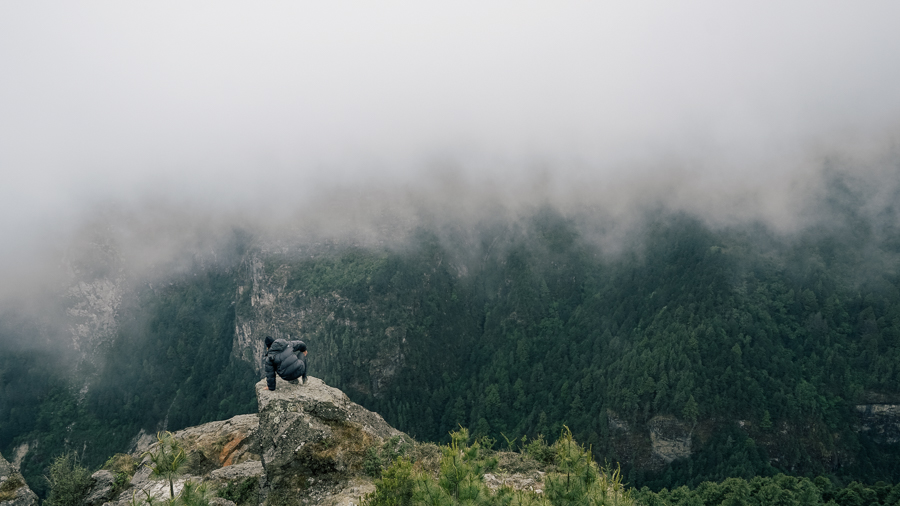
On day five of the Everest Base Camp trek, you say goodbye to the village of Tengboche and head towards Dingboche. It is a stunninng day as you voyage through the valley as the glacier river flows down below while snow-capped peaks loom in the distance. Along the trek, you will stop for tea in the village of Pangboche with lots of views of Ama Dablam mountain .
The elevation gain on day five is 700 meters and the entire journey will take about 5-6 hours at a moderate pace. Dingboche is 4,400 meters above sea level so it’s common to start to have a couple of symptoms of altitude sickness at this stage of the trek.
When you leave Tengboche, you begin a descent into the beautiful forest and can enjoy the shade as you pass through the village of Deboche. After you pass through Deboche, the trail gains some elevation and you will cross a suspension bridge, which guides you to the left side of the valley. Ama Dablam is still in view as you navigate the steep sections of the incline.
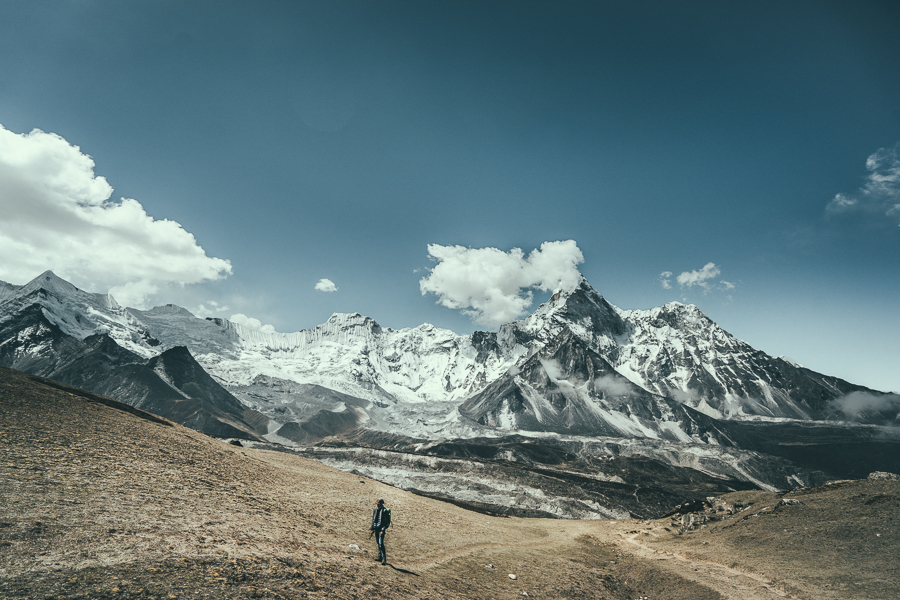
Day Six & Seven: Chuukhung Ri Acclimitization and Dingboche to Lobuche
Day six was an acclimatization day up to Chukhung Ri viewpoint, which was actually one of my favorite days. Because we would stay a second night in Dingboche, we left our bags in the tea house and did the climb up and down Chukhung Ri to help our bodies adjust to the altitude. The idea is to hike high and sleep low, which helps the body adapt.
Chukhung Ri is actually at 5500 meters, which is more than 1000 meters above Dingboche. This is a steep climb and you don’t need to go all the way to the summit. However, with spectacular views, isolation from other hikers, and a good chance to help your body adapt to the altitude, it’s a great day excursion with incredible scenery.
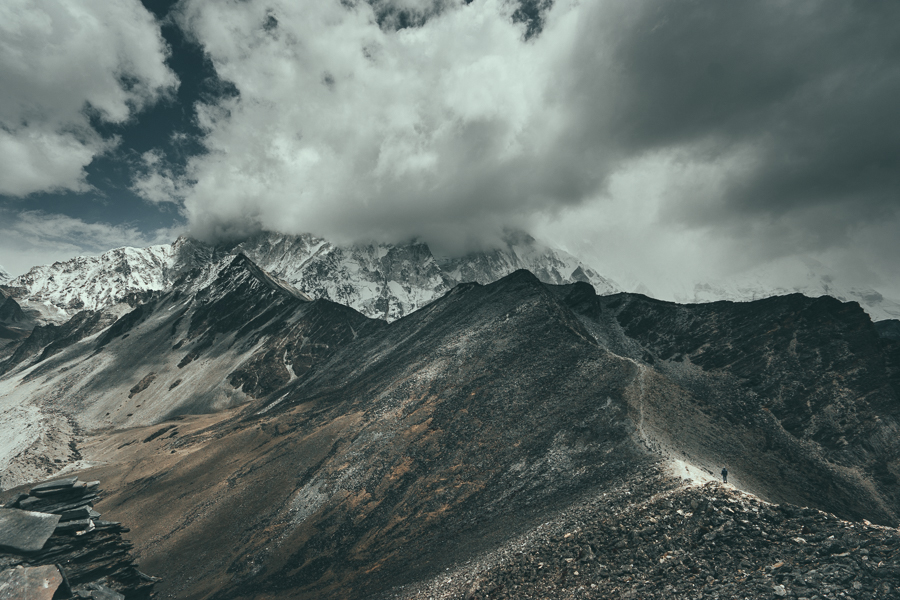
On day seven of the Everest Base Camp trek, we hiked from Dingboche to Lobuche, which is actually the second-highest village on the entire trail. Today is also the first time we will see the Khumba Glacier, which is one of the highlights of the trip.
The total elevation change for day seven is 500 meters in altitude but you will climb 600m in total for the day taking into account a few downhill sections on the trail. It’s a shorter day taking just four hours to reach Lobuche from Dingboche.
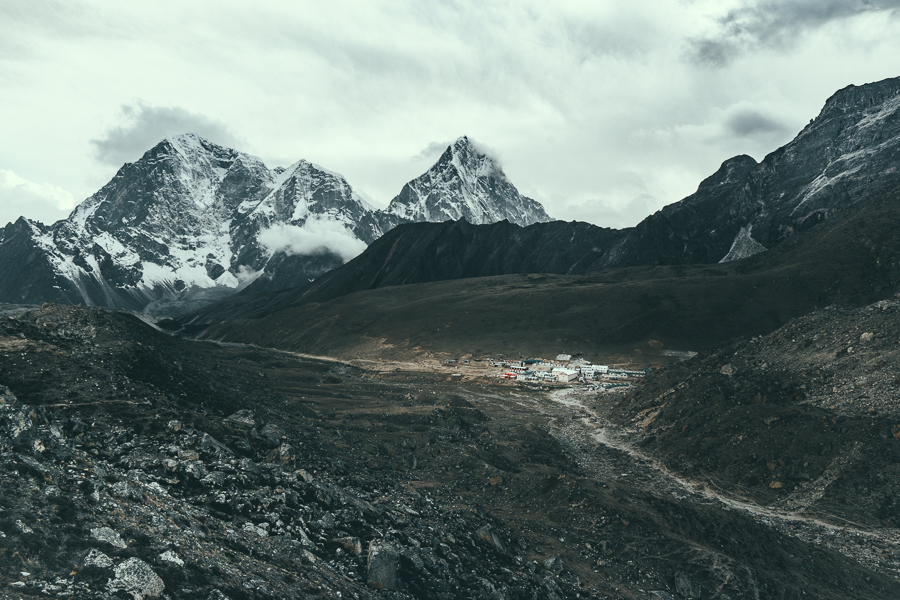
Day Eight: Lobuche to Gorak Shep to Everest Base Camp
On day eight of the Everest Base Camp trek, it is finally time to reach Everest Base Camp. From Lobuche your first trek to Gorak Shep, which is the highest village you sleep at throughout the trek.
Gorak Shep is a small village, and it’s the closest to Everest Base Camp is also the closest village to Everest Base Camp. Basically, you will trek to Gorak Shep, have an early lunch, and drop off your bag before doing the round-trip trek to explore Everest Base Camp. Then you will return to Gorak Shep where you will stay the night before heading to the nearby Kala Patthar in the morning.
The journey from Lobuche to Gorak Shep is along a rocky path, which slowly gains elevation as you walk next to the Khumbu Glacier. From Gorak Shep to Base camp, you will reach an altitude of 5,364m, which won’t be the highest on the trek as you will go higher the next morning at Kala Patthar.
When you leave Gorak Shep you walk next to the Khumbu Glacier with the Everest Mountain Range looming behind. The glacier is covered in dust and rocks due to the sediments, which have been falling from the surrounding peaks over the last years.
The trail continues alongside the glacier until you reach Everest Base Camp. It’s interesting because you actually can’t see Mount Everest from the base camp, which surprised me but the surrounding peaks are still very impressive and dramatic. Depending on if you come during the climbing season or off-season will alter how the base camp looks. I visited in the low season so there were no tents set up and it was pretty barren.
The trail continues past some Sherpa prayer flags as the rocky terrain leads you towards the famous Everest Base Camp rock, which is covered in hundreds of prayer flags. We’ve made it!
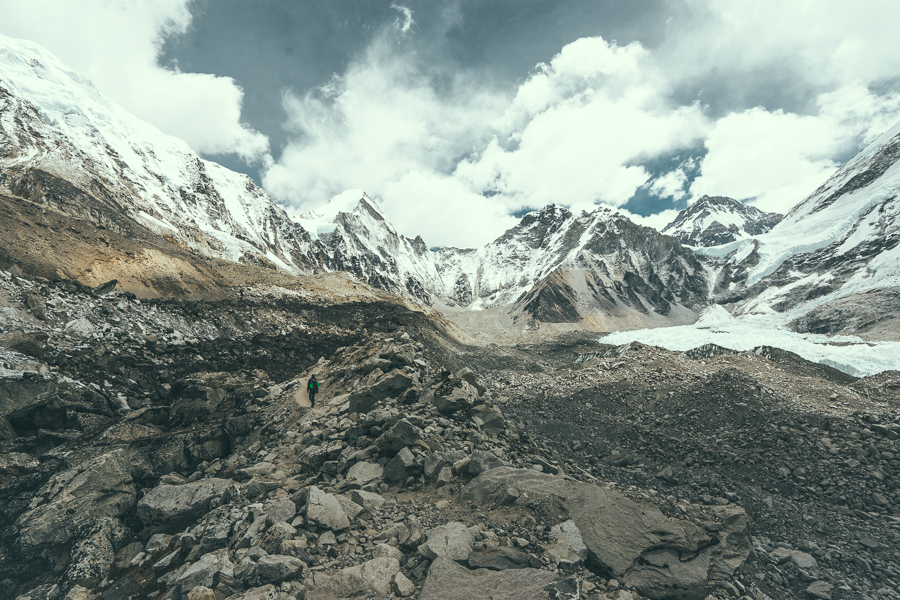
Day Nine: Kala Patthar
The highlight of the Everest Base Camp trek was the climb up to Kalapathar (also spelled out as Kala Patthar). It’s a 5,540-meter peak, which looms over the small village of Gorak Shep where you have just spent the night. It’s worth the freezing wake-up call in the morning as it is one of the best spots in Sagarmatha National Park to take in the views of Mount Everest.
It’s only a 3-kilometer round-trip trek from Gorak Shep with 300 meters of incline but at such high altitude, it can be quite difficult. I suggest starting 1.5-2 hours before sunrise so you are at the summit when the morning glow begins. After enjoying the sunrise with epic views of the cloud-filled valley and Mount Everest, we began the trek back down to Lukla.
It would take us another two days to reach Lukla, which is less than normal but going down is much easier.

Day Ten & Eleven: Heading back down
Heading back down is now at the pace of your choosing. We were keen to get back to Kathmandu so we took just two days to head back down the mountain. With altitude sickness no longer an issue, you can really make some good time.
If you are ahead of schedule you can keep going to the next village as there are no pre-made bookings. Heading down is a great feeling as you have accomplished reaching the base camp and you can now just breathe in the mountain air and enjoy the descent.
EVEREST BASE CAMP TREK: THE ULTIMATE GUIDE
In this section of the blog post, I will share with you the logistics and everything you need to know about trekking to Everest Base Camp.
HOW TO TREK TO EVEREST BASE CAMP
You have a few different options depending on your experience and requirements:
- Book a package through an agency to join a tour group
- Do the trek independently (not with an agency) but still hire a guide and/or porter
- Do the Everest Base Camp Trek entirely independently
If you are alone and don’t want to do the trek independently then it is a great idea to join a group. There are lots of free time and chill moments at the teahouses to play cards and chat with your group.
Doing it entirely independently means you are in charge of all the logistics and it can be quite stressful if you aren’t experienced at managing all flights, maps, costs, negotiations, food, language barriers, first-aid and more.
BOOKING AN EVEREST BASE CAMP TREK IN ADVANCE
These are the most popular routes and are organized by the top tour companies who have a global reputation.
The Everest Base Camp Trek doesn’t require a guide but it’s great to have a guide managing the logistics such as directions, tea-houses, distances, medical issues, and the overall organization. I’d say 90% of trekkers go with a guide.
I highly recommend booking with Himalayan Masters which is one of the top trekking companies when it comes to the Everest Base Camp Trek. I’ve trekked many different routes in Nepal with them and I’m a big fan of their attention to detail.
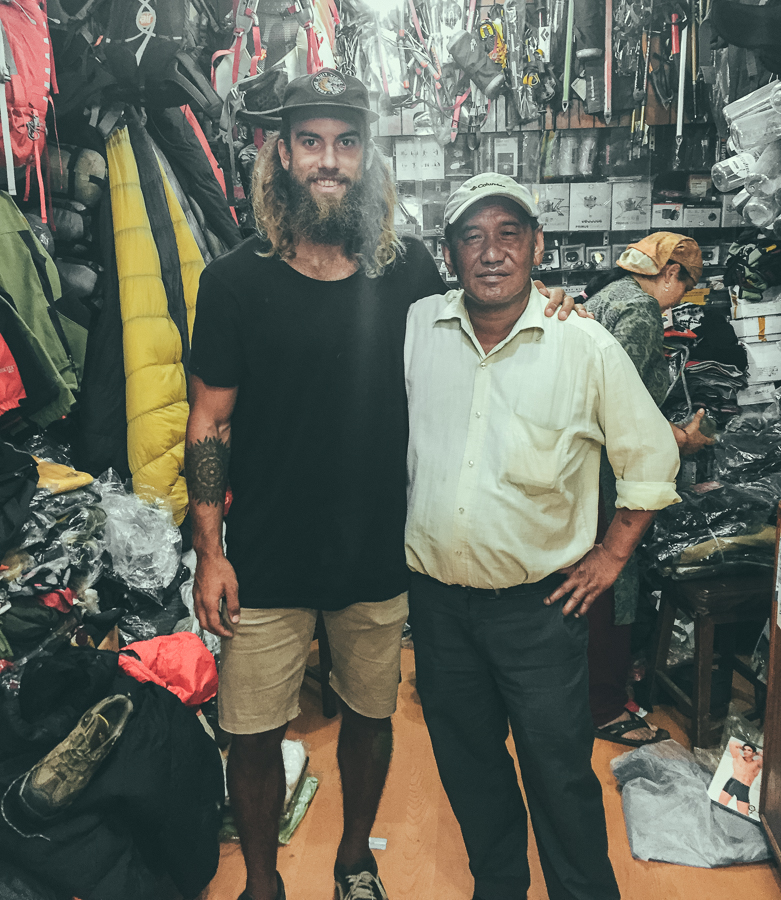
CHOOSING THE RIGHT TOUR AND A GUIDE
Trekking to Everest Base Camp can be done without a guide although I suggest hiring one. Here are 3 reasons why:
- Directions : The route isn’t incredibly hard to follow but there are many twists and turns I would have missed had I not had a guide. The route is available on many maps and map applications but it isn’t a clear trail throughout and some previous experience following a trail in a foreign country would be necessary.
- A guide is relatively cheap to hire : Included in your trekking package will be a qualified guide. However, in your package is also meals, accommodation, flights, etc. The guide him or herself will only cost $10-15 per day.
- When things go wrong : My guide helped me through food poisoning, altitude sickness and was as much a nurse as a guide. I rarely get sick at normal heights but altitude sickness is uncontrollable. I am pretty fit and it still smashed me hard. You can go it alone and be fine but it’s comforting to have a guide there when you come into trouble, especially with altitude sickness. My guide had seen it all before so his calm made me feel better about feeling sick for four days straight.
If you think you will get a guide like the majority of people on the Everest Base Camp, you have a lot of options and things to consider. Pictured below is my guide, Lapsang, who was a legend and someone who became a good friend. When I left Nepal he waited at the bus stop for two hours with me and gave me a Nepali scarf as a gift.
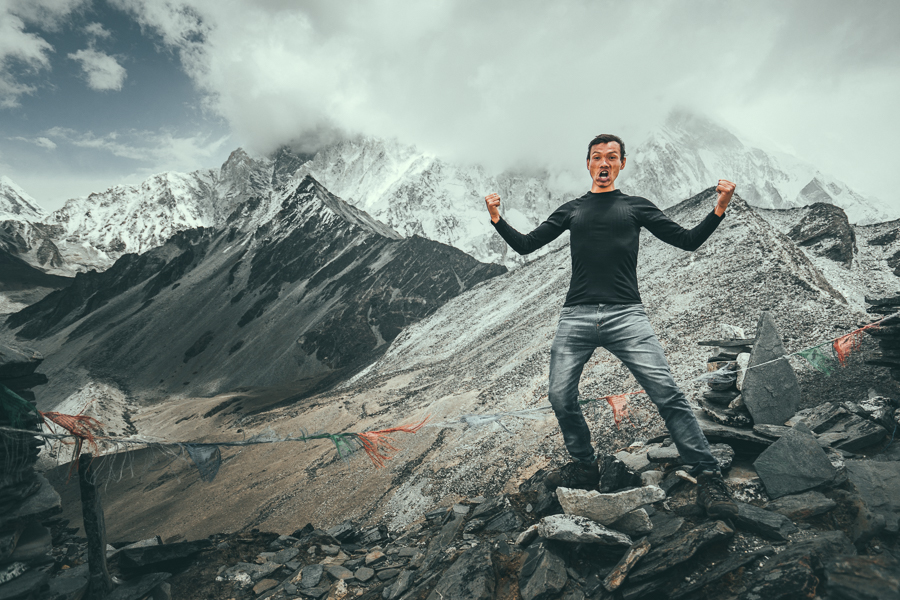
I suggest going with a small group of friends. We saw a few big groups and it looked like a Contiki tour compared to the experience I had with just myself and my guide. Only get a porter if you really need it. You should be able to carry your bag for 4-5 hours of trekking each day.
My guide, Lapsang Tamang, had done the trek multiple times as a porter and now many times a guide. He said he has lost count but somewhere over 20 times, he has been hiking the Everest Base Camp Trek. The best thing to do is to contact my guide and arrange to meet him first in Kathmandu so you can chat and decide if you want to go ahead. You will be together for 12 days after all!
You can directly contact my guide Lapsang by emailing him here: [email protected]
Lapsang is an awesome guy and I had too many chai tea hangouts with him before and after the trip. Lapsang and I became friends during the trip and afterward, we went bungee jumping, cooked Dal Bhat at his apartment, and visited Swayambunath Temple.
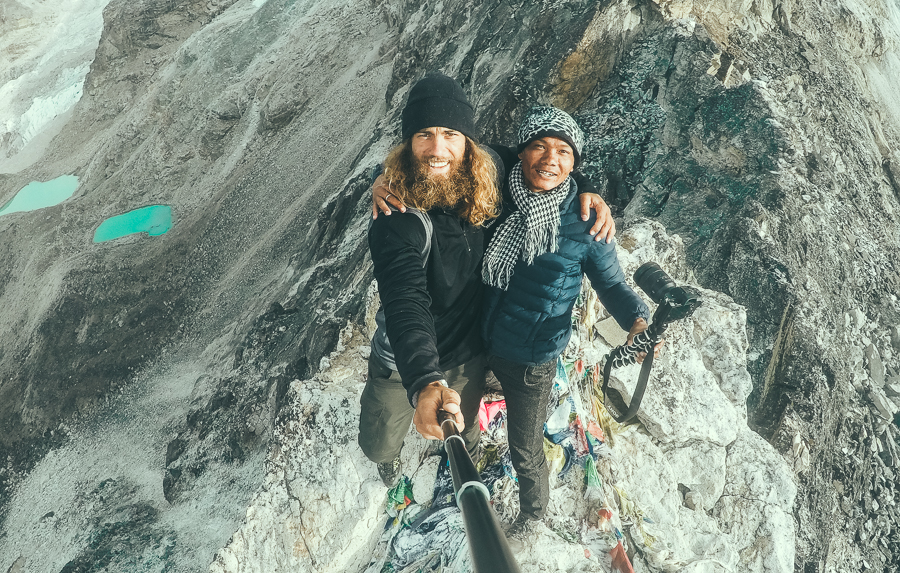
EVEREST BASE CAMP PACKING LIST
I had no winter clothes or even trekking shoes before getting to Kathmandu and bought it all for under $200 brand new (Likely fake North Face). But just as a guide you can get all the gear new for under $200. Bargaining/second hand etc. may help you get it a bit cheaper but this was one time I didn’t want to be so tight with money then freeze my ass off later on top of a mountain.
Keep in mind you won’t be doing any washing. Clothes that dry quickly and are lightweight are key. I showered once… Here is a list of what I took:
- 2 pairs of pants that rip off into shorts ($15 each in Kathmandu) (Super Safari style but actually handy in this situation.)
- 2 long sleeve quick-dry material shirts ($10 each in Kathmandu)
- 5 Pairs of Thermal North Face socks ($2-3 per pair in Kathmandu)
- 1 Fleece pants and sweater. ($25 for top and bottom in Kathmandu)
- 1 Thermal Lycra long sleeve and pants ($20 in Kathmandu)
- 5-6 pairs of quick-dry underwear
- 1 huge waterproof down jacket (Rented for $1 a day in Kathmandu)
- Beanie ($1 in Kathmandu)
- Neck Buff ($2 in Kathmandu)
- Gloves ($5 in Kathmandu)
- Water Purification pills and 1L bottle
- Camera gear and electronics (Not necessary but up to you. Obviously I carried a lot)
All of this should fit into a backpack no bigger than 50L and be less than 15kg. I used my 60L backpacking bag because I didn’t want to buy a new bag for a two-week trek. It worked out fine and weighed about 13kg including all of my lenses, chargers, and power banks.
What are my favorite pieces of trekking gear?
There are six pieces of gear that I simply never forget when I go trekking. These are five items that I using right now and this list gets updated every year! Here are my trekking essentials.
- Arcteryx BETA AR Rain Jacket : This is my go-to rain jacket. It’s super light, folds down into a tiny ball, and protects brilliantly in a storm. This one never leaves my backpack.
- Salomon X Ultra 3 Mid GTX Hiking Boots : For the best ankle support, waterproofing, and durable exterior I’m a fan of tough but light hiking boots like these Salomons for my adventures.
- Black Diamond Head Torch : I can’t tell you how many times, I’ve arrived back from a hike unexpectedly late. I always keep this lightweight but strong headtorch in my bag for the unexpected.
- Darn Tough Socks : These are the most comfortable hiking socks I’ve ever worn and last for years. They also have a lifetime warranty and you just send them in with a hole and they replace it no questions asked.
- Osprey Atmos AG 65L Backpack : I’ve never had a more comfortable 65L pack than this one. I got it in the Navy Blue and have trekked with it through many a mountain.
- Bl ack Diamond Trekking Poles : They might feel weird at first, but on a long trek with incline and decline you’ll begin to love these.
- Grayl GeoPress Water Filter Bottle : I’ve used this for three years. It filters your water with one press and you can drink directly from it. Never buy a plastic water bottle again!
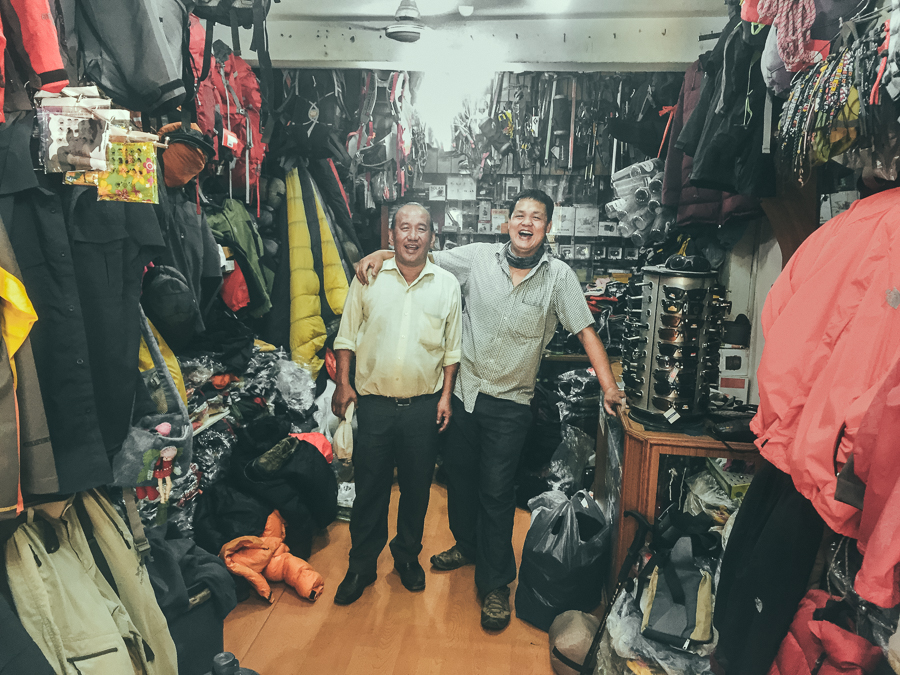
EVEREST BASE CAMP TREK COST
I paid $900 USD for my package all the way back in 2016 but you can expect to pay anywhere from $1400 to $2500 these days.
What’s included in the package for trekking to Everest Base Camp:
- Taxi from Thamel to Kathmandu Airport
- Flights from Kathmandu Airport to Lukla Airport
- Flights from Lukla Airport to Kathmandu Airport (Regular price $320 round trip)
- Breakfast, lunch, and dinner from the guesthouses you are staying at. I could pick anything on the menu, which had western options or Nepali options. You can eat pancakes, pizza, and burgers or you can go for the 24-hr Nepali Power Dal Bhat. I could also choose any hot drink with each meal.
- Your guide throughout the trip.
What’s not included:
- Water. You can buy bottled water like me if you are playing it safe. It is $1 per bottle at a lower elevation and $3 per bottle at the highest elevation. Or lots of people use purification tablets and they seemed to be fine.
- Electricity

EVEREST BASE CAMP TREK: WIFI/ELECTRICITY AVAILABILITY.
Wifi: Costs anywhere from $3 to $10 to use wifi at the guesthouses. Buy a Ncell Sim before you go. Ncell works at 50% of the guesthouses. Electricity: You will have to pay anywhere from $2 at low elevation to $8 at high elevation to charge your power banks, cameras, and phones. The key is to get a fat power bank. Pay to charge that then charge everything from your power bank. My power bank lets me charge my phone and four camera batteries before it would be done.
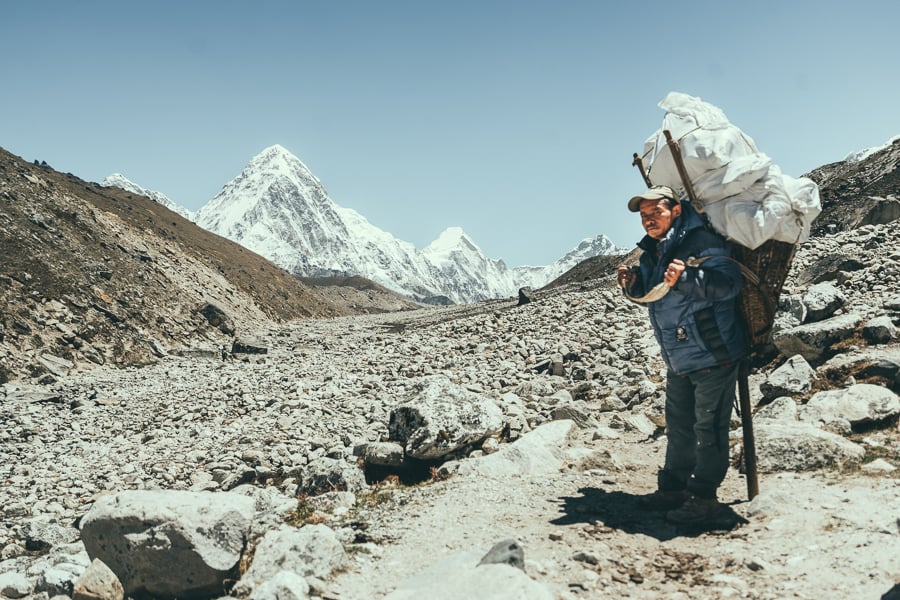
EVEREST BASE CAMP TREK: BEST TIME OF YEAR
This is an interesting question. Do you want snow, reliable weather or to get away from crazy crowds?
February to May – Peak season, clear bright days, very busy trails, lots of people attempting Everest ascent June to August – Monsoon season, no crowds and empty guesthouses September to October – Most stable and clear weather, trails are quite busy November to January – Coldest period, can reach -25, some routes closed
I trekked in the first week of June and was lucky to escape the rain. I didn’t get wet once. Normally it rained in the afternoon or at night if at all but we trekked in the morning and usually only heard the rain as we slept. The trails were open and some days we didn’t even see anyone.
My guide showed me a photo of Namche on a busy morning and I couldn’t believe it. The path looked like the start of a marathon. After seeing that I was so glad to have gone in the off-season.

EVEREST BASE CAMP TREK TEMPERATURE
During June when I trekked it was sunny in the days and I actually wore shorts every day. However as I mentioned above about when the best time to be trekking to Everest Base Camp is, it can get very cold at high elevations during November to January (-20 to-30)
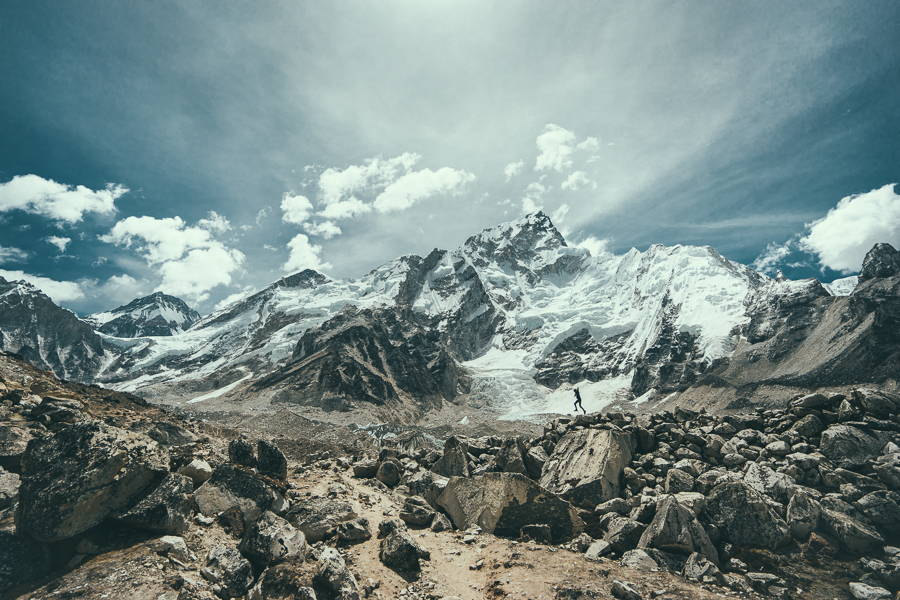
EVEREST BASE CAMP TREK DIFFICULTY
Trekking to Everest Base Camp takes some serious effort. But do you need to be in great shape to complete the journey? The simple answer is NO.
You can go at a slow pace, your own pace, and still make it to Everest Base Camp. In fact, going slow will help you to acclimatize better. I am all about speed but this is not a race. Some days we only trekked for just over three hours but we gained 500m in altitude so we rested for a day and then went again in the morning.
Having said all of that you should be able to walk 10-15 km in a day. Be able to walk up intense inclines for at least an hour. Be able to carry a bag while doing all of this unless you plan to hire a porter.
It’s hard to measure if you are ready. It isn’t like a marathon or anything else you have ever done most probably. I didn’t train at all and was fine. I’m in pretty good shape and played sport my whole life. There were people on the trail who were overweight and going incredibly slow but they were right there with us at base camp to celebrate the achievement.
EVEREST BASE CAMP ALTITUDE
The base camp is 17,600 ft or 5,380m. However, you will probably also trek to Kala Patthar, which looks over the base camp. Kala Patthara is 5,644m high.
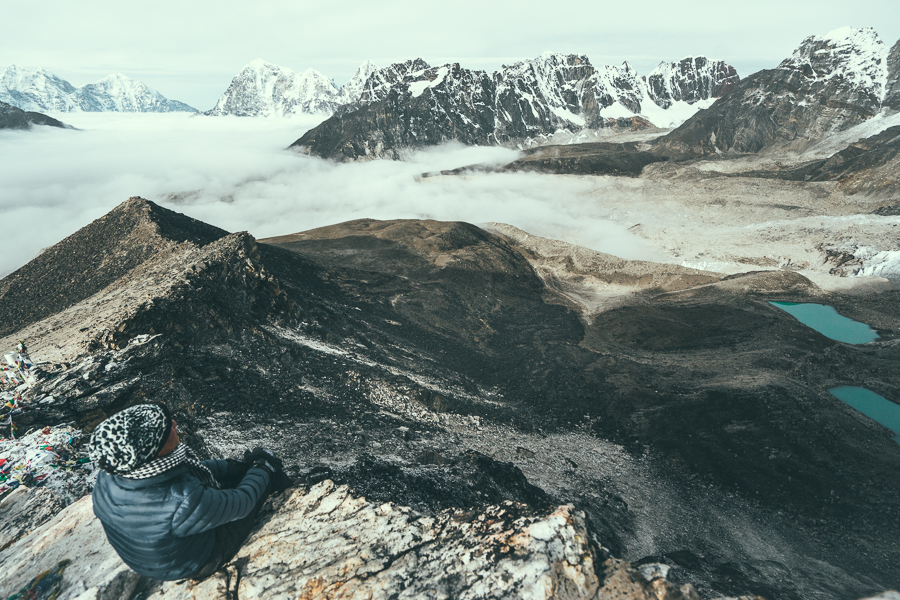
EVEREST BASE CAMP TREK DISTANCE
The distance from Lukla the first town to Everest Base Camp is 38.58 miles or 62 kilometers. Most people take 8-9 days trekking to Everest Base Camp and 3-4 days trekking back to Lukla. It took 8 days to trek to Base camp and two days to trek out.
EVEREST BASE CAMP ITINERARY
Your itinerary will vary depending on your speed and your guide. However, most people follow a somewhat similar trail and timeline. This was my timeline. Note that I spent one extra day in Phak Ding due to sickness. Most people spend that extra day in Namche.
- Day 1. Kathmandu flight to Lukla Lukla to Phak Ding (3-4 hrs)
- Day 2. Phak Ding rest day (sickness)
- Day 3. Phak Ding to Namche (5 hrs)
- Day 4. Namche to Tenboche (4 hrs)
- Day 5. Tenboche to Dinboche (3 hrs)
- Day 6. Dinboche to Chukhung Ri (2.5 hrs) Chukhung Ri back to Dinboche (1.5 hrs) (Acclimatization day)
- Day 7. Dinboche to Lobuche (3 hrs)
- Day 8. Lobuche to Gorak Shep (2 hrs) Gorak Shep to Everest Base Camp (1.5 hrs) Everest Base Camp to Gorak Shep (1.5 hrs)
- Day 9. Gorak Shep to Kala Patthara (2 hrs) Kala Patthara to Gorak Shep (1 hr) Gorak Shep to Tenboche (7hrs)
- Day 10. Tenboche to Lukla (8 hrs)
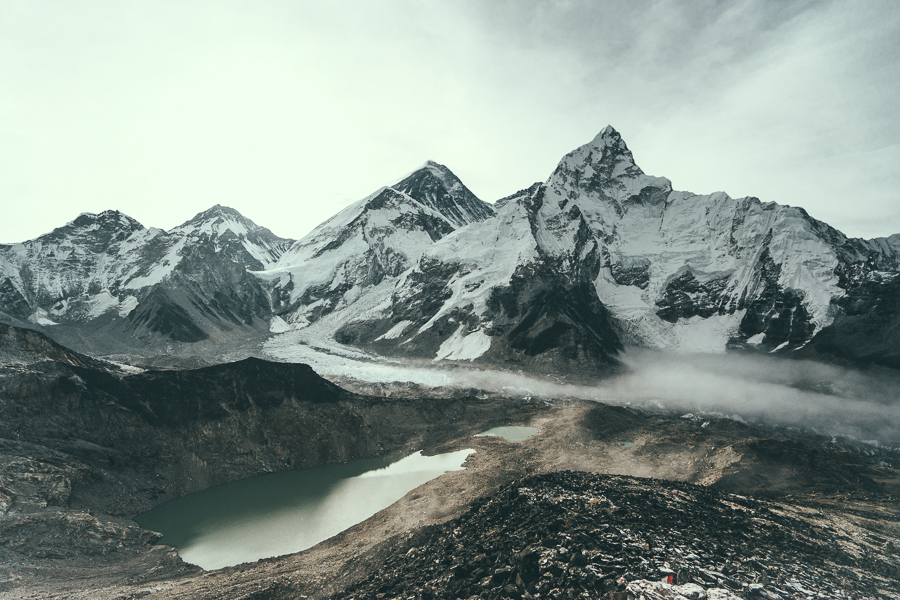
I hope you enjoyed my guide to the Everest Base Camp Trek and you have a great adventure.
HAVE YOU READ MY OTHER NEPAL BLOGS?
I’ve been lucky enough to have many awesome adventures in Nepal, which you can check out below where I’ve listed some of my favorite blog poss from Nepal.
- The Most Iconic route: Everest Base Camp Trek
- The Most Scenic Route: Annapurna Circuit Trek
- My Favorite Trek in Nepal: Manaslu Circuit Trek
- An Easy Nepal Trek: Langtang Valley Trek
- A great beginner peak: Island Peak Climb (6,165m)
- My Favorite Climb in Nepal: Climbing Ama Dablam (6,812m)
- My first 8000er: Climbing Manaslu (8,163m)
- My toughest climb in Nepal: Climbing Makalu (8,463m)
- Where to stay: 16 Best Places to Stay in Kathmandu

Tuesday 31st of October 2023
Sunday 17th of September 2023
So much informative articles which helps people to trek Everest Base Camp Trek
Inge Winkler
Saturday 3rd of June 2023
Hello, thank you for posting all the great infos, this will be very helpful for us. Could you please update me if the requirement of a Professional Guide is in place now or is there a way around it. Thank you so much in advance. Happy Trails, Inge
Sunday 18th of June 2023
I believe you need a guide now to trek anything above 3000m
Monday 21st of November 2022
Thanks for sharing such an adventurous trip experience with us. I read your blog. It feels like I was personally enjoying this trip.
Friday 12th of August 2022
Hi Jackson,
This was a helpful and informative guide. Kudos!
I had a small suggestion: You could have a small sections box right in the beginning and link each sub-section directly to the relevant content below, for ease of navigation!

- Best Hikes In The World
- Appalachian Trail
- European Hikes
- Nepal Hikes
- Patagonia Hikes
- See All Hikes
- Mount Kenya
- Mount Kilimanjaro
- Mount Toubkal
- See All Mountains
- South Africa
- New Zealand
- Switzerland
- United Kingdom
- Packing Lists
Everest Base Camp Trek – Nepal’s Most Famous Trek
Asia , Nepal
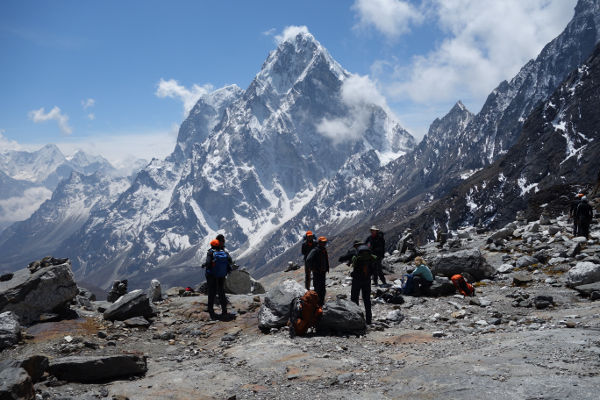
The Everest Base Camp Trek is one of the most popular and best treks in Nepal .
Home to four of the six highest mountains in the world – Mt. Everest (8,848 meters), Mt. Lhotse (8,516 meters), Mt. Makalu (8,470 meters) and Cho Oyu (8,201 meters) – the Everest (or Khumbu) region affords trekkers the opportunity to hike in one of the grandest and most awe-inspiring trekking areas in the world.
Trekkers get to retrace the footsteps taken by Sir Edmund Hillary and Tenzing Norgay on their historic Everest expedition in 1953.
On this page, you will find a comprehensive and impartial guide to the Everest Base Camp Trek.
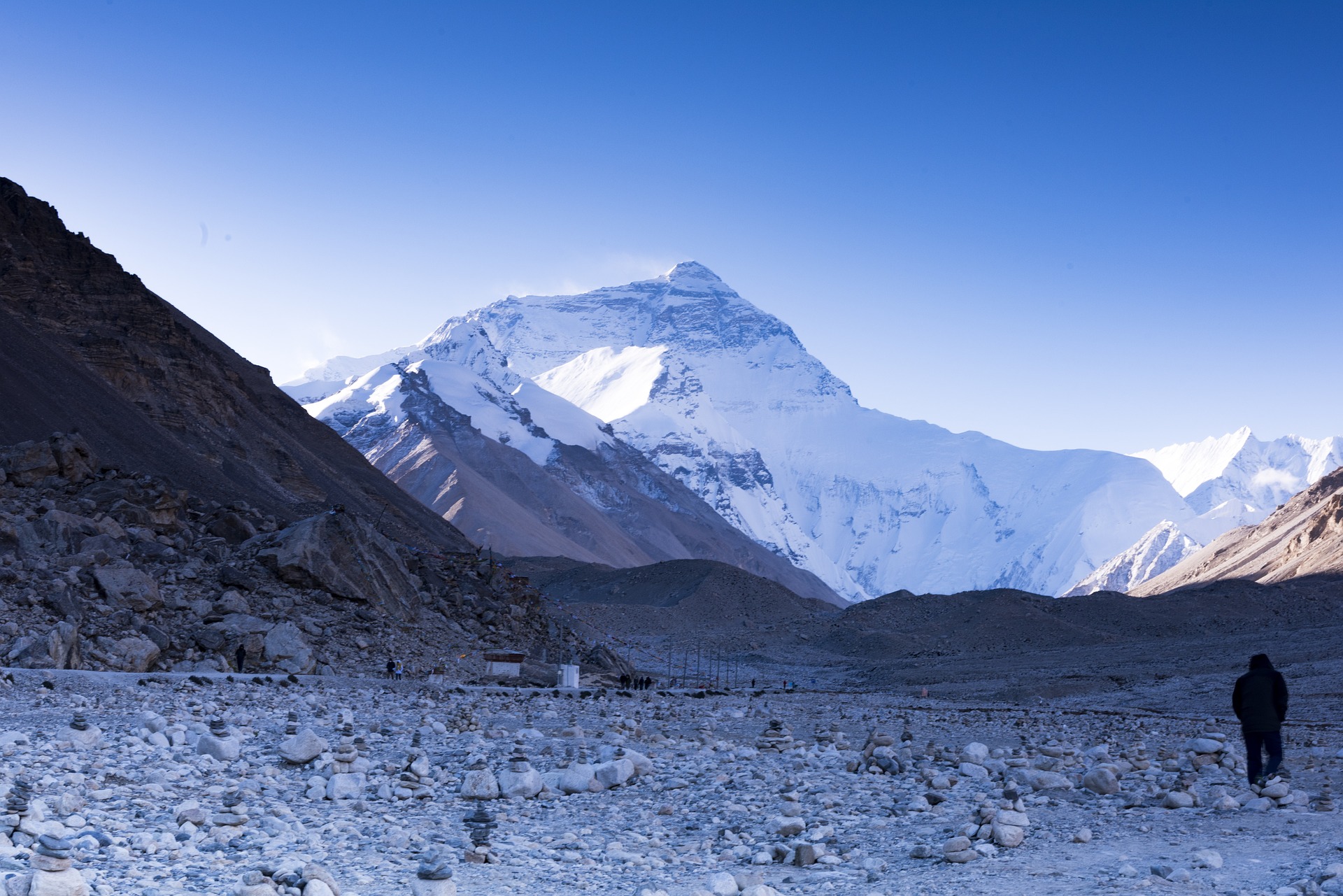
Everest Base Camp Trek
Ebc hike overview.
In this detailed Everest Base Camp trek article, you will find information on the typical route and its variations; a day-by-day itinerary breakdown of the trek; practical information on accommodation, meals, permits, equipment and insurance; as well as guidance on the best time to trek Everest Base Camp.
Key Highlights
Highlights on the trek include: unforgettable mountain views from Kala Patther , including Mt. Everest; the chance to see the famous Everest region Sherpas and Sherpa town – Namche Bazaar; sightseeing in the Sagarmatha National Park – a World Heritage Site; glimpses of the highest Buddhist monasteries in the world; and a sneak preview into the inner workings of the base camp to the world’s highest mountain.
Everest Regional Map
The Everest Base Camp trek is situated in the Everest, or Khumbu region of Nepal (see map below). It is the most popular trek in the region, if not the country.
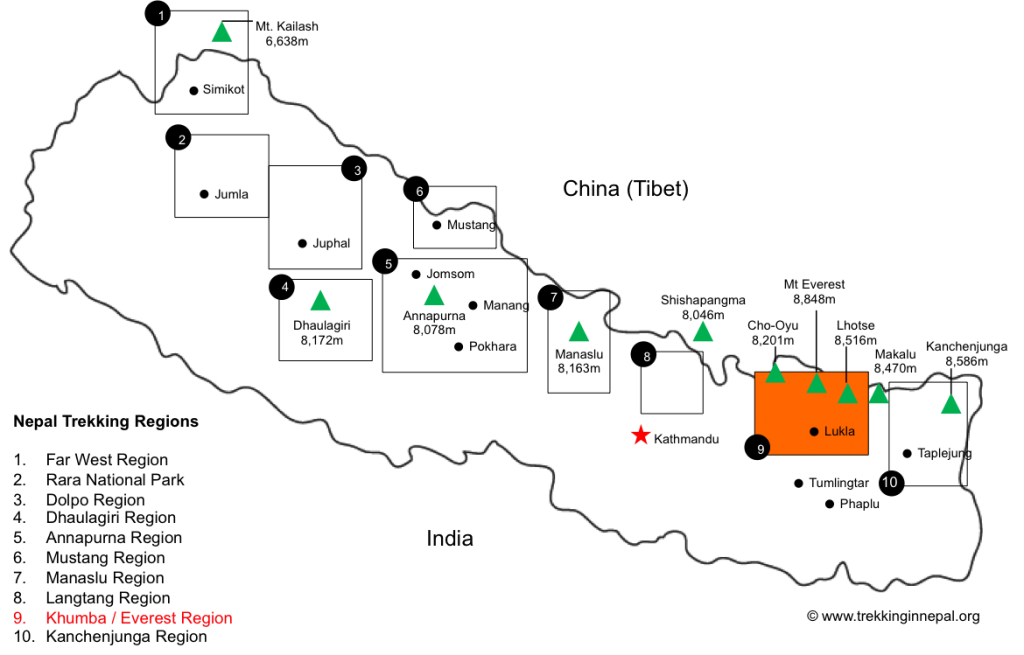
EBC Recommended Map
This map is one of the better representational schematics of the Everest Base Camp trail (we believe it is from GlobeTrekker but can’t be certain as there are many maps scattered across Google Images).
The map above shows the classic Everest Base Camp trek running up from Lukla to Namche Bazaar and then veering North-east up to Periche / Dingboche. From Dingboche / Periche the trail turns North-west to Lobuche before heading north gain to Gorak Shep. From here Everest Base Camp can be seen to the East and Kala Patthar in the North-west.
The map also shows the route to Island Peak in the East, via Dingboche and Chhukung, and the Gokyo Lakes in the West.
Please Note: The above recommended map is not to scale and should not be used as an accurate representation of the Everest Base Camp trek route. We provide links below to excellent maps of the Everest region.
EBC Trek Itinerary
Most trekkers fly from Kathmandu to Lukla Airport to begin their Everest Base Camp trek. The ‘classic’ or typical route follows straight up the Khumba Valley and through the Sagarmatha National Park to Everest Base Camp.
Variations via Gokyo Lakes or Chhukhung Valley are also popular (see the variations section below).
The typical Everest Base Camp trek duration is between 14-16 days (including transfers between Kathmandu and Lukla). The trek itself (excluding sightseeing in Kathmandu and transfers) usually lasts about 12 days with acclimatisation days at Namche Bazaar and Pheriche.
Here is a brief overview of a typical itinerary on an EBC trek, with approximate trekking times and altitudes.
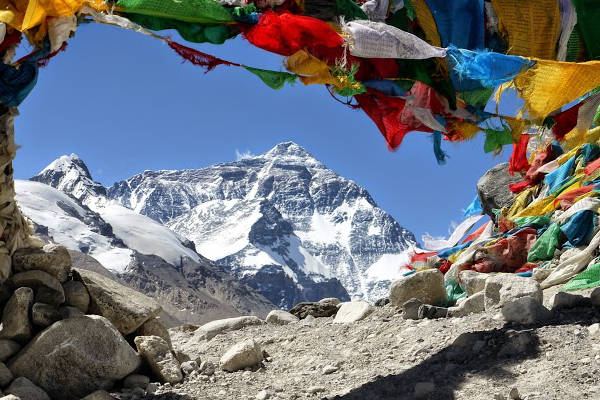
Day 1: Arrive Kathmandu
Arrive in Kathmandu. Rest and tour Kathmandu (often your tour operator will have pre-organised tours around Kathmandu).
See more in our guide on things to do in Kathmandu .
Day 2: Fly Kathmandu to Lukla. Trek to Phakding
Fly from Kathmandu to Lukla (expect a slightly scary landing at Lukla but rest assured the pilots are very experienced!). Weather can sometimes be a problem, so delays are common.
The flights afford great views of the Everest region, so have your camera ready. Try to sit on the right side of the plane to see Mt Everest. Upon arrival you will be transported to the trailhead and take a relatively easy trek from Lukla (2,800 meters) to Phakding (2,652 meters).

Namche Bazaar, Khumbu District
Day 3: Trek from Phakding to Namche Bazaar
Phakding (2,652 meters) to Namche Bazaar (3,440 meters) via Monjo (2,840 meters) and the beginning of Sagarmatha National Park. Weather permitting you might get your first glimpses of Mt Everest from the steep trail to Namche.
Day 4: Acclimatisation in Namche
This is usually a rest acclimatisation day in Namche (3,440 meters). If you are lucky enough to be in Namche on a Saturday, then make sure to visit the weekly market. Most operators will encourage you to take an acclimatisation trek to the Everest View Hotel (3,880 meters) where you can have lunch and capture views of Mt. Everest.
Day 5: Trek from Namche to Tengboche
Trek from Namche (3,440 meters) to Tengboche – also written Thyangboche (3,860 meters), home to the largest gompo (a Buddhist ecclesiastical fortification of learning). The trek is an undulating one which provides great views of beautiful mountains including Everest, Nuptse, Lhotse and Ama Dablam. Some treks go via Thame to visit the Thame Monastery, before continuing to Tengboche.
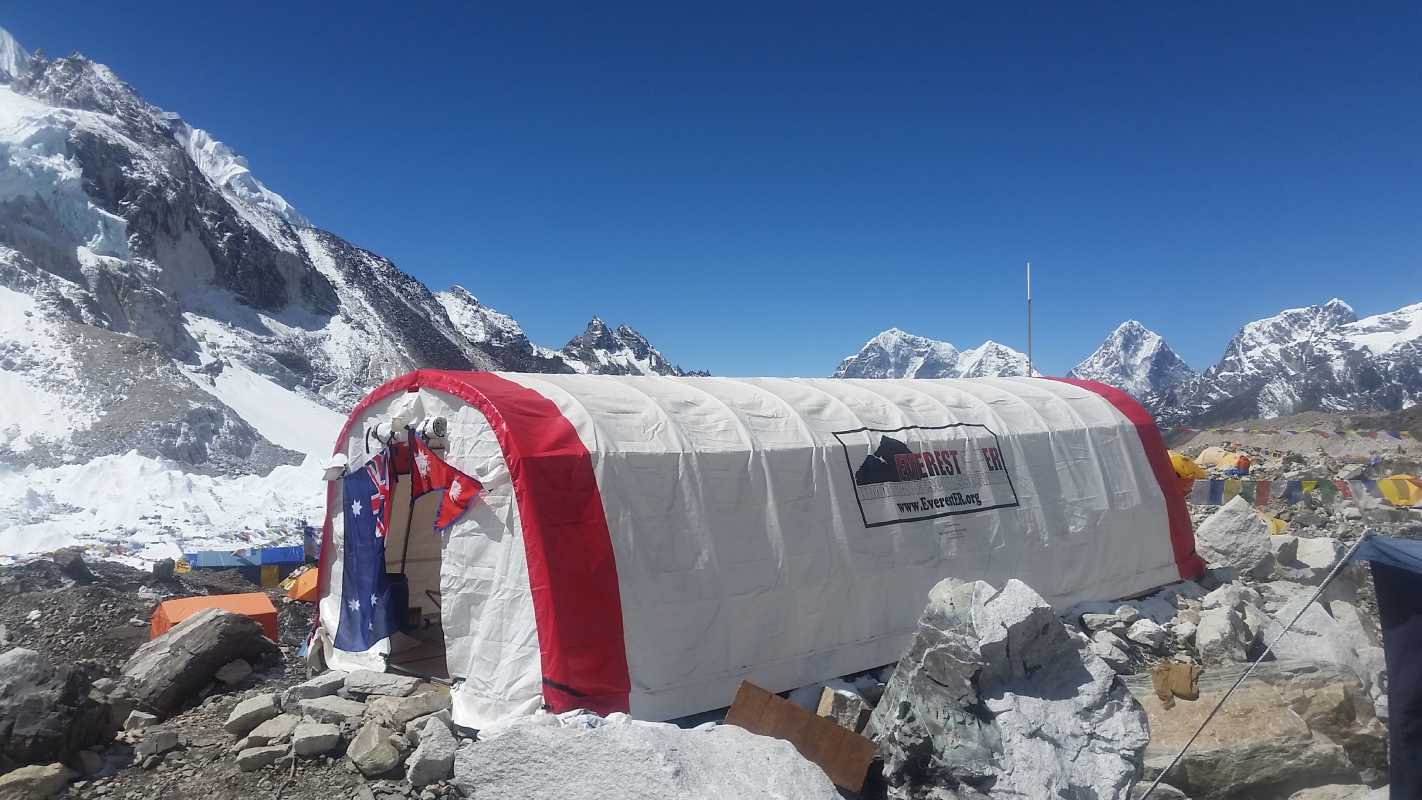
Day 6: Trek from Tengboche to Periche
Trek from Tengboche (3,860 meters) to Periche (4,280 meters) via the town of Pangboche. The Himalaya Rescue Association are based here, and it is well worth visiting them if your operator hasn’t already organised a tour.
Day 7: Acclimatisation day in Periche
Periche (4,280 meters) is usually used as the location for your second rest and acclimatisation day. Depending on your operator you will likely visit the Tshola Tsho Lake and then take a short trek towards Dingboche (4,360 meters) where you will get great views of the south face of Mt. Lhotse and Island Peak.
Day 8: Trek from Periche to Lobuche
A fairly long and steep trek from Periche (4,280 meters) to Lobuche (4,940 meters) via the Khumbu Glacier. You will see Sherpa Memorials built of stone cairns in remembrance to the many Sherpas and climbers that have died climbing Everest.
Day 9: Trek from Lobuche to Gorak Shep
Trek from Lobuche (4,940 meters) to Gorak Shep (5,170 meters) where you will have lunch and then onto Everest Base Camp (5,364 meters).
Most treks are not allowed to stay at Everest Base Camp without specific permission. The rules and regulations have changed around this issue over recent years, so it is worthwhile checking with your tour operator.
Visits to the icefall require mountaineering permits and are usually not part of a standard Everest Base Camp trek. After visiting Everest Base Camp you will return to Gorak Shep for the night.
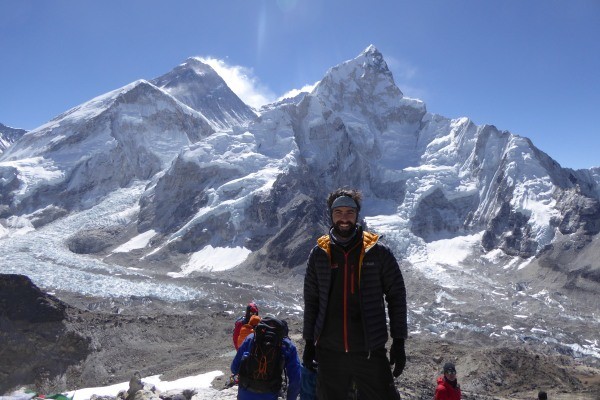
Kala Patthar
Day 10: Trek from Gorak Shep to Kala Patthar and EBC (Return to Dingboche)
A trek from Gorak Shep (5,170 meters) up the steep slopes to Kala Patthar (5,554 meters), a peak west of the Everest Base Camp which affords the best views of Mt. Everest, Nuptse Nup II and Changtse; as well as the northern flank and summit of Lhotse. You will leave Gorak Shep early to reach Kala Patther before the clouds roll in.
On a typical Everest Base Camp trek, Kala Patthar will be the highest altitude you will reach. It is also home to the worlds highest webcam – Mount Everest Webcam. From Kala Patthar, you then descend all the way back to Dingboche (4,360 meters).
Day 11: Trek from Dingboche to Namche
Trek from Dingboche (4,360 meters) to Namche (3,440 meters) via the rhododendron forests around Tengboche.
Day 12: Trek from Namche to Lukla
Trek from Namche (3,440 meters) all the way back to Lukla (2,800 meters) – a long and tiring walk to finish what is an incredible Himalaya trek.
Day 13: Fly from Lukla to Kathmandu
Fly from Lukla to Kathmandu.
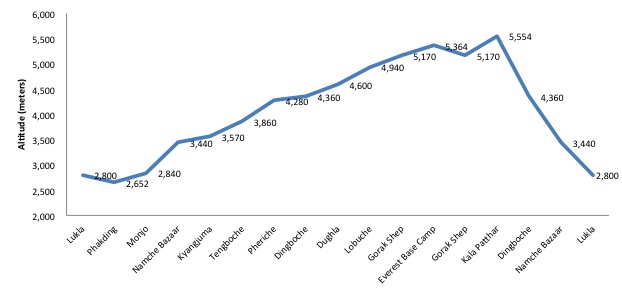
EBC Route Altitude Profile
Above is an altitude profile chart for a typical Everest Base Camp hike. The highest peak is Kala Patthar, at a staggering altitude of 5,554m.
Everest Route Variations
Below are typical route variations for the Everest BC hike.
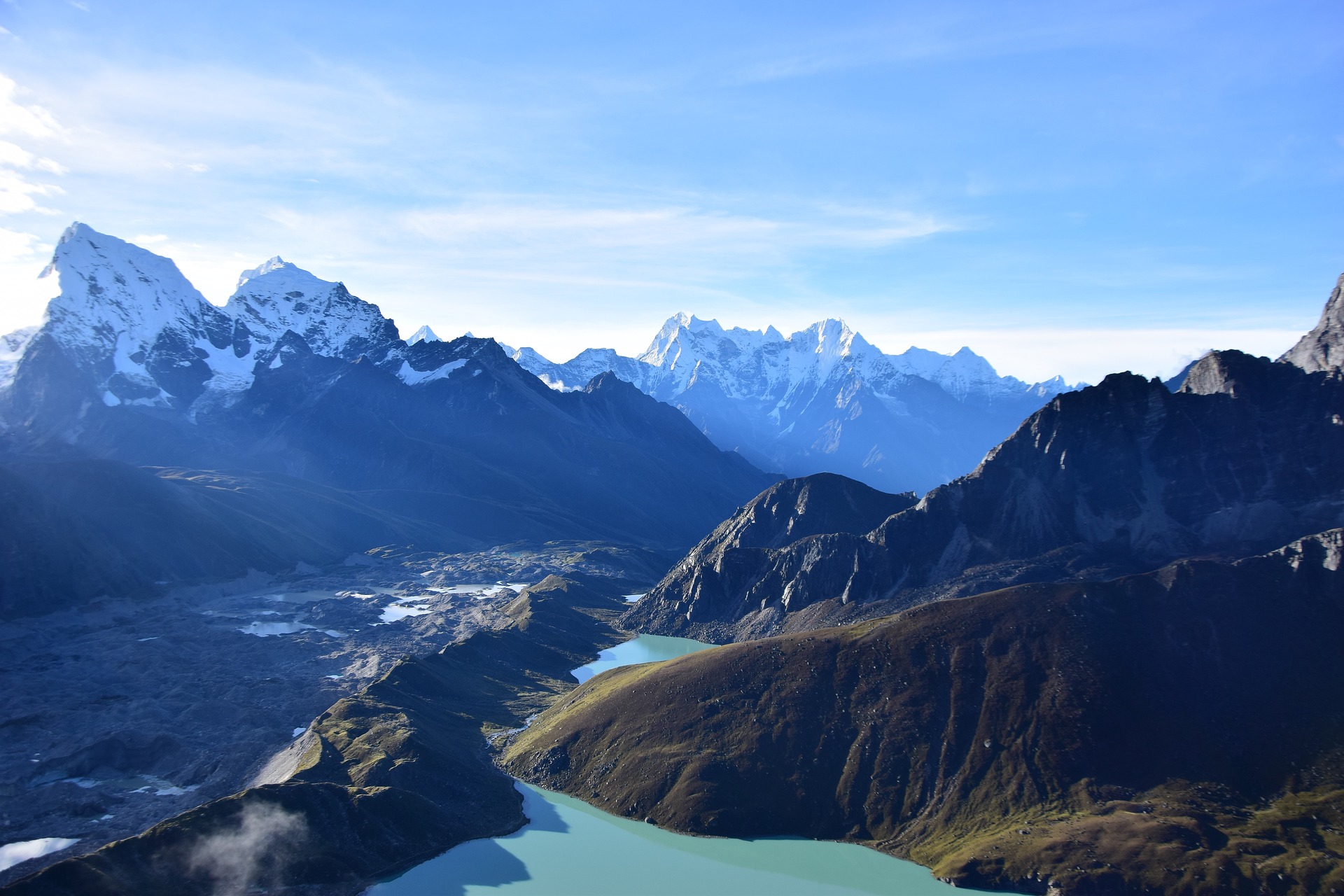
Gokyo-Ri glacier
Gokyo Lakes
The Gokyo Lakes or Gokyo Ri Trek is a fantastic variation on the Everest Base Trek. The route begins in Lukla and follows the traditional EBC trek itinerary for the first three days up to Namche Bazaar. Here it veers off to the North-west via the towns of Dole and Machemo, up to the stunningly beautiful Gokyo Lakes . The trail then ascends Gokyo Ri (5,483 meters) and traverses Cho La Pass (5,420 meters) before joining back up with the classic base camp trek at Lobuche.
The variation adds 2-3 days to an average Everest Base Camp trek but provides an excellent opportunity to avoid the crowds on the busy everest trail, as well as gives one the opportunity to trek up and down on different routes.
Chhukhung Valley
The Chhukhung Valley sits east of Dingboche and provides an alternative and longer passage to Lobuche than the traditional Everest Base Camp trail. Trekkers stay a night in Chhukhung (4,730 meters) before returning to Lobuche via Kongma La Pass (5,535 meters), an epic Himalayan pass .
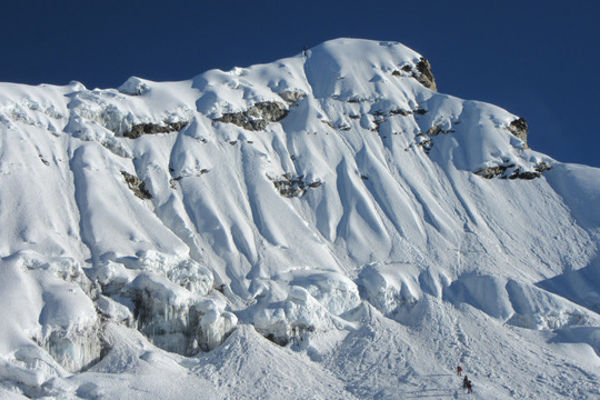
Island Peak headwall
Island Peak
Island Peak is one of Nepal’s 33 trekking peaks. Standing at 6,189 meters, Island Peak is a real challenge in terms of altitude, but only requires beginner level climbing skills (you will need to be comfortable with ice axes and crampons though). Most climbers use the traditional Everest Base Camp trek to acclimatise for Island Peak.
Returning from Everest Base Camp, you can either trek to Cchukhung via Dingboche from Lobuche or veer South-east from Lobuche traversing the Kongma La Pass to Cchukhung (4,730 meters). From here you can trek to Island Peak Base Camp (5,120 meters) in preparation for their trek / climb up to Island Peaks summit. The summit typically takes 2 days and the total trip, including Everest Base Camo, between 18-20 days.
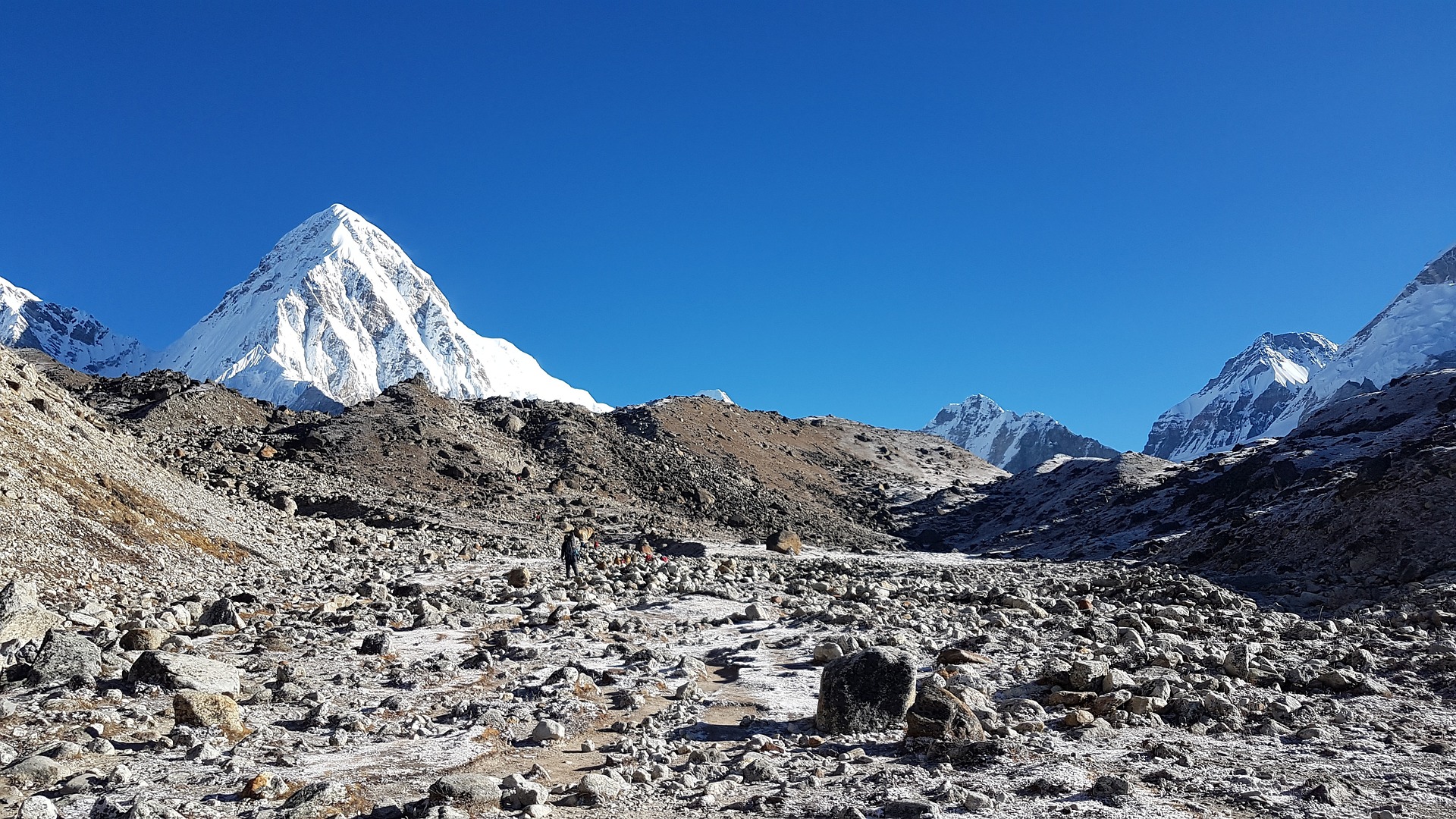
Everest Base Camp Trek FAQ
How much does the ebc trek cost.
Like many treks in Nepal, there are three ways you can plan your Everest Base Camp trek. See more in our guide on a detailed breakdown on the cost of an Everest Base Trek .
Below are four options for Everest Base Camp treks and their estimated costs.
Independent Trekking
Here you organise your trek. You will need to get yourself from Kathmandu to Lukla (a flight is the fastest and easiest; there are buses but these are rather unpleasant). You can employ the services of a porter or guide in Lukla or indeed in Namche, but it is important to note that as an independent trekker, it is illegal to use a guide or porter that is not licensed as a trekking agent through TAAN, or affiliated with a licensed trekking agent. You will need a Green TIMS card (costing NPR 2,000), money to buy food and water, a reliable and accurate map, and negotiations skills to book teahouse accommodation.
The estimated cost for an independent trek excluding flights is between $500-$800.
Local Tour Operator
There are many local tour operators in Kathmandu who organise guided Everest Base Camp treks. Generally local Nepal trekking companies are quite good. You will join a group of trekkers (up to 15 people) and have a team of porters, assistant guides and lead guides (who can speak English) of a similar size to the trekking group.
It is important to check that your local operator is a licensed trekking agent. We recommend shopping around and asking for recommendations from other trekkers. The cheap local operators tend to be the least reliable, often only providing tent accommodation or access to old and poorly run teahouses. Their ethical standards towards staff and the local environment may not be to the highest standard as well.
The estimated cost for an Everest Base Camp trek organised by a local tour operator is between $800-$2,000.
Western Run / Operated Tours
There are many Western run companies that offer Everest Base Camp treks. Most of these Western companies have their own ground teams or strong relationships with the best local tour operators who they outsource their on-the-ground operation to, whilst managing the overall tour experience.
The best Western companies own their on-the-ground operations. Expect a well-run tour with either a Western guide or a very well-trained local guide who understands the subtle service nuances expected of a Western trekker.
The estimated cost for an Everest Base Camp trek organised by a Western run tour operator is between $1,200-3,000.
Everest Climbing Expedition
A fourth option of joining an Everest climbing expedition is also possible. Major climbing operators like Adventure Consultants, Jagged Globe or Alpine Ascents usually offer Everest Base Camp trekking spaces on their Everest climbing expeditions. Securing a trekking space can be a little pricey but offers one an incredible insight into an Everest expedition as well as the chance to spend a night or two at Everest Base Camp.
If you think a base camp trek is expensive, wait till you hear how much it costs to Climb Mount Everest !

Are permits required for the EBC trek?
Yes, there are two permits you require for standard treks from Lukla to EBC. They are:
1. Trekkers Information Management System (TIMS Card)
TIMS cards are issued by the Tourism Agency Association of Nepal (TAAN). There are three different types:
- Organised TIMS Card (Blue in colour, USD 10). If you are trekking with an organised tour these will be arranged for you. You will need to provide your passport number and one passport photograph
- Individual TIMS Card (Green in colour, USD 20). If you are trekking independently (without support) you will need to get one of these TIMS cards from the Nepal Tourism Board in Kathmandu
- SAARC Country TIMS Card (Red in colour, USD 3). These cards are for nationals from the South Asian Association for Regional Cooperation, i.e. India, Bhutan, Pakistan, Sri Lanka, Maldives, Bangladesh and Afghanistan.
2. Sagarmatha National Park Entry Permit (USD 30 + 13% Govt. Tax)
The Sagarmatha National Park or Solukhumbu is the region through which the EBC trek runs. A National Park entry permit is required to enter Sagarmatha. Permits can be acquired at the first checkpoint along the route, north of Lukla called Monjo. The cost is US$30 + 13% tax for trekkers using a trek operator or agency, as well as for independent trekkers. Permits can also be acquired in Kathmandu, but we recommend getting it in Monjo as it is more straightforward.
For treks from Jiri to Everest Base Camp, there is another permit required called the Gaurishankar Conservation Area Project permit. It costs US$20 (no discount for independent trekkers or SAAEC nationals). The checkpoint is at at Shivalaya (just after Jiri). We recommend getting the permit in Kathmandu before departing as the cost is double if they have to issue the permit in Shivalaya.
As a rule of thumb, we recommend bringing at least 4 passport size photographs for all your permit requirements.
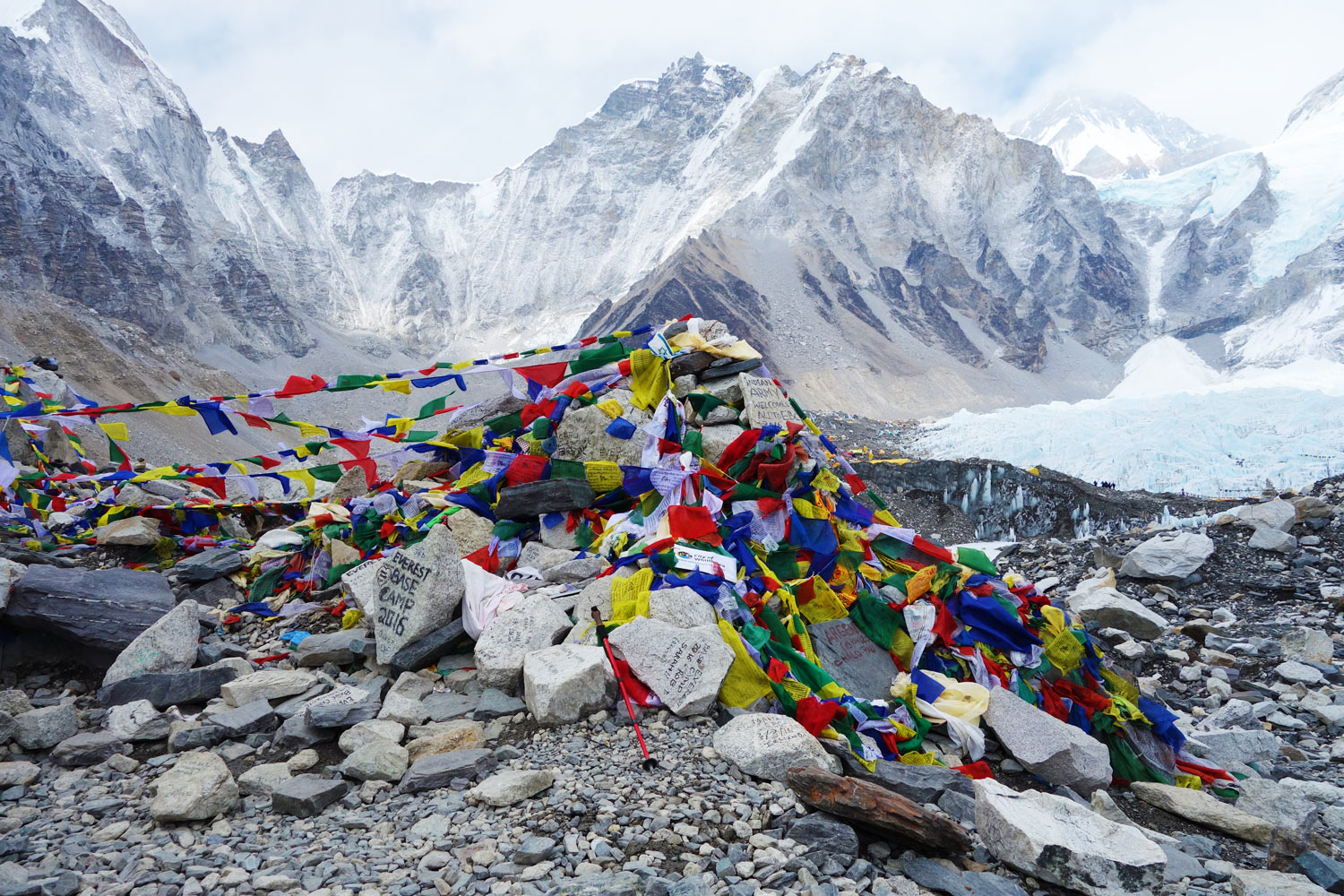
When is the best time to trek to Everest Base Camp?
The best time to trek Everest Base Camp is during the dry and warm months of September through November of March through late May / Early June.
The monsoon rains arrive in mid-late June and get into full swing for the months of July and August (as seen in the average rainfall map below). The route is really too wet for trekking and you would be better placed to explore treks in rain shadow areas like the Upper Manang, Mustang, Annapurna or Dolpo region.
December, January and early February are very cold. Treks run during these periods but be prepared for freezing temperatures and possible snow flurries. The upside is that the route is a lot quieter than in the peak seasons.
The chart shows average temperatures and rainfall in Nepal (data from 1960-1990 compliments of the Climate Change Knowledge Portal at the World Bank ).

Is altitude sickness a risk on the Everest Base Camp hike?
Yes, altitude sickness is a risk on the Everest Base Camp route. The trek takes one from a moderately high altitude, 2,800 meters in Lukla, to high altitude, over 5,300 meters at Everest Base Camp and over 5,500 meters at Kala Patthar. At these higher altitudes, the body needs to have acclimatised to the lower saturation of oxygen in the air in order to avoid the symptoms of altitude sickness (or what is sometimes referred to as Acute Mountain Sickness – AMS).
The good news is that a typical Everest Base Camp hike has a slow ascent profile which maximises the amount of time available to acclimatise. Nonetheless, every year 100s of people suffer altitude sickness symptoms and some need to cut their trek short due to more severe complications.
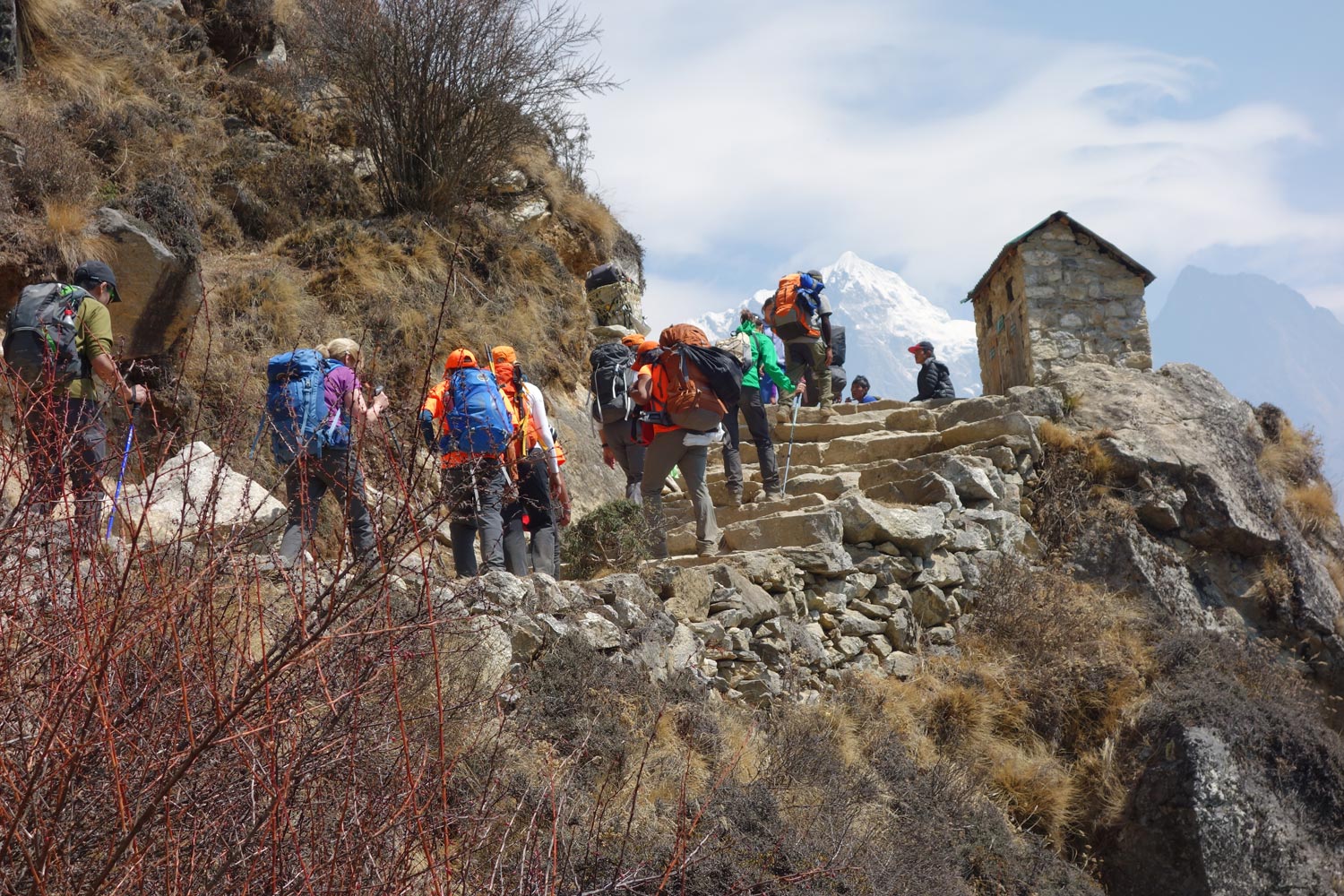
How difficult is the Everest Base Camp Trek?
The difficulty of the Everest Base Camp Trek is relatively low. It should be noted that the Everest Base Camp trek requires no climbing expertise and there are certainly no technical climbing sections. With determination and a basic fitness level, you should be able to trek the route. We have seen old and young, overweight and underweight complete the trek – all with a smile on their face!
With that being said, there are certainly some factors that should be considered prior to your trek, such as altitude, length and training that will enable you to better understand what you are getting yourself into before deciding.
What gear do I need for the EBC Trek?
One of the most frequent questions that we get asked is what gear should be packed for an Everest Base Camp trek.
To make your life a lot easier we have written a very detailed Everest Base Camp packing list article. The list is fairly exhaustive but includes all the absolutely necessary items of clothing and outdoor gear that you should bring with you.
You will have the opportunity to either buy or rent gear in Kathmandu, Lukla or even in Namche Bazaar, but in general we recommend you bring with you the main items (i.e. hiking daypack , hiking boots, warm down jacket, sleeping bag and sleeping mat , trekking poles , appropriate trekking clothes, headgear and headlamp and gloves etc.)
What travel insurance do I need for the EBC hike?
Trekking Everest Base Camp comes with obvious risks. We recommend you get travel and trekking insurance for all treks in Nepal .
On the Everest Base Camp route, you will reach a maximum altitude of 5,416 meters, so it is important you choose an insurance package that covers you up to that altitude.

Are there any recommended guidebooks for the Everest Base Camp Trek?
Absolutely. There are some great guidebooks and trekking maps to choose from when doing the Everest Base Camp Trek.
The classic EBC trail itself is well-worn, but there are many smaller yak trails that can confuse people.
We recommend taking a detailed trekking map. The region is sparse, and it is possible to get lost in the many valleys that lie on either side of the main trail. The most recent Lonely Planet Trekking in the Nepal Himalaya provides the most up to date information and maps of the region.
Sian Pritchard-Jones and Bob Gibbons’s book: A Trekking Guide to Everest is also rather good.
For a more general guide to Nepal, you may want to check out the Nepal Lonely Planet Travel Guide .
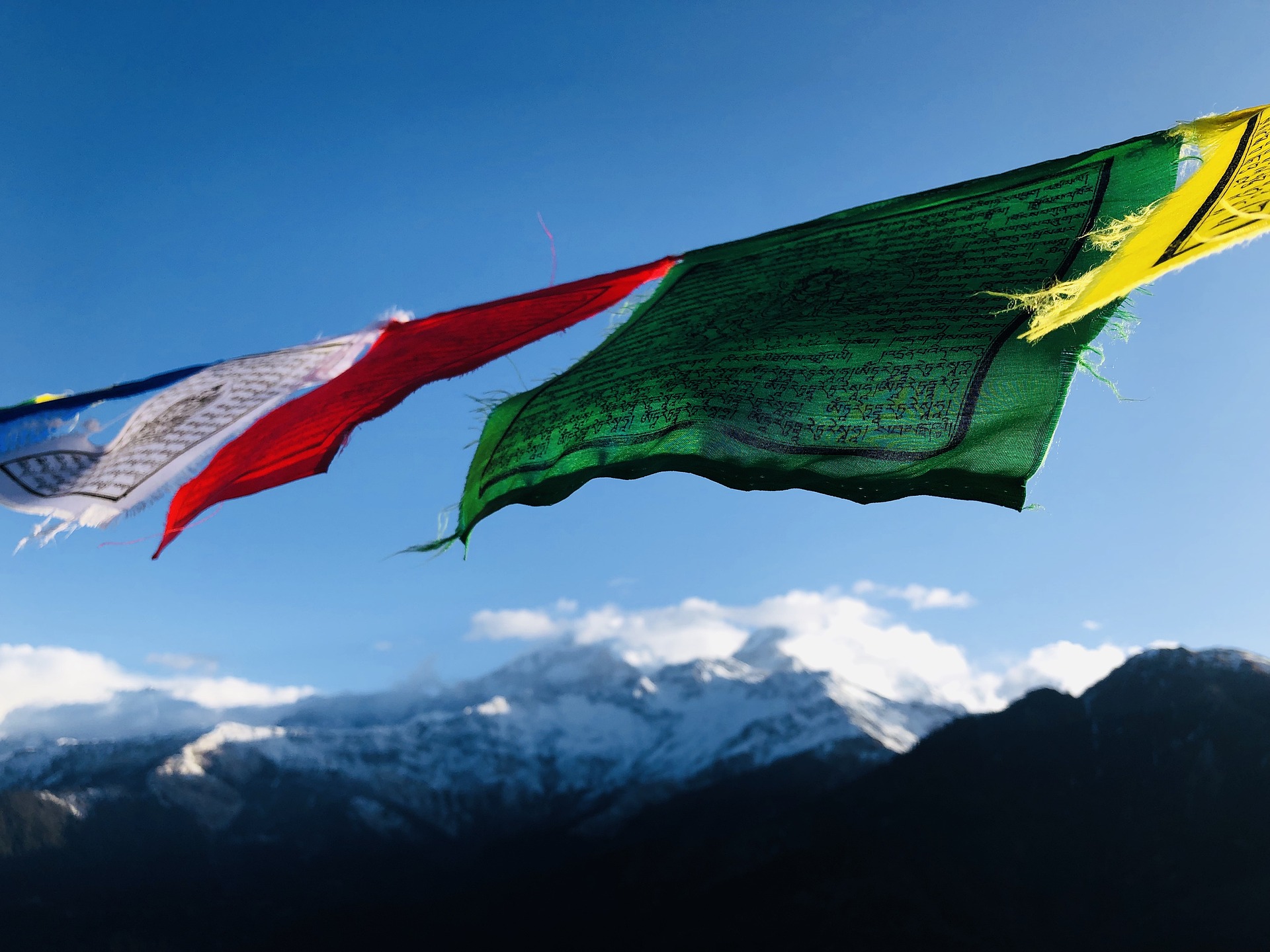
Are there any other hikes in Nepal you would recommend?
Yes, there are many other hikes in Nepal that I love.
Some of the most popular alternative Nepal trekking routes are the Annapurna Circuit Trek , the Langtang Valley Trek and the Manaslu Circuit Trek . If you're looking for some easy Nepal hikes , then check out the Poon hill hike or the Royal hike . For short Nepal hiking routes see the Helambu hike , which is near Kathmandu.
Continue browsing
See more information on Nepal . Or check out these other Everest/Nepal articles:
- Best Climbing Mount Everest Tips
- Food on the Everest hike
- Internet Access on EBC hike
- Everest Base Camp Trek Deaths and Statistics
- Best Places to Visit in Nepal
- What to Expect in Nepal Tea Houses
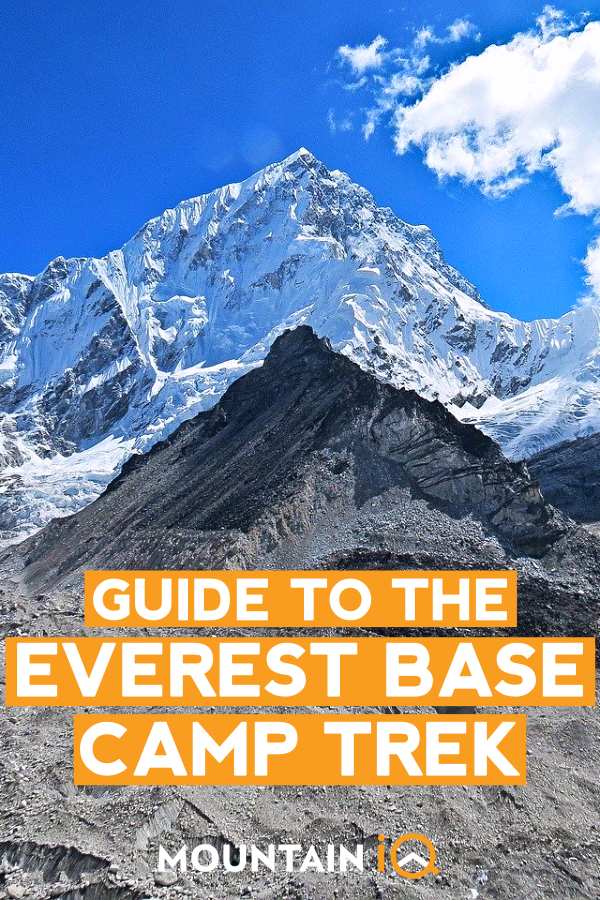
About the author
Mark Whitman
Mark has trekked extensively in Asia, Europe, South America and Africa. He founded Mountain IQ in 2014 with the sole aim to be the best online information portal to some of the most popular mountain destinations around the world. When not writing for Mountain IQ, Mark is out exploring the outdoors with his wife!
Leave a Reply
Your email address will not be published. Required fields are marked
Nice article. Full of true information and very supportive for new trekkers.
We work with local guides to offer great value adventures at unbeatable prices

Everest Base Camp Trek – Ultimate Guide For 2024
Written By: The Planet D
Adventure Travel , Nepal
Updated On: January 5, 2024
Trekking to Everest Base Camp is different than other treks around the world. Nowhere else on earth will you experience trekking as you do in Nepal and nowhere quite compares to the majesty of the Himalayas. Villages dot the landscape filled with restaurants, markets, bazaars, and tea houses (mini-hotels) where you can stop for lunch, buy supplies, and have a piece of apple pie while surrounded by the highest mountains in the world.
Every hundred meters or so there is a hotel, restaurant, or cluster of buildings making up a small village. The villages are stunning reminding us of something out of the Swiss Alps on steroids. Well-built lodges and brick homes line the trail with the magnificent setting of the Himalayas draped in the back.
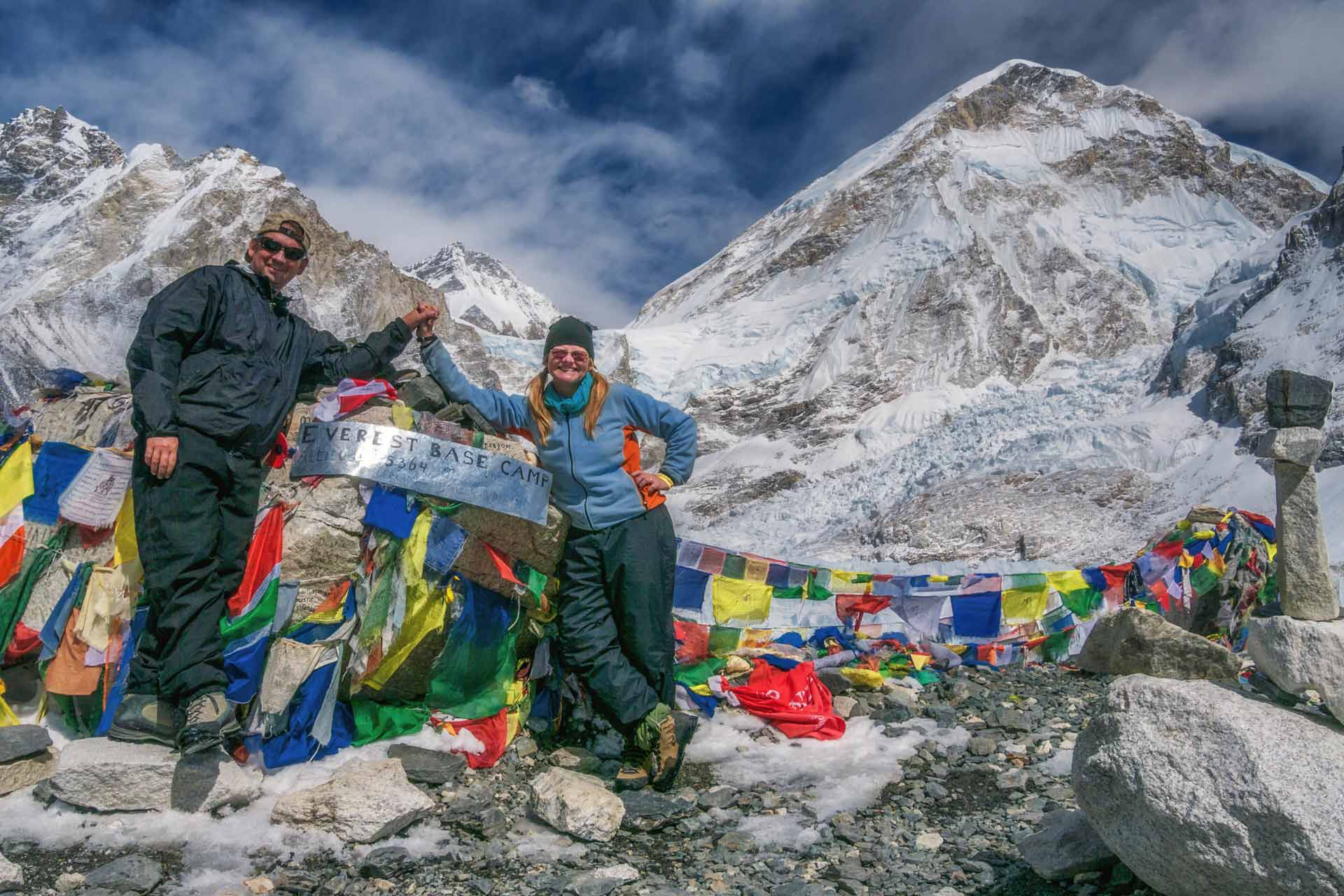
Table of Contents
Trekking to Everest Base Camp
What is it like trekking to Everest Base Camp in Nepal? The EBC Trek is life-changing, it’s exhilarating, and it is challenging. We share everything you need to know from planning your trek to Everest to packing for your trip. This guide to the Everest Base Camp Trek breaks down each day. So sit back and take a journey with us through Nepal’s legendary Sagarmatha National Park.
Everest Base Camp Trek Itinerary
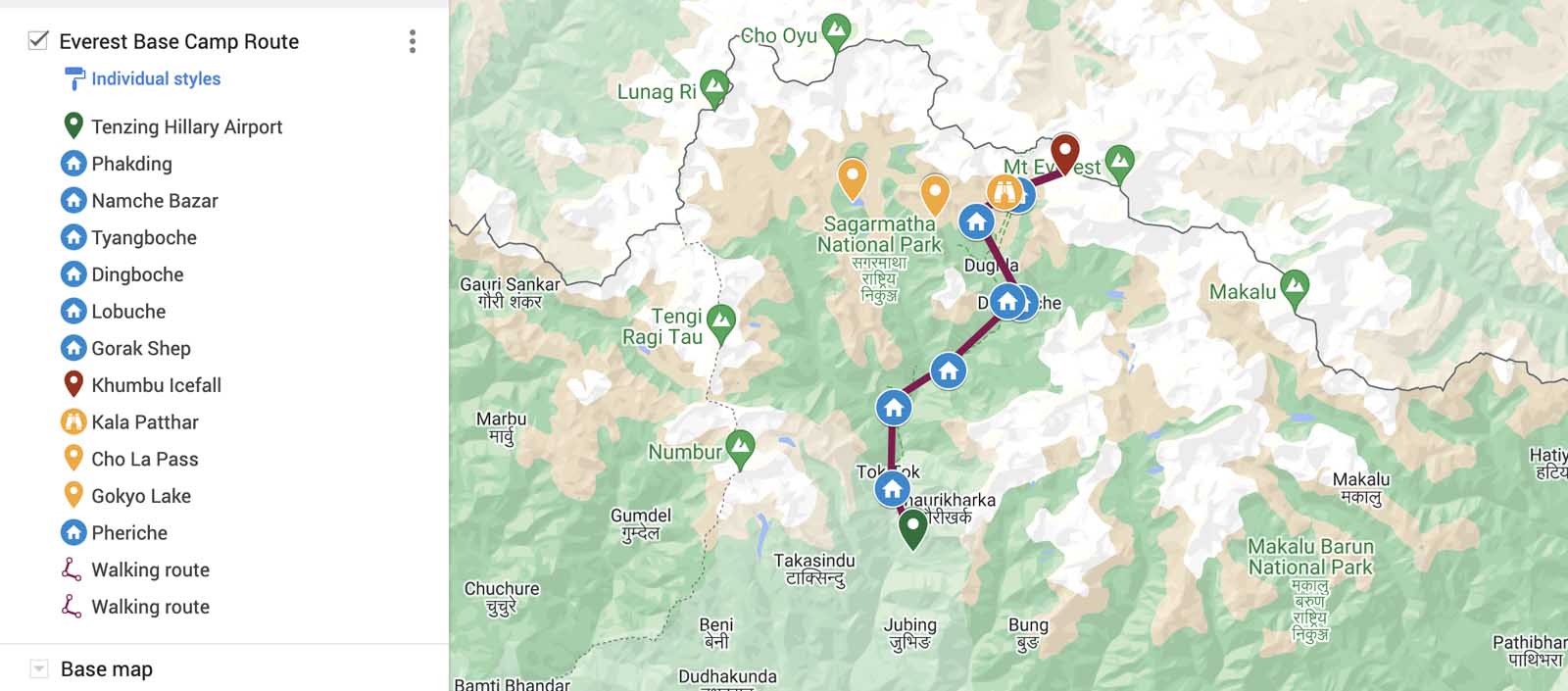
On the map, the Everest Base Camp trekking route distances look fairly easy to hike from village to village through the Khumbu Valley. Eight days may seem like it would be more than enough time to cover a mere 63 km (39 miles) one way, (128 km return) but with several sustained days in a row above 4000 meters (13,000 feet), the walk is slow and steady.
It is important not to push too fast to avoid altitude sickness which is a very real possibility. When trekking to Everest base camp, expect to hike anywhere from 7 – 17 km (4.5 – 10 miles) per day with the entire trek taking 12 – 14 days.
Hiring a Guide for the EBC Trek – Mandatory
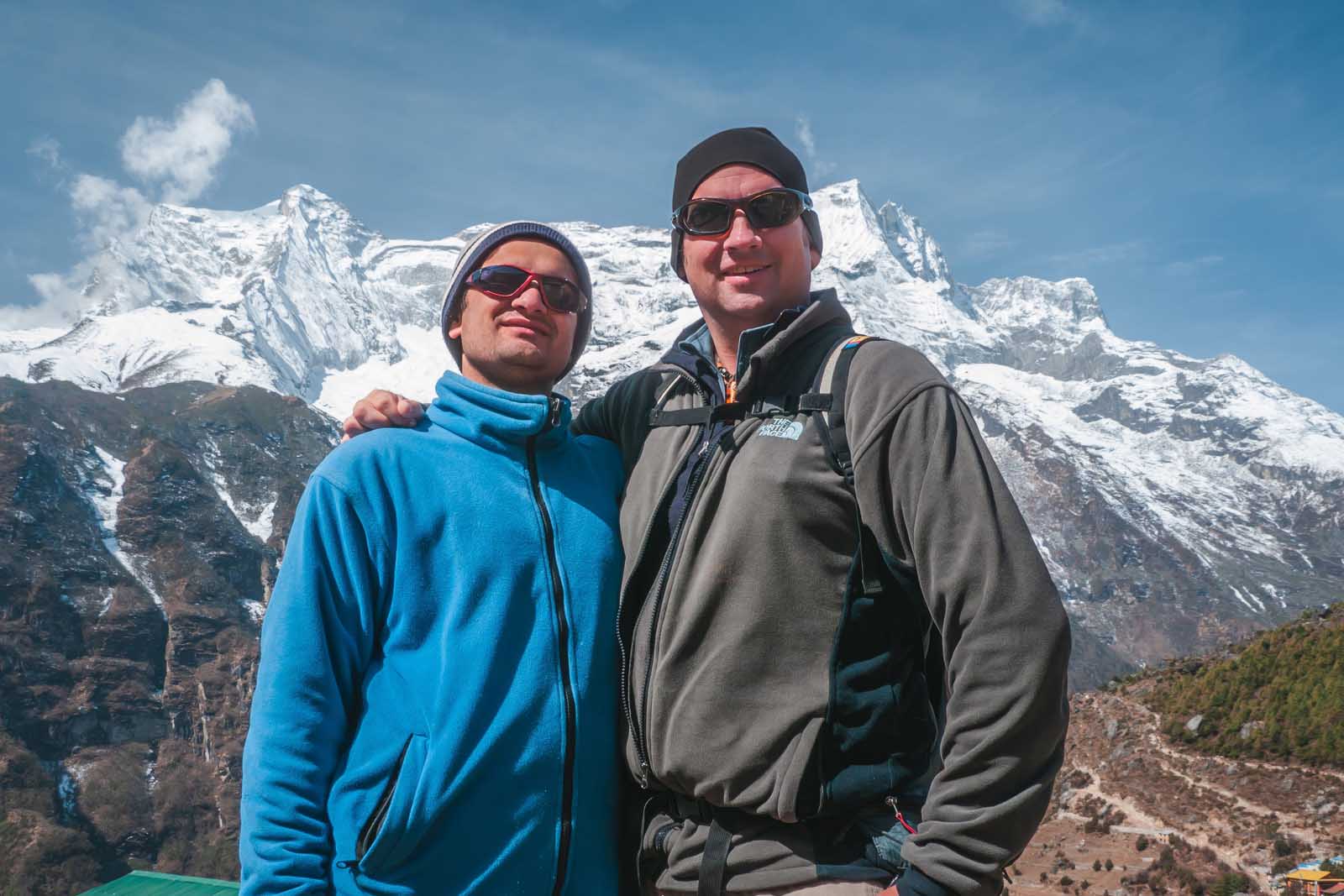
In April 1, 2023, Nepal has banned solo trekking. Foreigners must hire a guide for treks in high-altitude trekking regions of national parks. According to the Kathmandu Post in March “ solo or independent trekkers have to mandatorily hire a guide or a porter before setting off to Nepal’s mountains.” However, after an updated article in the Kathmandu Post, it seems that the Everest Region is an exception. Before booking, we would check with local companies and authorities as rules are constantly changing.
Book Locally
Many people book ahead of time with a tour company located outside of Nepal such as Intrepid Travel or GAdventures, but we hired locally and it saved a lot of money.
Plus, you know your money is going directly to the local economy and you have a more intimate experience by trekking with a local guide. We spent a couple of days in Kathmandu looking for a guide to Everest and found Simrik Real Nepa l owned by Kathmandu resident Dipendra Simkhada.
Dipendra planned the entire trip for us, and all we had to do was wait for him to pick us up at our guesthouse in Kathmandu to take us to the airport to board our Tara Air flight to Lukla Airport. Book your Trek to Everest Base Camp with Simrik Real Nepal – A Locally owned and operated tour company, Simrik is located in Kathmandu.
Kathmandu – The Hub of Nepal Treks
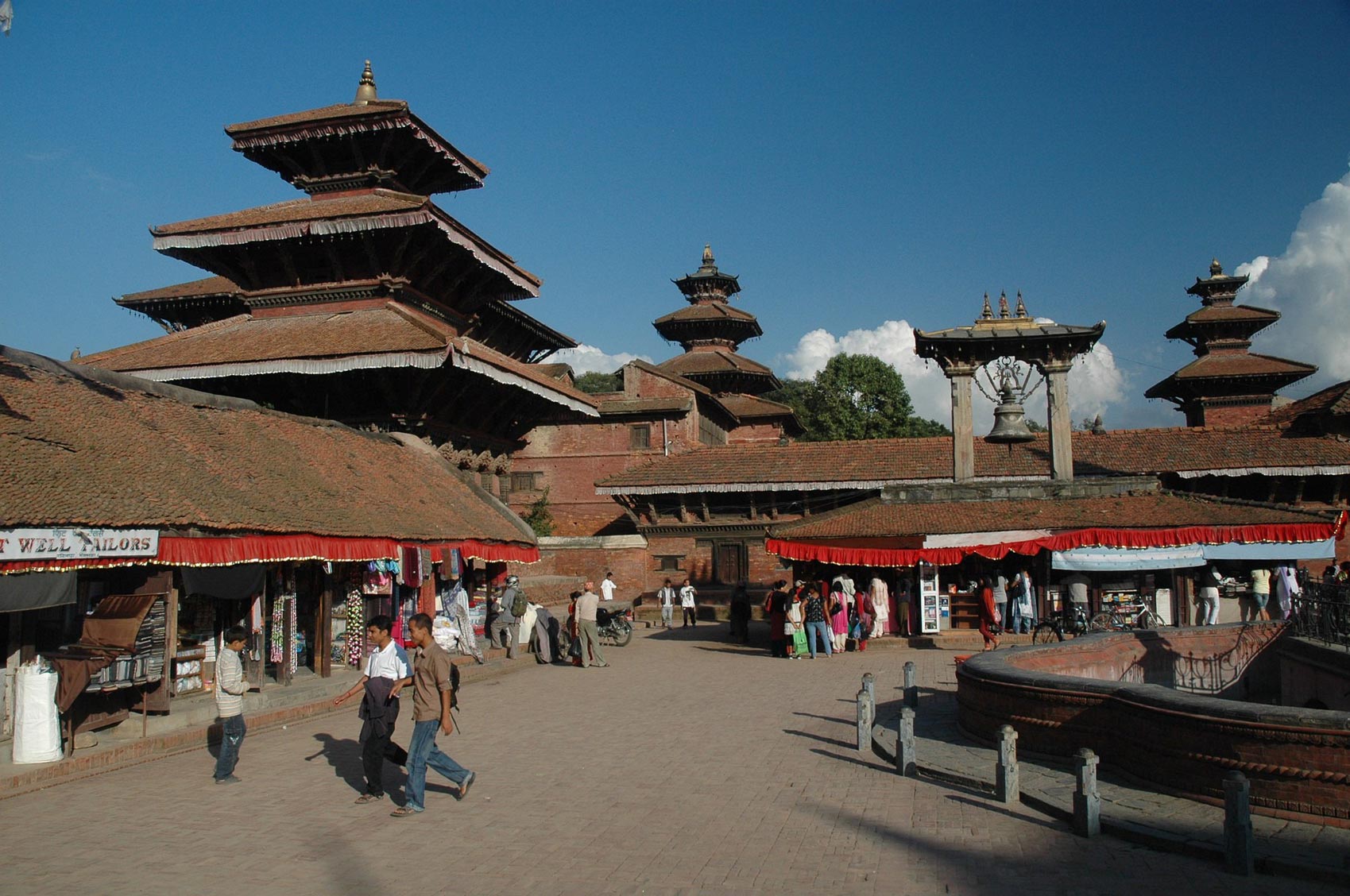
We spent a few days in Kathmandu picking up supplies and doing some sightseeing before trekking to Everest. We suggest not spending too long here as it can be very polluted in Kathmandu and by the time we were ready to trek, I was already quite congested.
Our recommendation is when you arrive in Kathmandu, only spend two to three days to get yourself organized and instead do your sightseeing at the end of your trek. Read more: Top Places to visit in Kathmandu, Nepal
Day 1: Fly from Lukla Trek to Pakhding
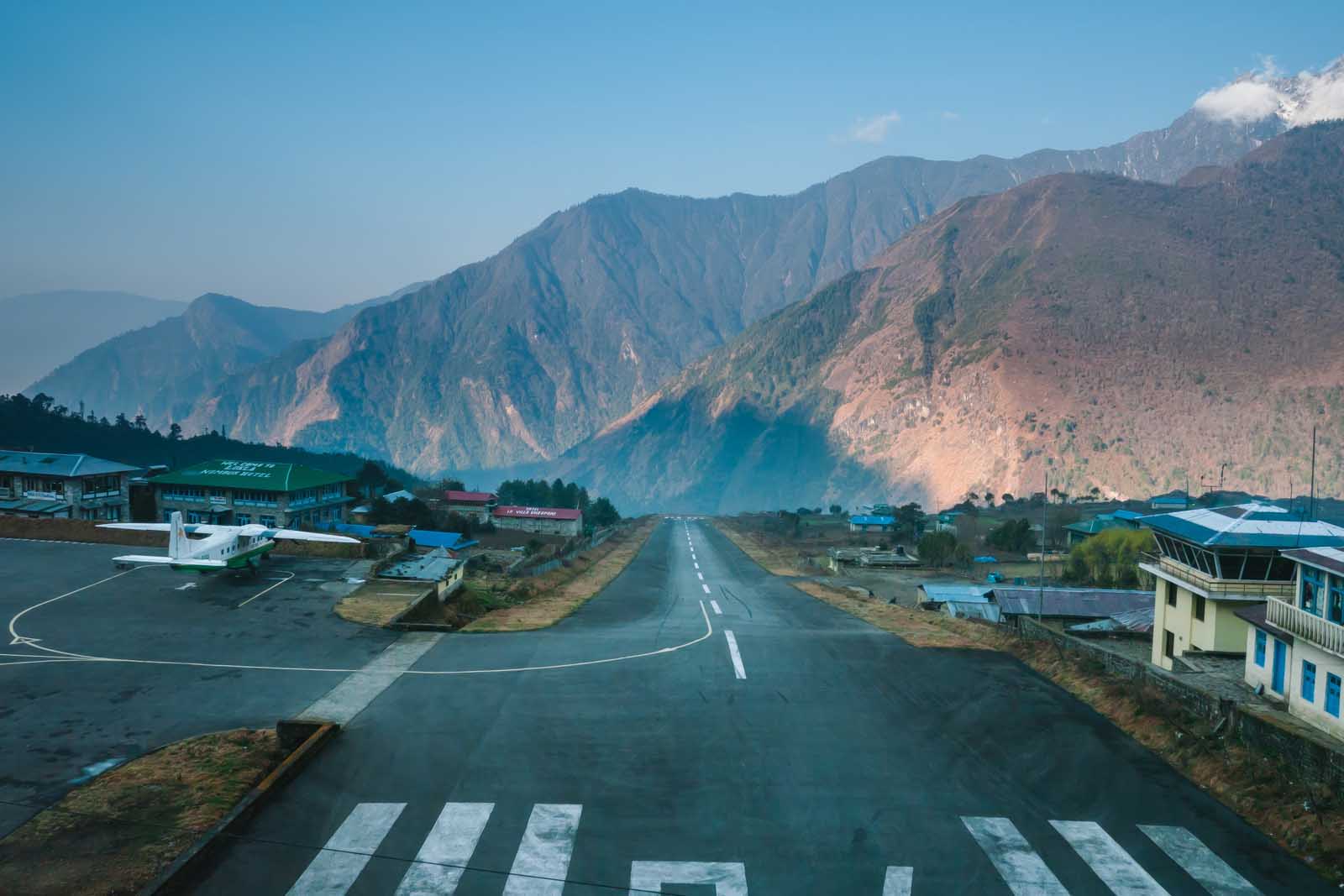
Flights to Lukla no longer leave from Tribhuvan International Airport (Kathmandu Airport) in Kathmandu due to congestion. Flights are now out of Ramechap airport which is a 4 1/2 hour drive from Kathmandu. You can book private helicopters from Tribhuvan International Airport.
The flight from Ramechap airport is much shorter than the flight from Tribhuvan International Airport. Flights to Lukla are only 12 minutes so more flights can get through when the weather is clear making flights less likely to be canceled or delayed for too long.
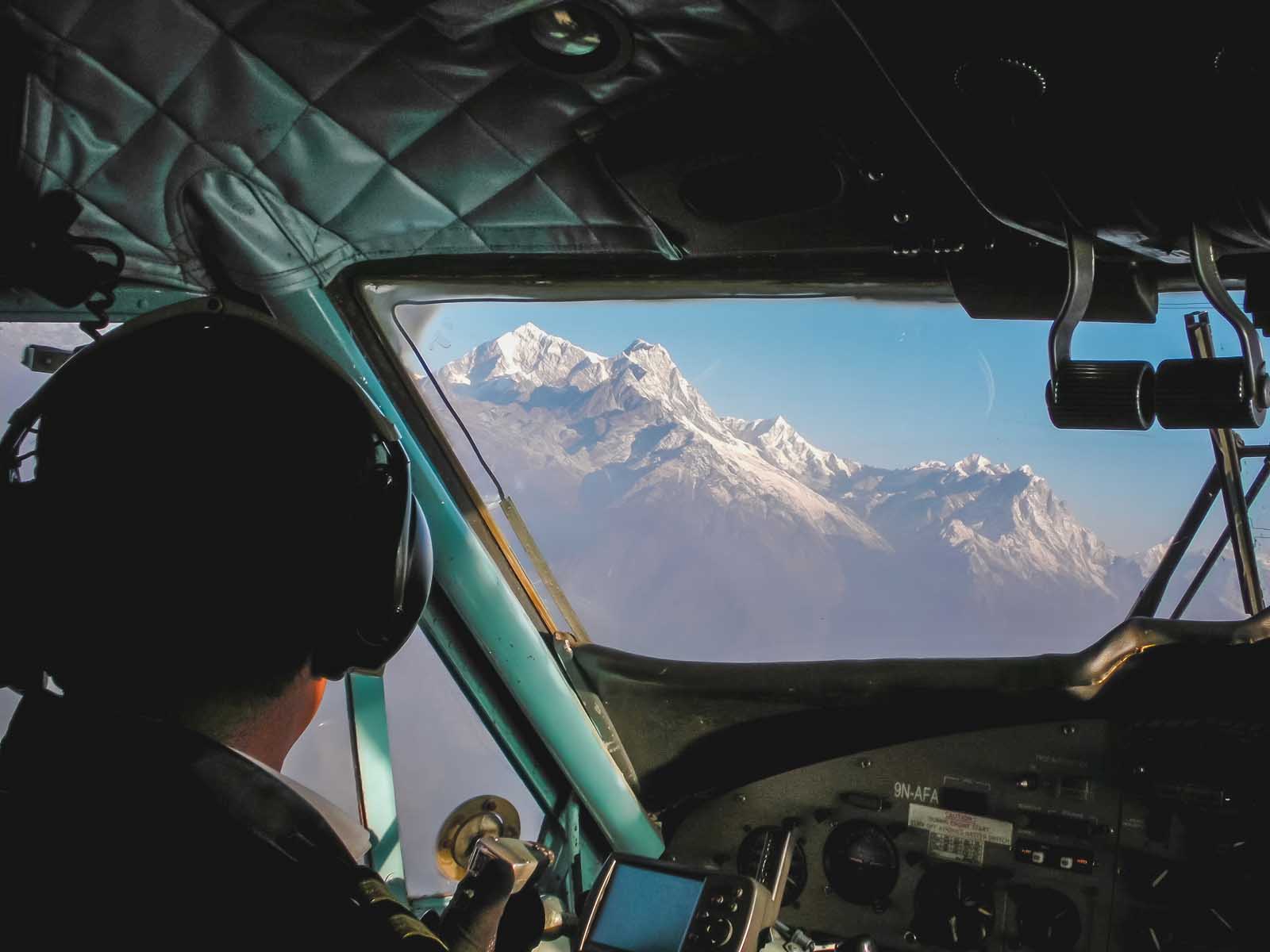
The flight to Lukla is a scary flight and is considered one of the most dangerous in the world. We flew from Kathmandu but flights now are much shorter from Ramechap. I think I would like it better as we sat at the front of the plane and saw the pilot’s instruments constantly flash “ obstacle ahead. ” It looked as if we were about to crash into a mountain at any time. Read all about our flight to Lukla and watch the video here
Watch Us Fly to Lukla Airport
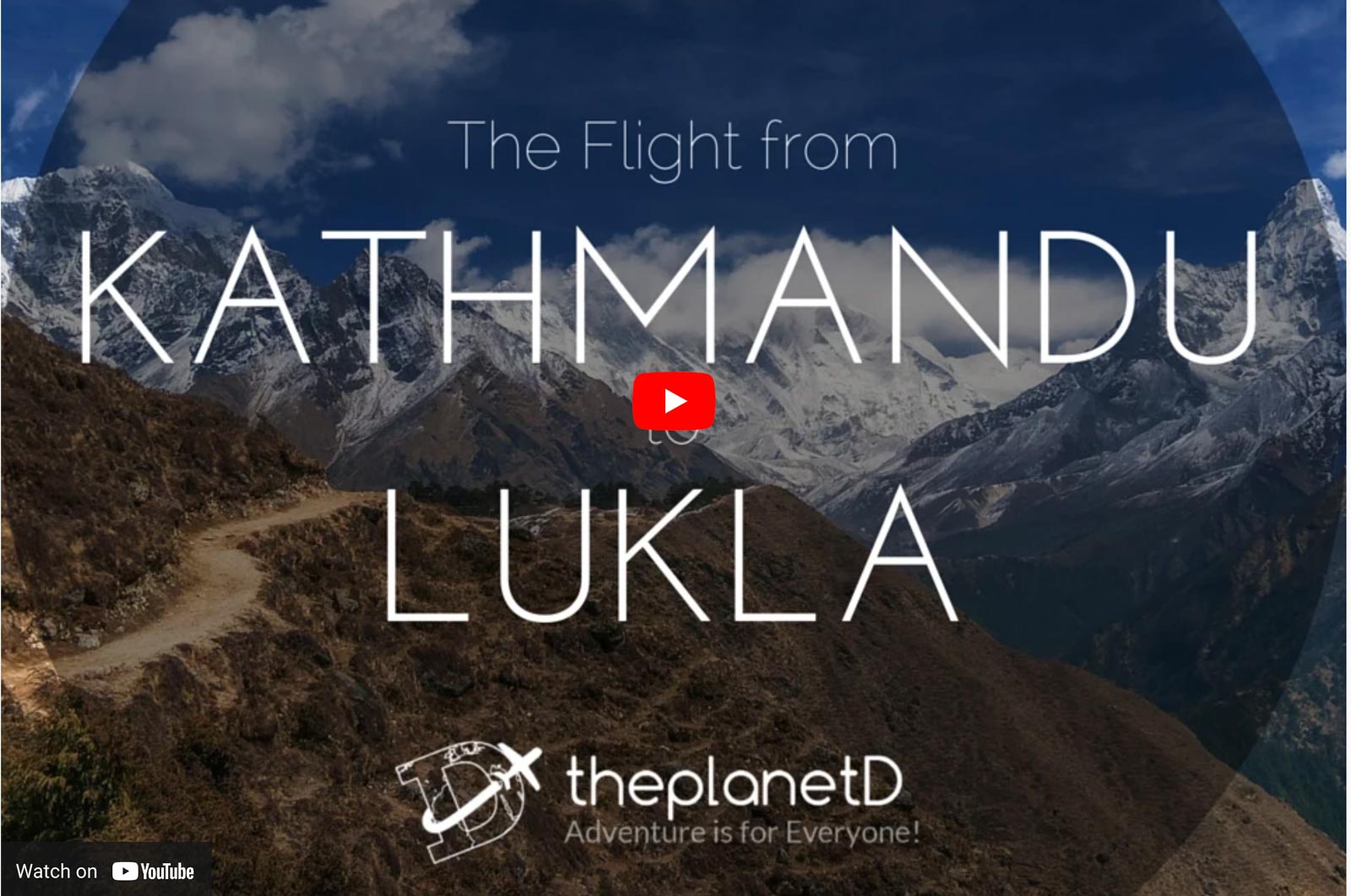
The Lukla airstrip at Lukla Airpot is a short landing strip at only 525 meters (1,729 feet long.) Built on the side of a mountain it is also a very steep grade that is needed to slow the planes down quickly. Needless to say, we held our breath during the landing.
We survived that flight, but it was the flight back to Kathmandu I was nervous about. Taking off on that short of a runway was a hair-raising experience. One false move and we’d drop thousands of feet into the valley below. Lukla Airport is actually called Tenzing Hillary Airport named after the first two men to summit Mount Everest.
Hiking from Lukla to Pakding
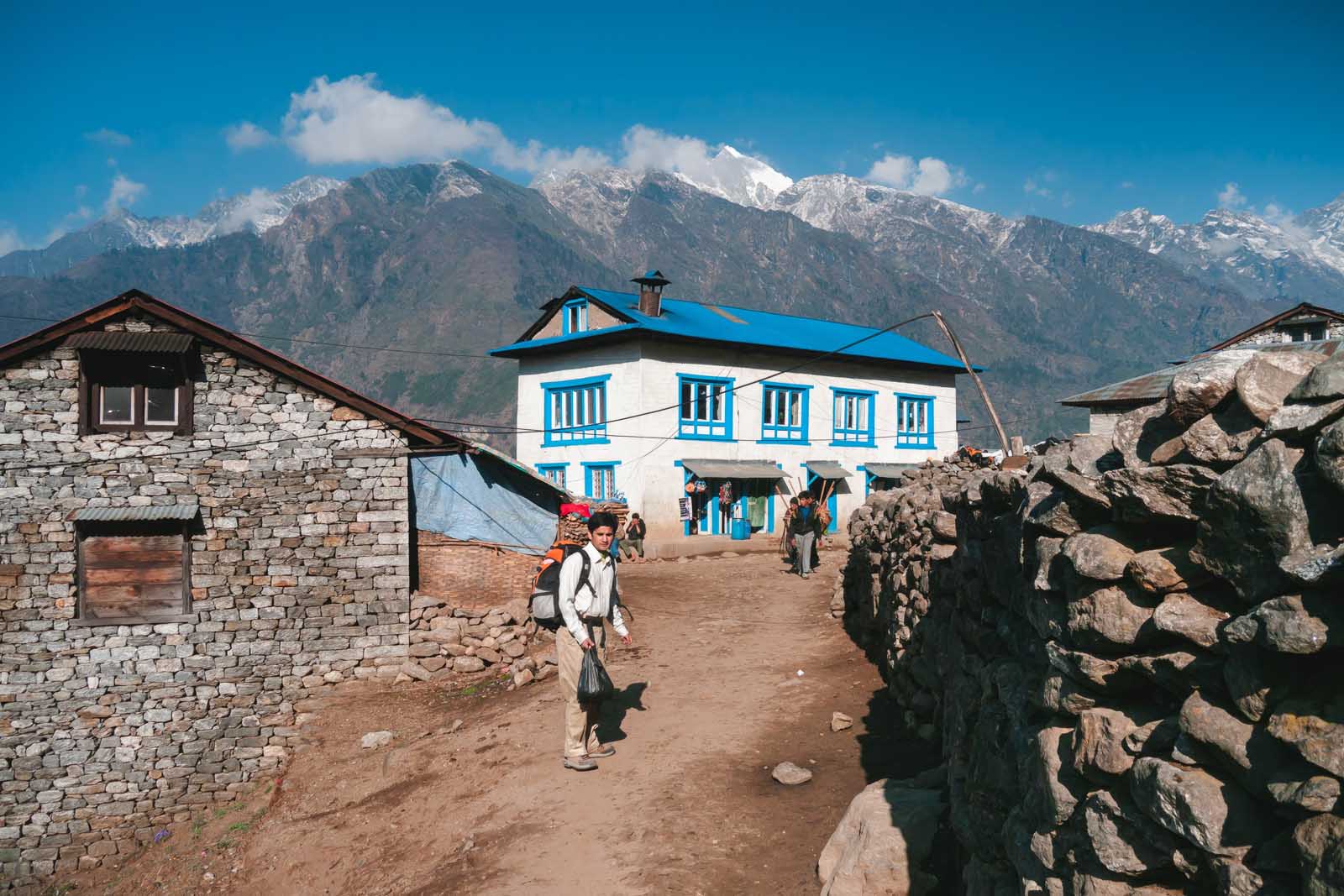
The trek begins officially in Lukla. Lukla is a busy town with plenty of accommodation, shops, and eateries. If you forgot anything for your EBC trek, you can pick up supplies in a pinch. But we suggest purchasing all your gear in Kathmandu. It is much cheaper.
From Lukla, we immediately started our Everest Base Camp hike. After a quick snack and a cup of tea in Lukla, we set off on an easy three-hour trek along trekking trails that were easy to follow weaving through villages, crossing rivers, and stumbling over stony paths.
Entering Sagarmatha National Park
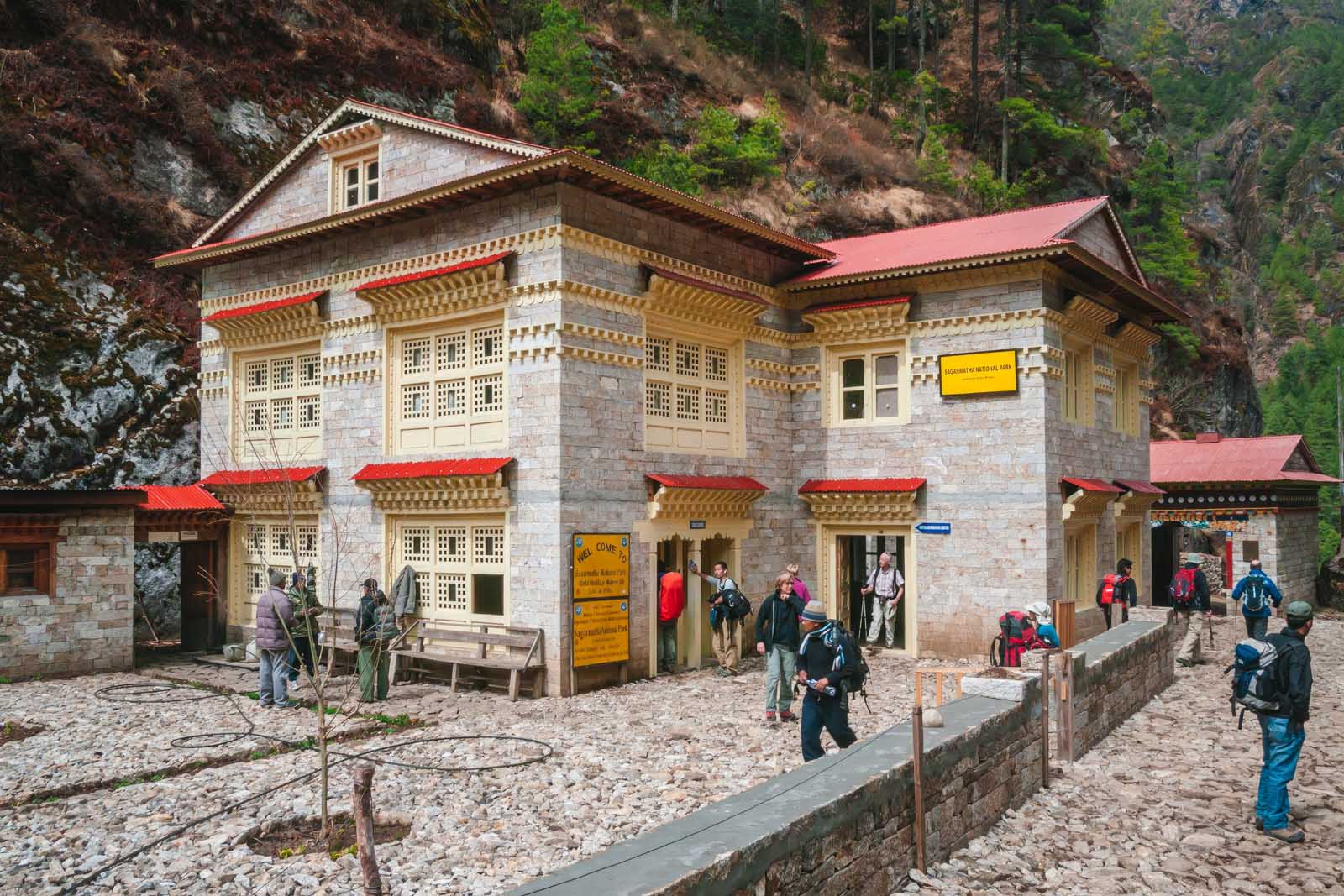
A permit is needed to hike to Everest Base Camp as it is located in Sagarmatha National Park. We checked in with the national park headquarters and Dipendra took care of everything. He had all our paperwork in order so all we had to do was start walking through the beautiful Khumbu Valley to make our way to Everest base camp.
Sagarmatha National Park has been a UNESCO World Heritage Site since 1976. At 1148 square km (443 square miles) in area, it is one of the most beautiful places we have ever visited.
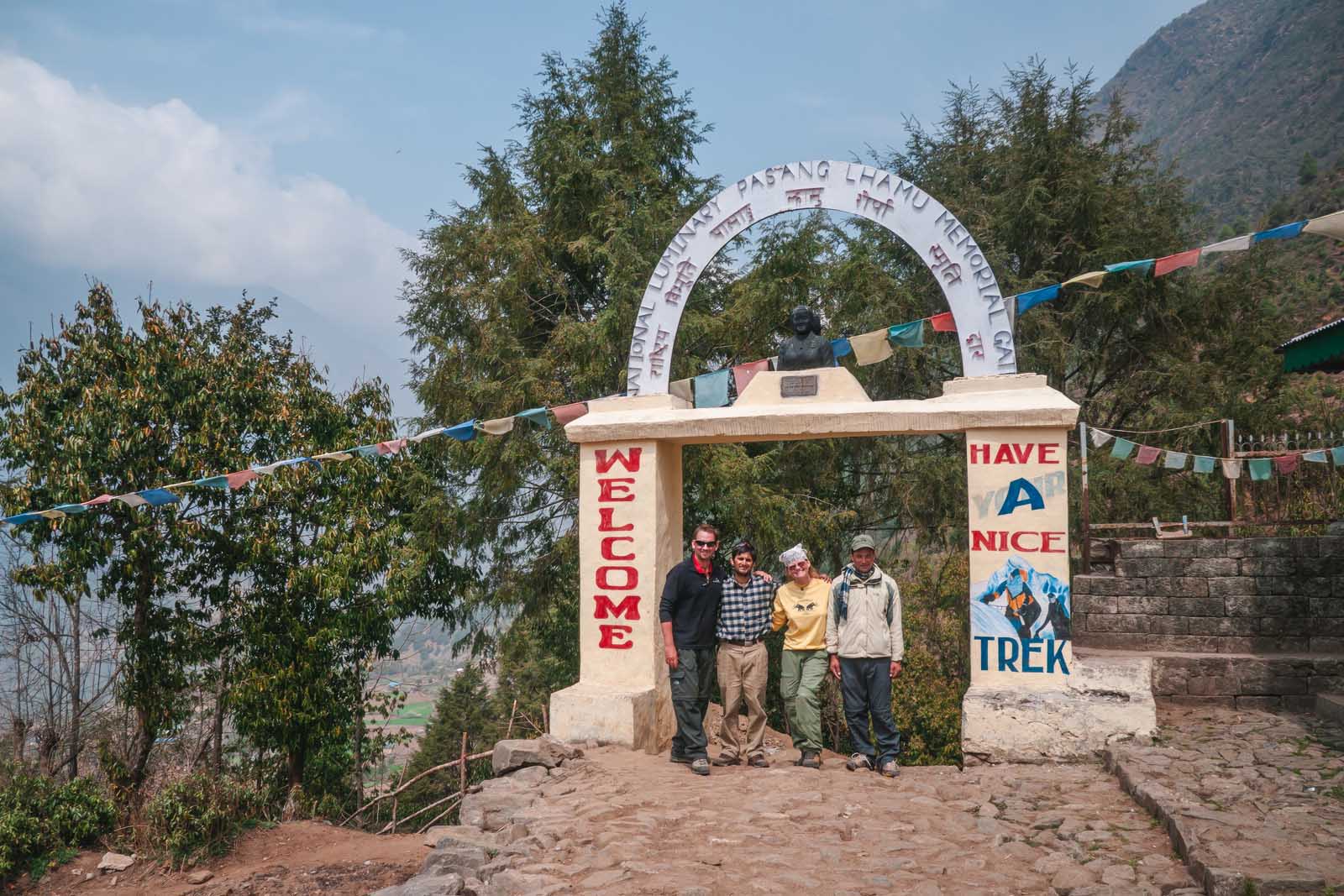
We felt giddy stepping through the welcome gates located just outside of Lukla. This was it, we were following in the footsteps of the great adventurers of our time. It was awe-inspiring to hike through the Khumbu region surrounded by the Himalayas.
As we hiked out of Lukla, Dipendra pointed out the surrounding jagged white peaks named Kwangde, Mumbu, and Kishumkongara. At 6000+ meters, (19,000+ feet) these are the “little guys” of the world’s highest mountain range. It wouldn’t be long until we were among the famous 8000-meter (26,000 feet) peaks.
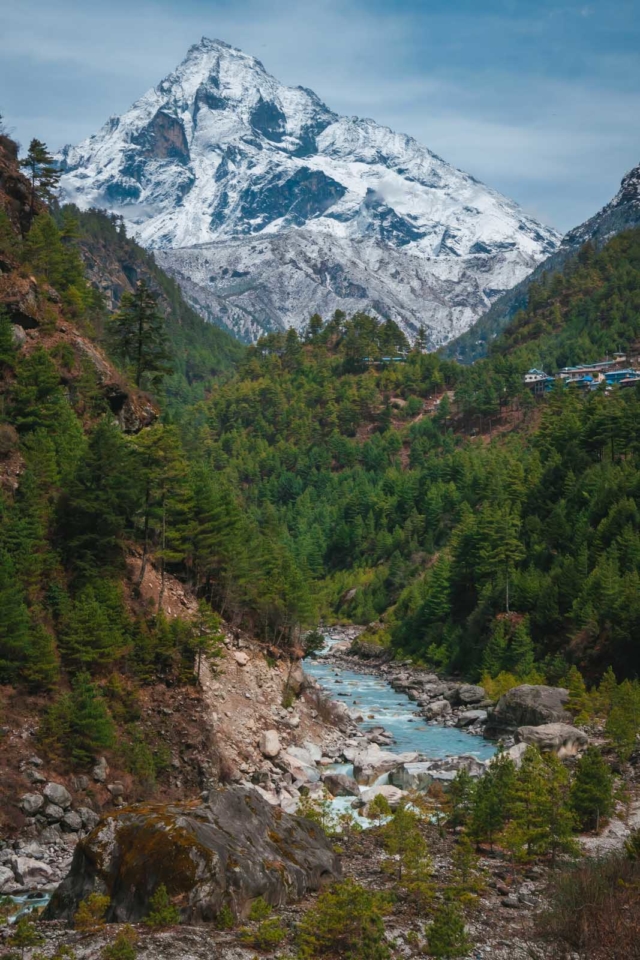
Our first day was filled with a relaxing walk while learning about the Khumbu region. It was quite early in the day, so we had plenty of time to take our time to learn about the customs of climbing and learn the names of the mountains found in this beautiful region of Nepal.
For the rest of the day, we followed the Dudh Koshi River Valley at a steady but leisurely pace to the village of Pakding. Temperatures were warm and the first day of trekking was comfortable. Lukla to Pakding actually has an elevation loss, so it is a good introduction to hiking through the region as we had a lot of downhill trekking.
After about 5 hours, we came to our first night on the trek where we spent the night in a comfortable teahouse in the village of Phakding.
Our First Night on the EBC Trek
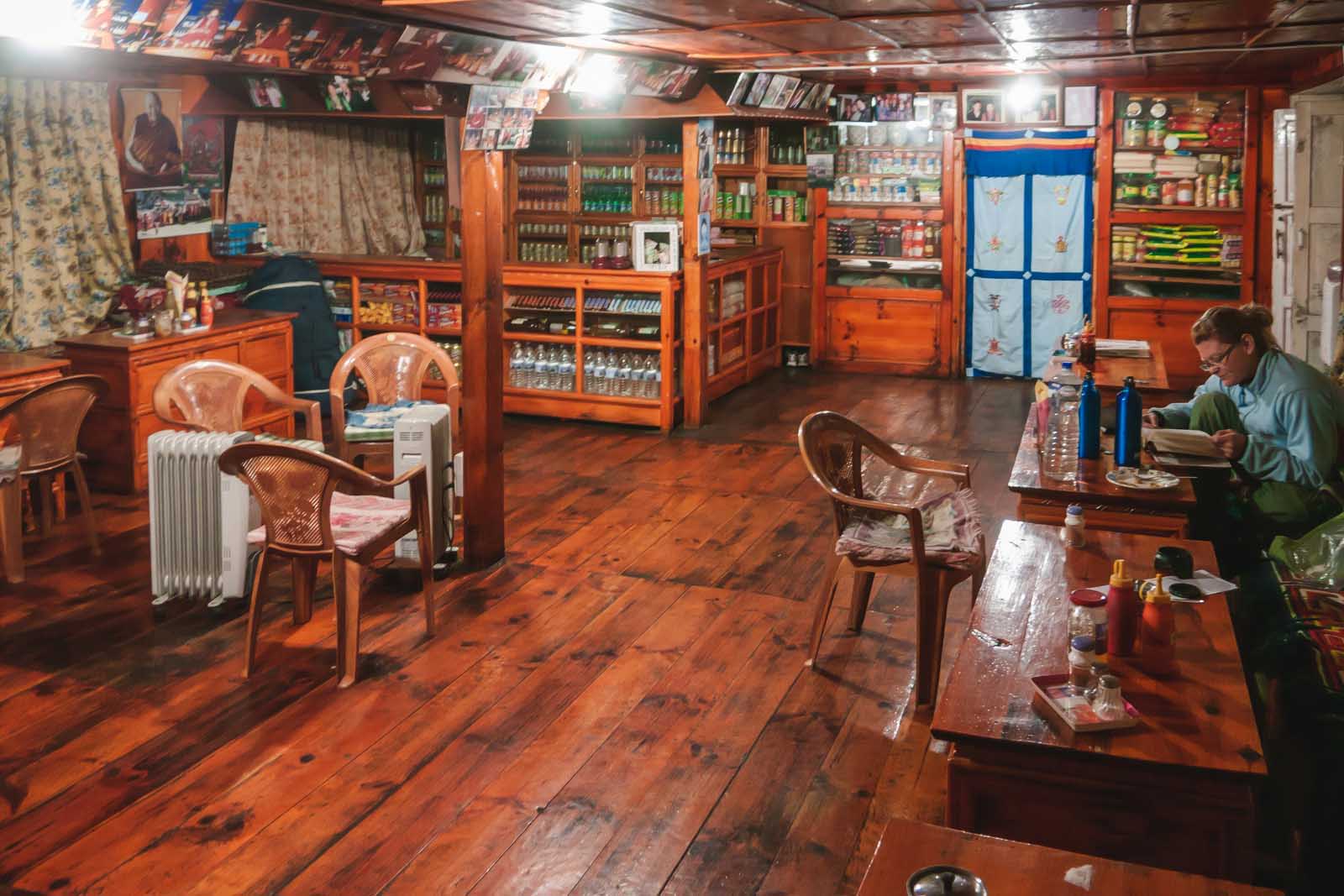
The accommodation in Pakding was a quaint little hotel/teahouse that looked like a cottage. The wood-burning stove smelled delicious as it warmed the restaurant while they prepared our meals.
Our porter “Sher” carried all our supplies including the sleeping bags that we borrowed from our trekking company. We each rented a sleeping bag that was included in the price of our EBC trek. The beds were comfortable and Dave and I had private rooms. Some tours use dorm rooms but we had private rooms. Toilets were shared, but everything was clean and comfortable. The rooms were clean and we slept like rocks snuggled up in our thick down sleeping bags.
Heated Lodges – Teahouses on the EBC Trek
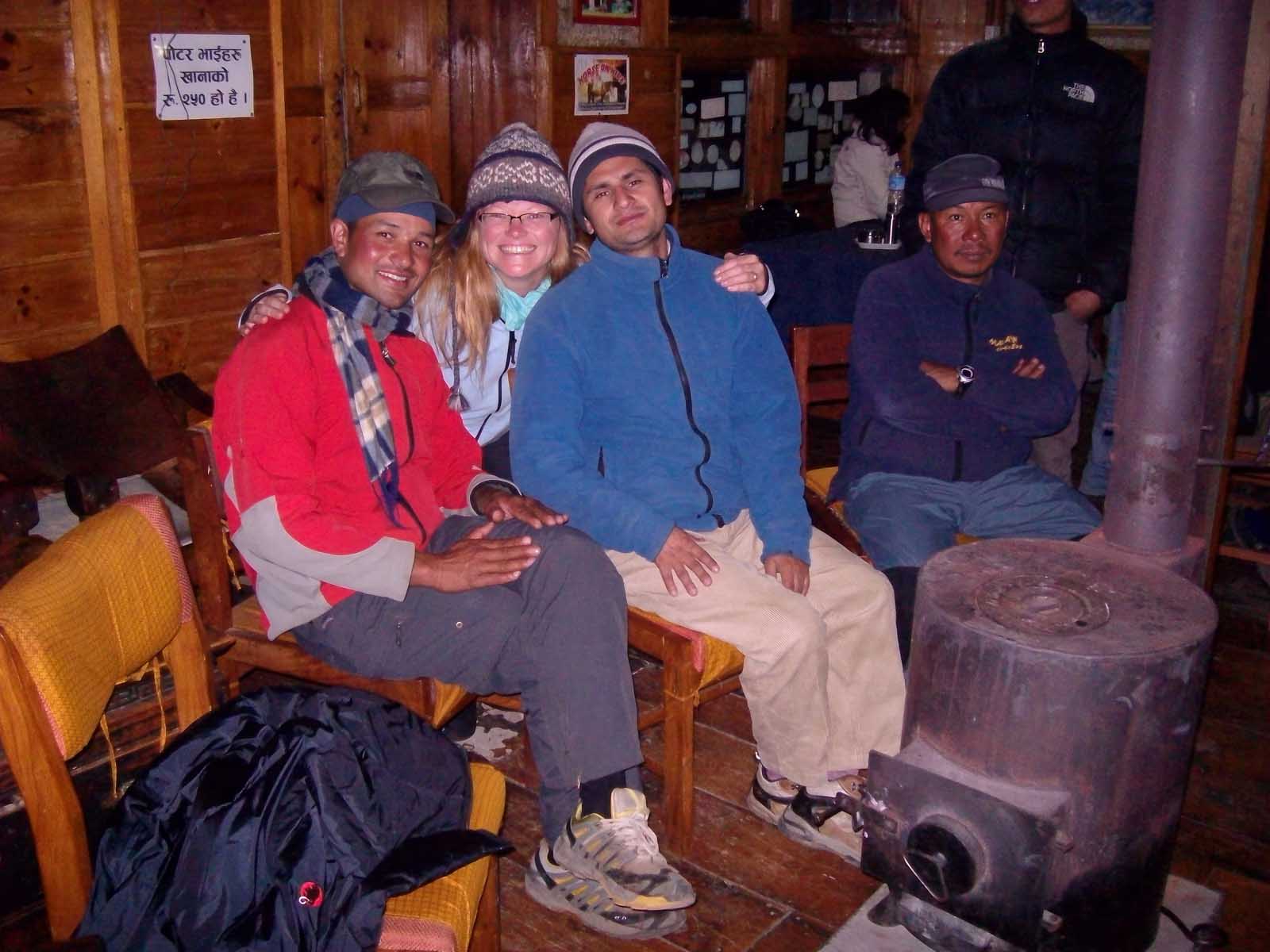
During the EBC Trek, you don’t stay in tents. You stay in charming teahouses with cozy beds, wood-burning stoves, and fully stocked restaurants that serve dinner.
The teahouses are a welcoming sight after a long day of trekking helping to make the trek to Everest one of the most memorable experiences of our lives. If you are planning to trek to Everest Base Camp in Nepal, read on for all the information you’ll need to help you prepare.
The main lodges of each teahouse we stayed in during the first half of our EBC trek were cozy and warm. At the lower elevations, woodstoves burned wood in the dining room and common areas and our rooms were a comfortable temperature with heating as we were wrapped up in our sleeping bags. We ate hearty meals of pasta and meat and enjoyed a relaxing night soaking in the amazing day we just had on the mountain.
- From Lukla – Elevation 2869 meters (9,350 feet)
- To Pakding – Elevation 2610 meters ( 8563 Feet)
- Length – 7.7 km (4.78 miles)
- Elevation loss – 79 meters (259 feet)
- Duration – 3 Hours
Day 2 – Pakding to Namche Bazaar
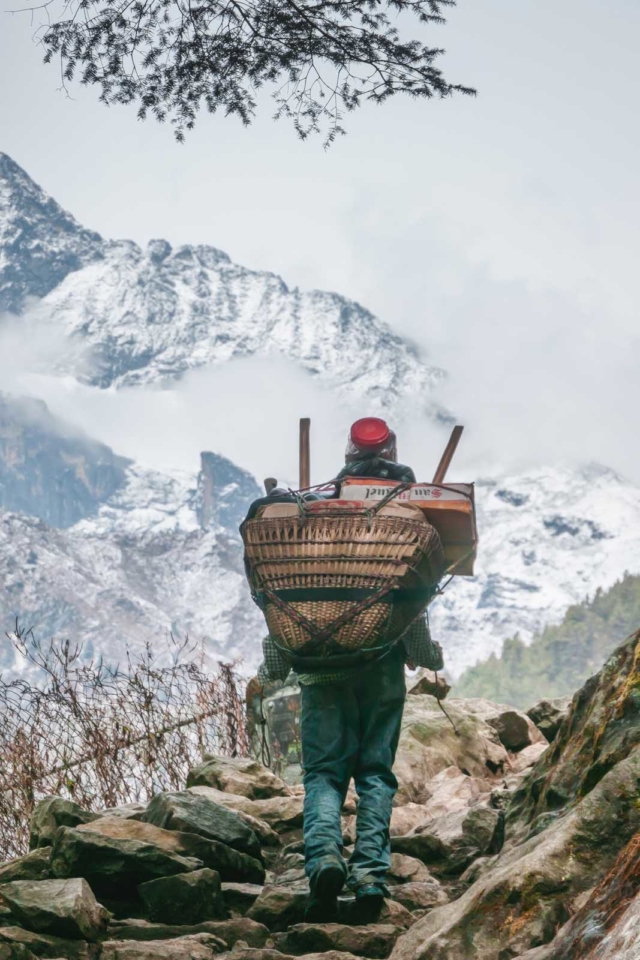
On day two, we checked in at another gate of the Mt. Everest park headquarters to show our documentation. We had to show our passports and give them extra passport photos to go into the log. (So make sure you have extra passport photos with you) Once we signed in, we were officially in the Khumbu region and officially on our way trekking to Everest Base Camp.
We covered a lot of terrain on day two making it the longest day of the Everest Base Camp trek. The trail up the mountains was steep and challenging but it was a memorable day.
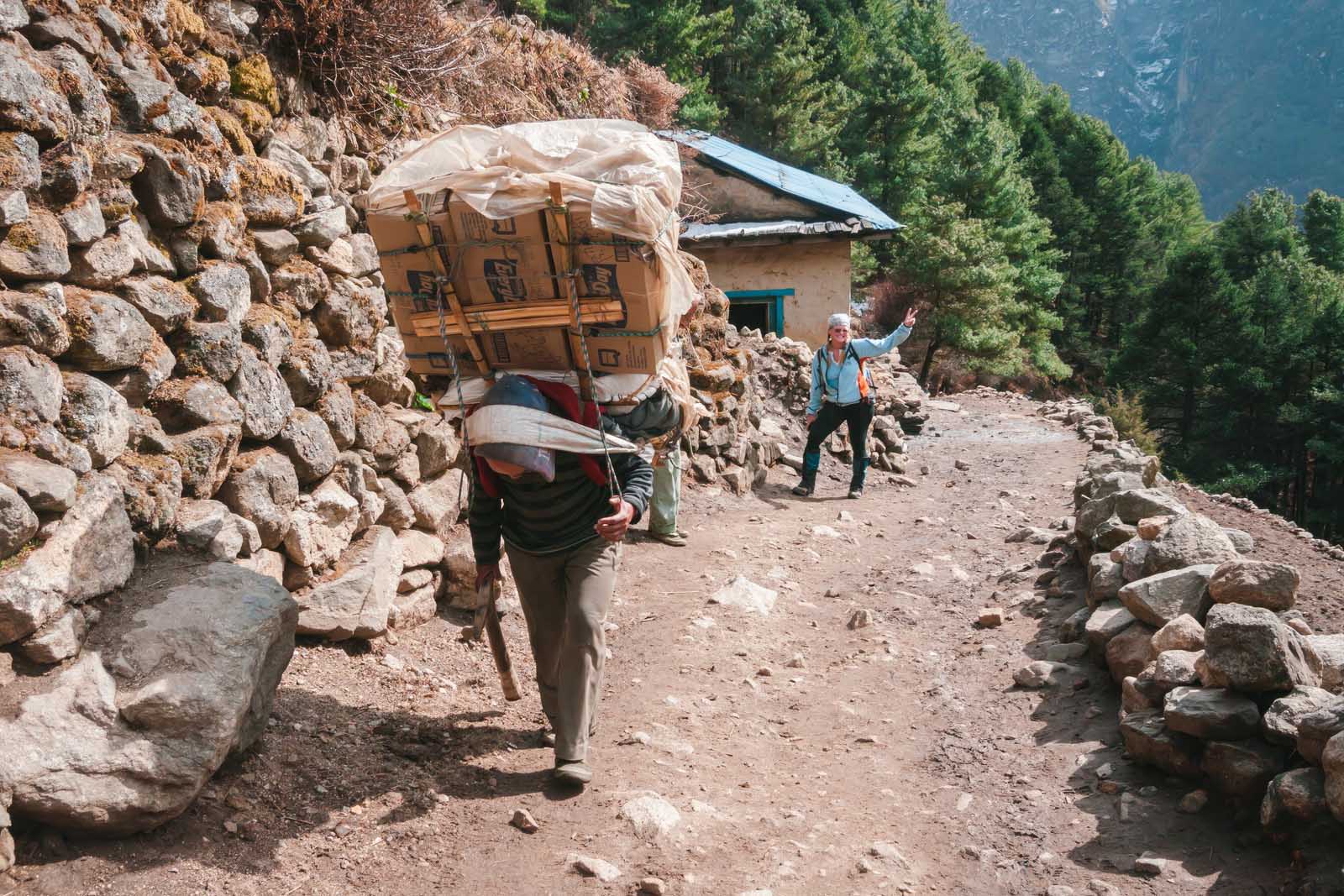
Day two of the EBC trek was a hike of almost 10km (6.2 miles) with an elevation gain of 800 meters (2624 feet). But throughout the hike, there was a lot of elevation loss mixed in so it felt like a lot more.
We would lose elevation as we descended into the valley only to have to climb back up again to a higher elevation. Today was a lot of fun though because we crossed several suspension bridges over Dudh Kosi River Valley.
Suspension Bridges on the way to Everest
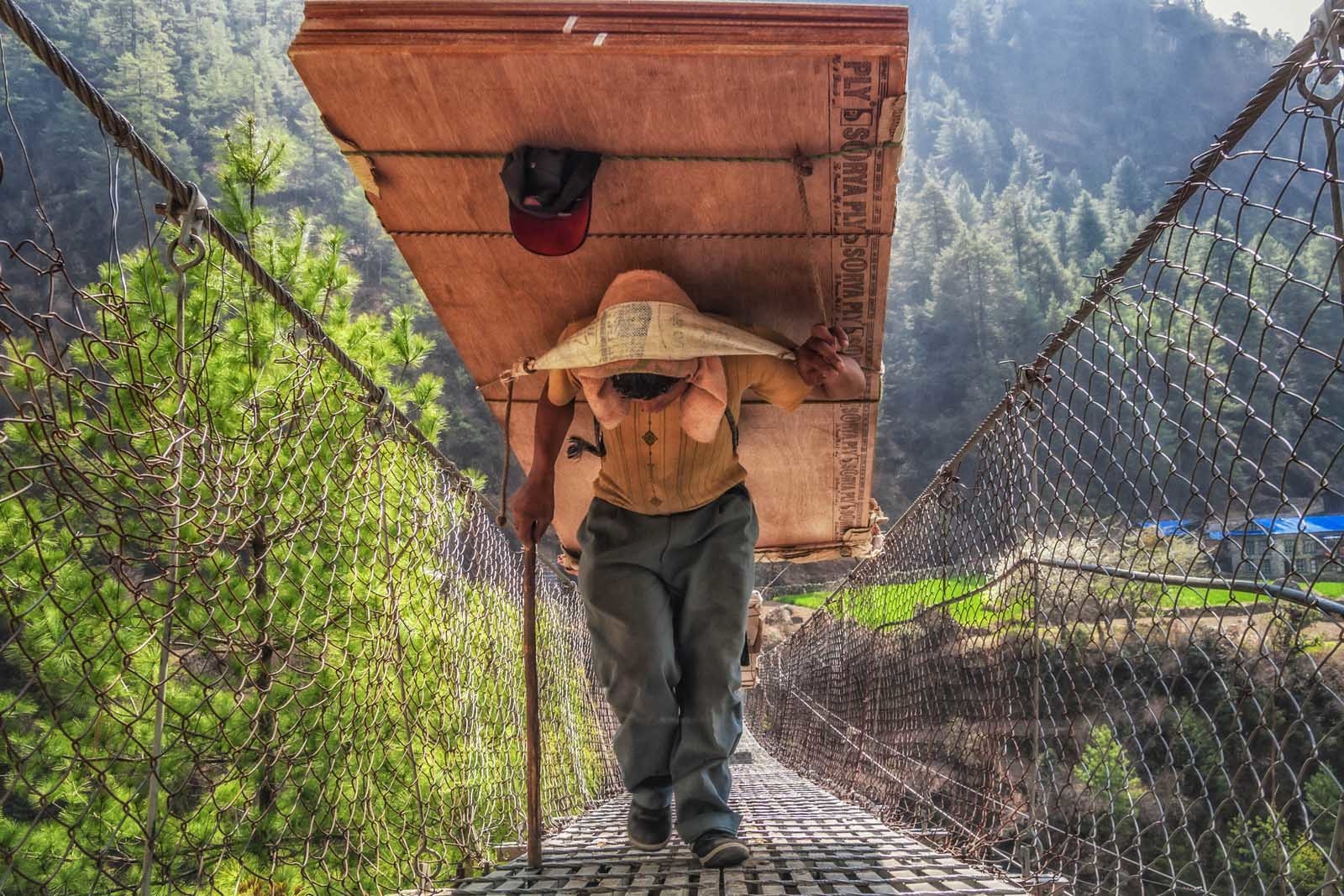
If you have a fear of heights, crossing suspension bridges may not be your favorite moment, but the suspension bridges while trekking to Everest Base Camp are well constructed, made of steel, and in excellent condition.
I was nervous about the suspension bridges. The Lonely Planet Guide said, “ Grit your teeth and climb onto a drooping suspension bridge floating at a dizzying height .” That sentence freaked me out.
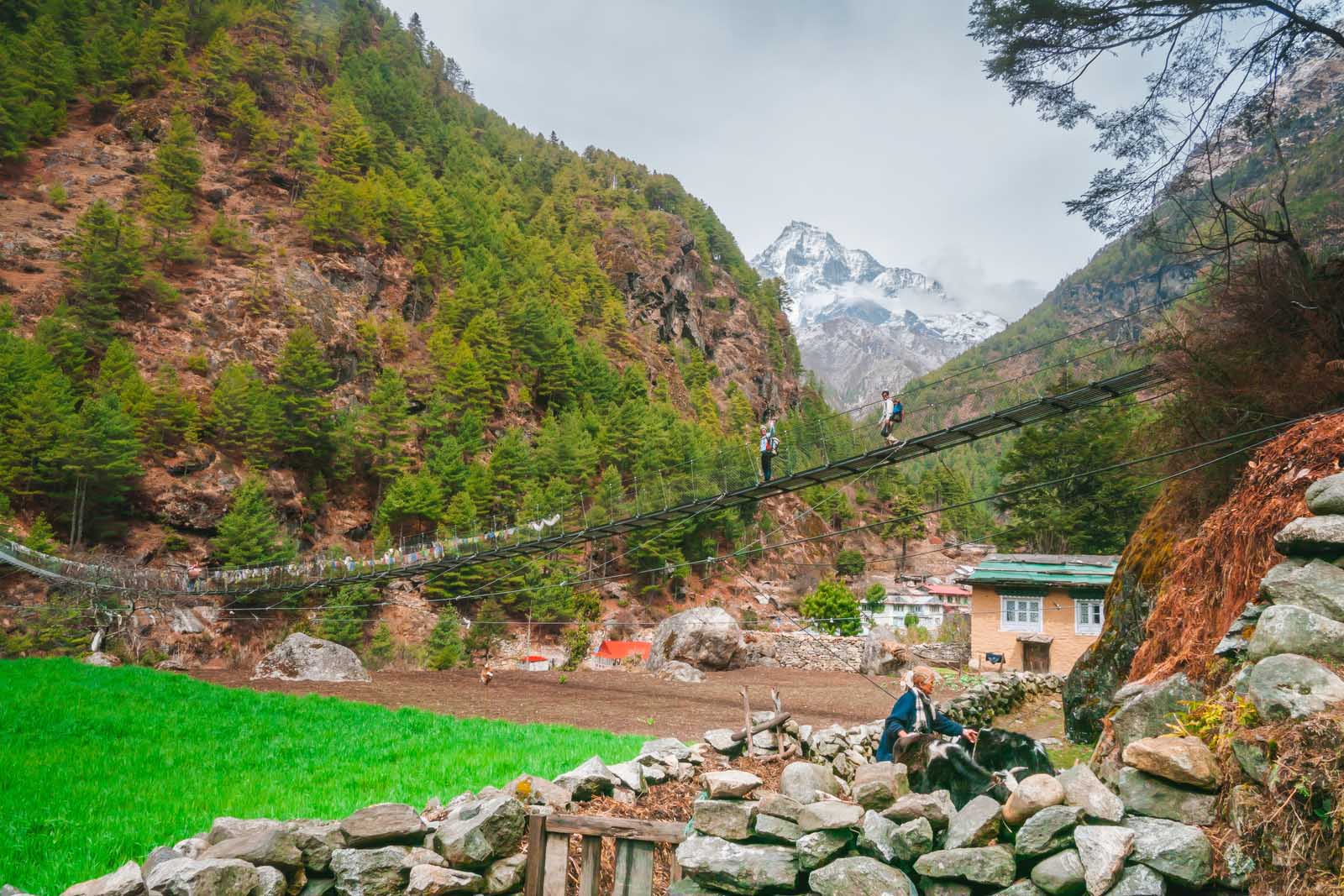
I had built the suspension bridges of the EBC trek in my head as something monstrous. But by the time we reached the first bridge, I wondered what all the fuss was about. Once I crossed my first bridge, my confidence was up and I was ready for anything the Everest trek was ready to throw at me.
Donkey Trains
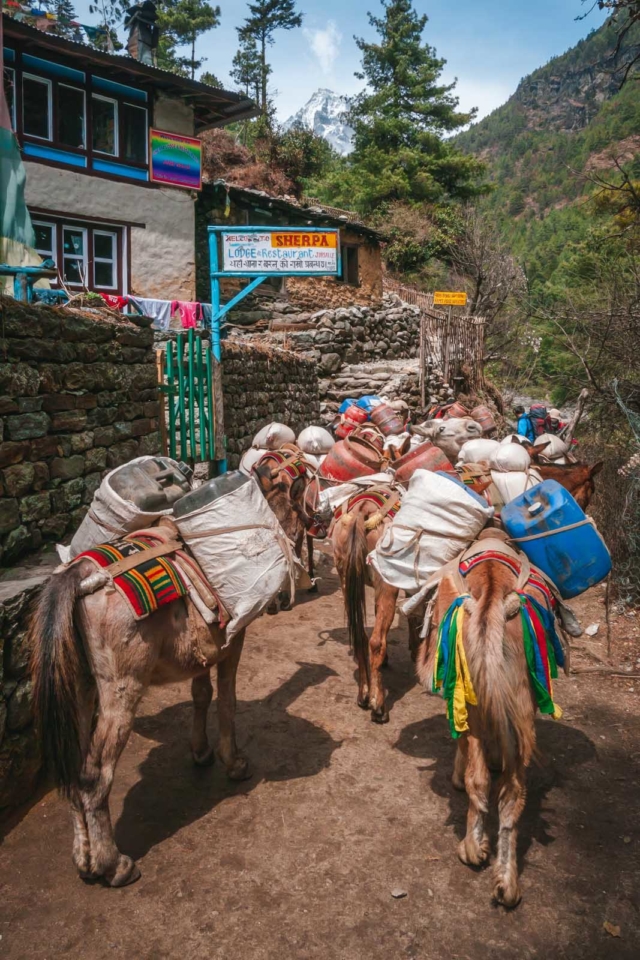
Today we also started to see a lot of donkeys, cows, and goats taking supplies to the villages. Traffic can get very heavy on the Everest Base Camp hike. When animal trains go by, make sure to get out of their way and stay to the side.
They are loaded down with heavy gear and they have a mission to keep on walking until they are done. They can easily nudge you right off the side of a cliff as no matter what is in their way, they just keep walking.
The trail is a highway, but instead of transport trucks or trains carrying cargo, people and farm animals carry everything from lumber and building supplies to food and kitchen appliances.
Safety Tips on the Everest Base Camp Trek for yaks and donkeys
- Important Tip: When a yak, donkey, or cow train passes you during the EBC trek, be sure to stand on the mountainside of the trail so they can’t push you over the edge !
- It is better to be squished into a mountainside than to go tumbling over the edge!
Final Stretch to Namche Bazaar
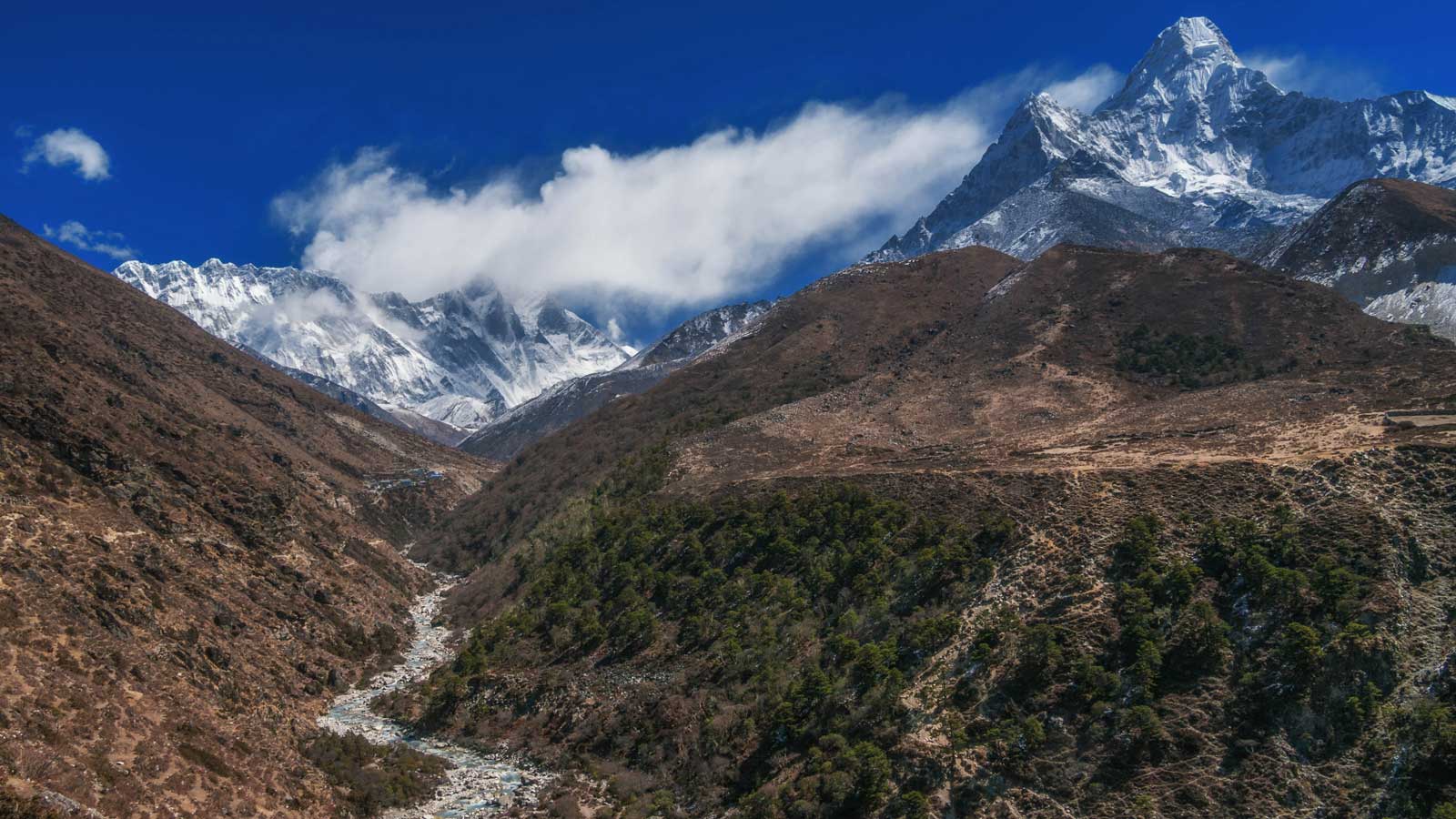
Right after crossing the last bridge, the hardest part of day two of trekking to Everest base camp started The last push of the day consisted of 2-hours straight uphill to Namche Bazar.
We were drenched with sweat but the air was cool. Whenever we stopped for a break, we would get a chill so we just kept on chugging away.
Large tour groups passed us quickly, only to be caught a few minutes later as they rested. We realize that we were the tortoise and they were the hare! Slow and steady is the way to climb at high altitudes and in the end, we made it to Namche Bazaar with plenty of time to spare in the day.
Arrival to Namche Bazaar
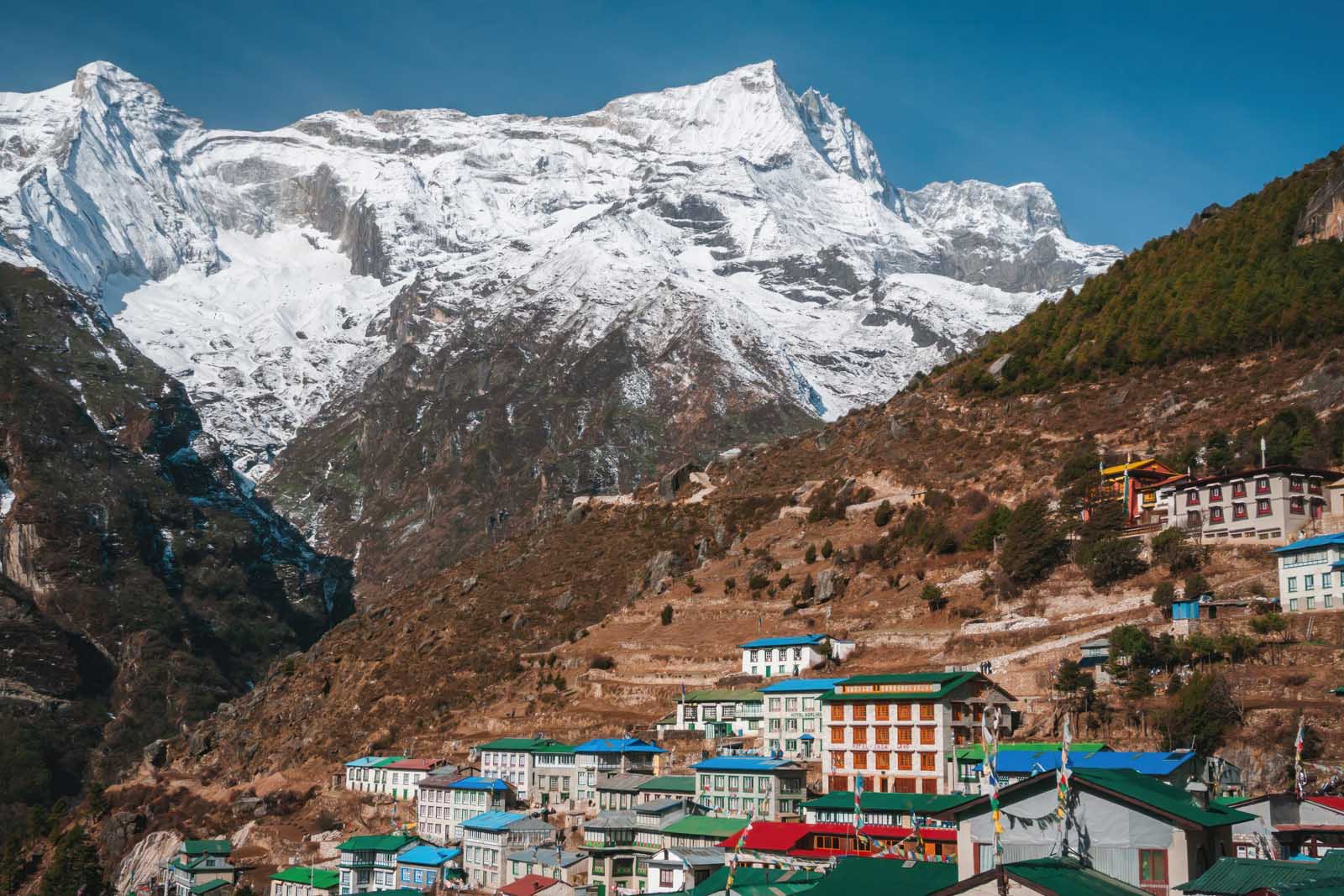
We checked into the security post and cringed when we found out that our lodge was an uphill walk for another 20 minutes. Rest had to wait a bit longer.
When we arrived at our accommodation, we were thrilled to see our porter Sher’s smiling face. He had already checked us in and put our bag in our room. We immediately went for a nap and then did a little walking around town in the evening to do some shopping and grab a bite to eat before turning in for an early night.
There are plenty of shops and restaurants at Namche Bazaar, this town is bustling and we spent two nights of our EBC Trek here which was awesome.
Pakding – Elevation 2610 meters ( 8563 Feet) Namche Bazaar – 3440 meters (11,286 feet) Elevation Gain – 830 meters (2723 feet) Distance – 10km (6.2 Miles) Duration – 6 hours
Day 3 – Acclimatization Day at Namche Bazaar
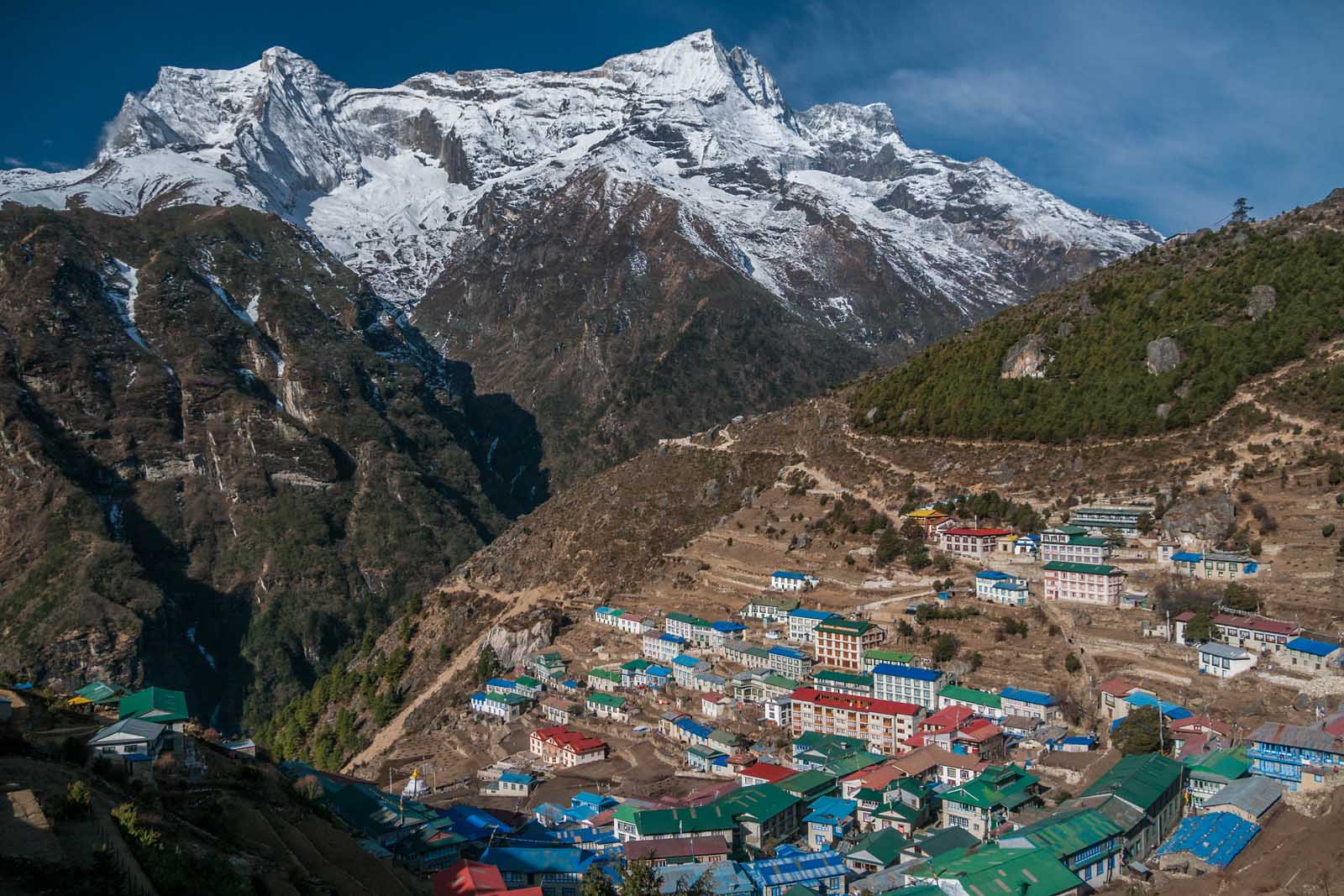
We had two glorious days at Namche Bazaar. Dipendra chose great accommodation for us throughout our EBC trek and we had a good rest in this splendid teahouse where we enjoyed delicious pasta, meats, and of course dhal baht. We spent the morning enjoying coffee and doing a bit of shopping.
What to do in Namche Bazaar
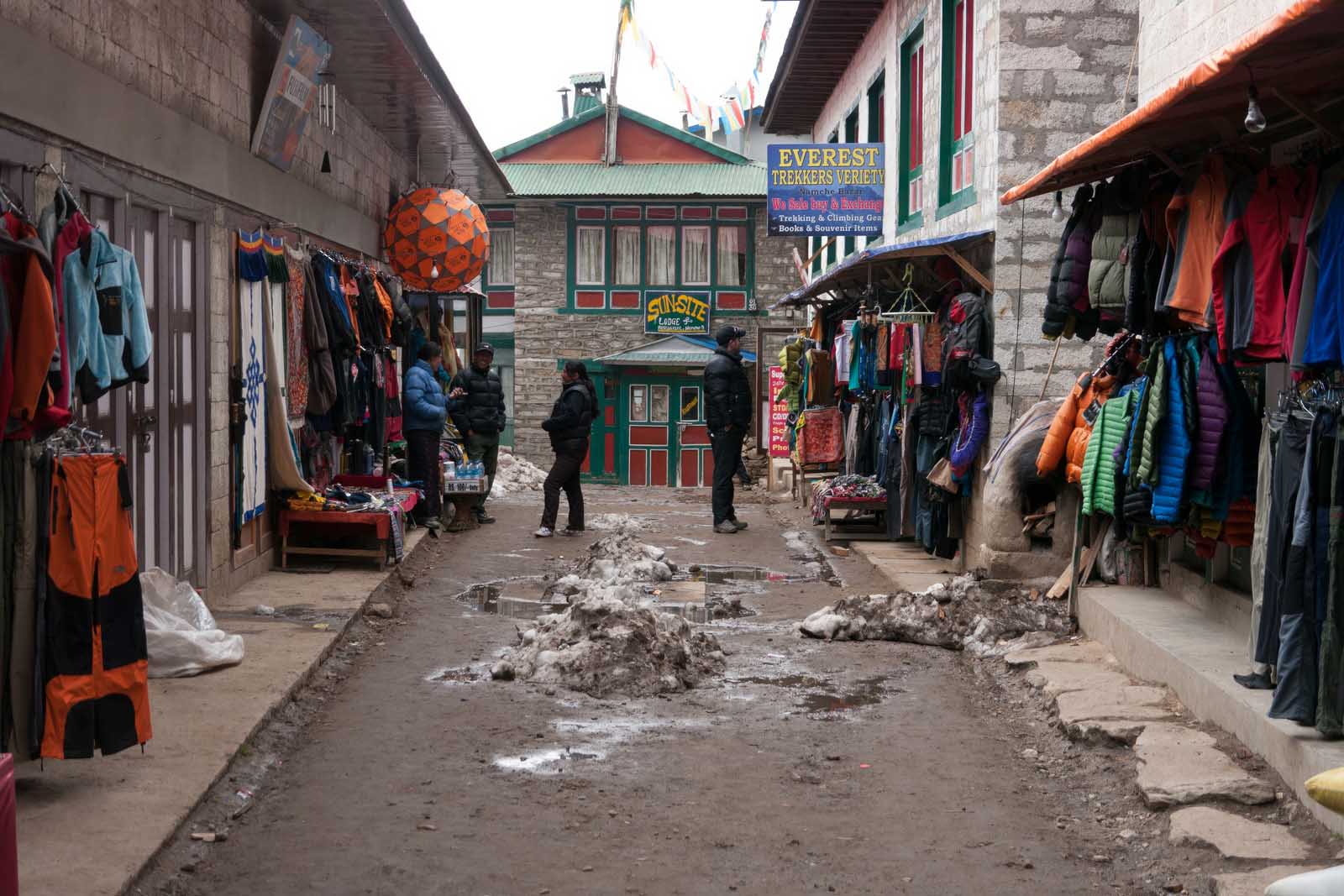
We explored Namche Bazaar and checked out its many shops. The streets are packed with shopping stalls and markets. We searched for gear that we missed getting in Kathmandu and got some great deals. We were surprised the prices weren’t inflated at Namche Bazaar.
We bought some down booties to keep our feet warm at night, a couple of sherpa hats, and a warmer set of gloves. The Everest Bakery was a highlight with delicious apple pie, fresh coffee, and WiFi. We had two pieces each!

But we took it very easy, making sure to stay hydrated and to eat enough food to stave off altitude sickness. Namche Bazaar is located at a high altitude of 3440 meters (11,286 feet). We already saw a woman suffering from altitude sickness. She was having her blood pressure taken and heart rate monitored and when she got up, she was staggering as she leaned on her guide.
Her Everest base camp trek had already come to an abrupt end. It reminded us to relax because the days ahead were going to be tough. So we went back to our teahouse to relax and prepare for the rest of our journey
The Acclimatization Hike for EBC Trek
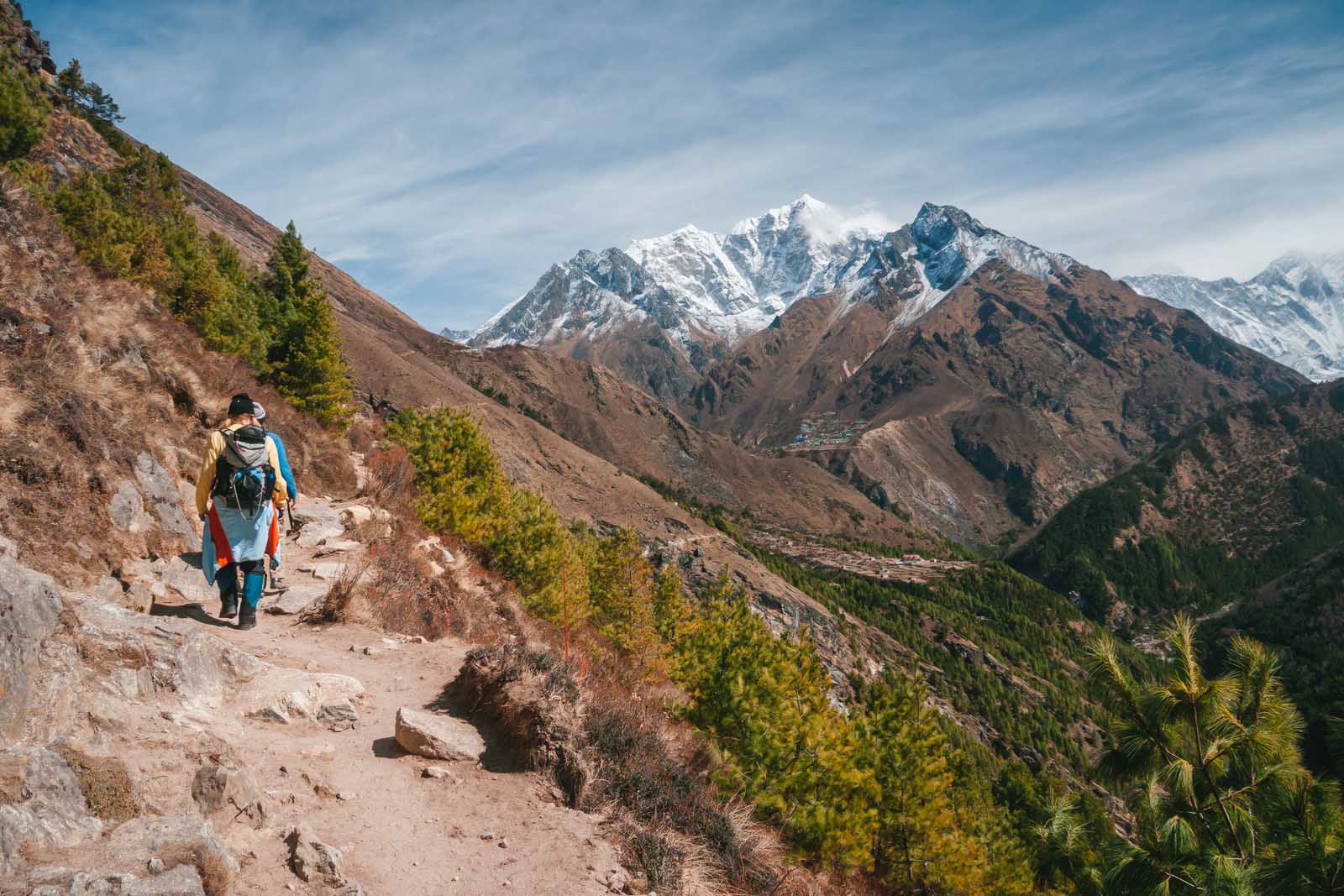
Most high-altitude treks have at least one acclimation day . The Everest Base Camp trek is no exception. An acclimatization day consists of hiking to a higher altitude and then coming back down to sleep at a lower elevation. It gives your body a chance to adjust to the altitude but you don’t stay for long.
As you will be constantly gaining altitude on the Everest Trek, it is good to have at least one day to climb higher and sleep lower to help prevent altitude sickness.
Our acclimation hike took us to the Everest View Hotel. With an elevation gain of only 400 meters, it wasn’t too much higher than our hotel in Namche Bazaar, but it is enough to help acclimate to the high altitudes. Everest View Hotel offers amazing views of Mount Everest (hence the name). Plus it holds the Guinness book of world records as the highest hotel in the world.
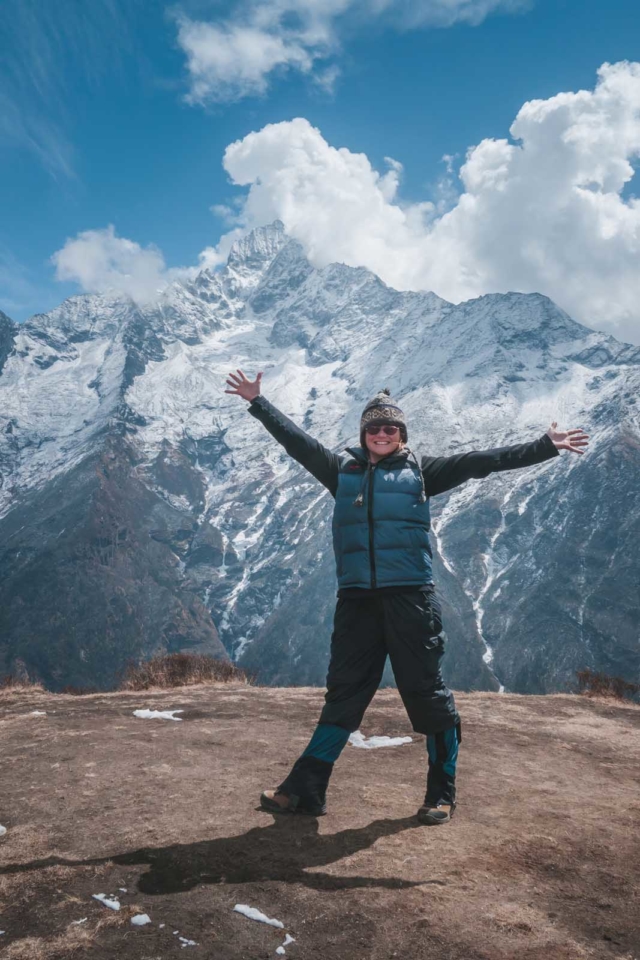
It is not an easy day off though. Just walking through town takes your breath away. As we made our way up the steps, I wondered if I should have just stayed in bed and skipped the viewpoint to relax. When we started the climb I was breathing heavily just walking up a few flights of steps. We hadn’t even left Namche Bazaar and I was pooped!
Once we got on the trail, things became easier. The steep grade gave way to a sloping trail and I started to feel better. After one and a half hours of climbing, we reached what has to be the world’s highest airstrip at 3700 meters (12,139 feet). We arrive just in time to see a small plane take off.
First Views of Mt. Everest
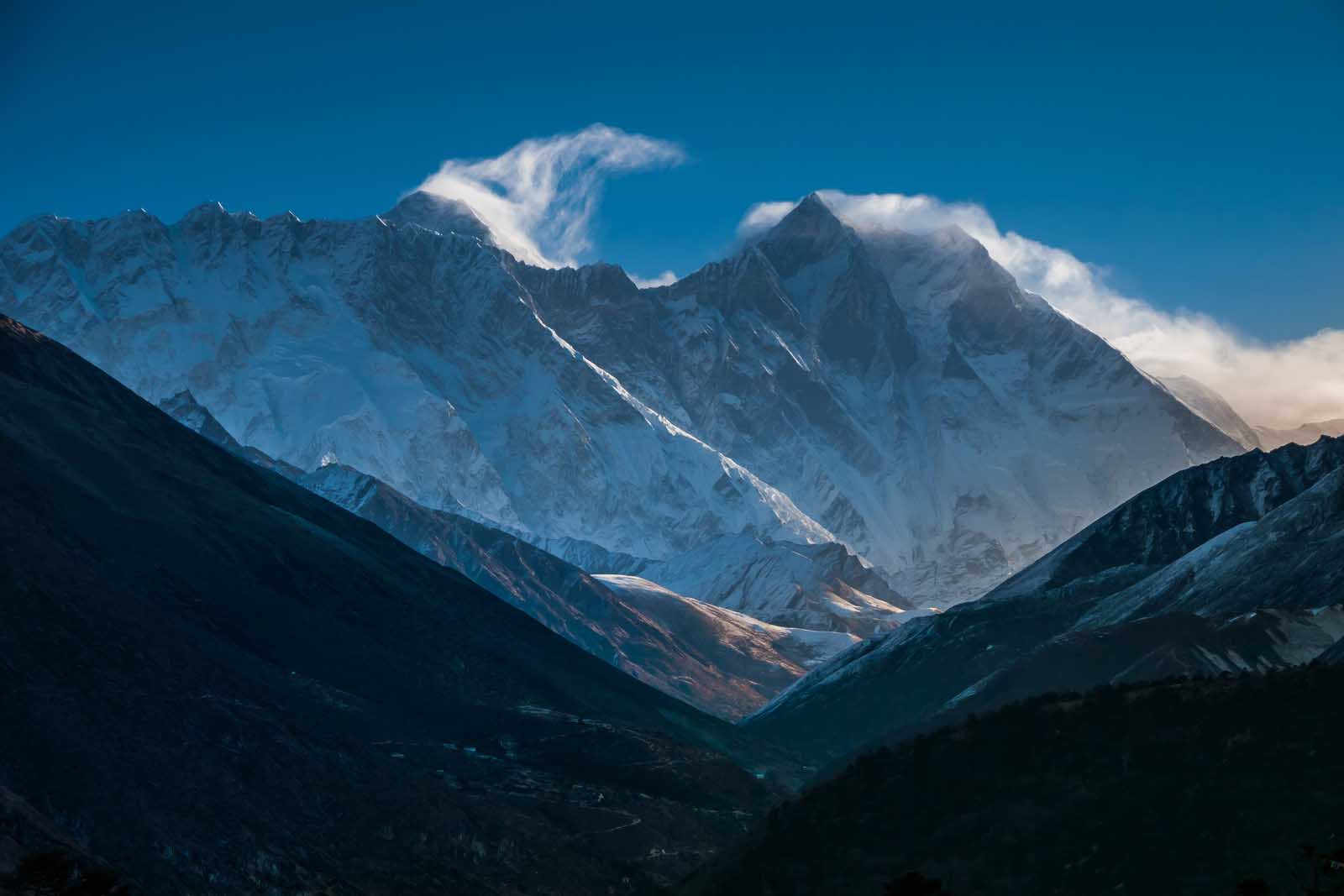
It was here that we got to see our first breathtaking views of Mt. Everest and the surrounding mountains. We hiked a bit farther and there it was, standing quietly behind the other highest peaks of the earth.
Lhotse, Changri, Ama Dablam, and Nuptse surround the mighty Mount Everest, the world’s highest peak. At 8414m (27,604 feet), 6027m (19,773 feet), and 7861m (25,790 feet) they are the little sisters of this sacred mountain. Mount Everest stands at 8848 meters (27,716 feet).
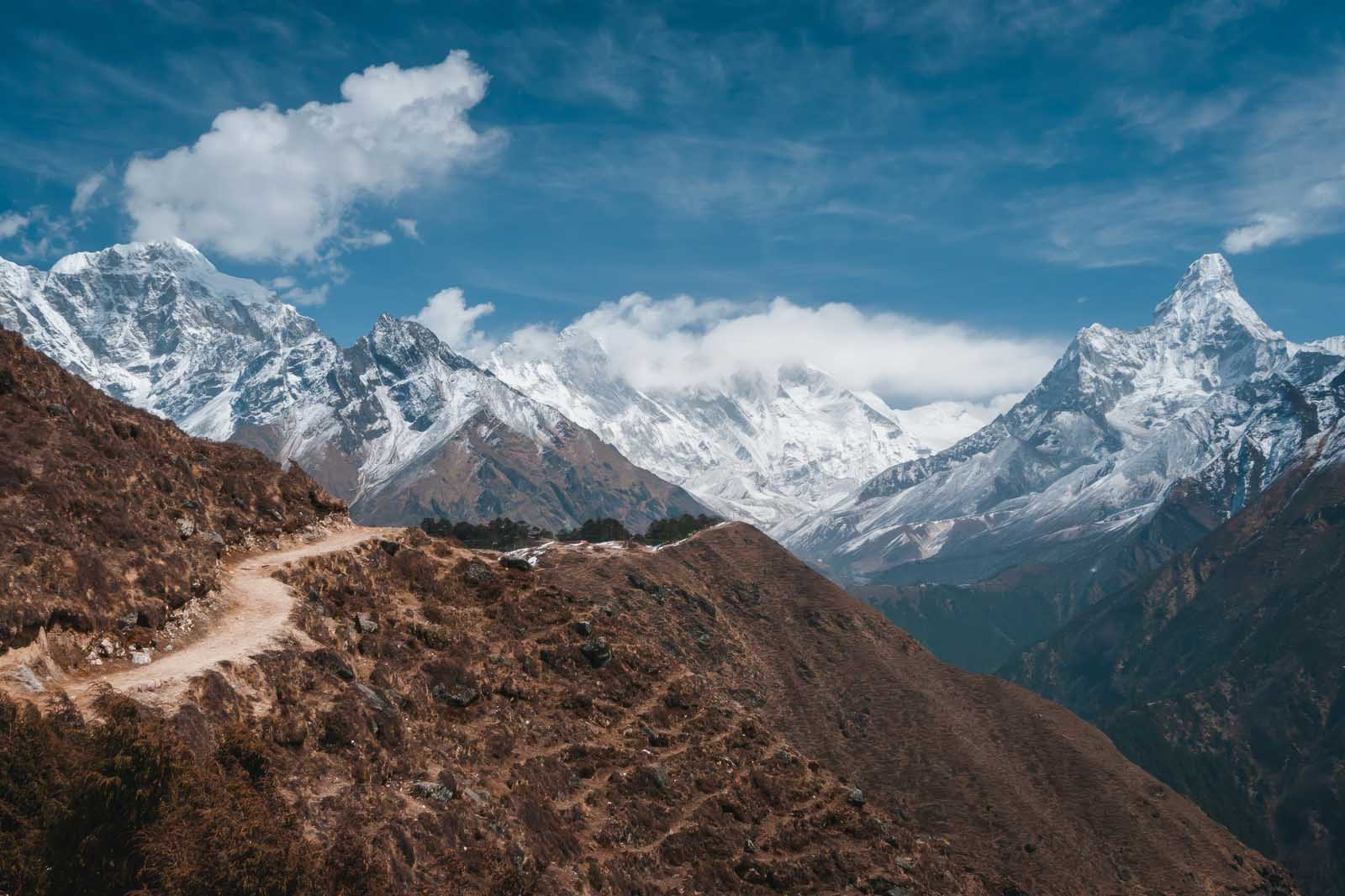
The deep Khumbu valley views were magnificent. The river wove far below, carving through the panorama of the white mountain tops. We walked a narrow trail snaking along the side of a steep mountain and suddenly realize “this trek has become real.” We were high in the Himalayas and one false move could mean catastrophe falling into the abyss below.
The sky was a deep blue and the white summits reached toward the billowing clouds. The view was so awe-inspiring it brought me to tears. Everything was so crisp and clear. During the EBC trek, you feel as if you could reach out and touch heaven.
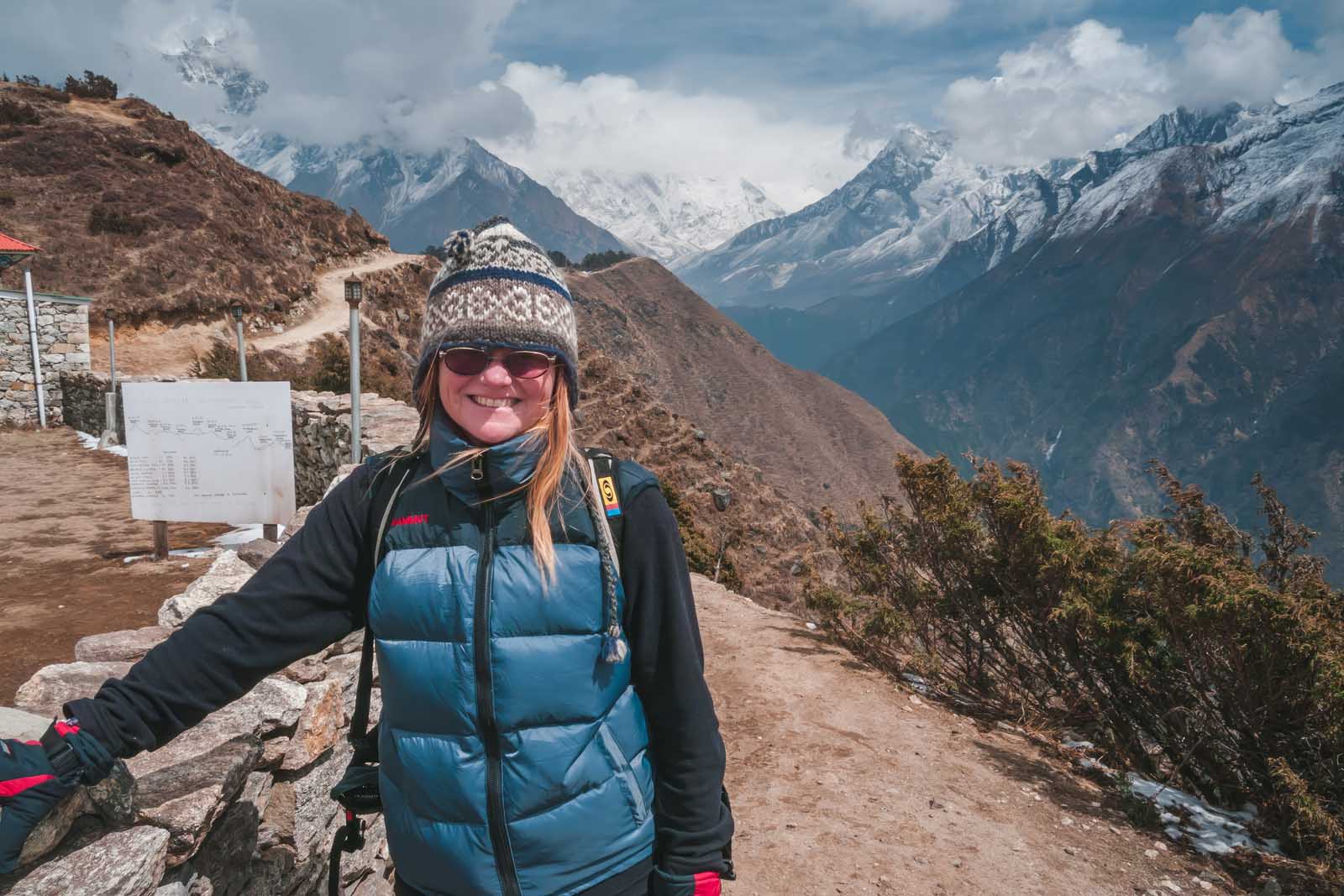
The clouds rolled in quickly so it was time to go. The weather conditions change quickly on the Everest base camp hike, so it is good to have the experience of a guide leading us through all terrain and conditions. We went back to Namche Bazaar to relax and gain strength for the rest of the trek.
Namche Bazaar – Elevation – 3440 meters. (11246 feet) Everest View Hotel – 3880 meters (12,730 ft.) Elevation – Bounce of 440 meters (1443 feet) Duration – 3 hours return Elevation Gain – 0 km
Day 4 – Namche Bazaar to Tengboche
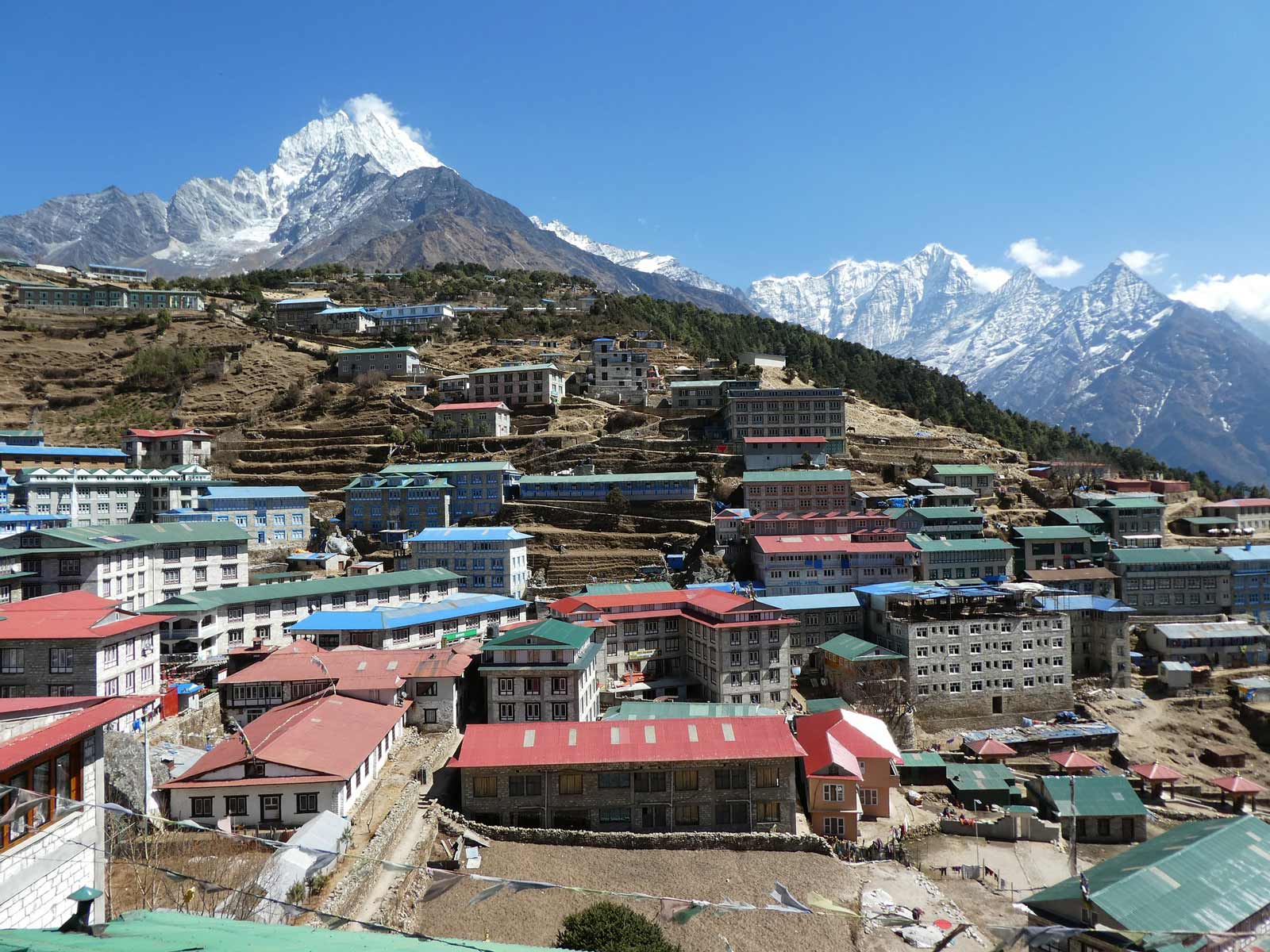
We awoke earlier than usual on Day 4. Two large group treks (Intrepid Travel and G Adventures) had checked into our lodge and we didn’t want to have to compete for service or breakfast. We also didn’t want to have to wait in line for the bathroom.
Lodges become more and more sparse as you go higher on the Everest Base Camp Trek and fewer toilets are shared between more people. Up until now, we hadn’t encountered crowds of people. It had been pretty quiet on the mountain and we liked it that way.
Luckily, we were a day ahead of the other tours. They had to stay in Namche Bazaar for another day to acclimate to the high altitudes, So we moved on to enjoy our EBC Trek free from crowds of people – for now.
Tenzing Norgay Memorial Stupa
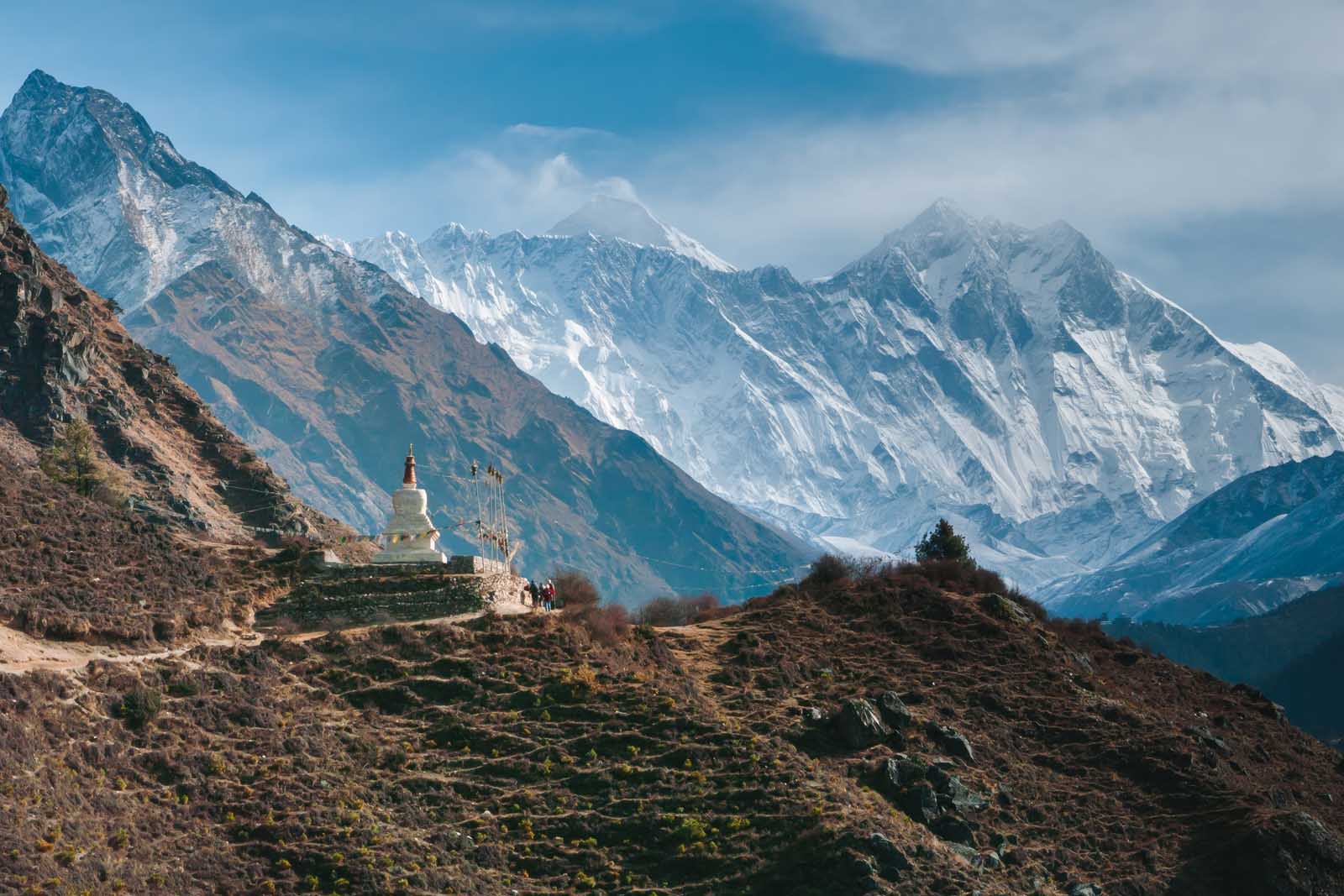
During day 4 of the EBC trek, we hiked along trails clinging to the side of the mountain. The narrow trekking trails along this route were a little scary. They wound along the edge of the cliff with nothing but a sheer drop to the abyss into the Khumbu Valley. But we kept our wits about us putting one foot ahead of the other until we reached the Sherpa Monument.
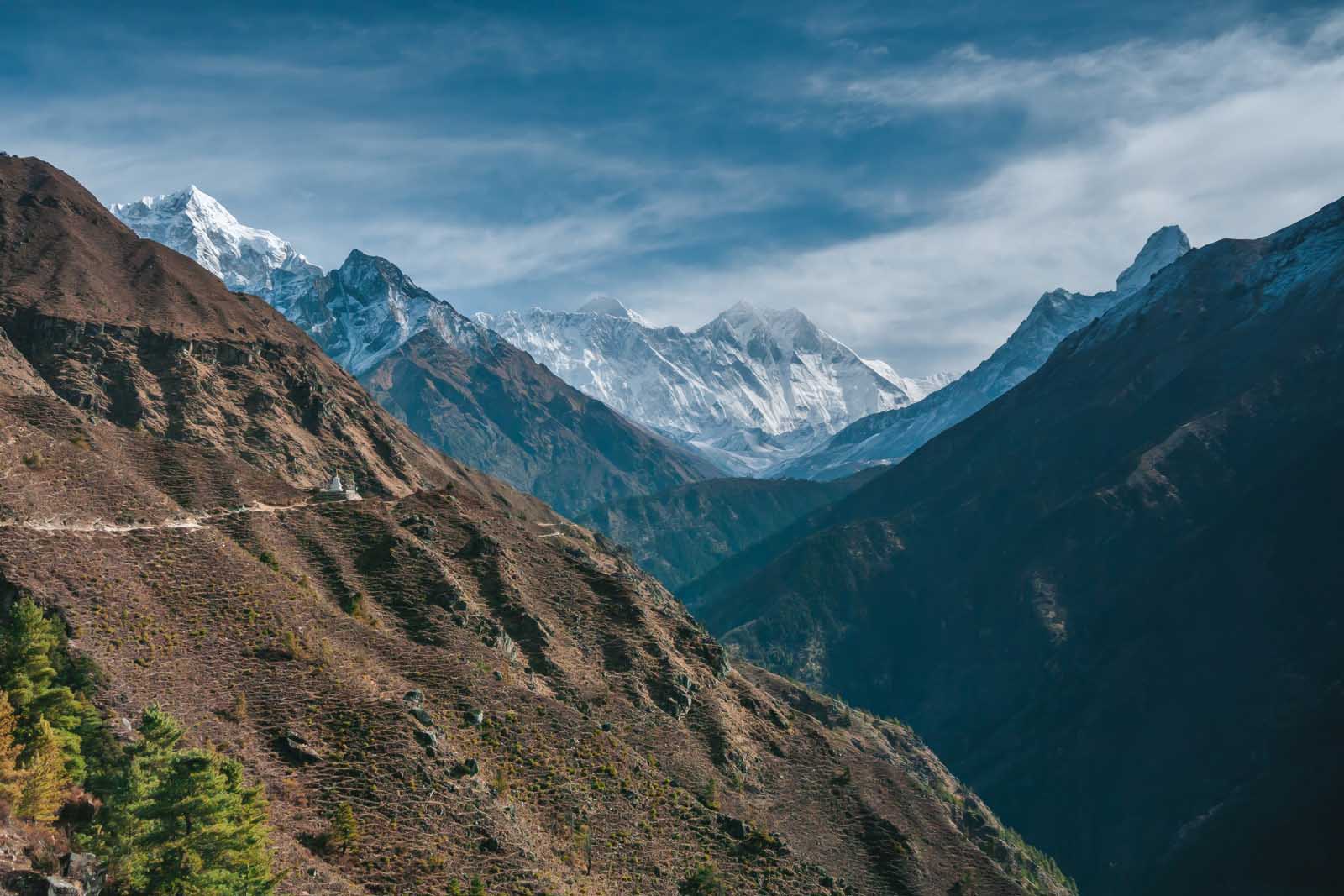
Tenzing Norgay Sherpa monument was erected by the Norgay family. It is a stupa honoring Tenzing Norgay Sherpa and all the Sherpas that risked their lives to help climbers reach the summit of Mt. Everest.
All treks pass this monument and it is an important stop on the journey to pay respect to the famous Sherpa of the Everest region. In case you don’t know, Tenzing Norgay Sherpa was the first man to summit Everest along with Sir Edmund Hillary.
What is a Sherpa?
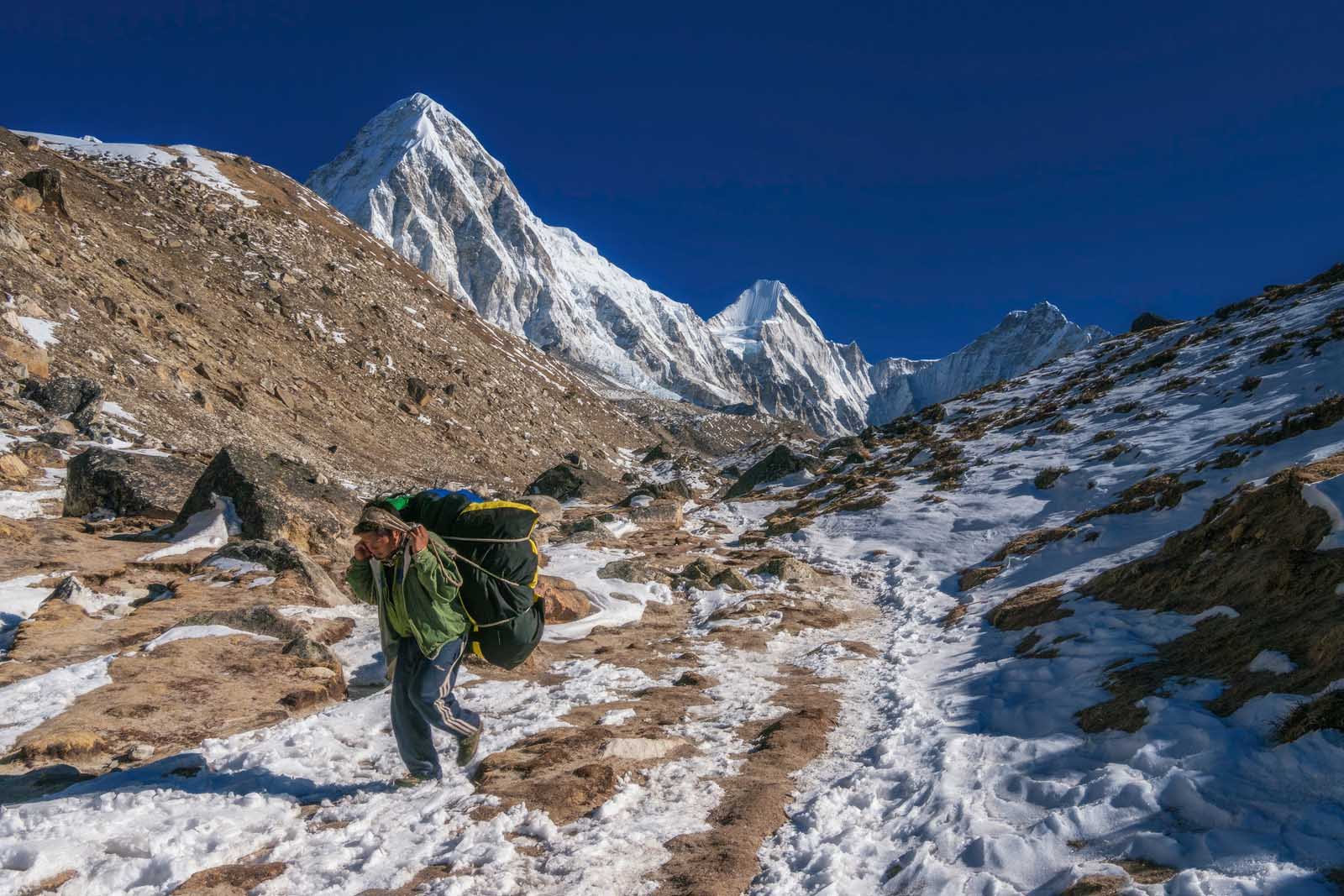
Sherpas are the unsung heroes of Mt. Everest. They do all of the hard work and technical work on the mountain. They carry the heavy loads, set the ladders and ropes to cross the Hillary Step and Khumbu Icefield for mountain climbers, and they take care of setting up camp while climbers and trekkers catch their breath and try to survive life on the world’s highest peak.
Difference Between a Sherpa and a Porter
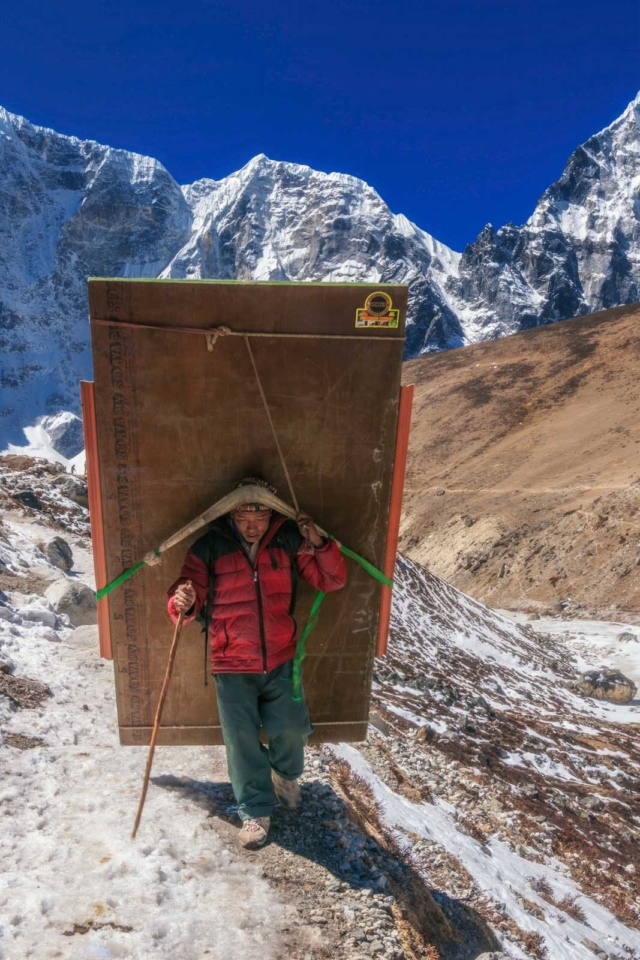
Sherpas and porters are very different from one another. We learned that a Sherpa is actually the name of an ethnic group from Tibet. The original mountaineers hired Sherpas as their guides in the Himalayas and the world has now adopted the name for porters in the Everest region. If you aren’t born into the Sherpa ethnic group, you cannot be called a Sherpa. Porters are porters and Sherpas are Sherpas.
We were told that some porters, especially commercial porters carry up to 60kg (150 pounds) of supplies and gear to businesses located along the EBC trek. That is a lot of weight and we were very surprised. When climbing Mount Kilimanjaro , porters had a mandatory weight limit of 35kg. (77 pounds).
Dipendra told us that they get paid per kilo so some people push it too far. The Nepalese are a strong bunch but this is a lot to carry at such a high altitude no matter what shape you are in.
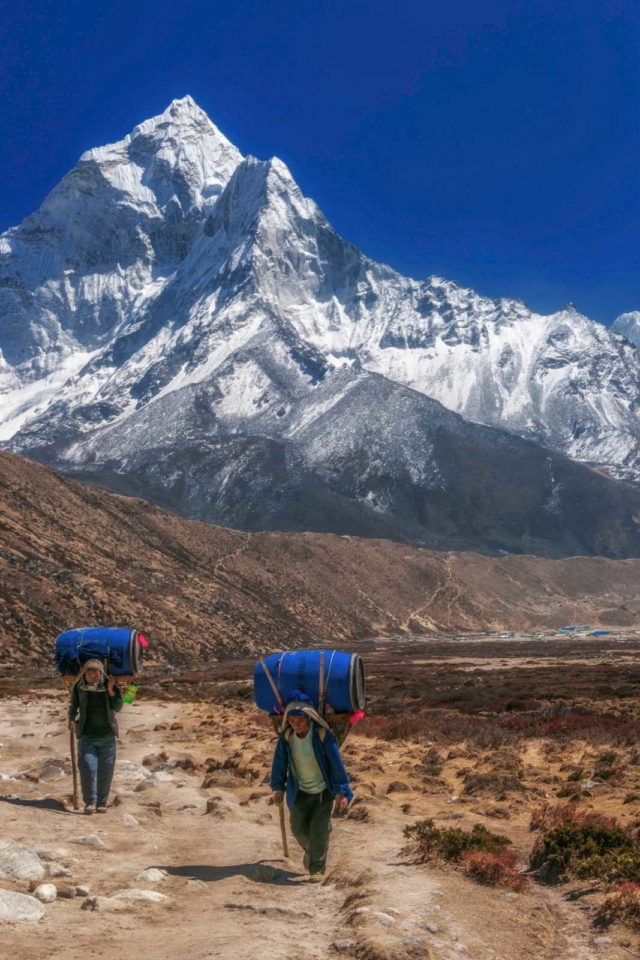
We kept our pack as light as possible at around 22kg (48 pounds) for Sher and we even felt bad about that! We have heard there is a 30kg (66lb) limit for Everest, but judging by what we saw other porters carrying on the Everest Base Camp hike, people were pushing it well beyond that.
We saw men carrying stacks of plywood with heavy white sacks loaded on top. We saw men carrying propane tanks, doors, and huge packs. What could people possibly need on the EBC Trek that they packed their packs so full? Read more: Packing List for Everest Base Camp Trek
Approaching Tengboche
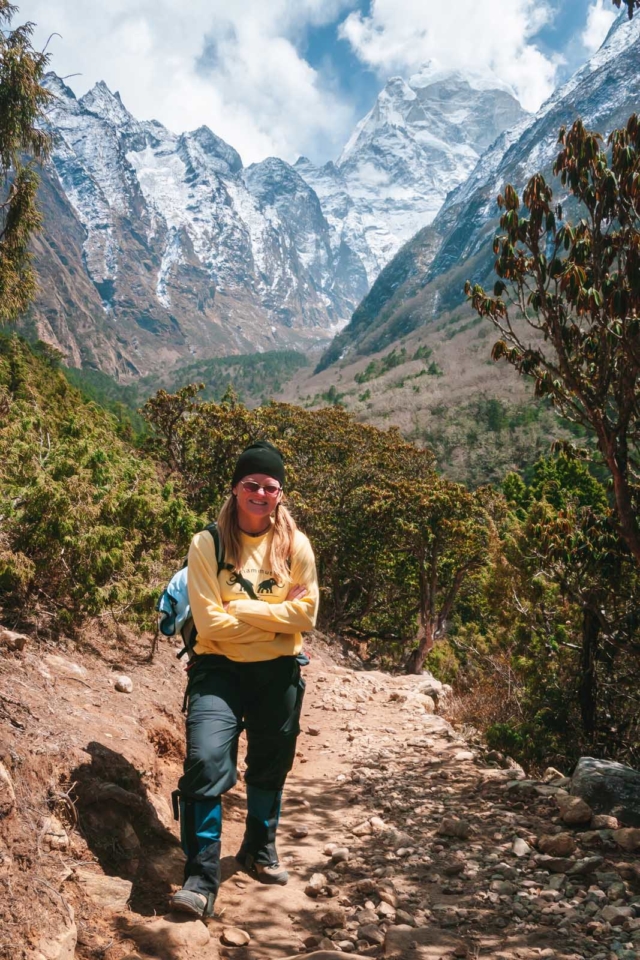
The final push of our EBC Trek day 4 was to Tengboche Monastery. It was a tough yet steady 2-hour steep climb. We are now gaining altitude climbing above the tree line. We put our heads down and huffed and puffed our way up. We didn’t stop for any photos or videos and were surprised to cut the climb down to just one and a half hours.
We reached the prayer wheels of Tengboche Monastery just in time for light snow to start falling. We made it into our camp at Tengboche by 1:30 pm and had the entire afternoon to ourselves at 3900 meters (12795 feet). This is an excellent place on the Everest Base Camp hike to have some extra time to relax as there are a few special things to see and do.
Tengboche Monastery
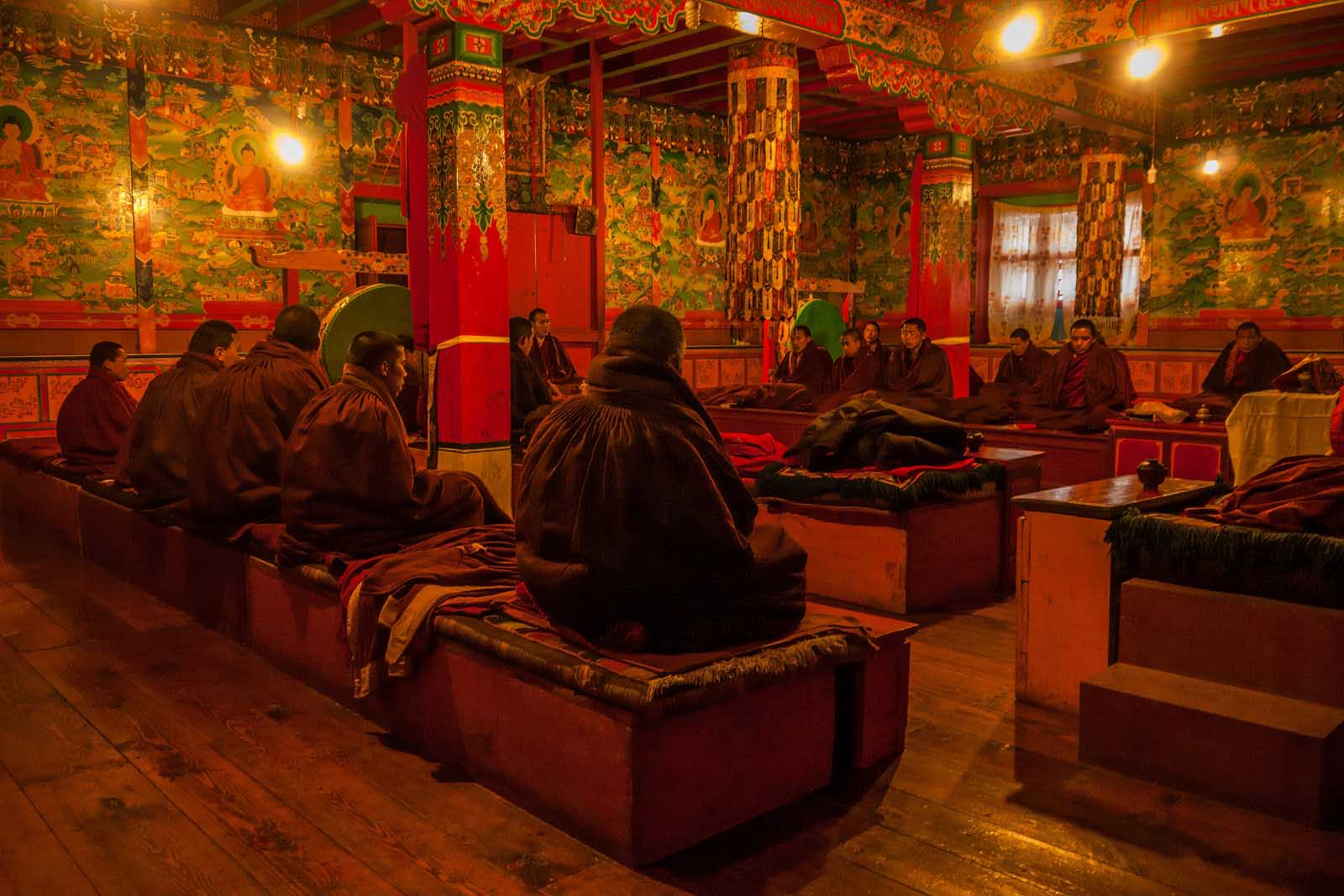
We warmed our feet with our new down booties that we bought at Namche Bazaar and changed into some dryer clothes before heading off to see the monks chant at Tengboche Monastery. Our guide Dipendra told us that this is the most important monastery in the region. All climbers summiting the mountains stop at this monastery to be blessed by the monks.
We were allowed to watch the ceremony and to take in the warmth and blessings from the monks. It is a sacred place and all climbers and trekkers stop here before continuing up the mountains.
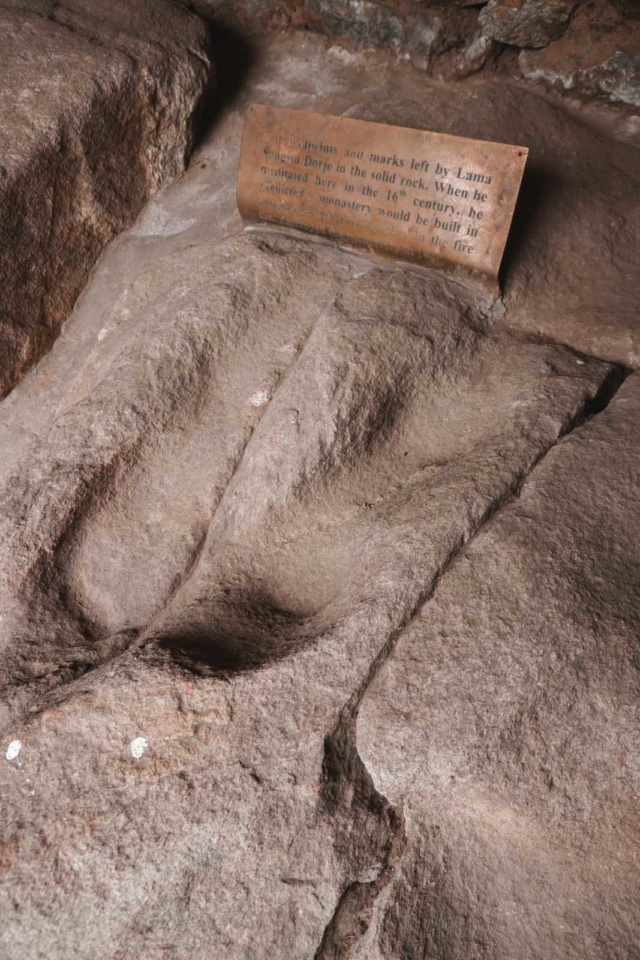
The footprints of Lama Pagna Dorje from the 16th century are embedded in solid stone in front of the monastery. A place where he mediated and raced through the Himalayas riding the wind with his mind.
Apparently, he sat on this stone for so long, his feet left their mark. He spent years traveling the world through the power of his mind and we believe the story. Especially after our yoga experience in Goa India. He predicted that a monastery would be built here and surprise surprise…here it is.
The View from Tengboche Monastery
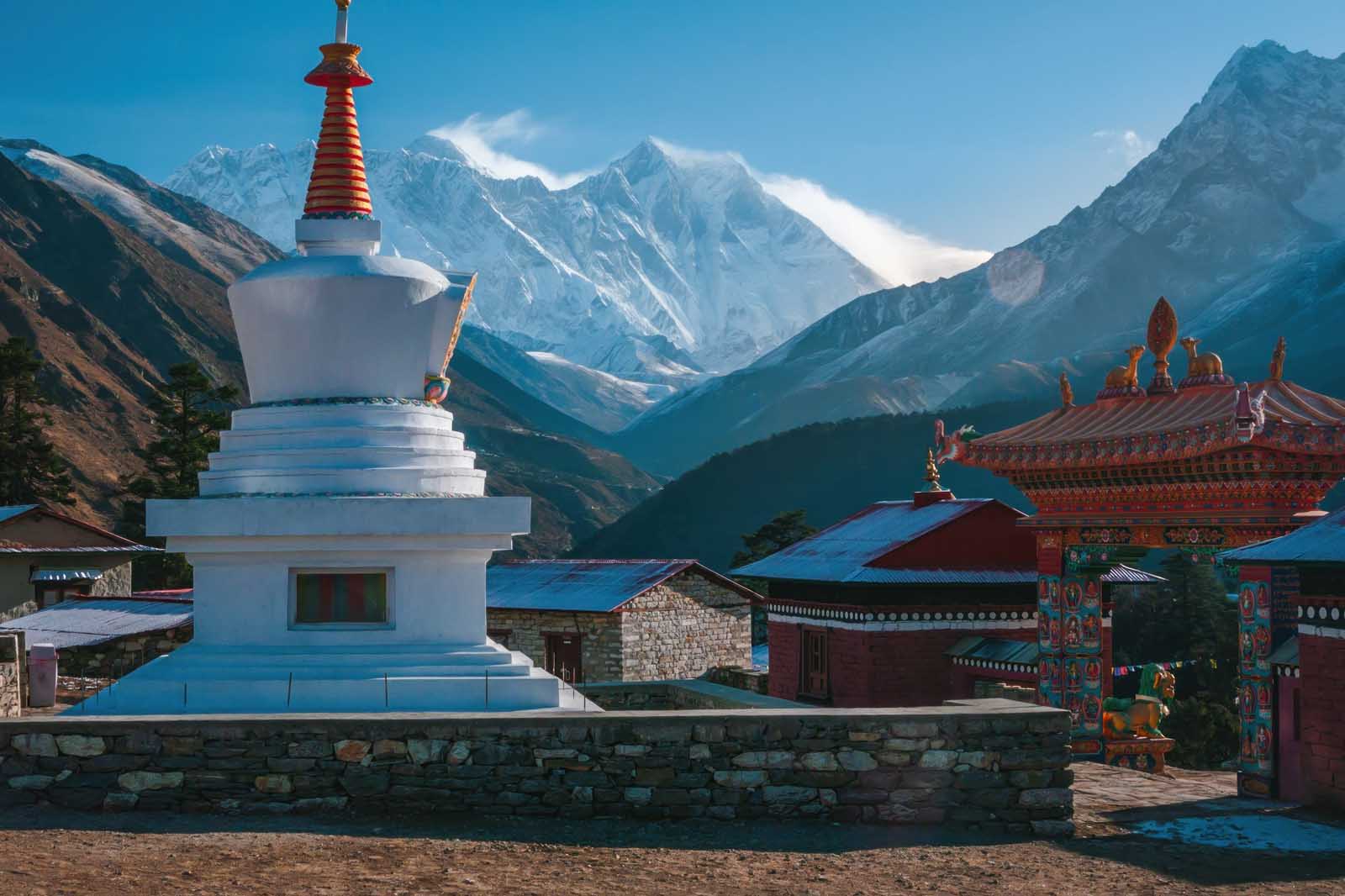
The view is magnificent from Tengboche Monastery. The valley is wide and opens up to massive rolling hills giving way to the highest peaks on earth. Plus it has a clear view of Mt. Everest and the surrounding mountains.
We were told that Sir Edmund Hillary came back to survey the peak of Mount Everest from this spot because the view is so clear of the mountain and we can understand why.
Accommodation – Basic Tea Houses at Higher Altitude
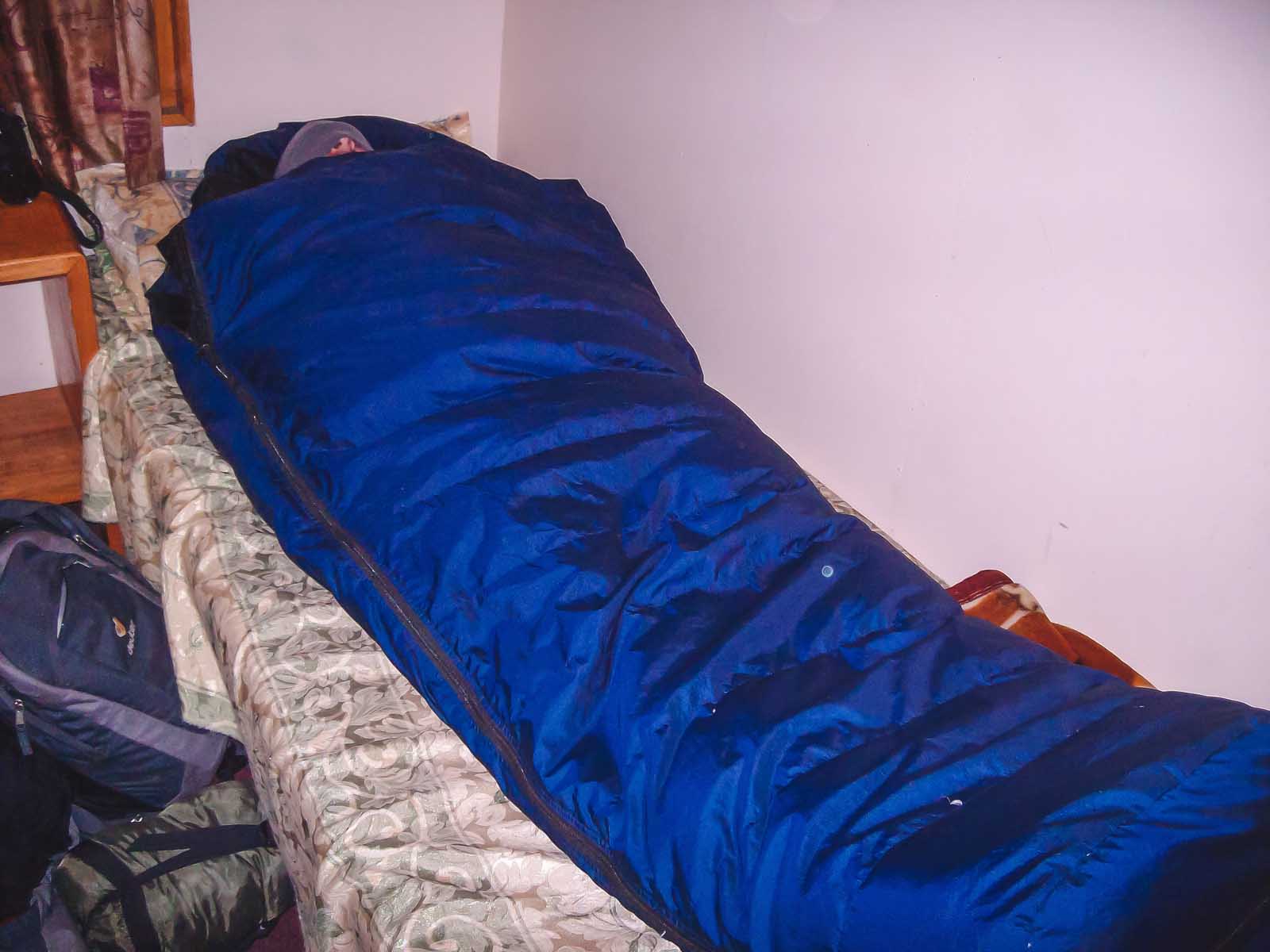
At this high elevation of the EBC trek, accommodation became very basic and rustic. We felt like true adventurers as we sat by the fire warming our feet and bonding with our fellow trekkers over our shared experience by candlelight.
There were 10 of us staying in this teahouse. All are sharing electricity to charge our camera batteries. Meals were now vegetarian and wood stoves were heated by yak dung. At this high altitude, meat cannot be transported fast enough to stay fresh and regular wood is scarce, so yak dung it is.
When we went to bed, our room was freezing. Rooms are not heated at higher elevations. We had our own room, but I sometimes wonder if sleeping in a dorm would have helped with more body heat. The temperature easily dipped down to -10 Celcius (14 degrees Fahrenheit) and our plywood walls didn’t offer a lot of comforts.
We tossed and turned all night long trying to keep our noses warm in our sleeping bags wearing our down jackets, thick socks, and thermal mid-layers.
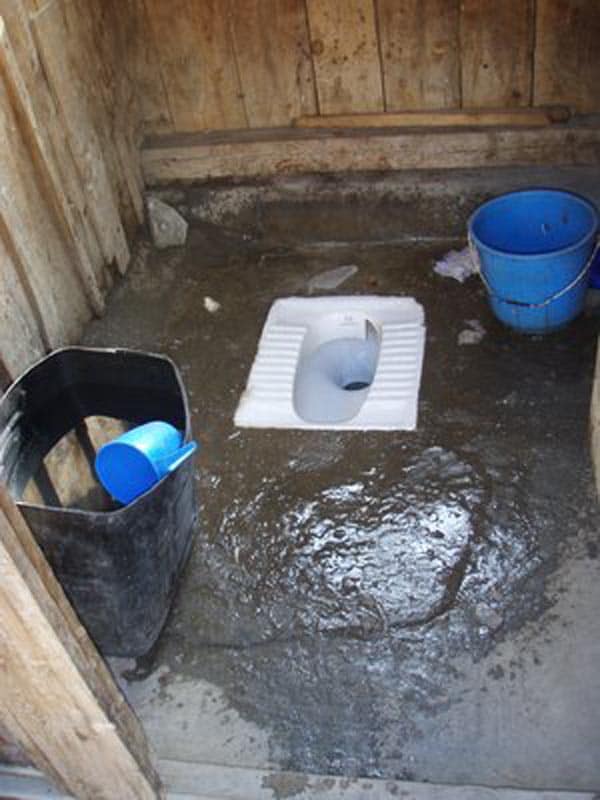
It was so cold the scoop bucket for the shared squat toilet froze over forming a patch of ice to form on the floor. It was a slippery trip to the outhouse. Sadly, we always have to pee a lot during the night when sleeping at high altitudes so we visited that toilet a lot.
Hot Tip: Pay for hots showers at lower elevations You won’t regret it! We realized that we should have paid the 250 Rupees for the hot showers offered at the accommodation in Namche Bazaar. Now that the weather was so cold there was no way we could face a bucket bath in a freezing shed. Dave and I set a new record in these mountains of Nepal, 9 days without a shower!
Namche Bazaar – Elevation – 3440 meters. (11246 feet) above sea level Tengboche – 3860 meters (12664 feet) Elevation Gain – 420 meters (1378 feet) Distance – 9.3 km (5.77 miles) Duration – 3 hours (without stopping) 5 hours for photos, lunch and rest.
Day 5 – Tengboche to Dingboche
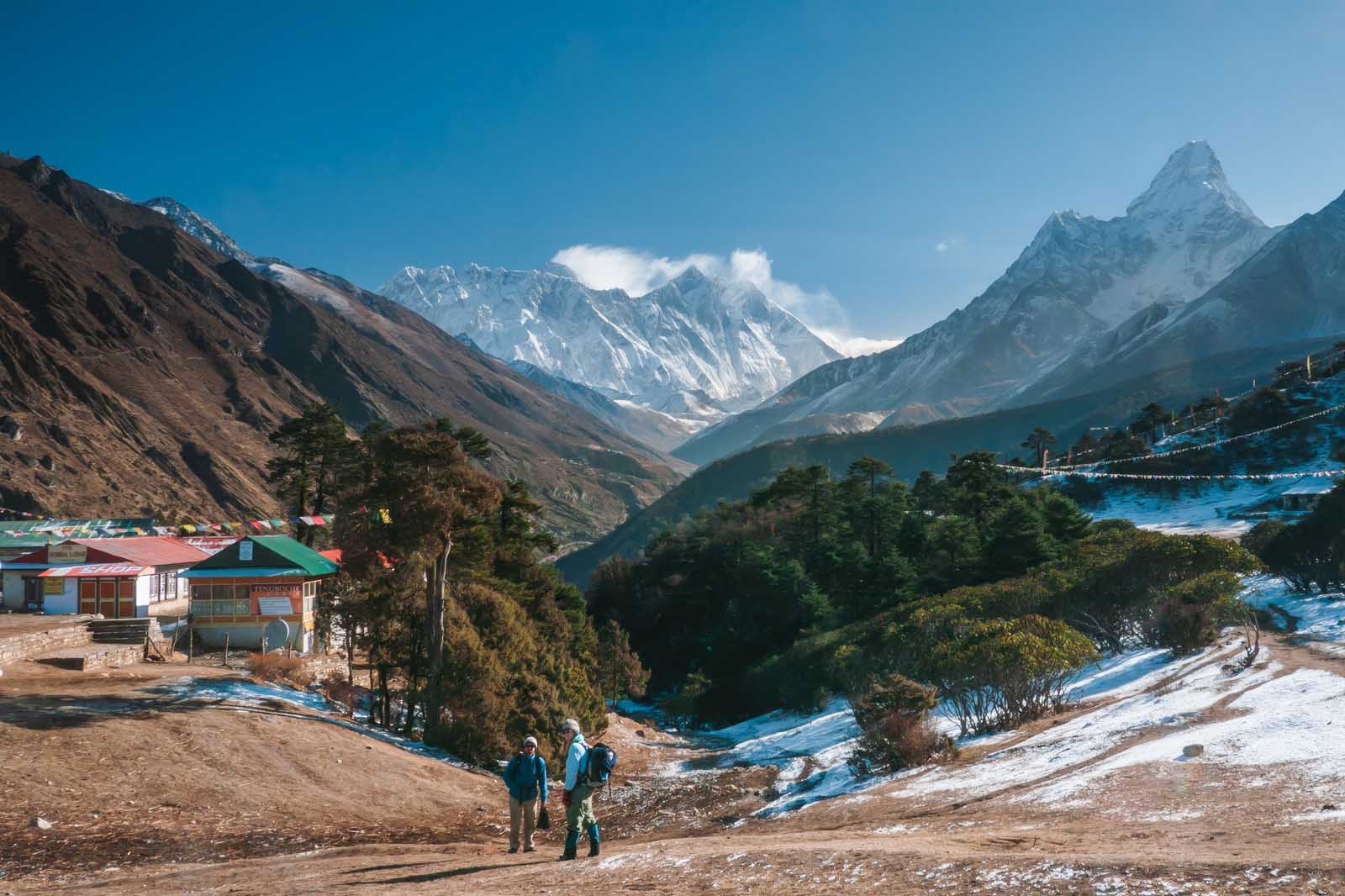
Day 5 of the EBC Trek was freezing! We had an early wake-up call and morning came too quickly on the Tengboche leg of the EBC Trek. But, we awoke to a winter wonderland of fresh snow at the Tengboche Monastery and clear views of Lhotse peak.
The snow from the night before made for more incredible views on the hiking trails. As we started out from the lodge, the sky was crisp and clear, showing Mount Everest in all its glory. It was stunning, and in between gasping for air, we admired the view.
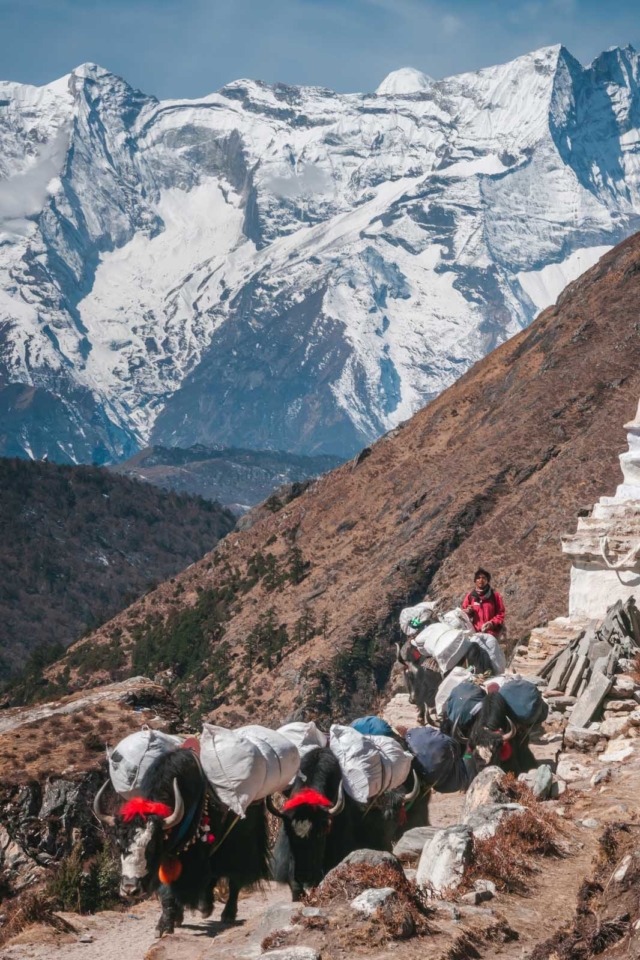
Today we walked to higher altitudes and saw our first trains of wooly yaks. Yaks cannot survive at low altitudes because it is too warm for them, so you don’t see yaks on the Everest Base Camp hike until at least 3000 meters. (9800 feet) They are beautiful.
Yaks on the Trek to Everest Base Camp
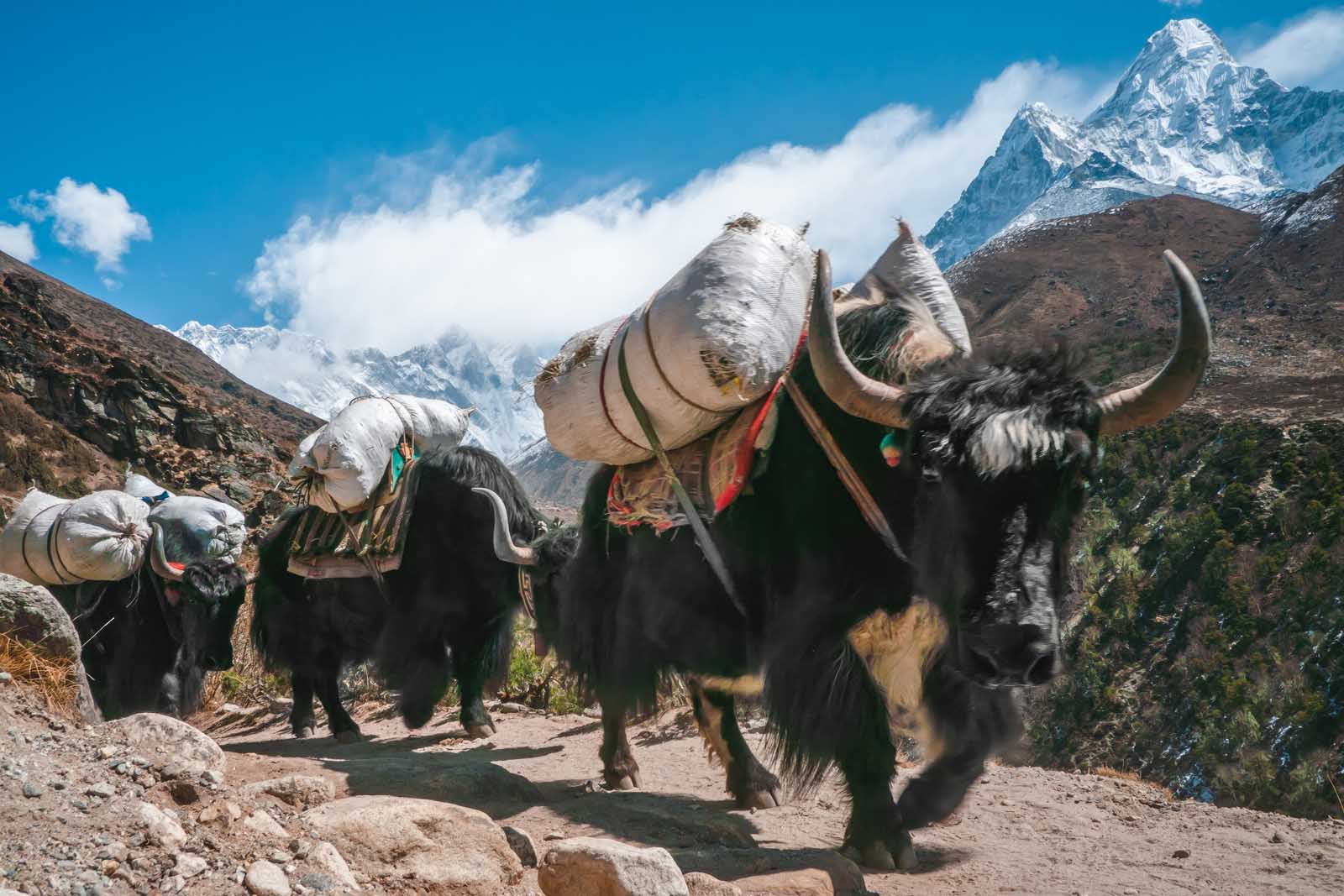
Woolly yak trains were more frequent and by day five of the EBC Trek, we had our system perfected to give them the right of way without letting them nudge us off the mountain.
As we said earlier, it is important to give yaks space. They will run you right off the mountain if you are in their way. Be sure to stand on the mountainside as they pass so you don’t get knocked over the edge. The yaks of the Everest Base Camp trek, have only one thing on their mind. To get to their destination.
On this day, signs of expeditions going up to summit Everest started to go by as large groups of yaks carried giant loads of climbing gear. It is exciting to think that we were walking the same route as so many great mountain climbers, like Sir Edmund Hillary and Tenzing Norgay Sherpa.
The Trek from Tengboche is breathtaking
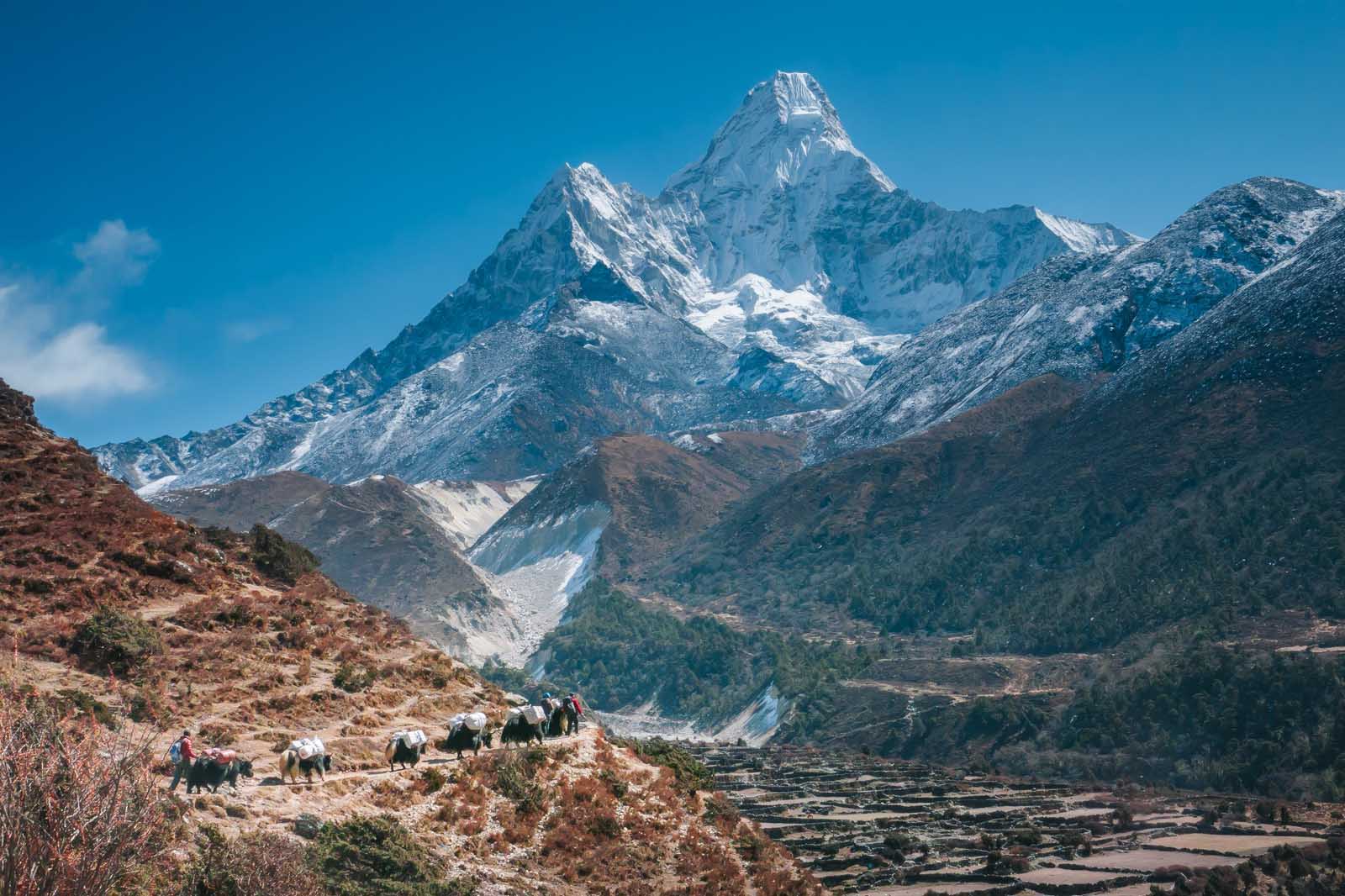
I conquered what little fear of heights I had left this day. Some of the narrow paths on the route dropped sharply into the deep valley below. Soon we found ourselves walking along the ledge not thinking at all about the dangers below. We hiked for a couple of hours before stopping for tea at a restaurant in Pangboche.
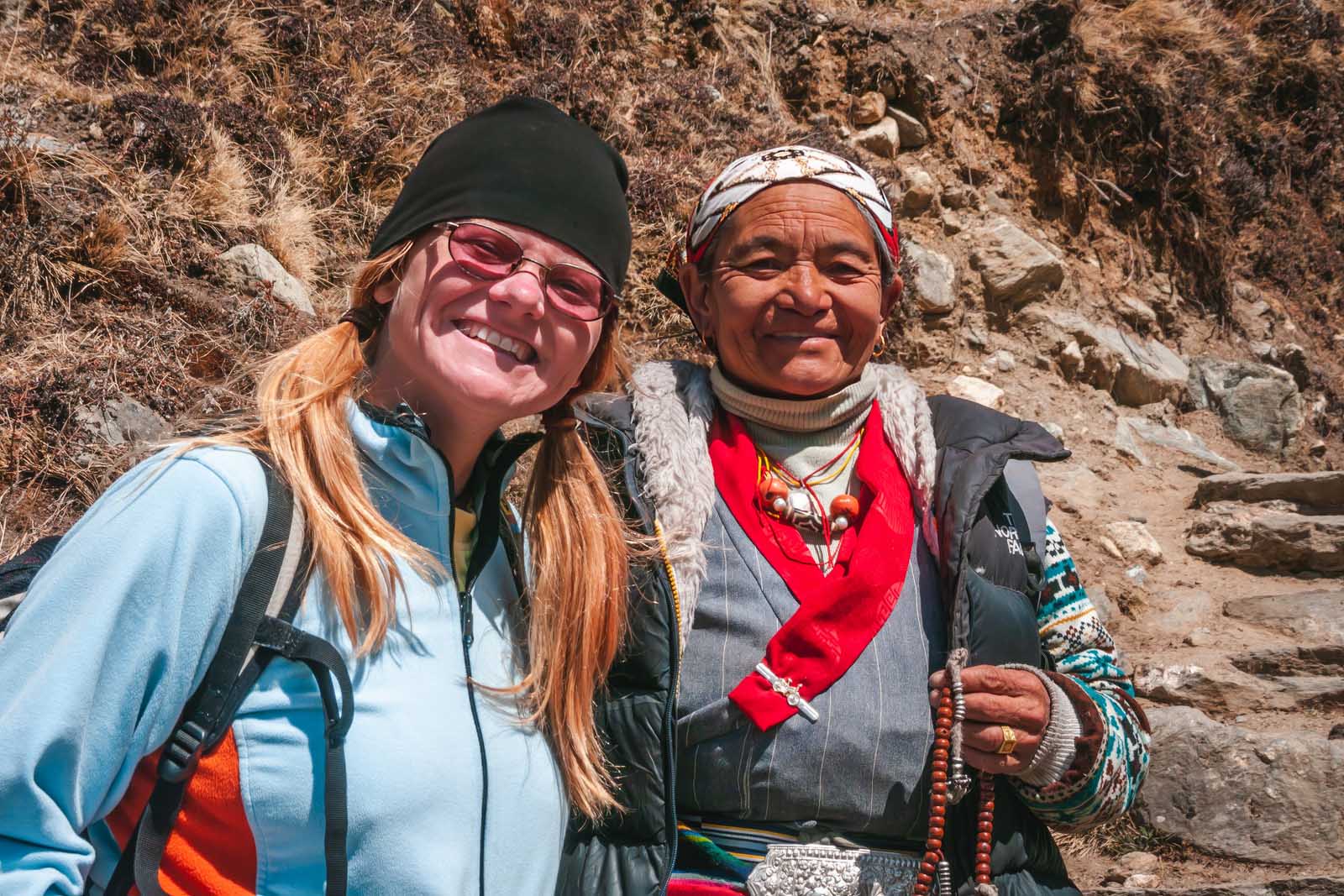
There are shops, teahouses, and restaurants along the route so we could buy lunch along the way and one of the more popular stops is in the village of Pangboche. After a tea stop in Pangboche, we met a sweet lady that walked with us all the way to the village of Dingboche. Her name was Yangshou and she waited for us as we struggled up hills and crossed the suspension bridge over the Imja Khola River.
Her cute laugh and quiet prayers helped to pass the time. She stopped to talk to everyone on the trail while we plugged along. She’d fall far behind when she chatted with friends, only to quickly catch us and then scoot by us with ease. She must have enjoyed our company because we really slowed her down. “ Yangzhou, we will always remember your smiling face!
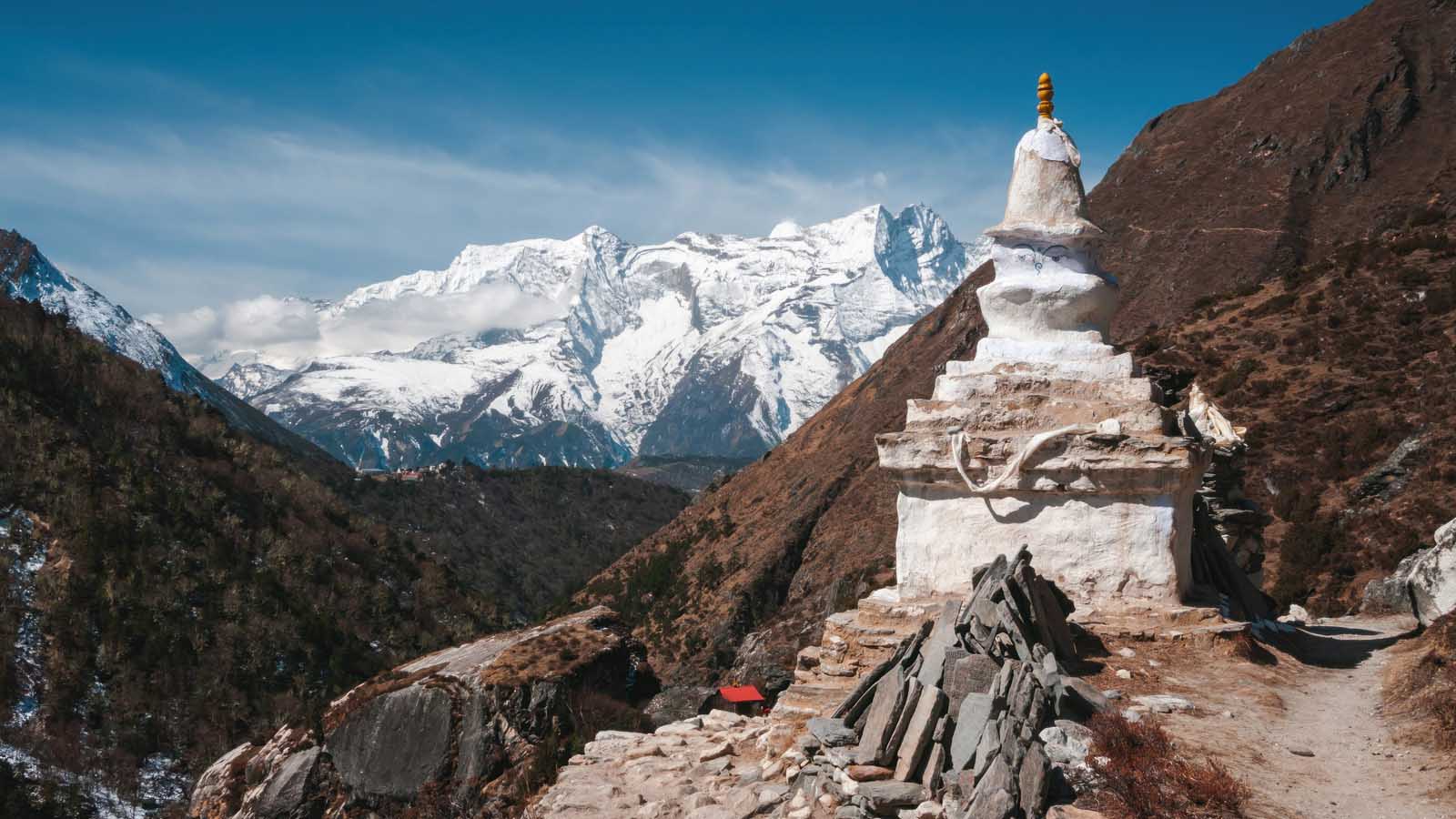
We spent the night in the village of Dingboche and wished that we had another night here. It is from here that you will see beautiful views of Island Peak and Lhotse, but it is also a good spot for another acclimatization day.
Tengboche – 3860 meters (12664 feet) above sea level Dingboche – Elevation – 4410 meters. (14468 feet) Elevation Gain – 550 meters (1804 feet) Distance – 10.8 km (6.71 miles) Duration – 3 hours (without stopping) 5 hours for photos, lunch, and rest.
Day 6 – Second Acclimatization Day at Dingboche
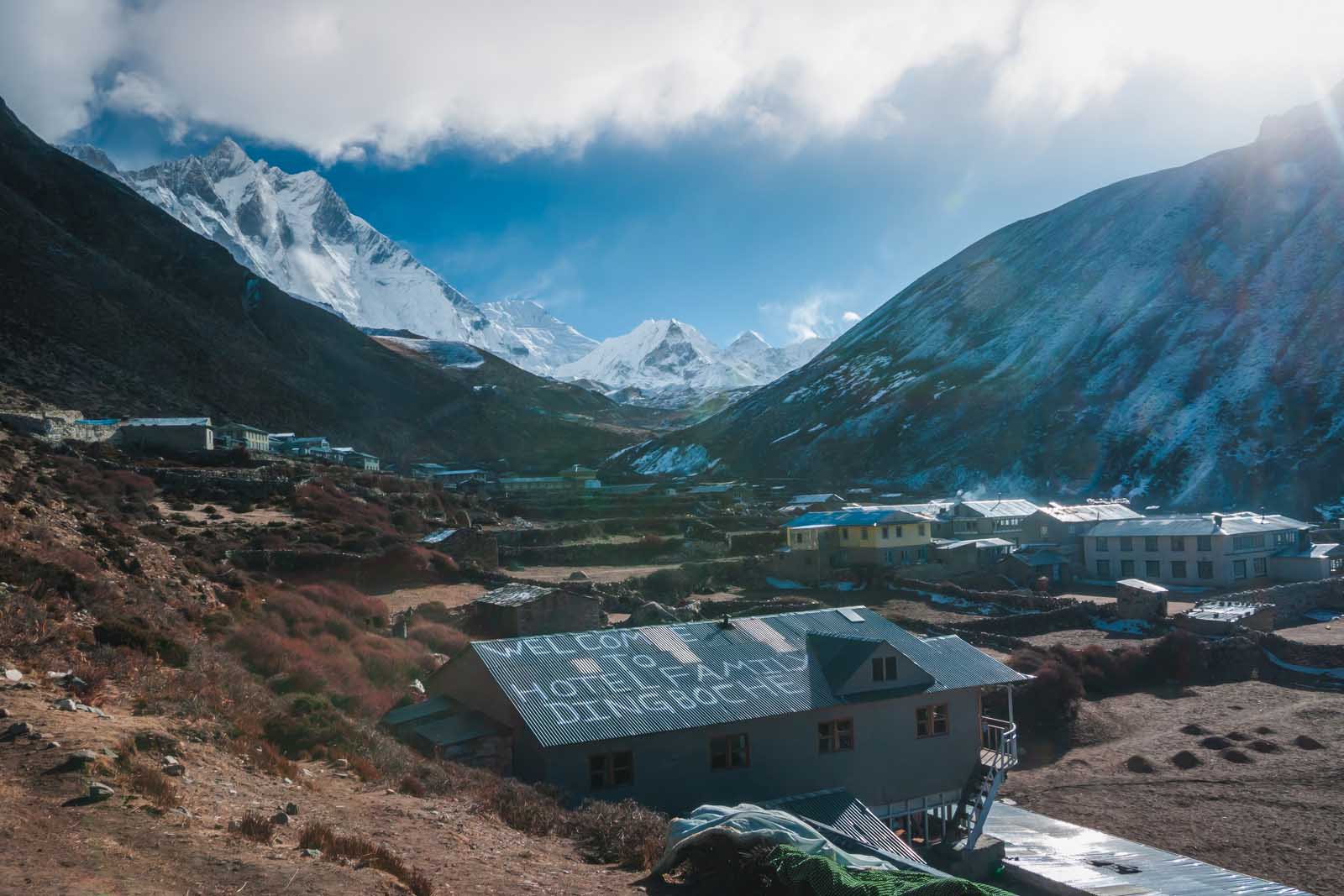
This is a day that most people spend acclimating to the high altitude. We did not do this day, but you should! So we are including it in the guide because it is a very important day when trekking to Everest Base Camp. If we were smarter, we would have spent 2 nights in the village of Dingboche where we would spend a day hiking up to Nagurjun Hill.
This is the best place for climbers looking to summit Everest, Ama Dablam (6812m), Lobuche peak (6,119 m), or Island Peak to do their acclimatization day. Dingboche is a small village in the Khumbu region with only a few guest houses, so it is a good time to relax, replenish and rejuvenate for the next push.
If we had brought our Lonely Planet Trekking in the Nepal Himalayas (which we forgot in Kathmandu and kicked ourselves about it every day) we would have realized that we should have taken an extra day to acclimate in Dingboche.
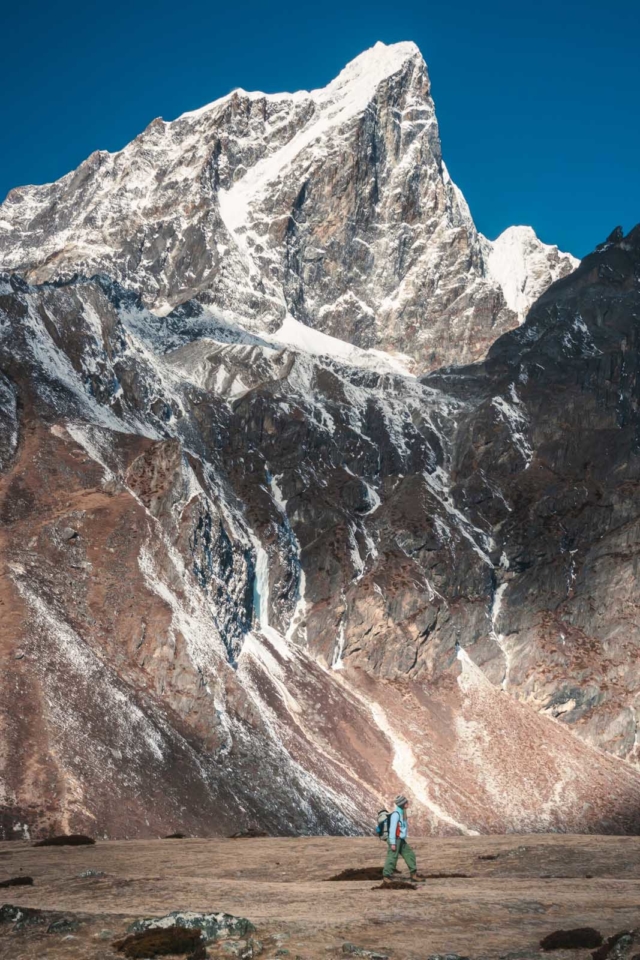
Dipendra was flexible so he would have easily added another day onto our trek, we just didn’t know any better to ask about it. Lucky for us, we felt strong, but other groups were complaining of headaches and dizziness.
In the end, we wish we spent the extra day here. Some people even spend two days here climbing to the surrounding peaks. We did suffer after reaching base camp and I believe that is because we didn’t spend time acclimatizing here.
Had we stayed, we would have done some light hikes to gain altitude and then come back down to rest at a lower elevation. Many people who are set to climb Island Peak or Kala Patthar stay here for a few days to get some practice climbs in.
Dingboche – Elevation – 4410 meters. (14468 feet) above sea level Nangkartshang Peak – Altitude – 5050 meters (16568 feet) Climb – 640 meters (2099 feet) Distance – 10.8 km (6.71 miles) Duration – 4 hours Elevation Gain – 0
Day 7 – Dingboche to Lobuche
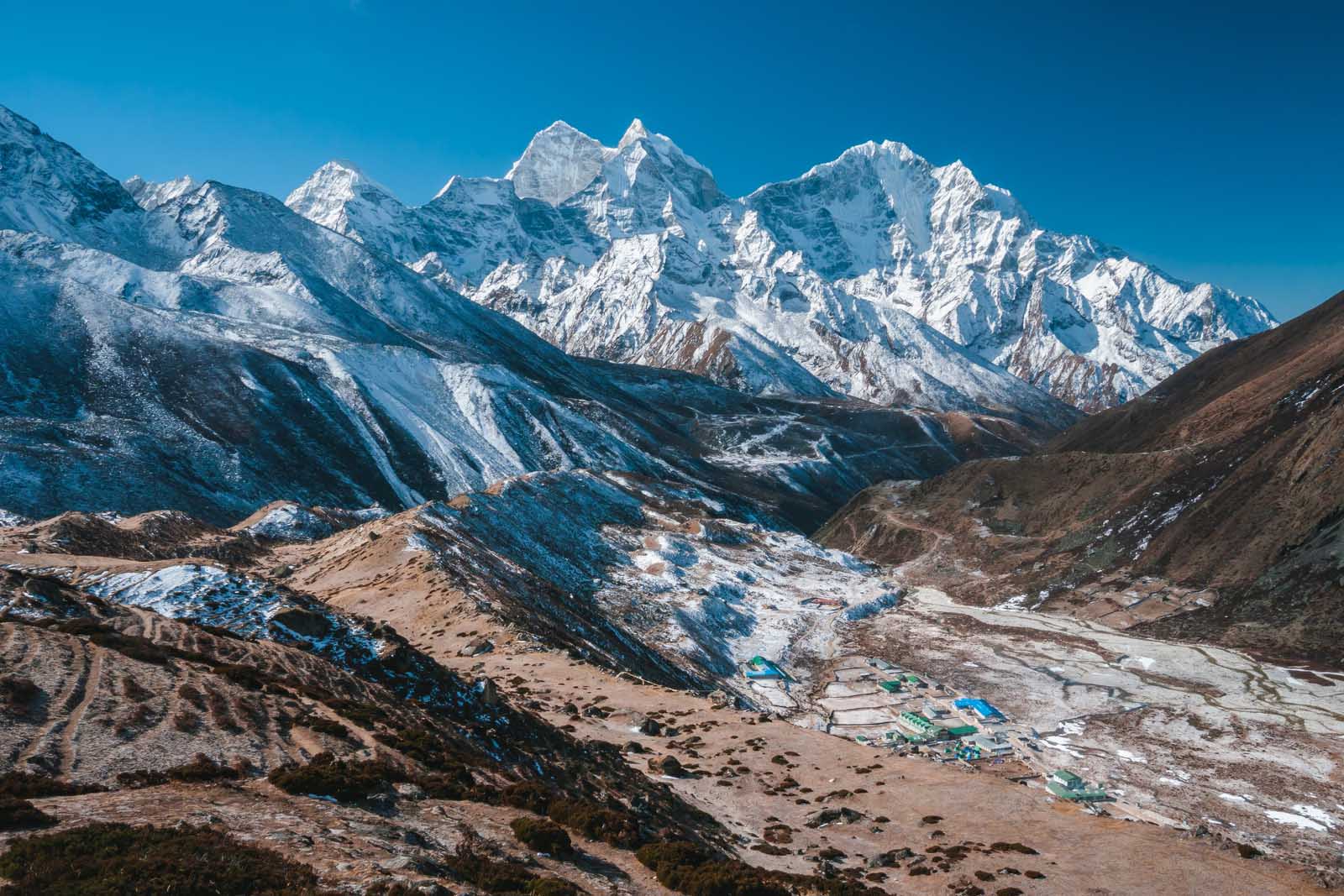
We walked with fellow trekkers we met at our guesthouse Martin and Richard from Slovakia during the morning hours. They carried their own packs and after watching them struggle, we were happy we hired a porter. (note: As of April 2023, you can no longer trek independently in Nepal) They were really starting to feel the altitude and we eventually left them behind.
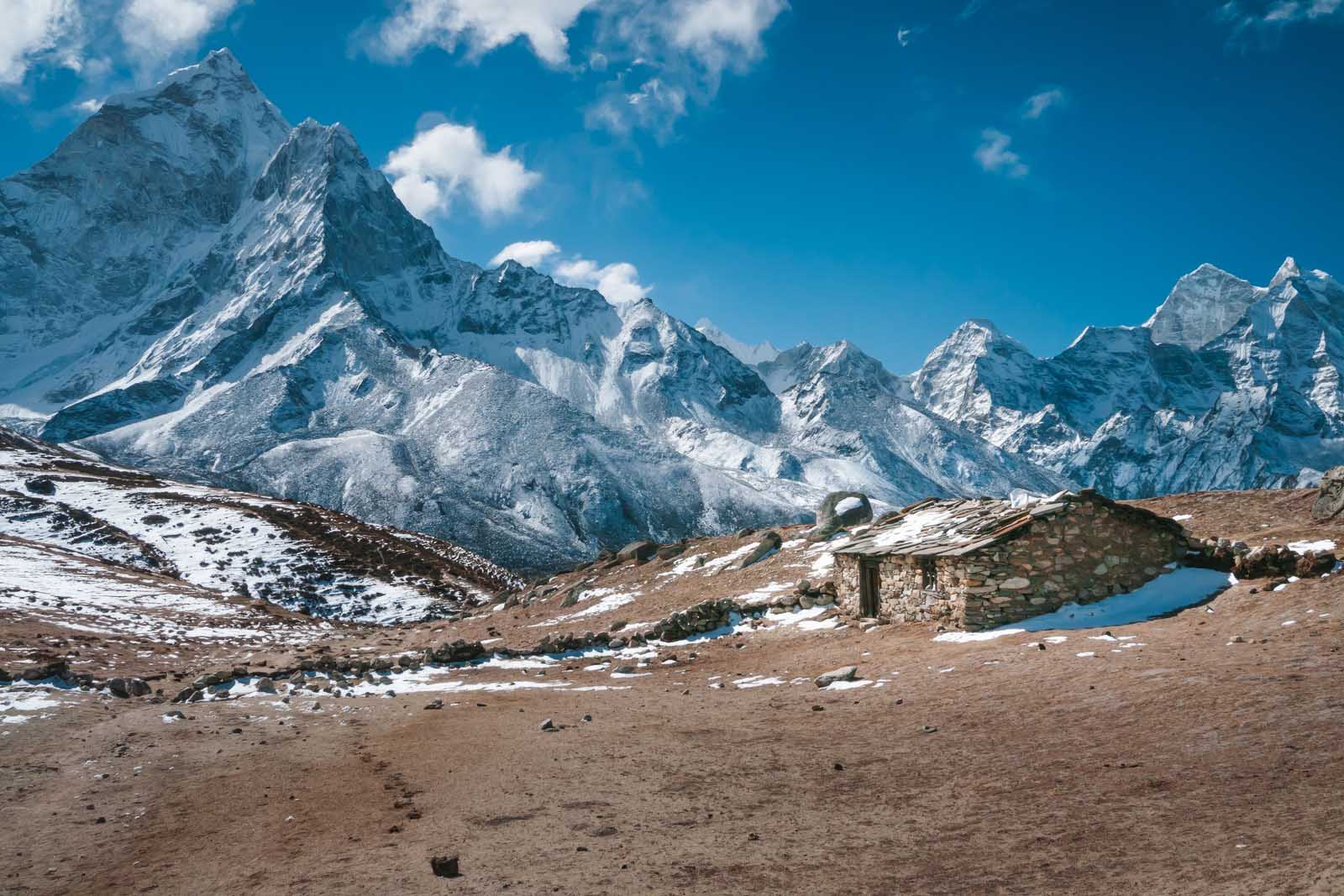
We enjoyed our day taking photos of the stunning clear views of the Everest region. It may be a little colder trekking in Nepal at this time of year (Early March), but the skies are clear and blue. When we came across a small cluster of houses, we felt like we had entered the Kingdom of Middle Earth. Little Hobbit houses lined a valley with giant peaks looming overhead.
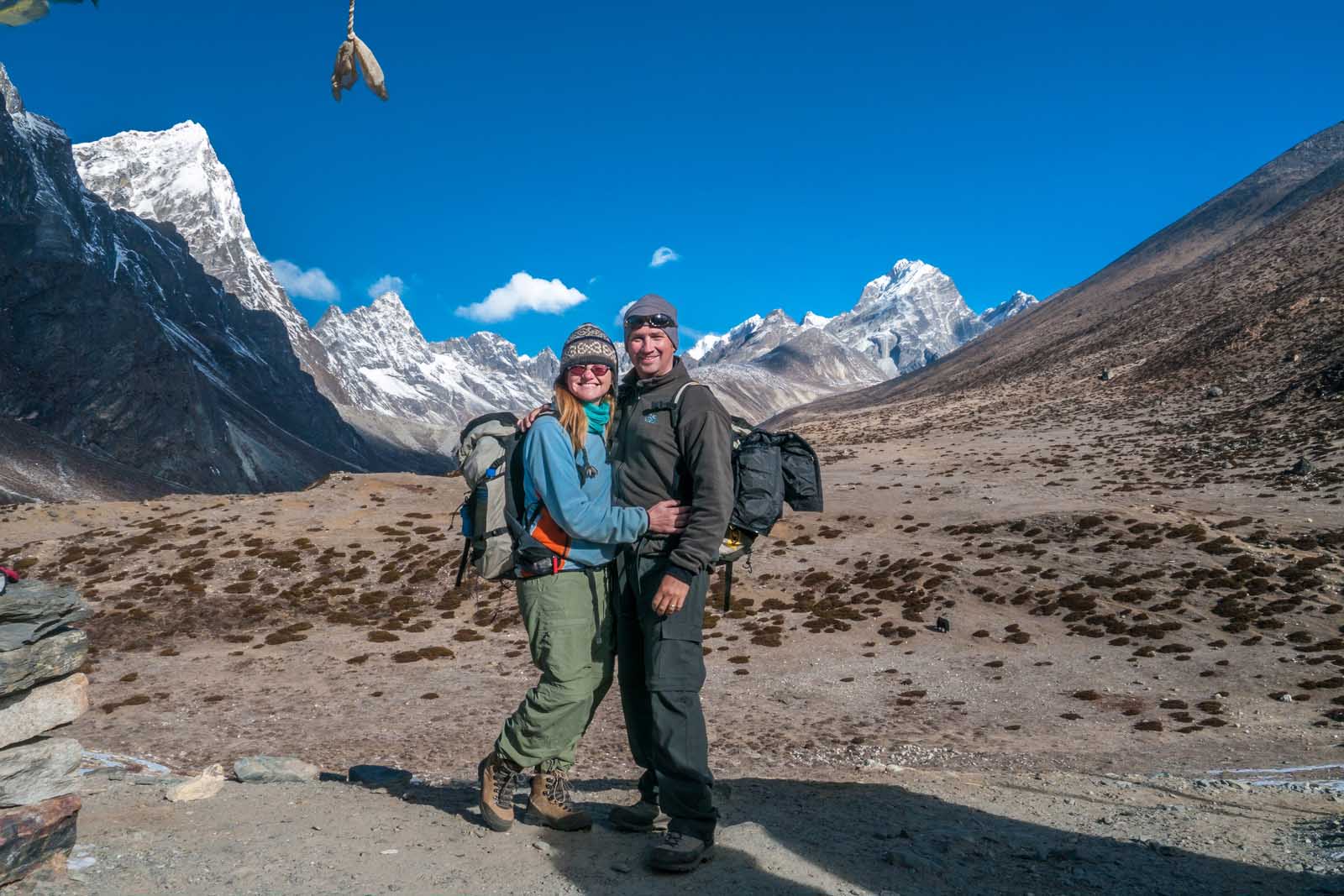
We had a front-row seat to some of the most breathtaking views on earth. An entire panorama of the mountains standing proudly overhead, reaching up to the deepest blue sky that I have ever witnessed. The scene took our breath away. The mountains looked more imposing with each corner we turned and we could not believe that we were fulfilling our dream of hiking to Everest.
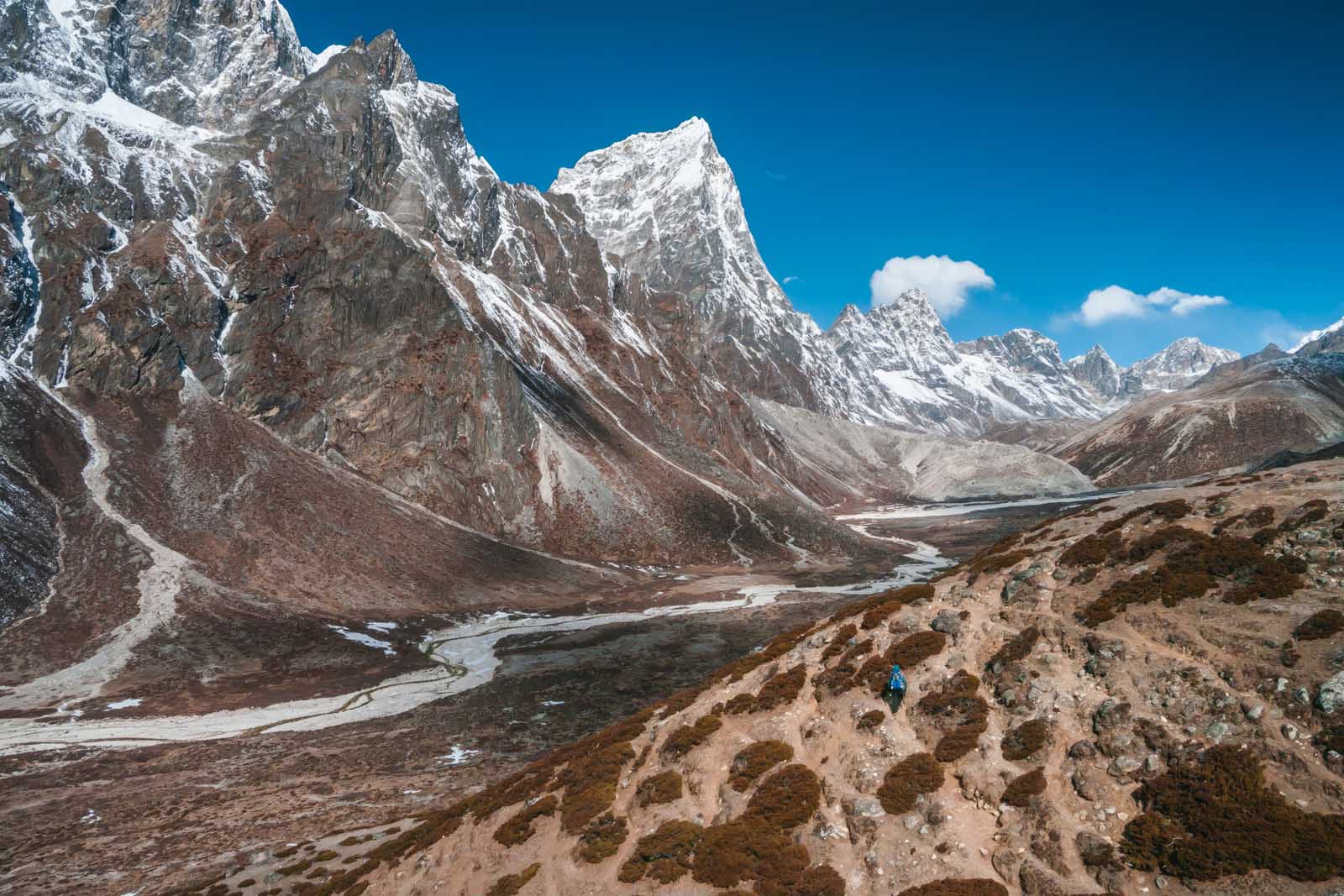
We had to knock on the door to see if Bilbo Baggins happened to be in. Sadly, he wasn’t home. I ended up singing Leonard Nimoy’s Ballad of Bilbo Baggin s for the rest of the day. A bad idea since I only know a few words.
Weather Conditions
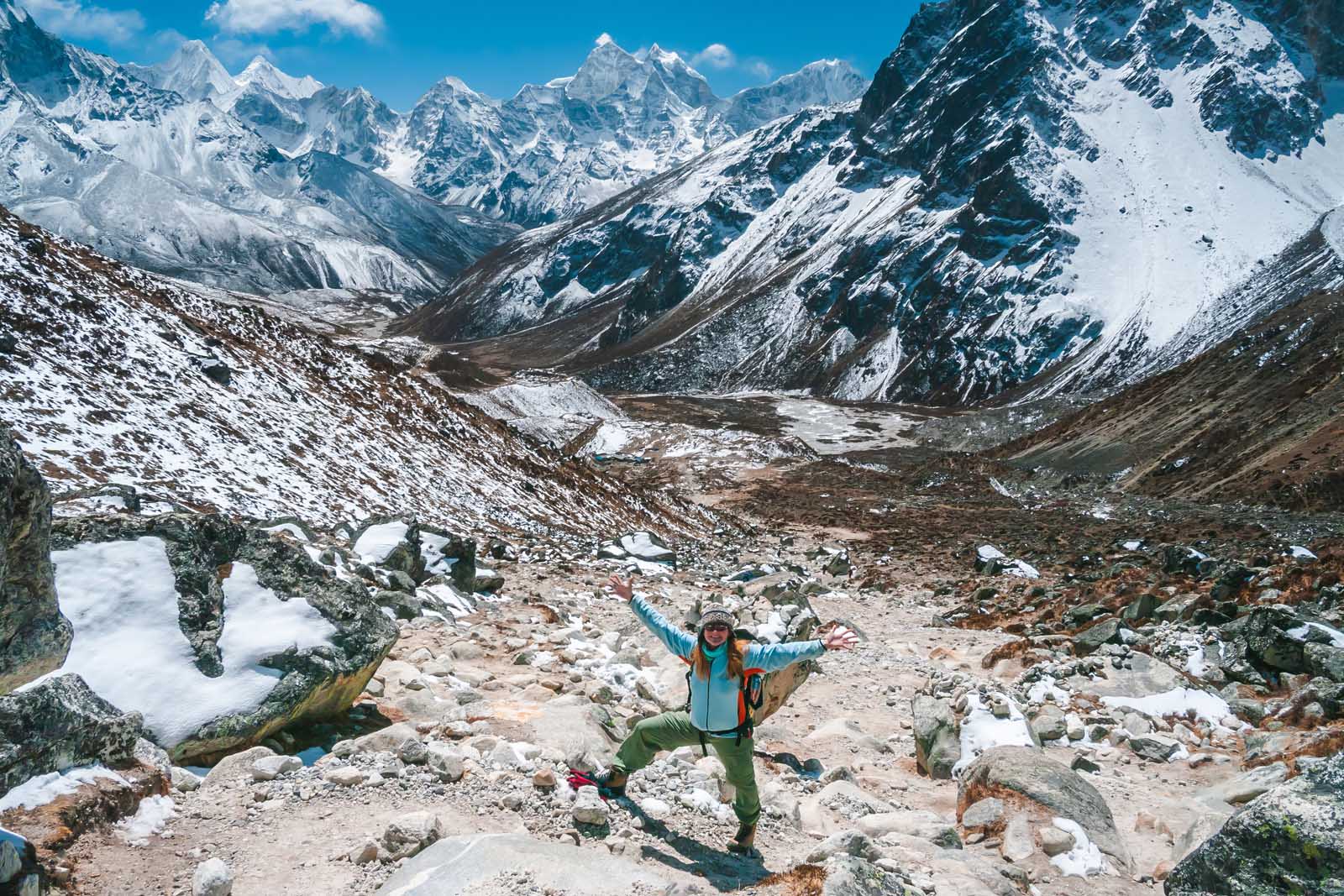
The wind picked up and we put on our outer layers for the first time. We were thankful to have them as we staggered through the high gusts. Weather varies greatly in the Everest Region and before you know it you can have inclement weather so be prepared with your layers. The sun can be shining one minute and then wind and clouds roll in the next.
After lunch, we faced quite the scramble up a steep hill littered with boulders. It looked like a tough climb, but we moved with ease and quickly made it to the top. Where we found our strength, I do not know.
Sherpa Monuments
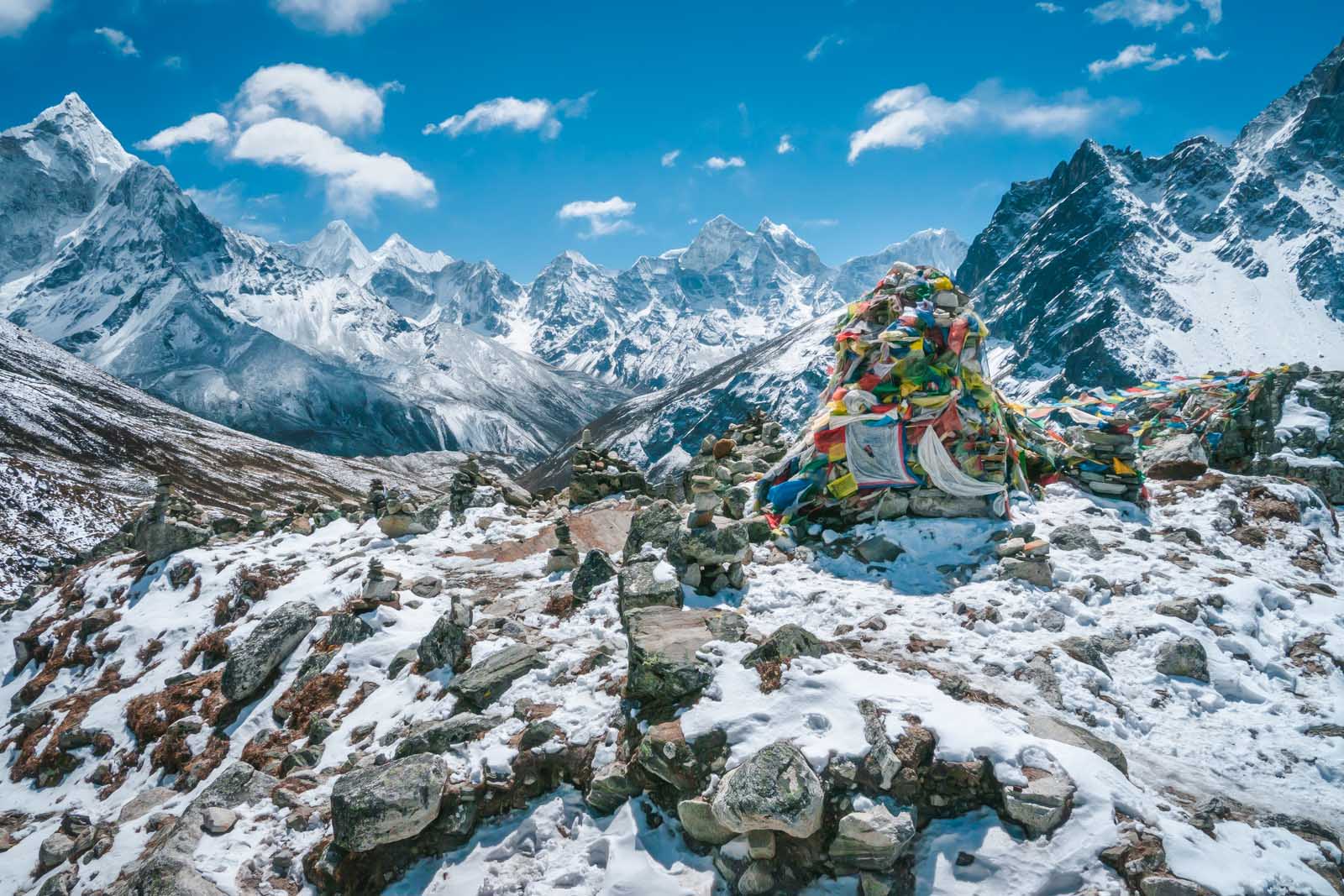
At the top of the hill is a very moving sight. Several monuments and stupas are erected, honoring Sherpas and climbers that have lost their lives on Everest. The most notable of these is Babu Chiri Sherpa .
Babu Chiri Sherpa was the former world record holder of the fastest ascent of Everest, the most number of ascents up the mountain, and the quickest back-to-back summits of 2 in less than 2 weeks. He tragically lost his life on his 11th attempt when he fell into a crevasse.
It was a moving experience and a strong reminder to not take things lightly on Everest, even if you are only trekking to Everest Base Camp. It is still a serious trek.
Dingboche – Elevation – 4410 meters. (14468 feet) above sea level Lobuche – Altitude – 4940 meters (16207 feet) Elevation Gain – 530 meters (1738 feet) Distance – 17.6 km (10.9 miles) Duration – 4 to 5 hours
Day 8 – Morning – Lobuche to Gorak Shep
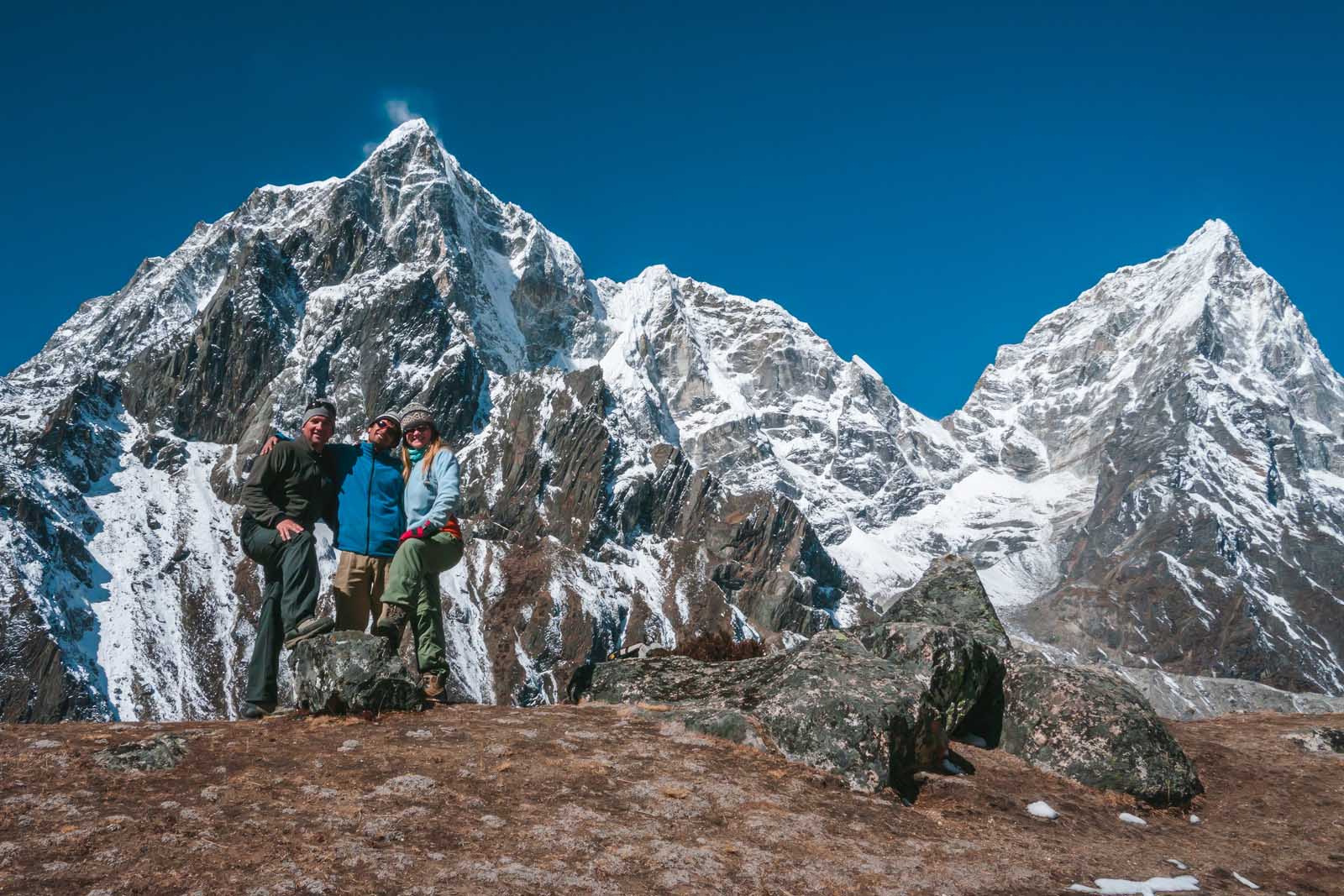
Day 8 on the Everest Base Camp Trek takes you to 5000 meters (16404 feet). How did we feel at 5000 meters? Terrible. Before entering Nepal, I had been suffering for a few weeks in India. The pollution of Kathmandu didn’t help and my congestion was worse when I started the climb. I thought it would clear up in the fresh air, but it intensified with each increase in altitude.
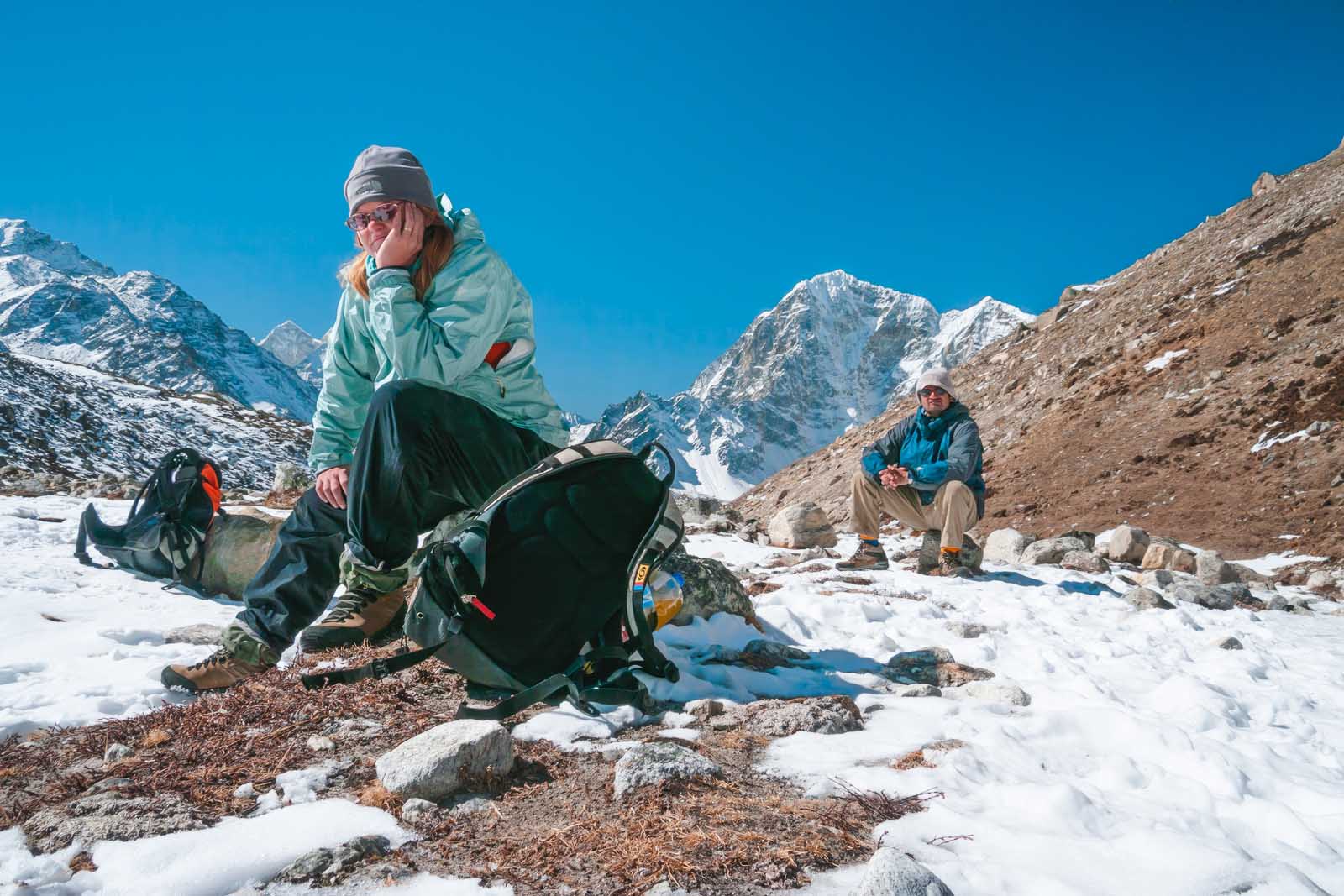
Every morning my cough got worse and my nose was stuffed up to the point of being unbearable. Today, I felt the effects of the congestion and couldn’t catch my breath. It didn’t help that we had gone into such a high altitude. The air is thin and cold.
Dave suffered his first symptoms of altitude sickness when reaching 5000 meters as well. He had a slight case of diarrhea and wasn’t happy about having to wait for the toilet in the teahouses. I think many people were suffering from the same symptoms.
Our was a slow climb to Gorak Shep. We stopped regularly to catch our breath and today we took more breaks than usual. Luckily it was only a couple of hundred meters in elevation gain so we made it to our guest house in Gorek Shep by 12:30.
Lobuche – Altitude – 4940 meters (16207 feet) above sea level Gorak Shep – 5164 meters (16942 feet) above sea level Elevation Gain – 224 meters (734 feet) Distance – 4.3 (2.6 miles) Duration – 4 Hours
Day 8 – Afternoon: Gorak Shep to Everest Base Camp
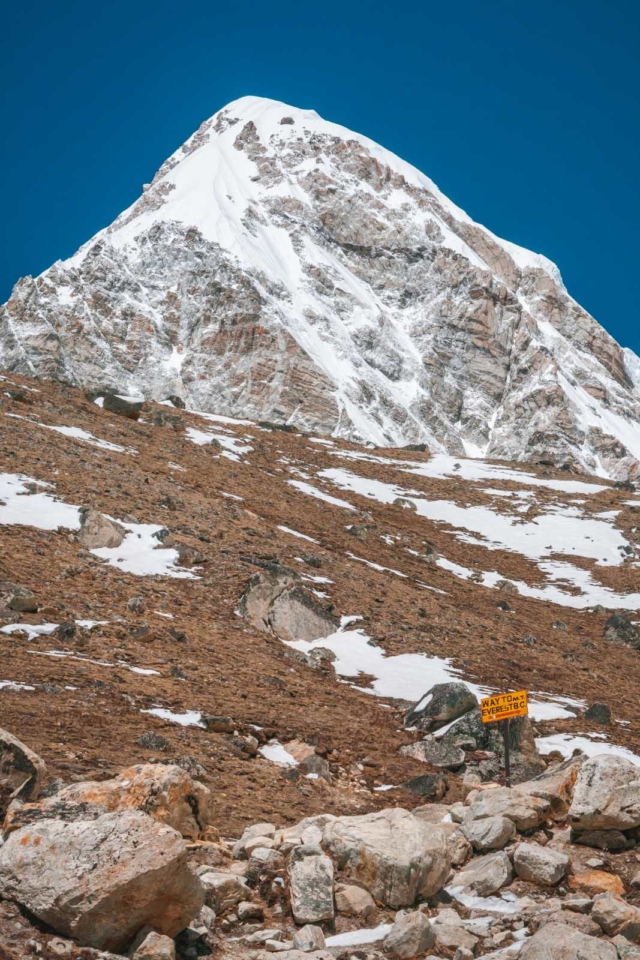
We took a break at Gorek Shep before making out way to Everest Base Camp. We sat in the sun marveling at the fact that we made it this far. After eating a hearty lunch of vegetarian Sherpa stew (Dal Bhat) on the terrace, (yes, we ate outside in the warm sun above 5100 meters) we set out for Everest Base Camp. The sun was shining brightly and it was quite pleasant outside so we were very excited.
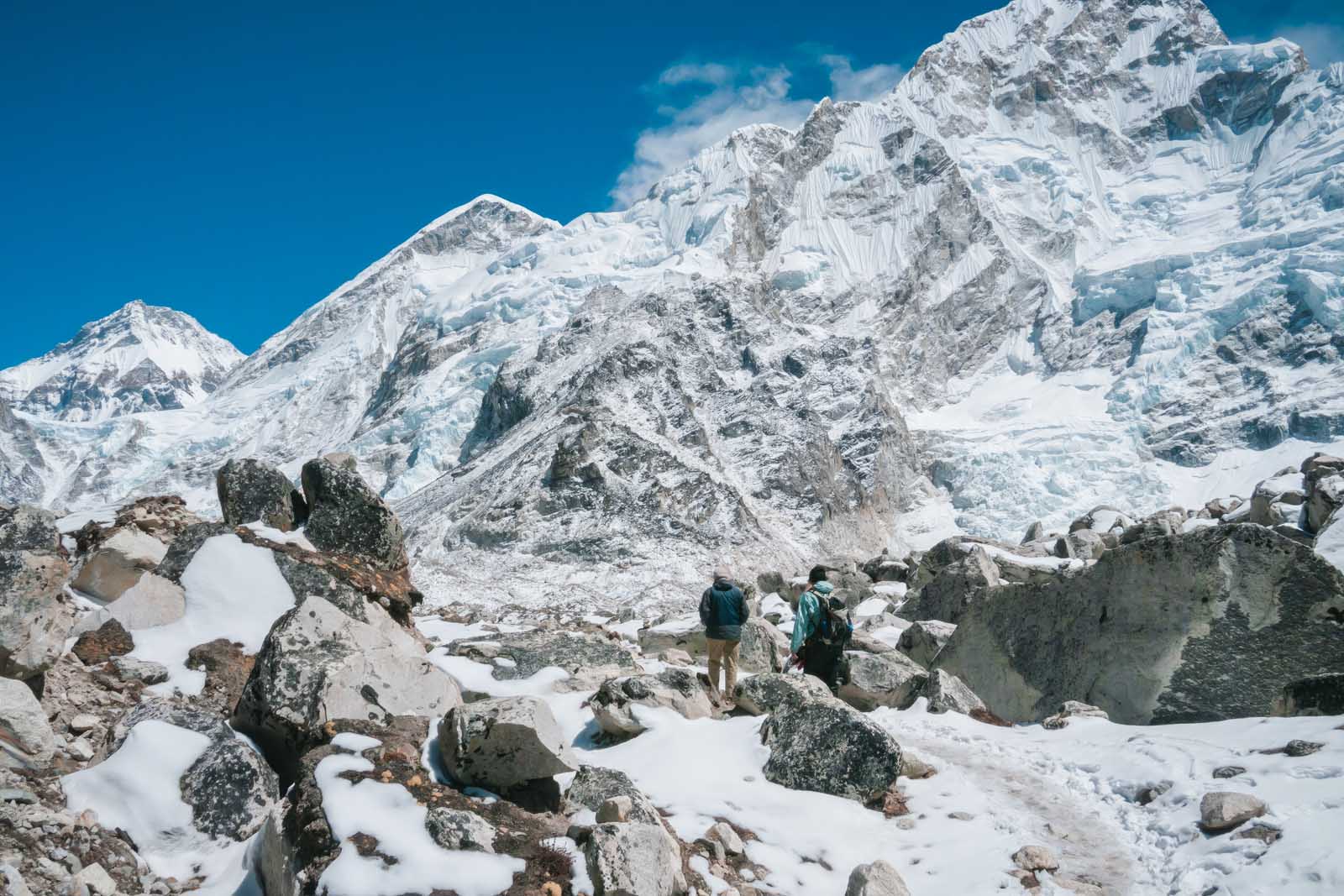
We were lucky and had clear skies. Up until today, the clouds had rolled in by early afternoon every day. Today the sun shone and the skies were blue until sunset. So, it was our perfect morning to make the push.
The trek to Base Camp from Gorak Shep is an easy one. It’s two hours of walking with only a small elevation gain, and we made it with ease. That break for lunch really helped our spirits.
Reaching Everest Base Camp
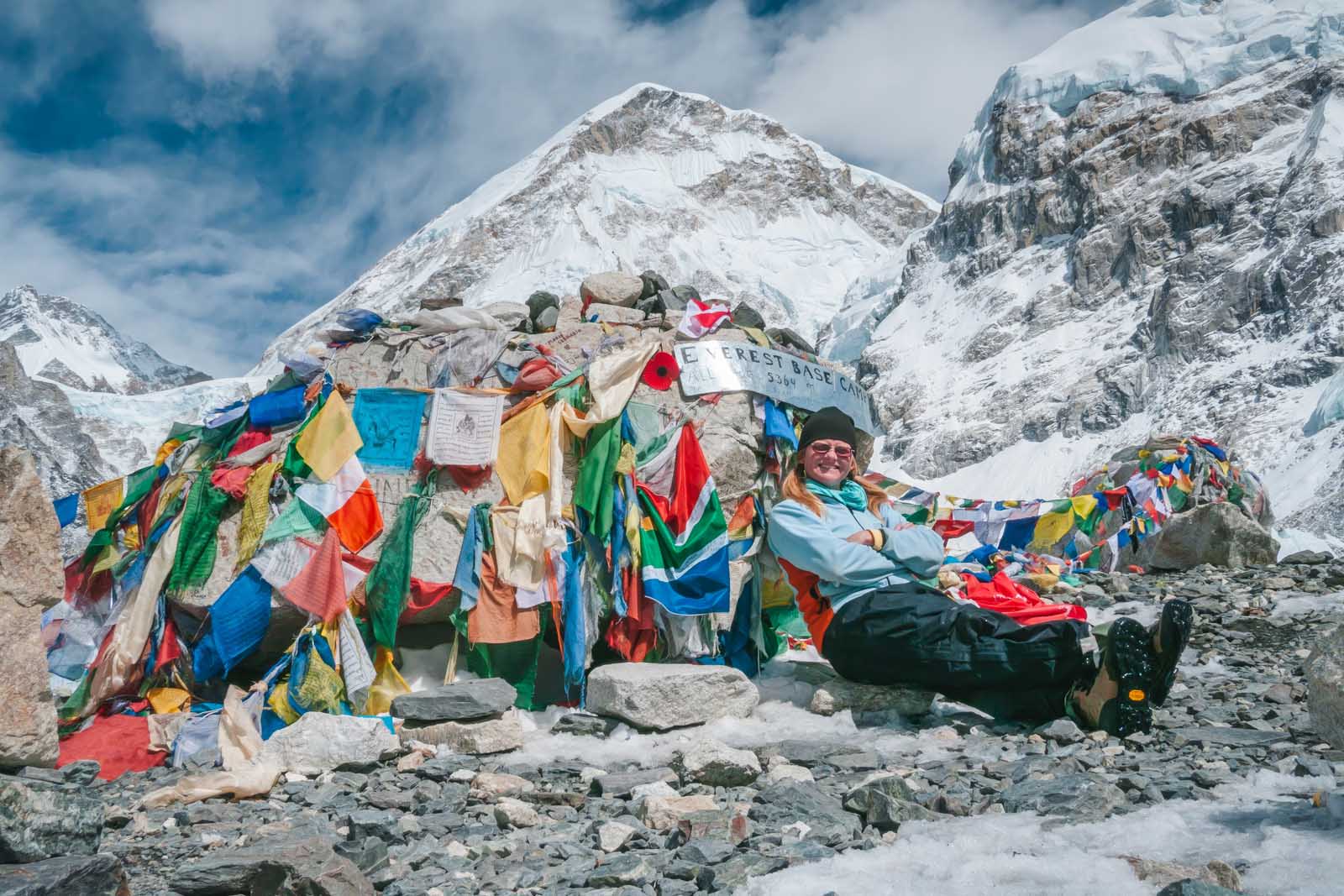
People can summit Mount Everest from Tibet, but the main Everest Base Camp expedition route is in Nepal, and it is busy when the season is in full swing. Even those climbing to the peak of Mt Everest hike the route we took along the Everest Base Camp trek.
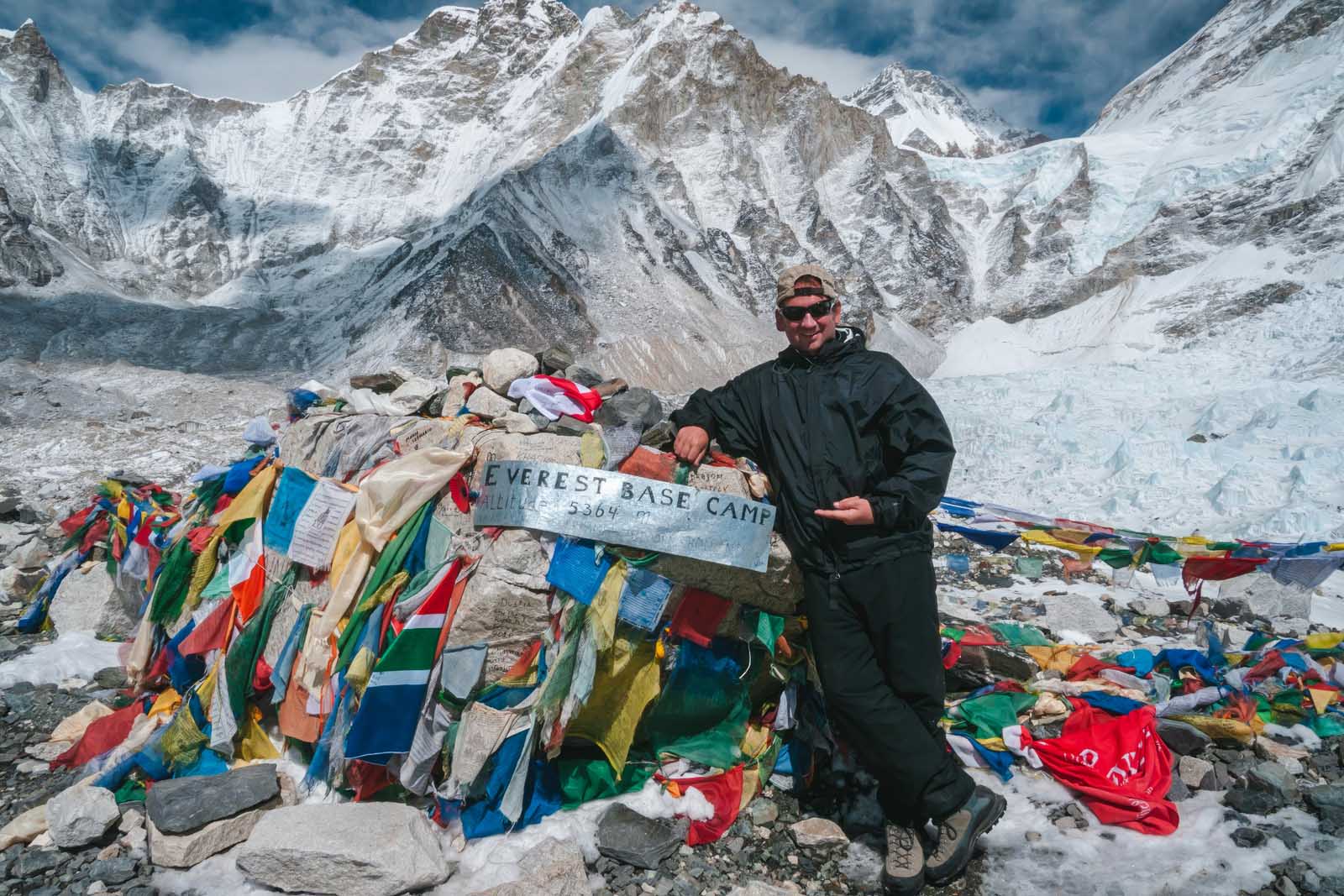
We arrived just a week or two before the season, so it was still quiet on the mountain. In fact, we were the only people at Base Camp that afternoon. We saw another group coming down on our way up, but once there we had it all to ourselves. It was thrilling.
To reach Everest base camp, you will hike out from nearby Gorak Shep and then hike back the same day to spend the night in the village. You do not spend the night at base camp.
Khumbu Glacier
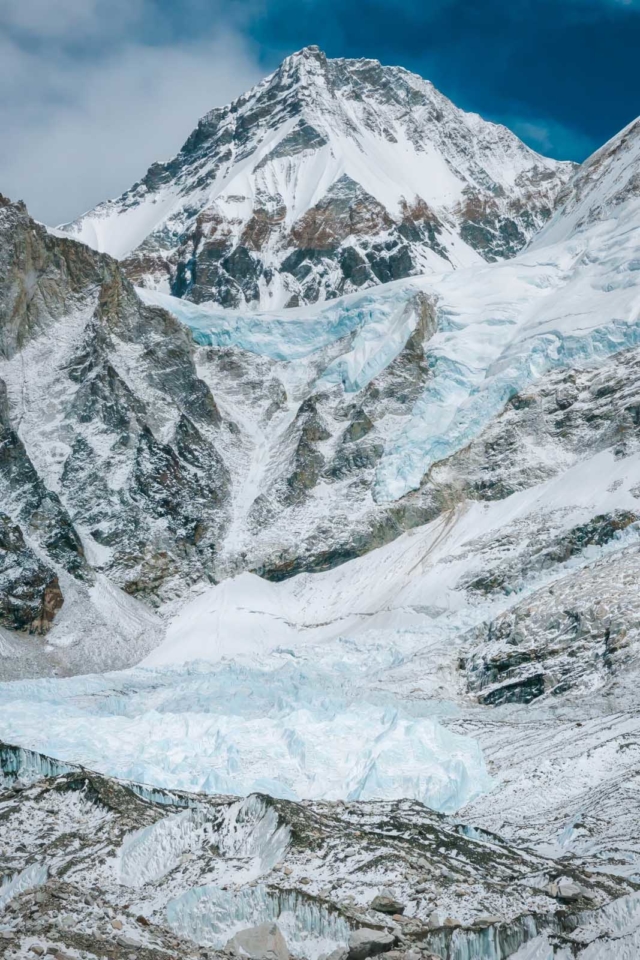
The Khumbu Glacier is the first thing to come into view, and it is unbelievable to think that we are actually standing there. The Khumbu Glacier is the largest glacier in all of Nepal and is famous for the Khumbu Icefall. This treacherous sheet of ice is the most dangerous obstacle that climbers face when summiting Everest.
We witnessed an avalanche that reminded us just how precarious the climb to Mount Everest is. It is an intimidating sight and I cannot imagine having the courage to cross that field of ice. Climbers walk across ladders that shift and move as the ice is alive and constantly settling. It has taken many lives, and we were happy to look at it from afar.
With an elevation of 7600 meters at its source, the Khumbu Glacier is the highest glacier in the world and the Khumbu Icefall is one of the most dangerous portions of the climb to the summit of the world’s highest peak. We were happy to look at it from afar.
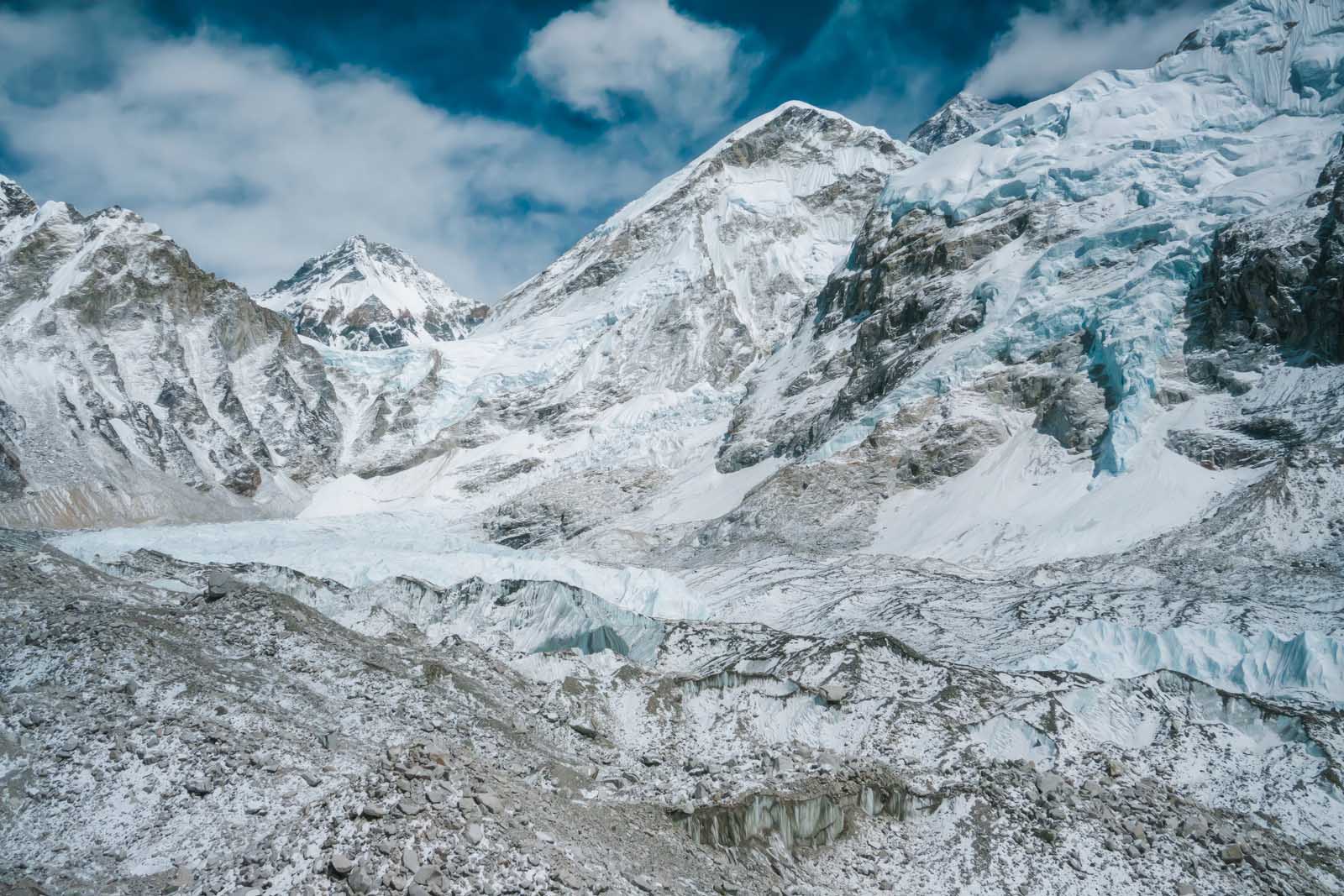
Everest Base Camp’s elevation is 5,364m (17,598 feet) so you will feel the high altitude. But, if you have taken your time you should feel pretty good. We had been at this elevation now for a while and stayed hydrated, so we could enjoy the experience.
We stood at a rock covered with prayer flags announcing that yes, we had made it to Mount Everest Base Camp at 5364 meters. We stayed for almost an hour taking videos, celebrating, and snapping photos. If you can bear it, don’t rush the experience, take it in and enjoy every minute. This will be the only time you’ll see it.
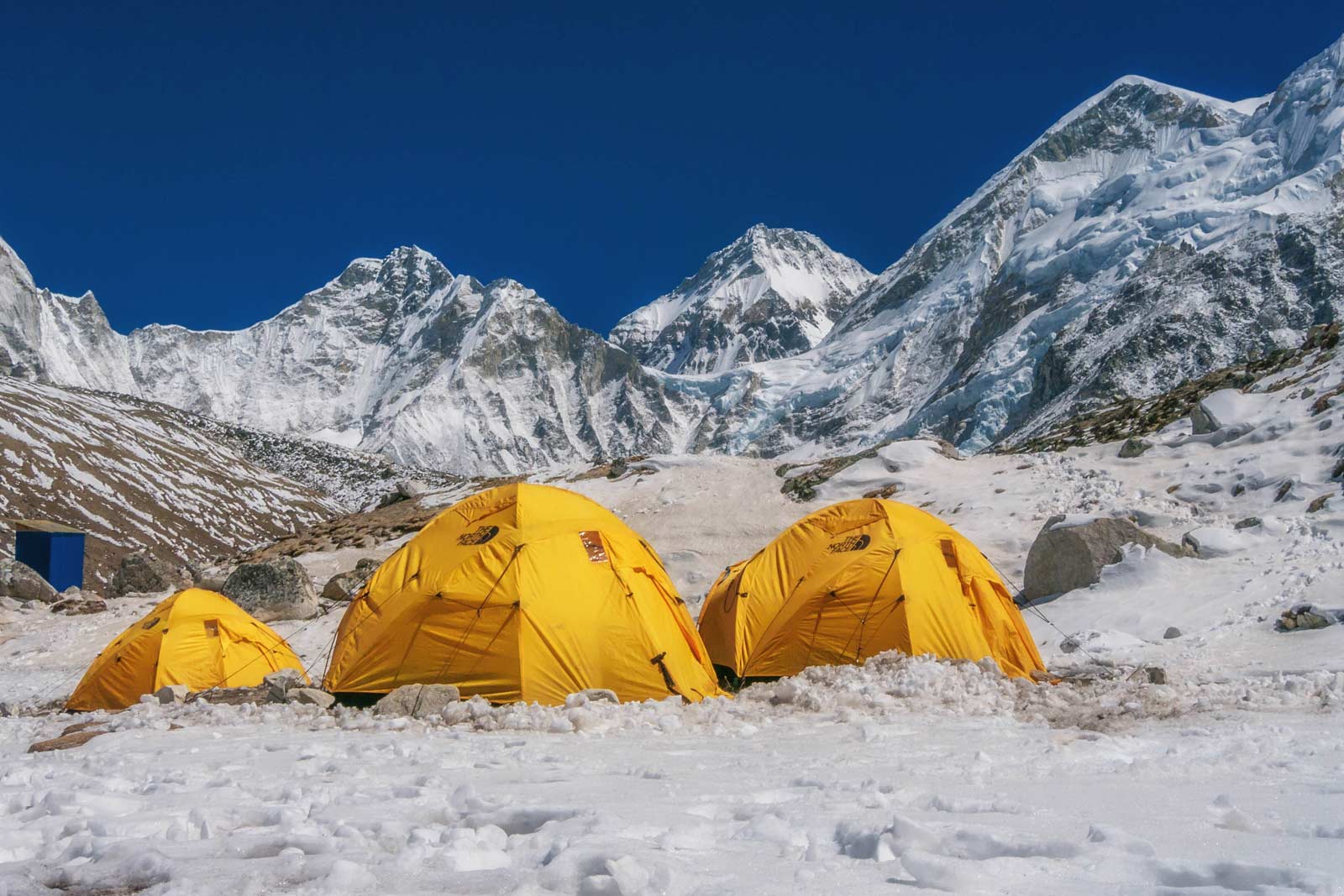
Trekking to Everest may be more exciting later in the season when Everest expeditions are there, but we really liked having base camp to ourselves. There wasn’t a soul on the mountain except for the three of us. We stayed for almost an hour taking videos, celebrating, snapping photos, and marveling at the massive Khumbu Glacier. Can it really be true that we are here? It felt like a dream.
We finished our climb about two weeks before the high season began and we wouldn’t have it any other way. We stood at a rock covered with prayer flags announcing that yes, we had made it to Everest Base Camp.
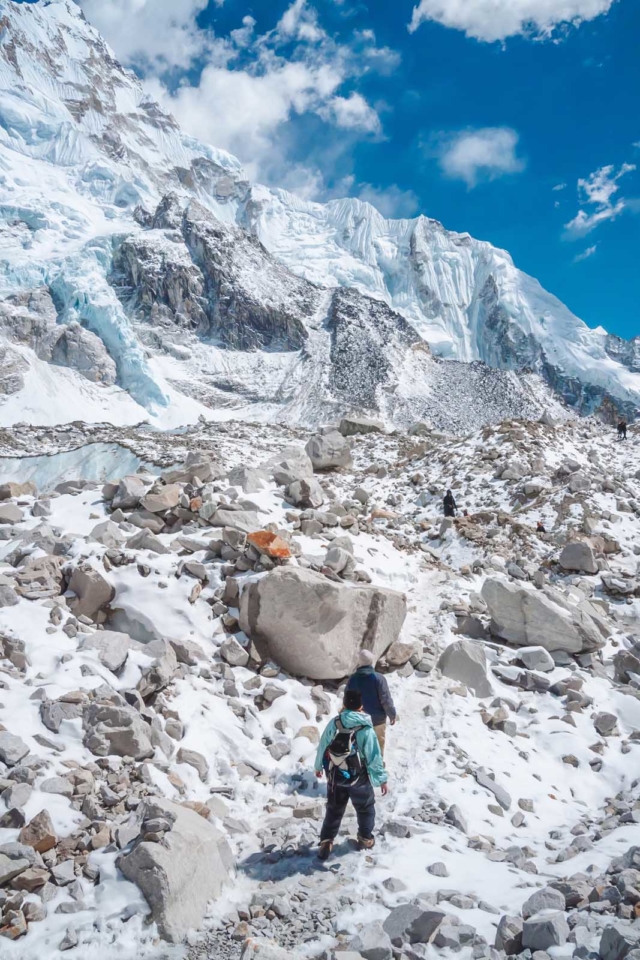
When it’s high season, base camp is filled with expeditions and tents spanning the valley. We only saw one expedition so far. They may have been here to climb Island Peak as base camp is also a place to acclimate for that peak.
We started to make our way back to Gorak Shep from Everest Base Camp at about 3:30 pm. Even though it was an easy trek back, there are narrow paths atop high ledges and it just so happens that while we were walking back, an ice bridge broke off after I stepped on it leaving Dave with a sticky situation of having to take one giant leap over a gorge. We made it back to Gorak Shep safely but it was a reminder just how dangerous the Himalayas can be.
Back to Gorak Shep
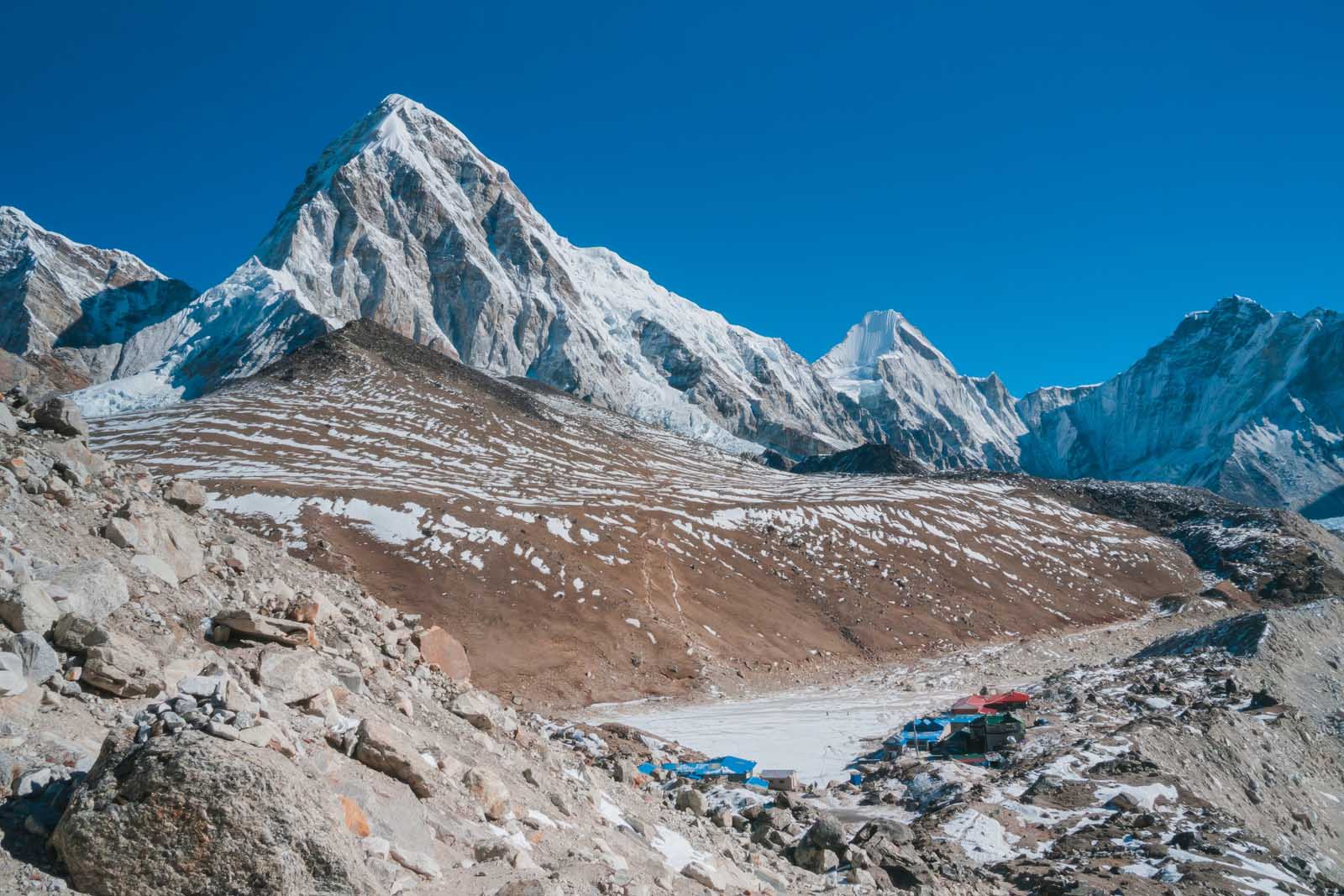
By the time we made it back to Gorak Shep, the excitement of reaching Everest base camp had worn off. We had reached our final destination Base Camp, but there was still a lot more trekking to go.
We were happy to have seen it, but we were exhausted. We felt the same when we climbed Mount Kilimanjaro. The thrill of reaching your destination is over and there is nothing more to look forward to, but there are still so many days to go.
That night I had serious sinus congestion and felt like I was suffocating in my freezing bed. It was quite scary to already be short of breath because of the altitude and then be completely congested. I really was terrified. Our guide Dipendra brought me hot tea all night and I slathered myself in Vicks Vaporub but nothing helped me to breathe easier.
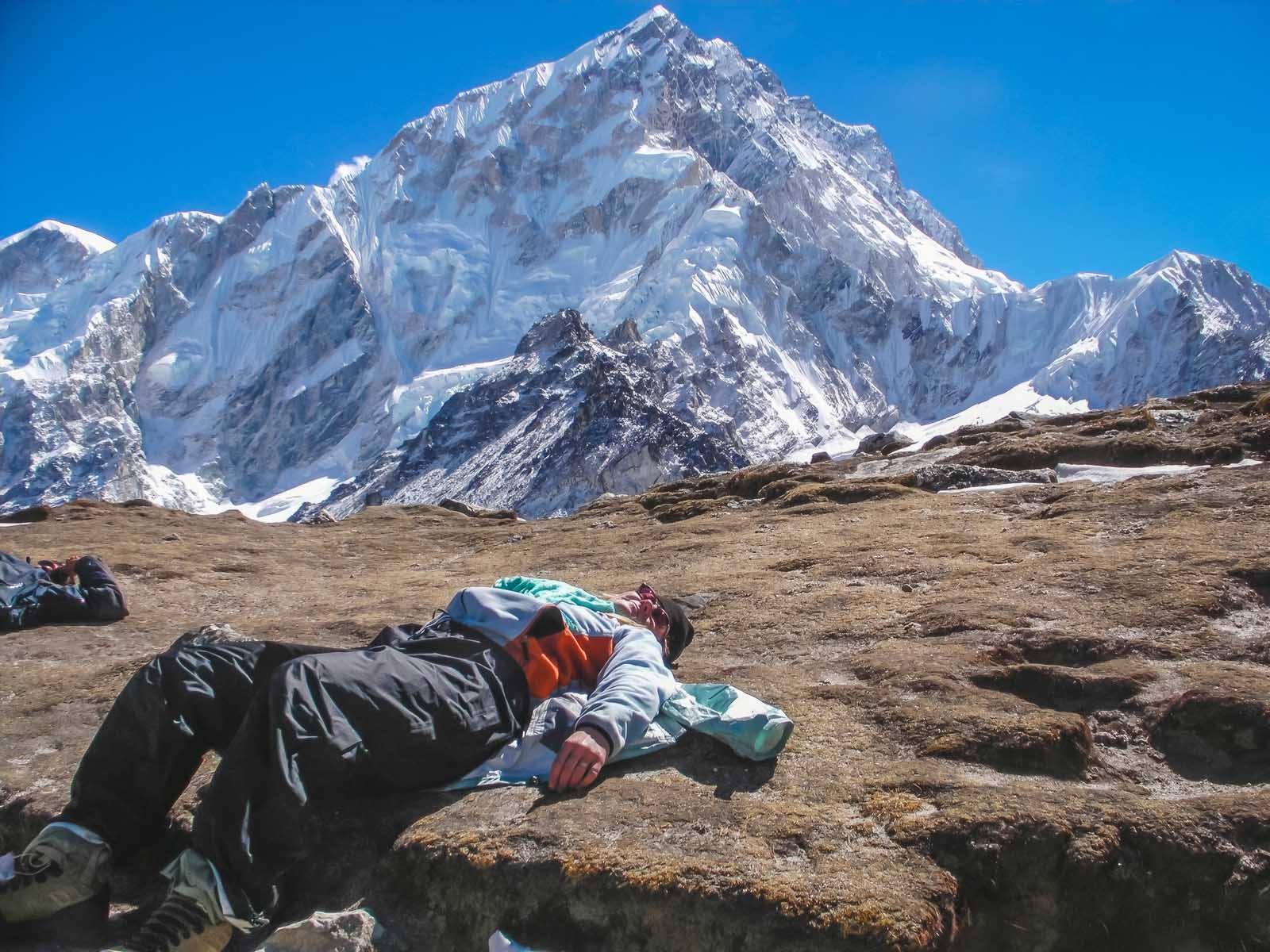
I was afraid as we had the Gokyo Lake trek ahead through the Cho La Pass. We were also planning to trek up to Kala Pattar for the best views of Everest in the morning. I hope I could make it but I was also dreading the day ahead. I barely slept a wink but I finally drifted into a not-so-peaceful slumber.
Gorak Shep – 5164 meters (16942 feet) above sea level Everest Base Camp Elevation – 5,364m (17,598 feet) above sea level Elevation Gain – 200 meters (656 feet) Distance – 3.5 km one way (2.1 miles) Duration – Three Hours Round Trip
Alternative Gokyo Lake Via Cho La Pass
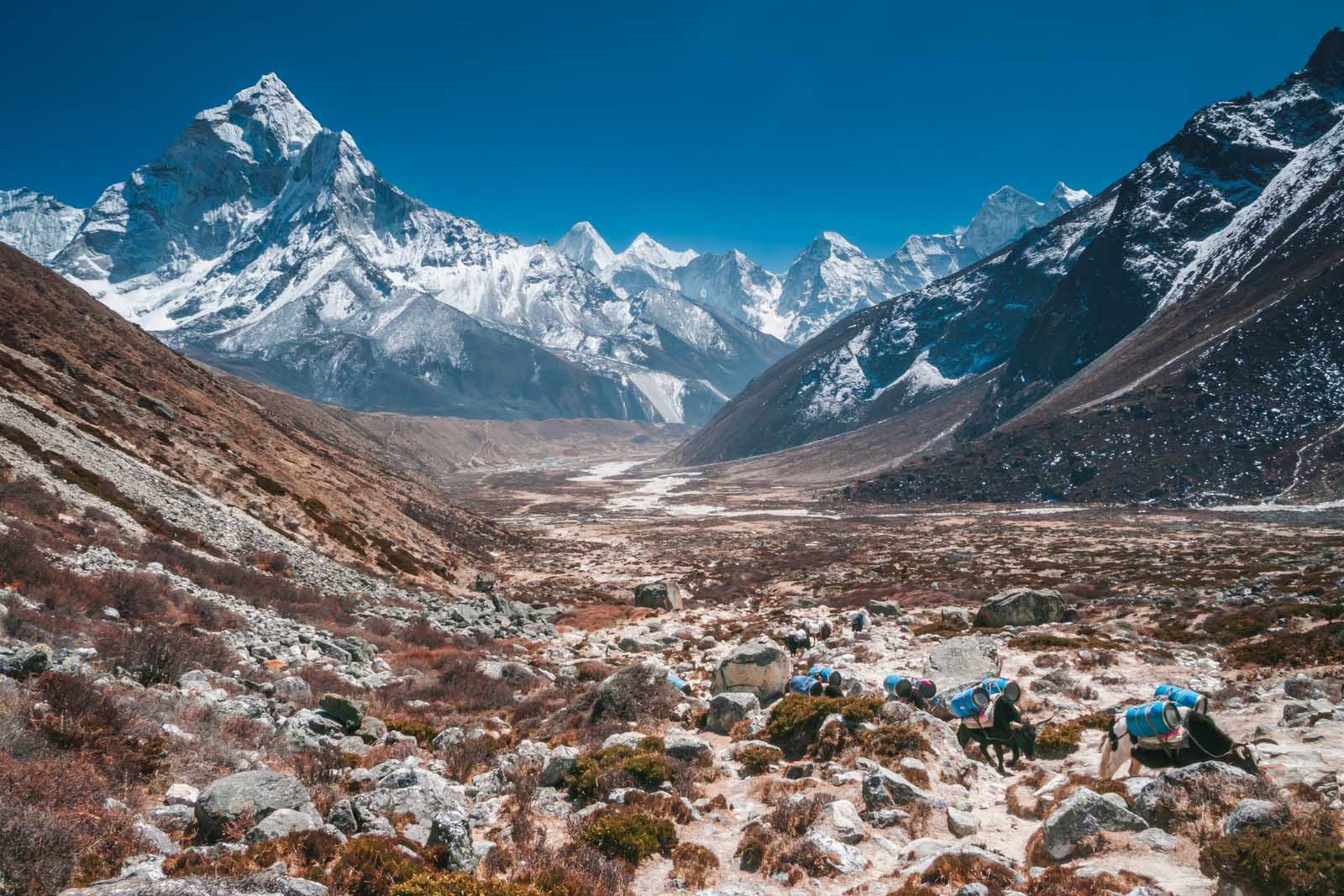
The next morning after a terrible night, we gave up our plans of climbing Kala Patthar and then on to the Gokyo Lakes and Cho La Pass trek. Even though I wasn’t feeling dizzy, nauseous, or lightheaded anymore, the sinus congestion was really getting to me. At altitude a cold can turn serious quickly, you just can’t take a chance when altitude is involved.
But, if we were going to trek on, this would be the next stop. It is supposed to be beautiful and if you are feeling up to it, we highly recommend it. This makes the trek much more interesting as you get to take a different way back to Lukla.
Cho La Pass: Altitude 5420 meters (17,782 feet) Gokyo Ri: 5357 Meters (17,575 feet) Gokyo Lakes: 4,700–5,000 m (15,400–16,400 ft)
Day 9 – The Descent and Kala Patthar
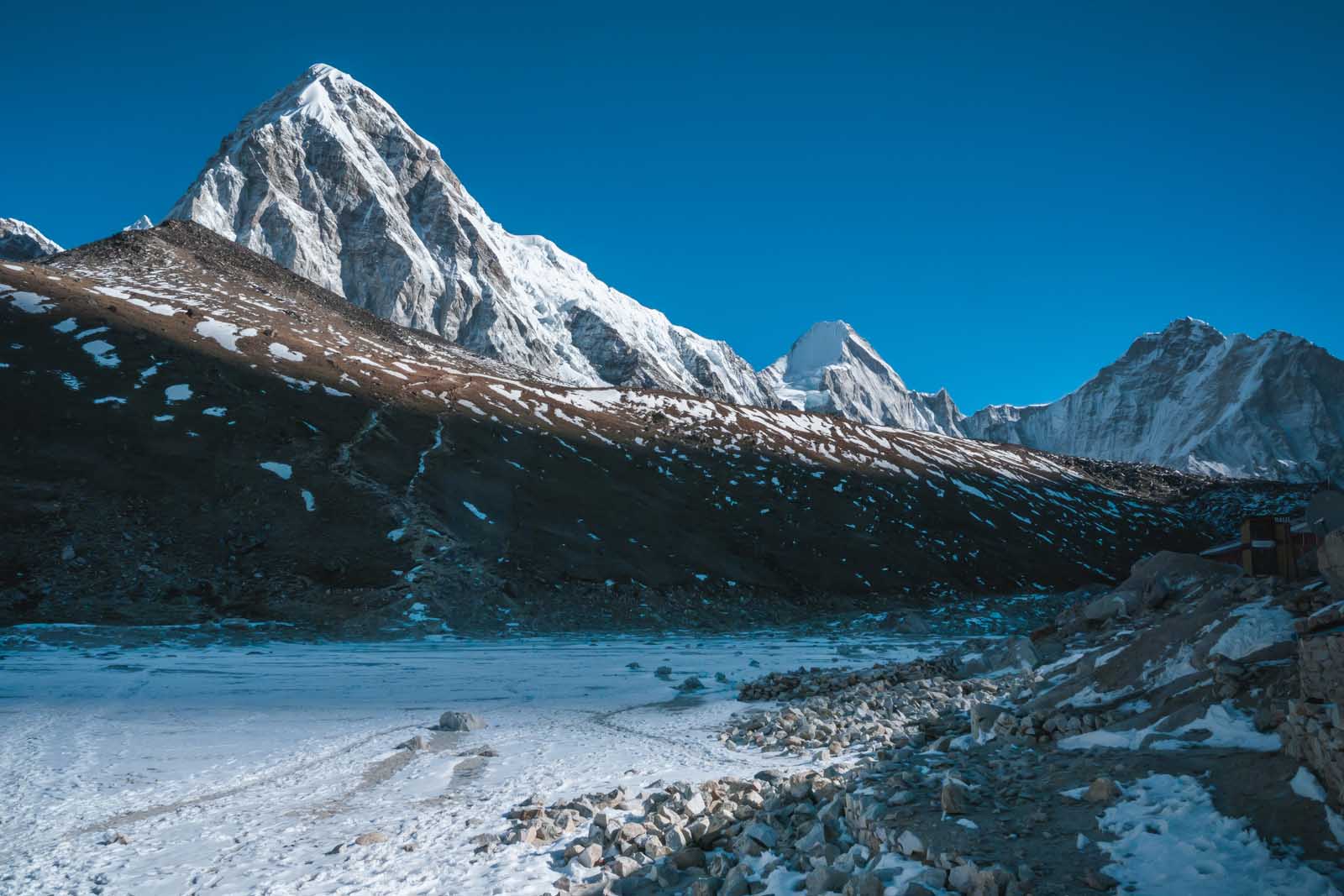
Kala Patthar is a hill above Gorak Shep that offers the best views of Everest and is a must-stop on anyone’s Everest Base Camp trekking route. We had planned to climb to the summit of Kala Patthar, but my congestion was so bad, that we decided it was safer to get to a lower elevation quickly.
Kala Patthar is a quick two-hour trek to add to your descent back to Lukla. It is a good option if you are feeling up for it as it gives a great view of Mt. Everest. Make sure to start early morning before dawn as there is still a long day of trekking after summiting Kala Pattar. Plan on another five or six hours to your next overnight stop at Pheriche.
Kala Patthar to Pheriche – Afternoon
By the time you reach your accommodation at Periche, you should be feeling a lot better. Dave and I find that we are fine in the 4000-meter ranges of altitude and experience very few symptoms of altitude sickness. It is at 5000 meters and above that, we start to feel our symptoms. Periche is a much more manageable 4371 meters.
Kala Pattar: 5643 metres Pheriche: 4371 Meters Altitude Loss : 1272
Days 10 to 11 – The Descent from Everest Base Camp
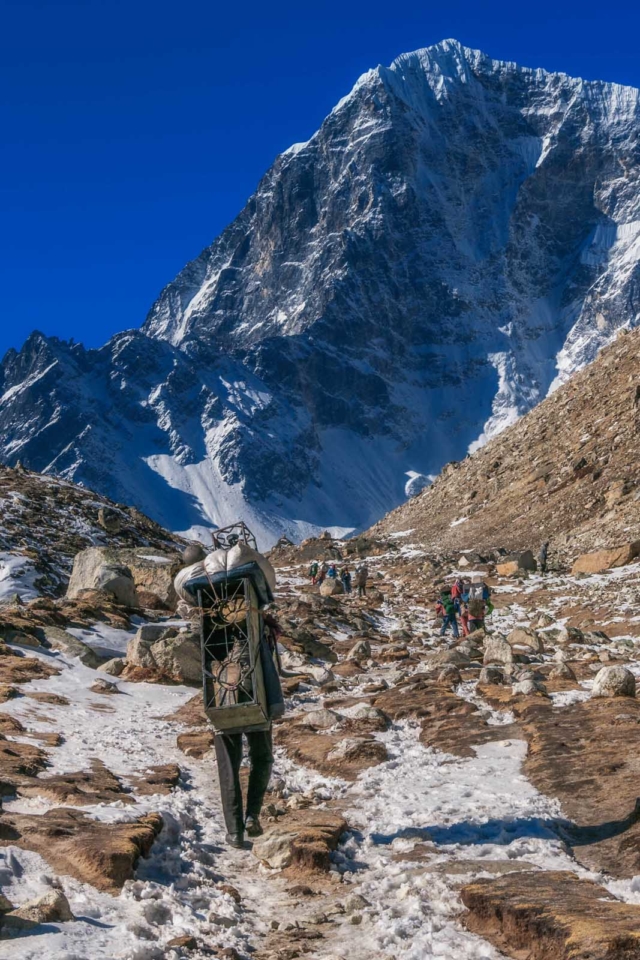
It took us two days more to trek back from Everest Base Camp to our final destination on the EBC Trek. I started feeling better on the second day as the dryness of the Everest base camp disappeared. My sinuses cleared and soon I was breathing easily. I started to feel guilty about turning around, but in hindsight, I know it was the right choice. You never want to take a chance with altitude sickness.
Even though we were heading down, there is still a lot of altitude gain as the EBC trek doesn’t continuously go downhill. I was feeling really fatigued and we still had a tough couple of days ahead of us. But knowing there was light at the end of the tunnel made everything easier.
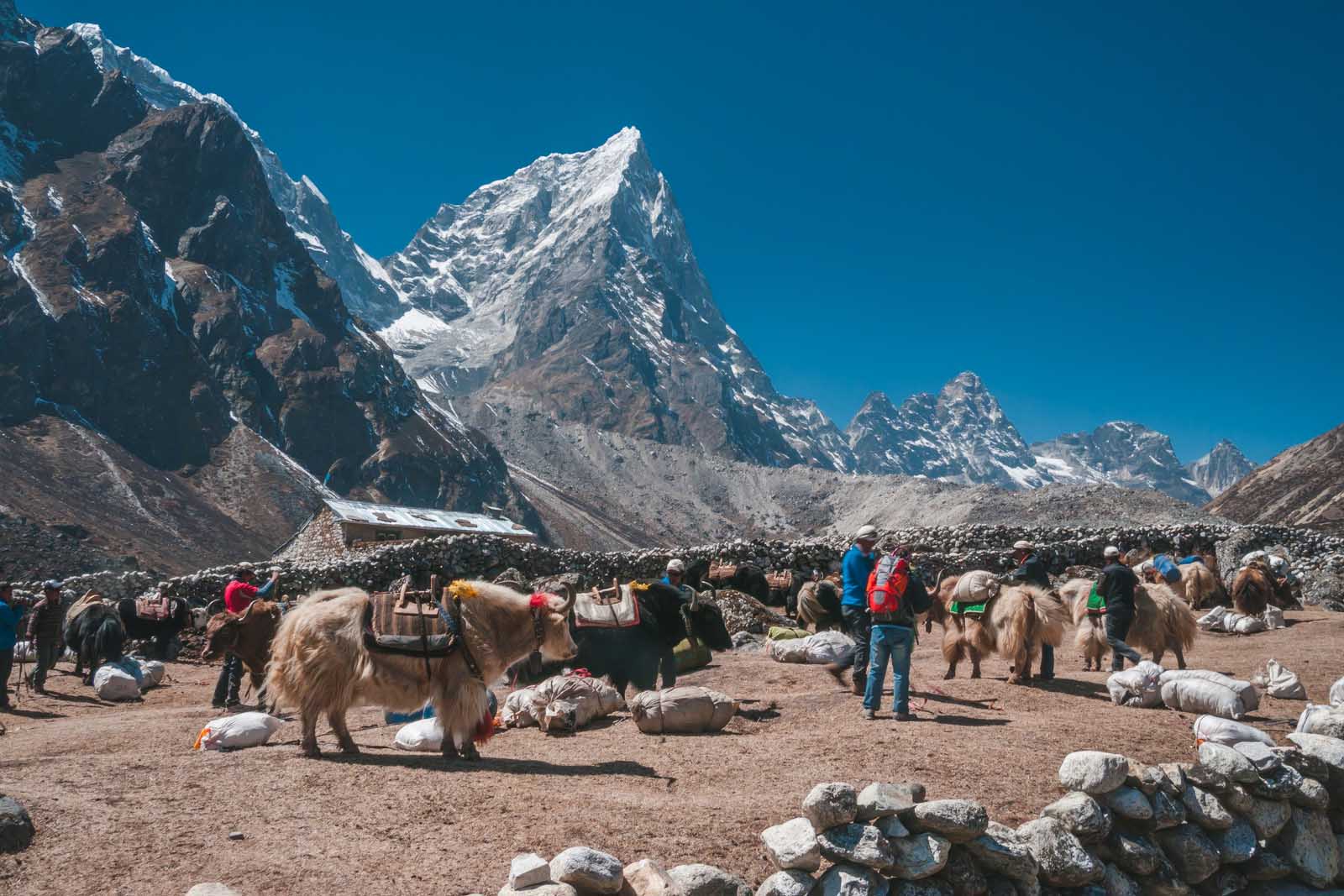
It takes a lot of mental stamina to climb back down as the euphoria of reaching the Everest base camp has worn off, but we made the most of it, by chatting with other trekkers and getting to know our guides better.
During our decent we could actually take our time to smell the roses or should I say enjoy the trekking trail that ran through the stunning rhododendron forest.
Rhododendrons are beautiful flowering plants that bloom in different shades of pink, red, white, and purple. The rhododendron forest is particularly prominent in the areas of Phakding, Namche Bazaar, Tengboche, and Dingboche which we really didn’t notice until we made our way down the mountains.
We followed the route we came up with, but it was much faster and we stayed in different villages. The beauty of booking organized trips with a local guide is that our guide Dipendra knew the routes like the back of his hand, so he could change accommodations easily to suit our speed.

Day 12 – Lukla
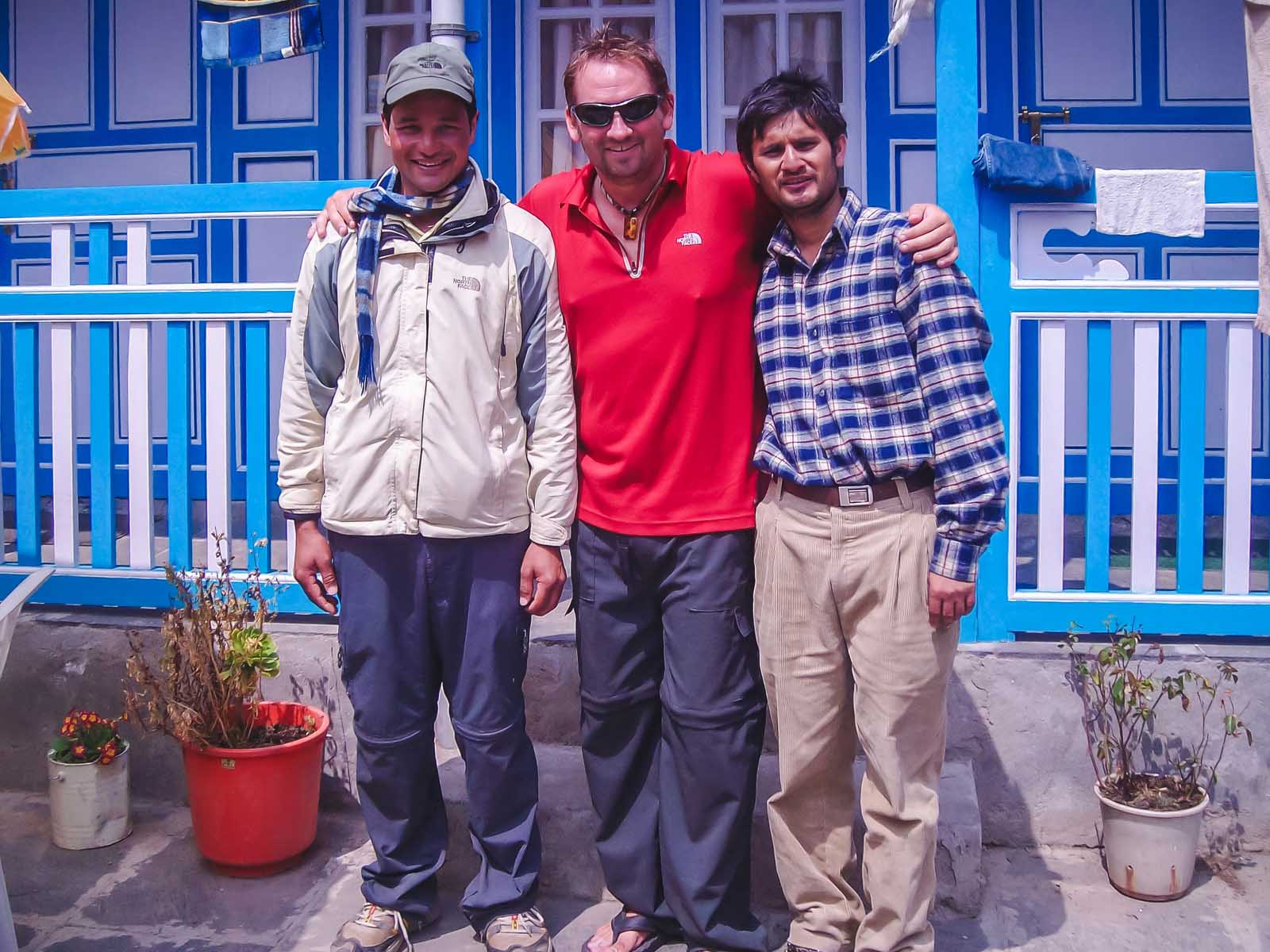
We were back in Lukla early on day 12 of our EBC Trek and had an evening booked in a guest house here to catch the first flight from Lukla back to Kathmandu in the morning. As much as we loved our trip to Everest, we were excited to be moving on to explore more of Nepal.
The accommodation was pleasant with a lovely restaurant, hot shower, and warm and cozy beds. It was a great way to end the trip.
Day 13 – Return To Kathmandu Flight from Lukla Airport
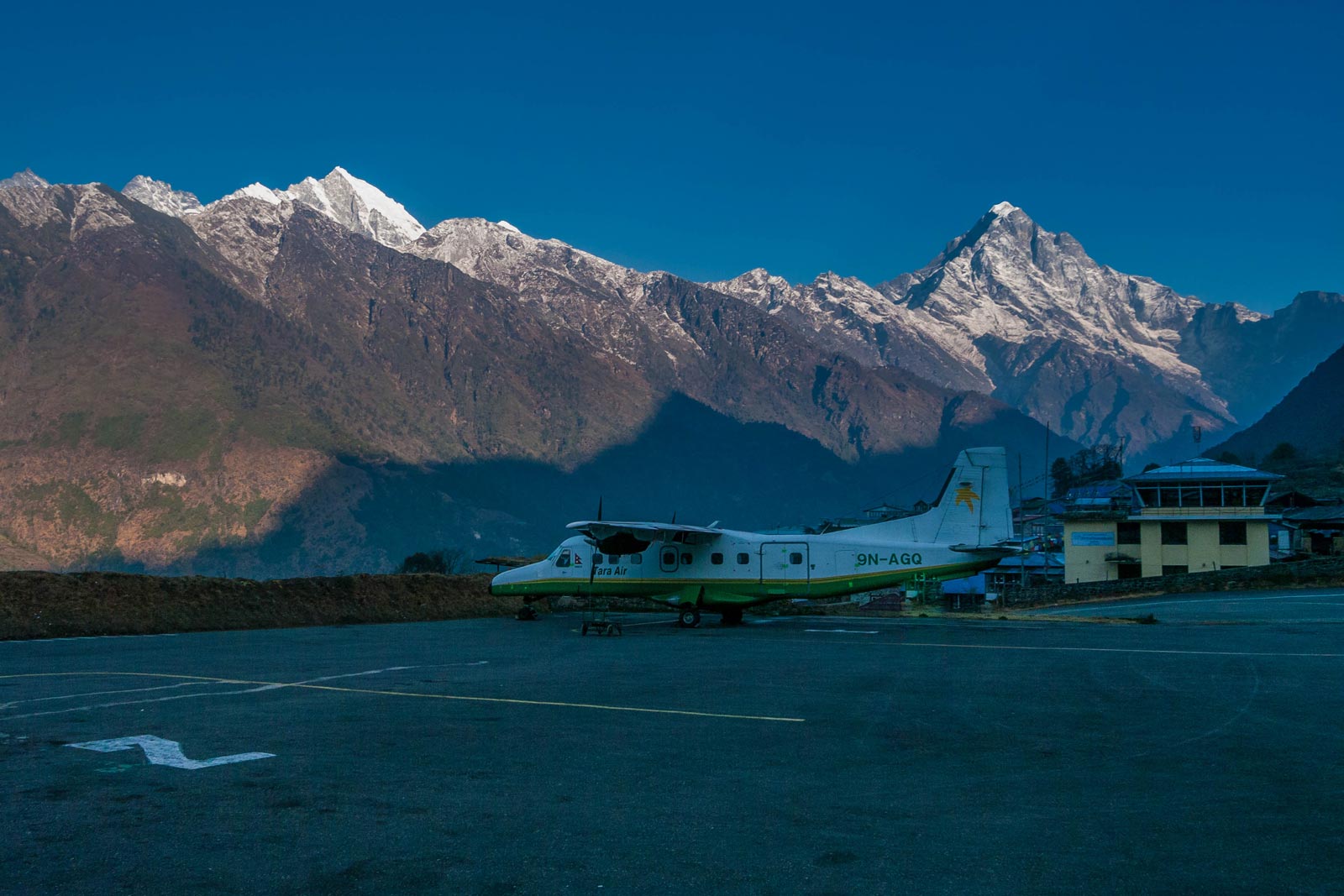
It is very important to give yourself an extra cushion when booking your return flight not only home from Kathmandu but from Lukla. We stayed overnight in Lukla on the final night of our trek and booked a flight to Kathmandu for first thing the next morning.
It is not uncommon for flights to be canceled or delayed flying out of Lukla Airport. Weather conditions change quickly. So give a bit of a cushion when booking your flight home from Nepal after you’ve finished your trek to Everest Base Camp. Many a traveler has missed their connecting flights home from Kathmandu because of delays in Lukla. It is safer to plan to spend a night or two in Kathmandu after your trek.
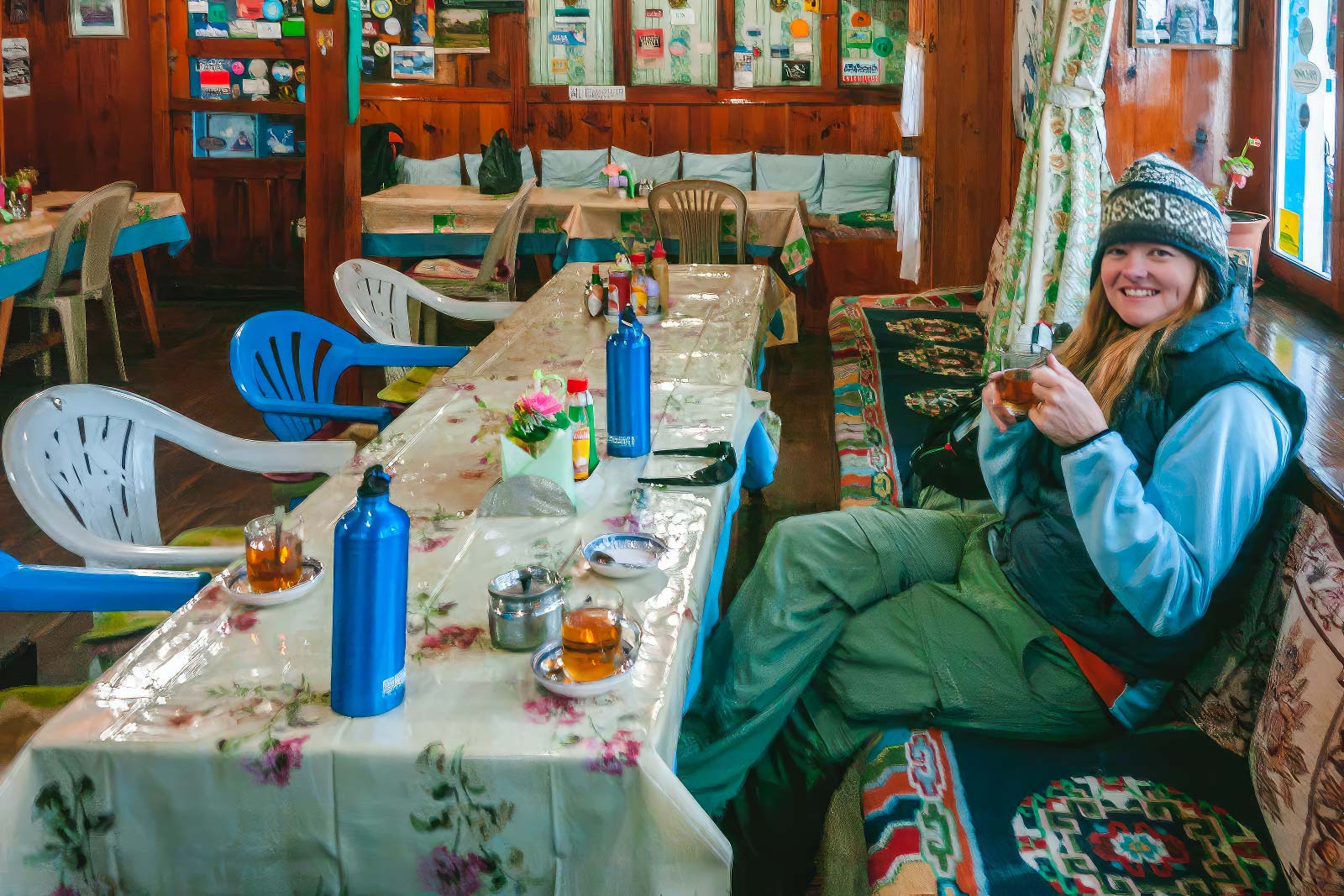
We were delayed an entire day. Even though we were booked on the first flight from Lukla, the weather made us wait until near sunset. We were the first (and only) flight out that day, so everyone else who was waiting for their flights all day was stuck another night.
It was a bumpy flight back to Kathmandu and we almost wished that we didn’t make it on the flight. The turbulence was so bad, I was sure we were going to drop out of the sky.
Everyone on the flight was silent as we were tossed about dropping huge amounts of elevation at a time. But we landed and we have never been so happy to arrive in Kathmandu. We kissed the ground, thankful to have trekked to Everest Base Camp, but vowed to never do it again.
Accommodation – Tea Houses on Everest Base Camp
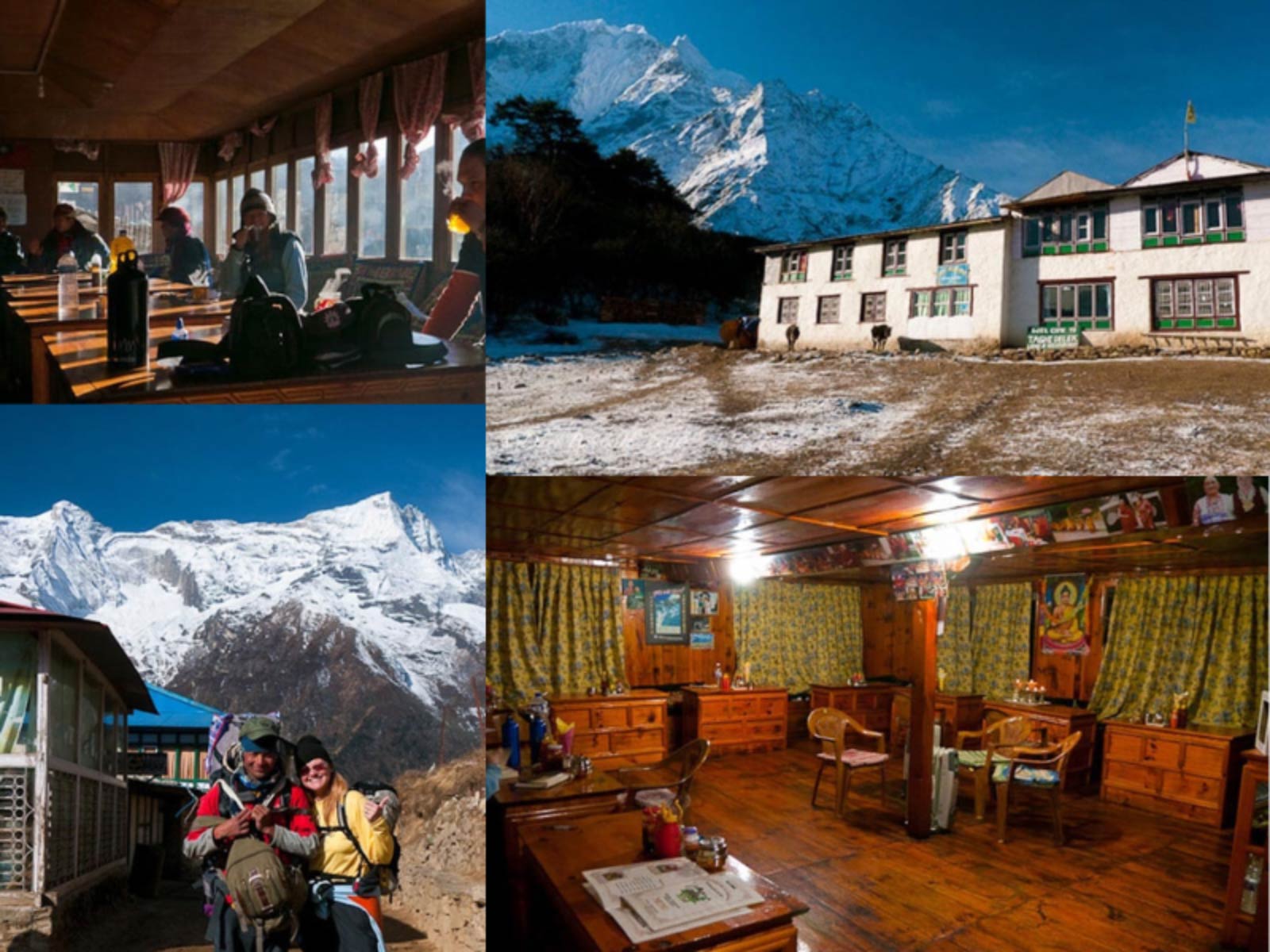
The main lodges of each teahouse we stayed in during the first half of our trip were cozy and warm. At the lower elevations, woodstoves burned wood in the dining room and common areas and our rooms were a comfortable temperature as we were wrapped up in our sleeping bags.
But as we ventured higher, the stoves were less abundant and instead of wood, they burned yak dung. You heard me, Yak Dung. Wood can’t burn in thin air, so they use yak dung to heat the teahouses at high elevations. Rooms are not heated so when we went to our rooms, we had to wear hats, thick socks, puffy coats, and long johns.
There were charging stations at the accommodation for electronics and we paid by the hour for electricity.
- We highly recommend taking a portable USB charger to charge your own electronics.
- We also used a solar USB charger that recharged during the day as we hiked.
Meals on Everest Base Camp
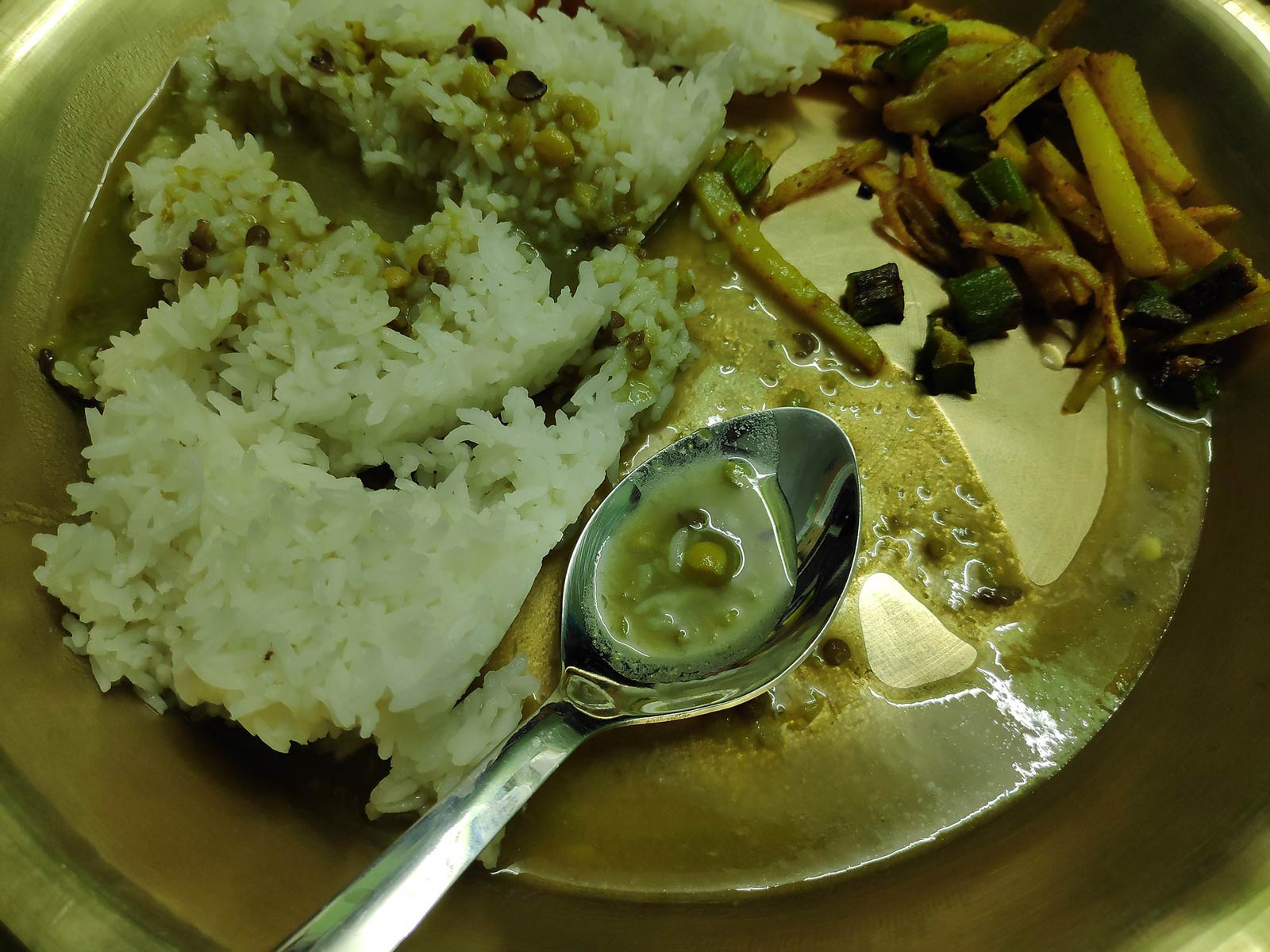
Because we booked an all-inclusive Everest Base Camp trek with Simrik Real Nepal tour company, all meals and snacks were included with our accommodation. Each evening, hearty meals were served that included pasta, rice, or Dal Bhat. Dal Bhat is the staple food of Nepal consisting of lentils, vegetables, steamed rice, and curry.
For the first few days, meat was served at meals, but as you climb higher, meals turned to vegetarian as it is more difficult to get the meat up the mountains.
Prayer Flags and Prayer Wheels – EBC Trek Etiquette
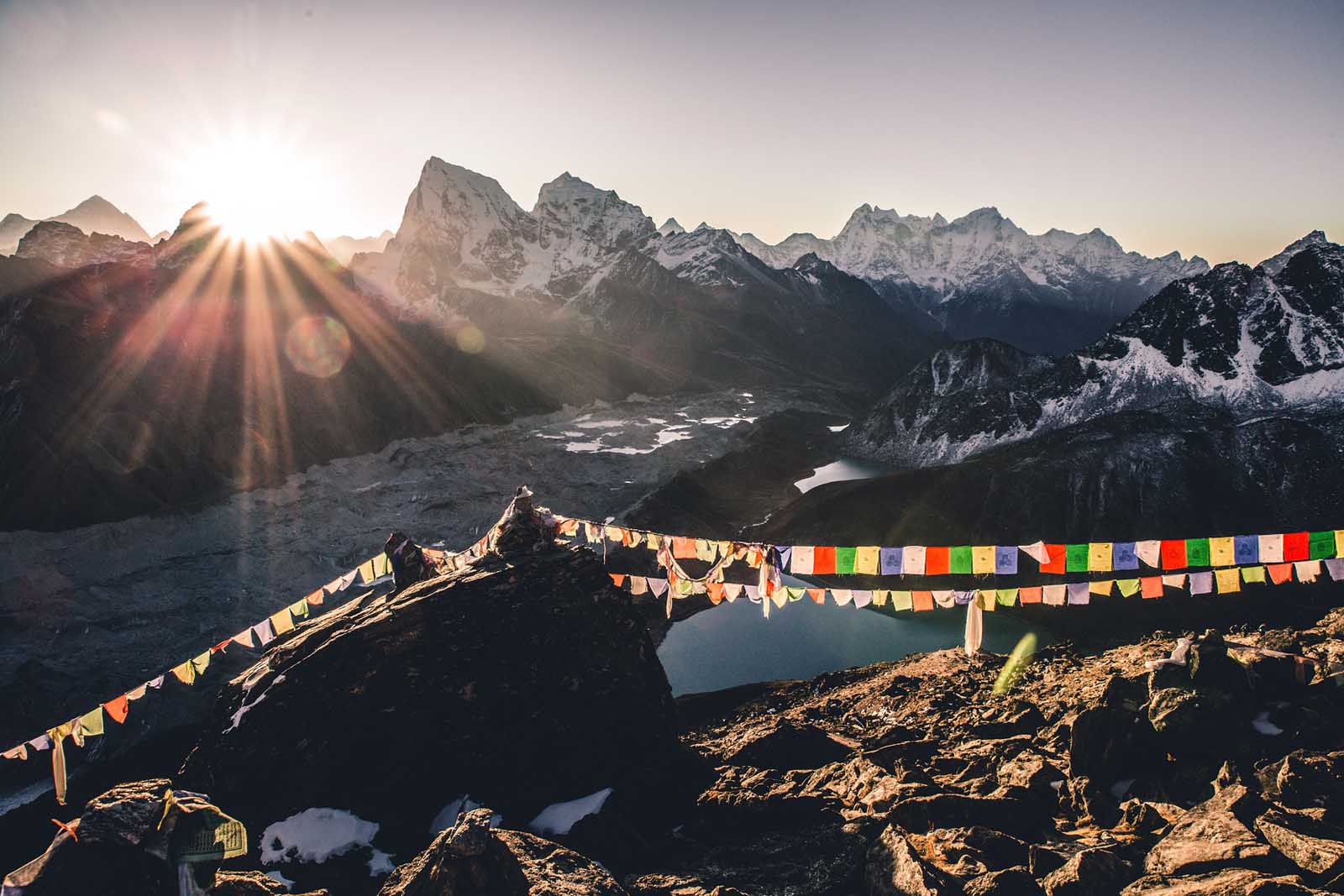
We saw many prayer wheels, prayer flags, and prayer rocks (mani stones) all along the trail to Everest. Everest is a sacred mountain and these monuments help give luck to the climbers on the mountain. There are customs to be followed when approaching prayer rocks or prayer wheels.
How to properly trek around prayer Wheels and Prayer Rocks
- When approaching a prayer rock, it is important to walk to the left of the prayer rocks (mani stones) in a clockwise direction. The stone on the right means you are on the “right hand of God.”
- When using prayer wheels, you walk along and spin them to ask for blessings for the climb ahead.
- Sherpas and locals spin prayer wheels saying the mantra “ Om Mani Padme Hum” giving blessings to the climb ahead.
- The prayer flags have prayers and mantras written on them which are believed to carry messages of positivity and to spread goodwill and compassion they are carried by the wind.
Altitude Sickness
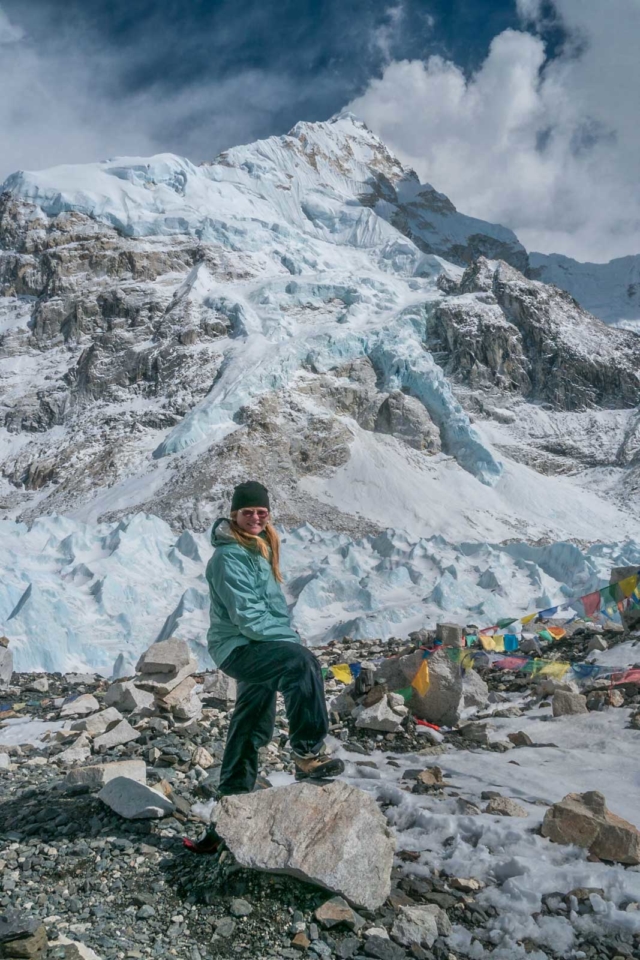
Altitude Sickness is a very real possibility on the EBC Trek. On average 3-5 people die each year doing the trek to Everest base camp. Make sure to keep an eye out for signs of Acute Mountain Sickness. Acute Mountain Sickness is life-threatening and early symptoms include nausea, headache, and vomiting. It can lead to death. The Best way to alleviate symptoms is to go down to a lower elevation.
If you start to feel dizzy, have a pounding headache, or if you start to vomit go down to a lower altitude as quickly as possible. Take your time climbing, stay hydrated, and listen to your body.
Drink plenty of fluids, try to eat, and rest regularly. It is better to walk slowly and steadily rather than rushing at high altitudes. And when you get to your accommodations each day, relax as much as possible.
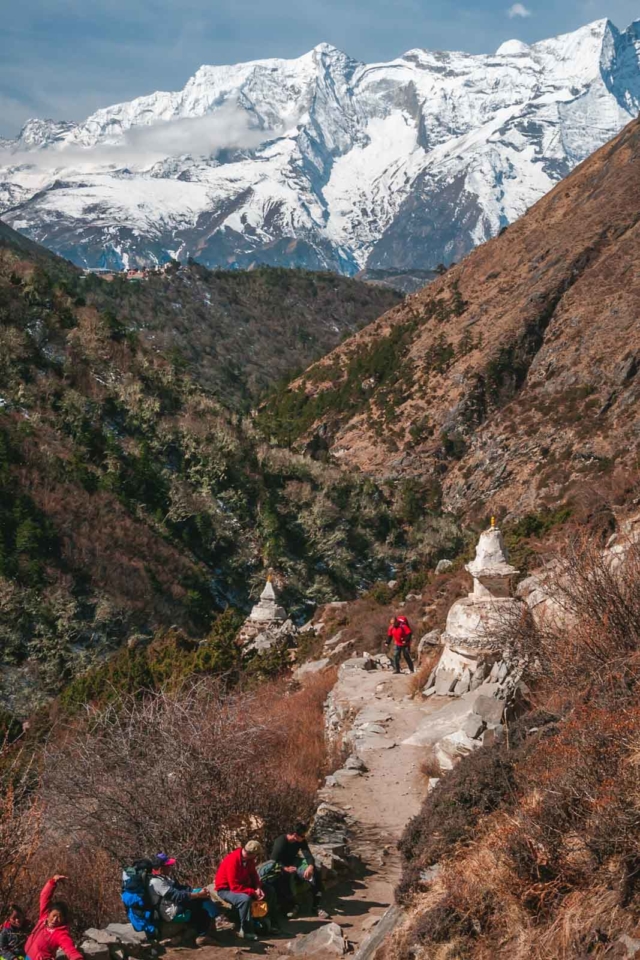
It can be dangerous trekking to Everest Base Camp from falling off the mountain to succumbing to altitude sickness. Some people have simply disappeared. Hiring a guide is a good option (and now the only option) for safety and it is very important to look for signals of altitude-related sickness.
But the Everest basecamp trek isn’t nearly as dangerous as climbing to the summit of Mt Everest. In 2019, 11 people died while trying to summit Mount Everest.
The village of Lukla is located at a high elevation so you will feel the effects of the thin air as soon as you land. The elevation of Lukla, Nepal is 2869 meters (9,350 feet). We were short of breath and already feeling fatigued upon landing. So instead of immediately starting our trek, we had a hot breakfast at one of the many restaurants in Lukla.
Travel Insurance for Everest Trek
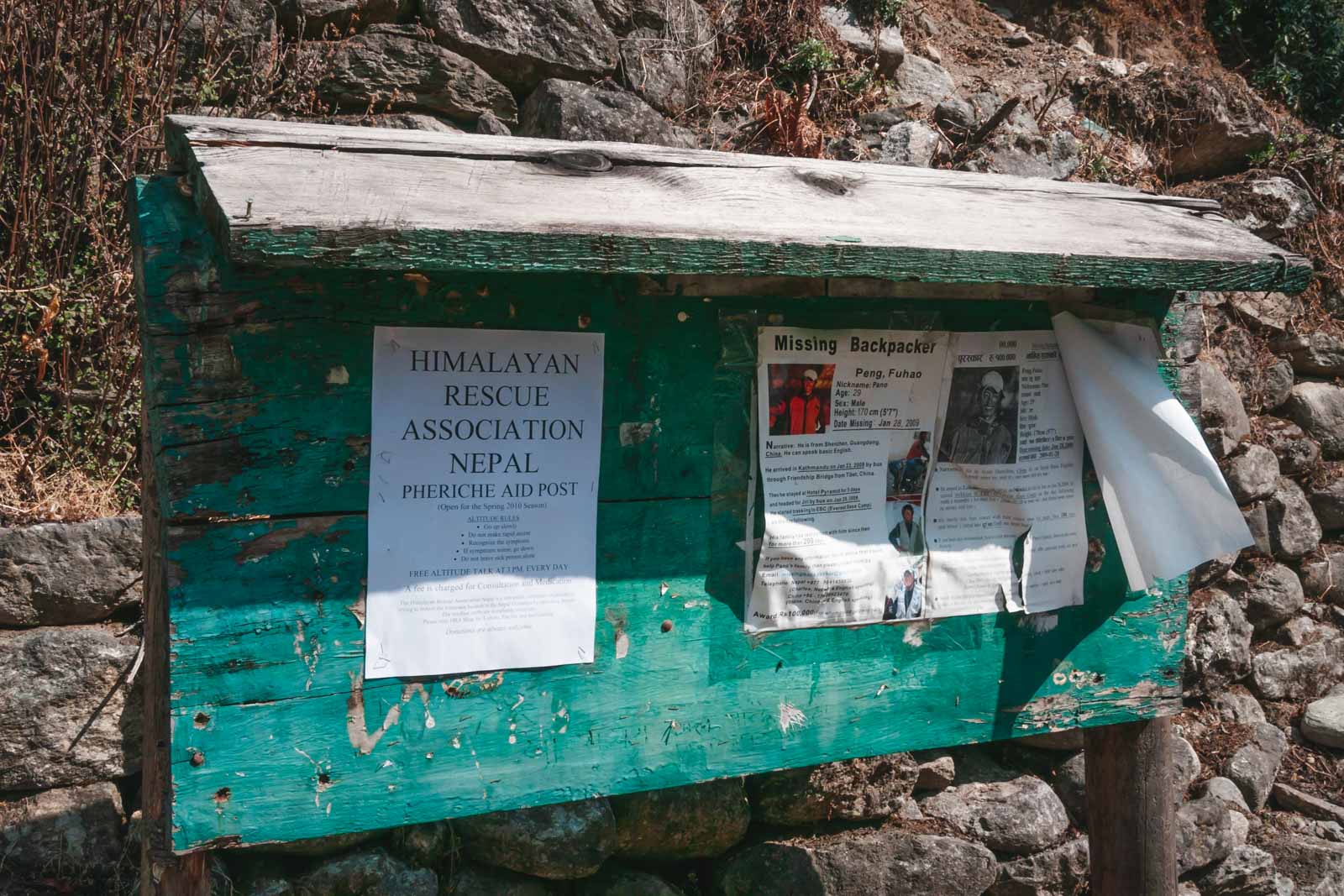
We always travel with travel insurance on our travels, but hiking to Everest Base Camp will not be covered by regular insurance providers. It is highly recommended to get supplemental comprehensive travel insurance that offers trip cancellation insurance, and medical evacuation insurance.
Medjet is a good option for medical evacuation insurance and is a good addition to your regular travel insurance. There is a very real possibility of altitude sickness and we knew of two people that needed helicopter rescues during our trek.
World Nomads offers specific Everest Base Camp Insurance. You can check them out to get a quote. I would suggest a combination of World Nomads travel insurance and Medjet medical evacuation insurance. Regardless of what travel insurance you choose, be sure to call them directly to ask for specific advice about trekking to Everest Base Camp.
For a trip like Everest Base Camp, you will want to make sure to have trip interruption and trip cancellation insurance as well as lost luggage. This is a trip of a lifetime, so make sure you have a backup plan.
Can you Trek Independently to Everest Base Camp?
As of April 1, 2023, Nepal has banned solo trekking. Foreigners must hire a guide for treks in high-altitude trekking regions of national parks. According to the Kathmandu Post in March, “ solo or independent trekkers have to mandatorily hire a guide or a porter before setting off to Nepal’s mountains.” However, after an updated article in the Kathmandu Post, it seems that the Everest Region is an exception. Before booking, we would check with local companies and authorities as rules are constantly changing.
Regardless, we loved hiring a local guide to make oure experience richer, to support the local economy and to feel safer hi
- Our all-inclusive Everest Base Camp Trek through the Simrik Real Nepal included return flights from Lukla, food, lodging, guiding, and all permits and paperwork.
- We didn’t have to search for accommodation at the end of each day of trekking
- We had English-speaking guides and a porter.
- We had our own room, but you can also share rooms on the EBC Trek
- We never worried about the cost of meals. They were all prepaid.
- And our guide (Dipendra) and porter were part of the package for the trip.
Costs for Everest Base Camp Trek
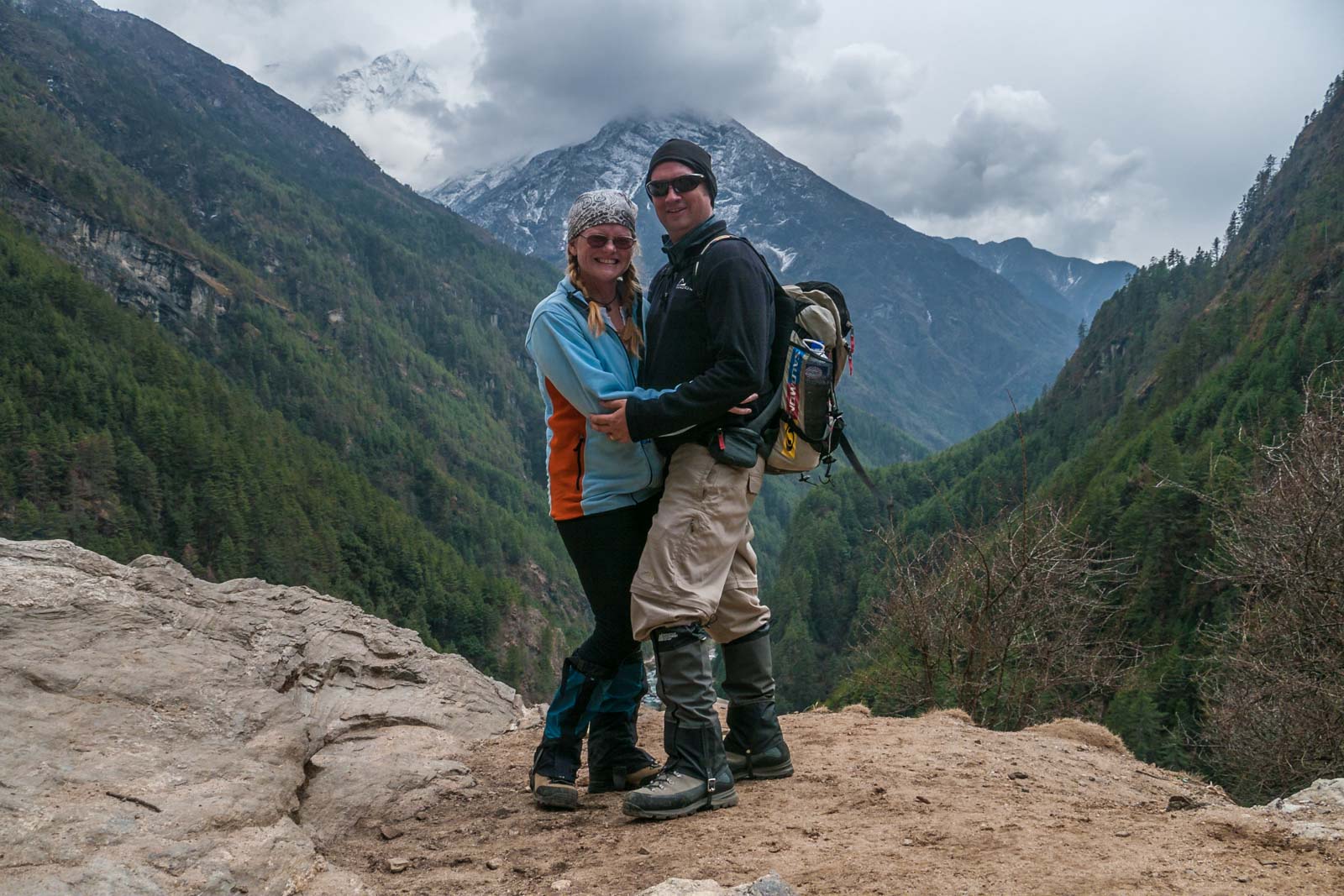
Prices can vary greatly for trekking to Everest Base Camp. You can contact Simrik Real Nepal for up to date prices.
- Booking with an international agency can cost from $1800 – $5000 USD
- Booking with a local agency and be anywhere from $1400 – $2500
W hen is the Best time to Trek to Base Camp?
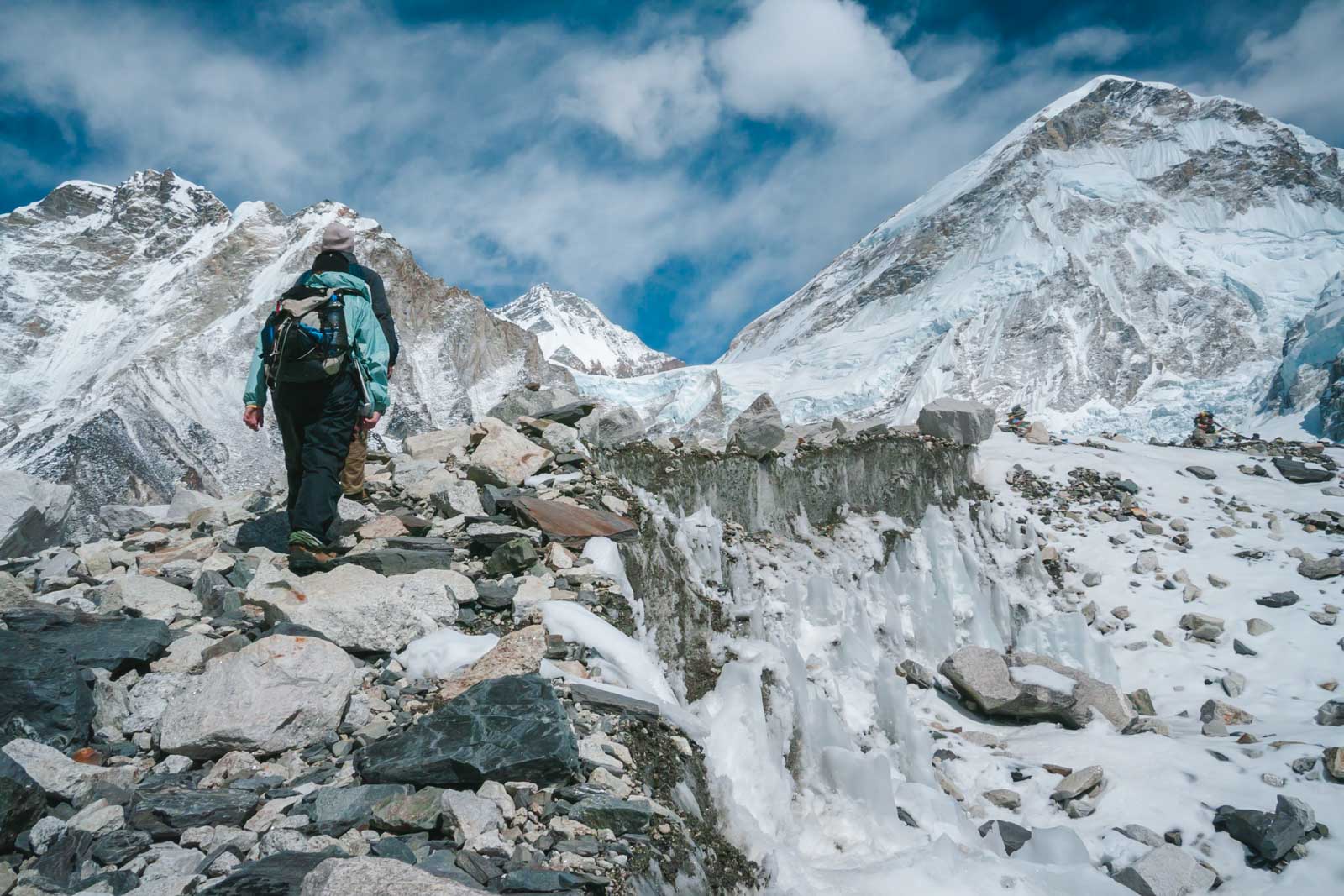
The high season for treks is April to May and October to November. We climbed in early March and felt that it was the perfect time of the year. The weather was beautiful, the skies were clear and the official climbing season hadn’t picked up yet. So we had a lot of the mountain to ourselves. We had heard stories of how busy the trail is, but at this time of year, it was quite deserted.
But a week and a half after our trek started as we made our way back to Lukla, it was already busier. We saw a lot of parties climbing up and the trail was getting congested. I can only imagine how packed the trails are during the high season.
What to Pack For Your Everest Base Camp Trek
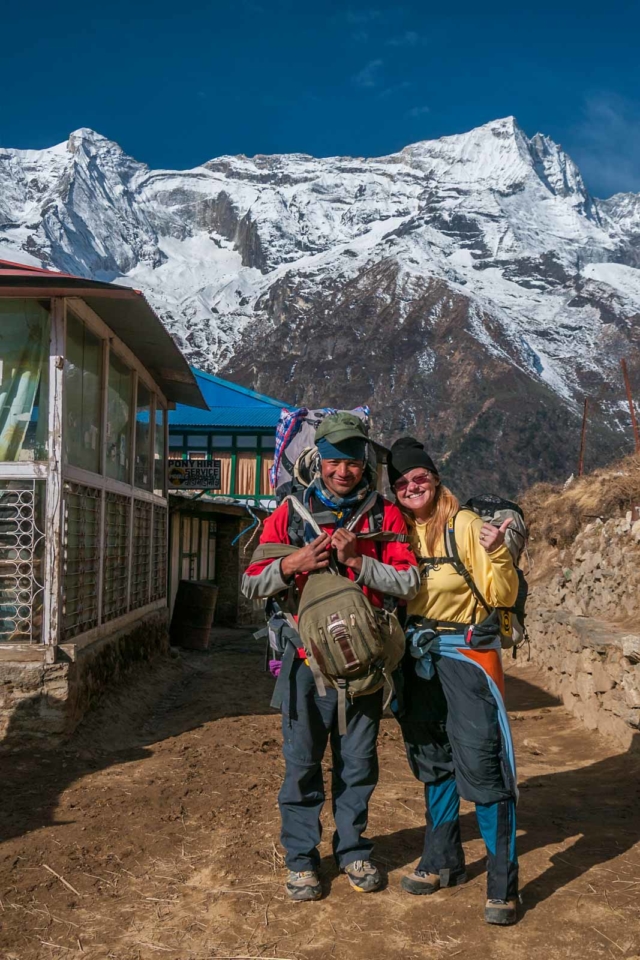
Layering is extremely important when trekking to Everest Base Camp. This is a quick guide for clothing but we wrote a complete packing guide for base camp here .
Make sure to have a day pack to carry the important items and layers that you will need for your day of trekking for the entire trek. Your porter will carry everything else.
- 2 quick drying long sleeved base layer shirts
- 2 trekking shirts short sleeve
- 2 Thermal Base Layer – 2 leggings/2shirts
- 2 liner socks
- 3 pairs of woolen blend trekking socks
- 2 pairs of trekking pants with zip-off bottoms
- 2 fleece sweaters – one lightweight, one heavier
- Outer windproof jacket and pants
- 2 water bottles to fill regularly
- Steripen or Lifestraw – this is great for purifying water
- Portable USB Charger
- Basic First Aid Kit – A first aid kit is important to have but your guide, they will have one as well.
- Warm sleeping bag. If you don’t have a sleeping bag rated to below zero, we recommend renting one from your guding company.
Treats and Medication
- Tang – I was glad we packed Tang for our water. It made it taste better, keeping us well-hydrated. We didn’t really want to drink just water, but the Tang (which we bought in Kathmandu) was actually delicious. Gatorade or another electrolyte-replenishing drink is a great idea.
- Diamox – (You can buy this in Kathmandu without a prescription) I highly recommend using Diamox tablets for altitude sickness as well. We met so many people suffering from headaches, dizziness, and fatigue and they weren’t taking anything. We’ve always used Diamox when climbing to altitude and it has worked beautifully for us.
- Chocolate – When we were feeling ill, we were happy to have chocolate to eat. It was the only thing that we could eat at times.
How to Get Fresh Water on An Everest Trek
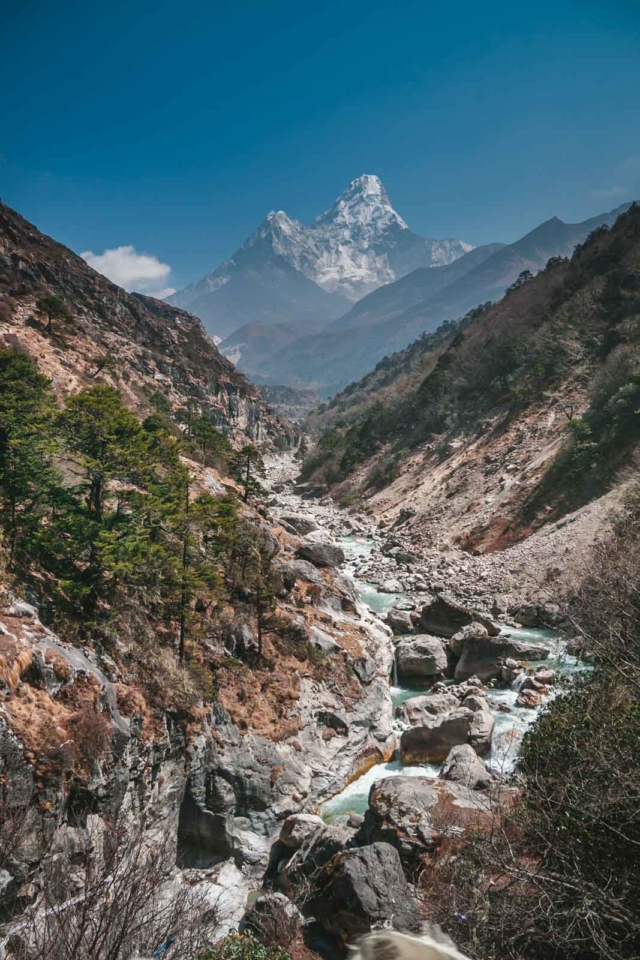
We recommend two refillable water bottles per person that can be refilled along the way. You can fill up anywhere for free along the Everest Base Camp route, but make sure you have a SteriPen or some other form of water purification with you. We love the SteriPen for purifying water, see our review here.
You can also use the LifeStraw or water purification tablets , but once we discovered the SteriPen , we never went back. See our complete Packing a Travel First Aid Kit here
Do You Need Climbing Experience for Everest Base Camp Trek?
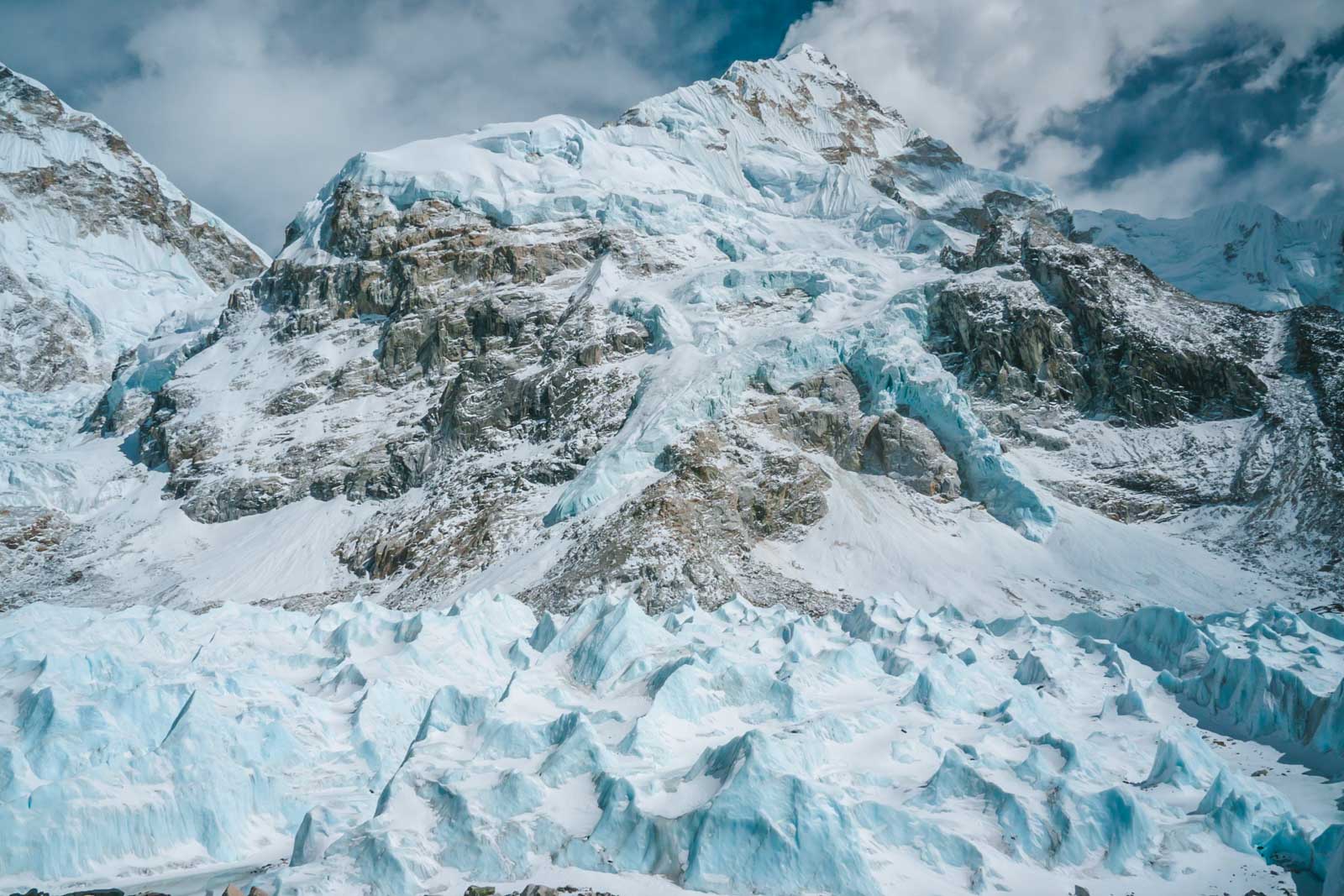
There is no need for any technical climbing experience to make it to Everest Base Camp. If you are relatively fit, it is very doable. But it is a full two weeks at a sustained altitude of over 4000 meters.
We didn’t train for our Everest Base Camp Trek but we had been to altitude before and had spent a lot of time backpacking leading up to the months prior. It’s good to know how your body reacts to altitude. We suggested doing a couple of treks above 3000 meters (9000 feet) to see how your body reacts.
Hot Tips for Trekking to EBC
- Keep your camera batteries close to your body when not in use. The cold and altitude really eat up battery life, so you will want to keep them warm for as long as you can.
- Bring USD, ATM Fees are high and you are limited to the amounts you can take out of the ATM, so have ISD to exchange instead.
- Pack handi wipes and Gold Bond Powder – it’s a lifesaver when you can’t get hot showers.
- See our Full list of Everest Base Camp Tips here.
How to Get to Everest Base Camp
There are daily flights to Kathmandu International Airport from international hubs around the world.
Where to Book Your Everest Base Camp Trek
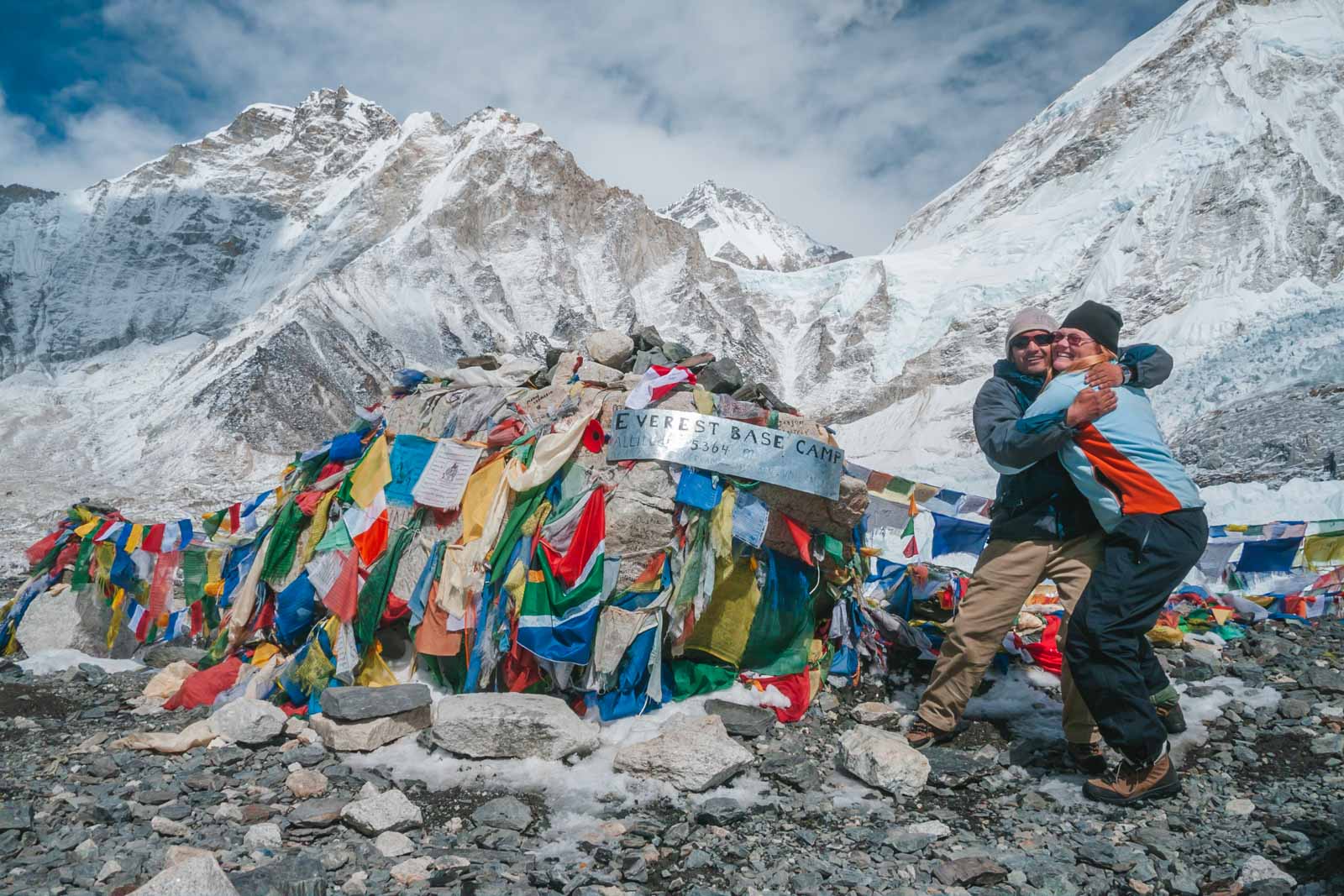
We booked our trek in Kathmandu with Local Guide Dipendra of Simrik Real Nepal. If you are looking for a local guide he is an excellent choice with nearly 20 years of experience in the mighty Himalayas.
Prices for the Everest base camp trek cost can vary depending on where you book. Group tours booked in North America will charge more. Ranging from $1500 – $5000 USD
You can save a lot of money by booking a local guide as you will cut out the middleman prices. Having a local guide let us know our money was going directly to the Nepal economy. Check with Simrik Real Nepal for current prices.
How Much to Tip Guides and Porters for an EBC Trek
Guides and porters in Nepal do not make a lot of money and rely on tipping. When we take tours of any kind, we (ourselves) tip 15% – 20% but that is a part of our culture in North America, we are quite large tippers and realize that others are not comfortable with that. We’ve done a lot of research and gone by what our tour companies have suggested on other tips, what we feel is a fair tip and what the average is across the internet.
For tipping in Nepal we have broken down the cost for a guide and porter.
Guide – Tipping – 10% – 15% of the total cost of the trip. We find this the easiest to figure out. If you paid $2000 for your trek, the lead guide should receive $200 – $300
Guide per day – Some suggest $10 – $15 per day per person for guides – For a 14 day trek that means you would tip your guide $140 – $210.
Porters per day – $5 – $10 per day per person for porters. – $70 – $140 for your porter.
We like to start at 15% of the total cost of our trips to give to the guides and then pay the porters a daily fee of $10.
If you can afford to trek to Everest Base Camp, you should be able to tip your guides and porters who have worked so hard accordingly.
Daily Life in the Everest Region of Nepal
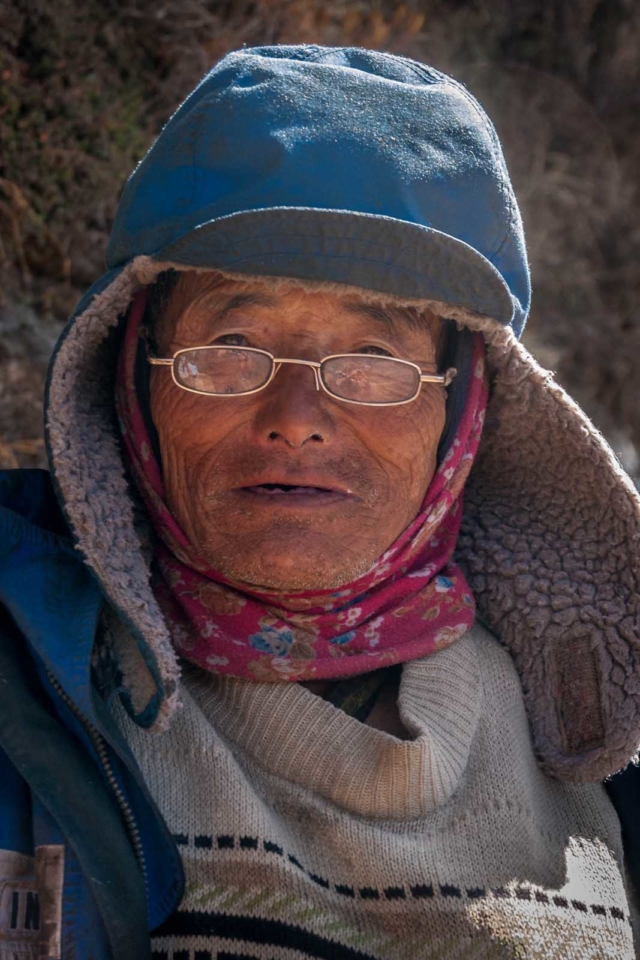
While trekking to Everest we passed through many picturesque villages. The people are friendly and life goes on as it would in any community in Nepal. People do well in the Khumbu Region and they respect the tours passing through because the tourists are what keep them going.
There is electricity from the water that they harness from the Imja Khola River and Dudh Kosi River; two rivers that run through the trek. They also have solar power for electricity as well. There are schools, fresh running water, televisions, a health clinic, and bars.
That is not to say that life is all roses. It is a remote region of Nepal and it is difficult to get any supplies in. Food and equipment need to be carried into villages on foot. Porters carry heavy loads on their backs and women and children also do the heavy lifting. Everything needs to be carted in by hand or by animals. Check out our tips for climbing to Base Camp
How Long Does it Take to Trek to Everest Base Camp?
The Everest base camp trek takes 12 – 14 days to climb including two acclimatization days. Treks can be done in 11 days and it is not uncommon for trips to take 15 days to allow for more acclimatization.
How Difficult is it to trek to Everest Base Camp?
Trekking to Everest Base Camp requires good fitness. You spend several days at a sustained altitude of more than 4000 meters (16,404 feet). Altitude sickness is a genuine possibility, it is important to take your time, stay hydrated, and listen to your body.
Can you trek to Everest Base Camp on your own?
As of April 1, 2023 the government states that all high altititude treks require a guide, but then after some backlash, they made an exception for the Everest region. However, we highly recommend hiring guides and porters . You can trek the region yourself carrying your own packs and gear, but you have a much better chance of making to base camp (and enjoying the experience) if you hire guides.
How Long is the Everest Base Camp Trek?
The trek is 63km (39 miles) each way . 126 km (78 miles) round trip from Lukla. Expect to hike anywhere between 7 to 17 km per day.
And that is a day-by-day breakdown of our experience on the Mount Everest Base Camp Trek. If you plan ahead and understand what to expect on the EBC Trek, you will be sure to have an amazing journey.
It’s an experience we’ll never forget and highly recommend it to everyone. The Himalayan Mountains are the most beautiful and spiritual place on earth and this trip will change your life.
Read More about travel to Nepal and things to do in Kathmandu before your trek
- Flight to Lukla
- Packing list for Everest Base Camp
- Remarkable Everest Base Camp Trek in Photos
- 30 Tips for Trekking to Everest Base Camp
- Nepal Travel Guide
- Top 6 Places to visit in Kathmandu, Nepal
- Where to Eat in Kathmandu – Eight Great Spots to Indulge After Your Trek
- The Ultimate Travel Songs Playlist to Inspire Wanderlust
Dal Bhat photograph courtesy of Wikimedia – I don’t know why we never took a photo of our Dal Bhat. We ate it nearly every day while trekking to Everest Base Camp. You’ll either learn to love it or despise it.
- Inca Trail – Machu Picchu Hiking Tips – How To Hike the Inca Trail
- Complete Guide to Climbing Mount Kilimanjaro – How Hard is It?
- Top 13 Best Treks in Nepal to Help you Choose The Right Trek for you
- Trolltunga Hike – Trekking to Norway’s Most Famous Landmark
- The Complete Guide to Climbing Mount Fuji
Travel Planning Resources
Looking to book your next trip? Why not use these resources that are tried and tested by yours truly.
Flights: Start planning your trip by finding the best flight deals on Skyscanner
Book your Hotel: Find the best prices on hotels with these two providers. If you are located in Europe use Booking.com and if you are anywhere else use TripAdvisor
Find Apartment Rentals: You will find the cheapest prices on apartment rentals with VRBO .
Travel Insurance: Don't leave home without it. Here is what we recommend:
- Allianz - Occasional Travelers.
- Medjet - Global air medical transport and travel security.
Need more help planning your trip? Make sure to check out our Resources Page where we highlight all the great companies that we trust when we are traveling.
You May Also Like
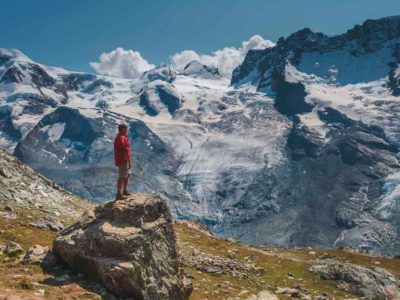
30 Beautiful and Best Hikes in the World
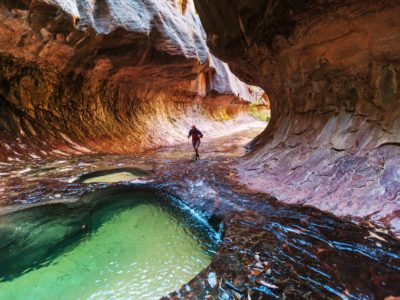
24 Best Hikes in the USA to Add to Your Bucket list
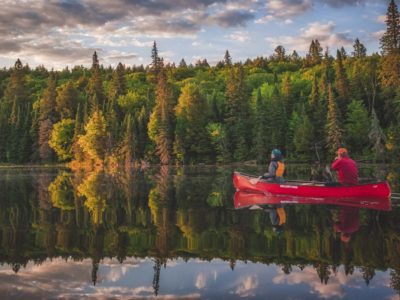
Weekend Warriors – 14 Awesome Hobbies to Turn You Into an Adventurer
About The Planet D
Dave Bouskill and Debra Corbeil are the owners and founders of The Planet D. After traveling to 115 countries, on all 7 continents over the past 13 years they have become one of the foremost experts in travel. Being recognized as top travel bloggers and influencers by the likes of Forbes Magazine , the Society of American Travel Writers and USA Today has allowed them to become leaders in their field.
Join thousands of others who get our monthly updates!
Leave a comment cancel reply.
Save my name, email, and website in this browser for the next time I comment.
53 thoughts on “Everest Base Camp Trek – Ultimate Guide For 2024”
Beautiful article! You have shared a thrilling journey with us till the end. It will definitely be useful for us trekkers. Thanks for the great pictures, videos, and useful tips!
This is a fantastic and unique post! After reading it, I learned a lot about Basecamp that I didn’t know before. Excellent article! That is true adventure, and conquering Mount Everest is without a doubt the goal of all hikers around the world. Keep up the excellent work. Thank you for providing this information.
Wow, the content has got all the details about the trek. Thank you so much for sharing your Journey experience of Everest Base Camp Nepal.
Hi There, Great Article! That’s the real adventure and especially climbing Mount Everest is the dream for all hikers across the globe without any doubt. Keep up the good work. Thanks for sharing.
Wow, the content has got all the details about the trek. Thank You so much for writing such an efficient article on Everest Base Camp Trek.
That’s the real adventure and especially climbing Mount Everest is the dream for all hikers across the globe without any doubt.
Thank you for taking the time and effort to produce such an awesome post with amazing pictures. Loved reading all your posts, really good insights here into Everest Base Camp ! Looking forward to read more.
Nice article on trekking best of luck for your new journeys
Dear Dave and Deb Namaste It is really beautiful article regards of Everest base camp trek in Nepal. Your article provides a lot details of the EBC trek. I’m sure your blog helping lot to organize other trekkers.
Excellent article. Everest Base camp is in my bucket list but I haven’t attempted because I’m prone to sickness quickly. Reading this article has triggered the interest even more. Thank you so much for explaining in detail about EBC trek. I hope One day I too can share my experience 🙂
Hey, I love trekking, I went last month with my friends in Nepal after reading your blog the memory are refreshed Thank you for sharing
Namaste, Dave and Dave, Thank you so much for sharing your Journey experience of Everest Base Camp Nepal. And also glad to read that why not support the local economy by hiring a guide and porter… I salute to your positive view. Visit Nepal anytime.
It is very interesting to read this Everest base camp trekking. I love trekking and i am excited very to do this base camp trekking once. Thanks for sharing.
This popped up in my inbox I love the way you break down your travel itinerary this way. I’m one of those people that love to know every detail of a place before travelling there myself. Another place to add to the list, thanks to you guys! Beautiful photographs.
Thank you for taking the time and effort to produce a terrific blog of your trek to EBC. I really appreciate being able to experience what it is going to be like before I actually arrive.
Everest is the highest mountain. It is at the Zenith. Most of the people just a dream of it.Very useful information. Thanks for sharing with us.
Excellent article !! Thanks for sharing such a great informative post it really helpful and amazing so keep it up and all the best………….
this was just amazing… keep sharing
The post was very informative. If you love adventure and treks you should definitely visit Nepal, it’s gonna be a life time experience. This post will really help people who are planning their next trek to Everest base camp. If you are planning your next trek to Nepal, North Nepal Trek can help you to make your trek much easier and will give you unique experience.
All of your photos are just awesome. Information is perfect.
Such an awesome post with amazing pictures. Thanks for sharing your experience with us.
This is really a very good blog post and thanks for sharing it with the community
It’s an informative post and I was thinking how you backpack for the weather? There are many things that somewhere can’t be cope at altitude like a sickness. I remember I scare when I attempt sky diving in Dubai. It’s was a wonderful experience but I have a fear of altitude places.
I have read about it but never tried. I am glad that at least i am reading such an informative article that clearly shows experience of treking over there. It might so much exciting and filled with happiness because seeing something like that would always be more of fun and achieving some of our own. Would love to try it once for sure!
Hi guys. Nice blog. Very informative. I just wonder, how did you prepare for the weather? How did you acclimatise so that you can cope with thr danger of altitude sickness? It is the ine thing that scares me to try to trek on high altitude places. To climb Kilimanjaro and to reach the EBC are in my bucket list. I’m hesitant because of my fear that I might die from cold temperature and altitude sickness.
Dress in layers, and drink plenty of water. You will want to bring DIamox with you and take it. You can get it in Kathmandu, or go to a travel clinic before leaving home. You won’t die from cold temperatures at Base Camp if you have a proper guide, and dress properly. The real dangers are if you are summitting Everest, that’s when you can get into problems, but Base Camp is very doable for anyone that is physically fit. If you don’t have the gear, you can buy winter coats, boots etc in Kathmandu. But we do recommend breaking in your boots beforehand, so you should buy those before you leave home and wear them a lot. Get warm, waterproof breathable boots with wool socks and bring several pairs. We have a guide to winter base layers to avoid the deep freeze here: https://theplanetd.com/layering-tips-for-cold-weather-travel/
Loved reading all your posts, some really good insights here into EBC! You mention putting your hair in braids, why is that? Is it because of the sweat? Is it windy so it gets knotted up? Just curious as I am doing this trek in a week and am open to all tips ?
Yes, hair can get really matted due to wind, dryness and lack of showering. The Braids kept it from matting up like dread locks. Have a great time!
Long hair can get very matted almost like dread locks. It’s becuase there aren’t a lot of chances to shower after Namche Baazar, the wind, sweat and dryness from altitude really takes its toll on both hair and skin and the braids, keep the hair from matting and breaking off.
Great read! Just curious. what time of year did you go to avoid the masses of tourists?
Thanks for sharing articles and videos it will be helpful to all people those wants to go Mount Everest.
This is just amazing and knowing each and every experience that we will have while travelling is another aspect that made me read this article fully. I am in Dubai now on a trip and would surely try to visit this place i could. I should consider the right time and other things roo. I must thank you for this wonderful piece.
Such a great journey you have shared from start to finish and your presentation is also impressive. I would love to follow these things when I will go for a camp tour.
Regards, Ronit
Your Video is superb, I feel your treking experience in this article. worth to read it.
Wow what an wonderful place is this. Want to trek this place in my life.
Great article, thanks, surprised at the early time of year you did the trek, but sounded ideal – any other good write-ups or links discussing the pros and cons of going in the spring vs fall? …weather, landscape, crowded w/ other trekkers, festivals, etc Thanks!
I am looking forward for this kind of base camp.
What an excellent post!! Thank you so much for an informative article and personal feel. This is very helpful and inspiring for my upcoming trek to Everest Base Camp.
There is so great view in pictures.it’s useful and helpful for the trekkers .i like these types of views .and tourist are also love these types of views.
Anyways amazing photos and love the videos! really gives you a feeling how it is there and must be just thrilling. Looking forward to read more about your travels.
Nice Articles and sharing a good details of Everest base camp and amazing photos. I will try to go this year Nepal and go to Everest Base Camp.
Great post. I am doing the Everest Base Camp trek in October. I completed the Annapurna Circuit in 2012 and loved it. Nepal is a such a lovely place and the people are amazing. Thanks for sharing!
Wow congratulations on your trip and everything looks really cool. I would love to do the same! Did you train a lot before you went there? Did you prepare physically? I don’t know how fit I have to be to be able to take on such a travel. Anyways amazing photos and love the videos! really gives you a feeling how it is there and must be just thrilling. Looking forward to read more about your travels.
Hi Marus, we didnt’ train a lot before. We were traveling a lot though. Before heading to Nepal we spent 4 months traveling Sri Lanka and India. We did a yoga retreat and a lot of hiking and walking, but we didn’t do any proper training. We were in relatively good shape. It’s mostly just a long uphill hike. The difficulty is being at altitude for a sustained amount of time. It affects everyone differently. Some people can be in tip top shape, but not do well at altitude and vice versa. So, it’s best to take it slow and steady, drink plenty of fluids and pay attention to how you are feeling.
All your photos are simple awesome and your posts are speaking a lot of useful information. Thank you for sharing this article.
Thanks for your beautiful video. I fell a little up lifted seeing this. I believe one of the prayer flags is for a lady I knew. Inspiring. I wish I would have done adventurous things like this when I was young. Young people don’t put off adventure.
I’m glad I read this. This is something I have always wanted to do but have been a little nervous to think about doing it when the climbing season is in full swing. The time of year you went and the company you chose make a lot of sense! Thanks for sharing.
The views are amazing!! I love adventure, but I would definitely need to build up my stamina to do the Everest Base Camp trek. It looks like it was an awesome experience for you!
Wow, what a beautiful experience. Your photos are amazing!
-Siggi The Voyaging Viking
Amazing! Can’t wait to check this off my list!
Thanks for writing this.
Thank you for sharing these helpful tips. Your post has given me some great ideas. Thanks again for the valuable information!

- Everest Region Trek
- Annapurna Region Trek
- Manaslu Region Trek
- Mustang Region Trek
- Langtang Region Trek
- Makalu Region Trek
- Dolpo Region Trek
- Kanchenjunga Region Trek
- Best Selling Treks
- Nepal Trekking
- Luxury Treks in Nepal
- Challenging Treks in Nepal
- Family Treks in Nepal
- Peak Climbing
- Mountain Climbing in Nepal
- Nepal Tour Packages
- Luxury Tours in Nepal
- Helicopter Tours
- Nepal Family Tours
- Bhutan Tour
- Kailash Tour
- Pokhara Day Tour
- Kathmandu Day Tours
- Jungle Safari in Nepal
- Nepal Visa Information
- Packing List for Trekking
- Bhutan Visa
- Fitness Training
- 10 Comprehensive Nepal Trekking Tips
- Flight Cancellation
- Travel Insurance
- The Differences
- Terms & Conditions

Everest Base Camp Trek in Nepal: The Ultimate Guide to Reaching the Foot of the World’s Highest Peak
: 2023-12-26
Last Updated : 2024-01-08
The journey to Everest Base Camp Trek in Nepal tops the dream list for countless trekkers worldwide, and for good reason! It is a trail that showcases the greatness of the Khumbu Valley, offering breathtaking views of some of the world’s highest peaks.
The journey begins with an exciting flight to Lukla, at an elevation of about 2850 meters. Thereafter, you will cross through delightful Sherpa villages. Each of the stops along the way reveals a piece of Nepal’s rich cultural tapestry.
Standing at the foothills of the mighty Everest, the highest pinnacle on Earth, this trek proves to be an unforgettable adventure.
We will trek through amazing rhododendron forests and fascinating Sherpa settlements, eventually reaching the iconic base camp at an impressive altitude of 5364 meters. Explore the natural beauty of the Himalayas, stand in the shadow of the world’s highest peak, and make unforgettable memories in the amazing Everest region in Nepal.
Our well-known travel agency in Nepal , Himalayan Trekking and Tours with over 20 years of experience guiding trekkers through Nepal’s magnificent landscapes, invites you to join us on the best trekking experience in Nepal.
Table of Contents
Brief history and significance of mount everest.
Mount Everest is truly a symbol of human achievement and the incredible power of nature. It is named after Sir George Everest, but locals also call it Chomolungma and Sagarmatha, capturing its breathtaking presence. Standing at a staggering 8,848 meters (29,029 feet) above sea level, it is the highest peak on Earth.
The mountain has a rich history filled with both triumph and tragedy. The first successful climb to the summit was a huge moment on May 29, 1953, when Sir Edmund Hillary of New Zealand and Tenzing Norgay , a Sherpa from Nepal, reached the top.
This iconic peak has since captivated the imagination of explorers, mountaineers, and trekkers worldwide. Its magnetic attraction draws thousands of adventurers eager to witness its majestic glory and stand in or at the base of the world’s highest point.
Reaching Everest Base Camp is an amazing accomplishment that fills people with a sense of adventure and excitement. Even if they don’t make it to the top of the mountain, just standing in its shadow is an unforgettable experience.
Geographic location and elevation of Everest Base Camp
The geographic location and elevation of Everest Base Camp are important while understanding the challenges of this iconic trek. Everest Base Camp serves as the launching point for expeditions aiming to conquer the world’s tallest peak, Mount Everest .
Geographically, Everest Base Camp is situated within the Sagarmatha National Park , a UNESCO World Heritage Site of Nepal that spans an area of 1,148 square kilometers. The trek starts at Lukla. Lukla, which has a small airport for people arriving by plane. From there, the trail goes through all kinds of landscapes like forests, Sherpa villages, and areas with big piles of rocks left behind by glaciers.
Along the way, trekkers get to see famous places like Namche Bazaar , which is like the capital of the region, and Tengboche Monastery , where they can see amazing views of Mount Everest and other big mountains.
The last part of the trek to Everest Base Camp is a tough climb from a place called Gorak Shep. This is where trekkers get to see the raw, wild beauty of the Himalayas and walk along the Khumbu Glacier until they finally reach the camp.
The location of Everest Base Camp is not just about how high it is, but also about the incredible views it offers. It gives trekkers a chance to see the huge mountains up close and feel a real sense of accomplishment and wonder.
But it’s not all easy. The high altitude, extreme weather, and rough terrain make the journey really challenging. People need to be prepared, take their time to get used to the altitude, and be respectful of the environment.
The combination of the amazing location and the tough physical challenges makes trekking to Everest Base Camp an unforgettable adventure that draws people from all over the world to experience the beauty and greatness of the highest peak on Earth.
Trek Difficulty and Preparations for Everest Base Camp
It is important to understand the Everest Base Camp Trek in Nepal’s difficulty, and adequately preparing for the journey are very important for a successful and enjoyable experience.
- Altitude: The Ultimate Challenge
Everest Base Camp Trek in Nepal isn’t defined by technicality; rather, it’s an altitude game. Scaling above 5,000 meters in the Himalayas poses the greatest challenge. Despite prior trekking experience at high elevations in other regions, acclimatization remains crucial. The thin air can pose a greater obstacle than the trek’s physical demands.
- Fitness and Trainin g
Physical fitness significantly impacts your trek. While the route doesn’t demand technical climbing skills, it requires endurance. A well-rounded fitness regimen pre-trek aids in building stamina, strength, and cardiovascular endurance. Focusing on leg strength and aerobic fitness through activities like hiking, running, and cycling prepares your body for the demands of the trail.
- Gradual Ascent for Acclimatization
The trek’s design factors in gradual ascents to aid in acclimatization. The itinerary typically includes multiple rest days and moderate daily distances. These intentional breaks allow your body to adjust gradually to the diminishing oxygen levels, reducing the risk of altitude-related illnesses.
- Awareness of Altitude Sickness
Altitude sickness, particularly acute mountain sickness (AMS), is a significant concern. Symptoms such as headaches, nausea, and fatigue may occur due to the decreased oxygen at higher altitudes. Recognizing these signs and understanding when to rest or descend is crucial.
- Hydration and Nutrition
Staying hydrated and well-nourished is vital during the trek. Dehydration worsens altitude-related issues, while a balanced diet aids in energy levels and recovery. Carbohydrates are particularly helpful, assisting the body in efficiently utilizing oxygen at high elevations.
- Trekking Pace and Rest
Pacing oneself and heeding one’s body’s cues are fundamental. Striking a balance between consistent progress and rest is key. Restful sleep and ample breaks help combat fatigue and aid in acclimatization. Overexertion and rapid ascents significantly increase the risk of altitude sickness.
- Preparation Checklist
A thorough packing list is indispensable. Adequate gear, including sturdy hiking boots, breathable clothing, and essential equipment, ensures comfort and safety throughout the trek. Technical clothing suited for varying weather conditions and proper trekking boots for difficult terrain are non-negotiable items.
- Mental Preparation
Lastly, mental preparedness is as crucial as physical readiness. Mentally embracing the challenge, staying positive, and maintaining realistic expectations empower trekkers to conquer the trail.
In summary, while the Everest Base Camp Trek in Nepal isn’t a technical climb, its altitude demands respect and preparation. Fitness training, gradual ascent, awareness of altitude sickness, nutrition, pacing, and mental readiness collectively ensure a safe, enjoyable, and successful journey to the iconic base camp of the world’s highest peak.
Best Time for Everest Base Camp Trek in Nepal
Everest Base Camp Trek in Nepal is a thrilling adventure, but choosing the right time to head on this journey greatly influences the experience. The Everest Region experiences four distinct seasons, each offering its own unique atmosphere and challenges.
- Spring (March to May)
Highlights: Spring stands as the prime trekking season for Everest Base Camp Trek in Nepal. During these months, the temperatures are mild, the skies are clear, and the landscape bursts with vibrant colors as rhododendrons bloom along the trails.
The trail is buzzing with excitement as trekkers from around the world gather to witness the Himalayan peaks at their best. This season allows for fantastic views and pleasant trekking conditions.
Considerations: Despite the favorable weather, spring tends to draw large crowds, making popular spots a bit crowded. However, it is an excellent time to connect with fellow trekkers and join the camaraderie of the trekking community.
- Summer (June to August)
Highlights: The summer months in the Everest Region are warm, but they coincide with the monsoon season. Expect high temperatures and increased humidity. The trail is less crowded during this time, offering a more serene experience. The lush greenery and blooming flora create a scenic landscape.
Considerations: However, the monsoon brings frequent rainfall, leading to wet and slippery trails. Cloud cover often obscures mountain views, limiting visibility. Trekking during this time requires careful planning and preparedness for rain and potential landslides.
- Autumn (September to November)
Highlights: Autumn is another prime season for Everest Base Camp Trek in Nepal. The weather during this time is stable, with clear skies and excellent visibility of the majestic Himalayan peaks. The air is crisp and clear, allowing for breathtaking panoramic views.
Considerations: Similar to spring, autumn attracts a significant number of trekkers, especially during peak months like October. It’s advisable to make early arrangements for accommodations and permits due to the high demand.
- Winter (December to February)
Highlights: Winter in the Everest Region brings cold temperatures and snowy landscapes. While the trails are quieter with fewer trekkers, the stunning snowy vistas offer a unique and tranquil experience. The clear skies allow for crystal-clear views of the mountains.
Considerations: Winter trekking is challenging due to extremely cold temperatures, particularly at higher altitudes. Trekking during this season requires adequate preparation with proper gear to endure the cold.
Each season in the Everest Region presents its own set of advantages and challenges. Spring and autumn are the peak trekking seasons, offering the best weather conditions and spectacular views. Summer provides a quieter trekking experience amid lush landscapes, while winter offers a serene but challenging trek through snowy terrain.
Choosing the best time for your Everest Base Camp Trek in Nepal depends on your preferences for weather, crowd levels, and your willingness to tackle the different challenges each season presents.
The Sherpas: Guardians of the Himalayas
The Sherpas are a really important part Everest Base Camp Trek in Nepal. They are not just guides or porters; they are the guardians of the Himalayas and play a huge role in making the trek successful. They live in the Solu-Khumbu Valley in eastern Nepal and are a big part of the trekking experience.
- Sherpa’s Culture and Background
The Sherpas have a strong connection to their Tibetan heritage, which shows in their customs, language, and religion. Buddhism is a big part of their culture, and you can see it in the many monasteries and stupas along the route to Everest Base Camp Trek in Nepal. The mountains are a big part of their identity, and their respect for these peaks is really clear.
- Sherpa’s Expertise and Knowledge
Sherpas are known for being experts in navigating the Himalayas. They understand the terrain, weather, and high altitudes really well, which makes them incredibly important for climbers and trekkers. Their ability to handle extreme altitudes and carry heavy loads has been a huge help for people trying to conquer the mountains.
- Support in Mountaineering
In the early days of mountaineering, Sherpas played a big role in helping large-scale expeditions in the Himalayas. Their strength and agility allowed them to carry heavy loads, which was essential for these tough expeditions.
- Economic Contribution and Sustainable Tourism
Tourism is a big source of income for Sherpa families, with thousands of trekkers and climbers visiting the Everest region every year. They play a big part in the trekking industry, whether as guides, porters, or running teahouses. They are also committed to responsible and sustainable tourism to protect the region’s natural beauty and culture.
- Guiding and Nurturing Trekkers
Sherpas are not just guides; they are also really welcoming and kind. They open their homes and offer shelter to trekkers, sharing their culture and making the experience more than just a physical journey.
In summary, the Sherpas are more than just companions on the Everest Base Camp Trek in Nepal. They are the keepers of the mountains, cultural ambassadors, and essential partners in making this adventure a special and transformative cultural experience amidst the world’s highest peaks.
Everest Base Camp Trek Itinerary
Day 1: Fly from Kathmandu or Ramechhap Airport to Lukla, and same day Trek to Phakding
Duration: 3–4 hours Distance: 7.3 km Ascent: 160 m Descent: 370 m
The journey begins with an early flight from Kathmandu to Lukla, offering breathtaking views of the Himalayan range. Lukla, a bustling mountain town, serves as the starting point for trekkers. The trek to Phakding involves a gradual descent alongside the Dudhkoshi River, passing through Sherpa villages like Ghat and Chheplung.
Trekkers cross thrilling suspension bridges, enjoy tea in villages like Jorsale, and reach Phakding, surrounded by majestic mountains. This day provides a perfect blend of scenic flights, cultural encounters, and the excitement of embarking on the Everest Base Camp Trek in Nepal.
Day 2: Trek from Phakding to Namche Bazaar
Duration: 4.5 hours Distance: 10.5 km Ascent: 910 m Descent: 150 m
On Day 2 of the incredible journey of Everest Base Camp Trek in Nepal, trekkers set out from the charming village of Phakding, ready to embrace the wonders of the Khumbu region. The trail takes you through Sherpa communities like Benkar and Chumoa, revealing the warmth of local hospitality. Crossing the Dudhkoshi River on swaying suspension bridges adds an exciting touch to the adventure.
As the path ascends through fragrant pine forests, the first glimpse of Thamserku will make trekkers feel enthusiastic. The entrance to Sagarmatha National Park symbolizes the start of a truly fascinating Himalayan experience.
The day’s ultimate challenge lies in the ascent to Namche Bazaar, a vibrant Sherpa town. Namche, with its bustling markets and stunning mountain views, becomes not just a resting point but a place to connect with the unique spirit of the Himalayas, making every step forward a memorable journey.
Day 3: Acclimatize at Namche Bazaar
On Day 3, we take a breather in the lively town of Namche Bazaar, surrounded by majestic peaks that create a surreal backdrop. It is a day to rest a bit and soak in the essence of the mountains. As we explore, the town reveals its cultural treasures, including local monasteries and a glimpse into Sherpa life.
With the breathtaking views of Kwangde, Khumbu Peak, and Thamserku, Namche becomes not just a place for acclimatization but a haven where trekkers connect with the Sherpa community and embrace the unique mountain culture. This day serves as a crucial pause, allowing us to adapt to the altitude while immersing ourselves in the beauty and warmth of Namche.
Day 4: Trek from Namche bazaar to Tengboche
Duration: 5.5 hours Distance: 9.5 km Ascent: 780 m Descent: 350 m
Day 4 of the Everest Base Camp Trek in Nepal is like stepping into a dream. We leave the lively energy of Namche Bazaar and venture into nature’s masterpiece. The trail, adorned with vibrant rhododendron forests, reveals stunning snapshots of Everest and Ama Dablam.
The ascent to Tengboche feels like a journey to a spiritual haven, crowned by the iconic monastery against a Himalayan backdrop. It is a day of challenges met with breadth-taking vistas, where the Sherpa culture is closely seen and understood. Tengboche, at 3,860 meters, welcomes us with a sense of peace—a perfect spot to absorb the spiritual essence, witness a Himalayan sunset, and gear up for the Everest adventure that awaits.
Day 5: Trek to Dingboche
Duration: 5.5 hours
Distance: 10.8 km
Ascent: 630 m
Descent: 170 m
On the 5th day of our incredible Everest Base Camp Trek in Nepal adventure, we set out from the enchanting Tengboche, surrounded by dense forests and the melodious sounds of nature. Our journey took us on a descent through a vibrant forest, where we crossed the Imja Khola on a charming suspension bridge. As we trekked, the majestic Ama Dablam greeted us, adding to the breathtaking scenery.
The trail then heads towards, revealing a gradual ascent with panoramic views of the surrounding peaks. Finally, we reached the peaceful village of Dingboche, surrounded by protective stone walls guarding the crops from the harsh mountain weather. The day ends with a sense of accomplishment and eager anticipation for the Himalayan wonders yet to be discovered.
Day 6: Acclimatization in Dingboche
On Day 6 of the Everest Base Camp Trek in Nepal , trekkers experience a vital acclimatization day in the beautiful village of Dingboche. Situated at an elevation of 4,410 meters, Dingboche offers stunning views of the towering peaks, including Ama Dablam. The day is dedicated to adapting to higher altitudes, ensuring the well-being of trekkers as they ascend.
While acclimatizing, adventurers have the option to begin short, invigorating hikes in the surrounding hills, providing not only breathtaking panoramic views but also aiding the adjustment process. With its unique blend of cultural charm and mountainous attraction, Dingboche becomes a crucial rest stop on the journey, allowing trekkers to recharge before continuing the ascent towards Everest Base Camp.
Day 7: Trek to Lobuche
Duration: 4.5 hours
Distance: 7.8 km
Ascent: 620 m
Descent: 20 m
On the 7th day of the Everest Base Camp trek in Nepal, adventurers will have an amazing experience as they hike to Lobuche. The day starts with a beautiful climb, passing through stunning mountain landscapes. The trail goes through the heart of the Khumbu region, offering incredible views of tall peaks and huge glaciers. As hikers go higher, they will notice the air getting thinner, giving them a taste of the challenges of high altitudes.
After passing through the village of Thugla, with its memorial stupas for climbers, the route continues to Lobuche. Here, tired but excited trekkers can finally take a well-deserved break in the shadow of the Himalayan mountains.
This day’s journey not only shows off the natural beauty of the Everest Region , but also helps adventurers get used to the high altitude, getting them ready for the even more amazing experiences to come at even higher altitudes in the days ahead.
Day 8: Trek to Gorak Shep (5180m) – Everest Base Camp (5364m) – Gorak Shep
Duration: 6.5 hours
Distance: 12 km
Ascent: 390 m
Descent: 150 m
On Day 8 of the Everest Base Camp Trek in Nepal, adventurers take on a tough but thrilling journey. They climb to the high heights of Gorak Shep at 5180 meters and then push on to the famous Everest Base Camp at 5364 meters. The trail goes through a rough landscape next to the Khumbu Glacier, giving trekkers an amazing view of the majestic Himalayas.
When they reach Everest Base Camp, they get to see an incredible panorama of tall peaks, including the highest one, Mount Everest. After exploring the base camp and taking in the stunning beauty of the area, the trip back down to Gorak Shep gives a special view of just how big the journey is and how impressive the Himalayas are. This day shows not just how tough the trek is but also how amazing it feels to stand at the bottom of the world’s most famous peak.
Day 9: Gorak Shep – Kala Patthar (5643m) – Pheriche
Duration: 9 hours
Distance: 17 km
Ascent: 430 m
Descent: 1330 m
On Day 9, the Everest Base Camp Trek in Nepal reaches its pinnacle as trekkers begin a challenging journey from Gorak Shep to Kala Patthar (5643m) and then descend to Pheriche. The day begins with an early morning ascent to the summit of Kala Patthar, providing an amazing panorama of the Himalayan giants, with Mount Everest commanding the scene.
Trekkers are treated to breathtaking views of the surrounding peaks, glaciers, and the iconic Everest Base Camp far below. The descent from Kala Patthar to Pheriche is equally rewarding, offering a sense of accomplishment and the opportunity to reflect on the incredible journey.
The day’s challenges are met with unparalleled scenery, making it a memorable chapter in the trek, and trekkers gradually make their way to Pheriche for a well-deserved rest and overnight stay.
Day 10: Pheriche – Namche Bazaar
Duration: 10.3 hours
Distance: 20.5 km
Ascent: 580 m
Descent: 1410 m
On Day 10 of the Everest Base Camp Trek in Nepal, the journey from Pheriche to Namche Bazaar covers tough but rewarding terrain. The day starts with a walk through beautiful landscapes, passing Tengboche and Phunkithanga. Trekkers get to see amazing views of the Himalayan peaks as they make their way along the trail.
The route has both uphill and downhill sections, giving trekkers a varied experience. The downhill part goes through charming Sherpa villages and lush forests, which is a change from the higher-altitude landscapes they saw earlier in the trek.
Heading back to Namche Bazaar not only marks the end of the adventure but also lets trekkers look back on the incredible landscapes and experiences they’ve had while enjoying the friendly welcome of the region. This day is a chance to think about the amazing journey they’ve been on, mixing physical challenges with the stunning beauty of the Khumbu region.
Day 11: Trek to Lukla
Duration: 7 hours
Distance: 18 km
Ascent: 530 m
Descent: 1080 m
On Day 11 of the Everest Base Camp Trek in Nepal, trekkers start the final part of their journey, walking from Namche Bazaar to Lukla. The trail goes back along familiar paths, following the Dudhkoshi River through lush landscapes and lovely Sherpa villages. As the trek goes downhill, trekkers cross suspension bridges, see prayer flags waving in the mountain breeze, and remember the amazing views of the Himalayas.
Passing through Tengboche and Phunkithanga, the route shows off the varied terrain of the Khumbu region. When they reach Lukla, where the adventure began, trekkers can think back on their incredible journey and celebrate finishing one of the world’s most famous treks.
This day is a fitting end to an unforgettable expedition, and in the evening, trekkers can enjoy the feeling of accomplishment and togetherness in Lukla before saying goodbye to the majestic beauty of the Everest region.
Day 12: Fly back to Kathmandu
On this last day, the Everest Base Camp Trek in Nepal reaches its peak as you take an early morning flight from Lukla to Kathmandu. The short and exciting flight gives you one more chance to see the amazing views of the Himalayas, saying a final goodbye to the towering peaks that have been with you throughout your journey.
When you land in Kathmandu, you will feel a mix of achievement and nostalgia. The difference between the mountain scenery and the busy city marks the end of an adventure that has taken you to the top of the world.
Take this day to think about the challenges you have overcome, the stunning landscapes you have seen, and the friendships you have made along the trails of the Everest region. Whether it is a quiet moment of reflection or a joyful get-together, this day is a meaningful end to an unforgettable journey.
Everest Base Camp With Helicopter Return
For those seeking a more time-efficient and exhilarating journey, the Everest Base Camp trek with helicopter return offers a unique and convenient option. While the classic Everest Base Camp Trek in Nepal takes a minimum of 12 days, the helicopter return allows trekkers to cut short their return journey by flying back to Kathmandu from the highest tea house at Gorak Shep.
This option is ideal for individuals with limited time or those looking to save 3 days of trekking back to Lukla. The helicopter flight not only provides a spectacular aerial view of the majestic Himalayan landscape but also offers a more comfortable and swift return to the bustling city of Kathmandu, which is marvelous. It feels nice, and it makes the trip astonishing.
Choosing the Everest Base Camp trek with a helicopter return is not only a time-saving measure but also a way to reduce the strain on your knees during the descent. The helicopter ride back to Kathmandu from Gorak Shep is undoubtedly a highlight, soaring among the highest mountains in the world and providing a memorable conclusion to the trek.
Option for an Exhilarating Helicopter Return
For those who wish to trek in style, Himalayan Trekking and Tours also offers an Everest Base Camp with helicopter return , including stays in the best lodges along the trail. This deluxe option includes a helicopter drop-off in Lukla from Kathmandu and a return flight from Gorak Shep straight to Kathmandu.
Where can I Find A Map For The Everest Base Camp Trek?
For trekkers going to the Everest Base Camp Trek in Nepal, having a reliable map is important for navigation and orientation along the trail. While there are various sources where you can find maps for the Everest Base Camp Trek, it is essential to choose one that is accurate, up-to-date, and suitable for your trekking needs.
- Local Bookstores in Kathmandu and Lukla: Kathmandu, the capital city of Nepal, and Lukla, the gateway to the Everest region, have numerous bookstores that offer trekking maps. These maps are often detailed and specific to the Everest region. Look for reputable bookstores that specialize in travel and trekking materials.
- We at Himalayan Trekking and Tours: We provide maps (upon request) as part of our trekking packages. These maps are typically comprehensive, highlighting key points along the trek, such as villages, teahouses, and elevation details
- Online Resources: Various online platforms offer downloadable maps for the Everest Base Camp Trek . Few websites provide digital maps that you can print or use on your electronic devices. Ensure that the map is recent and sourced from reliable trekking information platforms.
- Guidebooks and Trekking Publications: Guidebooks specific to the Everest region, authored by experienced trekkers and mountaineers, often include detailed maps. Publications such as the Lonely Planet Trekking in the Nepal Himalaya or maps created by renowned trekking experts can be valuable resources. These guidebooks are available in both print and digital formats.
- GPS Navigation Apps: Smartphone apps with GPS capabilities can serve as interactive maps for the Everest Base Camp Trek. Apps like Maps.me or Gaia GPS allow you to download offline maps, track your progress, and locate points of interest along the trail.
What Permits Do I Need for The Everest Base Camp Trek in Nepal?
Trekkers are required to obtain certain permits to ensure their entry into Everest Base Camp. Here are the permits you need for the Everest Base Camp Trek in Nepal:
- Khumbu Rural Municipality Permit:
This is a local permit specific to the Khumbu region. It allows access to the areas under the jurisdiction of Khumbu Rural Municipality. It’s an additional permit to the Sagarmatha National Park Entry Permit and is obtained at Lukla or Monjo.
- Sagarmatha National Park Entry Permit:
The Sagarmatha National Park Entry Permit is required to enter the Sagarmatha National Park, which covers the Everest region. Trekkers can obtain this permit at the entrance gate of the national park.
These permits are essential for trekking in the Everest region and contribute to the conservation and management of the natural and cultural resources in the area. We at Himalayan Trekking assist trekkers in obtaining these permits as part of the trekking package.
The Tea Houses on The Everest Base Camp Trek
One of the distinctive features of the Everest Base Camp Trek in Nepal is the network of tea houses that line the route, providing trekkers with a unique and cozy accommodation experience. These tea houses, also known as lodges, play a vital role in supporting the thriving trekking industry in the Everest region. Offering a blend of local hospitality and essential amenities, tea houses are a welcoming refuge for trekkers seeking shelter and comfort along the challenging trail.
What to Expect at Tea Houses:
- Basic Accommodations:
Tea houses offer simple yet comfortable accommodations. Rooms usually consist of twin beds with blankets or sleeping bags. The emphasis is on warmth, as temperatures can drop significantly, especially at higher altitudes.
- Communal Dining Areas:
The heart of a tea house is its communal dining area. Trekkers gather here to share stories, enjoy warm meals, and relax. The dining areas often feature wood-burning stoves, providing a cozy atmosphere.
- Local Cuisine:
Tea houses serve a variety of meals, ranging from traditional Nepali dishes to international options. Dal Bhat, a staple Nepali meal, is a favorite among trekkers. This hearty combination of rice, lentil soup, vegetables, and meat provides the necessary energy for the trek.
- Hot Showers and Charging Facilities:
Many tea houses offer hot shower facilities, a luxury appreciated after a day of trekking in the cold mountain air. Additionally, charging facilities for electronic devices are available, typically at an extra cost.
- Stunning Views:
Positioned strategically along the trekking route, tea houses offer breathtaking views of the surrounding mountains. Waking up to the sight of towering peaks like Ama Dablam and Thamserku is an unforgettable experience.
Tips for Tea House Etiquette:
- Respect Local Customs:
Familiarize yourself with local customs and traditions. Simple gestures of respect, such as greeting locals with “Namaste,” go a long way.
- Order Meals Early:
In the high season, tea houses can get busy. To ensure timely meals, especially dinner, place your order early to allow the kitchen staff ample time to prepare.
- Pack Essentials:
While tea houses provide basic amenities, it is advisable to carry essentials like a sleeping bag, toiletries, and a headlamp for added comfort.
- Support Local Businesses:
Opt for tea houses run by local communities. Your stay directly contributes to the livelihoods of the residents in the Everest region.
Everest Base Camp and Altitude Sickness
Everest Base Camp Trek in Nepal is a dream for many adventure enthusiasts, but the journey to the high altitudes of the Himalayas comes with the risk of altitude sickness, also known as Acute Mountain Sickness (AMS). As you ascend to the breathtaking heights of Everest Base Camp, it is important to be aware of altitude sickness and take preventive measures to ensure a safe and enjoyable trek.
Understanding Altitude Sickness:
Altitude sickness occurs when the body is exposed to reduced levels of oxygen at higher elevations. Symptoms can range from mild to severe and may include
- headache,
- nausea,
- dizziness,
- fatigue, and
- difficulty breathing.
In extreme cases, altitude sickness can progress to life-threatening conditions like High Altitude Pulmonary Edema (HAPE) and High Altitude Cerebral Edema (HACE).
Preventive Measures:
- Gradual Ascent:
One of the most effective ways to prevent altitude sickness is to ascend gradually. Our itinerary for the Everest Base Camp trek is designed to allow for acclimatization with rest days at higher altitudes. This gradual approach gives the body time to adjust to the reduced oxygen levels.
- Stay Hydrated:
Dehydration can worsen the symptoms of altitude sickness. Drink plenty of fluids, preferably water, to stay hydrated. Avoid excessive consumption of alcohol and caffeine, as they can contribute to dehydration.
- Balanced Diet:
Consume a well-balanced diet with a focus on carbohydrates. Carbohydrates can help your body utilize oxygen more efficiently at high altitudes. Avoid heavy and fatty meals that can be harder to digest.
- Medication:
Some individuals may consider taking medication, such as acetazolamide (Diamox), to help prevent altitude sickness. Consult with a healthcare professional before using any medication, and be aware of potential side effects.
- Adequate Rest:
Ensure you get enough sleep and rest during your ascent. Fatigue can increase the risk of altitude sickness, so listen to your body and prioritize adequate rest.
- Avoid Overexertion:
Pace yourself and avoid overexertion, especially during the initial days of the trek. The trekking distances are carefully planned to allow for acclimatization, so follow the recommended pace and take breaks when needed.
- Descend if Symptoms Persist:
If you experience symptoms of altitude sickness, such as headaches, nausea, or difficulty breathing, it is important to descend to a lower altitude. Ignoring symptoms can lead to more severe conditions.
- Learn the Signs:
Educate yourself and your trekking companions about the signs and symptoms of altitude sickness. Be vigilant in monitoring each other’s condition, and seek help if symptoms persist.
- Plan for Acclimatization Days:
The trek itinerary includes acclimatization days at higher altitudes. Use these days to explore the surroundings and allow your body to adjust before ascending further.
- Maintain Altitude Awareness:
Pay attention to the elevation you’re at and the rate of ascent. Rapid ascents significantly increase the risk of AMS, so adhere to the recommended trekking itinerary.
Being well-informed and proactive is key to preventing altitude sickness during the Everest Base Camp trek. By taking these preventive measures and listening to your body, you can enhance your chances of a successful and safe journey to one of the world’s most iconic destinations.
Packing List for the Everest Base Camp Trek in Nepal
The Everest Base Camp Trek in Nepal requires careful planning and preparation, and having the right gear is essential for a successful and enjoyable journey through the high-altitude terrain.
Here is a comprehensive packing list to ensure you are well-equipped for the challenges and varying conditions along the trek:
1. Clothing:
- Base Layers: Moisture-wicking thermal tops and bottoms to manage sweat and keep you warm.
- Insulation: Fleece jacket or down jacket for additional warmth in colder temperatures.
- Outer Layers: Waterproof and windproof jacket and pants to protect against rain, snow, and strong winds.
- Trekking Shirts: Lightweight, breathable, and moisture-wicking shirts for comfort during trekking.
- Trekking Pants: Quick-drying, comfortable pants suitable for trekking.
- Headwear: Warm beanie, sun hat, and a buff or scarf to protect against the sun and cold.
- Gloves: Insulated, waterproof gloves for warmth and protection against cold temperatures.
- Socks: Moisture-wicking and warm socks, preferably with a liner to prevent blisters.
2. Footwear:
- Hiking Boots: Sturdy, waterproof, and well-broken-in hiking boots with good ankle support.
- Gaiters: To keep snow, rocks, and debris out of your boots.
- Camp Shoes: Comfortable shoes or sandals for use in tea houses and camps.
3. Backpack and Accessories:
- Backpack: A comfortable, durable backpack with a capacity of around 40-50 liters for your essentials.
- Daypack: A smaller daypack for short excursions and carrying essentials during the day.
- Sleeping Bag: Warm, lightweight sleeping bag suitable for sub-zero temperatures.
- Trekking Poles: Adjustable trekking poles for stability and support during descents and uneven terrain.
- Dry Bags: Waterproof dry bags to protect electronics and clothing from rain.
4. Personal Items:
- Toiletries: Toothbrush, toothpaste, biodegradable soap, hand sanitizer, and wet wipes.
- Personal Hygiene: Menstrual products (if applicable), small towel, and any personal hygiene items.
- Sunscreen: High SPF sunscreen to protect against strong UV rays at high altitudes.
- Lip Balm: With SPF to prevent chapped lips in the dry mountain air.
5. Health and Safety:
- First Aid Kit: Including basic medications, blister care, and any personal medications.
- Water Purification: Water purification tablets or a water filter to ensure safe drinking water.
- Altitude Sickness Medications: Consult with a healthcare professional and carry necessary medications.
- Emergency Contacts: List of emergency contacts and relevant information.
6. Electronics:
- Headlamp/Flashlight: With extra batteries for evening and early morning use.
- Camera: Capture the breathtaking landscapes with a reliable camera.
- Chargers: Chargers for your electronics with adapter plugs suitable for Nepal.
7. Miscellaneous:
- Snacks:High-energy snacks like trail mix, energy bars, and chocolate.
- Duct Tape:Handy for quick repairs on gear.
- Notebook and Pen:Journal your experiences and jot down important information.
Remember: Pack efficiently and prioritize lightweight, moisture-wicking, and versatile clothing. Be mindful of the weather conditions, which can vary significantly, and be prepared for cold temperatures at higher altitudes. Ensure your gear is well-tested and broken-in before the trek to avoid discomfort and blisters. Adjust your packing list based on the specific season and conditions of your Everest Base Camp trek.
Where Can I Book the Everest Base Camp Trek in Nepal?
When it comes to booking a trekking adventure in the Himalayas, the choice of a reliable and experienced trekking company is very important.
Himalayan Trekking and Tours stands out as a preferred choice for several compelling reasons:
- Over 20 Years of Expertise: With a legacy spanning more than two decades, Himalayan Trekking and Tours brings a wealth of experience to the table. This extensive tenure reflects a deep understanding of the region, its challenges, and the needs of trekkers.
- Proven Track Record: Our company’s long-standing presence in the industry is a testament to its commitment to delivering high-quality trekking experiences. A proven track record of successfully organized treks speaks volumes about the reliability and professionalism of Himalayan Trekking and Tours.
- Local Knowledge and Connections: Operating in the heart of the Himalayas, the company has cultivated strong ties with local communities, guides, and support staff. This local knowledge contributes to a more authentic trekking experience for adventurers.
- Diverse Range of Treks: Himalayan Trekking and Tours offers a diverse array of trekking options, catering to varying preferences, fitness levels, and durations. Whether it is the iconic Everest Base Camp trek, the serene Annapurna Circuit, or other less-traveled routes, we provide a trek for every adventurer.
- Safety First Approach: Safety is a paramount concern, and Himalayan Trekking and Tours prioritizes the well-being of trekkers. We ensure that treks are meticulously planned, adhering to safety protocols and guidelines, and led by experienced guides familiar with the challenges of high-altitude trekking.
- Customized Itineraries: Recognizing that each trekker is unique, the company offers the flexibility of customizing itineraries. This personalization allows trekkers to tailor their journeys based on preferences, time constraints, and specific interests.
- Community Engagement and Sustainability: Himalayan Trekking and Tours is committed to responsible tourism. We actively engage with local communities, support eco-friendly practices, and promote sustainable tourism initiatives to ensure that the Himalayan beauty is preserved for generations to come.
- Positive Reviews and Testimonials: The positive reviews and testimonials from past trekkers highlight the satisfaction and memorable experiences delivered by Himalayan Trekking and Tours. Real-life accounts from fellow adventurers serve as endorsements of the company’s reliability.
- Comprehensive Services: Beyond trekking, we often provide comprehensive services, including assistance with permits, transportation, accommodations, and additional travel arrangements, streamlining the entire trekking experience.
In conclusion, we at Himalayan Trekking and Tours are a seasoned and reputable trekking company in Nepal. We offer not just a journey through the majestic Himalayas but a well-supported adventure backed by years of experience and a commitment to excellence.
People Also Search
The Everest Base Camp trek in Nepal is challenging due to high altitude, extreme weather, and rough terrain. Adequate preparation involves physical fitness training, acclimatization to altitude, wearing technical clothing, and mental readiness. Gradual ascent, hydration, and a balanced diet are crucial for a safe and enjoyable journey.
The best time to trek to Everest Base Camp is during the spring (March to May) and autumn (September to November) seasons. Spring offers mild temperatures, clear skies, and vibrant landscapes, while autumn provides favorable weather conditions. Summer and winter have their challenges, including monsoon rains and extreme cold temperatures.
Sherpas play a vital role in mountaineering, providing support for large-scale expeditions in the Himalayas. Their strength and agility are essential for carrying heavy loads. Additionally, Sherpas contribute to the trekking industry as guides, porters, and teahouse operators, promoting sustainable tourism and preserving the region’s natural beauty and culture
Tea houses are accommodations along the Everest Base Camp Trek in Nepal route, offering a unique and cozy experience. Trekkers can expect basic yet comfortable accommodations, local cuisine, hot showers, and charging facilities. It’s important to respect local customs, order meals early during peak seasons, and choose tea houses that support local communities.
Preventing altitude sickness involves a gradual ascent, staying hydrated, consuming a balanced diet rich in carbohydrates, avoiding overexertion, and being aware of symptoms. If symptoms persist, descending to a lower altitude is crucial. Trekkers should educate themselves about altitude sickness and monitor each other’s conditions.
You can book the Everest Base Camp Trek in Nepal by contacting us directly. Our contact details:
+977 9851032316 (WhatsApp/ Viber available) or you can also send us an email at [email protected]
With over 20 years of expertise, a proven track record, and strong local connections, we offer a well-supported adventure through the Himalayas.
Winter trekking is challenging due to the cold temperatures. Adequate preparation with proper gear is essential for a safe and enjoyable trek.
Yes, beginners can trek to Everest Base Camp. The Everest Base Camp trek is challenging, but it doesn’t require technical mountaineering skills. Several trekking companies and experts emphasize that, with proper planning, acclimatization, and physical fitness, beginners can successfully complete the journey. Training and preparation, both physically and mentally, are essential to ensure a safe and enjoyable experience. Many trekking agencies, including Himalayan Trekking and Tours, offer tailored itineraries to make the trek accessible for beginners, providing a well-supported adventure through the Himalayas.
The hike to Everest Base Camp is considered moderately challenging. While the trek itself is not especially tough in terms of physical effort, with only a couple of steep climbs lasting about an hour each, the primary challenge is the high altitude. The elevation of Everest Base Campis 5,364 meters (17,598 feet), and altitude-related factors can make the trek demanding.
The difficulty level is moderate. The trek typically takes about two weeks, covering a distance of 130 kilometers (round trip). Trekkers are advised to focus on factors such as fitness training, gradual ascent, awareness of altitude sickness, proper nutrition, pacing, and mental readiness to ensure a safe, enjoyable, and successful journey to the iconic base camp of the world’s highest peak.
While it is not a technical climb, the altitude demands respect and preparation. The terrain involves walking along mountain paths, and the trek provides stunning views of the Himalayan landscapes. Additionally, there are options for different itineraries, including a helicopter return for those seeking a more time-efficient journey.
Yes, beginners can trek to Everest Base Camp. The Everest Base Camp trek is challenging, but it doesn’t require technical mountaineering skills. Several trekking companies and experts emphasize that with proper planning, acclimatization, and physical fitness, beginners can successfully complete the journey. Training and preparation, both physically and mentally, are essential to ensure a safe and enjoyable experience. Many trekking agencies, including Himalayan Trekking and Tours, offer tailored itineraries to make the trek accessible for beginners, providing a well-supported adventure through the Himalayas.
Send an Enquiry
© 2024 - Himalayan Trekking and Tours (P) Ltd. All Rights Reserved.

- Classic EBC Trek
- EBC + Gokyo Trek
- Jiri to EBC
- 3 Passes Trek to EBC
- Island Peak and EBC
- Acclimatisation
- Packing List
- Get a Trek Quote
Everest Base Camp Trek Distance, Length and Elevation
The Everest Base Camp Trek is the most popular trek in the Nepal region and one of the most iconic and well-known treks in the world.
After a nerve-racking flight into Lukla airport that is sure to get you pumped up, you will retrace the footsteps of Sir Edmund Hillary, Tenzing Norgay and the countless other brave men and women who have summited Everest after them.
The route takes you through the beautiful Sagarmatha National Park and eventually ends up at Everest Base Camp, where you will feel the buzz and excitement of potential summiteers of the world’s tallest mountain (the main climbing season kicks off in April and culminates in the 3rd or 4th week of May).
Popular questions asked about the Everest Base Camp Trek always seems to follow the similar pattern of ‘how hard?’, ‘how long?’ and ‘how high?’.
This article will cover the raw data behind the trek to answer all those burning question about distance, length and elevation.
To get a better understanding of how challenging the trek is, read our in-depth article on the difficulty of the Everest Base Camp Trek .
[adinserter block=”2″]
The classic Everest Base Camp trek from Lukla to EBC and back is 130km long – 65km each way – which may sound like a lot of trekking!
Fear not, because the typical round trip to Everest Base Camp takes around 12 days, the actual distance you will be covering each day will be about 15km – a much more reasonable and achievable number.
Furthermore, the average walking pace is about 5km/hour, so 15km per day does not sound too bad anymore.
Obviously, you will not be trekking at that pace because of the rocky terrain, gradual ascent and high altitude gains that have to be made.
The point being made is that the distance is very attainable for all people of all ages, shapes and sizes!
If you book through a tour operator , you will likely have the luxury of having your large bags carried for you by porters or by yak / mules. This should further take the strain off your body and allow you to focus on getting yourself safely up and back down the trail.
[adinserter block=”3″]
The typical length, in terms of time, of the Everest Base Camp trek is around 12 days. There are variations of standard route, like Jiri to Everest Base Camp and Gokyo Lakes trek , which take longer.
The outward route from Lukla to Everest Base Camp is significantly longer, in terms of time, than the return route to allow for proper acclimatization and to minimize the risks of Acute Mountain Sickness and related illnesses.
It should take around 9 days of trekking to reach base camp and just 3 days to return to Lukla.
To get a better idea of the distances and day-by-day break down of the typical Everest Base Camp Trek we have posted a sample itinerary below:
- Day 1: Arrive in Kathmandu where you will spend the night.
- Day 2: Fly from Kathmandu to Lukla, then walk to Phakding – 9 km (4 hours)
- Day 3: Trek from Phakding to Namchee Bazaar – 12 km (6 hours)
- Day 4: Acclimatization day. No walking except maybe a quick hike up to the Everest View Hotel.
- Day 5: Trek from Namchee Bazaar to Tengboche – 10 km (6 hours)
- Day 6: Hike from Tengboche to Dingboche – 12 km (6 hours)
- Day 7: Acclimatization day in Dingboche. Explore the area.
- Day 8: Trek from Dingboche to Lobuche – 12 km (7 hours)
- Day 9: Hike from Lobuche to Gorak Shep to EBC and back to Gorak Shep – 15 km (8 hours)
- Day 10: Hike from Gorak Shep up Kala Pathar and then to Pheriche – 13 km (7 hours)
- Day 11: Trek from Pheriche back to Namchee Bazaar – 14 km (8 hours)
- Day 12: Hike from Namchee Bazaar to the airstrip at Lukla – 15 km (8 hours)
- Day 13: Fly back to Kathmandu
- Day 14: Leave Kathmandu
[adinserter block=”4″]
The most challenging element of the trek is probably elevation . Even at the start of the trek at Lukla airport you will be at an altitude of over 2,600m. As most people’s bodies are not used to these altitudes, the trek involves acclimatization days and the ascent to Everest Base Camp will occur at a much slower pace than the descent to allow for acclimatization and to ensure safety.
Typical elevation gains will be in the range of 400-800m each day. Days when the gain is large and the altitude is significantly high will usually be followed by an acclimatization day that doubles up as time for some sightseeing and exploration of the surrounding areas.
Here is an Everest Base Camp trek elevation and altitude profile for the standard trek.
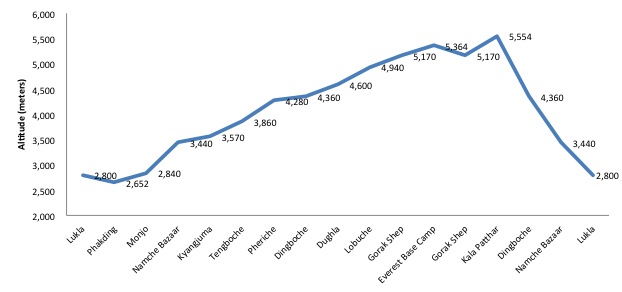
The highest point on most Everest Base Camp Treks tends to be the Kala Patthar viewing point where you will be blessed with some of the best views of Everest and the nearby peaks. Kala Patthar stands at just over 5500m, but not too much time is spent at that altitude as the trek then descends back down to Pheriche and eventually back to Lukla Airport.
Hopefully these facts and figures have convinced you set out on your own trek to Everest Base Camp – if so, happy trekking!
Tags: Everest Base Camp Trek Distance, How long is the Everest Base Camp Trek? Length of the Everest Base Camp trek, Everest Base Camp trek altitude, Everest Base Camp Trek elevation
Mark Whitman
Hi, I'm Mark! Welcome to EBC Trek Guide - the Web's No.1 Trekking Guide to Everest Base Camp. I have trekked all over Nepal, but the Everest region remains my favourite. I hope you find all the answers you are looking for on this site. If you have any questions don't hesitate to drop a comment below! Happy Trekking!
Leave a Reply
Your email address will not be published. Required fields are marked
Really useful post to reflect the daily walking distance , gain elevation and length of track regarding EBC treks thanks for sharing
Hi Mark, just wondering if Island Peak (in November) is do-able for my son who will be 17 years old. We’re both pretty fit but we don’t have any climbing experience. I did EBC in 2014. Cheers.
Hi Anthony, thanks for getting in touch. It is possible to climb Island Peak in November. The hike to Island Peak usually includes a visit to EBC before to help with acclimatisation. The climb itself is a real challenge and not for the faint-hearted. I would highly recommend doing some winter mountaineering courses before embarking on the adventure. You will need to be comfortable using crampons, crossing a glacier with ladder crevasse sections and ascending a tough headwall with a fixed rope jumar. You can read more about Island Peak here: https://www.mountainiq.com/guides/trekking-in-nepal/routes/island-peak/
Thanks Mark, your info was very helpful = )
Thanks for info. It needs to write per day max hgt of destination
on the clair ridge oil platform we climb 17km per day.8.5 up and 8.5 down….how many times do we climb the equivolent of everest per week ?
Hi Donald, I’m not sure the answer to your question. I would estimate that on the average day on the EBC trek, you gain about 800-1500m in altitude and lose about 400-800m. The average elevation gain is about 400-800m per day. Hope this helps.
Hellow ! My name is Jaak, my friends name is Andras and we are from Estonia. We wish to make a little trek, max 10-11 days for max alt. 5500/5600m and to stay overnight 5000+ meters few nights. It mast be an acclimatization trek, because my friend are going to K2 summit expedition in july. My friend have gone earlier on Mount Everest summit .Could You please think about it and say, is it possible to organize trek like this between 08.05 – 21.05. We do not need a guide service and accomondation can be easy. Thanks in adavance, Jaak and Andras
Hi Jaak, we are not a tour oeprator so unfortunately we cannot help organise your trek. For a tour operator recommendation go here: https://ebctrekguide.com/go
Looking over the Everest Trek itinerary (which is similar to other organized Everest treks), it seems a little ambitious for the uninitiated. What I mean (and I’ve done the trek independently as well as extensive mountain climbing and backpacking in the Cdn. Rockies) is that while each day’s trek is reasonable, the day-after-day grind will wear down some people. I would recommend anyone attempting this pace first do some multi-day backpacking in the mountains to see how he or she reacts to what is a fairly relentless pace. A Stairmaster is a poor substitute. Also, people who’ve not trekked high up (above 12,000 feet) should know that altitude brings new challenges.
I love to try EBC from Lukla
please tell distance between first base camp to everest summit
Hi Murali, the distance from EBC on the south side (Nepal side) to the summit is approx. 20 kilometres. The altitude gain is nearly 3,300 meters though.
Thanks for all the information… Inshalah I will be there on the last August
Hi, I would like to do EBC on my own since having a porter or a guide with me all the time does not work for me. I am wondering how safe it is to hike alone for a female. I am also wondering if getting accommodation can be a problem if you dont book in advance. Finally, is the path well marked. Many thanks!
Hi, it is possible to trek solo and if you go during the high seasons (March-May or September-November) then there will be quite a few people on the trail. Getting accommodation each day should not be a problem but you might not get your pick of teahouses. Generally porters run ahead of trekkers to secure the best teahouses. The standard EBC path is not well marked but maps of the region are very detailed and easy to follow. All the best!
I am Ram and 40 year old i would like to know more about Everest trekking , i would like to do and what is the process
Hi Ram, I recommend browsing our site – it provides all the information you need. Start here: https://ebctrekguide.com/
Why is there so little time spent at EBC?
Hi Laurie, There are a few reasons why the time at EBC is limited. Firstly, trekkers cannot actually get all the way into the camp. The stop point is just before the camp, and there isn’t a huge amount to see. 10-20 minutes there is more than enough. Secondly, EBC is a good two hour hike from the last tea house at Gorak Shep. So to hike there and back means hanging around EBC is not recommended. Finally, the best views of Everest, the surrounding mountains and EBC is from Kala Pattar, which is right next to Gorak Shep and if you move fast can be hiked on the same day that you visit EBC. Hope this helps!
I’m planning to trek solo in December – January. I read is the low season, with probably a lot of snow. You consider this dangerous? Which equipment would you consider? Your info it’s very clear thank you very much!
Hi Mariano, yes, there is more snow in December. As long as you are trekking the standard route to EBC there is no additional danger. If you plan to cross some big passes, like those on the Gokyo route or Three Passes Trek, I would caution against that. Most passes will be closed in December anyway. In terms of gear, here is what you need: https://ebctrekguide.com/everest-base-camp-trek-packing-list
Thank you for sharing all this information in your blog . Very useful information, it opened my eyes to things i wasn’t aware about. Great way to start preparing for next years climb
Thanks Ebby!
Thanks for the info Mark, helps a lot. Planning to do the trek in December. Would appreciate any pointers to make it comfortable as I am told the Climate is extremely cold.
Hey Ismail, yes, December is pretty cold. Make sure to bring a four season sleeping bag and warm winter jacket / gloves / beanie etc. Layers will be important too, check out our packing list for advice: https://ebctrekguide.com/everest-base-camp-trek-packing-list
Hi, we are a family of 4 and interested in doing EBC in July 2019. Wanted to check what the minimum age is. My two sons are 12 and 10 years old and are physically fit. Thanks
Hi Jeet, there is no official minimum age for the EBC trek, although I wouldn’t take a child younger than 10. In terms of timings I would avoid July – this is the middle of the monsoon season and a terrible time to trek. The best time to go is either Feb-May or Sept-November. Hope this helps.
My other is a smoker and we would like to trek to EBC. Please give her some words of wisdom from your experience with smoking trekkers.
Hi William, words of wisdom… stop smoking. No in all seriousness, one can trek to EBC and smoke but I wouldn’t recommend it. If at all possible, I would encourage your ‘other’ to abstain from smoking, especially on the upper reaches of the trek.
Hello we are 3 friends and want to do EBC, want to know the formalities. Preferable date is 23rd march
We are planning to trekk to Everest base camp in next month . What is your advice for me
Hey, little mistakes on the altitude, Lukla is 2850m and the Kala Patthar is 5643m. 😉 btw I recommend to not hire any porter, that’s too easy with them and you won’t have the same satisfaction. I did it by myself without help and I was so proud to carry my bag in front of all this groups of tired people (but with no bags 😉 ) you’re going for a challenge or not ?
can you hire poter and guide at lukla. how is the chance if you trek to phaking and try to get a tea house without prior booking
Yes it is possible to hire a guide / porter in Lukla. If you ask at one of the many teahouses they should be able to assist. In terms of teahouse availability, this varies by season and time you arrive. Ideally it is best to send a porter ahead early in the day to make a booking for you, but generally if you arrive at a reasonable time it is usually possible to find a free room in one of the teahouses.
Great informative stuff, I’m Planning on 4 old guys 60 +62 to EBC In Nov 2020 Let you know how it goes
can I see everest from namchee bazaar?
Technically you need to hike up to the Everest View Hotel which is just above Namche. But it is only a 20 minute walk away so yes you can.
Is it possible to take a helicopter from Lukla to EBC and then hike back to Lukla with a group? I have taken a bus to EBC and that would be an option too. We would be staying the week before at a 10,000' elevation to help with acclimatization. Thanks,. Tom
Hi Thomas, it is possible to get a helicopter to EBC, but it’s pretty expensive and due to the high altitude weight is usually limited to one passenger (maybe two).
How far from base camp 4 to the peak and back?
Hi Albert, just to be clear this website is about hiking to Everest Base Camp, not climbing Mount Everest. But to answer your question, Camp 4 is on Everest is located on the South Col at just over 8000m. It’s about 1-mile climb to the summit and takes about 7-8 hours.
All of these guides have been so helpful! I leave for EBC in a week and have been panic googling to try to be as prepared as possible. Thank you for the info!
Sure thing Megan!
Hi! What clothing do you recommend for doing the EBC trek first couple weeks of November? Thanks!! Great article
Hi Jackie, I recommend checking out this packing list: https://ebctrekguide.com/everest-base-camp-trek-packing-list
very informative mark thank you. i will be doing this in october 2023
Thanks Tony!
Hi Mark, is there scope to buy all the kit you need in Kathmandu as I’m traveling light at the moment. Im in the far east in shorts and flip flops and my gear is back in the uk. If so how much would I be looking at?
Yes, there are loads of gear stores in Thamel.
Very informative, intresting and nicely articulated! Loved it.
Get a quote from the best local trek operator in Nepal!
Ask me your questions.
Get your EBC questions answered
Join my Free Facebook Group
Get my recommendations on the Best EBC trek operators
Atlas & Boots
The UK's most popular outdoor travel blog
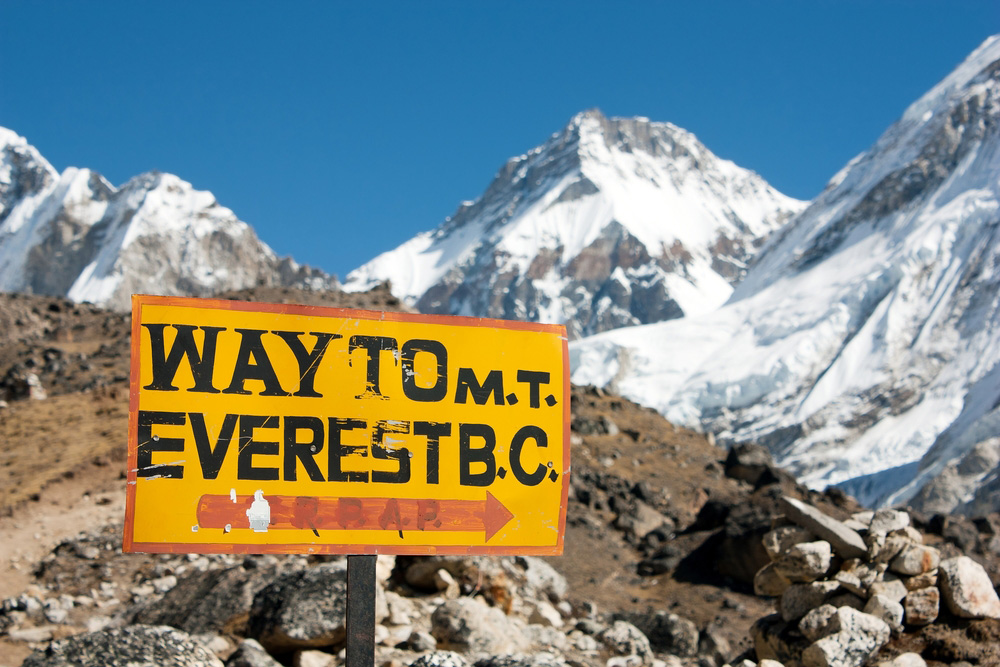
Everest base camp trek tips: 28 things to know before you go
Our Everest base camp trek tips cover everything from permits and teahouses to where to get the best views
I trekked to Everest base camp back in 2019. It was the start of a feverish 24 months of trekking and climbing that took me to the base camps of Earth’s highest and second-highest mountains, across the remote tundra of western Greenland and ultimately to the summit of Aconcagua – the roof of the Americas which, at 6,961m (22,837ft), is the highest peak I’ve ever climbed.
Nepal’s – and perhaps the world’s – best-loved trek is a scenic tour de force. At 8,848m (29,029ft), Mount Everest is the highest mountain in the world. It is one of just 14 eight-thousanders as well as a seven summit . It has captivated intrepid men and women since the first legends of mountaineering made headlines of Everest around the world.
Beyond the epic summits are Sherpa villages, picturesque forests and glacial moraines, all at their best beneath Nepal’s brilliant morning light or blissful evening alpenglow. The route makes use of unparalleled trekking infrastructure with porters and guides taking the heavy loads and cosy teahouses providing soft beds and steaming plates of dal bhat (lentils and rice) along the entire route.
Nepal instantly became one of my favourite countries and I have vowed to return as soon as possible to complete the Annapurna Circuit and Langtang treks. Perhaps one day I’ll go a step further and climb the mountain for real.
Everest base camp trek tips
Given that a few years have passed since my own trek, we asked leading Nepali trekking guides Magical Nepal for their advice on how to get the most from your Everest base camp trek .
Based in Kathmandu, they have a wealth of experience when it comes to trekking throughout the Everest region and the wider Nepali Himalayas as well as Bhutan and Tibet. Together, we have assembled the following list of Everest base camp trek tips you should know before you go.
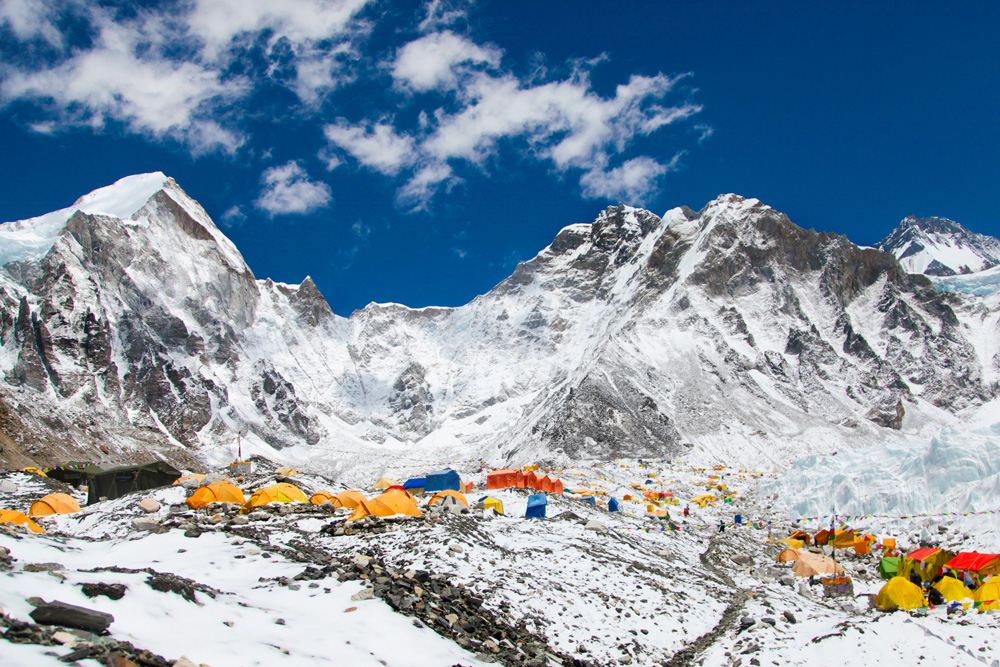
1. At a glance
Duration: 14 days Distance: ~110km Max Altitude: 5,545m (18,192ft) Starts/ends: Lukla Longest day: 19.6 km/7-8 Hours Region: Everest, Sagarmāthā National Park Accommodation: 11 nights in mountain teahouses; two nights in a Kathmandu hotel
2. How long does it take?
An Everest base camp trek typically takes around 14 days which includes 11 days of trekking – although two of these will be acclimatisation/rest days. The trek takes nine days to ascend to base camp and two to descend back to Lukla.
3. How hard is the Everest base camp trek?
On a scale of one to 10, I would say it’s about a six or seven. It is a high-altitude trek, it is for 11 days, you walk for between three and eight hours a day and it can get very cold. It is a challenging trek that shouldn’t be taken lightly.
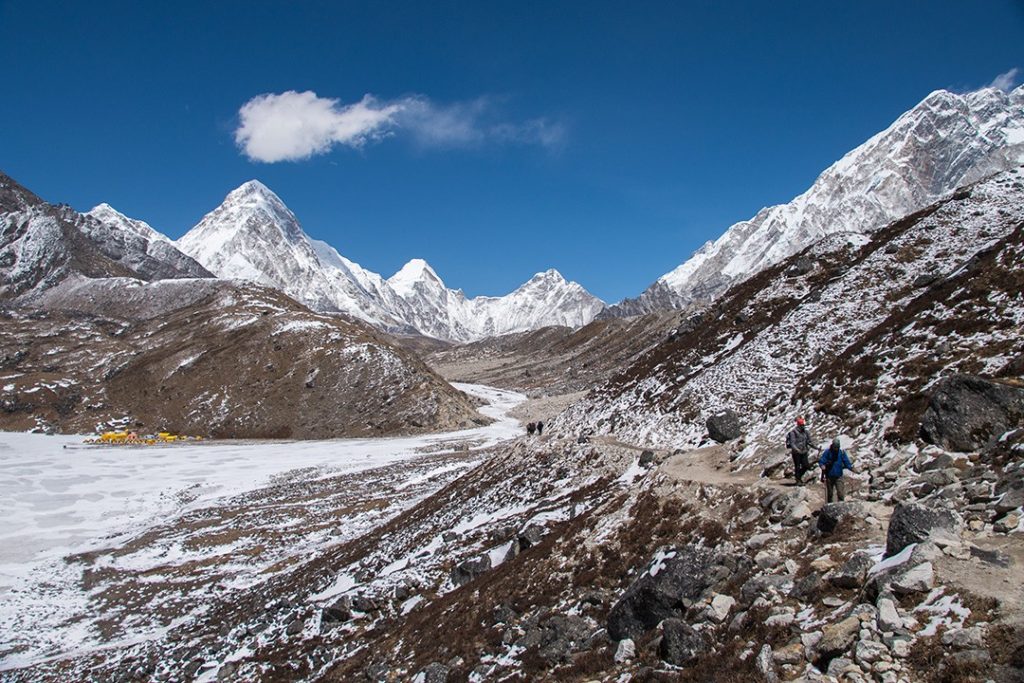
If you have little experience with multi-day trekking or walking at altitude or aren’t particularly fit, then you will find this trek more challenging. A member of our group, a healthy thirty-something man, described it as the hardest thing he’s ever done.
That said, porters carry your heavy gear so your backpack is light, the trail is well-trodden and easy to follow and as long as you take your time and listen to advice, it is a very achievable trek. Every year, over 30,000 people from all walks of life make the trek.
4. How much does it cost and what does it include?
The Everest base camp trek can be booked through Magical Nepal , a Kathmandu-based trekking specialist with a wealth of experience in the region. Prices start from around USD $1,459 for a round trip from Kathmandu and include the following:
- Local transfers for international flights (arrival/departure)
- Local transfers for domestic flights
- Return flight from Kathmandu to Lukla
- Sagarmāthā National Park entry permit and local permits
- Guide for 12 days
- Porters for 11 days
- 2 nights accommodation in a Kathmandu (Bodhi Boutique or similar)
- 11 nights accommodation in mountain teahouses
- 12 breakfasts, 11 lunches and 11 dinners during the trek
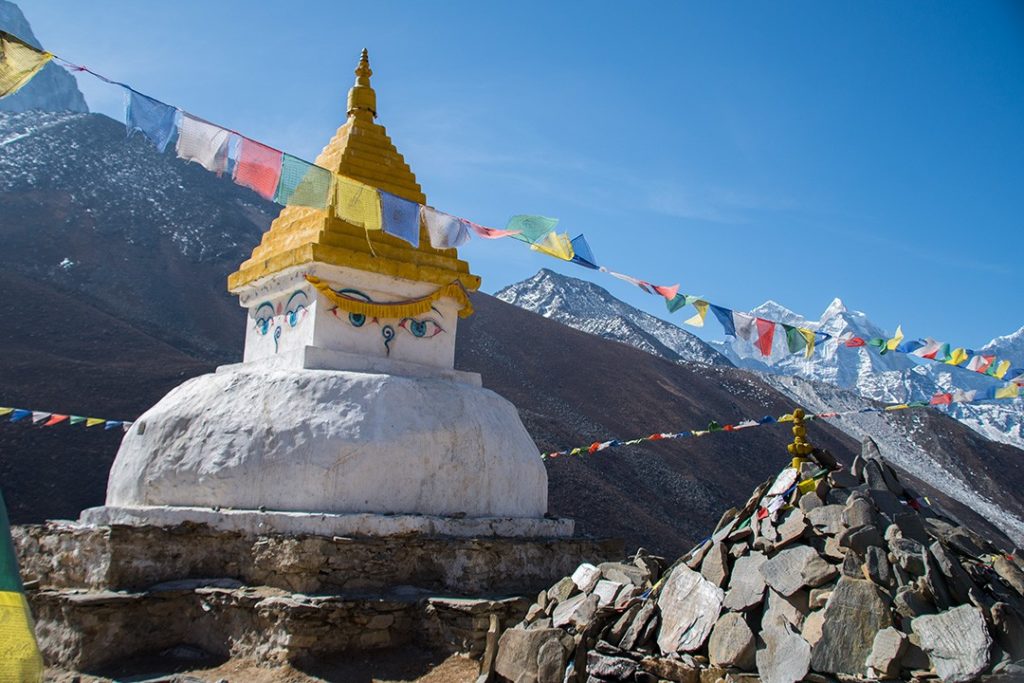
5. How cold does it get?
It depends on the time of year and your location on the trail. The higher you are, the colder it gets. During our trek in early April, it got as cold as -20°C on one night – although most nights were not as cold. The days varied massively. Sometimes we were hiking in shirtsleeves and sweating in the sun while on others we were in cold-weather gear while it snowed.
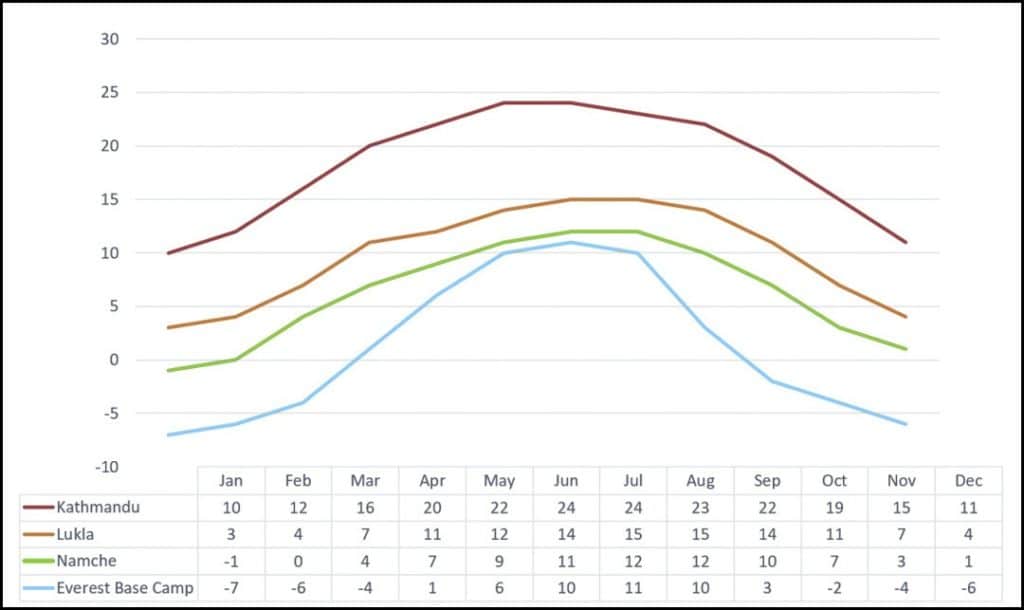
6. When is the best time to trek?
The best time to complete an Everest base camp trek is in autumn (late Sep-Nov). Days are generally dry and clear although there can be the odd shower or storm. This is also peak season so trails are at their busiest.
Another excellent time to trek is during the warmer and quieter spring (Mar-May), which is when I went (early April). This is also the time when the colourful rhododendrons bloom, generally between 2,000m and 3,000m. The drawback is that the dry weather brings dust which leads to hazier days.
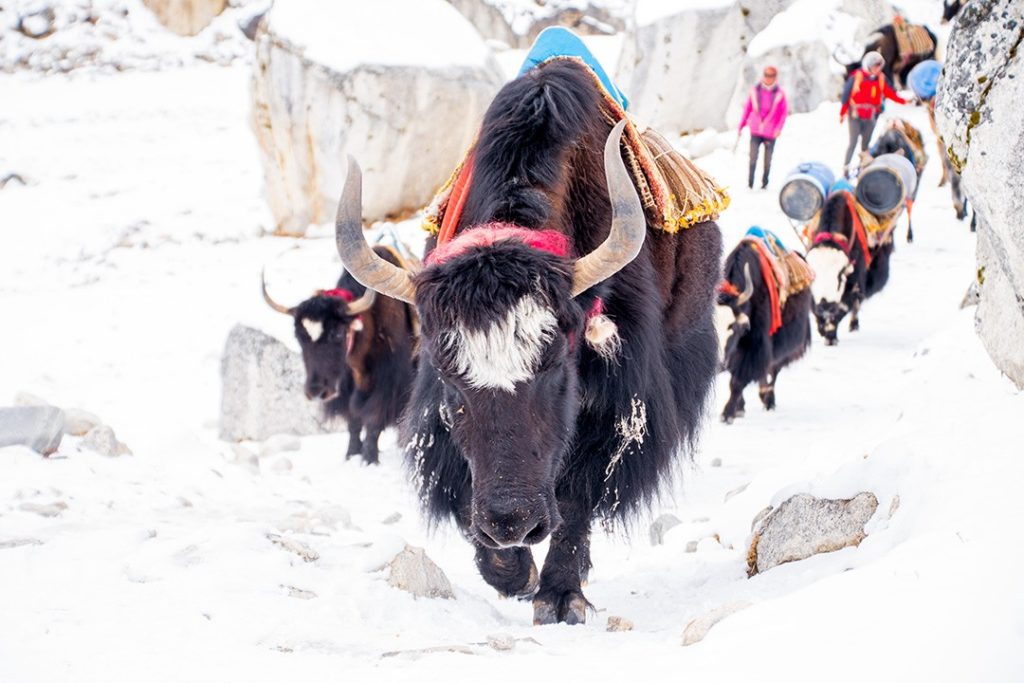
Dec-Feb are good months for trekking, but they are also the coldest and reaching base camp can be a real endurance test. The monsoons arrive in earnest from Jun-Sep, swelling rivers to breaking point, bringing hordes of leeches and making the trail very muddy. Many teahouses will close during these months.
7. Is there snow at Everest base camp?
Absolutely. It’s the base of the highest mountain in the world! It will of course depend on the weather and the time of year, but you should expect to find snow at base camp throughout the year.
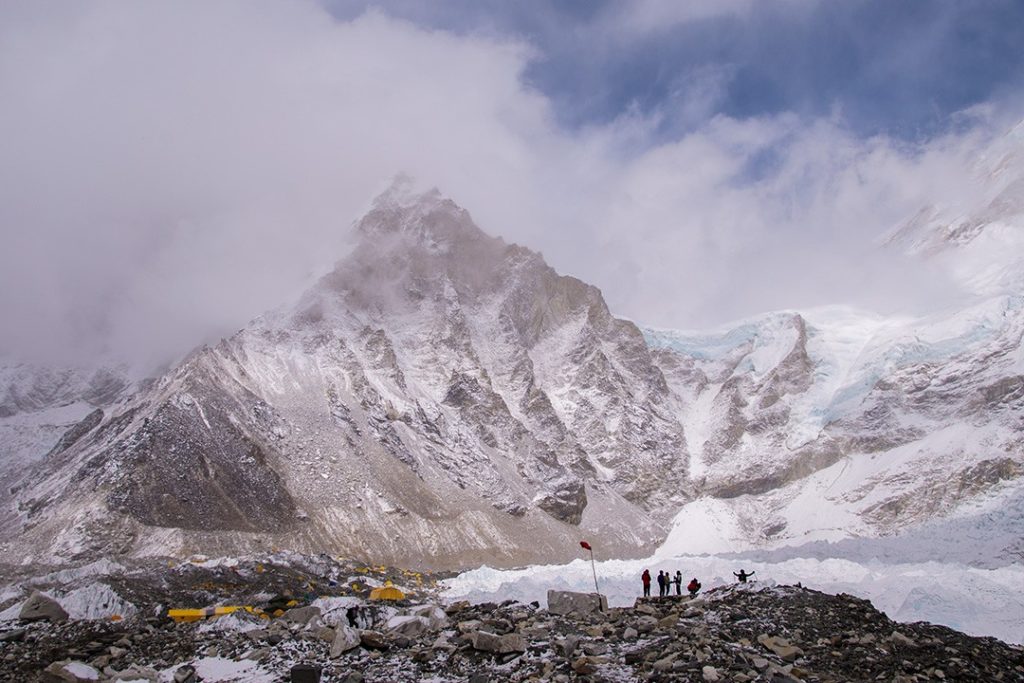
8. What should I pack?
I’ve put together a complete Everest base camp kit list . It contains everything I took with me including clothing, trekking gear, toiletries, medication, electronics and documentation.
9. Can I buy trekking gear and clothes locally?
It is possible to buy (or hire) most items on my Everest base camp kit list on arrival in Nepal. However, I wouldn’t advise leaving it that late and quality can’t always be guaranteed.
Kathmandu does have a host of outdoor shops selling much of what you’re likely to need. There is a collection of imported gear shops – with comparable prices to those in the west – spread along Tridevi Marg near Thamel.
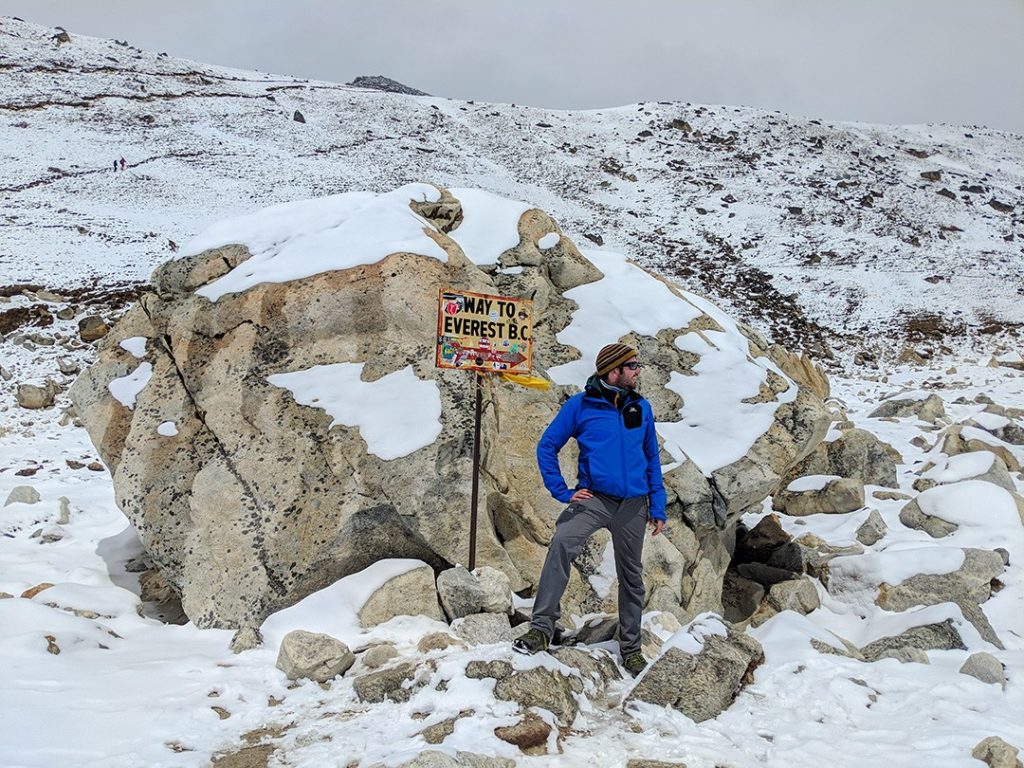
On the trail, Namche Bazaar has some excellent equipment shops including both international ( Sherpa , The North Face ) and local outdoor gear shops as well as countless souvenir shops. There is also a limited assortment of shops and pharmacies in Lukla and other trailside villages en route.
Again, in Kathmandu, it’s possible to hire many items such as sleeping bags and down jackets. Trekkers should always bring their own walking boots and shoes, which should be thoroughly worn in beforehand.
10. What are the weight limits on the flight?
There are strict weight limits on the domestic flight from Kathmandu to Lukla. The flight only allows for 10kg of checked luggage and 5kg of hand luggage. This coincides with the maximum weight porters are allowed to carry: 10kg per trekker with a maximum of two trekkers per porter.
Luggage can be stored securely at your hotel in Kathmandu, but you will need to take all your trekking gear with you. In our Kathmandu hotel, Fuji , there were some luggage scales available for guests to use.
11. What is the flight to Lukla like?
Thrilling! The morning flight to Lukla is spectacular in its own right, with the landing an exciting way to begin the trek. One end of the runway at Tenzing-Hillary Airport in Lukla is 60m (197ft) higher than the other.
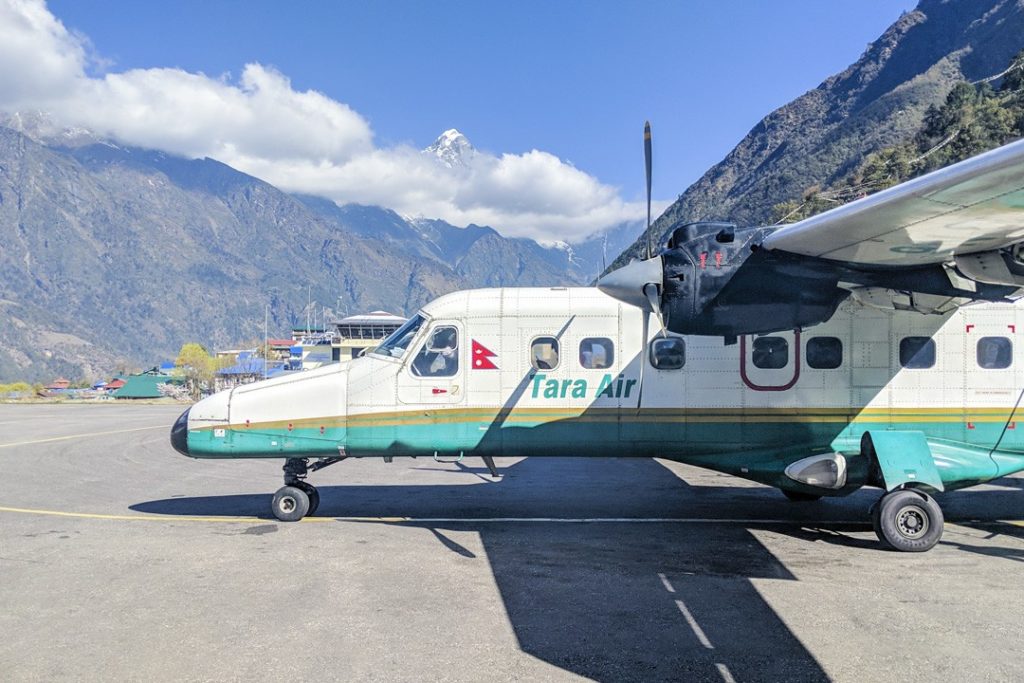
The journey to Lukla takes around 25 minutes by small propeller planes – either Dornier Do 228s or Twin Otters – that seat only 15 to 19 passengers. Spectacular views of the foothills of the Himalayas are on offer, but the weather tends to deteriorate in the afternoon.
If you suffer from travel sickness, I would advise taking some medication. At least one member of our group wished they had! Airsickness bags are provided on the flight.
12. How much should I tip guides and porters?
Tipping when travelling can be a bit of a quagmire, but the guides and porters on the trek deserve every penny they earn and then some. We suggest the following when it comes to tipping local support staff.
- For the head guide between $20-30 USD per client, per week.
- For porters during the trek $4-7bUSD per group, per day.
- For drivers and local guides $1-$2 USD per client, per day.
We had a head guide, assistant guide and five porters supporting our group of 11 clients. Our guide and assistant guide were with us for 15 days and the porters for 12 days.
We each contributed around $150 USD to the tip fund which was divvied up as follows:
- Head guide: $60 x 11 = $660
- Assistant guide: $30 x 11 = $330
- Porters: $60 x 11 = $660 / 5 porters = $132 each
We also collected a few dollars each for our head porter as he was particularly helpful and even invited us to his wife’s teahouse during the descent for snacks and tea.
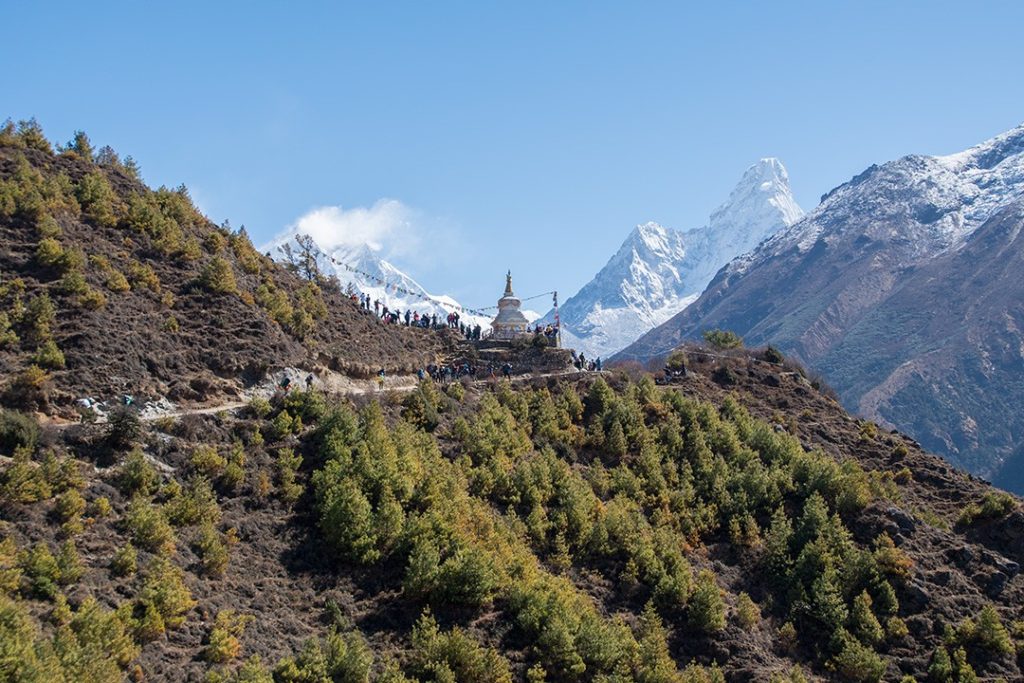
13. Can I charge my phone and camera on the trail?
It is possible to charge appliances at teahouses, but this usually incurs a charge starting from 100 NPR ($1 USD) at lower altitudes and rising to 500 NPR ($5 USD) higher up the trail. Some teahouses charge more for charging a powerbank or camera. I think the most I heard someone paying was 700 NPR ($7 USD) for a large powerbank.
Some cafes on the trail will allow you to charge a device for free if you’re buying a meal or drink.
14. Is there wifi available?
Wifi is available at many villages along the trail. However, these are some of the most remote villages in the world so connection is often interrupted or very slow – particularly when groups of trekkers arrive at the same time and all connect simultaneously!
Again, wifi costs increase as you ascend. Generally, at lower levels, it starts from around 100 NPR ($1 USD) to connect at a teahouse overnight and increases as you get higher.
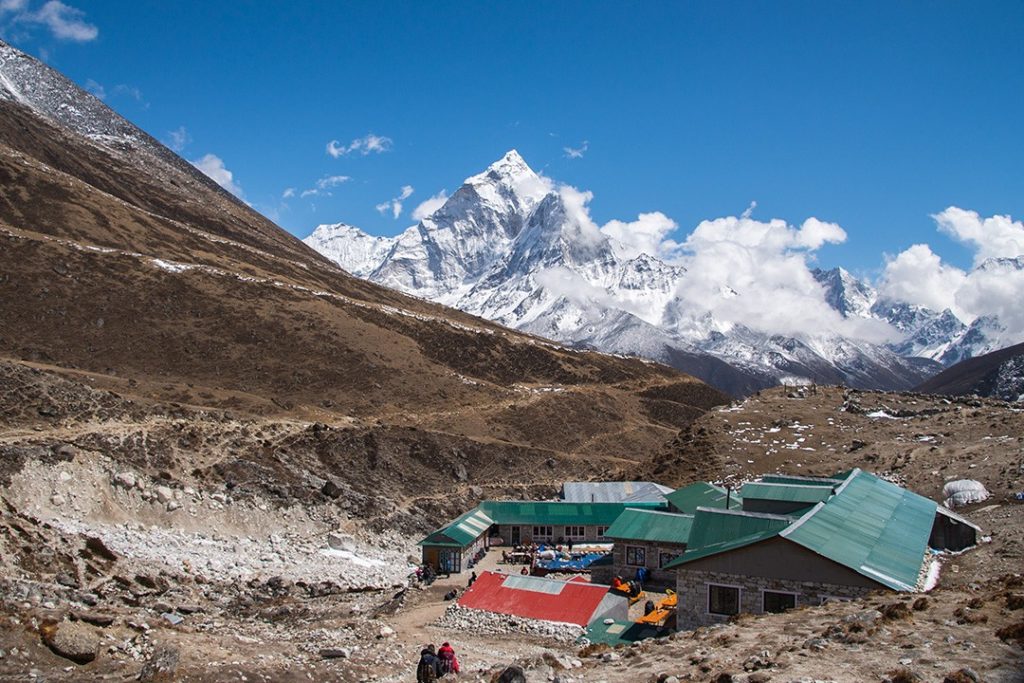
The most reliable connections are the Everest Link hotspots available at most of the villages. These prepaid cards are available in 10GB and 20GB for 1,999 NPR ($20 USD) and 2,999 NPR ($30 USD) packages and last for 30 days. Cards can be bought in Kathmandu, Lukla, Namche Bazaar and in some of the smaller villages.
15. Is there phone reception?
Phone reception is of course intermittent, but there is reception at the lower villages. I made the mistake of buying a Nepal Telecom ‘Namaste’ SIM card at the airport on arrival. However, this didn’t have reception from Namche Bazaar onwards. The Ncell networ k , which my guide and some other trekkers had, appeared to have better reception further up the trail and my guide recommended them.
Both providers have outlets at the airport and throughout the country and offer a range of data packages. You’ll need a copy of your passport and a photo to obtain a SIM card.
Another option is to get a Holafly eSIM for Nepal so you can stay connected to the internet on your trip. We can offer our readers 5% off Holafly purchases. Simply use the code ATLASANDBOOTS at checkout.
16. Is it safe to drink the water?
Yes, it is safe to drink water as long as you use purification tablets. Nearly all teahouses and restaurants can provide drinking water free of charge. Only at Gorakshep (the last stop before base camp) was it necessary to buy bottled water, as there is not a natural spring nearby.
Otherwise, do not buy bottled water or bottled soft drinks on the trail. Plastic bottles are difficult to dispose of and have become a serious environmental problem.
17. What is the food like?
The food is actually pretty good along the trail. For lunch and dinner, every teahouse serves the traditional Nepali Dal Bhat (rice and lentils) as well as a variety of meals such as rice, vegetables, noodles, potatoes and soup along with Nepali versions of western food such as pizza, pasta, sandwiches and veggie burgers.

The food on the trail was tasty and varied
Breakfast is usually a choice of porridge, various styles of eggs, toast, pancakes or the delicious (but sweet) Tibetan bread.
Do not eat meat along the trail, particularly higher up, as it has to be flown into Lukla and then transferred up the trail. Additionally, refrigeration cannot be relied upon.
Regardless, it’s much better to stick to a carb-heavy vegetarian diet as it’s just what you need on a long high-altitude trek such as this.
18. How much do meals cost?
I found I was spending around $20-30 USD per day on food, hot drinks and snacks – and that often included a fee for charging a device, a hot shower or wifi.
However, if joining an organised trek, all meals along the trail are usually included in the price so you only have to pay for your meals in Kathmandu.
If you’re travelling independently, allow for between $400-600 USD in total for meals along the trail. The cost of food and drinks gets more expensive the higher you trek.
19. Can I take a shower during the Everest base camp trek?
There are some hot showers at teahouses on the trail at an additional cost ($3-5 USD). I took two hot showers during the trek. The rest of the time I just had cold-water washes.
Only have showers at teahouses with solar heaters. Don’t use water heated by wood, as a lack of firewood in villages is a big environmental concern in Nepal. Your guide will be able to advise you.
20. Is the Everest base camp trek dangerous?
All high-altitude treks involve a certain degree of risk. However, if you follow these Everest base camp trek tips, along with the advice of your guide and adhere to the set acclimatisation itinerary, then most healthy people will complete the trek without any serious issues.
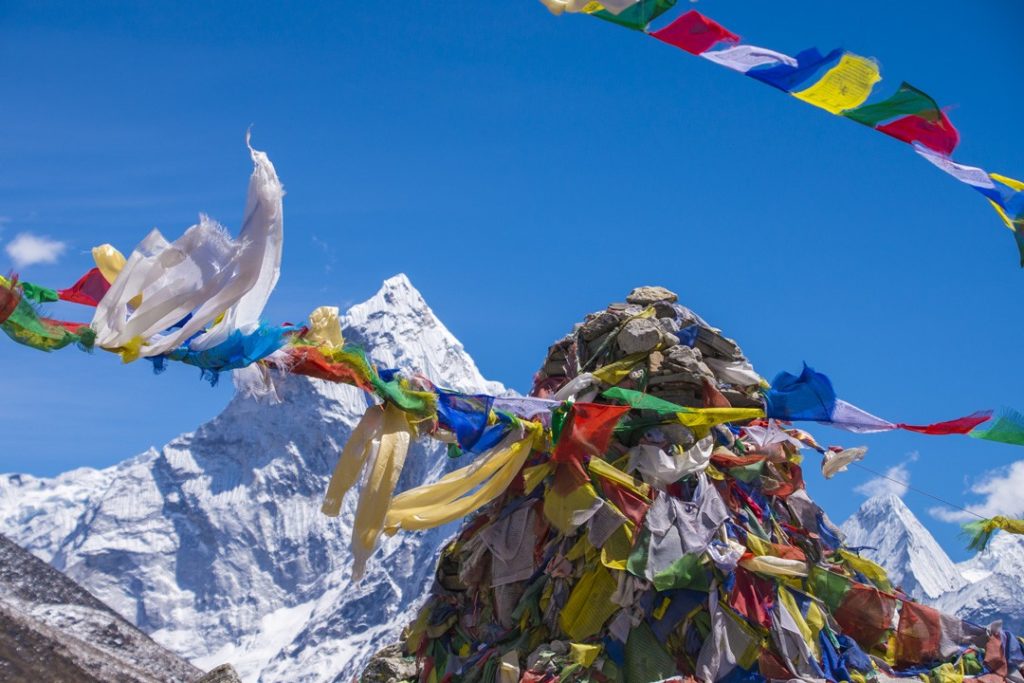
The important thing with high-altitude trekking is to not rush, go at your pace and listen to your body. Read our detailed guide on how to identify, treat and prevent altitude sickness symptoms .
21. Should I take Diamox?
This is very much down to the individual. I didn’t take Diamox, but I have been up to this altitude several times before so knew what to expect. However, I did have some with me in case I felt bad at the higher altitudes.
The best advice I can give is what trekking guides have told me in the past. Have some Diamox with you and take it as soon as you start to feel the pulsing headaches that are synonymous with altitude sickness . He said it’s good to have some available at the higher altitudes – particularly at Gorakshep where you sleep at 5,300m – so you can use it to help you get a good night’s sleep.
22. Do I need sunscreen?
Yes! Despite the cold, the sun is intense. Make sure you wear sunscreen with an SPF of at least 40, lip balm with SPF protection, sunglasses and a sunhat.
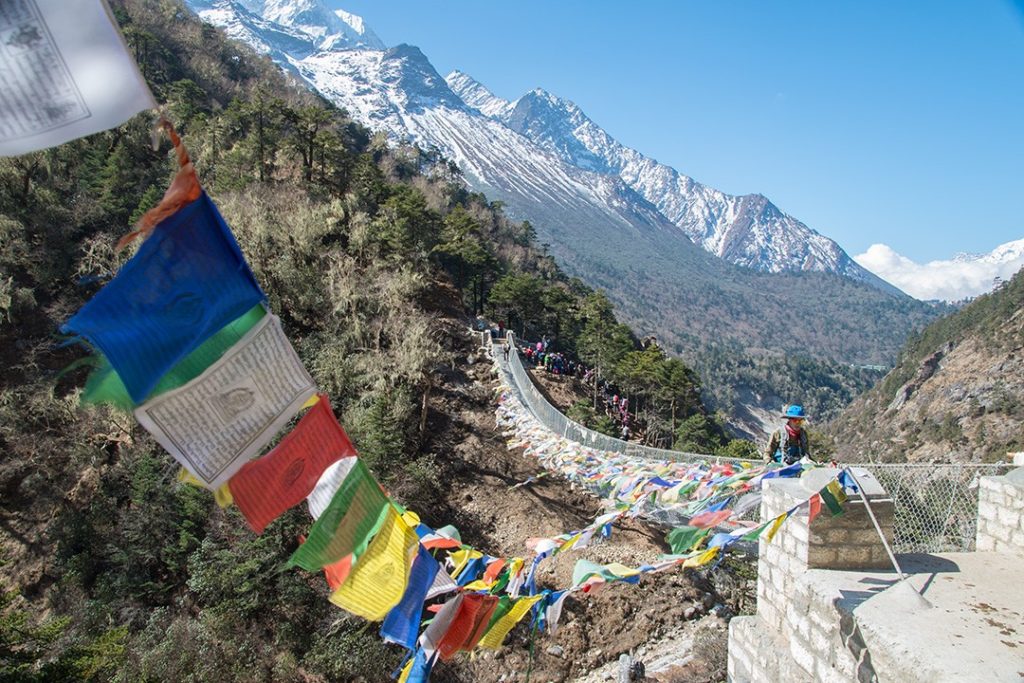
23. What sort of travel insurance do I need?
One of the most important Everest base camp trek tips is to make sure you select a travel insurance policy that has sufficient medical coverage. It must have a minimum coverage of $200,000 USD for repatriation and emergency rescue. Make sure you check how your policy covers ‘dangerous activities’ such as trekking at altitude and mountaineering.
It must cover the possibility of a helicopter evacuation for trekkers and general medical evacuation to Bangkok or Delhi, which alone can cost $40,000 USD.
24. Do I need a trekking permit?
To trek to Everest base camp you must enter Sagarmāthā National Park where you will need to pay a national-park fee. For foreigners, not from a South Asian Association for Regional Cooperation (SAARC) country, the fee is 3,000 NPR ($30 USD) per person. A full list of park entry fees in Nepal can be found here .
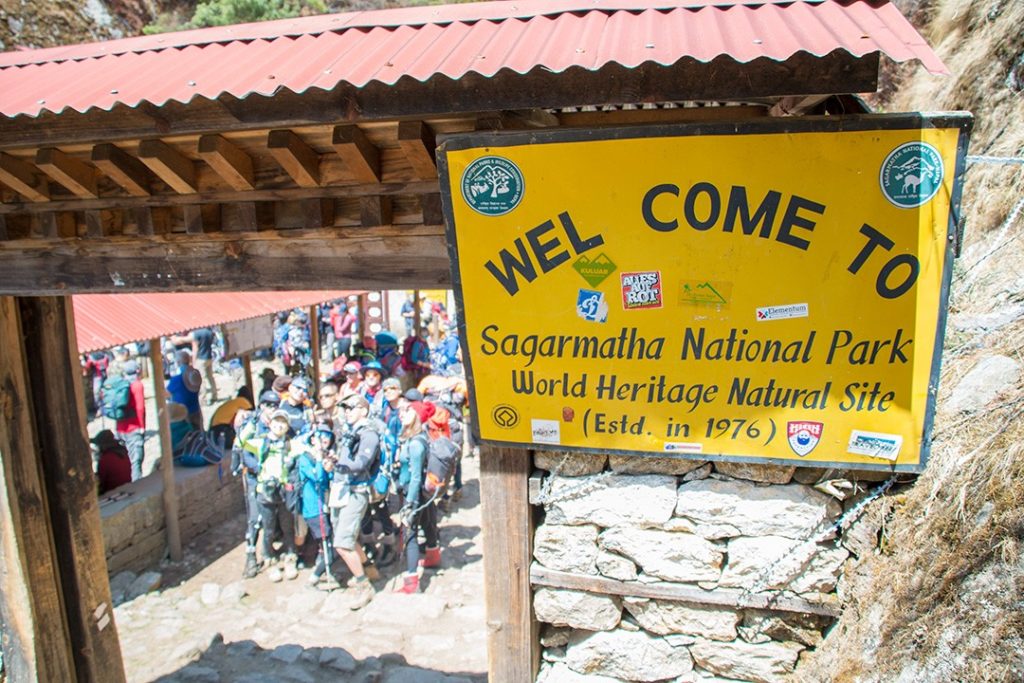
If you’re joining an organised trek, the fee should be included in the trip cost.
25. Are the teahouses warm?
There is usually a large dining room-cum-lounge with a stove in the centre where trekkers hang out in the evenings. The stove is usually lit in the early evening so the room gets pretty cosy.
However, the bedrooms remain chilly, to say the least. A blanket is often supplied which, combined with your sleeping bag, means you should be warm enough once safely cocooned in your bedding. The cold certainly never stopped me from getting a good night’s rest.
26. Can I drink alcohol along the trail?
There are teahouses, restaurants and even bars in the villages along the trail that serve alcohol. However, I wouldn’t recommend drinking any alcohol until you’re on your way down.
Some members of our group drank alcohol on the way up and they all suffered for it. On the way down you’ll be accustomed to the altitude and in a far better state to enjoy a snifter or two.
Furthermore, drinking higher up the trail just encourages demand. All those cans of beer you don’t need have to be carried on the backs of porters and yaks.
27. Can I see Everest from base camp?
Yes, although because of the angle it is somewhat obscured by Lhotse, Nuptse, the West Shoulder and the South Col. The best views of the Everest massif and the Khumbu Icefall are from the nearby summit of Kala Patthar.
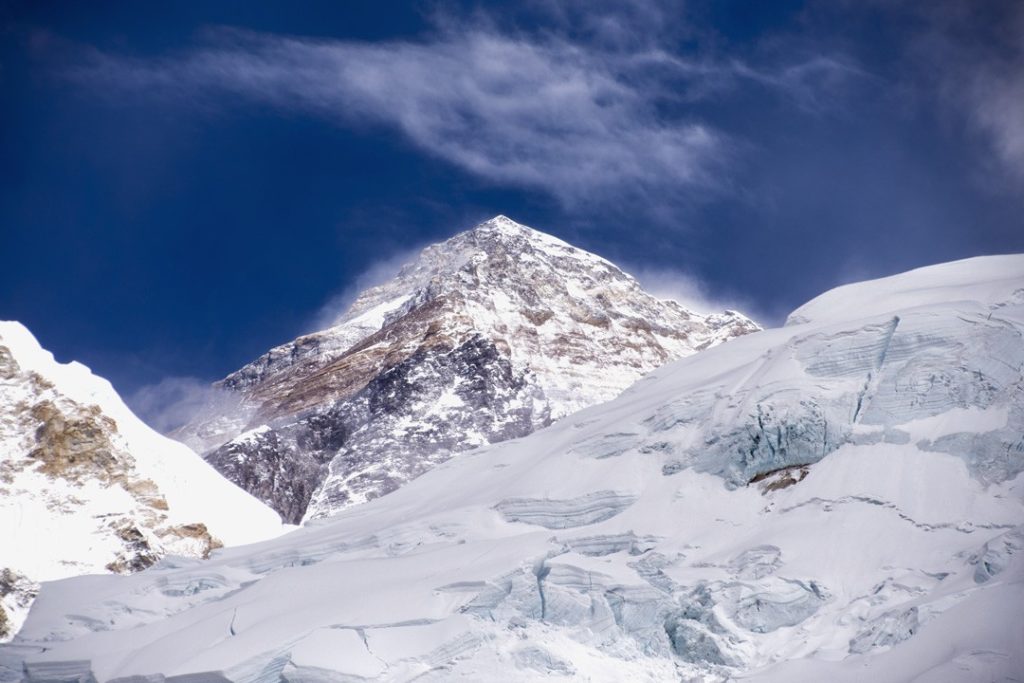
On my trek, no one fancied the optional early morning hike up Kala Patthar, so I dragged myself out of bed and headed off alone. I didn’t have enough time to make it to the summit, but I got as high as the plateau which still offered some excellent views. The wind was lashing and it was ferociously cold, but I do regret not getting up a bit earlier and making the full ascent.
28. Is the Everest base camp trek worth it?
Without a doubt, yes.
After over 100km of high-altitude trekking amid soaring peaks, Sherpa villages, picturesque forests and glacial moraine concluding at the foot of the world’s highest mountain, I can safely say the experience was everything I hoped it to be.
Enjoyed this post? pin it for later…
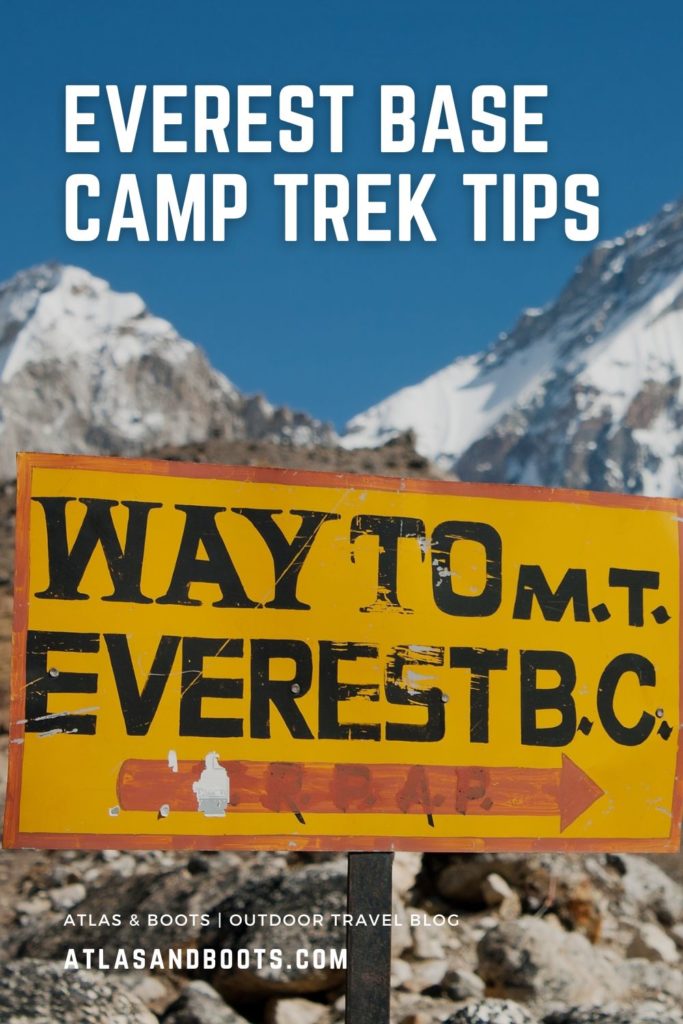
Lead image: Daniel Prudek/Shutterstock
You might also like:.
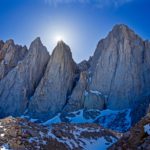

How Many Days You Will Need to Go Everest Base Camp
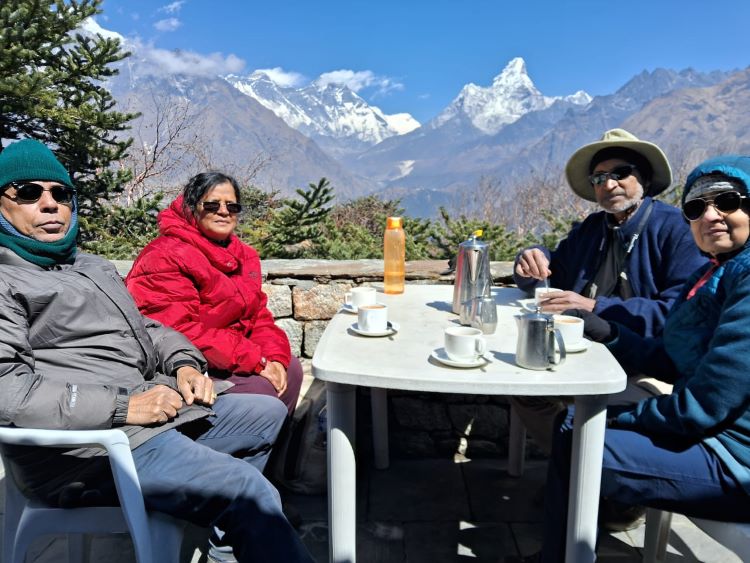
Everest Base Camp Trek is one of the most preferred Himalayan trekking adventures in Nepal that is designated toward the base of the highest alpine peak in the world, Mt Everest (8,848.86 meters). This trekking prospect in the eastern Himalayan region of Nepal is certainly on the to-do list of every trekking lover around the globe.
If you are curious about this remarkable Himalayan excursion and wondering about how many days you need to go to Everest Base Camp, then it depends on what kind of package you are choosing. The general length of the Everest Base Camp Trek is about 12 to 16 days .
The duration of your Himalayan adventure will mostly depend on the route taken, side detours around the region, trekking pace, and acclimatization days included in the package. Everest Base Camp Trek 12 Days is the most standard duration to complete this iconic journey to the Himalayas that houses the world’s mightiest peak. This standard trekking period covers the exploration of all the major highlights of this mainstream and also includes two days for the acclimatization period for trekkers to get enough rest and adapt properly to new altitudes along the journey.
Thus, if you are looking for the most optimized trekking package to the Everest Base Camp, this 12-day package is the ideal deal for you to enjoy the exploration without missing out on anything. The only difference between this itinerary plan and other lengthy packages is that the Everest Base Camp Trek 12 Days directly starts with the Kathmandu to Lukla flight and just covers itinerary plans for the trekking period.
Table of Contents
How Many Days to Go Everest Base Camp Trek – Outline Itinerary
12 Days Itinerary is the most standard itinerary plan for the Everest Base Camp Trek in Nepal. In this itinerary plan, you will finish the exploration of all major highlights in this mainstream trekking route, and you will also get enough acclimatization period so you can trek more comfortably.
Day 01: Flight from Kathmandu (1,400 meters) to Lukla (2,800 meters) and trek down to Phakding (2,651 meters)
Day 02: Trekking from Phakding to Namche Bazaar (3,430 meters)
Day 03: Acclimatization and exploration day at Namche
Day 04: Trekking from Namche Bazaar to Tengboche (3,870 meters
Day 05: Tengboche to Dingboche (4,360 meters) trek
Day 06: Rest and acclimatization day at Dingboche
Day 07: Trek from Dingboche to Lobuche (4,940 meters)
Day 08: Trekking from Lobuche to Gorak Shep (5,170 meters) to Everest Base Camp (5,364 meters)
Day 09: Morning hike to Kala Patthar (5,545 meters) and trek down to Pheriche (4,288 meters)
Day 10: Trekking to Namche Bazaar (3,430 meters) from Pheriche
Day 11: Namche to Lukla (2,800 meters)
Day 12: Fly back to Kathmandu (1,400 meters) from Lukla
Day-to-Day Itinerary Plans: Everest Base Camp Trek 12 Days
Everest Base Camp Trek 12 Days is a standard-length trekking adventure in the mainstream route. This exhilarating Himalayan journey starts with a direct flight from Kathmandu to Lukla, and you will immediately begin your trekking journey on the banks of the Dudh Koshi River to reach the Phakding Village . However, if you have bought a long-length trekking package, i.e., 15 or 16 days , your package will also include a sightseeing day in Kathmandu before you join the trekking trails on the mountain.
From Phakding, you will then climb uphill to reach the vibrant town of Sherpas, Namche Bazaar , which is a renowned town in the mainstream EBC Trek route. You will enjoy an acclimatization day here and take your time to adapt to the new altitude before trekking further. You will then gradually trek across the high-altitude Sherpa settlements like Tengboche and Dingboche . At Dingboche, you will enjoy another rest day and do some short hikes around the region to acclimatize properly. From Dingboche, you will head toward Lobuhce and trek past Gorak Shep to reach the base of the mighty Everest, Everest Base Camp .
However, your adventure doesn’t end at the base camp, the next morning, you will hike to the popular viewpoint in the Everest region, Kalapatthar , which is also the highest elevation gain point in this trip and is situated at an elevation of 5,644 meters . After enjoying the panoramic mountain views of the eastern Himalayas from this viewpoint, you will then make your descent to Pheriche before joining the mainstream Everest Base Camp Trek route at Pangboche . You will then trek down Tengboche to reach Namche Bazaar, from where you will make your descent to Lukla. The next day’s morning flight from Lukla to Kathmandu will officially mark the end of the Everest Base Camp Trek 12 Days.
Everest Base Camp Distance
The total Everest Base Camp distance is approximately 65 km (40 miles) from Lukla to the base camp. While hiking to Everest Base Camp, you will traverse across this much distance on the rugged and diverse terrains on the mainstream route in a single way. For the return journey, you will travel the same distance to reach Lukla for the flight back to Kathmandu. So, in total, you will trek about 130 km (80 miles) during your standard Everest Base Camp Trek 12 Days.
If your Himalayan journey also includes side explorations like Gokyo Lake Trek , Everest Three Pass Trek , or follows the classical Jiri to Everest Base Camp Trek route, then the overall trekking distance is much longer than the standard trekking package. In case if you are looking for a short-distance trekking adventure that fits perfectly with a limited vacation period then, the Everest Base Camp Trek With Helicopter Return is the most viable option. This helicopter return trekking prospect has a 9-day itinerary plan, and out of them, two are acclimatization days at Namche and Dingboche.
The Everest Base Camp distance in this mode of trekking is only about 65 km (40 miles), as you will fly back directly to Kathmandu after completing your hike to Kalapatthar. This helicopter return trek will cut off the trek distance of the return trip to Lukla and also make the journey much more comfortable, not to mention the epic aerial views of the pristine peaks.
Factors Influencing Trek Duration
There are several factors that affect the overall trek duration in this mainstream route, this influencing factors affect both day-to-day trek duration as well as the overall trekking period.
Physical Factors
Needless to say, the overall physical capabilities of the trekkers determine the pace and overall duration of the Everest Base Camp Trek. Naturally, fit trekkers can easily overcome the demanding trails that stretch to high elevation points in the region, and they will have more time to explore around the trails. However, for those who are not physically capable, covering even the day-to-day trek distance can take longer.
Compared to the fit trekkers who can cover more ground with their fast-paced trek, it is not possible for the trekkers who are not fit to cover the same length within their timeframe. So, the length of the journey will mostly depend on how easily the trekkers can overcome the physical demands of the trek.
Enroute Acclimatization Needs
In the Everest Base Camp Trek 12 Days, you will get two days of acclimatization period before pushing further into the high elevation points. It is important to acclimatize properly during high altitude trips so you can give your body enough rest periods as well mitigate the risks of Acute Mountain Sickness (AMS). But, if your EBC Trek explores other highlights of the region that are at significant altitudes, then you will need more acclimatization period.
Setting up more acclimatization days along the trail strategically is important to ensure the body gets enough rest and that trekkers adapt to new altitudes before heading to further elevation points.
Group Dynamic and Preferred Pace
If you are traveling with a dynamic group, then it is not possible for all the trekkers to have a uniform pace. Especially when your group comprises children and elderly trekkers then, it is important to consider the walking pace of every trekker. A young group with a good level of fitness can easily complete this iconic trekking in the eastern Himalayas within a short span.
However, for the trekking group with dynamic age group, enough resting period is important in the day-to-day trekking route as well in overall trip. So, the dynamic age trekking groups take it longer to complete the same trekking distance than the young-enthusiast trekking group.
Trek Preference
Custom designed itinerary plans are not new things in the Nepali trekking industry. In this category the trekking agencies custom-tailor most suitable itinerary plan for the trekkers depending on their adventure needs. Trekkers can also provide their own itinerary plans if they are familiar with the region and the agencies will design a trekking package based on those plans.
In the custom-tailored packages, the trekkers can adjust the overall length of the trek by themselves. If you and your friends want a short and sweet exploration with limited acclimatization period, you can request a shorter trekking package. You can also decide on the overall trekking pace and distance you want to cover in a single day in these types of packages.
Trekking Season and Weather Condition
The length of Everest Base Camp Trek is also majorly affected by the weather conditions and the season of visit. The EBC Trek is a seamless journey during the high seasons like spring (March to May) and autumn (September to November). The weather is stable during these peak seasons, and walking on trails is much more comfortable. However, if you are taking part in this Himalayan excursion during the off-seasons, like monsoon (June to August) and winter (December to February), the trip can be both challenging and lengthy.
Due to heavy rainfall and bad weather conditions in monsoon, you have to use a few of your contingency days. Similarly, the slippery and muddy trails affect the overall trekking pace, which can lengthen your day-to-day journey. On the other hand, during the winter season, due to extreme cold, the acclimatization process can take much longer, and traversing across trails covered with snow-covered trails can be a demanding endeavor.
Is Everest Base Camp Trek Right for Me?
This exciting exploration opportunity in the eastern Himalayas has been graded as a moderately difficult endeavor. Due to its milder difficulty factors, pretty much anyone can take part in this Himalayan adventure, and there aren’t any technical sections along the route as well. Still, as hiking to Everest Base Camp is a high-altitude journey, there are several factors you have to be mindful of in this trek. The overall trekking distance and the altitude gain are two of the challenging aspects of this trek that you need to prepare efficiently for. However, as these hurdles are not that challenging, you can overcome them with a good amount of physical preparation.
Strength exercises will improve your endurance level to meet the long hours of walking. Similarly, stamina and cardiovascular will make the trek feel easy as well as improve your body’s capabilities to adapt to the high altitude region. On top of that, during your trek, you will get enough acclimatization period before climbing to significant altitudes. So, overcoming these major hurdles of your Himalayan journey is not that much of a big deal. Also, the overall success rate of Everest Base Camp Trek is above 95%-97% with Great Adventure Treks. So, that gives you some insights on the actual difficulty grade of the trek if you are evaluating it as a strenuous journey.
In case if you are curious about the age restrictions for this trek, there aren’t any official age restrictions for the EBC Trek. Even children below thirteen and elderly trekkers in their 60s have successfully completed this classical Himalayan trekking adventure with us. So, whether you can do this trek or not depends entirely on how motivated and determined you are for this exciting Himalayan excursion.
Training and Preparation
Physical preparation.
If you are planning on taking this incredible exploration in the eastern Himalayas, you can make the journey more enjoyable and comfortable if you make an adequate amount of preparation. Normally, you are recommended to train for 3- 6 weeks ; you can adjust the length and duration of training to your schedule after properly assessing your physical capabilities.
Developing your strength level should be your top priority in your training, as the rugged terrains of the Himalayas will test your endurance level. Similarly, the stamina and cardiovascular exercises will make the long hours of walking a comfortable experience. Besides working out routinely, you can also do some practice hike sessions in steep terrains close to you.
Strength and Endurance Exercises: Lunges, Push Up, Squat, Cal Raise, Crunch, Leg Raise, Pull Up, Leg Extension, Dips, Plank, Deadlift, Overhead Press, Step Up, etc
Stamina and Cardiovascular Exercises: Stair Climbing, Jogging, Cycling, Swimming, Dancing, Jumping Rope, Aerobics, Mountain Climber, etc
Mental Preparation
Like physical preparation, mental preparation is equally important for this Himalayan journey and plays a significant role in determining the overall success rate of your journey. The Himalayan region in Nepal is the remote and less-developed region of the country. Thus, if you are expecting top-tier services during your trek, like any other popular vacation destination, you might be disappointed.
Similarly, due to remoteness, the services and amenities offered by the teahouses gradually start to narrow down as you ascend to higher altitudes, where the settlements are pretty close to the absolute wilderness. Also, you will have to trek for long hours (approx. 6-7 hours ) during the trekking days across the rugged and steep sections of the Himalayas; your physical capabilities and mental resilience should be in synch if you want to easily overcome the obstacles in your journey.
Mental Preparation Practices
- Stay positive
- Practice leaving your comfort zone
- Stay focused and motivated
- Surround yourself with positive people
- Learn to visualize your journey
- Practice controlled breathing
- Be flexible
- Build resilience
When Should You Do Everest Base Camp Trek 12 Days?
You can take part in Everest Base Camp Trek 12 Days every season throughout the year. It is totally up to you to decide the season of your Himalayan adventure, depending on what kind of experience you are looking for. Still, the high seasons, like spring (March to May) and autumn (September to November) , are considered to be the best period for an invaluable experience. Both of these seasons have calm climatic conditions, pleasant temperatures, and their own unique add to the abundant natural beauty that makes the experience magical.
Spring is famous as the season favored by nature; you will find the entire landscape covered with lush greenery and adorned with vibrant, bright flowers. It is also high time to explore the endangered flora and fauna of the Sagarmatha National Park , a UNESCO World Heritage Site. Similarly, the autumn season is popular for its dry trekking trails, ideal temperatures, unique shades of the fall seasons, and incredible Himalayan vistas under the clear blue skies. The autumn season is also the core period when major festivals like Dashain , Tihar , Chhath , Mani Rimdu , etc take place. So, you will be able to add memorable cultural experiences to your Himalayan adventure during this season.
Temperature of Everest Region During Spring: 5°C to 25°C
Temperature of Everest Region During Autumn: 4°C to 18°C
Expert Tips and Advice for Everest Base Camp Trek 12 Days
- Prepare yourself physically and mentally before trek
- Trek slowly and drink enough water (recommended hydration limit is 3-4 liters)
- Monitor your diet and eat balanced meals
- Keep yourself warm and pack the right layers for different climatic zones
- Avoid alcohol and cigarettes during the trek
- Trek with an experienced guide and hire a porter who is a local resident
- Stick with guides and suggestions from your guides/porters
- Communicate clearly if you are facing any kind of issues
- Respect local culture and traditions
Add Comments
XHTML: You can use these tags:
* Fields are mandatory.
Speak to our local travel expert, who can assist you in planning your trip.
- Most Recent
- Most Popular
The Best Hikes In Kathmandu
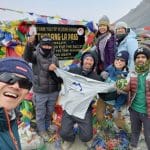
A Guide to Capturing Stunning Videos in the Himalayas
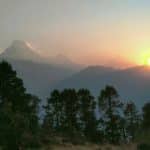
Best 4 Days Treks In Nepal
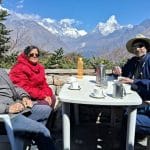
Everest Base Camp Trek Packages: Your Options
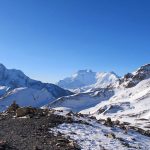
Annapurna Circuit Trek Packing list
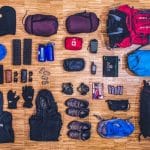
Manaslu Circuit Trek Packing List
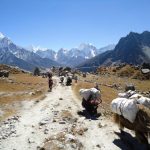
Thorong La Pass
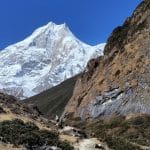
How Much to Tip Guides and Porter In Manaslu Circuit Trek

Tipping For Guide, Porter In Everest Base camp Trek
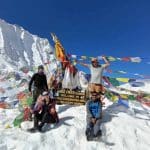
Manaslu Trek Nepal : Nature’s Spectacle in the Himalayas

We are recommended on:

Adventure Great Himalaya Pvt. Ltd. (Private day tours)

Everest Base Camp Trek – 13 Things to Know for Your Trip in 2024

Just a mention of the Everest Base Camp Trek (EBC) in Nepal is usually enough to stir the soul of hikers all over the world. Thousands of aspirational ramblers have gained valuable experience on this Himalayan route. Some see this hike as a rite of passage for all true trekkers. Others go on this trek because it’s a ticket to the soaring roof of the world, where an up-close encounter with the highest summit of all awaits. The Everest Base Camp in Nepal itself sits at an impressive 17,598 feet (5,364m) high, but more on its impressive heights later on.
Whatever your reason for wanting to strike the Everest Base Camp Trek from the bucket list this year or the next, this guide can help in your pursuit. It will run through all the basics of this iconic trekking route between Namche Bazaar and EBC in Nepal, detailing the best time of year to go, what sort of challenges can be expected along the way, what trekking gear you’ll need on such a trip, and so much more. Find answers to the most frequently asked EBC Trek questions here. Dive in!
Our experience on the Everest Base Camp Trek
Like many, we began offering the trek to Everest Base Camp largely because of its reputation as one of the most extraordinary adventures on the planet. As soon as our team set foot on this legendary path we could instantly see why it was the case. Travelers of all stripes, all nationalities, join together on this true Himalayan adventure. The EBC Trek has the feel of a true expedition as you fly into the small airport at Lukla and take your first steps on the wooded trail towards the small village of Namche Bazaar.
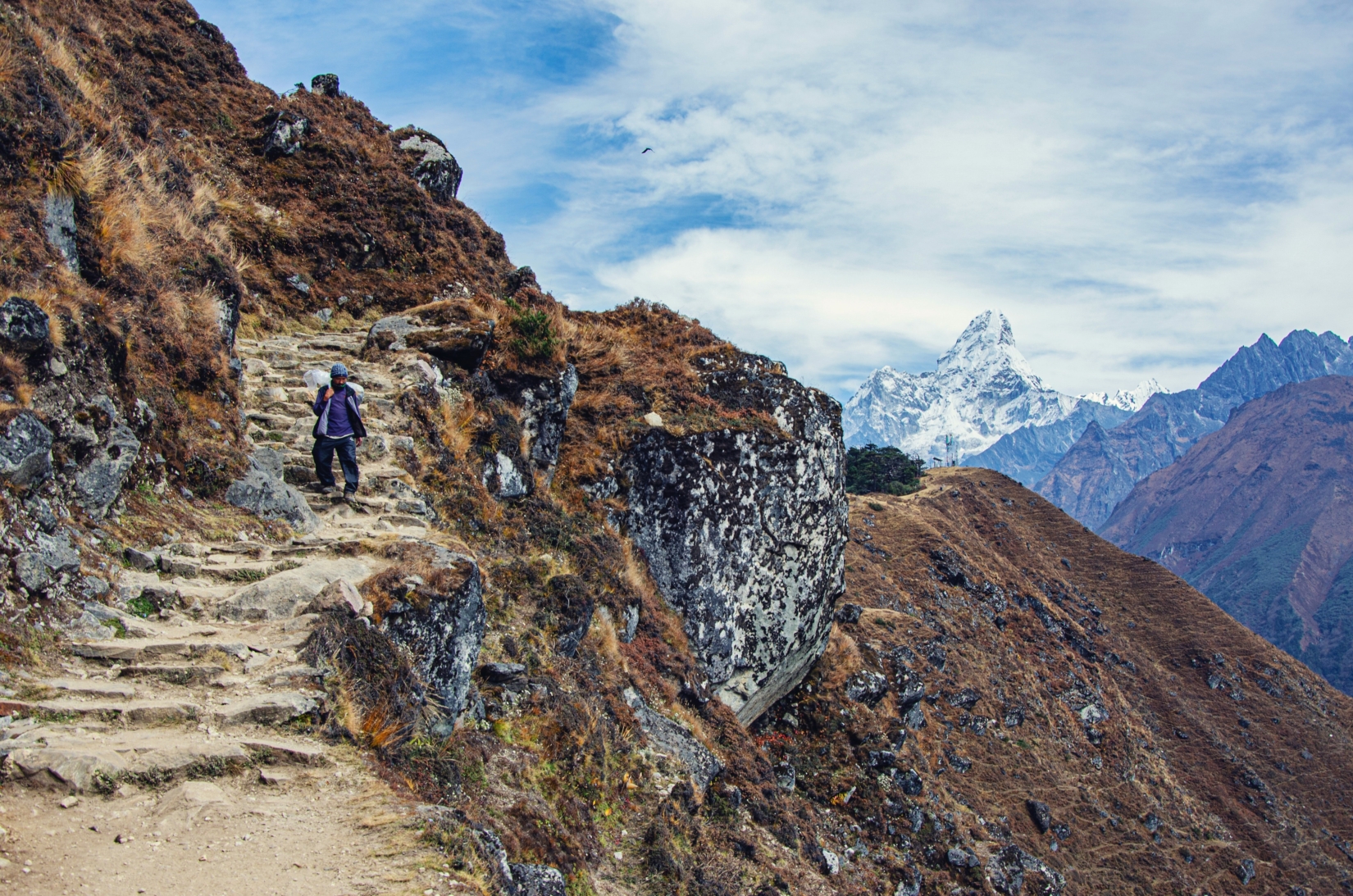
For me, Nepal is unlike any country I have visited. On my visit to this culturally rich and diverse nation I felt like I had entered into a new world. With the influences of both Buddhism and Hindi, the capital city of Kathmandu provides a window into the beautiful culture and history of the Nepalese people and bags you to explore more of this remarkable country.
What’s in this guide?
- Where is Everest Base Camp (EBC)?
- History of Everest Base Camp
- How long is the trek to EBC?
- Is it worth it? Things to see & costs
- How hard is the trek? Terrain, elevation, and altitude
- Food on the Everest Base Camp Trek
- Accommodations on Everest Base Camp
- When’s the best time to go? Temperatures & weather
- What gear and equipment should I pack?
- Should I use a porter service?
- Getting there
- Travel visas and permits
- A typical Everest Base Camp Trek itinerary
1. Where is Everest Base Camp (EBC)?
There are actually two base camps for Everest trekking: the North Base Camp in Tibet and the South Base Camp in Nepal. The Nepalese camp in the Khumbu region is the Everest Base Camp that most people talk about, and the endpoint of this legendary trek. It’s tucked away at the end of a long valley that carves through the Himalayas after splitting at the Sherpa village of Dingboche. The formidable Khumbu Icefall – the first obstacle for those attempting a summit push to Everest – begins right on the doorstep of the camp, leading up to the Western Cwm (also known as the Valley of Silence) and the peaks of Lhotse and Nuptse.
2. History of Everest Base Camp
Climbing on Mount Everest started at the beginning of the 1920s, when a team led by George Mallory (who some think may well have been the first person to reach the summit) came to map out the north face. However, Mallory and his team never established a permanent base camp on their trips, and the north route was all but shut when China invaded Tibet in 1949.
Then came the conquering expedition of Edmund Hillary and Tenzing Norgay . It took place on the south slopes in Nepal. Hillary and Norgay realized it made more sense to have a place to store supplies at the base of the mountain rather than trek the whole length of the Khumbu Valley whenever they needed gear. Thus, Everest Base Camp was born.
3. How long is the trek to EBC?
The Everest Base Camp Trek may be the single most famous trek in Asia, and arguably the world. Some say its booming popularity is the trek’s own worst enemy, and it’s true that the trail has suffered from overcrowding and some pollution in recent years. However, nothing can take away from the thrilling sense of adventure that comes with climbing towards the edge of the world’s highest peak. That reaches a fever pitch in the early days of your hike, when you’ll catch a jaw-dropping broadside of Mount Everest from a lookout on the south side of Ama Dablam.

Distance
The rewards of the trek don’t come so easily. EBC is a high-altitude path that requires considerable acclimatization over a good distance. You’ll typically need 12-14 days of full-on trekking (that’s right, your “rest days” involve walking too!) to complete the 80-mile (130km) roundtrip that starts from Lukla.
This distance is roughly divided into individual daily sections of 8-10 miles (13-16km), but the reason the whole adventure takes so many days is because it needs to be broken down into bite-sized chunks due to the altitude with acclimatization and rest days mixed in. Most itineraries will leave enough time to complete each leg on any given day at well below the average trekking pace.
Walking times
Most walkers find that they hike a maximum of 8 hours each day, though that can go up a little when you reach the higher altitude sections of the route – not just because of the physical challenge, but because you’ll be stopping often to take in all the breathtaking views!
4. Is it worth it? Everest Base Camp trip highlights & costs
The joy is in the journey here, as you trek further up to gaze from the roof of the world. Some of the best sightings of the famous Everest arguably come during the Everest Base Camp Trek itself, from various lookout points along the way. These magnificent views combined with mystical monasteries and Sherpa villages offer a host of intriguing trip attractions en route. For me, the best highlights of the trek are:
- Kala Patthar (Kalapathar) – Roughly translates to “Black Rock”. Detour to this soaring lookout point that’s 18,208 feet (5,550m) up on the ridges above Gorak Shep . It’s a real challenge (think a 1,640-feet / 500-meter ascent in 2 hours) but is hailed by many as the best view over Everest, with the Khumbu Icefall crashing through the valley below.

- Gorak Shep (Gorakshep) – A settlement that seems at the end of the world, this tiny town is the heartland of the Sherpa people and sits at the base of Kala Patthar.
- Sagarmatha National Park Museum – You’ll encounter this one very early on in the trek during your rest day in Namche Bazaar. It’s worth the climb to its perch above the village, mainly because the forecourt has incredible views of Everest and Nuptse – your first glimpse of the great mountain. Inside, you can learn all about the unique culture of the Khumbu Sherpa people .
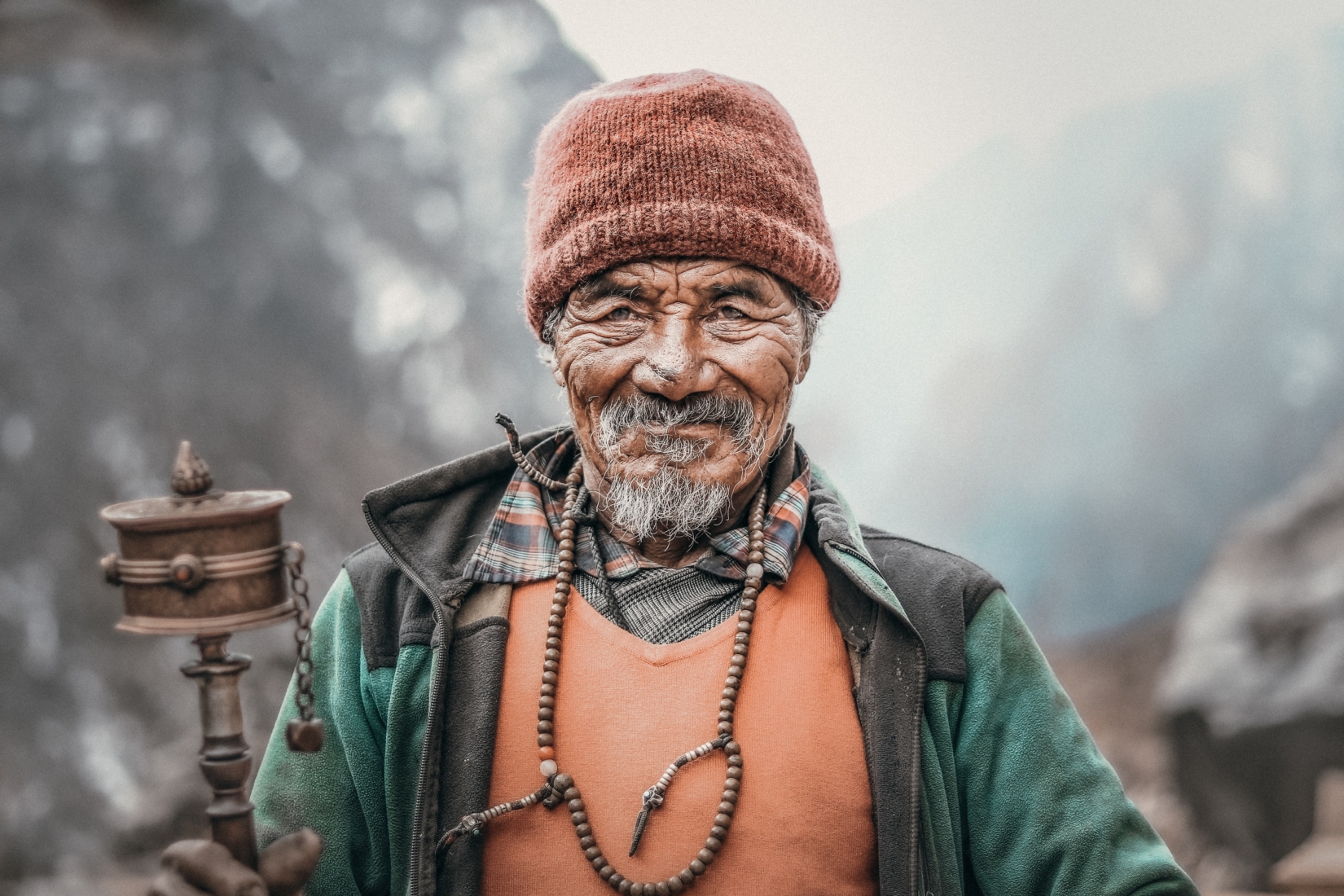
- Tengboche Monastery (Thyangboche Monastery or Dawa Choling Gompa) – The largest Buddhist gompa in the valley of Everest, Tengboche Monastery is a pitstop for determined trekkers bound for the summit. They come to light candles and ask for blessings.
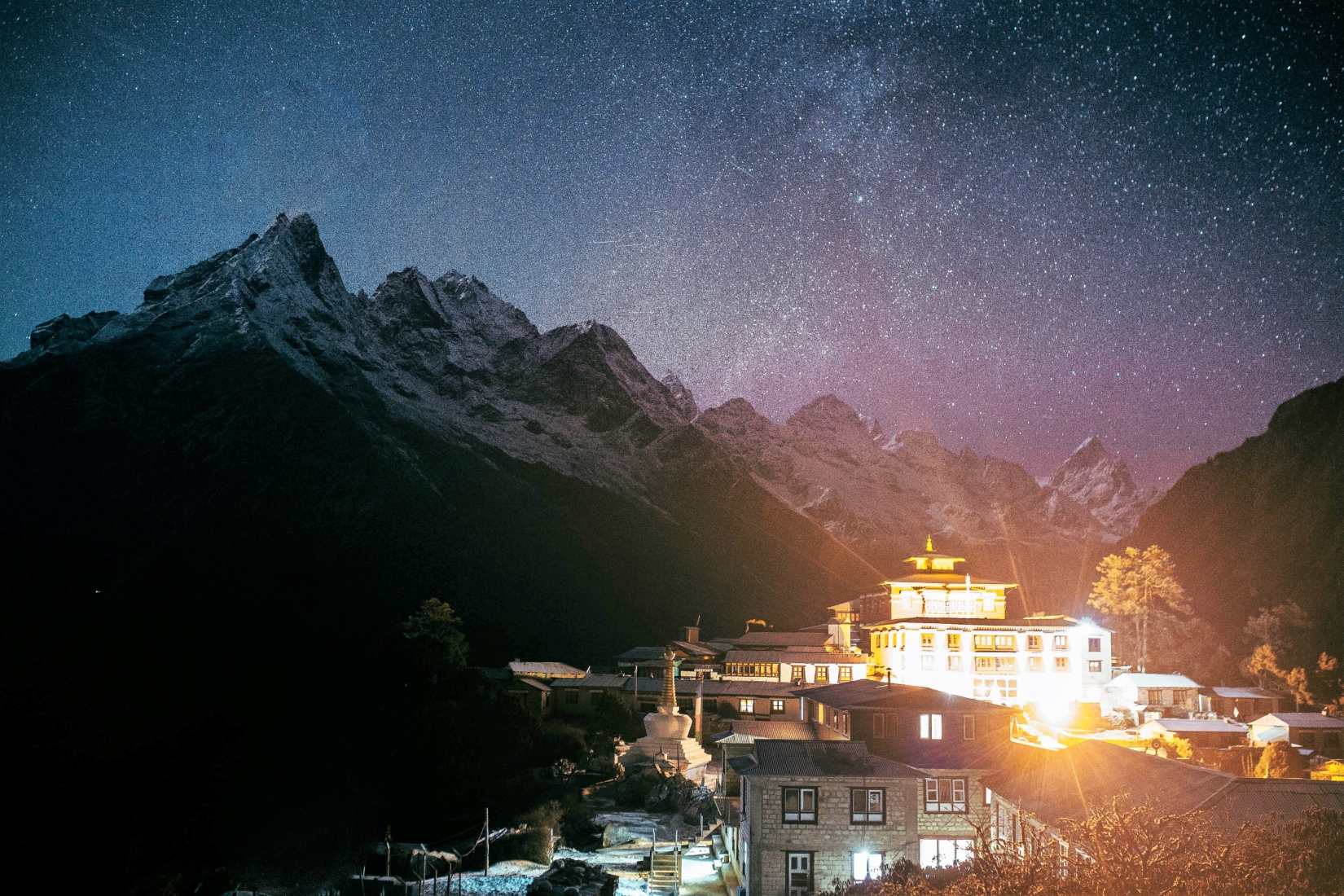
- Nangkar Tsang / Dingboche Viewpoint – Above the town of Dingboche, this detour off the main route is good acclimatization trekking and offers a panorama that takes in the Khumbu Glacier and the whole Imja Khola Valley.
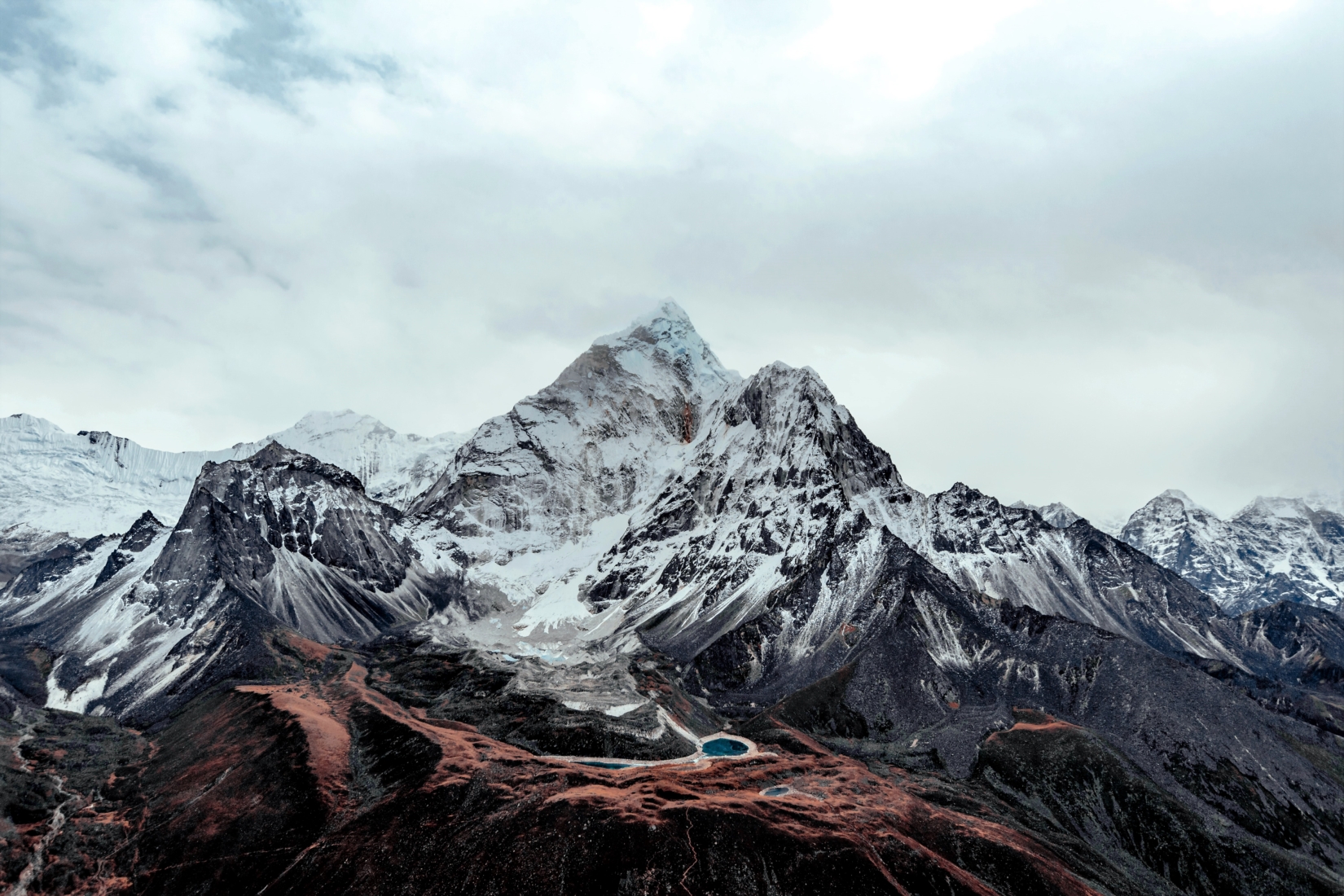
With so much natural beauty to be experienced, how much will it set you back? When it comes to pricing, costs of the Everest Base Camp Trek can range widely but the best all-inclusive tour packages start at around US$4,295 (including domestic flights to/from the trek start point) . If this number is giving you sticker shock, don’t let it deter you from the trip of a lifetime to Nepal, because my team at The Explorer’s Passage is always here to work with you and your preferences to craft a trip that fits your needs .
5. How hard is the trek? Terrain, elevation, and altitude
So just how difficult is the trek to Everest Base Camp? To answer this, you’ll have to consider the terrain and heights of EBC. Your physical fitness also plays a factor in the perceived difficulty of this adventure. Based on our Trip Activity Level Guide , we classify this trek as an advanced level, but you may be glad to know that no technical training or mountaineering experience is required.
Not sure if this Himalayan adventure is right for you? Contact us and we’ll walk you through details on the physical demands, recommended training, and more so you can make an informed decision.
The Everest Base Camp hike graduates from the alpine surroundings at the south end of the Sagarmatha National Park to the scree-covered ridges of ancient moraines in the final push towards the trekking finish line. The first sections are easier in terms of terrain but more difficult because they are constantly steep. You’ll notice this in the ascent from Lukla to Namche Bazaar, and then again from Namche Bazaar to Tengboche. The path there is largely shaded by pine and ironwood forests, muddy when wet but also interspersed with rocks wedged into the ground. You’ll stroll across suspension bridges to cross most rivers.
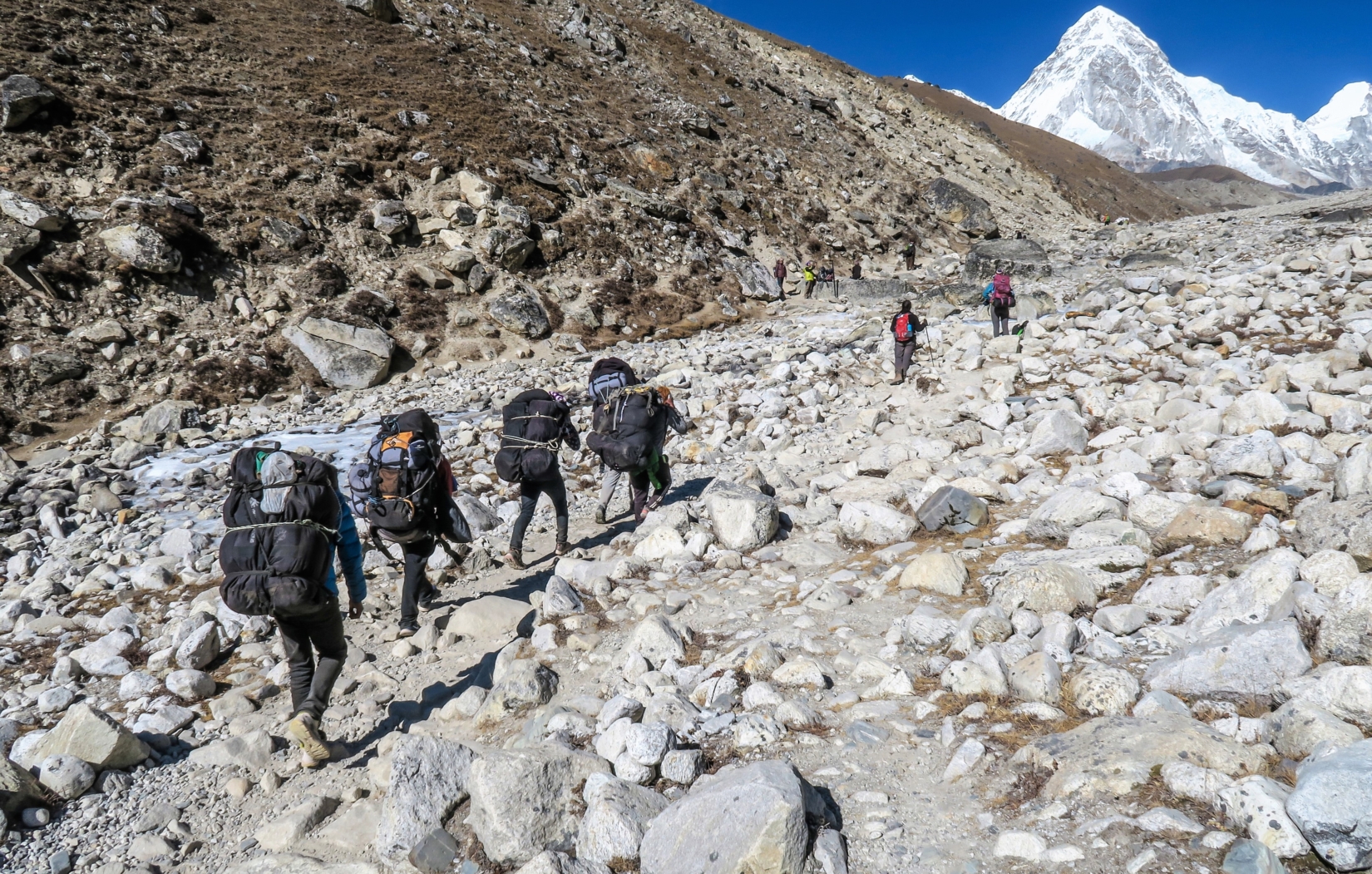
After the first few days of your trip, you’ll see that the trekking path levels a little as it skirts a wide, flat valley with the mighty Himalayas looming on all sides. This is where you lose the tree cover for good, so be sure to have the sunscreen handy. It’s rock and grit underfoot until you near Gorak Shep. There, the route sort of merges with the great pebble and rock moraine at the end of the Khumbu Icefall. It’s normal to find snow coverage in those parts, especially if you’re trekking between November and March.
Elevation and altitude
How high is Everest Base Camp? Well, altitude is commonly travelers’ biggest challenge on this tall trek. As mentioned before, you’re going to have to clock up a hefty 17,598 feet (5,364m) above sea level. You’ll manage 9,400 feet (2,865m) at the EBC trailhead, which is taken care of by the flight from Kathmandu to Lukla. The rest is up to your legs. You’ll knock out about 1,800 feet (549m) by climbing to Namche Bazaar. After that, days on the trail (not including acclimatization days) average around 1,200-1,600 feet (366-488m) in elevation gain, though it’s on less-steep paths once you cross the tree line around Tengboche. Everest Base Camp elevation is no joke and can be difficult for some.
Acute Mountain Sickness (AMS) – the mildest form of altitude sickness – is certainly a risk here. It can affect anyone over altitudes of 8,000 feet (2,438m), but usually has severe impacts at higher levels. Since the EBC Trek reaches altitudes of more than double the height where AMS can possibly kick in, there are usually two full acclimatization days planned in – one in Namche Bazaar and the another in Dingboche or Lobuche. These days aren’t for resting but instead used to climb high and then descend to sleep at lower altitudes, a common practice that’s known to help the body acclimate to conditions at higher elevations.
Don’t be surprised if your Everest Base Camp Trek guide constantly reminds you to drink enough water as it’s another way to combat AMS. Once you hit the higher altitude parts of the path, you can typically expect your guide to be prepared with a supply of oxygen, should you need it. You might also want to consider packing an AMS medication like Diamox on your trip to Nepal.
Even seasoned alpinists find the trip a challenge and lots of climbers struggle with Acute Mountain Sickness. Just remember: no pain, no gain on this most incredible of trails! On this trip, you’ll see the sheer majesty of the Nepalese Himalayas up close and scale to viewpoints that are simply some of the best you’ll ever hike to.
6. Food on the Everest Base Camp Trek
All that trekking is going to work up a serious appetite, you can be sure of that. Thankfully, EBC teahouses tout some decent grub for when it’s time to refuel. Don’t be surprised to find that the menus are virtually identical the whole way along, even if the dishes themselves vary greatly with the whims of different chefs up and down the trip route.
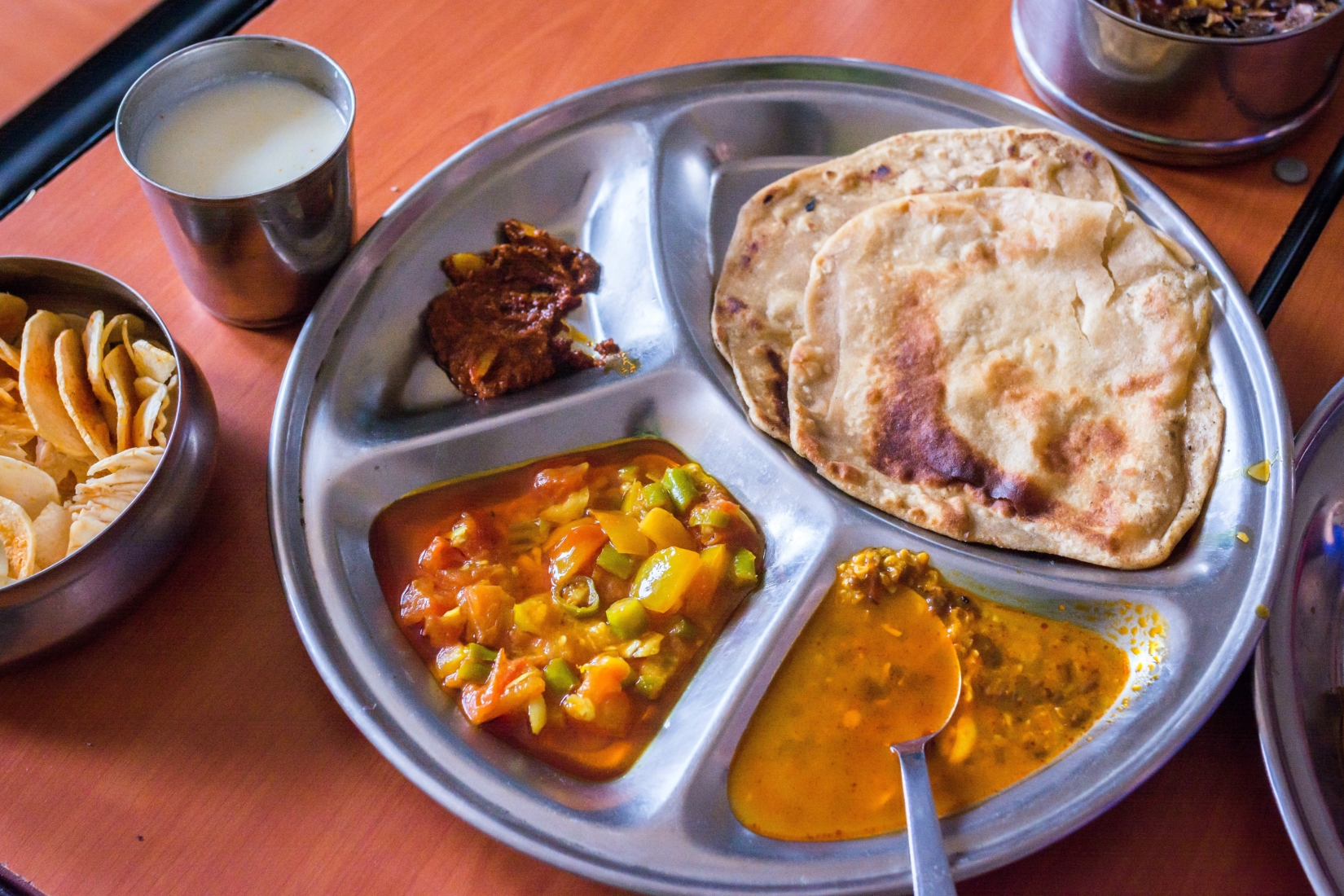
Common dishes include:
- Dal bhat – The most popular EBC meal of all. Every hiker who’s done the route has warmed up with this spicy lentil stew at least once. It’s usually served with rice and chapati flatbread.
- Egg and fries – A hearty option for those feeling really hungry, this one includes hand-cut, fried potatoes and a double-egg omelette.
- Shyakpa ( Sherpa stew ) – A classic favorite of sherpas in Nepal and a great vegetarian option that’s basically broth with cut potatoes, carrots, and other root vegetables.
- Pizza – Some teahouses try their hand at pizza. We’ll let you be the judge of whether or not the Italians would be proud.
Is your mouth watering yet? These dishes will surely give you the energy you need to power through the trek.
7. Accommodations on Everest Base Camp
Apart from the hotels in Kathmandu at the start and at the end of your quest, all of your accommodations on the Everest Base Camp Trek route are likely to be teahouses. Don’t let the name fool you – these aren’t just places to stop for a hot drink. They’re actually full-fledged bed and breakfast lodges purposely designed to host travelers.
EBC teahouse accommodations in Nepal are simple, clean, and comfortable. The general rule is that the quality is better towards the start of the trek, where the teahouses are both larger and better supplied. Rooms are usually minimally decorated. They have wood-paneled or plastered walls and, for the most part, a single window, along with low-rise beds with foam mattress pads. Some have in-room heating, while other teahouses are warmed by a central stove that’s kept alight in the evenings. Some places offer hot showers, but most only offer cold. Electrical charging of devices is on offer at most places, though that could come at an extra cost.
For more details on accommodations, check out our Everest Base Camp tour page .
8. Best time to trek to Everest Base Camp
There are two main seasons for trekking to Everest Base Camp in Nepal. The first is in the spring (late March to May) and the second comes in the autumn (late September to November) . Both high seasons essentially straddle the main monsoon season, offering more dryness and clearer skies without too much precipitation. Although, it’s important to note that zero rain can never be guaranteed this high up.
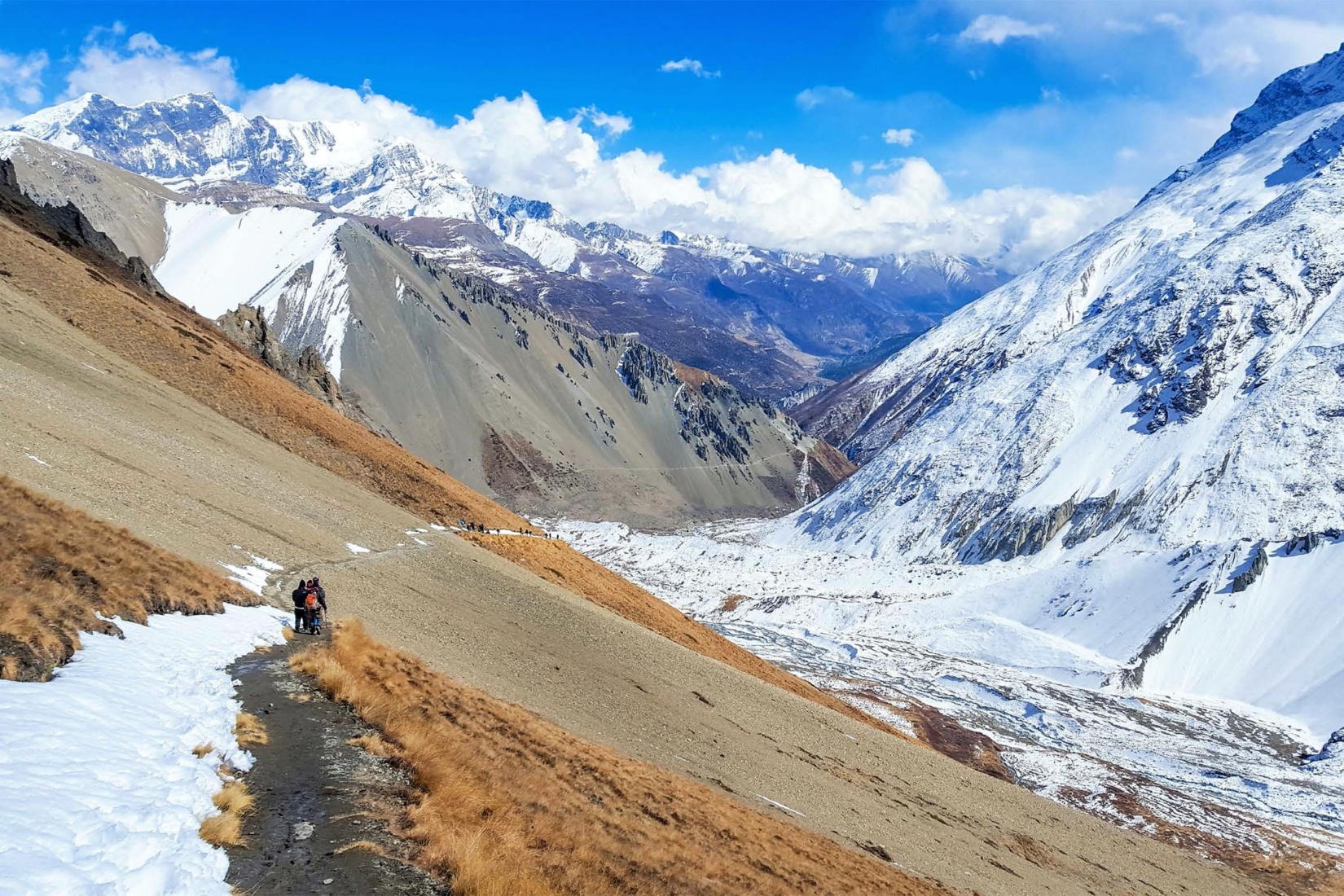
Here’s a breakdown of the best months to go:
- March – Marks the beginning of the trekking season proper but it’s not its peak. That means a good balance of smaller crowds, availability in teahouses and affordability. Most of the ground snow has melted by this point, but rising temperatures do mean there can be some heat haze to obscure the views.
- April – The busiest time of all on the Mount Everest Base Camp Trek, but for good reason: Clear skies abound, the views are wonderful, and temperatures are comfortable. You can also come in April if you’re keen to see the hardcore mountaineers prepping for a summit push up Mount Everest itself.
- May – The hottest month on the trail with less harsh conditions in the evening. Downsides include heat haze that can obstruct the views and the potential for some early-monsoon rains.
- September – The first month after the monsoon can see some rains stick around. However, that also means the lower-altitude parts of the trek between Lukla and Namche Bazaar are wonderfully lush with flower blooms and vivid greenery.
- October – Second only to April in terms of crowds of travelers. Lots of people hit the EBC trail at this time because there’s a great balance between comfortable temperatures and clear skies. In fact, I’d say that this is the clearest time of all, so it’s perfect for those wanting uninterrupted views of Everest.
- November – Cold winter conditions can start to set in by November. It’s not unusual to encounter snow at higher altitudes and you’ll need proper thermal gear to get through the nights. The payoff is super-clear skies and way fewer hikers on the trail.
December to February is the low season for one main reason: Snow. Temperatures during these colder days drop to an average of 25 degrees fahrenheit (-4℃) in the middle of the winter season, and that’s in Namche Bazaar, one of the lowest points on the trek. It’s not ideal for overnight hikes that rely on teahouses made of plywood walls. That said however, completing the EBC certainly isn’t impossible at this time, it just presents unique challenges. You’ll need way more thermal layering, special trekking equipment to handle the snowdrifts, and probably extra days to complete the trek. The upside is that winter days offer very clear skies and there’s rarely a big crowd on the trail.
9. What gear and equipment should I pack?
When considering what to pack for your trip, it’s good to know there are strict limits on the weight each passenger can take on that initial flight from Kathmandu to Lukla. What’s more, there are limits on the size and weight of bags that you can ask porters to shuttle up and back to EBC for you. Due to these limits, you’ll want to think very carefully about what to bring for this once-in-a-lifetime trek. As a general rule, it’s good to stick to about 22-33 pounds (10-15kg) in your main pack, with a small 30-litre day pack on the side to carry the things you’ll need on the trail.
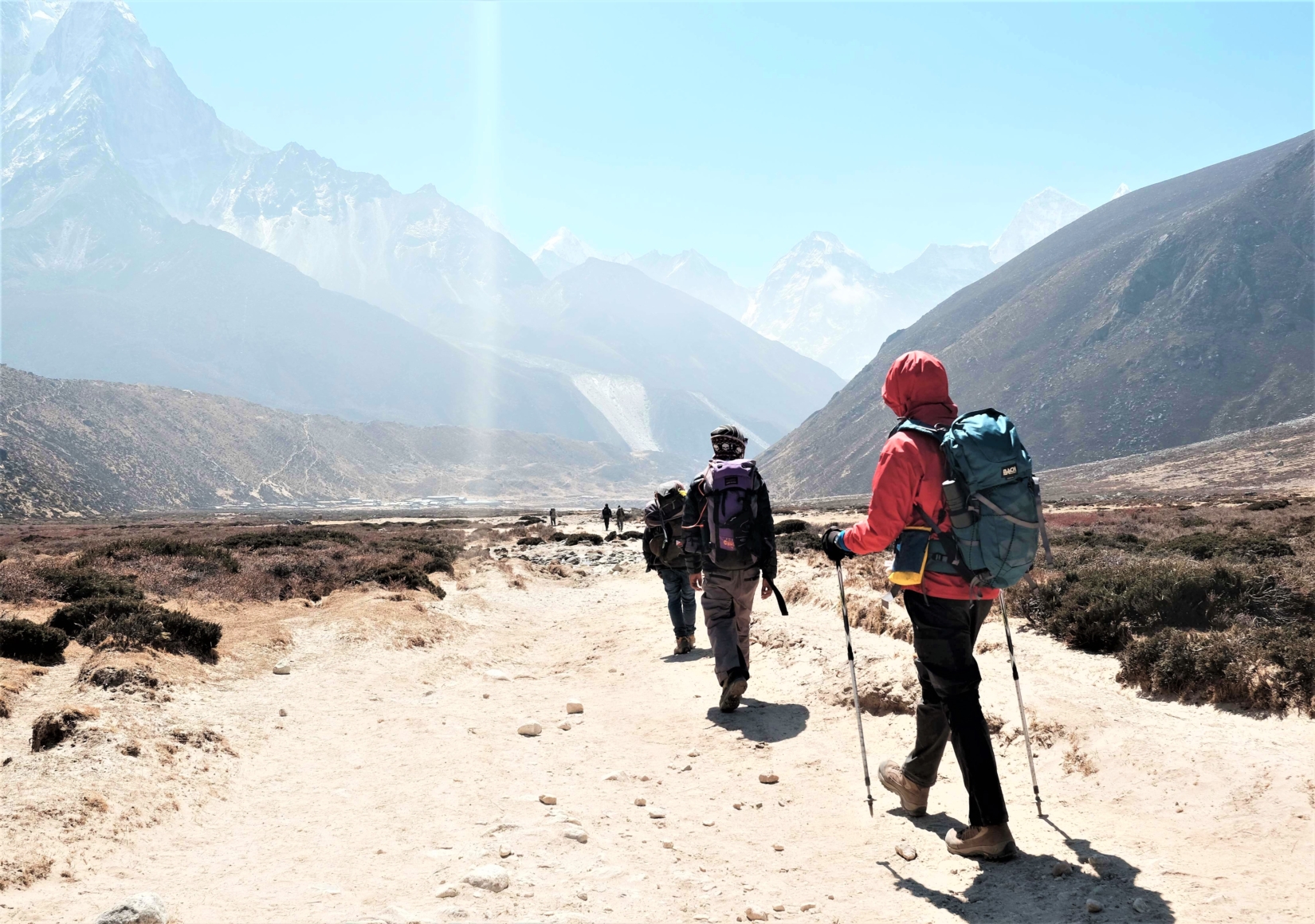
Layers are always key in the Nepalese mountains, as temperatures can warm up considerably during the day and drop suddenly at night. You’ll want to be able to add and remove fleeces and thermals on the upper body to match the fluctuating temperatures. For the lower body, I’d recommend bringing both shorts (mainly for the lower elevations of the trek where it can be positively balmy) and sturdy trekking pants (for higher elevations), backed up by good thermal-rated underlayers.
Waterproofs are also essential for your trip. Rain and snowfall can come without warning in the high Himalayas, and weather patterns on the EBC Trek have little respect for the so-called high season, so inclement weather can happen any time of the year. Winter trekkers will need to plan a little more, though, in order to deal with all that ground ice and much colder conditions.
On top of that, you’ll need to think about all those hiking essentials. Good boots, a pair of hiking poles you feel comfortable with, both a wool hat and a sun hat, strong sweat-resistant sunscreen, headlamps, and a decent-capacity water bottle should all be on your packing list.
That’s just scratching the surface, but The Explorer’s Passage will make sure you’re fully prepared for your chosen season on the EBC route when you plan with us – just ask us for a full packing list !
10. Should I use a porter service?
Put simply, porters are essential on the trek to Everest Base Camp. They’re very much the superheroes of the expedition, transporting the bulk of most trekkers’ gear and equipment from camp to camp outside of Lukla or Namche Bazaar. For larger groups of trekkers, some operators will utilize animal support for transport assistance. Porters will carry one standard rucksack or duffle bag per hiker. Usually, that’s limited to a weight of between 22-33 pounds (10-15kg) per person, though it can be lower or higher depending on the Everest Base Camp tour you pick. That leaves you to only carry what you need for the day. As mentioned above, a 30-litre pack typically works best, just enough for water, snacks, fleece and waterproof layers, your camera, and sunscreen.
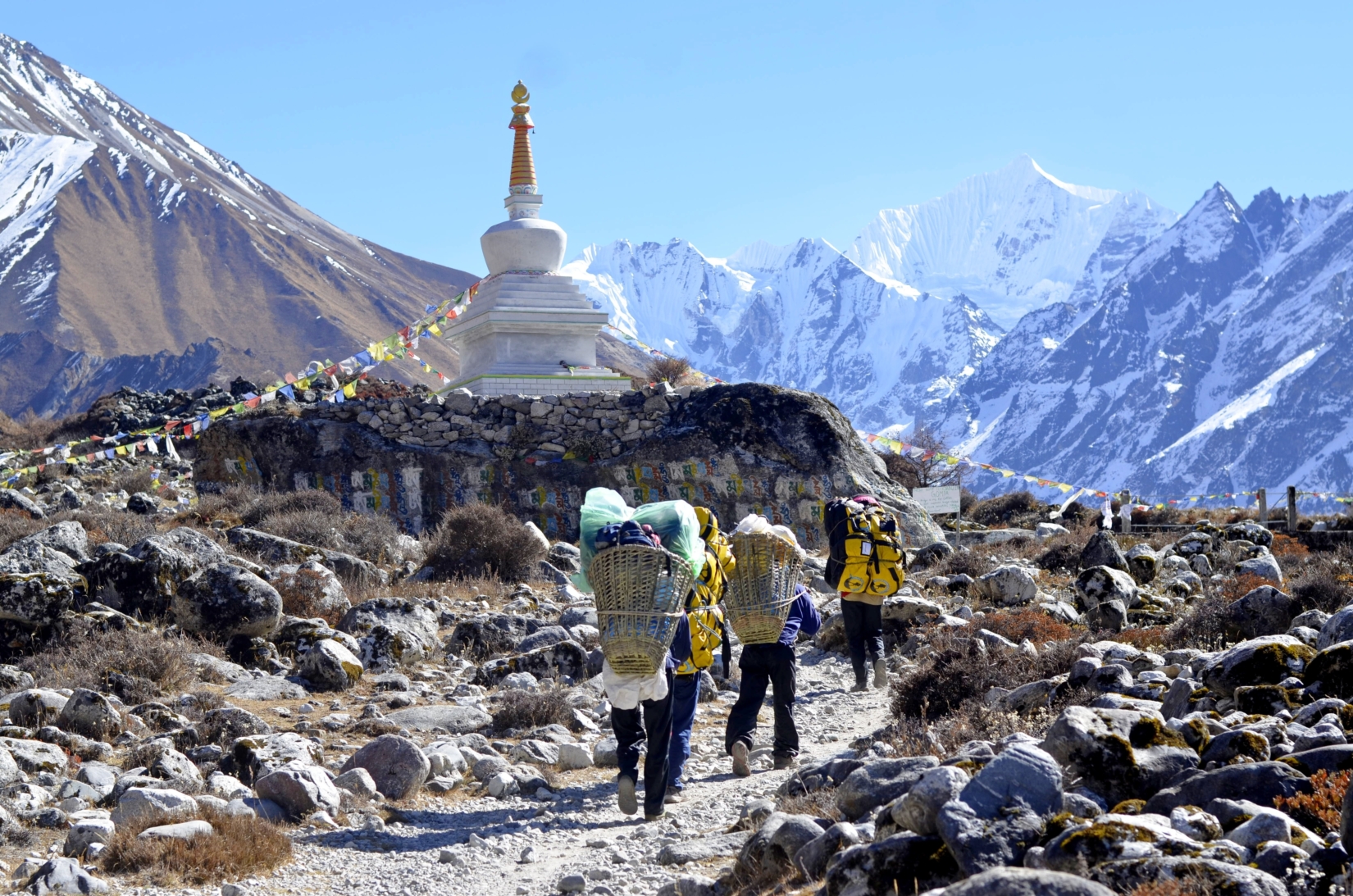
I do, occasionally, see people who choose not to engage a porter but that’s a tough task. Ultimately, when you’re deciding whether or not porter service is right for you, remember that the Mt. Everest Base Camp hike involves several days of walking at altitudes over 12,000 feet (3,658m) above sea level, on tricky terrain to boot. It’s a challenge even without 44 pounds (20kg) of gear strapped to your back!
11. Getting there
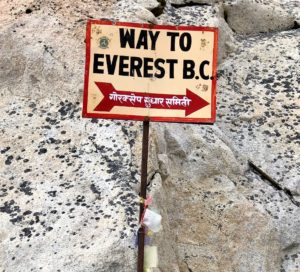
So now you know what this infamous excursion holds and you can’t wait another moment to go, how will you get there? The trip to the start of EBC is a journey in itself. You’ll first jet into Kathmandu, the heady, rickshaw-rattling capital of Nepal. It’s an amazing place, filled with UNESCO temples and the aromatic spices of Nepalese curry houses. We usually recommend that travelers arrive at least a couple of days before they are due to set off for the trek, not really to help with altitude acclimatization – Kathmandu is a relatively modest 4,500 feet (1,372m) up – but more for cultural acclimatization.
Doing that means you’ll have time to score any last-minute gear you might have forgotten for the hike itself. Kathmandu has plenty of decent outfitters that offer good deals on key items like down sleeping bags and thermals. It also means you’ll get to see some of the great cultural treasures of the country, including the tower-topped temples of Durbar Square and the colossal Boudhanath Stupa, which is usually writhed in prayer flags dancing in the wind.
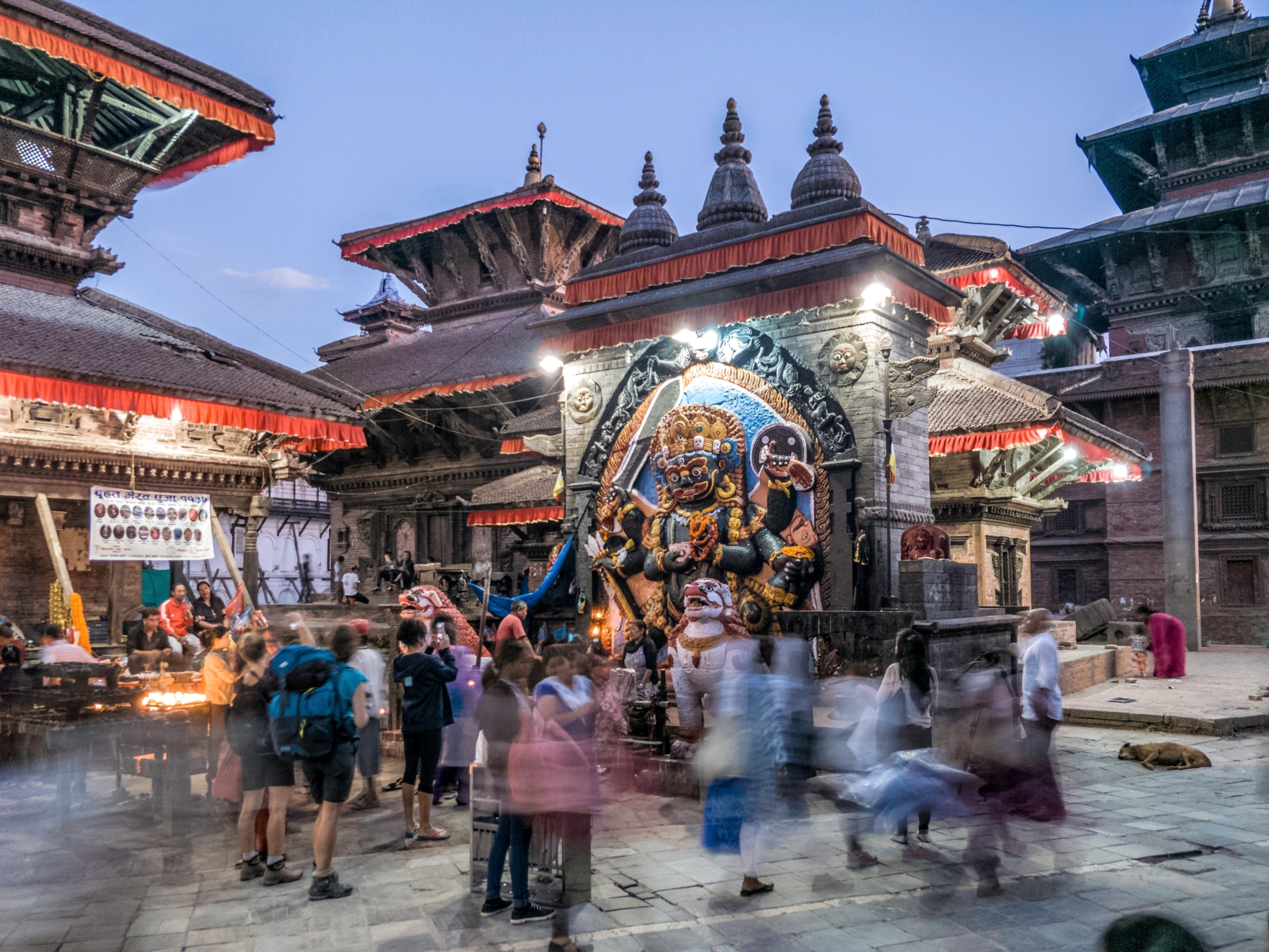
After Kathmandu, there’s a short-haul flight from the domestic terminal of Kathmandu Airport that takes you all the way to the trailhead of Everest Base Camp in Lukla. The plane ride is relatively quick – about 30 minutes total – and pretty spine-tingling, especially as the landing strip on the Lukla side sits a whopping 9,300 feet (2,835 meters) above sea level on a precipitous mountain plateau. It’s not a flight you’ll forget in a hurry!
12. Travel visas and permits
Some nationals of specific countries can enter Nepal without a visa, but most travelers will require one. For those who do, entry visas for tourists traveling into Nepal are generally available in advance or upon arrival at Tribhuvan International Airport and various land borders. If you’re unsure of which category you fall into, use this easy tool to double check your entry and health requirements .
When it comes to permits, there are no permits for the Everest Base Camp Trek itself, at least not like there are for the Inca Trail and some other bucket-list hikes elsewhere on the planet. However, there are limits to the number of guests teahouses can host (so it’s important to book early) and you will be passing through some regions and conservation areas that require visitors to obtain special passes, but no need to worry as The Explorer’s Passage will handle all of these details for you. Just make sure your travel documents and essentials are still valid.
For the route to Everest Base Camp from Lukla, there are two key documents that we will secure for you:
- Khumbu Pasang Lhamu Rural Municipality Entrance Permit – This is a pass for access to the whole Khumbu region.
- Sagarmatha National Park Entry Permit – This is your pass to enter the national park that contains Mt. Everest.
It is important to note, those looking to do the longer, 20-day extension to the EBC Trek, going from Kathmandu by road and then onwards by foot from Jiri, will also need a pass for access to the Gaurishankar Conservation Area.
13. A typical Everest Base Camp Trek itinerary
The temple-topped, bazaar-busting city of Kathmandu is likely to be where you enter Nepal. You’ll definitely want to take some time out of your trip to explore this amazing city first. Then, it’s time to head northeast to start your Everest Base Camp hike. Most travelers do that with a flight to Lukla and then walk from there, but it’s also possible to trek all the way if you have the time. Still, most Everest Base Camp Trek itineraries officially start at Lukla airport.
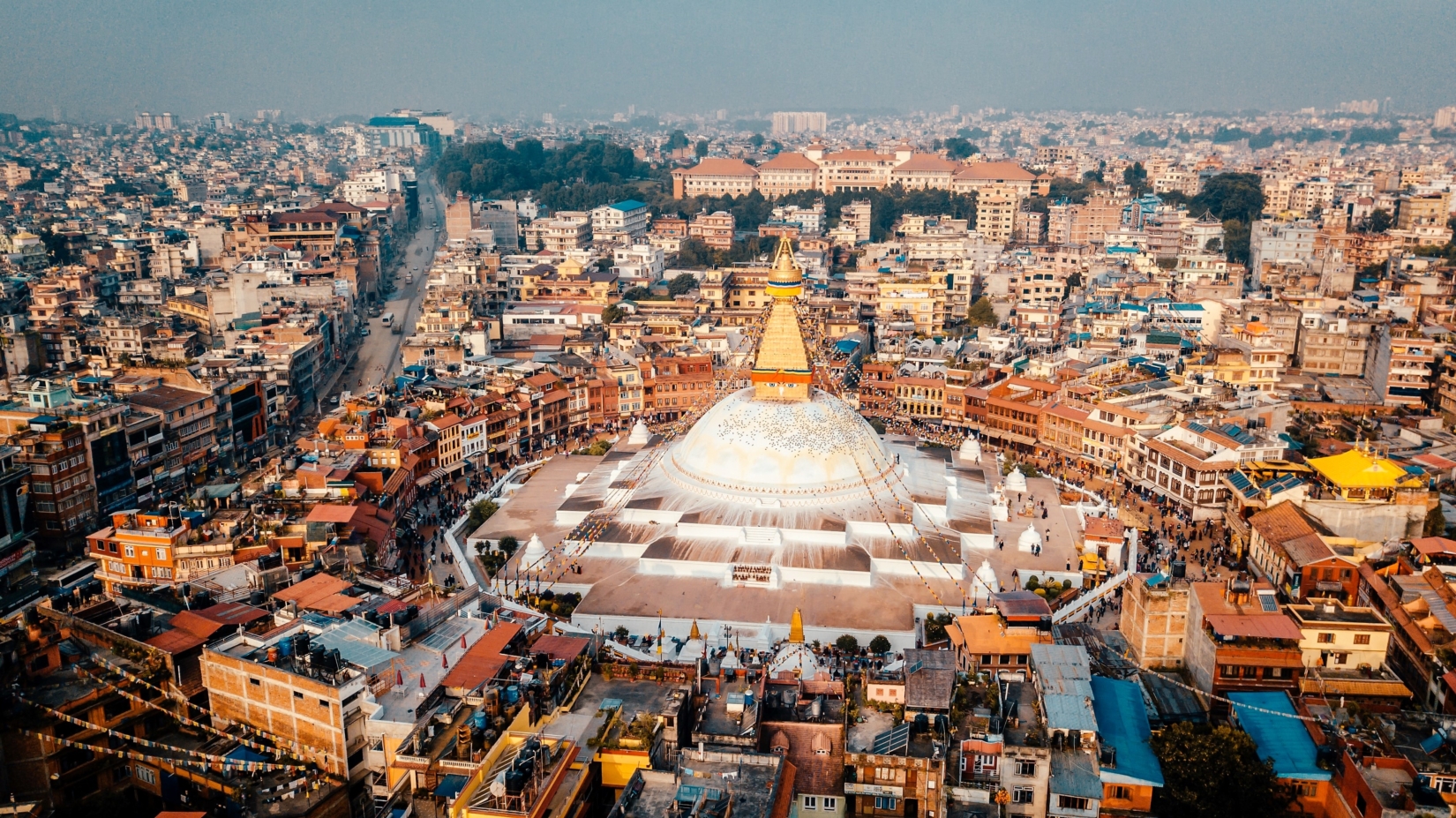
For a customized itinerary, connect with us to craft your ideal trip.
- Day 1: Namaste and welcome to Kathmandu! Get ready to experience one of the most awe-inspiring journeys our planet has to offer. You’ll arrive in Kathmandu and explore the dynamism, scenery, and history the city has to offer.
- Day 2: Today will be filled with cultural immersion. Begin by exploring three UNESCO World Heritage Sites. The first is Boudhanath, one of the largest stupas in Nepal. Next is Pashupatinath, a sacred Hindu temple located on the banks of the Bagmati River. Finally, you’ll visit Durbar Square, which sits in front of the old royal palace. Finish your day with one of the most classic walks through the old narrow streets of Kathmandu. In the heart of this city, soak up the buzzing atmosphere of the local markets and stores, before heading back to the hotel.
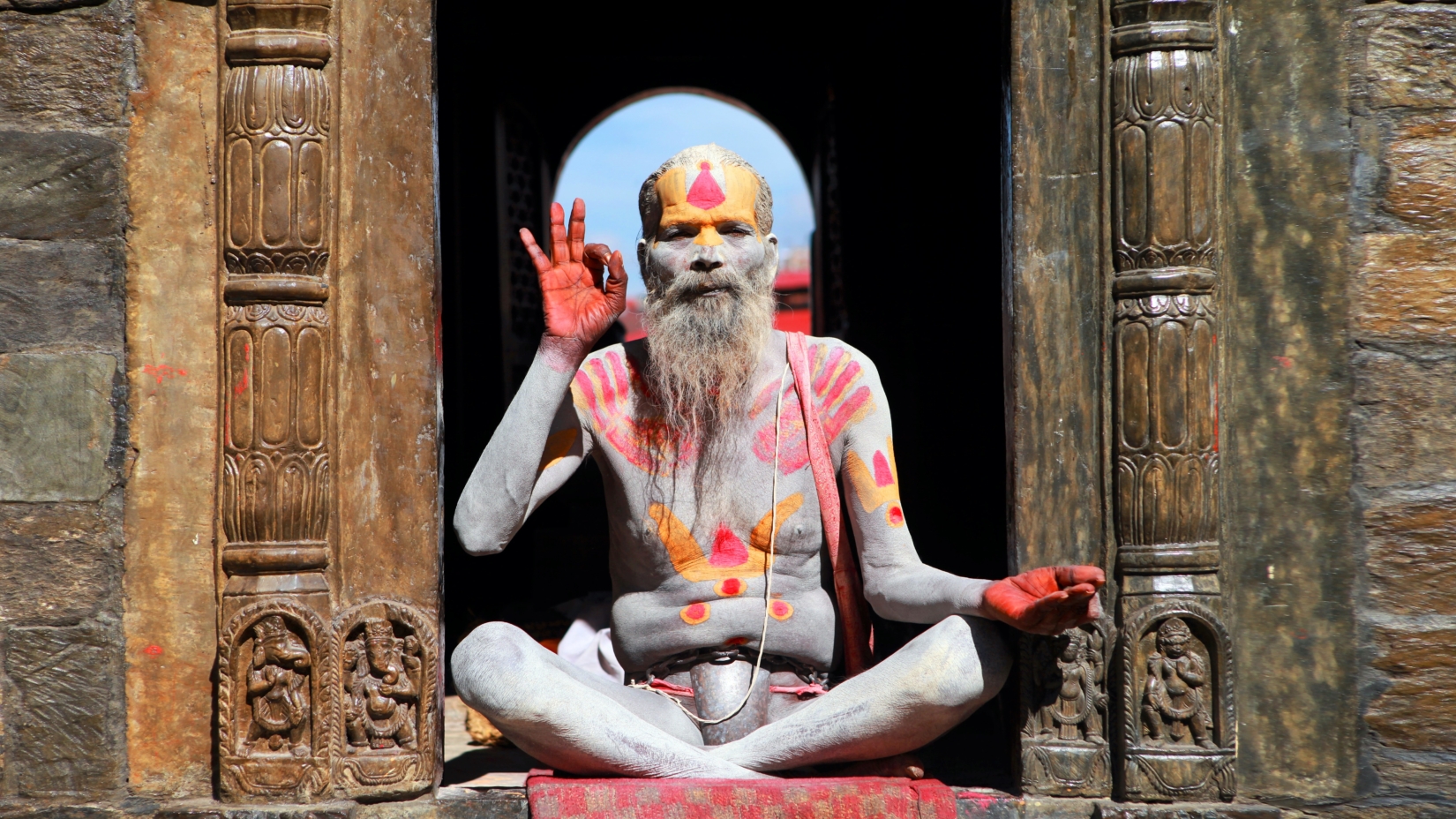
- Day 3: Kathmandu to Phakding (8,562 ft / 2,610 m) – After a short flight to Lukla, it’s a pleasant hike through dense pine forests and steep gorges traversed by swinging suspension bridges. There’s a real bustle about this part of the path, with oodles of hikers fresh onto the trail to chat to. It’s also the lushest part of the trail, with wildflowers and roaring riverways, more Alps than Himalaya.

- Day 4: Phakding to Namche Bazaar (11,286 ft / 3,440 m) – Today you’ll go up to the main hub of EBC: Namche Bazaar. This is a good place to stock up on any essentials you may have forgotten to bring on your trip. Enjoy the town that’s abuzz with hiker cafes and lodges, and comes with stunning views of the jagged Mount Khumbu Yül-Lha (Khumbila), loosely translated as “God of Khumbu” peak, to the north.
- Day 5: Namche Bazaar (11,286 ft / 3,440 m) – This is your first official acclimatization day. The best way to prepare for the altitude is to hike high during the day and return to lower altitudes in the evening to sleep. The Khunde and Khumjung Loop is the perfect option for that, taking you to long-lost Sherpa villages with mystical Buddhist stupas.
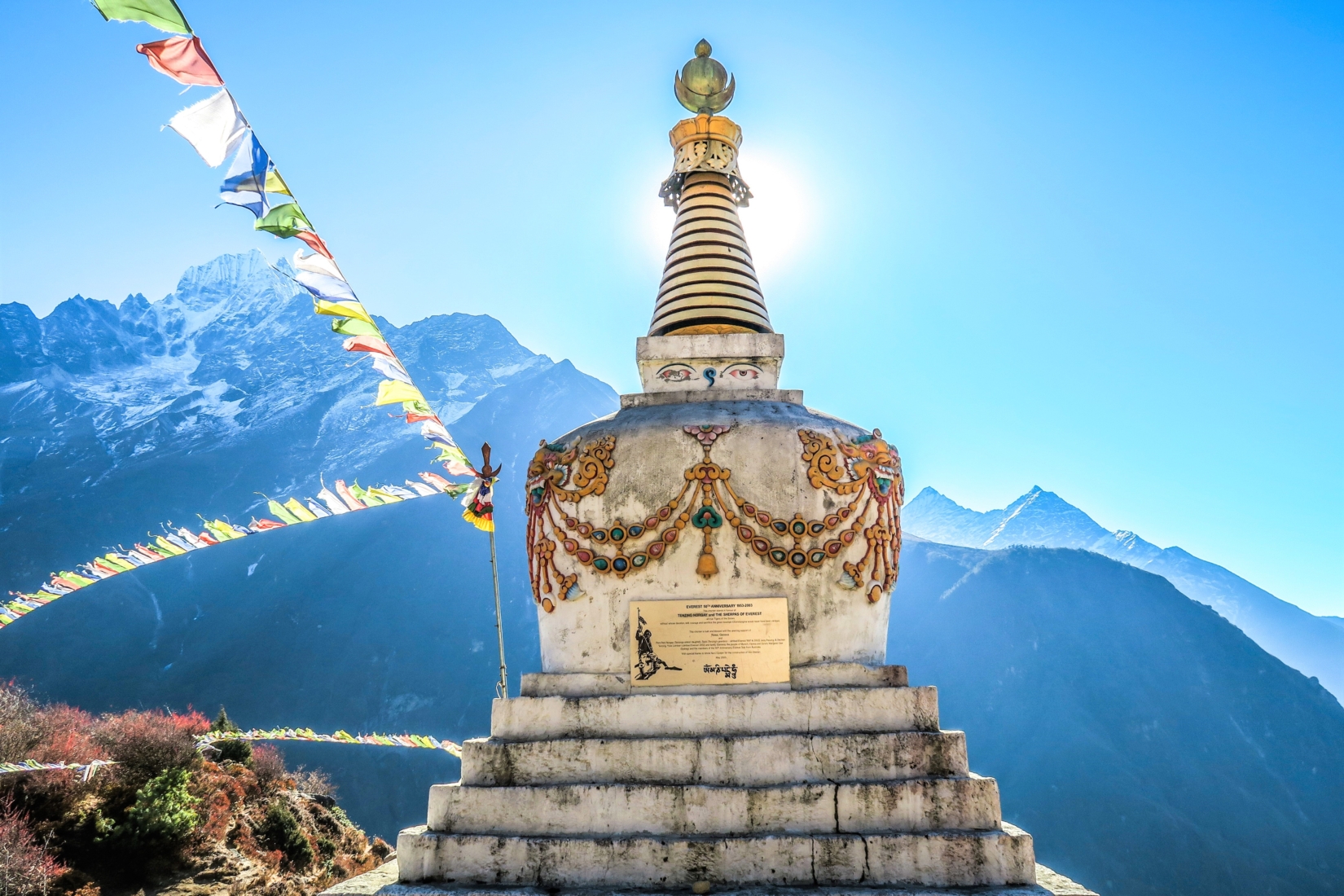
- Day 6: Namche Bazaar to Tengboche (12,664 ft / 3,860 m) – Your first steps on the Everest Base Camp Trek proper begin with a steep incline that takes you almost out of the treeline. The path levels and then emerges into a lunar-like world of big brown rocks where the Himalayas draw ever closer. The destination? The rhododendron forest, where you’ll stay for the evening.
- Day 7: Tengboche to Dingboche (14,470 ft / 4,410 m) – Expect exposed trekking except for some sections through high-altitude pine woods. Later in the day, the trail wiggles across the sides of Ama Dablam peak and you’ll get to appreciate the Everest massif in all its glory looming overhead.
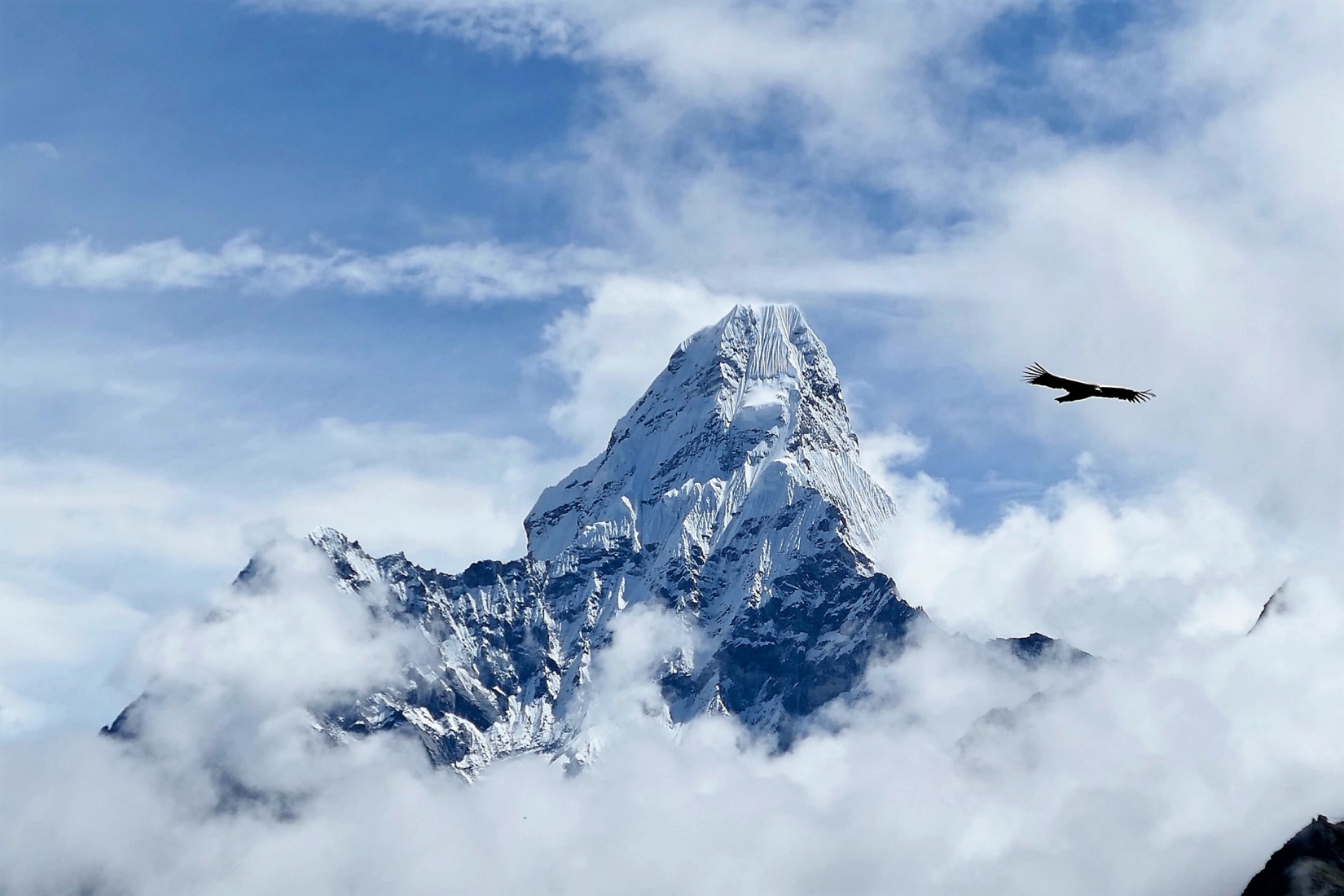
- Day 8: Dingboche (14,470 ft / 4,410 m) – A second acclimatization day is needed at this stage of the trip. Perhapstake some time to experience Chukhung (15,518 feet / 4,730 meters), a place traditionally used to raise yak. Lodges rise up amongst the peaks, making it a perfect spot for relaxation, observation and absorbing the scenery and local life.
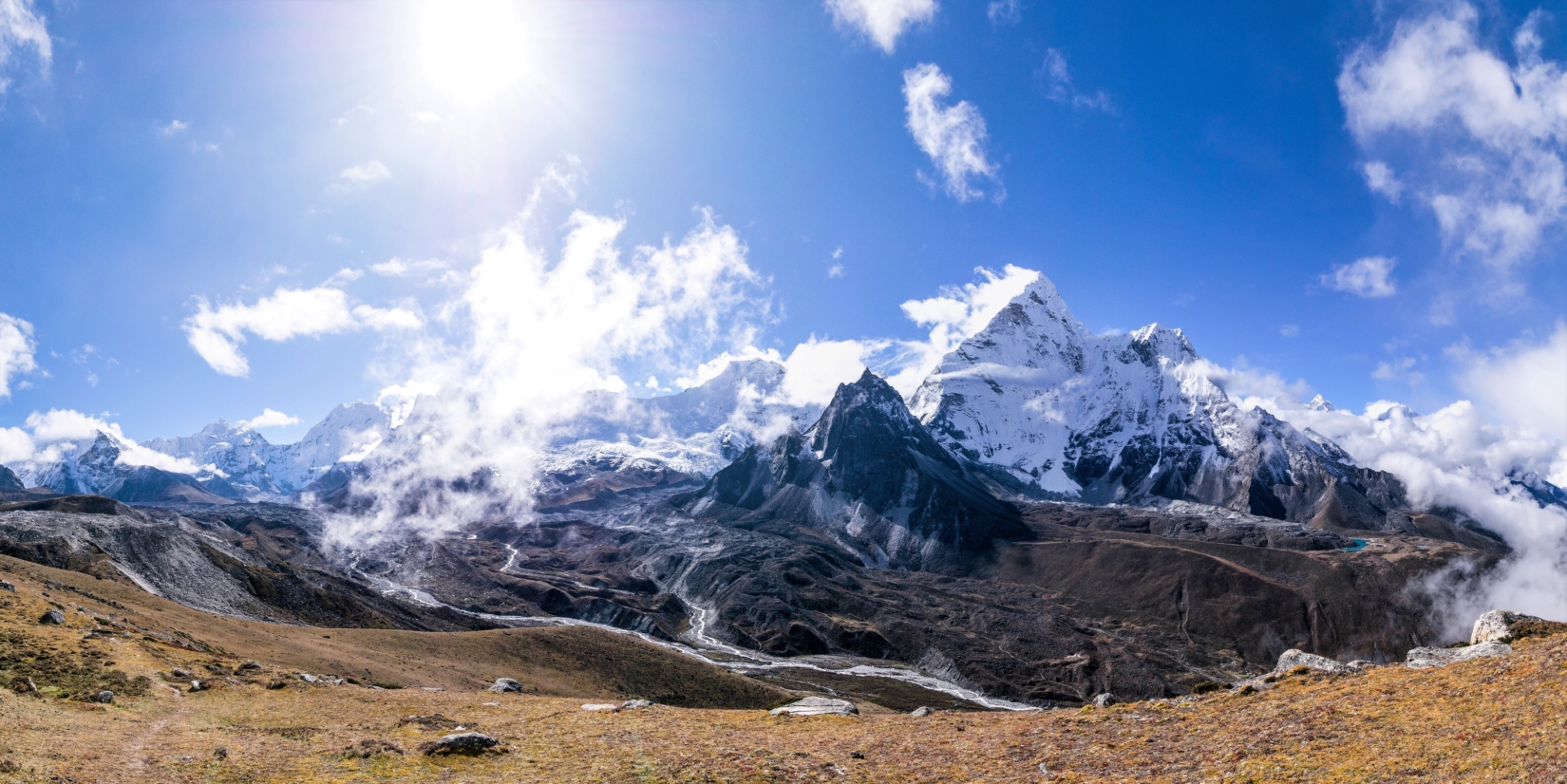
- Day 9: Dingboche to Lobuche (16,210 ft / 4,941 m) – You’re now onto the penultimate push towards Everest Base Camp. Welcome to the high Himalayas. Trees are long gone in this land of rugged rocks and the cascading tongues of glaciers. The day includes some amazing visions of the approaching Everest massif, especially the closer face of Nuptse.
- Day 10: Lobuche to Everest Base Camp (17,598 ft / 5,364 m) – The final part of the trail starts by weaving over rocky highland terrain and then passes through the Gorak Shep village, where a small trekking lodge clutches the edge of the Khumbu Icefall. There’s a chance of a small rest there, but not for long, because EBC is only another 1.5 hours up the valley!
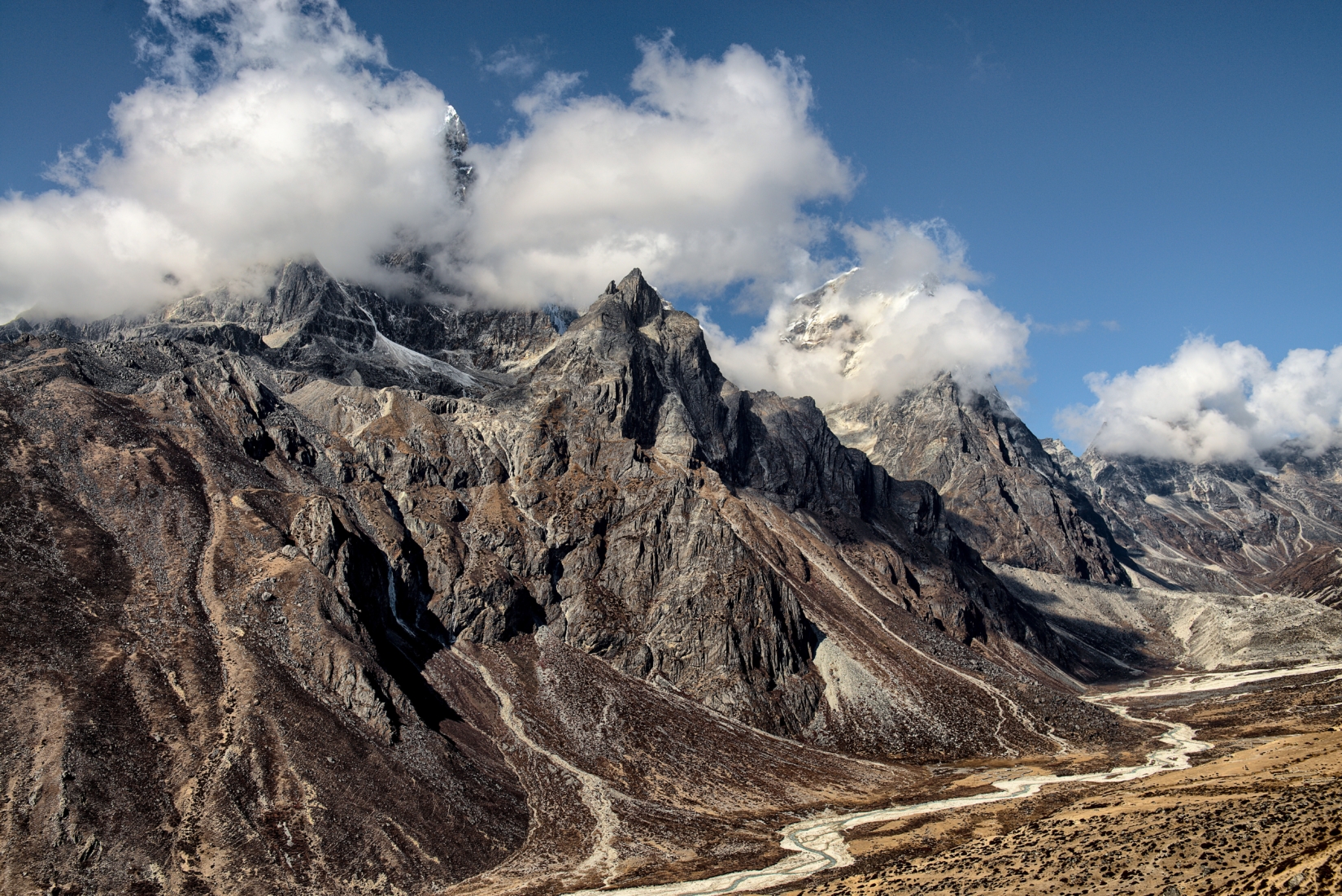
- Day 11: Everest Base Camp to Pheriche (14,340 ft / 4,371 m) – Today you’ll retrace your steps towards Pheriche, hiking first towards Kala Patthar. Oxygen begins to increase and much of this portion is downhill, and you’ll have the chance to take in the panoramic views with an easier trek.
- Day 12: Pheriche to Debouche (12,533 ft / 3,820 m) – You’ll work back via Deboche, passing the Old Nunnery. Follow the river back towards Debouche, a campsite, not far from the Tengboche Monastery.
- Day 13: Debouche to Namche Bazaar (11,286 ft / 3,440 m) – Today you’ll double back towards Namche Bazaar, the Sherpa village that is the hub of activity and local culture. Here you’ll see many porters like Norgay, who aid climbers and know this terrain better than anyone. Observe the local mountain life, as you continue on tomorrow towards Phakding.
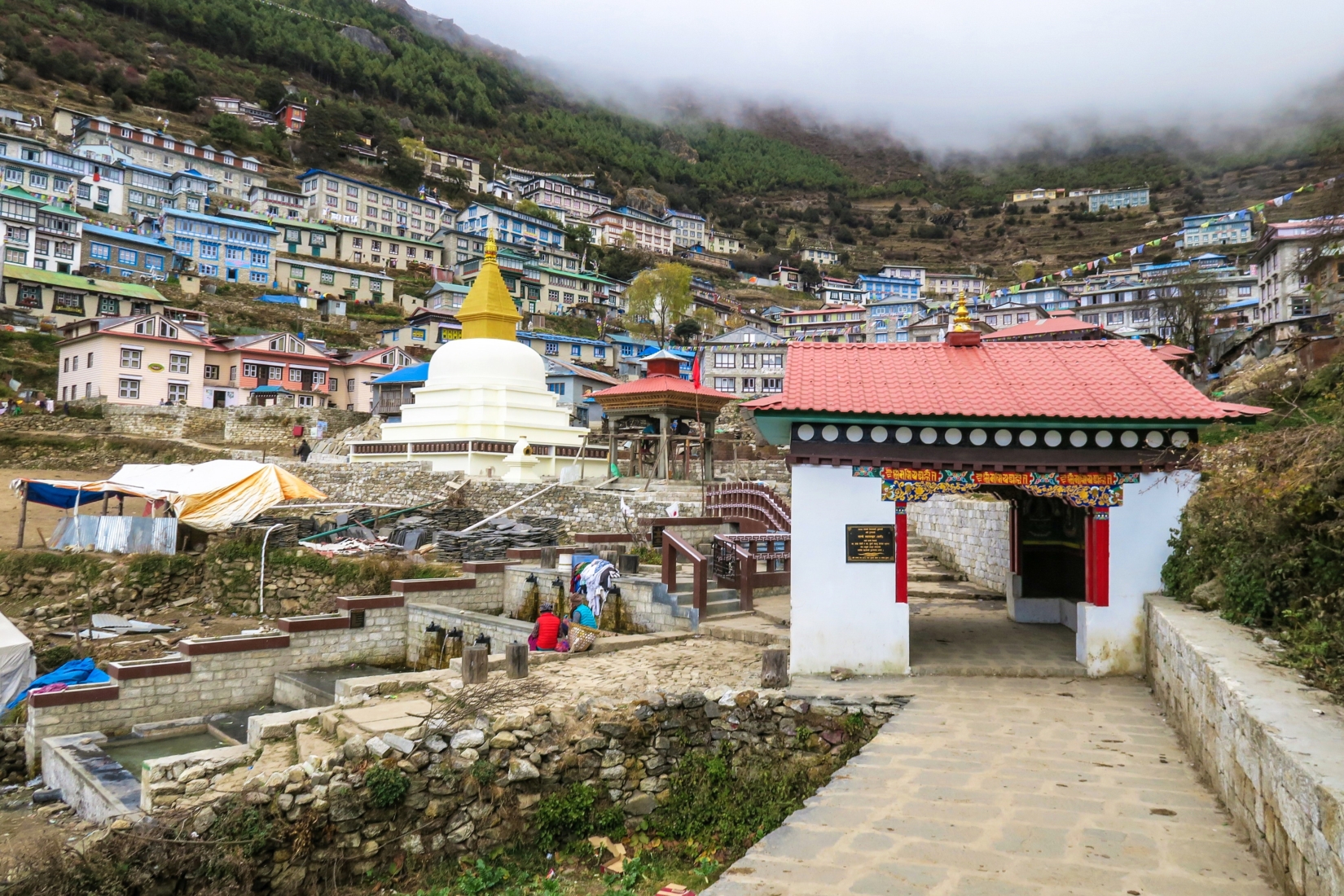
- Day 14: Namche Bazaar to Phakding (8,562 ft / 2,610 m) – As you continue downhill towards Phakding, observe the local agriculture and yak pastures as you pass by the majesty of the Himalayan peaks. You’ll spend the evening alongside the Dudh Kosi River, and take in the sights and sounds of the crystalline waters.
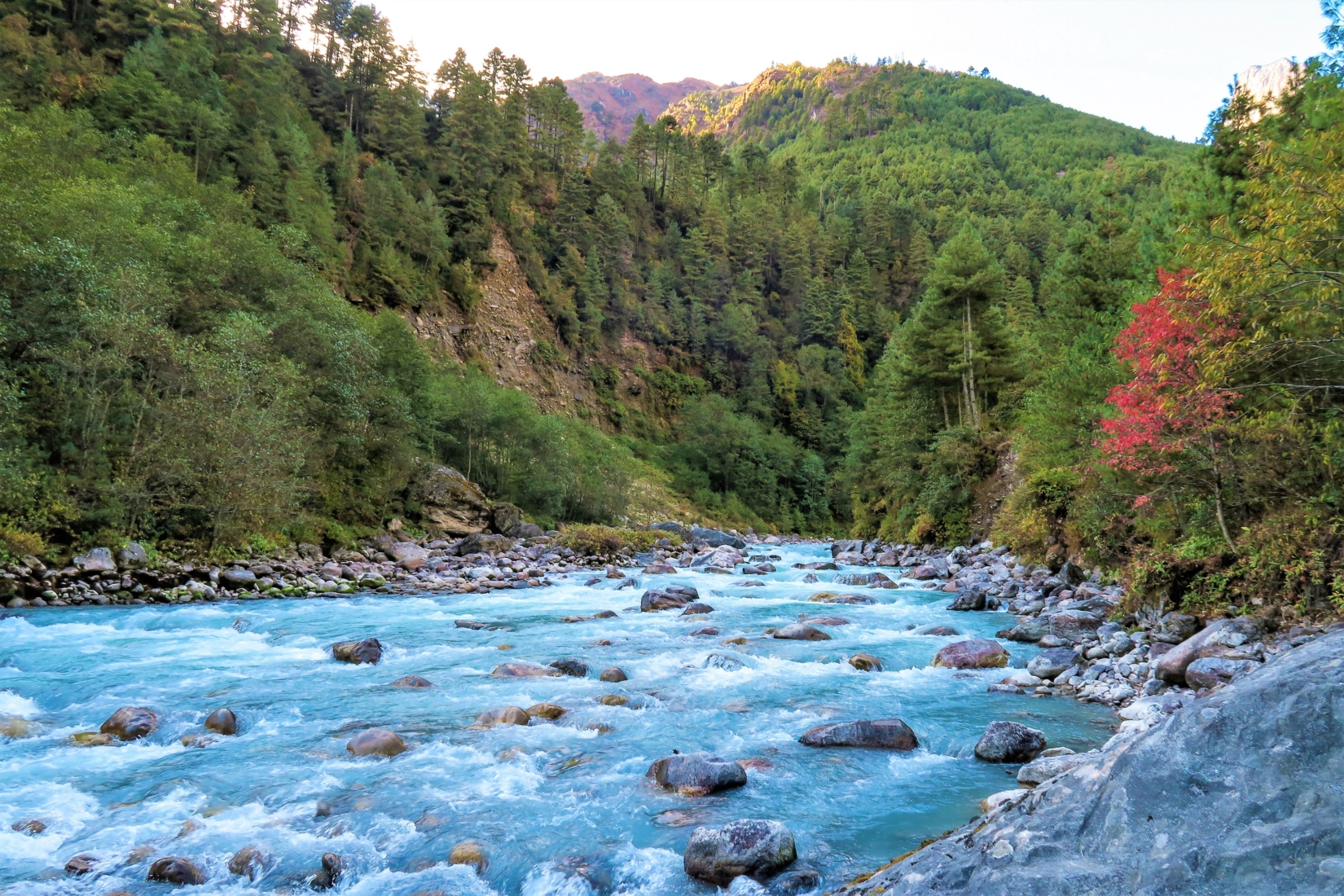
- Day 15: Phakding to Lukla – From Phakding, you’ll make our approach towards Lukla. Gather your new memories from the trip and enjoy your last days amongst unparalleled natural views in Nepal. You’ll stop for lunch in Lukla, with plenty of time to appreciate the clear landscape.
- Day 16: Lukla to Kathmandu – Returning to Kathmandu, you’ll have time and space to explore after having a chance to refresh and recuperate in your hotel. The Thamel district is a great place to wander with its many winding streets lined with souvenir shops, bars, restaurants, and more. There’s plenty to see and to try on the final day of your trip in Kathmandu. Soak up as much of the city’s offerings as you can as the end of our trip approaches.
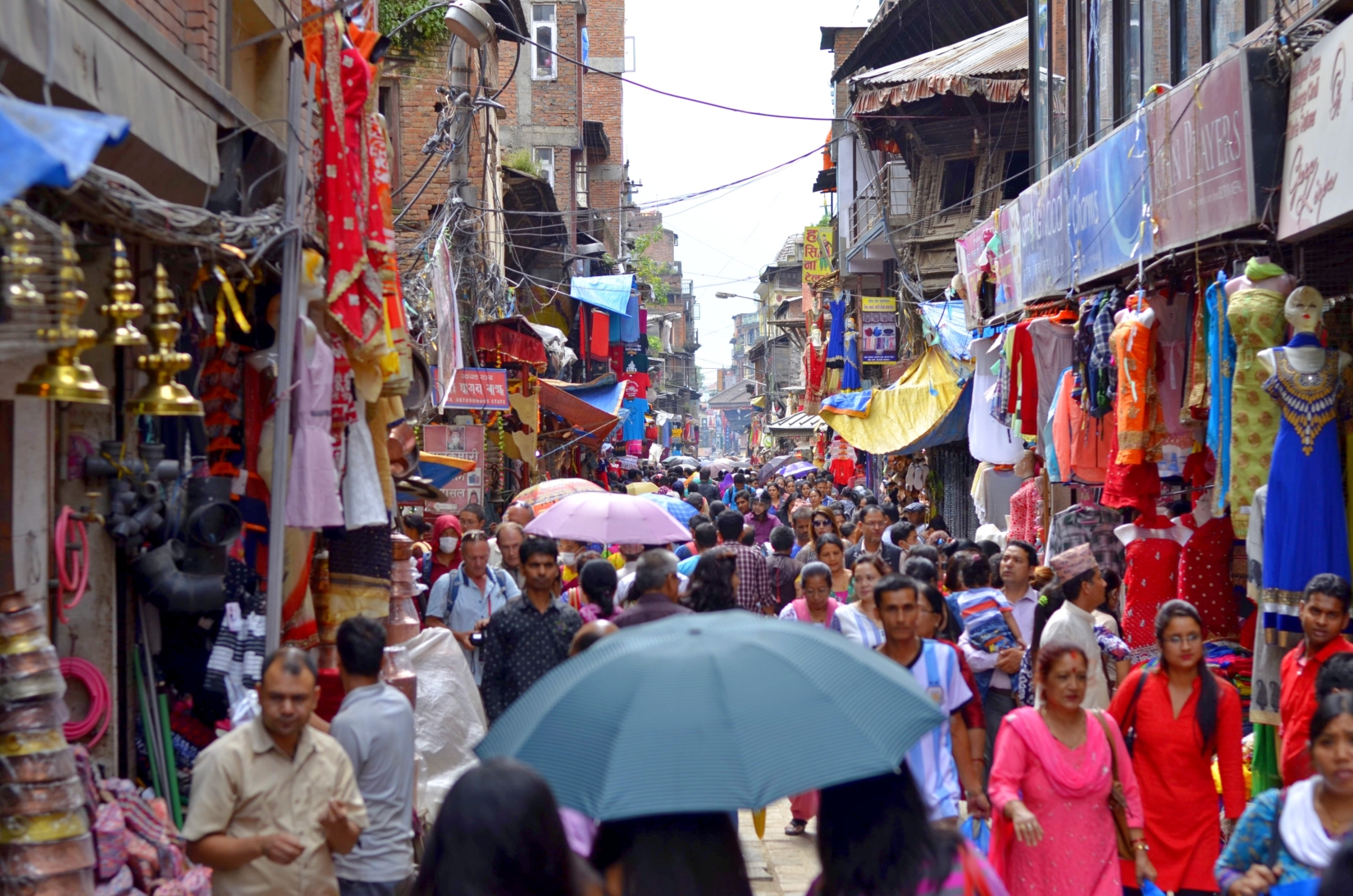
- Day 17: Today is your final day as an intrepid traveler exploring Nepal. You might have time to see some live music in Lazimpat or venture to Patan, which was originally known as Lalitpur, or the “City of Beauty”. Stop off at Newa Chen to add a visit to a 350-year-old Newari home, restored to its former glory and open to the public, to your trip. Be sure to experience as much of Kathmandu as you can, before you reluctantly head back home from this exhilarating adventure trip!
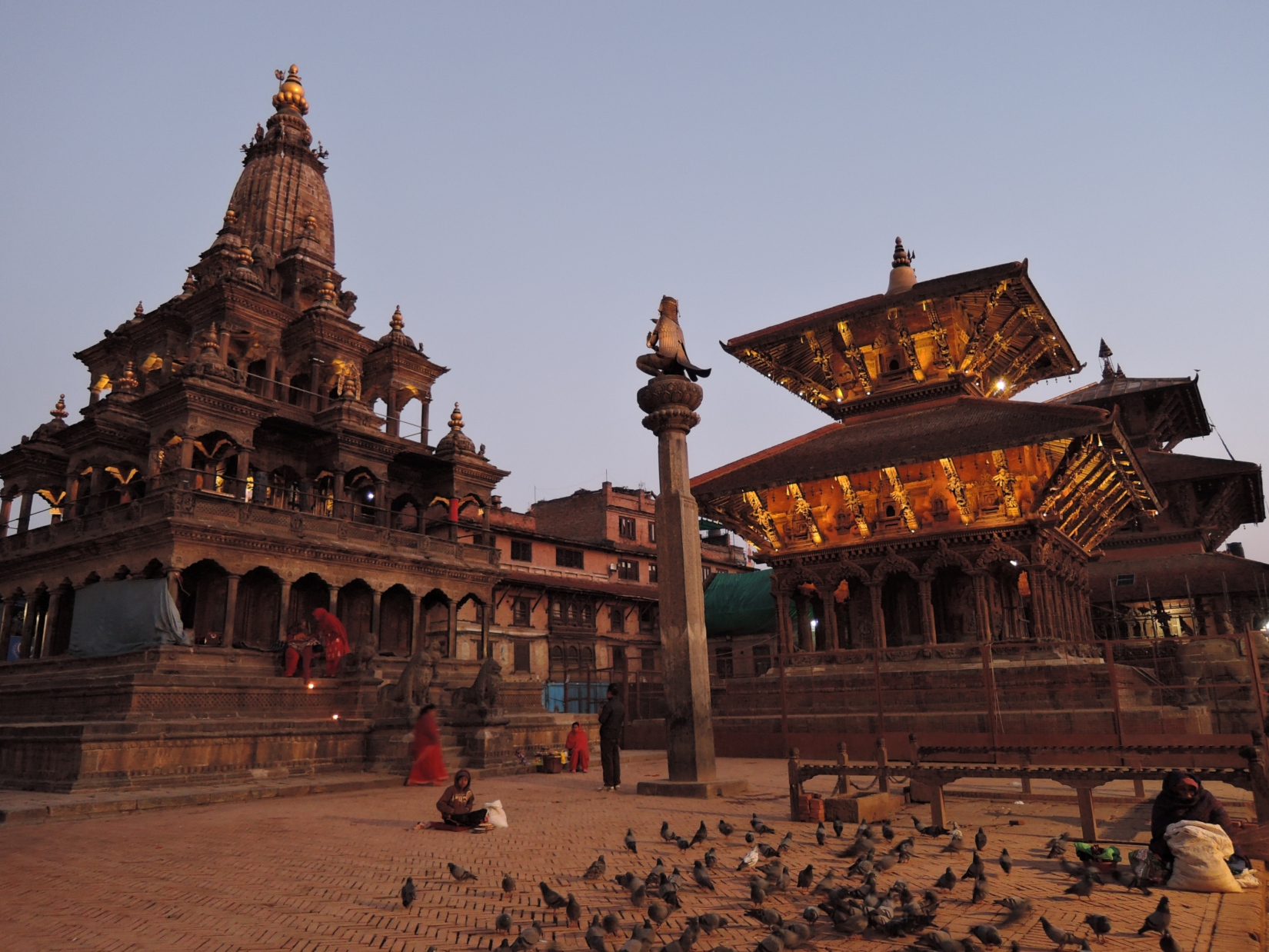
- Day 18: Depart from Kathmandu. Today you’ll return home having retraced many of Hillary and Norgay’s historic steps. You’re officially one of the lucky few who have witnessed the majesty of Everest up close!
Other Variations of the EBC Trek
The main up-and-back EBC Trek outlined above is by far the most popular route to the fabled camp on the slopes of Mount Everest, but there are also other options. Take the Three Passes Trek. It’s a circular romp that encompasses a trio of the highest traversable passes immediately around Everest itself, starting with Kongma La (18,175 feet) before pushing on through Cho La (17,782 feet) and then Renjo La (17,585 feet).
This is a considerably more challenging undertaking than the classic Everest Base Camp Trek, usually reserved for hikers with high-altitude experience. The reason? You spend multiple days walking at heights of over 16,400 feet. There’s also more chance you’ll have to contend with snowpacks – especially late and early in the main trekking seasons (April and November). The reward is a chance to explore all the nooks and crannies of the Khumbu Region, with visions of the gleaming Gokyo Lakes and remote Sherpa hill villages along the way.
Other variations include the dedicated Gokyo Lakes Trek, which involves portions of the Three Passes Trek at Cho La to offer a fuller visit of the Gokyo Valley before re-joining the route to base camp at Lobuche.
This trip guide is just a taste of what you should know before embarking on the remarkable trek to Everest Base Camp. For more details on general trip costs, accommodations, and more, check out the specifics on our Everest Base Camp tour page .
Better yet, if you have more questions on hiking to Everest Base Camp or need help planning your trip to the Himalayas, let’s connect! Our knowledgeable Adventure Consultants would love to hear from you so contact us and let us show you what’s possible .

Why travel with The Explorer’s Passage?
Experience the Everest Base Camp Trek with the best tour operator in Nepal. Our guides have been leading adventure trips in the Himalayas for over 30 years and are experts of trekking to Mount Everest Base Camp. They are also native to the Khumbu region of Nepal, the home of the Sherpa community, so you know you’ll enjoy an authentic experience.
We pride ourselves on delivering extraordinary tours based on travelers’ needs and are humbled by our guests’ testimonials . In fact, our dedication has earned us a 5-star rating on Tripadvisor , and awards by Travel+Leisure Magazine and Newsweek. Check us out and discover why so many travelers worldwide choose us . My team and I would love for you to join us on the trek to Everest Base Camp or any of our many other adventure trips !
I hope to go exploring with you soon!
Jeff Bonaldi Founder & CEO The Explorer’s Passage
About Jeff Bonaldi
Jeff Bonaldi is the Founder and CEO of The Explorer’s Passage, a premier adventure travel company. His mission is to provide travelers with the opportunity to transform their lives and the planet through the power of adventure.
Learn more about Jeff’s story and his company HERE .
Share This Amazing Location!
Related posts.
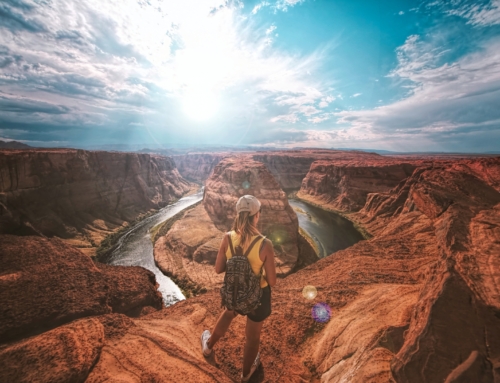
Expert Guide to Solo Travel & Top Destinations in 2024
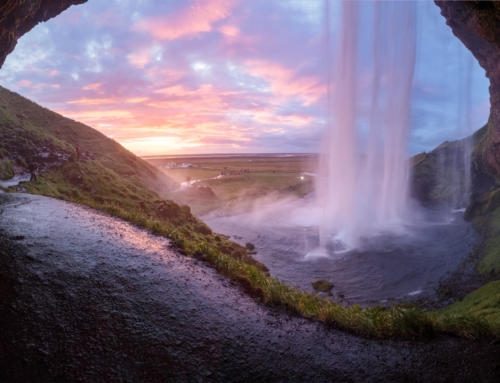
14 Best Places to Visit in Iceland in 2024
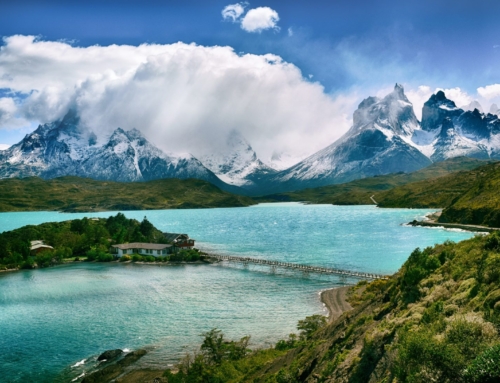
19 Things to Know Before Hiking the W Trek in Patagonia’s Torres del Paine in 2024

14 Things to Know Before You Climb Mount Kilimanjaro in 2024

The Ultimate Guide to Inca Trail Permits for 2024
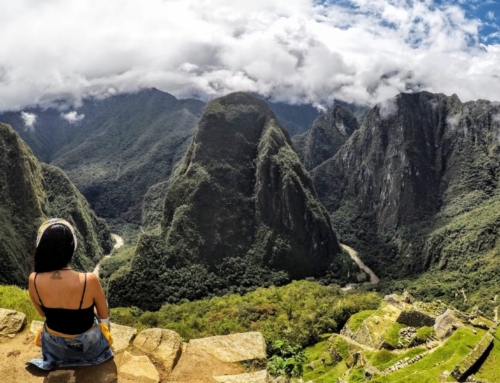
The Classic Inca Trail Route: A Day by Day Guide
Regd. No: 175840/074/075, Tourism License No: 2432

Run and Managed by:
Local tourism experts & sherpas of nepal.

- Trek to Nepal
Everest Base Camp Trek How Long?
- Trip Overview
Everest Base Camp Trek is a world-renowned hiking tour. Everest Base Camp, in short, is also famed as EBC Trek. The journey of Everest Base Camp takes you to the foothills of Mount Everest and offers you an incredible chance to explore Mount Everest, the highest peak on the earth, the top of the world, its close icy masses, and the other Himalayan pinnacles. Really, the Everest Base Camp Trek is a gutsy lifetime venture that is loaded with unforgettable sentimental moments.
How Long and How Many Days Are Required for Everest Base Camp Trek?
The hiking distance of Everest Base Camp Trek is around 130 Kilometers/81 miles. You will finish Everest Base Camp Trek in 11 nights and 12 days. Consistently you stroll on a normal of 12 Kilometers/7 miles in a day. In your normal pace of strolling, you will do it with a sometimes gradual climb on the rocky landscape and sometimes with a descent.

To start Everest Base Camp Trek, in the beginning, you fly from Kathmandu to Lukla. It is a 35 minute scenic flight. Everest Base Camp Trek starts from Lukla and ends also in Lukla. From Lukla, hiking starts towards Namche Bazaar through the Sherpa villages of Chheplung, Ghat, Phakding, Benkar, Manjo, and Jorrsalle. On the way, you will cross several suspension bridges.
After Namche Bazaar, you continue trekking to Tengboche. In Tengboche, you visit the famous Buddhist monastery famous as Tengboche Monastery. Then, you walk ahead passing the places called Dibuche, Somare, Orsho, Dingboche (the world’s highest farmland), Thukla Pass (4,830m), Lobuche Pass (5,110m), Gorekshep to reach Everest Base Camp.
After the visit to Everest Base Camp, you also climb to Kalapathar. Kalapathar is the best viewpoint near Everest Base Camp for the best panoramic views of Mount Everest. Afterward, you trek back to Lukla following the same previous route. From Lukla, you back to Kathmandu where your overall trip ends.
Height of Everest Base Camp Trek/ Elevation of EBC Trek
You will start Everest Base Camp Trek from the elevation of 2804 meters/ 9199 feet at Lukla. Every day you will receive elevation in the range of 400 meters to 800 meters. As most of the people’s bodies are not used to these elevations, the trek includes acclimatization days at the places named Namche Bazaar and Dingboche to ensure your safety. The highest altitude of the entire EBC trekking is Kala Patthar, near Everest Base Camp. Its height is at 5555 meters/18225 feet. Kala Patthar is the best viewpoint for Mount Everest and its surrounding magnificent peaks.
Best Time of Everest Base Camp Trek
Everest Base Camp Trek in Nepal can be done at any time of the year. However, the best time is in the months of September, October, November, March, April, and May. During the mentioned months generally, the weather becomes pleasant with Clear Sky, and temperatures are also more bearable. In winter (December, January, February, and during the monsoon (June, July, August), days can be perfectly comfortable but the mercury plummets as soon as the sun sinks behind the mountains. The most serious obstacle to trekking in winter is the cold. In the winter and the monsoon, domestic flights to Lukla may be disturbed by delays and cancellations because of poor visibility.
Itinerary of Everest Base Camp Trek with Distance
How much price of everest base camp trek, are you in search of a recommended operator for the everest base camp trek.
Many companies promote the Everest Base Camp Trek package. Excellent Himalaya Trek and Expedition is different from others in the sense that it is based in Nepal and managed by Nepalese tourism experts, local experienced guides, and sherpas. This company is the direct operator of Everest Base Camp Trek, not the middle travel agency. This company is also recommended in Trip Advisor.
If you are planning to Everest Base Camp Trek, for any information about this trek, you can freely contact this company by email at [email protected] or WhatsApp at +977 9851203181.
What things are required to pack for Everest Base Camp Trek?
This is a basic checklist of the essential items that you should not forget to bring with you during your Everest Base Camp Trek:
• A sturdy pair of trekking boots with good ankle support • Rucksack or daypack (50 to 65 liters) with waterproof cover • Trekking pants and waterproof trousers • T-shirts or shirts • Down jacket* • Wind/ waterproof light jacket • Fleece jumper or jacket • Inner Thermal (top and trousers) • 4 to 6 pairs of Socks and underwear • Sunglasses, sun hat, woolen cap, or balaclava • Inner and outer gloves • Headlamp, power bank, and extra batteries • Sun protection cream, lip balm, wet wipes, and hand sanitizer • Towel, flip-flop or rubber sandal, toiletries • One-litre water bottle and water purification tablets • 4 Season sleeping bag (good to -20 degrees C or 28 degrees F); * • Hiking poles, if you need • Your daily medicine if any, small personal first aid kit, aspirin, plasters (band-aids), anti-diarrhea pills, anti-headache pills, cough or cold medicine, anti-altitude sickness pills (Diamox or Acetazolamide), etc. • A small daypack/backpack for carrying your valuables
*Down jacket and sleeping bag you can rent/hire from Trekking gear shops in Kathmandu.
The above list is essential for your trekking. The weight limit for your luggage is 15 kg or 33 pounds. Remember that your luggage will be carried by a porter if you choose a package that includes a porter. Even if you have a porter you are required to carry a small day-pack with your valuables or anything important. We advise you to pack only what is necessary.
Ask our experts (Inquiry)
Select Trip Special Puja at Pashupatinath, Abhishek, Cost and Time Annapurna Base Camp Trek with visit to Hot Water Spring Rafting in Pokhara Bisket Jatra in Thimi Motor Bike Tour in Nepal Kathmandu to Manaslu Trek Canyoning in Pokhara Manang Tilicho Lake Trek Kathmandu to Langtang Trek Trek to Kala Patthar Nagarkot Tour from Kathmandu Thorong la Pass Trek: Affordable Cost with Best Services Lukla to Tengboche Trek: Tengboche Monastery Trek Ghandruk Poon Hill Trek Namche Bazaar Trek (Short Everest Trek) Sikles Kapuche Lake Trek Lwang Village Homestay Tour Panchase Trek 2 Days Astam Village Trek Tour Chitwan Sauraha Tour Package Mardi Himal Trek for Nepali and Indian People Australian Camp Trek Nepal Poon Hill Trek Package Besisahar to Jomsom Trek Pokhara to Jomsom Trek Khopra Danda Trek: Cheap Cost with Perfect Itinerary Mohare Danda Trek: Community Lodge Trek in Nepal Pikey Peak Trek: Affordable Cost and Package Pikey Peak Trek Nepal: Itinerary and Price 7 Days Annapurna Base Camp Trek Tamang Heritage Langtang Trek Cost: Cheap Package Price Langtang Tour Package: Hiking Trip Everest Base Camp Trek Booking 12 Days Short Everest Base Camp Trek Kushma Bungee Jump and Swing in Nepal Kathmandu to Ghandruk Tour Package Poon Hill Trek Route, Distance, Itinerary Annapurna Base Camp Trek Distance Tilicho Lake Annapurna Circuit Trek Itinerary with Length Everest Base Camp Gokyo Lake Trek Combine Tilicho Lake Annapurna Circuit Trek Everest Base Camp Trek Nepal Companies Poon Hill Trek Cost Mount Everest for Beginners Annapurna Circuit Trek inclusive Tilicho Lake Everest High Passes Trek Cost Everest Base Camp Trek with Daily Hiking Distance in Km/ Miles Everest Base Camp Trek Kathmandu Manaslu Tea House Trek Annapurna Circuit Trek Package Manaslu Nar Phu Valley Trek Tsum Valley Manaslu Trek Three Passes Trek Distance Gokyo Lake Trek Distance Mera Peak Climbing Itinerary and Cost Guide Cost for Everest Base Camp Trek Mardi Himal Trek Distance Langtang Trek Distance in Km and Miles How Long Annapurna Circuit Trek Distance in Km and miles Difference between Annapurna Circuit and Annapurna Base Camp Trek Annapurna Base Camp Mardi Himal Trek Mardi Himal vs Annapurna Base Camp Trek Best Company for Mera Peak Climbing Upper Mustang Jeep Tour Package Upper Mustang Trek Package Best Company for Upper Mustang Trek Best Tour Company for Everest Base Camp Trek Nepal Everest Base Camp Trek How Long? Nepal Trek to Everest Base Camp 4 Nights 5 Days Hiking Around Kathmandu 3 Nights 4 Days Hiking Around Kathmandu 2 Night 3 Day Hiking Near Kathmandu 1 Night 2 Day Hiking Around Kathmandu Hiking in Kathmandu Paragliding Kathmandu from Chandragiri: Price & Booking Contact Mardi Himal Trek Nepal One Week Nepal Honeymoon Tour Package Kathmandu Pokhara Honeymoon Tour Kathmandu Honeymoon Tour Package Nepal Honeymoon Tour Packages from India Nepal Tour Package for Couple Solo Poon Hill Trek Solo Three Passes Trek with Everest Base Camp Solo Mardi Himal Trek 7 Days Mardi Himal Trek Kalinchowk Package Langtang Trek with Local Company of Nepal Langtang Trek Nepal Island Peak Climbing: Cheap Cost and Best Package Everest Base Camp Trek: Hiking to Mt. Everest Everest Base Camp Trekking in Nepal Annapurna Base Camp Trek in Nepal Solo Annapurna Base Camp Trek Nepal Mahayana Buddhist Tour in Nepal Gokyo Renjo La Pass Trek: Less Crowded Trekking Route in Everest Trekking Agency to issue Upper Mustang Permit, Guide, Porter Hire Price Shortest Mardi Himal Trek Trekking Agency to issue Manaslu Trek Permit, Guide, Porter, Jeep Hire Poon Hill Trek for Malaysia, Singapore People Mardi Himal Trek with Recommended Agency of Nepal Manaslu Trek with Best Local Company of Nepal Everest Three Passes Trek with Best Recommended Company Everest Base Camp Trek with Local Company Recommended Company for Island Peak Summit Climb Annapurna Base Camp Trek with Recommended Company of Nepal Annapurna Circuit Trek with Recommended Trekking Company of Nepal Best Everest Base Camp Trek Company Mount Everest Tour by Plane Quickest Trek to Everest Base Camp Best Nepal Trek Packages for Christmas and New Year Vacation Best Nepal Tour for Christmas and New Year Vacation Everest Base Camp Trek UK for British Poon Hill Trek by Jeep Drive Tour Everest Base Camp Trek in December Gokyo Lake Renjo La Pass Trek Mardi Himal Trek: Best Cost and Perfect Itinerary Trekking Guide and Porter Hire Cost in Nepal Everest Base Camp Trek from Brazil Everest Base Camp Trek from Philippines Everest Base Camp Trek from Indonesia Greenline Bus Kathmandu Pokhara Everest Mountain Flight for Bangladeshi, Sri Lankan & Others Everest Mountain Flight for Chinese, Thai, Malaysian & Others Three Passes Trek with Everest Base Camp Everest Mountain Flight for Indian Citizen Langtang Trek for Beginners, Seniors and Family Langtang Solo Trek Package Trek to Langtang Langtang Trek Cost- Best Package and Perfect Itinerary Annapurna Circuit Trek for Beginners Annapurna Base Camp Trek for Beginners Everest Base Camp Trek for Seniors Muktinath Tour Package Sarangkot Hiking Everest Base Camp Trek from Singapore Everest Base Camp Trek for People from Australia Everest Base Camp Trek for Beginners: Best Itinerary with Price Recommended Operator of Everest Base Camp Trek Manaslu Circuit Trek: Best Cost and Package Manaslu Trek with Cost Annapurna Base Camp Trek Cost: ABC Trek Package Annapurna Circuit Trek: Affordable Cost and Package Bungee Jump in Pokhara at Affordable Price: 101 meters Height Annapurna Circuit Trek Cost for Single Trekker for 2020/ 2021 Best Price of Annapurna Circuit Trek Annapurna Circuit Trek for Malaysia and Singapore Hikers Everest Base Camp Trek Cost for Single Solo Everest Base Camp Trek in Nepal Everest Base Camp Trek at Hong Kong Dollar HKD Daily Hiking Distance of Everest Base Camp Trek in Kilometers and Miles Everest Base Camp Trek from Malaysia Annapurna Base Camp Trek from Malaysia Annapurna Base Camp Trek for Indian People Everest Base Camp Trek without flight to Lukla (By Road) 7 Days Poon Hill Trek 12 Days Annapurna Circuit Trek Short Annapurna Base Camp Trek Annapurna Base Camp Trek via Ghandruk Everest Base Camp Trek: Affordable Cost and Package Short Everest Base Camp Trek Hot Air Balloon in Pokhara Everest Base Camp Trek Manaslu Expedition: 8163 m/26781 ft Everest Expedition: 8848 m/29029 ft Amadablam Expedition: 6812 m/22349 ft Helambu Trek Tamang Heritage Trek Phaplu Everest Base Camp Trek Gokyo Renjo La Pass Trek Everest Base Camp Gokyo Lake Trek Cost: Perfect Itinerary, Best Package Amadablam Base Camp Trek Naya Kanga Peak Climbing: 5844 m/19168 ft Hinuchuli Peak Climbing: 6441 m/21126 ft Saribung Peak Climbing: 6346 m/20815 ft Dhampus Peak Climbing: 6012 m/19724 ft Tent Peak Climbing: 5663 m/18563 ft Singu Chuli Peak Climbing: 6501 m/21323 ft Mardi Himal Peak Climbing: 5587 m/18330 ft Paldor Peak Climbing: 5896 m/19343 ft Yala Peak Climbing: 5732 m/ 18790 ft Chulu West Peak Climbing: 6419 m/ 21059 ft Chulu East Peak Climbing: 6564 m/ 21005 ft Lobuche Peak Climbing: 6119 m/ 19581 ft Makalu Base Camp Trek Dhaulagiri Base Camp Trek Khopra Danda Trek Pashupatinath Tour Pashupatinath Janakpur Tour Muktinath Overland Tour Muktinath Tour Maratika Tour: Halesi Tour Lumbini Tour Kathmandu Temple Tour 3 Days Nepal Tour: Classic Nepal 4 Days Nepal Tour: Glance of Nepal 5 Days Nepal Tour: Romantic Nepal 5 Days Nepal Travel: Kathmandu World Heritage Tour 6 Days Nepal Tour: Wonderful Nepal 6 Days Nepal Travel: Nepal Jungle Safari Tour 7 Days Nepal Tour: Incredible Nepal 1 Week of Nepal Tour 7 Days Nepal Trip: Discover Nepal Best Selling Nepal Tour: Affordable Package Price Langtang Helicopter Tour 9 Days Nepal Tour: Nepal Vacation Package 10 Days Nepal Tour: Fascinating Nepal 11 Days Nepal Tour: Exploring Nepal 12 Days Nepal Tour: Colorful Nepal Island Peak Climbing: 6189 m/ 20305 ft Mera Peak Climbing: 6461 m/ 211907 ft Pisang Peak Climbing: 6091 m/19980 ft Rara Lake Helicopter Tour Muktinath Damodar Kund Heli Tour Annapurna Base Camp Helicopter Tour Nepal Honeymoon Tour Mardi Himal Trek Druk Path Trek: 10 days Trekking in Bhutan Gangtey Trek: 9 Days Trekking in Bhutan Bhutan Travel 8 days : Paro Thimphu Trongsa Tour Bhutan Travel 7 days : Paro Thimphu Gangtey Tour Kalinchowk Tour Bhutan Travel 6 days : Paro Thimphu Punakha Tour II Bhutan Travel 5 days : Paro Thimphu Punakha Tour I Bhutan Travel 4 days : Paro Thimphu Tour Bhutan Travel 3 days : Paro Tour Everest Base Camp Tour by drive: Nepal Tibet EBC Tour Nepal Tibet Travel: Kathmandu Lhasa Overland Tour II Nepal Tibet Tour: Kathmandu Lhasa Overland Tour I Guge Kingdom Tour Kailash Heli Yatra: Kailash Helicopter Tour Kailash Yatra : Kailash Overland Tour Kailash Tour with Lhasa Everest Base Camp Mount Kailash Tour with Lhasa Tibet Tour 9 days : Lhasa Everest Base Camp Travel Tibet Tour 8 days : Lhasa Everest Base Camp Tour Tibet Tour 7 days : Lhasa Gyantse Shigatse Tour Tibet Travel 6 days : Lhasa Tsedang Tour Tibet Tour 6 days : Lhasa Namtso Lake Tour Hindu Pilgrimage Tour Nepal Buddha Temple Tour Nepal Muktinath Helicopter Tour Everest Base Camp Helicopter Tour Nepal Adventure Tour 9 days Nepal Adventure Tour 6 Days Tibet Tour 5 days : Lhasa Yamdrok Lake Tour Upper Mustang Trek Nepal Family Tour Everest Family Trek Nepal Family Trek Rara Lake Trek Kanchenjunga Base Camp Trek Upper Dolpo Trek Lower Dolpo Trek Tsum Valley Trek Langtang Gosaikunda Lake Trek: Cheap Cost with Perfect Itinerary Everest View Trek Three Passes Trek Everest Cost- 3 Passes Trek Package Gokyo Lake Trek Cost: Affordable Gokyo Lake Trek Package Classic Everest Trek The Last Resort Bungee: Bhotekoshi Bungy Jump Paragliding in Pokhara: Updated Price with Best Services Manaslu Trek Zipline in Pokhara: Classic and Superman Zipline Bhote Koshi Rafting Ultralight Flight in Pokhara: Best Price with Exciting Flight Everest Mountain Flight Everest Helicopter Tour Trishuli Rafting: Affordable Best Price Chitwan Jungle Safari Tibet Tour 4 days: Lhasa Tour Nar Phu Trek Ghandruk Trek Tilicho Lake Trek with Annapurna Circuit Poon Hill Trek Annapurna Circuit Trek Annapurna Base Camp Trek Langtang Valley Trek
Share this trip on
Have you any questions, if this trip doesn't suit you, make your trip happen, why travel with us.
- Run by local experts, guide & Sherpa.
- Focus on your needs.
- Good value for money.
- Real cared services.
- Government recognized company.
- Best reasonable rate.

Quick Navigation
- Trip Reviews
Steps of Contact and Booking with us

- Skip to content
- Skip to primary sidebar
Full Time Explorer
Nepal Travel Blog
Everest Base Camp Trek Itinerary with Gokyo Lake
Nepal Itinerary , Trekking in Nepal / June 13, 2021 by fulltimeexplorer / 10 Comments
I decided to do the Everest Base Camp Trek with a tour group since I was an inexperienced trekker. Previously, I’d only done three day treks at most, so an eighteen day trek was beyond my level of expertise. Add in the fact that I’d be in a developing country with a danger of altitude sickness, and I was way out of my element. Having done the trek and completed it, I thought it’d be helpful to share the Everest Base Camp trek itinerary with others who may want to try it on their own.
Our group of ten was able to make it through the entire trek without getting altitude sickness while a lot of other groups had members turn back before reaching Everest Base Camp. I met people who did the same trek in twelve days, so this schedule leaves a lot of time for acclimating and is much better suited to people who don’t trek as often. Of course, altitude sickness can happen to anyone at any time, and this schedule doesn’t guarantee anything.
Note: The places listed are where we slept for the evening. The oxygen concentration is compared to 100% at sea level.
Everest Base Camp & Gokyo Overview
Duration: 18 days
This trek can be done in a shorter period of time if you cross the pass instead of going down and around.
Difficulty Level: Moderate/Difficult
Highest Altitude: 5,643 m (18,514 feet)
Permits: The Sargarmatha National Park entry fee is 3,390 rupees ($34 USD) and the TIMS is 2,000 rupees ($20 USD)
Everest Base Camp Trek Itinerary Map
Note: This map should not be used for navigational purposes as some of the village locations are estimated. This is only meant to be used as a visual aid.
Day 1 – Kathmandu
1,360 meters (4,461 feet)
Oxygen Concentration 86%
Our trip started in Kathmandu. Since flights out of Lukla are not always guaranteed, you’ll want to schedule the earliest flight possible. Therefore, staying over in Kathmandu the night before is key. I’d actually recommend getting here a few days early to explore the area. Since Kathmandu is already at 1,360m, it’s an easy way to acclimate a tiny bit if you are coming from sea level. I spent three days there total before the trek.
Day 2 – Phakding
2,652 meters (8,700 feet)
Oxygen Concentration 74%
Flights into Lukla are not guaranteed as the weather can change any minute in the Himalaya. Unfortunately, that means you should leave at least a few days at the end of your trek in case your flight gets pushed back. I met a few people who had their flight pushed back three days in a row.
Once you are in Lukla (2800m), you can grab breakfast and watch the planes fly in. It’s said to be the most dangerous airport in the world with a mountain on one side and a cliff on the other. The airstrip has a large slope, and watching planes land is pretty exciting. You can check out my post on the flight to Lukla .
Day 2 is an easy day of hiking along the Dudh Kosi River. You get to cross the first few suspension bridges which are rather exciting, especially if a cow or yak is crossing with you. The trek only takes about 3 hours and is on what people call “Nepali flat.” Meaning that you go up and down but never really gain much altitude. We spent the night at the Mountain Resort.
Day 3 – Namche Bazaar
3,446 meters (11,305 feet)
Oxygen Concentration 67%
It’s a 7 hour hike from Phakding to Namche Bazaar. You get to go over a massive suspension bridges on route. There are a few, but the tallest is 160m high. We stopped in Monjo for lunch, and then headed up a steep incline to reach Namche. The incline on the second half of the trek is a little tougher, but if you take it slow, it’s not so bad.
Namche Bazaar is the best place to spend two nights to acclimate. Our guide told us that most of the people who get helicopter evacuated don’t spend two nights and end up getting altitude sickness. This is also the last places to buy or hire trekking gear. The small city is really cute and full of coffee shops, stores, and bars. It also has the highest Irish Pub in the world, which I stopped in on the way back down. We stayed at the Camp de Base hotel for two nights.
Day 4 – Namche Bazaar
One of the best ways to acclimate to the altitude is to take walks to a higher altitude, and then, come back down. We took a walk to the National Park Headquarters where you get your first glimpse of Everest. Oddly, it’s not the biggest mountain in sight since it’s so far away, but it was still worth the view. There’s also a small museum, statues, etc. Make sure to go in the morning before the clouds roll in. Sagarmatha National Park is a UNESCO site .
After the National Park Headquarters, we did a short trek north of Namche. At the top was a teahouse (Everest Sherpa Resort) where we had a snack and hot tea before coming back down. The trek takes a few hours to get up and back, but the views from the tea house are really incredible.
While in Namche, I’d recommend taking a hot shower since it gets pretty cold as you gain altitude. It’s also a good place to get the outfit you’ve been wearing the last few days laundered.
Day 5 – Mongla
3,970 meters (13,024 feet)
Oxygen Concentration 63%
The morning starts out similar to the acclimation trek on day 4. We passed the Shyanboche Airport where helicopters drop off supplies for porters to carry up the mountain. A good place to stop for lunch is in Khumjung Village. We visited the Hillary School while in town. The total trekking time for the day is about 4 hours. From Mongla, you’ll be able to see Phortse across the valley. We stopped there later in the trek on the way to Everest Base Camp, so it was interesting to see where we would be staying in a few nights. After checking into our teahouse (Snowland View Lodge), we did a short one hour trek up one of the small hills nearby to help acclimate for the evening.
Day 6 – Dole
4,038 meters (13,248 feet)
Oxygen Concentration 62%
It takes about 4 hours to get from Mongla to Dole. The trek starts out by descending 300m and then you have to work your way back up. Around this time, I could feel the effects of the altitude while walking. My mind was foggy, and I had a hard time concentrating. Over the course of the day, the views are pretty incredible, as you get to see several of the highest mountains in the world including Ama Dablam, Cho Oyo, Gyachung Kang, and Taweche. We stayed at the Alpine Cottage Lodge. After checking in, we took a short trek up one of the nearby hills to help acclimate. My resting heart rate that night was 83 beats per minute.
Day 7 – Machhermo
4,465 meters (14,648 feet)
Oxygen Concentration 59%
Day 7 is pretty short with only a 3 hour hike through gradual terrain. You’ll notice that there are no more trees or greenery at this altitude. This is also the first day we saw snow. Overall, the day was easy, but the altitude really had an effect. We all moved very slowly, despite the short walking time. After checking into the Lodge at Machhermo, we did an acclimation hike to the base of Kyajo Ri. It took about an hour and a half. My resting heart rate that night was 97 beats per minute.
Day 8 – Gokyo
4,720 meters (15,485 feet)
Oxygen Concentration 57%
Trekking takes about 3.5 hours on Day 8. The terrain is steep and rocky. The altitude makes everything more difficult. You get to pass two smaller lakes before reaching the coveted Gokyo Lake. The lakes are all beautiful and worth going out of the way for. After lunch we did an acclimating hike up the ridge behind the hotel to get a look at the Ngozumpa Glacier which is the largest in Nepal. To be honest, it wasn’t what I pictured a glacier to look like.
Some groups cross the glacier to get to Everest Base Camp via the Cho La Pass , but safety depends a lot on the weather. Our group planned to go back down and around which gave us more time to acclimate. We stayed at the Gokyo Resort while in town. My resting heart rate that night was 95 beats per minute.
Day 9 – Machhermo
4,465 meters (14,648 feet)
We started day 9 by waking up at 4:00am for a sunrise hike up Gokyo Ri. The trek is extremely steep, but starting it in the dark makes it easier since you can’t see how far you have to go. Most people can trek it there and back in a couple of hours. We took our time since the altitude made it difficult to breathe. The views from the top are the best views of the entire trek. You can actually see four peaks over 8000m including Everest (8848m), Cho-Oyo (8153m), Lhotse (8511m) and Makalu (8481m). Trekking before the sun rises is extremely cold, so make sure to wear lots of layers.
After the morning trek, we had breakfast at our teahouse and then descended back to Machhermo. The trek takes less than 2 hours since it’s mostly downhill. Your lungs will also start to feel amazing as they fill with oxygen. I got a mini high from going to a lower altitude and found myself singing “I Feel Good” all the way down. Once back in Machhermo, we visited the hospital nearby for an amusing speech on altitude sickness. The doctors were really funny and made an interesting presentation. I’d recommend stopping by since there’s not much else to do after lunch.
Day 10 – Phortse
3,840 meters (12,598 feet)
Oxygen Concentration 64%
Not many trekkers pass through Phortse so the path there is nearly empty. It takes about 5 hours total, so it’s a good idea to stop in Dole for lunch. The trek starts off downhill, but eventually there is a steep incline right before you make it to your stopping point. The village itself is quaint and offers beautiful views. It’s also a much needed break from the cold since it’s a little warmer at this altitude. I’d recommend taking a hot shower if you can find one and doing some of your laundry. At this point, I began to get a cold. Had I been trekking on my own, I would have spent a second night here to get better.
Day 11 – Dingboche
4,360 meters (14,304 feet)
Oxygen Concentration 60%
The trek to Dingboche will take approximately 6 hours. We stopped in Pangboche for lunch and checked out the local monastery where a ‘yeti scalp’ is kept. My group thought it looked more like a coconut shell than a yeti scalp, but apparently it’s a big deal to locals. Plus, when else will you get to see an alleged yeti scalp?
Once you arrive at Dingboche, you’ll get great views of Ama Dablam and Lhotse. This was one of the hardest days for me since I had a cold and could barely breathe. On the bright side, we got to see a lot of mountain goats including the Alpha who posed for some photos.
At night, I popped out of my room at the Peak 38 View teahouse to use the bathroom. The mountains were lit up by the moon, and there were a million stars in the sky. I stared at them as long as I could before I got really cold. In the morning, I heard a few other people saying how incredible they thought the view was at night too.
If you’re interested in a harder trek, you can combine the Everest Base Camp Trek with the Island Peak trek which starts from Dingboche.
Day 12 – Lobuje
4,930 meters (16,174 feet)
Oxygen Concentration 56%
To be honest, I don’t remember much about day 12 since I was still sick. My notes for the day are even less helpful. We trekked a total of 6 hours. The incline was pretty gradual and most of it was on a wide open trail. After lunch, the terrain became more difficult. There’s a large hill, but going slowly and zigzagging your way up makes it feel less difficult. At the top are memorials for people who have passed away on expeditions to Everest. It’s a long day that felt even longer with my cold. We spent the night at Alpine Home, which was the warmest tea house we stayed in on the whole trek.
Day 13 – Gorak Shep
5,160 meters (16,929 feet)
Oxygen Concentration 54%
Day 13 is one of the longest days. It’s a three hour trek to Gorak Shep and another 5 hours to Everest Base Camp and back. The three hours to our teahouse, Snowland, took me longer than planned. The trek there isn’t difficult, although it’s very crowded, and there is a rocky section which requires some fancy footing.
We arrive around 10:00am but were told to have lunch since we wouldn’t get back until 3:00pm or later. Some of us ordered cheese sandwiches to go. The trek to Base Camp (5364m) really isn’t that hard, but it’s extremely difficult to breathe. We passed someone who had to turn back from altitude sickness when he started throwing up mid trek.
Very few people realize this, but you can’t actually see Everest from Everest Base Camp. Weird, I know. We went during the end of the season so no one was trying to summit. This means that Base Camp had no tents set up and was just a rock in the middle of a glacier. That being said, you get to see the Changri Nup Glacier and the notorious Everest Ice Fall (one of the most dangerous sections when trying to summit).
Day 14 – Pheriche
4,270 meters (14,009 feet)
Day 14 is supposed to start at 4:00am with a hike to the top of Kala Patar (5643m). My body had other plans. I woke up unable to breathe in the freezing cold air and had to hop back into my sleeping bag and hide my face just to catch my breath. I couldn’t stop coughing and decided there was no way I could do the morning trek. Later, I coughed up blood and was happy with my decision not to push myself earlier. The trek up takes about 1.5 hours and down takes about 45 minutes.
After my group came back from Kala Patar, we had breakfast in Gorak Shep before heading back to Namche Bazaar. The trek down takes about 5 hours and is fairly easy for most people. I struggled the entire way because of my cold, but not everyone had that experience. You can read about what it was like here . We stayed at the Sunrise Guesthouse in Pheriche.
Since I didn’t conquer Kala Patar, I highly recommend checking out Erika’s Travelventures post about the Kala Patthar Trek .
Day 15 – Namche Bazaar
3,346 meters (10,977 feet)
Oxygen Concentration 68%
Day 15 is a day of “Nepali flat,” where you go up and down continuously. Despite that, it becomes so easy to breathe on the descent that you’ll hardly notice the inclines. There are some sections where you start to feel the last two weeks worth of walking in your muscles, but overall, it’s not so bad. It’s a long day with around 7 hours of trekking. We took a long break at the Thyangboche Monastery. Inside, beautiful brightly colored paintings cover the walls. There’s also a bakery with really good coffee nearby.
Eventually, you’ll make it back to Namche Bazaar where hot showers and laundry services await you. You’ll also be able to get free wifi at the cafes and bars. I recommend stopping by the Irish Pub for a celebratory Bailey’s and hot chocolate. This time, we stayed at the Kala Patar Lodge while in town.
Day 16 – Phakding
2,652 meters (8,700 feet)
The walk to Phakding feels like a breeze after the last few days. You only need to trek for 4 hours to get there. It’s mostly downhill with a few uphills mixed in. Overall, you’ll feel amazing because you can breathe normally again. We stayed at the Mountain Resort which was the same place we stayed on the way up.
Day 17 – Lukla
2,800 meters (9,186 feet)
Oxygen Concentration 72%
Day 17 included 3.5 hours of trekking. It’s mostly easy, with some uphill as you approach Lukla. You’ll get there early enough that you’ll have time to explore. We passed through Lukla quickly on arrival, so it was fun walking around town once we arrived. We spent time in the cafe attached to the pub and burger joint. The coffee there was great, and it had amazing views.
Day 18 – Kathmandu
1,360 meters (4,461 feet)
We flew out of Lukla on the third flight of the day (around 6:30am). Luckily, the weather was clear, and we took off on time and made it back to Kathmandu for breakfast. Make sure to leave a few extra days in your itinerary just in case you aren’t able to fly out right away.
You might also like…
Michelle della giovanna.
Writer at Full Time Explorer
I’m just your average New Yorker who quit her job in the fashion industry to explore the world. Come find out what it’s like to trade in five-inch heels for squat toilets.
- Visit Twitter account (opens in a new tab)
- Visit Facebook account (opens in a new tab)
- Visit Instagram account (opens in a new tab)
- Visit Pinterest account (opens in a new tab)
This website uses affiliate links. This means that I may receive a small commission (at no extra cost to you ) if you purchase something through these links. I only link to products and companies that I love. Those companies, in return, reward me for connecting them to you .
Full Time Explorer LLC is a participant in the Amazon Services LLC Associates Program, an affiliate advertising program designed to provide a means for sites to earn advertising fees by advertising and linking to Amazon.com.
Reader Interactions
March 3, 2019 at 7:06 am
Hi MICHELLE, Thank you for this informative blog of Everest Gokyo Trek. Gokyo lakes trek is most popular trek after Everest Base Camp Trek in everest region.
May 7, 2019 at 1:47 pm
Minus the plan tickets arriving/departing Nepal, how much money you think one should bring?
May 8, 2019 at 1:31 am
That’s a difficult question. How long are you staying in Nepal? What kind of accommodations do you expect? Are you backpacking in hostels or do you prefer hotel rooms? You can check out this post which shows what I spent in a month of travel http://fulltimeexplorer.com/budget-costs-month-nepal/
Leave a Reply Cancel reply
Your email address will not be published. Required fields are marked *

How many days are required to complete the Everest base camp Trek
- You are here:
- Visit Nepal
- Apr 21, 2020
Table of Contents
The Everest Base Camp itself more than enough because it’s the base camp of the world’s highest mountain. However, The Everest Base Camp Trek is one of the most thrilling adventures Trekking trails in Nepal which offers the incredible beauty of nature and culture along with the massive view of the Everest and Himalayas in Khumbu region. This trek is sure to be a trip of a lifetime. It may challenge for the very first trekkers but we are sure that you will defiantly enjoy the majestic view of the Himalayas and its landscape. In addition, this trek is all about love and eagerness which enthralls all adventurous to the nucleus of your own heart.
Everest Base Camp Trek has different itineraries based on the level of your physical structure and stamina. Normally, 12 days hiking is recommended for the very first trekkers who are intended to trek to the Everest base camp which is included the 2 extra days for the acclimatization to adapt your body with the thin air at the high altitude. It’s more sufficient and doable from the age of 10 years to 75 years. However, the Everest base camp trek from Lukla is noticeable as per day to day trip itinerary which is given below.

Please kindly check the following day to day itinerary of the Everest Base Camp Trekking.
Outline Day to Day Itinerary:
Day 01: Fly from Kathmandu to Lukla (2,610 m ) 35 min by air and trek to Phakding (2810 m) 4 hrs walk approximately
Day 02: Trek from Phakding to Namche Bazzar (3,450 m/11,315 ft) - 5/ 6 hrs walk approximately
Day 03: Rest and acclimatization day at Namche
Day 04: Trek from Namche to Tengboche (3,860 m/12,677 ft)- 4/5 hrs walk approximately
Day 05: Trek from Tengboche to Dingboche (4,410 m/14,485 ft) - 4/5 hrs walk approximately
Day 06: Rest/ Acclimatization Day at Dingboche
Day 07: Trek from Dingboche to Lobuche (4,910 m/16,105 ft)- 4 hrs walk approximately
Day 08: Trek from Lobuche to Everest Base Camp and back to Gorakshep (5,185 m/17010 ft)- 5 hrs walk approximately
Day 09: 2 hrs Hike from Gorak Shep to Kalapather (5,545m/18,187ft ) then – Pheriche (4,250 m/13,940 ft)- 5 hrs walk, overnight at lodge
Day 10: Trek from Pheriche to Namche Bazaar (3,450/11,315 ft) - 6 hrs walk approximate, overnight at lodge
Day 11: Trek from Namche to Lukla (2,850 m/9,350 ft)- 6 hrs approximate walk, overnight at lodge.
Day 12: Fly from Lukla to Kathmandu 35 minute by air, transferred to the hotel, overnight at Hotel
WHEN TO TRAVEL TO EVEREST BASE CAMP
The best time to travel in Everest region, during the dry season (Autumn), which runs from the mid of September to May and pre-monsoon season (Spring) March to May, these months are the absolute time and favorable months for trekking in Nepal Himalayas and Everest region, offers crystal clear view of fresh snowy mountains with the nice temperature and nights are quite cold normally temperature drops to the negative during the nights.
Trip Highlights of Everest Base Camp Trek - 14 Days
- Trek to the foot of world’s highest peak Mount Everest
- Scenic mountain flight to and from Lukla
- The highest airport in the world at Syangboche
- Reach Everest base camp (5364 m) walking on Khumbu glacier
- Explore the Sherpa culture and lifestyle
- Visit ancient Tengboche monastery
- Extensive Flora and Fauna
- Trek through spectacular scenery with brilliant panoramic Mountains view
- Hiking to Kala Patthar 5,545 m and see the amazing panoramic views from the top
- World’s deepest Khumbu glacier
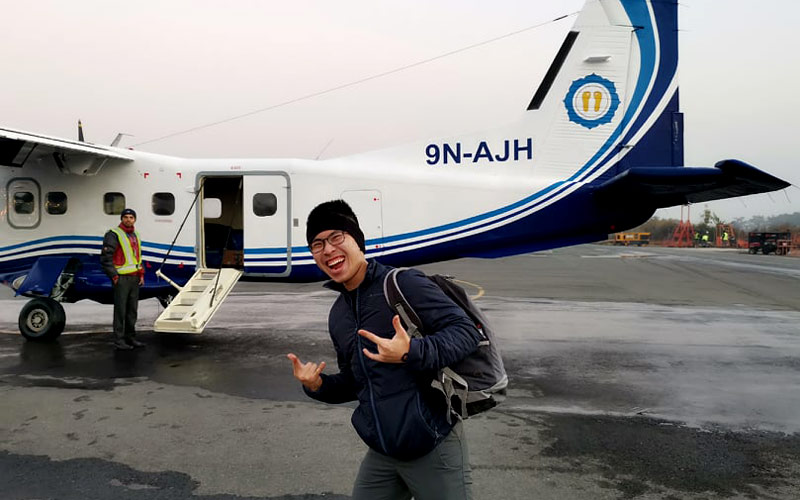
Accommodation during the Trek
Alpine Ramble Treks will be accommodated in the best hotel like 3 stars categories with the good facilities of WIFI , Hot Show er, and AC room with the best breakfas t services on the selection in Kathmandu and all Accommodations are provided on the twin-sharing basis. The single supplement will be served if you are a single traveler. Accommodations during the trek in the mountains, basically you will be staying at basic trekking lodges where you will have a nice and clean room with warm blankets, pillows, and comfortable matrices ( matrices size cannot be very thick size but still comfortable). All the facilities during the Everest base camp trek are not as same as Kathmandu but still very pleasant and suitable. Do not expect everything is the high level of standards in the mountain. Alpine Ramble Treks would be glad to ensure the attached bathroom in every possible place even on the Everest region in advance booking, in some places; you have to compromise in sharing a bathroom at a high altitudes area because there is no room with attached bath have being built at this elevations area.
How to Travel Everest Base Camp
Getting to Everest base camp, There are two different major transportation which is by the airstrip and Local bus/jeep. however taking an airstrip from Kathmandu to Lukla is one of the fastest ways to get the Everest base camp, and this trek starts from Lukla but if you take a local bus/jeep for this you have to have at least 3-4 days extra days behind above the itinerary. because you will have a transfer to Salleri which is the last bus station and you have to walk all the way up to Lukla for 2-3 days.
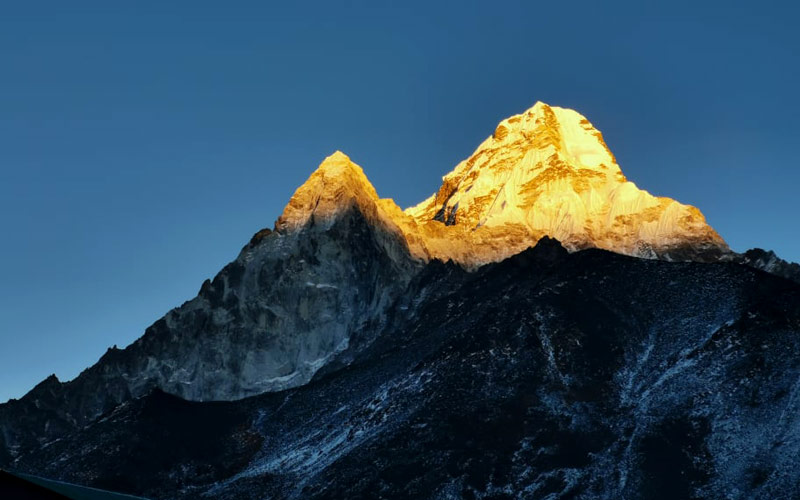
Meals during the trek in Everest region
The Everest base camp trek is a well-established trekking route of Nepal Himalayas where you can get the numerous trekking lodges along the way in the whole journey and basic meals are available in the trekking lodge on this route. The meals are served by our company as per our inclusive way which is included in this Everest Base Camp trek program. Basically, the foods are provided in the same tea house where you stay overnight and there are no outside foods is allowed according to the rule and regulations of the local community but you can simply take the normal snacks, water and drinking stuffs from outside as you wish which are allowed. In order to complete the 12 Days Everest base camp, the food is one of the most important factors that you really need it to hike in the Himalayas. The meal in this trek is very convenient and fresh except meat items, usually, we take our breakfast and dinner at the same lodge where we stay and for the lunch, our trekking guide will be chosen every day at the best place possible along the way,
Food during the trek, you will have full options to select your preferred meals items from the menu which are provided by the local tea houses, the Menu offers verities of ethnic cuisines foods as well as western styles meals including Sherpa stew, Fresh vegetable items, Rara noodles, different soups, handmade bread items, rice items, spaghetti, pizza, eggs, potatoes items, Apple pie, Dal Bhat and various of drinking like Black tea, lemon tea, Hot chocolates, Ginger tea, Milk coffee/tea, green tea, black coffee, Lemon ginger tea are available on the menu in this trek. The meals are quite surprising on this trek than other trekking routes Like Annapurna and Langtang regions of Nepal, all are selected items from the menu of the lodge will be fresh, hygienic and tasty. Some places, there are non-veg item meals are available however we do not recommend taking these meat items in the Everest region as they are not hygienic and healthy during the trek. The fresh and healthy meals during the trek like Dal Bhat, Vegetable items and soups items ( Garlic soup, potato soup, onion soup with the food, ) are recommended which are prepared by the local supplement and do not store as a long period of time to serve it.
Note: The water is available everywhere during EBC trek which costs around 2-3 dollars per liter of botels or you can also use the normal tap water for free but water purification pills are required to filter. And we would like you to take a separate proper bottle for hot water reason because cold water cannot be fit every time in the high altitude area and it’s too cold.
The Everest Base Camp trek can be customized as per your time and requirements. there are various trekking routes to get the Everest base camp based on your holiday's timeframe. However, the required trip itinerary of Everest base camp trek can be provided as per your request, please do not hesitate to write to us . We will be pleased to help you as much as we can anytime. we make sure that our clients are in the position of the comfort zone
Send Inquiry
Recent posts.
- Everest Base Camp Trek cost for Indian trekkers
- A Complete Guide to the Kanchenjunga Trek
- A Complete Guide to Trekking in the Dolpo Region
- Unveiling the Untouched Beauty of Nepal: Langtang Valley Trek in 7 Days
- Travelers’ Choice Best of the Best & Bookmundi Certificate 2023
Related Posts
- Best destinations for rafting and fishing in Nepal
- Best season to trek in Nepal Himalayas
- Top 5 One Week Treks in Nepal
- Short Treks in Nepal Himalayas
- Solo Female Travel in Nepal
- 5 Best Trekking Routes in Nepal
- Top Ten Best Treks in Nepal
- Annapurna trekking
- Everest Trek
- Langtang Trekking
- News and Updates
- Trekking in Nepal
Share and Bookmark It
National Geographic content straight to your inbox—sign up for our popular newsletters here
You can still climb Mount Everest. Here’s how to do it responsibly.
New rules are changing the Everest Base Camp hiking experience, aiming to protect the Himalayas’ Sherpa communities and help trekkers make a more positive impact.

Rising to 29,032ft on the border between Nepal and Tibet, Mount Everest — known as Sagarmatha by the Sherpa people of Nepal — has held an almost mystical allure for climbers and hikers since it was first summitted by New Zealand’s Edmund Hillary and Sherpa mountaineer Tenzing Norgay in 1953.
But 2024 marks a significant moment in the story of the world’s tallest mountain. As mountaineers gather in Nepal for the start of the spring climbing season, they face a raft of new rules and restrictions.
Introduced by the regional government, the new Base Camp Management Procedure is intended to improve safety, support local communities and shrink the mounds of rubbish building up on Everest. From wearing mandatory GPS trackers to carrying their faeces down the mountain, climbers have more to consider than ever before.
However, only a tiny fraction of travellers to Everest actually visit the summit. Most trekkers set their sights on surrounding Sagarmatha National Park, the Everest viewpoint at Kala Patthar and Everest Base Camp — the tent village used by mountaineering expeditions, perched at 17,598ft beside the Khumbu Glacier.
Offering a fascinating insight into the world of high-altitude climbing, Base Camp is the only place where hikers will be affected by the new rules for mountaineers. Here’s what you need to know to visit Everest responsibly.
What’s changed at Everest Base Camp?
Trekkers can still end the two-week Everest trek with a day trip from Gorak Shep to the mountaineers’ tent village at Everest Base Camp, but those who wish to stay overnight may find it harder to arrange. The new rules ban commercial enterprises at Base Camp, including the bakeries and massage tents that used to cater to day-trippers; you may still be able to get a cup of tea and a bite to eat, but don’t expect luxuries.
Can I get to the summit?
Climbing Everest is a more serious undertaking than trekking to Base Camp. Around 600 people complete the perilous ascent every year, but it requires months of preparation, support from a mountaineering agency and fees of over £80,000. If you join an expedition, the team will guide you through the new climbing rules, including where to get hold of the faeces bag provided by the Sagarmatha Pollution Control Committee.

How do I support local people?
Many of the new rules for mountaineers are designed to benefit Sherpa guides and porters, and trekkers can play their part on the hike to Everest Base Camp, too. Since April 2023, it’s been a legal requirement for trekkers in Sagarmatha National Park to hire a licensed Nepali guide through a trekking agency, which provides much-needed employment for Himalayan communities (the Trekking Agencies’ Association of Nepal has a list of registered agencies). Hiring local porters and staying and eating in village teahouses, rather than camping, will also provide work for Sherpa people.
Question prospective trekking agencies to make sure guides and porters are being fairly paid (at least $21 (£17) per day for guides and $18 (£14) per day for porters) and protected by insurance to support their families in case of accidents. Poverty is a big issue in the mountains and some porters still tackle the trails in flip-flops due to the unaffordability of hiking gear; make sure your hired team have appropriate clothing and footwear.
Another option is to travel with a responsible international operator. Intrepid and Exodus are two major travel companies that use local guides and porters and have established programmes to train the next generation of mountain workers in Nepal.
Before you trek, visit the Kathmandu Environmental Education Project (KEEP) in the capital’s traveller hub neighbourhood of Thamel to learn more about responsible trekking. Visit again at the end of your trek to donate any unwanted gear; it will go to porters who need it.
How do I protect the environment?
Climate change is causing glacial melting and flooding across the Himalayas. If you want to reduce your carbon footprint, take a bus and hike to the trailhead at Lukla, rather than flying from Kathmandu. It adds six days to the two-week Everest Base Camp trek, but will bring income to villages off the main trail.
Regardless of which route you’re trekking, try to stay in lodges that heat water and generate electricity using solar power or water-powered generators. If travelling independently, look out for this equipment as you enter villages. If joining an organised trek, mention to the agency that lodges that have taken sustainability measures are your preferred accommodation.

What can I do to help reduce overtourism?
In 2023, nearly 60,000 people visited the spectacular sweep of mountains, glaciers, Buddhist monasteries and Sherpa villages covered by Sagarmatha National Park. Although the park covers 443sq miles, most trekkers follow a well-established trail to Base Camp, via Namche Bazar, Tengboche, Periche or Pangboche and Gorak Shep. You can spread the economic benefits of tourism by breaking your trek at smaller villages and guesthouses, rather than the busy main overnight stops.
Also investigate quieter trekking routes. There are many rewarding alternatives or add-ons to the Everest Base Camp trek inside Sagarmatha National Park, including the dramatic hike to the jewel-like Gokyo Lakes and the challenging Three Passes Trek, linking three breathlessly high, prayer-flag-strewn mountain passes rising to 18,160ft at Kongma La.
Is there specific mountain etiquette?
Most Sherpas are Buddhist, so treat prayer flags and other religious objects with respect. Ask before you take photos of people, remove your shoes before entering homes or monasteries, walk clockwise around stupas and avoid pointing your feet towards people or images of Buddha. Locals dress modestly, so trekkers should do the same — shorts and T-shirts are fine for walking but avoid revealing outfits. Public displays of affection can also cause embarrassment.
Begging is common on the trails. If you want to help, donate to a local charity or approach schools or community centres rather than handing out gifts that won’t make a lasting difference. Books, stationery, toothpaste, toothbrushes and unwanted trekking gear are useful items to donate.
What can I do to protect the trails?
Stick to them. It’s important that trekkers always follow established paths rather than hiking through undergrowth, and avoid shortcuts between switchbacks, as these can increase erosion, destabilising the slopes. Also be careful to respect nature while out in the wilderness. Don’t pick flowers, crush plants or feed wild animals that you see on the trails. It’s best to stay a fair distance away from the local wildlife, as animals can carry diseases and feeding them might make them ill or change their natural behaviour.

How can I clean up Everest?
Avoid bringing single-use plastic packaging and plastic bags onto the trails. Don’t drop litter while hiking; consider bringing an empty canvas bag so you can gather up any rubbish you find on the trails and transport it back to Lukla, which has a government-backed rubbish-removal service. Carry toxic spent batteries from equipment such as torches or GPS devices back to Kathmandu.
Throw-away plastic water bottles are the bane of the Himalayas; it’s far better for the environment to carry a reusable bottle and purify your own water with a filter pump or chemical purification tablets. Use proper toilet facilities wherever possible; if you have to go while out on the trail, dig a hole well away from water sources and fill it in when you’re done.
Related Topics
- ADVENTURE TRAVEL
You May Also Like

Whale watching is booming. Here’s how to do it responsibly.

How to plan the ultimate adventure in the Himalayas, from beginners' hikes to Everest base camp
For hungry minds.

It’s summer in Antarctica. Here’s how to explore responsibly.

10 whimsical ways to experience Scotland

What it's like to hike to the end of the world in Chile's Tierra del Fuego

The essential guide to visiting Scotland

Banff, Jasper and more: 4 wild places for Canadian outdoor adventures
- Environment
- Perpetual Planet
History & Culture
- History & Culture
- History Magazine
- Mind, Body, Wonder
- Paid Content
- Terms of Use
- Privacy Policy
- Your US State Privacy Rights
- Children's Online Privacy Policy
- Interest-Based Ads
- About Nielsen Measurement
- Do Not Sell or Share My Personal Information
- Nat Geo Home
- Attend a Live Event
- Book a Trip
- Inspire Your Kids
- Shop Nat Geo
- Visit the D.C. Museum
- Learn About Our Impact
- Support Our Mission
- Advertise With Us
- Customer Service
- Renew Subscription
- Manage Your Subscription
- Work at Nat Geo
- Sign Up for Our Newsletters
- Contribute to Protect the Planet
Copyright © 1996-2015 National Geographic Society Copyright © 2015-2024 National Geographic Partners, LLC. All rights reserved
- Today's news
- Reviews and deals
- Climate change
- 2024 election
- Fall allergies
- Health news
- Mental health
- Sexual health
- Family health
- So mini ways
- Unapologetically
- Buying guides
Entertainment
- How to Watch
- My watchlist
- Stock market
- Biden economy
- Personal finance
- Stocks: most active
- Stocks: gainers
- Stocks: losers
- Trending tickers
- World indices
- US Treasury bonds
- Top mutual funds
- Highest open interest
- Highest implied volatility
- Currency converter
- Basic materials
- Communication services
- Consumer cyclical
- Consumer defensive
- Financial services
- Industrials
- Real estate
- Mutual funds
- Credit cards
- Balance transfer cards
- Cash back cards
- Rewards cards
- Travel cards
- Online checking
- High-yield savings
- Money market
- Home equity loan
- Personal loans
- Student loans
- Options pit
- Fantasy football
- Pro Pick 'Em
- College Pick 'Em
- Fantasy baseball
- Fantasy hockey
- Fantasy basketball
- Download the app
- Daily fantasy
- Scores and schedules
- GameChannel
- World Baseball Classic
- Premier League
- CONCACAF League
- Champions League
- Motorsports
- Horse racing
- Newsletters
New on Yahoo
- Privacy Dashboard
Engineer battles lack of oxygen on Everest trek
An engineer who trekked to Mount Everest base camp for charity has described battling against a lack of oxygen to achieve the feat.
Ben Allan, from Peterborough, has raised more than £2,500 for city charity Little Miracles, which supports families of children with disabilities.
He said he "couldn’t think of a better cause to support."
The charity said is its income relied almost entirely on voluntary donation and it was grateful for fundraising efforts such as Mr Allan’s for helping it to "keep going."
'So proud'
Mr Allan said: “The climb itself isn’t too hard, the scenery is great, and you get a real appreciation for just how insanely beautiful and rugged the landscape is in Nepal."
He said the trek took 12 days in total, with nine to 10 hours of walking, mostly uphill, every day.
“The most difficult thing to overcome is the lack of oxygen. It felt like I was constantly starved of oxygen and had to hyperventilate to breathe normally," he said.
He said highlights of the trip were the scenery, rope-bridge crossings and base camp itself.
Mr Allan’s employer Barratt and David Wilson Homes, which has donated £1,000 as part of its employee fund-matching, said it was “so proud of Ben and his team".
Georgia Handley of Little Miracles said it was "incredibly grateful" to Mr Allan.
“Fundraising events like Ben’s allow us to continue to be here for families who have children with disabilities, additional needs and life-limiting conditions, many of whom struggle both financially and emotionally to access the support they need in the community," she said.
Follow Peterborough news on Facebook , Instagram and X . Got a story? Email [email protected] or WhatsApp us on 0800 169 1830
Related Internet Links
Little Miracles
Recommended Stories
Las vegas tourism arm announces $100,000 sponsorship for every aces player.
That's more than some of the Aces players' salaries.
NBA playoffs: Pacers lock down Knicks to force Game 7
The Knicks haven't played a Game 7 at Madison Square Garden since 1995, when they lost to ... the Pacers.
Here are all of the Republicans who have shown up in court to support Trump at his hush money trial
GOP lawmakers have been showing up at the Manhattan Criminal Courthouse in waves to give the former president a public show of support, help him circumvent the gag order — and audition for a role in a possible second-term Cabinet.
Report: David Fletcher, former Shohei Ohtani teammate, placed bets with same bookie as Ippei Mizuhara
This scandal refuses to end for MLB.
Celtics C Kristaps Porzingis reportedly expected to miss start of Eastern Conference finals
The Celtics are optimistic the big man will return at some point in the series.
Chiefs' Wanya Morris, Chukwuebuka Godrick arrested for misdemeanor marijuana possession
Kansas City Chiefs players Wayna Morris and Chukwuebuka Godrick were arrested for misdemeanor marijuana possession, according to a Johnson County Sheriff.
How to watch the Microsoft Build 2024 keynote live on May 21
Microsoft is streaming its Build 2024 keynote on Tuesday. Here's how to watch -- and what to know about the lower-profile event the day before.
Doctor Who: Boom review: All hail the conquering hero
It's the first classic of the Disney+ era.
Indy 500: How to watch the practices and qualifying rounds
While you wait for the Indy 500, you can tune into all the practice action on the track.
PGA Championship: Will Zalatoris says group of players considered asking for postponement after death, Scottie Scheffler arrest
It was a surreal day at the PGA Championship.
Ben Affleck and Jennifer Lopez: What we know — and what we don't — amid rumors they're splitting
Is Ben Affleck and Jennifer Lopez's marriage over? There are a lot of rumors floating around about their union. Here's what we know.
Giants outfielder Jung Hoo Lee to undergo season-ending shoulder surgery
The Korean star signed a $113 million deal with the Giants last offseason.
Capital One Spark Cash Select for Excellent Credit review: A cash-back business card with simple rewards
This business card comes with a generous welcome bonus and earns a flat 1.5% cash back on every purchase
Kelly Clarkson is the latest celebrity to admit to using weight loss drugs. Do stars have a responsibility to share?
Are celebrities obligated to tell the world that they're using medication to aid in weight loss? Here's what experts say.
K-pop group NewJeans is at the center of messy feud: What to know
Breaking down the ongoing K-pop drama between ADOR CEO Min and Hybe.
Adobe comes after indie game emulator Delta for copying its logo
After Apple loosened its App Store guidelines to permit game emulators, the retro game emulator Delta -- an app 10 years in the making -- hit the top of the App Store's charts. Delta's game emulator was built by developer Riley Testut, who had begun his experiments in this space by figuring out how to load games onto graphing calculators, before turning to iOS.
The 27 best Walmart deals to shop this weekend — save up to 75% on early Memorial Day sales, summer essentials and more
Ready for your pre-summer perusal: A massive patio umbrella for over half off, a 65-inch Hisense smart TV for under $500 and a Keurig hot/iced coffeemaker for nearly $70 off.
Meta's latest experiment borrows from BeReal's and Snapchat's core ideas
Meta is once again taking on its competitors by developing a feature that borrows concepts from others -- in this case, BeReal and Snapchat. The company is developing a feature for Instagram called “Peek” that would allow users to post authentic pictures that can only be viewed once. While Snapchat popularized the idea of ephemeral content on social media, BeReal led the trend of posting authentic, unedited content.
Scottie Scheffler warmed up in jail cell ahead of 5-under round at PGA Championship
Even after early morning arrest, Scottie Scheffler has himself near the top of the leaderboard after two rounds of the 106th PGA Championship.
2024 Tight end rankings for fantasy football
The Yahoo Fantasy football analysts reveal their first tight end rankings for the 2024 NFL season.

Engineer battles lack of oxygen on Everest trek
A n engineer who trekked to Mount Everest base camp for charity has described battling against a lack of oxygen to achieve the feat.
Ben Allan, from Peterborough, has raised more than £2,500 for city charity Little Miracles, which supports families of children with disabilities.
He said he "couldn’t think of a better cause to support."
The charity said is its income relied almost entirely on voluntary donation and it was grateful for fundraising efforts such as Mr Allan’s for helping it to "keep going."
Mr Allan said: “The climb itself isn’t too hard, the scenery is great, and you get a real appreciation for just how insanely beautiful and rugged the landscape is in Nepal."
He said the trek took 12 days in total, with nine to 10 hours of walking, mostly uphill, every day.
“The most difficult thing to overcome is the lack of oxygen. It felt like I was constantly starved of oxygen and had to hyperventilate to breathe normally," he said.
He said highlights of the trip were the scenery, rope-bridge crossings and base camp itself.
Mr Allan’s employer Barratt and David Wilson Homes, which has donated £1,000 as part of its employee fund-matching, said it was “so proud of Ben and his team".
Georgia Handley of Little Miracles said it was "incredibly grateful" to Mr Allan.
“Fundraising events like Ben’s allow us to continue to be here for families who have children with disabilities, additional needs and life-limiting conditions, many of whom struggle both financially and emotionally to access the support they need in the community," she said.
Follow Peterborough news on Facebook , Instagram and X . Got a story? Email [email protected] or WhatsApp us on 0800 169 1830
Related Internet Links
- Little Miracles


IMAGES
VIDEO
COMMENTS
Everest Base Camp Trek Overview. Distance - 120 km/75 mi; Days required - 12 days; Total ascent - 6015 m/19 734 ft; Total descent - 5821 m/19 097 ft; Highest point - 5640 m/18 500 ft Kala Patthar; Difficulty - difficult ; Permits - Local Government fee (NPR 2000/US$17 pp.) and Sagarmatha National Park permit (NPR 3000/US$25 pp.) is required.No TIMS card is needed for the trek.
The typical Everest Base Camp itinerary is as follows: Day 1: Flight from Kathmandu to Lukla; trek to Phakding. Day 2: Phakding to Namche Bazar. Day 3: Acclimatization day in Namche Bazar. Day 4: Namche Bazar to Tengbouche. Day 5: Tengbouche to Dingboche. Day 6: Acclimatization day in Dingboche. Day 7: Dingboche to Lobuche.
Classic Everest Base Camp trek. The classic Everest Base Camp trek takes about 14 days, including time in Kathmandu before and after. From Kathmandu, you'll fly into Lukla Airport (2,860m/9,383ft) with its famously short runway - try to sit on the left side of the plane so you can catch your first views of Mt. Everest.
There are only a couple of steep climbs, lasting about an hour each, and most days involve less than four hours of walking. The thing that makes the EBC trek tough is the altitude. Base Camp is at 5600m (18,373ft) and you will need to spend one or two nights above 5000m (16,404ft). Above 4000m (13,123ft) you are going to feel increasingly ...
Phone +1 682-558-3926. Web Visit website. Trekking to Everest Base Camp in Nepal's Sagarmatha National Park is the adventure of a lifetime. Although actually climbing Mount Everest is out of reach for many of us, anyone with enough grit and good enough fitness can reach EBC and the Khumbu Icefall, the starting point for climbing Mount Everest.
Day 8: Dingboche to Thukla. Day 9: Thukla to Gorak Shep. Day 10: Everest Base Camp. Day 11: Kala Patthar to Gorak Shep to Pheriche. Day 12: Pheriche to Namche. Day 13: Namche to Lukla. If you ever need motivation to keep going on the Everest Base Camp hike, just look at how much the porters are carrying!
Altitude: Kathmandu (1 400m) - Lukla (2 860m) - Phakding (2 610m). Trekking time: 3-4 hours | 7,4 km. Difficulty: Easy with only a few uphill sections. Highlight: Flight into Lukla. Overview: The first day of your Everest Base Camp trek itinerary will start bright and early with a flight out of Kathmandu to the infamous Tenzing Hillary Airport in Lukla.
Days required: 12 -14 days. Total Incline: (Undulation) - 6015 m. Total Decline : (Undulation) - 5821 m. The highest point on the trek: 5640 m/18 500 ft, this is actually at Kala Patthar, which you will hike to in the morning after reaching Everest Base Camp. This is where you get the best views of Mount Everest.
The typical Everest Base Camp trek duration is between 14-16 days (including transfers between Kathmandu and Lukla). The trek itself (excluding sightseeing in Kathmandu and transfers) usually lasts about 12 days with acclimatisation days at Namche Bazaar and Pheriche. Here is a brief overview of a typical itinerary on an EBC trek, with ...
On the map, the Everest Base Camp trekking route distances look fairly easy to hike from village to village through the Khumbu Valley. Eight days may seem like it would be more than enough time to cover a mere 63 km (39 miles) one way, (128 km return) but with several sustained days in a row above 4000 meters (13,000 feet), the walk is slow and steady.
The journey to Everest Base Camp Trek in Nepal tops the dream list for countless trekkers worldwide, and for good reason! It is a trail that showcases the greatness of the Khumbu Valley, offering breathtaking views of some of the world's highest peaks. The journey begins with an exciting flight to Lukla, at an elevation of about 2850 meters.
Distance. The classic Everest Base Camp trek from Lukla to EBC and back is 130km long - 65km each way - which may sound like a lot of trekking! Fear not, because the typical round trip to Everest Base Camp takes around 12 days, the actual distance you will be covering each day will be about 15km - a much more reasonable and achievable number.
An Everest base camp trek typically takes around 14 days which includes 11 days of trekking - although two of these will be acclimatisation/rest days. The trek takes nine days to ascend to base camp and two to descend back to Lukla. ... The Everest base camp trek can be booked through Magical Nepal, a Kathmandu-based trekking specialist with ...
The general length of the Everest Base Camp Trek is about 12 to 16 days. The duration of your Himalayan adventure will mostly depend on the route taken, side detours around the region, trekking pace, and acclimatization days included in the package. Everest Base Camp Trek 12 Days is the most standard duration to complete this iconic journey to ...
A standard trek to EBC in Tibet looks like this: Day 1: Old Tingri to Lungthang. Day 2: Lungthang to Lamna La. Day 3: Lamna La to Zommug. Day 4: Zommug to Rombuk. Day 5: Rombuk to EBC. An alternative trekking route is between Rombuk/EBC and Advanced Base Camp (21,325 feet), which is just 17 miles but takes five days.
Our experience on the Everest Base Camp Trek. Like many, we began offering the trek to Everest Base Camp largely because of its reputation as one of the most extraordinary adventures on the planet. ... Day 10: Lobuche to Everest Base Camp (17,598 ft / 5,364 m) - The final part of the trail starts by weaving over rocky highland terrain and ...
The hiking distance of Everest Base Camp Trek is around 130 Kilometers/81 miles. You will finish Everest Base Camp Trek in 11 nights and 12 days. Consistently you stroll on a normal of 12 Kilometers/7 miles in a day. In your normal pace of strolling, you will do it with a sometimes gradual climb on the rocky landscape and sometimes with a descent.
Day 13 - Gorak Shep. 5,160 meters (16,929 feet) Oxygen Concentration 54%. Day 13 is one of the longest days. It's a three hour trek to Gorak Shep and another 5 hours to Everest Base Camp and back. The three hours to our teahouse, Snowland, took me longer than planned.
Trip Highlights of Everest Base Camp Trek - 14 Days. Trek to the foot of world's highest peak Mount Everest. Scenic mountain flight to and from Lukla. The highest airport in the world at Syangboche. Reach Everest base camp (5364 m) walking on Khumbu glacier. Explore the Sherpa culture and lifestyle.
There are many rewarding alternatives or add-ons to the Everest Base Camp trek inside Sagarmatha National Park, including the dramatic hike to the jewel-like Gokyo Lakes and the challenging Three ...
Hey everyone, welcome to the Rugged Trails Nepal YouTube channel!Today, we're taking you on a virtual journey to Everest Base Camp, the pinnacle of trekking ...
In between base camp and the next camp (6,065 metres), at the base of Changtse sits the dangerous Khumbu Icefall (between 5,486 and 5,791 metres). Climbers crossing the Khumbu Icefall on Mount ...
Journey To The Top: 10 Essential Tips For A Successful Everest Base Camp Trek Put one foot after another, enjoy the view, and remember to follow these 10 essential tips for a successful Everest ...
Everest Base Camp aerial view And, How many of you planning for Everest Base Camp Trek in 2024 ? Comment down below For Booking and inqiary: Mail: alpineacetreks @satkauskas.mindaugas #nepal...
Sat, May 18, 2024, 3:53 AM EDT · 2 min read. Ben Allan spent 12 days trekking to the base camp for Little Miracles [Contributed ] An engineer who trekked to Mount Everest base camp for charity ...
256 likes, 5 comments - alpineacetreks on May 17, 2024: "Everest Base Camp aerial view And, How many of you planning for Everest Base Camp Trek in 2024 ? Comment down below For Booking and inq...". Alpine Ace Treks | Everest Base Camp aerial view And, How many of you planning for Everest Base Camp Trek in 2024 ?
The Fight or Flight hiking group is made up of eight coworkers. The two women and six men put together the trek to Mount Everest base camp. "We called it 'Team Fight or Flight Road Trip to Everest' because when I was diagnosed with bladder cancer in 2019 hiking became harder.
A n engineer who trekked to Mount Everest base camp for charity has described battling ... He said the trek took 12 days in total, with nine to 10 hours of walking, mostly uphill, every day ...